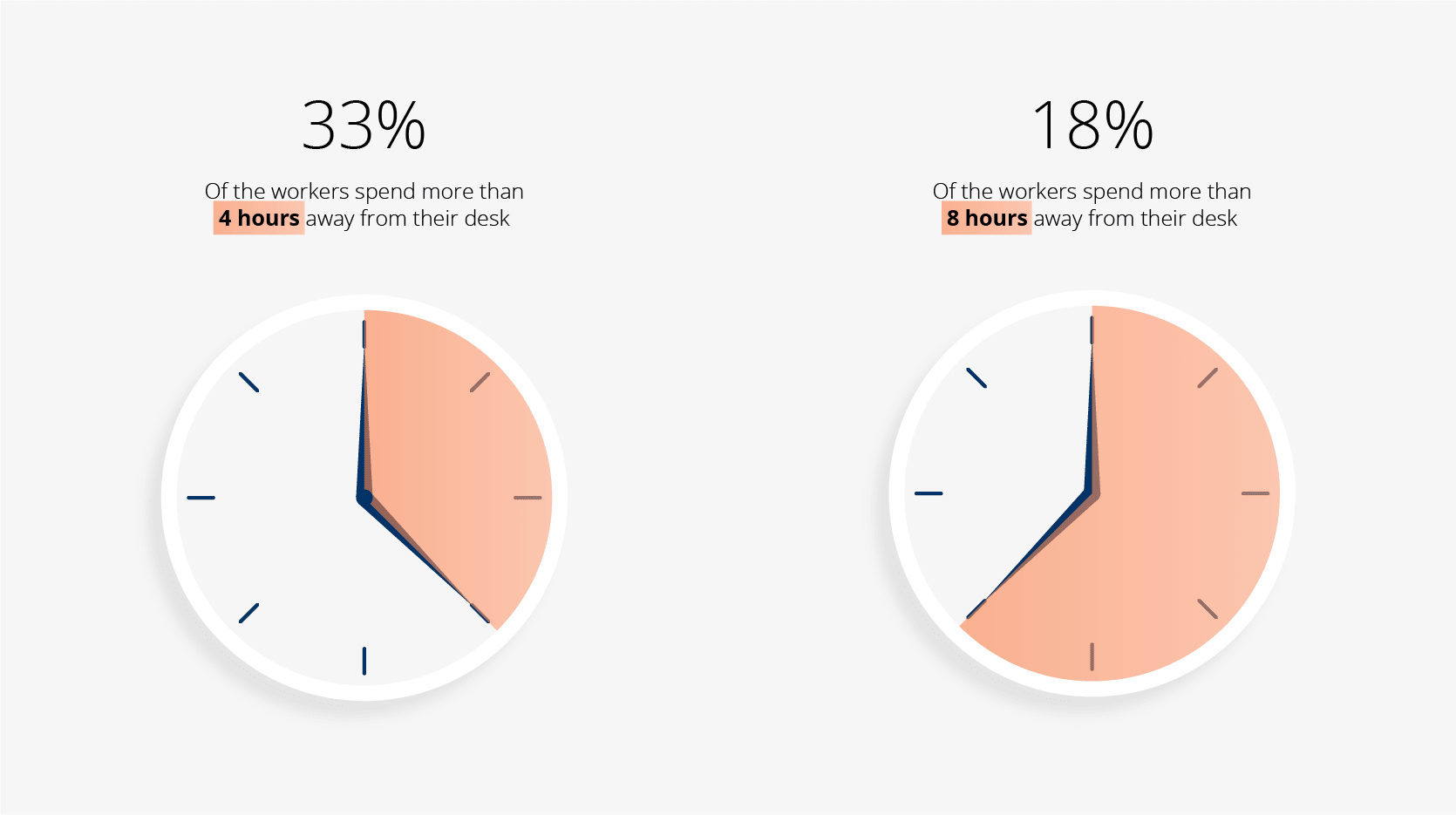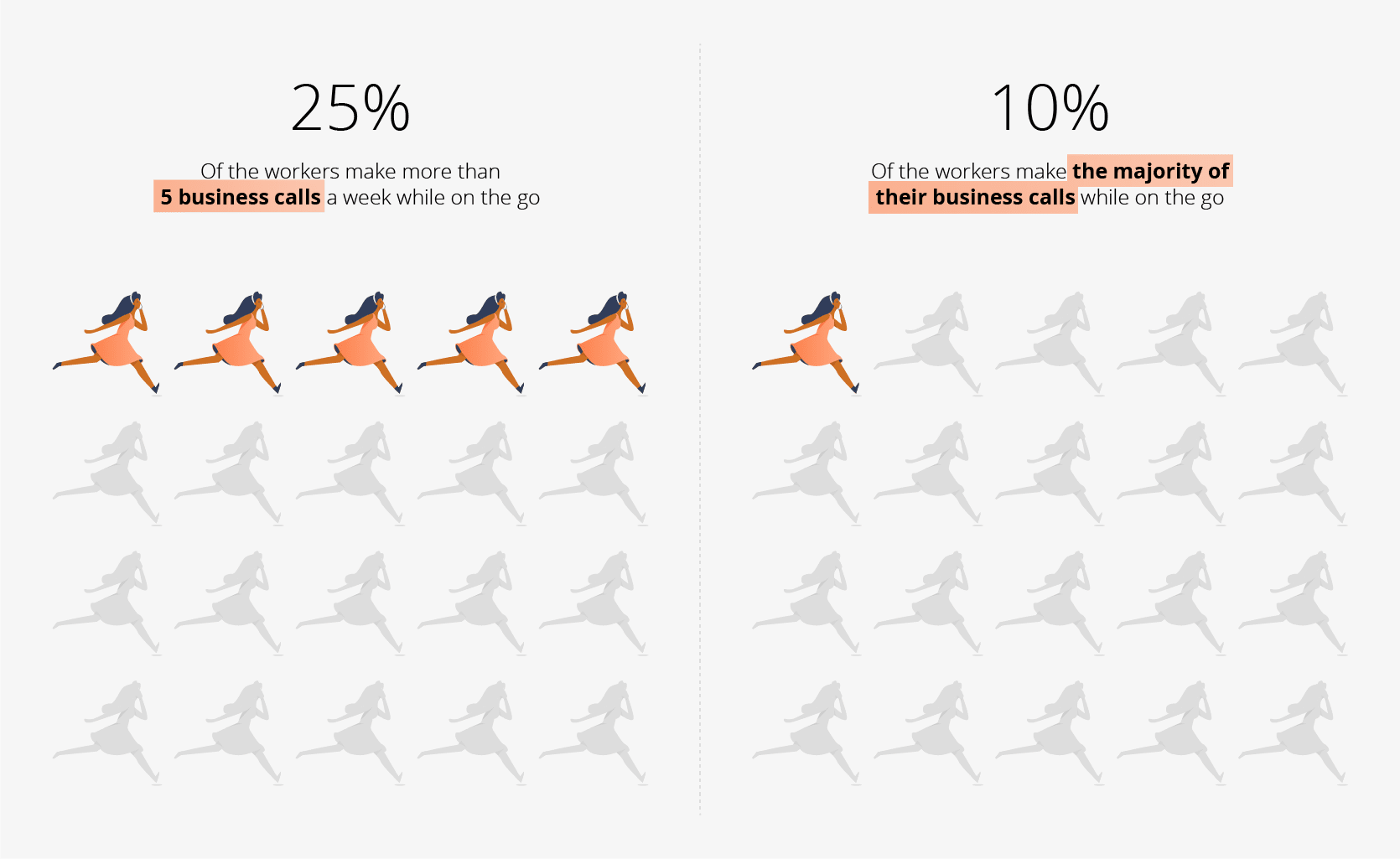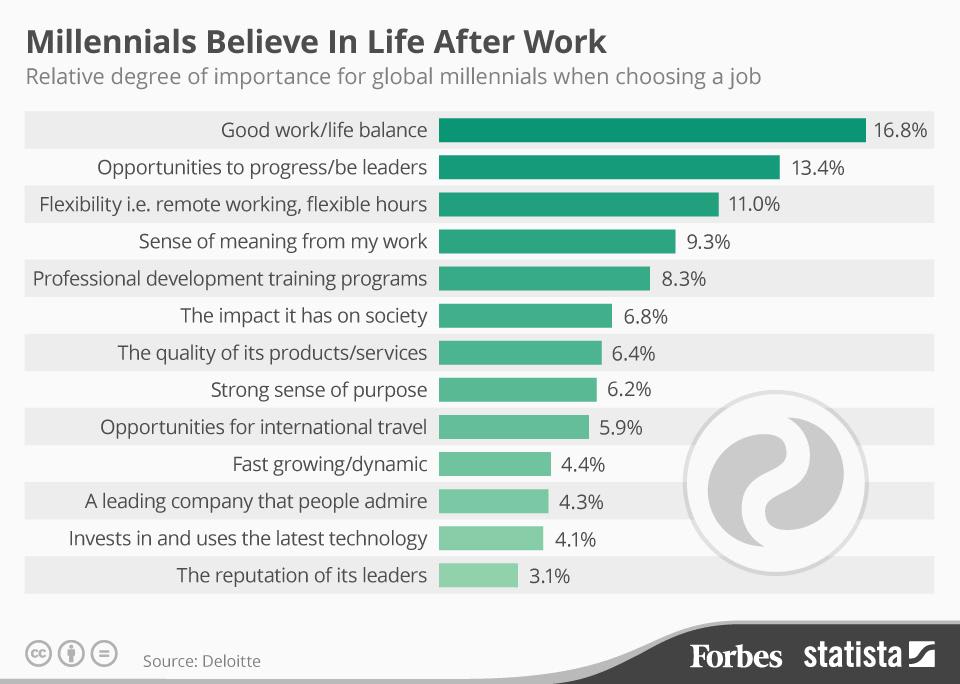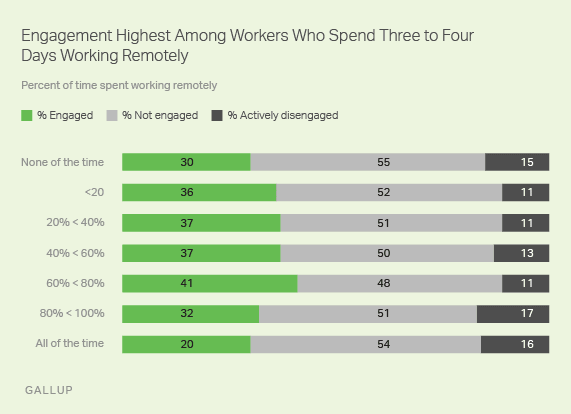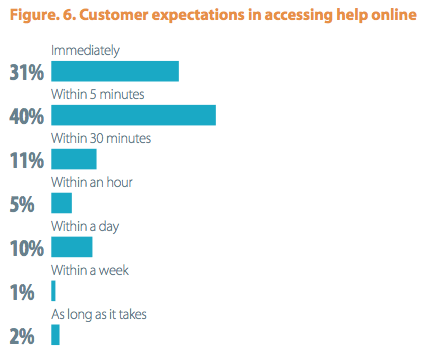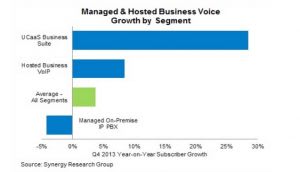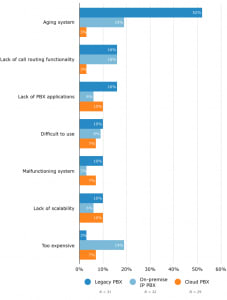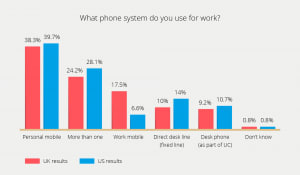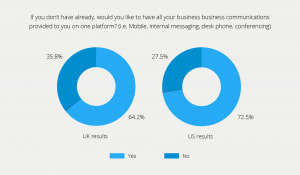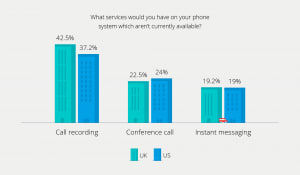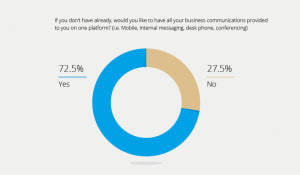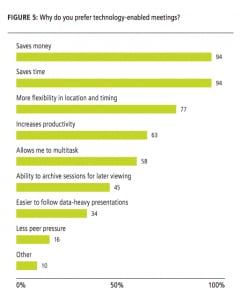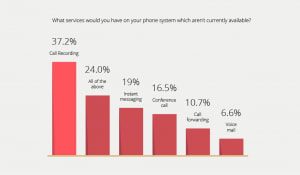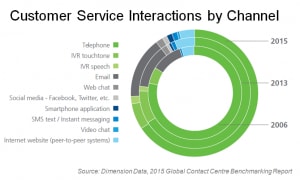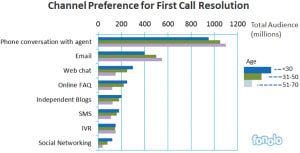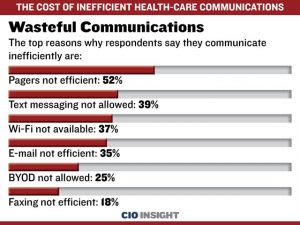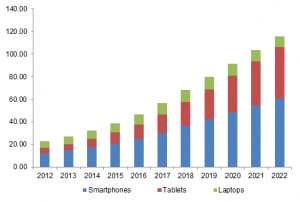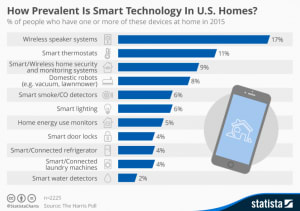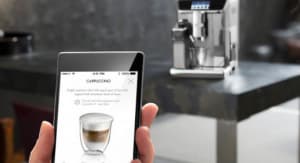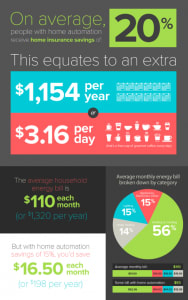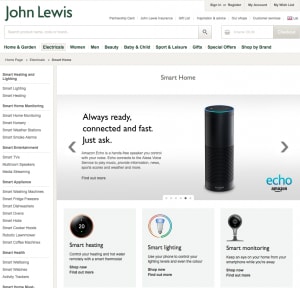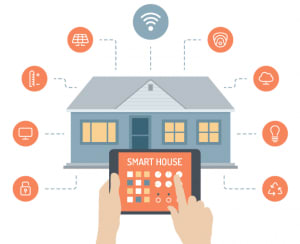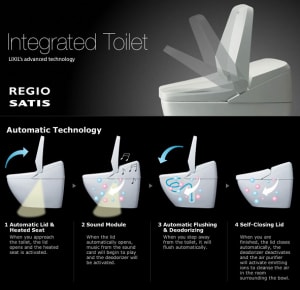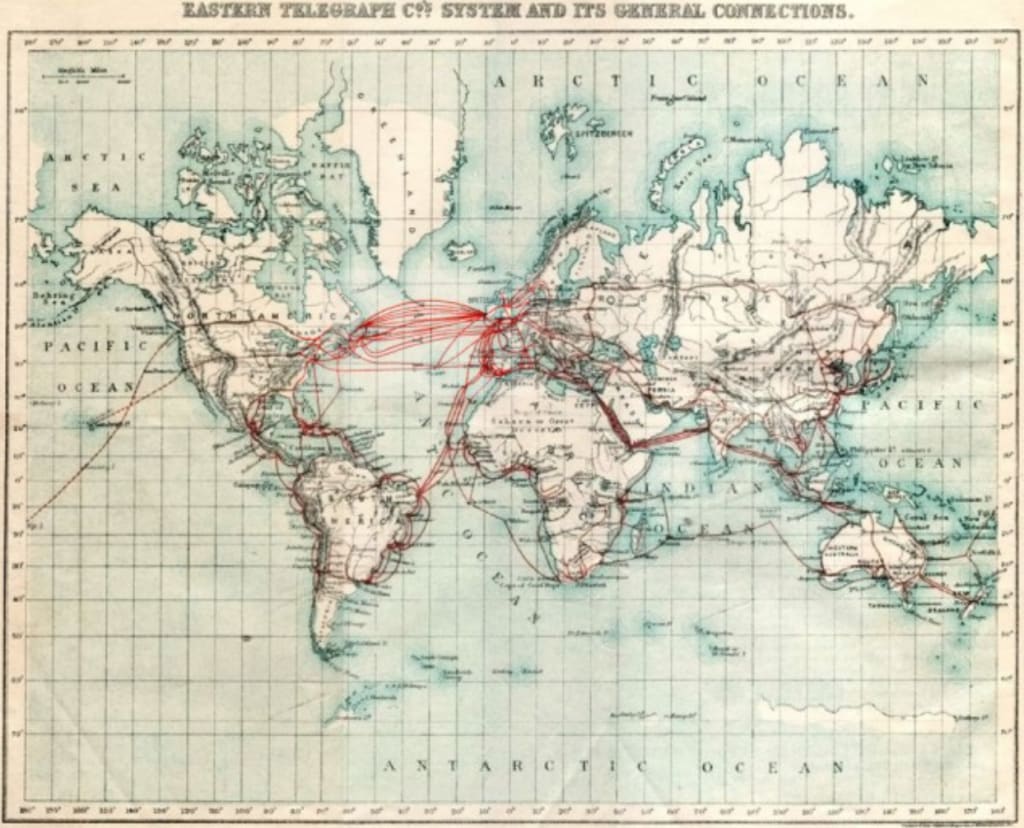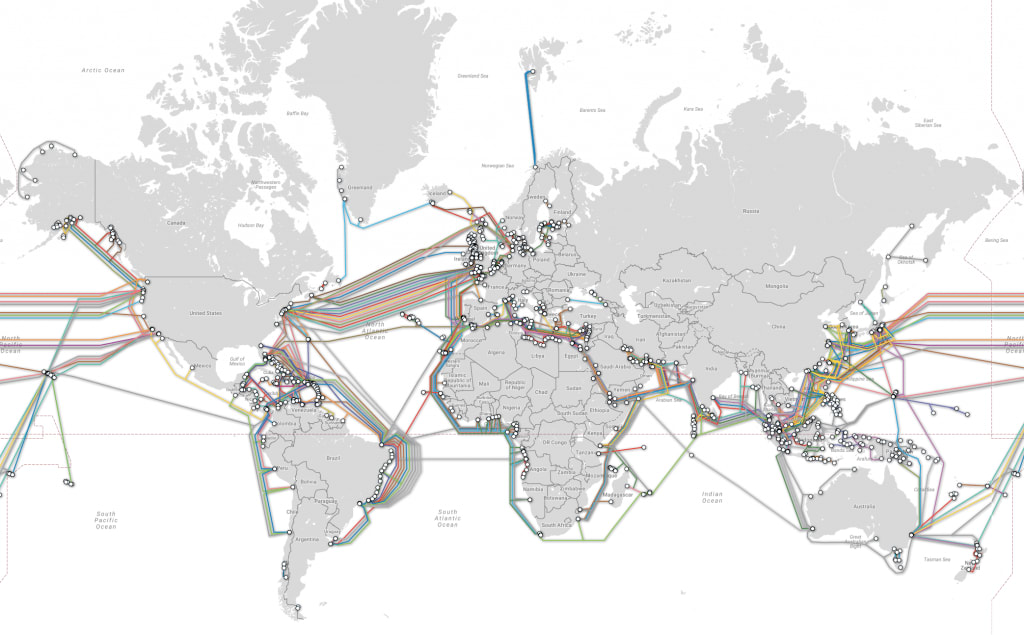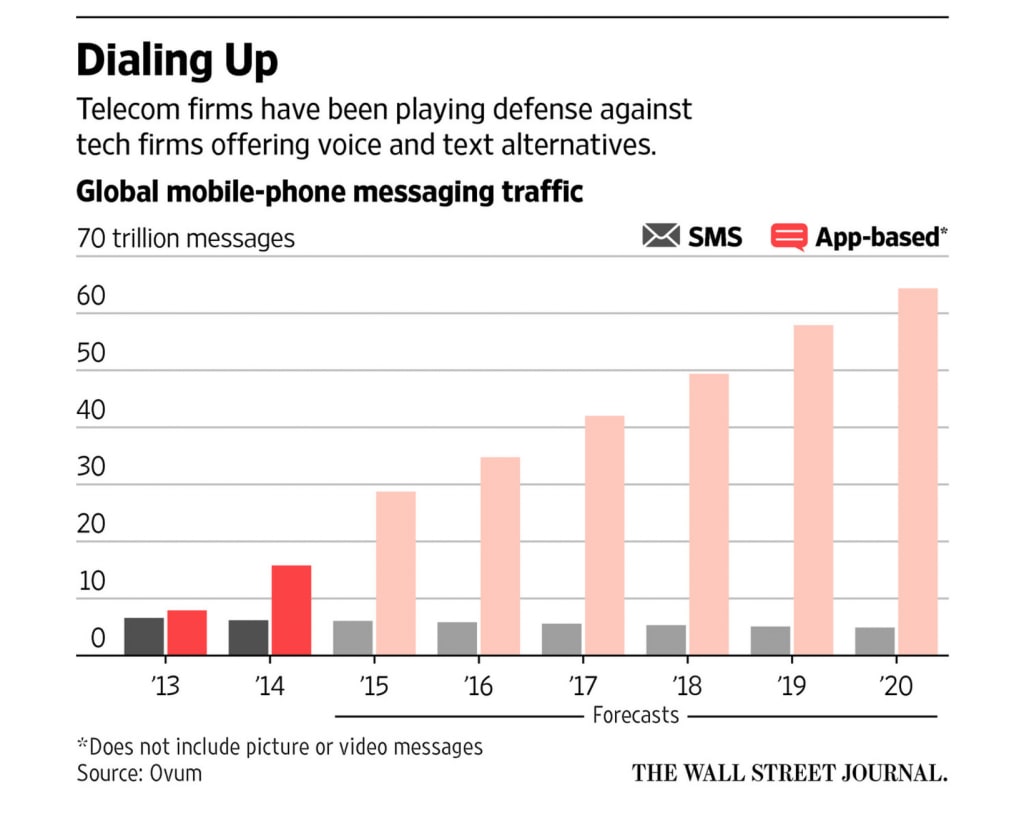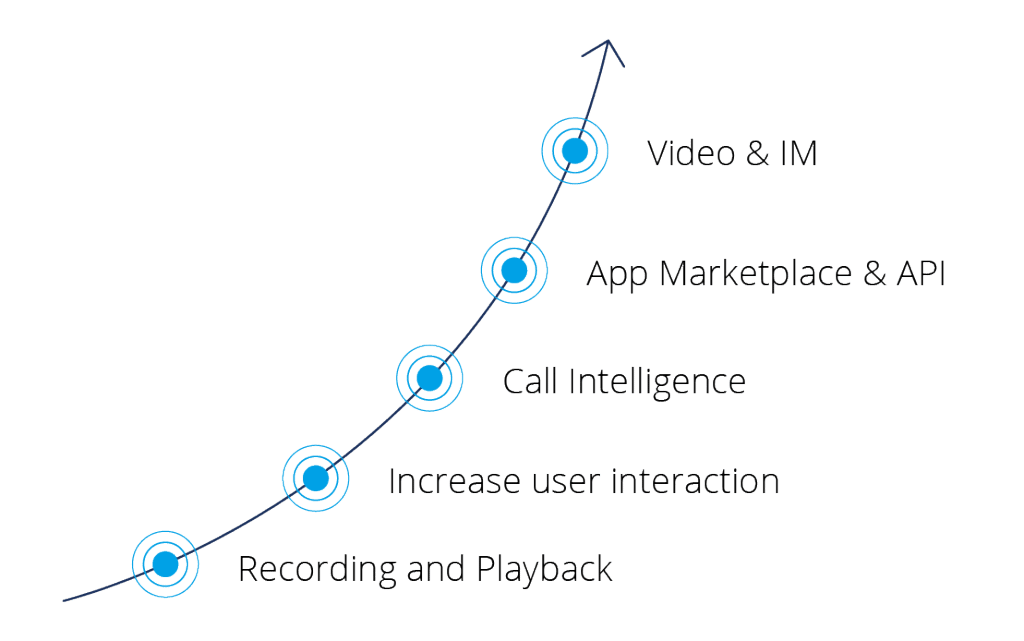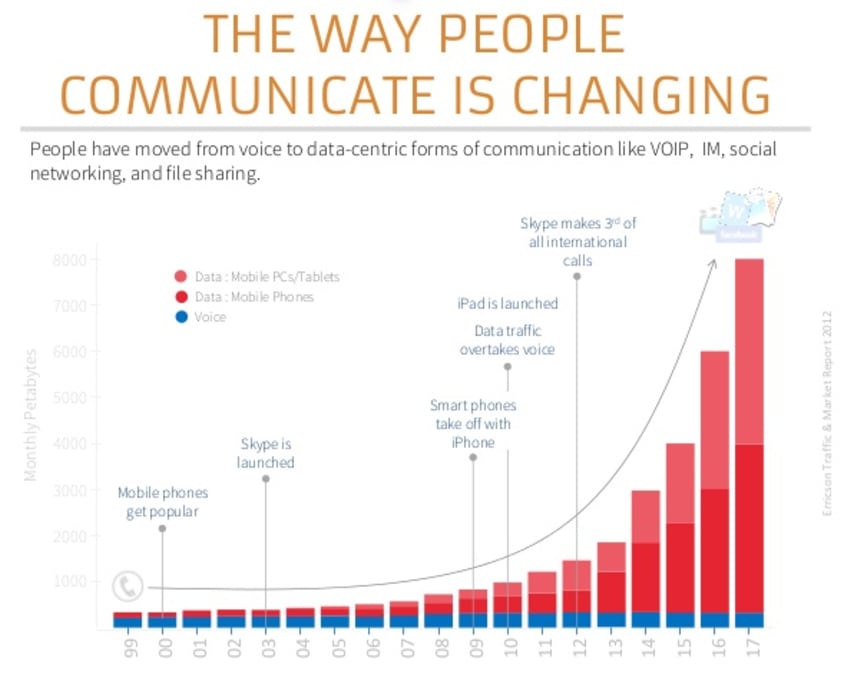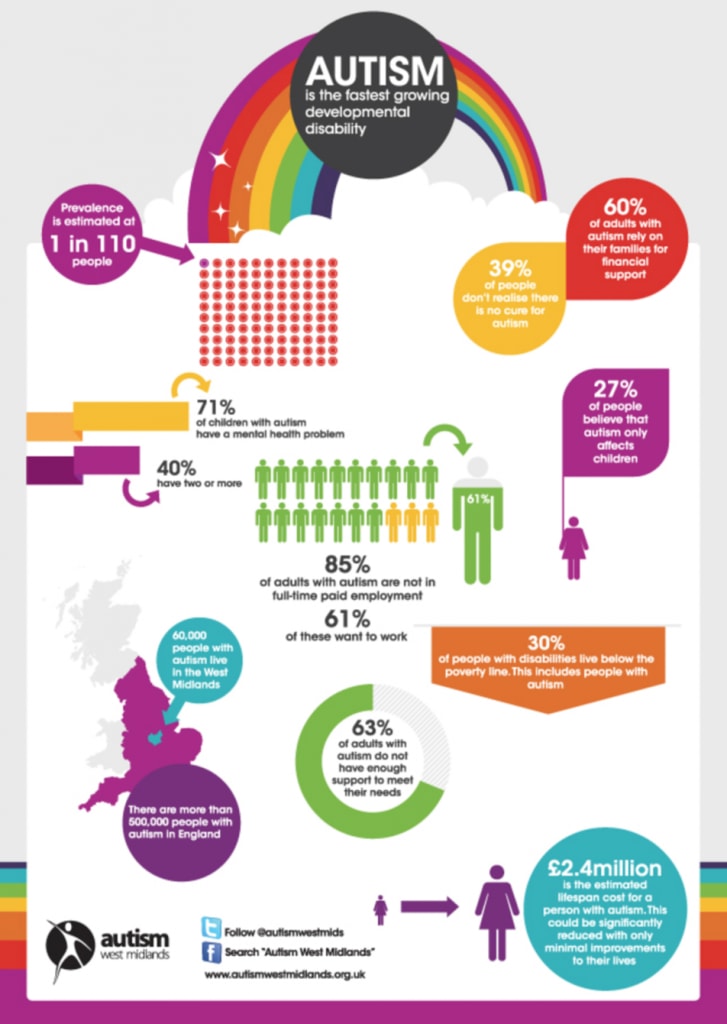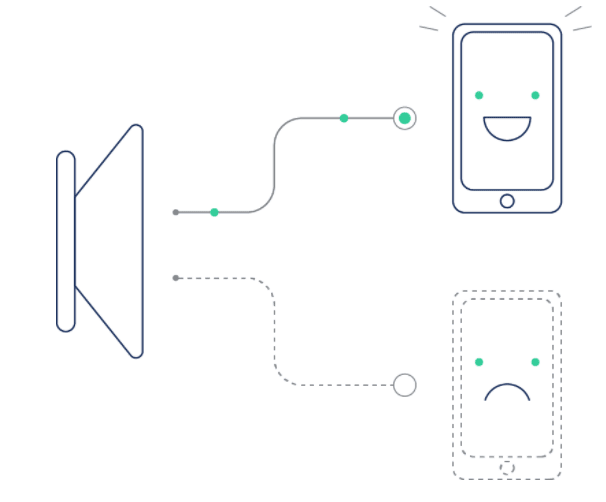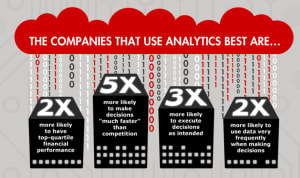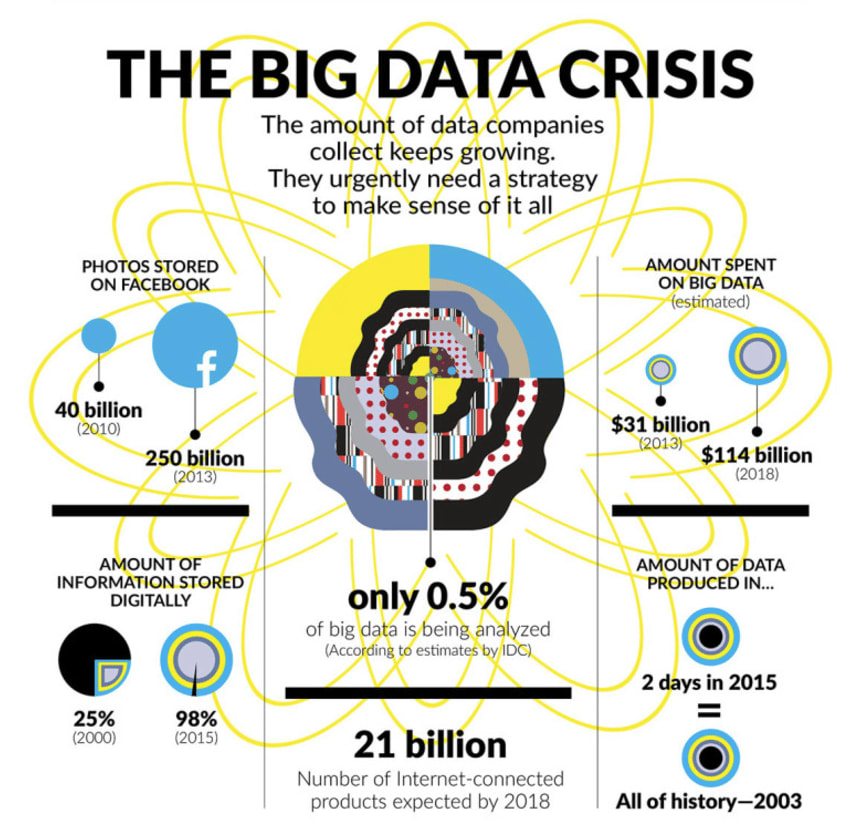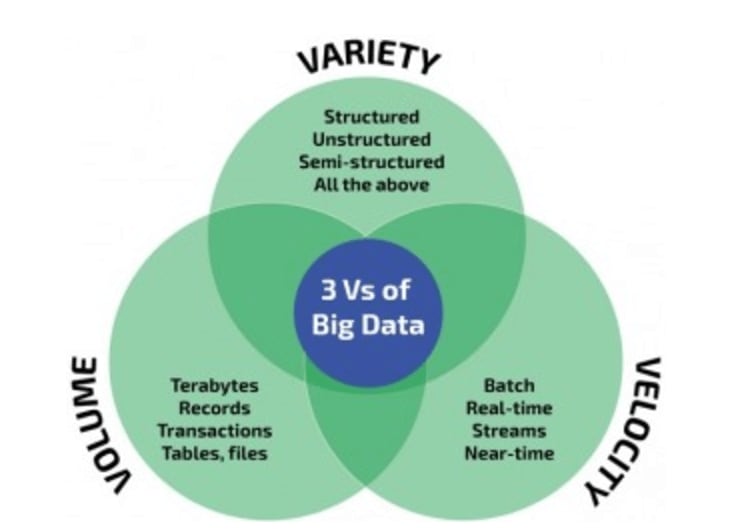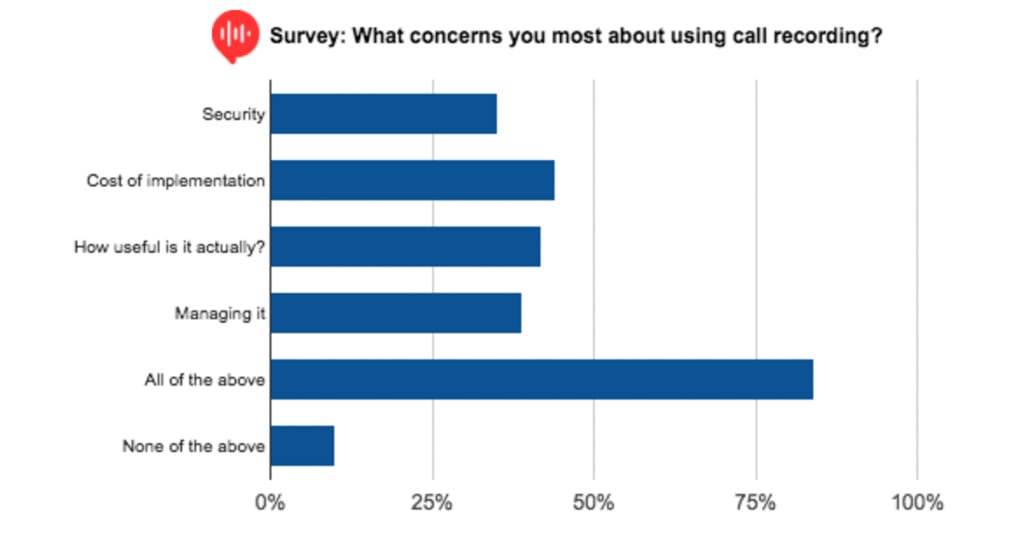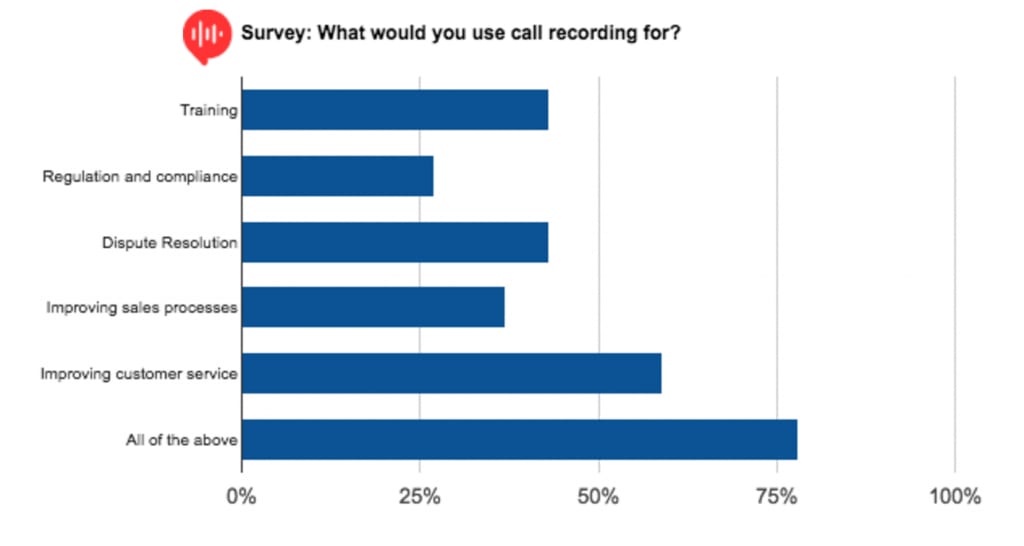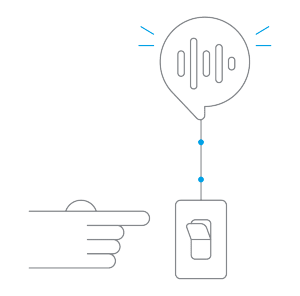As we close out another year, I’ve been reflecting on 2025 and what has been a defining year for Dubber, one marked by transition, challenge, and significant progress.
Over the past twelve months, we’ve reshaped our leadership team and strengthened our governance so that Dubber is well positioned for the future and disciplined in how we get there. This year was a reminder of the importance of diversification, resilience, and the strategic focus we’ve been putting in place for sustainable, long-term growth and value.
The global team has consistently delivered results. We returned a year-on-year revenue growth of 9% and reached operating cashflow breakeven in June. We also expanded our partner ecosystem, reflecting continued momentum and market confidence. As we close out the year, Dubber remains in a strong financial position, giving us the flexibility to keep investing in what matters most. These investments, along with the significant work put into our advanced AI capabilities are already beginning to show early returns, with customers starting to see Dubber not just as a compliance provider, but as a platform for intelligence, insight, and operational advantage.
For FY26, Dubber’s priorities are clear. We’ll focus our go-to-market efforts on industries we can make the most impact. We will deepen the value we deliver to our partners, helping them sell more effectively. We will continue to evolve our products, deploy our new recorder technology, grow AI-driven sales, and maintain the drive for business productivity and cost efficiency.
More than any strategic initiative, what gives me confidence is the people behind them. Our team has shown professionalism. Our investors and partners have shown patience. And our customers continue to place their trust in us as we help them turn communication into powerful intelligence. Thank you to every employee, partner, shareholder, and supporter for standing with us through a year of transformation. We step into 2026 with renewed purpose, a stronger foundation, and a shared determination to deliver even more meaningful outcomes.
Wishing you and your loved ones a safe, restful, and happy festive season, and an exciting year ahead!
Matthew Bellizia
Chief Executive Officer
![]()
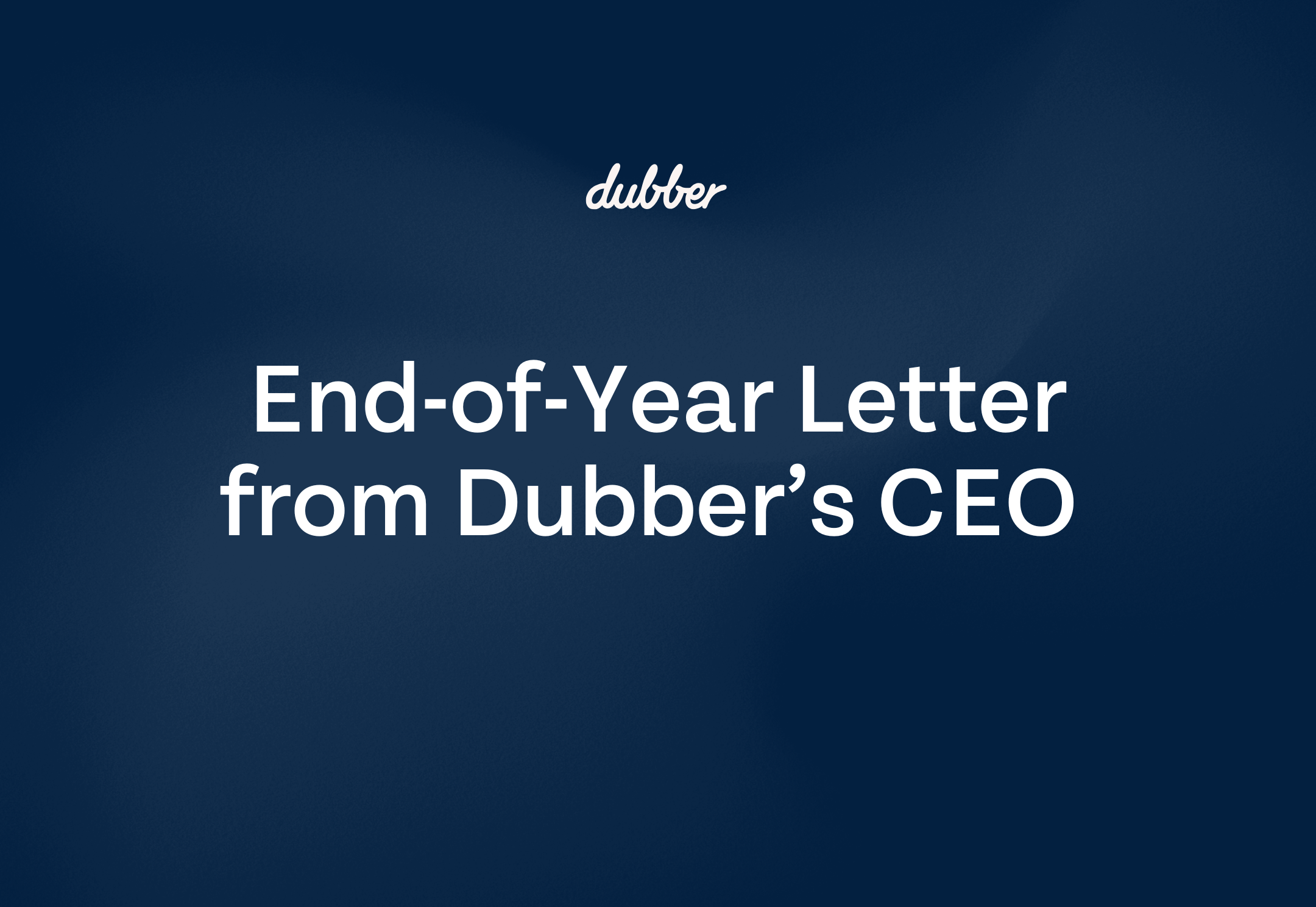
As we close out another year, I’ve been reflecting on 2025 and what has been a defining year for Dubber, one marked by transition, challenge, and significant progress.
Over the past twelve months, we’ve reshaped our leadership team and strengthened our governance so that Dubber is well positioned for the future and disciplined in how we get there. This year was a reminder of the importance of diversification, resilience, and the strategic focus we’ve been putting in place for sustainable, long-term growth and value.
The global team has consistently delivered results. We returned a year-on-year revenue growth of 9% and reached operating cashflow breakeven in June. We also expanded our partner ecosystem, reflecting continued momentum and market confidence. As we close out the year, Dubber remains in a strong financial position, giving us the flexibility to keep investing in what matters most. These investments, along with the significant work put into our advanced AI capabilities are already beginning to show early returns, with customers starting to see Dubber not just as a compliance provider, but as a platform for intelligence, insight, and operational advantage.
For FY26, Dubber’s priorities are clear. We’ll focus our go-to-market efforts on industries we can make the most impact. We will deepen the value we deliver to our partners, helping them sell more effectively. We will continue to evolve our products, deploy our new recorder technology, grow AI-driven sales, and maintain the drive for business productivity and cost efficiency.
More than any strategic initiative, what gives me confidence is the people behind them. Our team has shown professionalism. Our investors and partners have shown patience. And our customers continue to place their trust in us as we help them turn communication into powerful intelligence. Thank you to every employee, partner, shareholder, and supporter for standing with us through a year of transformation. We step into 2026 with renewed purpose, a stronger foundation, and a shared determination to deliver even more meaningful outcomes.
Wishing you and your loved ones a safe, restful, and happy festive season, and an exciting year ahead!
Matthew Bellizia
Chief Executive Officer
![]()

We’re pleased to share that Dubber has officially renewed both our ISO 27001 and ISO 22301 certifications. These globally recognized certifications reinforce our commitment to maintaining the highest standards for security across our platform.
For our users, these certifications provide confidence that the services they rely on are safeguarded by independently verified processes. They ensure that their data remains secure while allowing Dubber to continue to deliver reliable, advanced voice recording and intelligence services.
ISO 27001 (Information Security) Certification
We successfully retained our ongoing ISO 27001 certification, demonstrating our commitment to continuous improvement and robust security practices.
ISO 22301 (Business Continuity and Resilience) Certification
We have also formally achieved ISO 22301 certification, which has strengthened our Trust Portfolio, and independently validates that our business continuity and resilience practices meet globally recognized standards.
These certifications reflect our ongoing commitment to building trust, security, and resilience across the entire organization. They highlight the extensive internal work and the rigorous external assessments we have passed to help us protect our customers, support our teams, and continue innovating. Thanks to the Dubber team and staff for their contributions and support in achieving this milestone.
With strong data privacy and security practices, we are ensuring that our systems, processes, and controls operate at a globally recognized level of excellence. To learn more about our policies, compliance, and certifications, visit our Trust Centre: https://trust.dubber.net/.
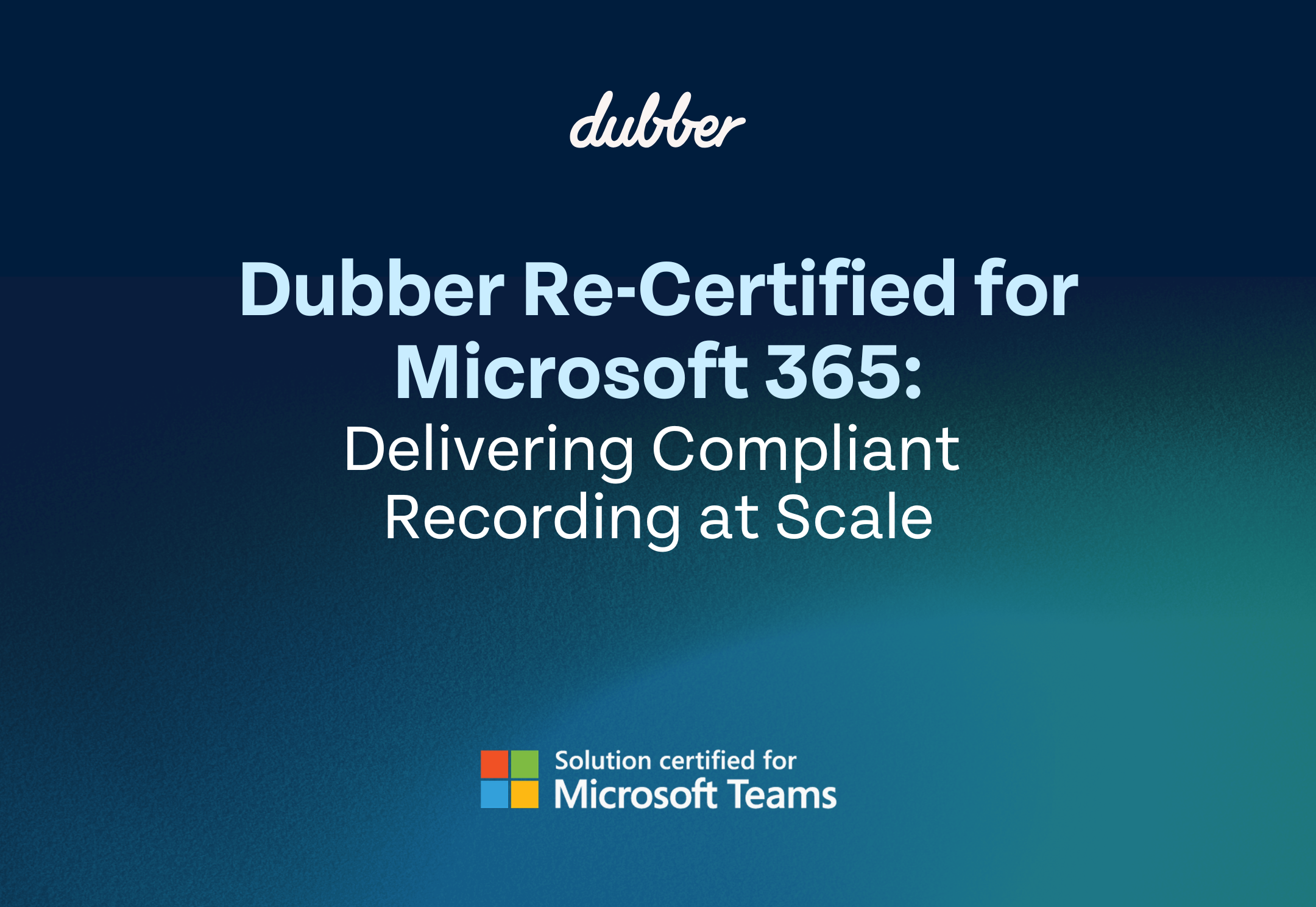
We are pleased to share that Dubber’s unified call recording solution for Microsoft Teams has once again achieved Microsoft 365 Certification!
This renewed certification reflects the deep integration of our voice recording and intelligence platform across the Microsoft ecosystem, showing to customers that our solution meets Microsoft’s high standards, while bringing enterprise-grade compliance, security, and high-performing recording to every call.
This Microsoft 365 Certification adds another layer of trust and transparency to Dubber’s communication technology platform. As part of the ongoing certification, a comprehensive, evidence-based audit confirms that Dubber continues to meet Microsoft’s stringent security, privacy, and compliance practices. It shows that our solution has been thoroughly tested and verified to work seamlessly and securely within the Teams environment, giving users peace of mind when capturing and retaining their critical business conversations. We are providing organizations using Dubber’s compliance call recording services in Microsoft Teams with the confidence that our application meets the requirements for third-party integration across the Microsoft 365 suite.
What This Means for Dubber Users:
Trust and Confidence: You’re using a solution tested by Microsoft.
Security First: Our platform meets Microsoft’s strict security, privacy, and compliance standards.
Easy Integration: Effortless deployment and performance across your Microsoft 365 and Teams environments.
Future-Proof Compliance: Stay ahead of global regulatory and business recording requirements.
This certification reflects our continual commitment to delivering compliant, secure, best-in-class, recording solutions to create smarter, future-ready experiences across the world’s most widely used communication platforms.
For more information on Dubber’s Trust & Security posture, visit our Trust Centre: https://trust.dubber.net/
For information about Microsoft’s certification process, visit: Microsoft Teams Compliance Recording Documentation. Or to learn how Dubber can support your business, email us at contactus@dubber.net.
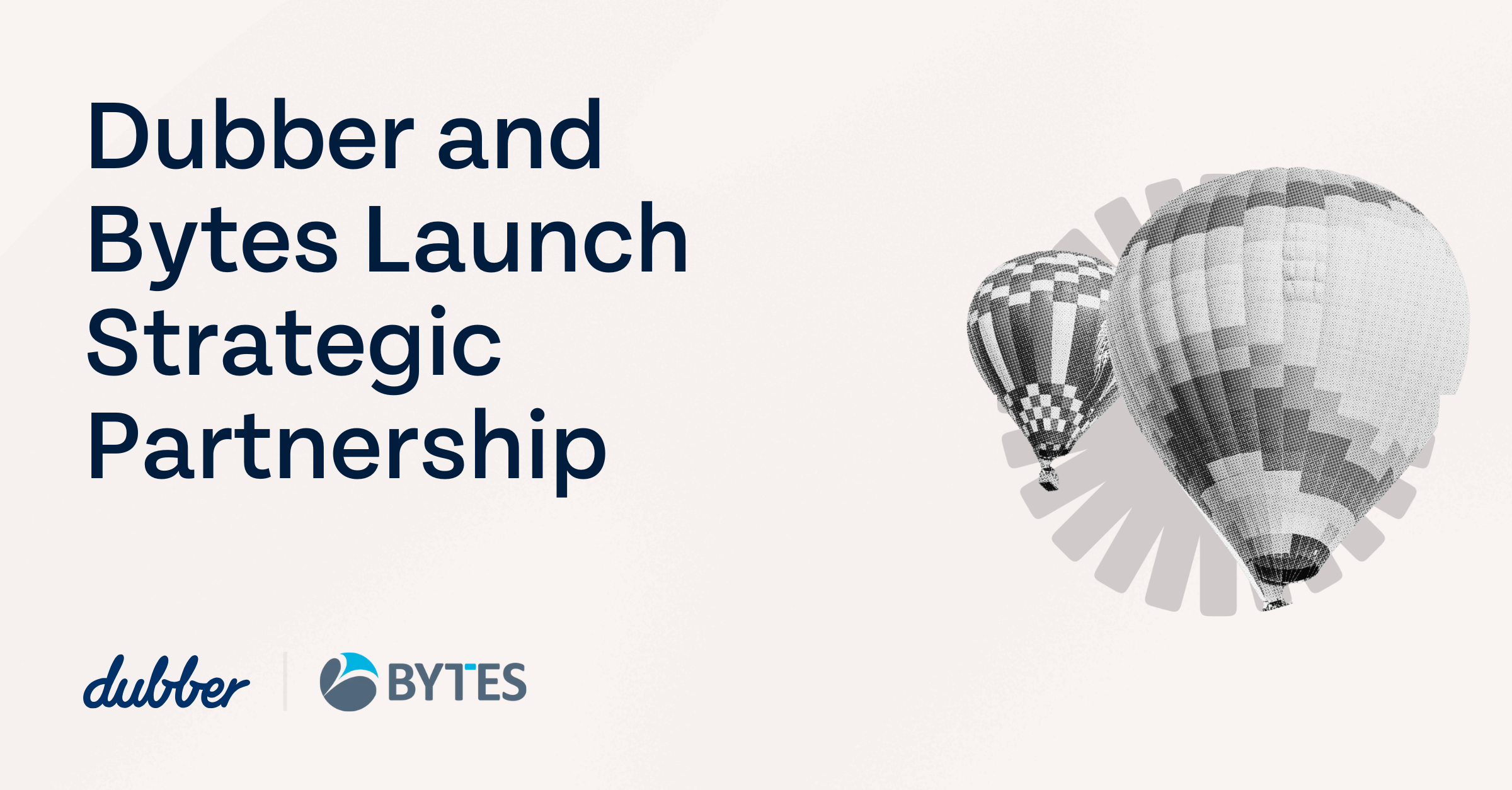
As part of Bytes’ Azure Marketplace expansion, Dubber is proud to join the Bytes Marketplace Hub as a flagship vendor. This partnership enables Bytes resellers to deliver advanced compliance, productivity, and customer experience capabilities to their clients, powered by Dubber’s AI-driven voice recording and intelligence solution.
Key Benefits for Customers:
Compliance & Security
- Dubber provides secure, compliant call and video recording across platforms like Microsoft Teams, Zoom, and Webex.
- Certified for major standards (GDPR, HIPAA, PCI DSS, MiFID II), making it ideal for regulated industries such as finance, healthcare, and government.
AI-Powered Insights
- Transforms conversations into actionable intelligence using patented AI (Dubber Moments).
- Features include sentiment analysis, topic detection, and trend monitoring to improve decision-making and customer experience.
Enhanced Customer Experience
- Enables personalisation at scale by analysing real customer interactions.
- Helps identify pain points and preferences, leading to faster resolutions and improved satisfaction.
Productivity & Sales Performance
- Tracks sales conversations, highlights missed opportunities, and identifies successful behaviours.
- Supports coaching and training with real-time insights, boosting conversion rates and revenue.
Employee Well-being & ESG
- Detects abusive or harmful language in real time, helping HR teams protect staff and maintain a safe work environment.
- Aligns with ESG goals by promoting respectful interactions.
Scalability & Flexibility
- Native cloud architecture offers unlimited scalability, rapid deployment, and no hardware requirements.
- SaaS pricing model with pay-as-you-go options for businesses of all sizes.
Integration & Ease of Use
- Seamlessly integrates with major UC platforms and CRMs.
- Available through Azure Marketplace, simplifying procurement for customers
“Our partnership with Dubber reinforces our commitment to bringing innovative solutions to our customer,” said Nathan Miller, Microsoft Program Manager at Bytes. “By combining Dubber’s industry-leading technology with our Microsoft expertise, we’re unlocking new opportunities for partners to drive value and growth.”
Giles Wake, VP Sales, EMEA at Dubber, added:
“We are thrilled to partner with Bytes, a renowned leader in the Microsoft ecosystem. By combining our AI-driven voice intelligence solutions with Bytes’ extensive channel expertise, we are empowering resellers to unlock new levels of compliance, productivity, and customer satisfaction. This partnership is a testament to our commitment to driving innovation and growth within the reseller community, and we look forward to the incredible opportunities it will bring.”
Together, Dubber and Bytes are helping partners deliver intelligent, value-driven solutions that transform how customers capture and use voice data.
For more information, see the full announcement or reach out at contactus@dubber.net
About Bytes
Bytes is a leading provider of cloud solutions, helping organisations unlock the full potential of digital transformation through innovative technology and expert support.
About Dubber
Dubber is a global leader in conversation intelligence and unified call recording, offering innovative, cloud-native solutions that transform voice data into actionable insights. Over the years Dubber has expanded its reach through partnerships with major communication service providers and enterprises worldwide. Its proprietary AI-driven platform captures, stores, and analyses conversations, delivering unparalleled value through enhanced compliance, customer experience, and business intelligence. Today, Dubber continues to innovate, empowering organisations to unlock the potential of their voice data and drive transformative outcomes across industries.
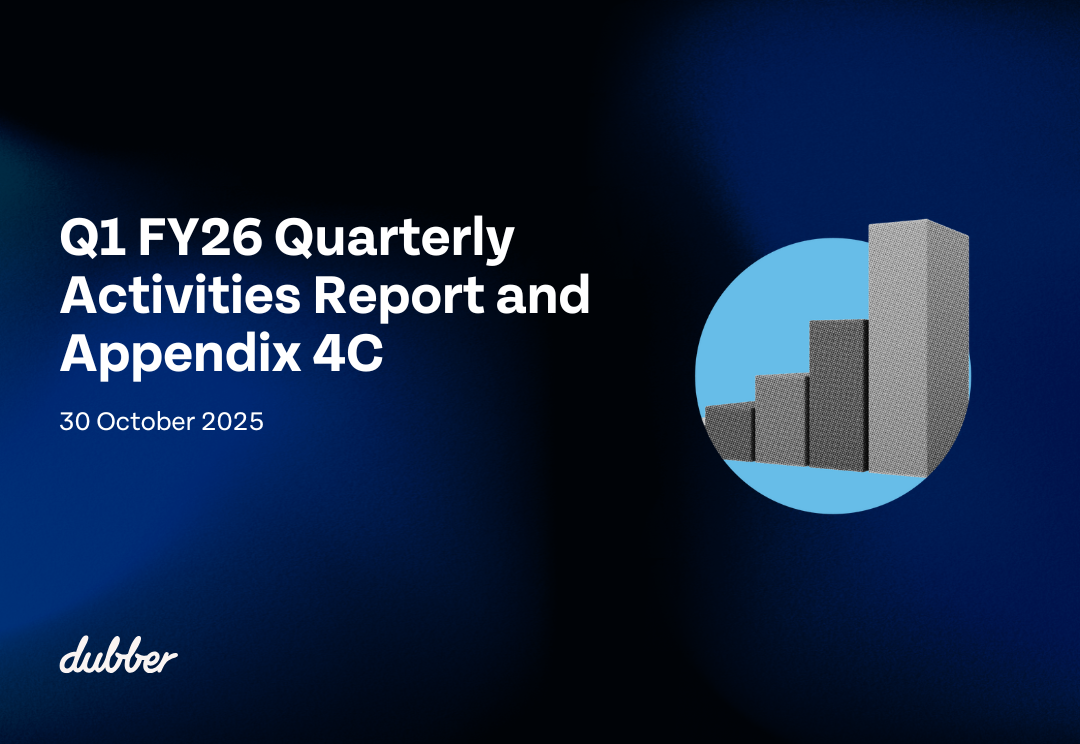
Melbourne, Australia: Dubber Corporation Limited (ASX:DUB) the leading conversation capture and intelligence platform for service providers and their customers globally, today released its Q1 FY26 quarterly report.
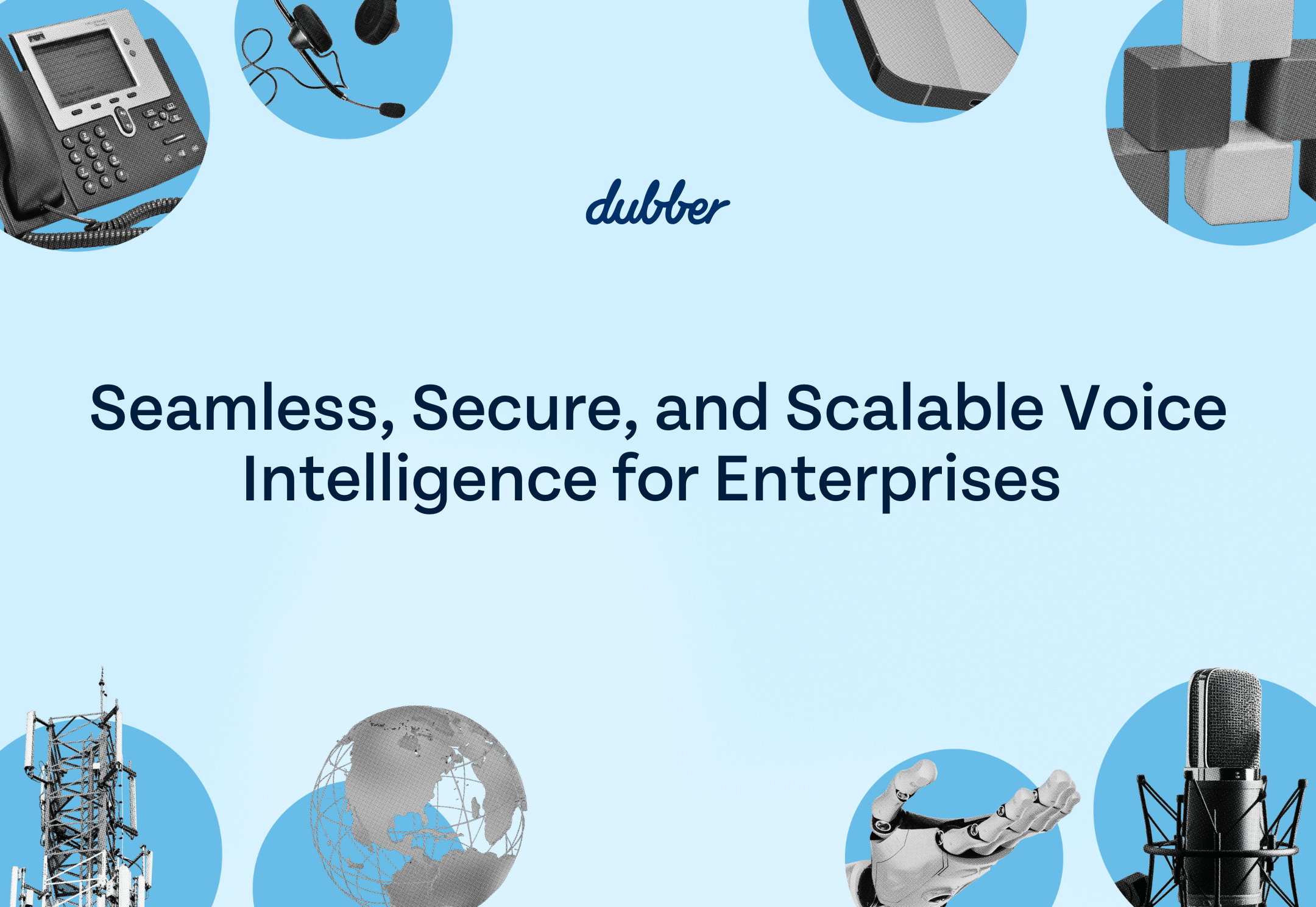
The Dubber Team has been busy attending partner events, and the same feedback is coming from across our global teams: enterprises are ready to find the value in their business conversations.
Across financial services, retail, healthcare, insurance, and other key industries, leaders are asking how they can capture, understand, and act on the interactions that drive their business. Many enterprises may see voice recording for compliance or record-keeping, but they’re now discovering that Dubber adds this and more. We transform voice data into actionable intelligence that is rich with insights about customers, performance, and opportunity.
Sales leaders can refine selling strategies and coach teams from top performing calls. Customer service and contact centres can identify opportunities or patterns before they escalate. Risk and compliance teams can trust that every conversation is secure and easily accessible for audits. Product and marketing teams can gain direct feedback from customer interactions for more efficient innovation and stronger messaging.
Dubber integrates natively with leading communication and collaboration platforms enterprises already use, such as Microsoft Teams, Cisco platforms and Zoom, delivering enterprise-grade intelligence without adding complexity or hardware. Our flexible deployments and deep integrations make it easy to embed conversation intelligence into existing workflows without disruption. The simplicity and scalability of Dubber is why our current enterprise customers trust us to record and analyse their conversations, turning them into valuable business intelligence. This intelligence is strengthening customer engagement, team performance, dispute resolution, compliance, and so much more.
We have been having great conversations with enterprise teams exploring how Dubber provides clear and immediate value across a range of markets. Enterprises are seeing how we help organisations improve customer experiences and give leaders the data they need to make strategic, growth-focused decisions.
To learn more or for information on industry-specific benefits and outcomes, email us at contactus@dubber.net
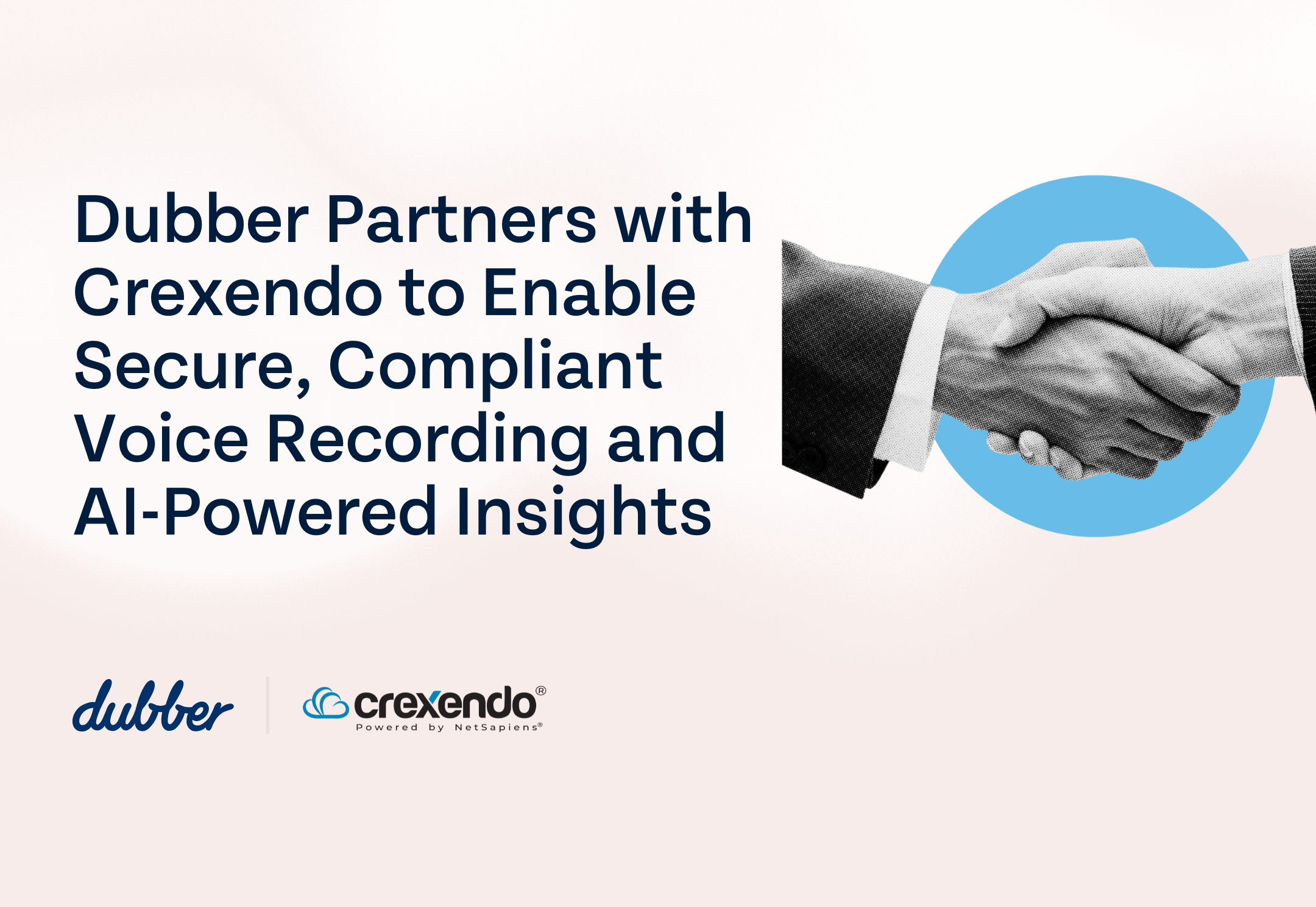
PHOENIX, ARIZONA / ACCESS Newswire / October 21, 2025 / Crexendo®, Inc. (NASDAQ:CXDO), an award-winning software technology company that is a premier provider of cloud communication platform software and unified communication as a service (UCaaS) offerings, including voice, video, contact center, and managed IT services tailored to businesses of all sizes, today announced that the company has added Dubber, a leading provider of multi-channel compliant voice recording and powerful AI insight solutions, as an Integration Partner into Crexendo’s NetSapiens Platform ecosystem .
Crexendo’s partnership with Dubber enables Crexendo platform licensees to offer secure, compliant call recording with Dubber’s own AI-powered solutions to their customers, unlocking additional revenue opportunities. Adding Dubber’s multi-channel voice recording and advanced conversation AI technology into the Crexendo platform allows end users to capture conversations across mobile, voice, messaging, and video all in one location for seamless access, analysis, and regulatory compliance across any industry. Dubber’s AI-powered conversation intelligence transforms every captured interaction into actionable insights that not only streamline business processes and surface key customer issues, but also deliver measurable improvements in customer experience, retention, and revenue growth.
“I’m thrilled about our partnership with Dubber, and the innovations in our platform to come as a result.” said Jeff Korn, Chairman and CEO of Crexendo. “The Crexendo platform is continually evolving with the integration of the latest cloud communications technology. With Dubber’s advanced solutions integrated with the NetSapiens Platform, our licensees gain access to a suite of conversation capture and analysis tools they can offer their customers to increase revenue. The addition of secure, compliant call recording and AI-driven data insights brings real business value to our customer base of over 6 million end users globally. Incorporating new innovations like these into our platform continues to rapidly increase AI adoption by businesses of all sizes.”
Matthew Bellizia CEO and Managing Director of Dubber says, “Crexendo customers will now have access to not only our compliant call recording but also to a wide range of AI-powered products that drive immediate business outcomes, from helping sales teams identify areas for improvement, to driving customer retention by addressing key complaints, and all while supporting a compliant HR environment. We are excited by the partnership and working closely together with Crexendo to achieve mutual success for our businesses and end user customers”.
Crexendo will share additional information on the Dubber partnership and the EVP Program at their annual User Group Meeting (UGM), taking place in Miami in late October, where the industry’s leading service providers and technology partners come together to shape the future of cloud communications.
Through the Crexendo EVP Ecosystem, service providers gain access to industry-leading partners who drive innovation and reinforce flexibility, reliability, and growth. By uniting solutions that complement Crexendo’s portfolio, the program empowers providers to deliver greater customer value while accelerating success in competitive markets. With every addition to the EVP Ecosystem, Crexendo continues to raise the standard for innovation and provider choice.
About Crexendo
Crexendo, Inc. is an award-winning software technology company that is a premier provider of cloud communication platform and services, video collaboration and managed IT services tailored to businesses of all sizes. Our solutions currently support over six million end users globally, through our extensive global network of over 235 cloud communication platform software subscribers and our direct retail offering. For more information, please visit www.crexendo.com.
About Dubber
Dubber is a global leader in conversation intelligence and unified call recording, offering innovative, cloud-native solutions that transform voice data into actionable insights. Over the years Dubber has expanded its reach through partnerships with major communication service providers and enterprises worldwide. Its proprietary AI-driven platform captures, stores, and analyses conversations, delivering unparalleled value through enhanced compliance, customer experience, and business intelligence. Today, Dubber continues to innovate, empowering organisations to unlock the potential of their voice data and drive transformative outcomes across industries.
SOURCE: Crexendo, Inc.
For questions about this partnership, email contactus@dubber.net.
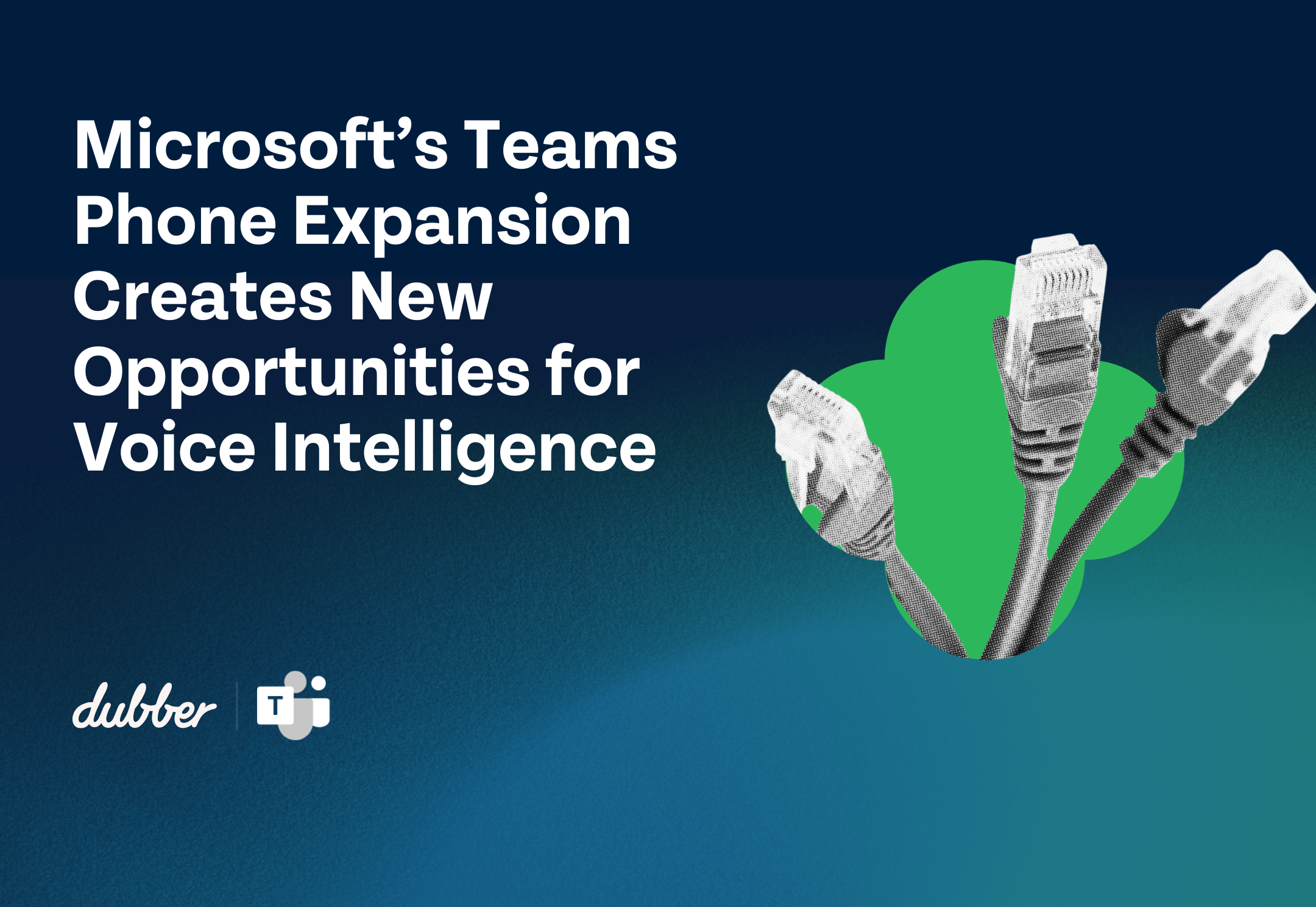
Microsoft has taken another major step in modernizing how organizations engage with customers by bringing together communications and contact center capabilities in a more unified, scalable way.
With the announcement of Teams Phone extensibility for Dynamics 365 Contact Center, businesses can now deliver seamless, high-quality customer experiences using the same platform they rely on internally.
Traditionally, contact centers (CCaaS) and internal business communications (UCaaS) have been kept separate, powered by different technologies and managed by different teams. This could mean inefficiencies, extra infrastructure, integration issues, and missed opportunities to capture voice insights across conversations. With Microsoft’s latest announcement, the entire organization, from back office to frontline representatives, can operate on a single, unified, and cloud-native platform.
What This Means for Dubber, Our Partners, and Customers
We’ve always believed that every conversation holds hidden value and now, with the convergence of UCaaS and CCaaS inside Microsoft’s ecosystem, it becomes even more accessible. As a trusted Microsoft partner and leading platform for voice intelligence, we’re positioned to help customers find that value across every part of their business, with smarter compliance, seamless user experiences, and powerful insights from every conversation.
With Teams Phone extensibility for Dynamics 365 Contact Center now available, businesses can use Dubber to record and analyse conversations from both contact center agents and internal Teams users. It’s fully compliant, works natively with Microsoft Teams, and supports all telephony models including Calling Plans, Direct Routing and Operator Connect.
Additionally, Dubber is immediately available in the Microsoft Commercial Marketplace, making it easier than ever to deploy and scale our solution. Customers can also leverage their Microsoft Azure Consumption Commitment (MACC) to purchase Dubber licenses, simplifying procurement and maximising the value of their existing Microsoft investments for advanced voice intelligence.
To learn more or for any questions, email us at contactus@dubber.net.
Read the full article from Microsoft: https://www.microsoft.com/en-us/dynamics-365/blog/it-professional/2025/09/03/teams-phone-extensibility-for-dynamics-365-contact-center-generally-available/

Download the FY25 Investor Update below.
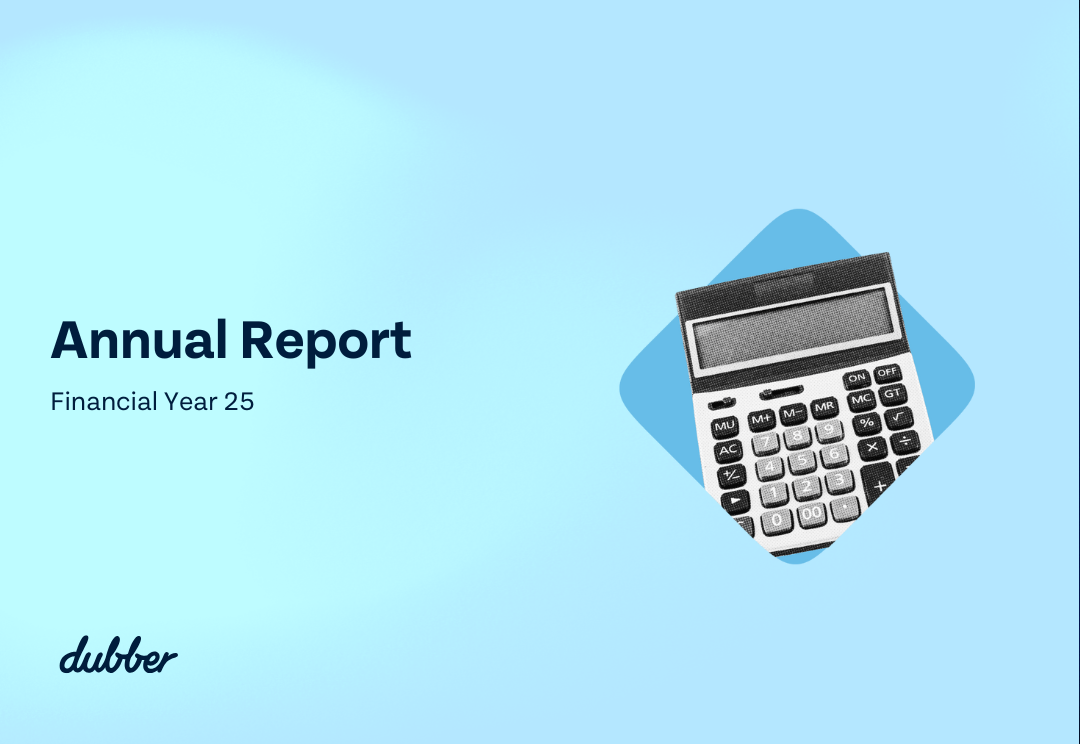
Melbourne, Australia: Dubber Corporation Limited (ASX:DUB) the leading conversation capture and intelligence platform for service providers and their customers globally, today released its FY25 Annual Report.
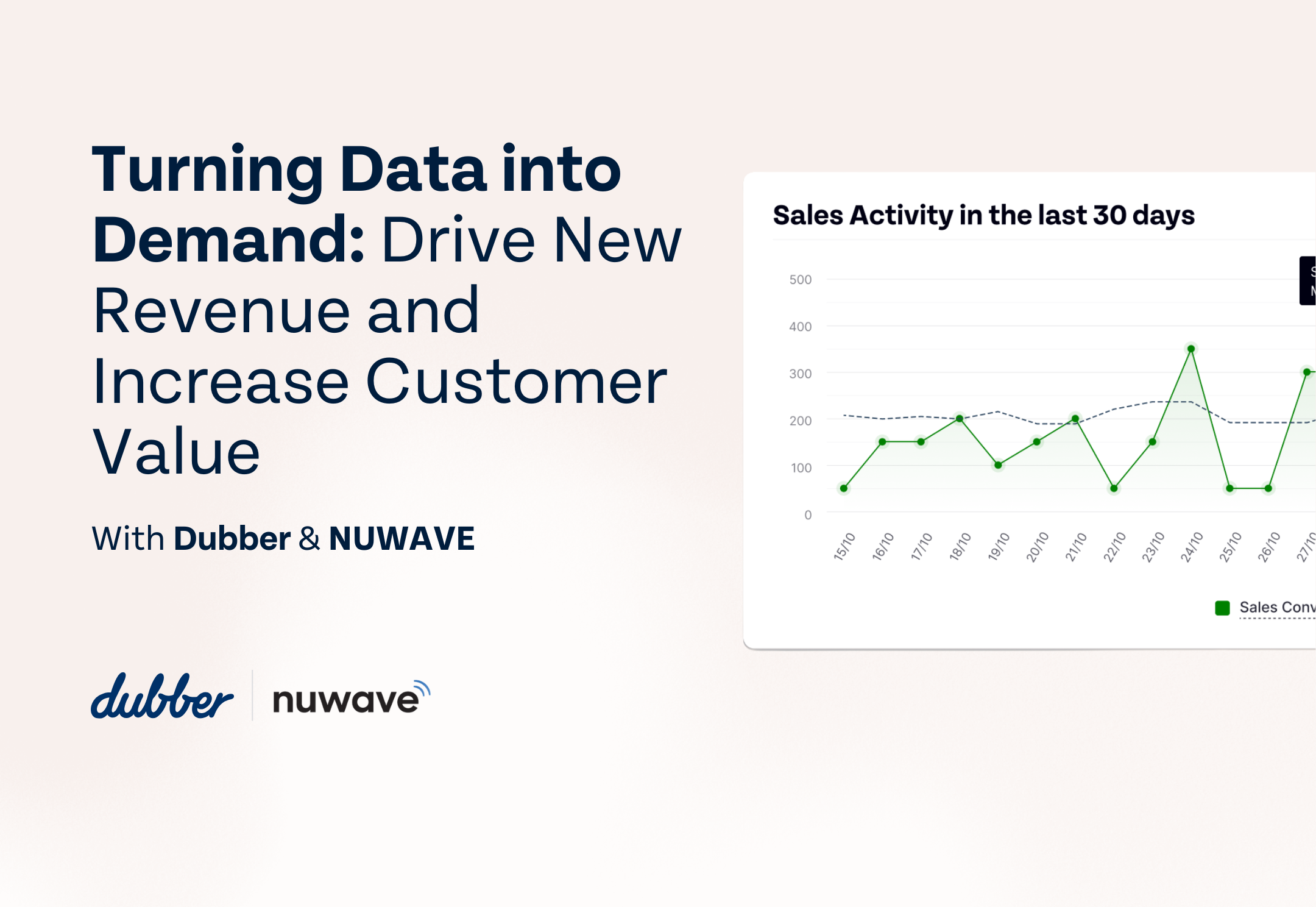
Last week, sellers across the channel joined NUWAVE Communications and Dubber for a webinar focused on finding new revenue streams and delivering greater customer value through powerful voice intelligence. As trusted innovators in cloud communications and voice data intelligence, NUWAVE and Dubber are reshaping how partners sell, differentiate, and grow in an increasingly competitive UC market.
During the session, Adrian Di Pietrantonio, Co-Founder & EVP, Global Strategy & Growth at Dubber, and Travis Burris, Vice President of Global Channels and Alliances at NUWAVE Communications, shared how our partnership is delivering high-value, ready-to-sell solutions that capture and analyze conversations across platforms like Teams, Webex, and Zoom. Dubber’s voice intelligence is fully integrated across these multi-UC platforms and can be easily provisioned via NUWAVE’s iPILOT, ensuring seamless, efficient deployment for partners.
By turning voice into structured, compliant, AI-enriched data, sellers now have a way to offer customers something different: actionable insights, automated compliance, and real business intelligence embedded directly into the platforms they’re already using.
When partners are empowered and equipped with these capabilities, they can find new revenue streams with minimal complexity through intuitive, ready-to-deploy solutions that solve real business problems and drive increased customer engagement and growth.
This is how data becomes demand.
If you’d like a copy of the full webinar recording or want to explore how to activate Dubber through NUWAVE’s iPILOT plaform, contact us here.
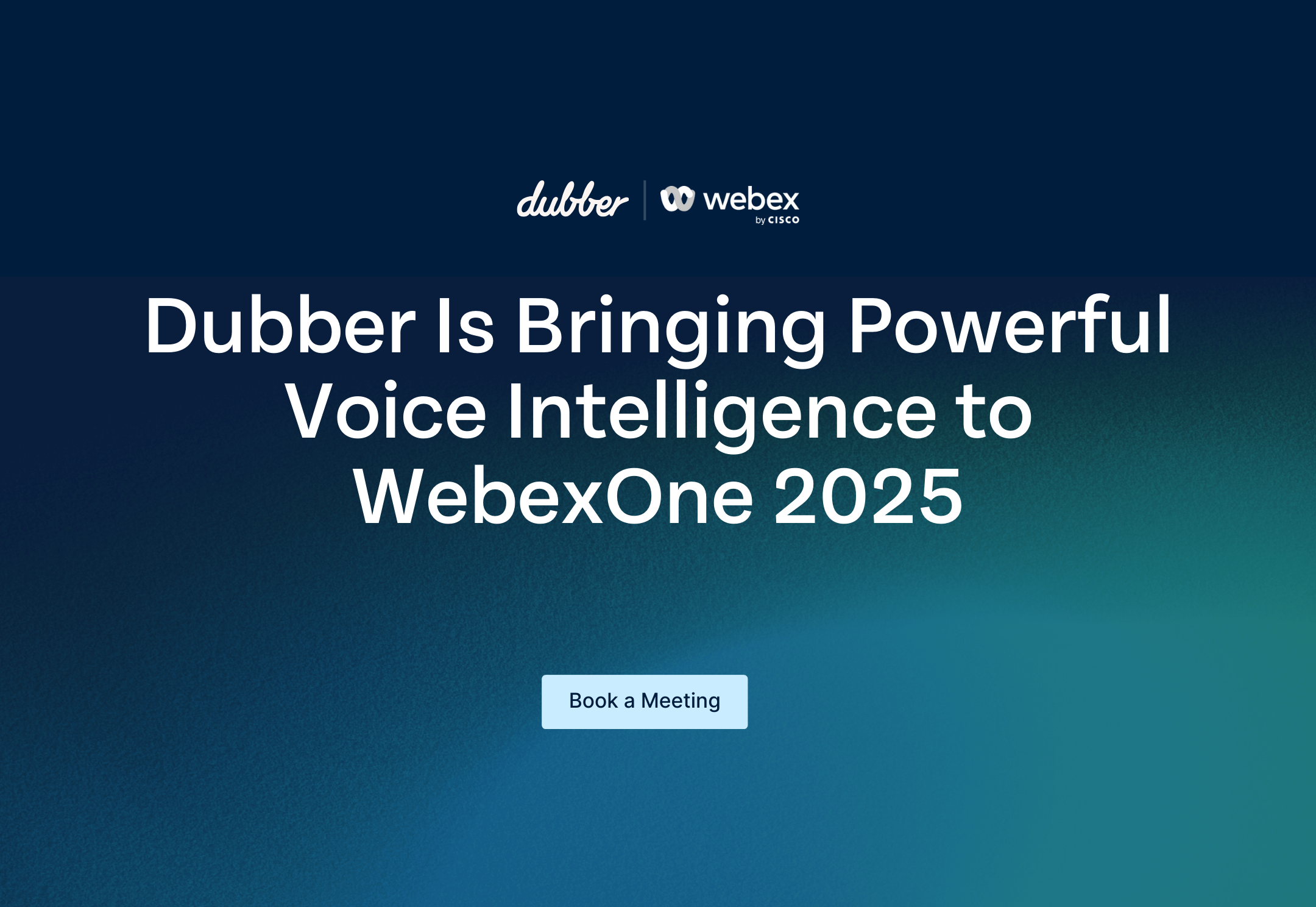
Dubber is excited to be sponsoring WebexOne 2025! As a proud Cisco partner and the leading platform for Voice Intelligence, join us at Booth B11 where we will be showcasing how together Dubber and Webex are working to bring even more AI-powered capabilities to Webex Calling.
How Dubber and Webex Calling Work Together
With over 16 million users worldwide, Webex Calling is transforming how businesses communicate, and Dubber is supporting this.
Dubber is embedded into Webex Calling and once enabled, every spoken word is automatically analysed, structured, and made accessible in ways that create real and immediate business value:
- Real-time transcription and sentiment analysis
- Automated compliance for regulated industries
- Coaching and performance insights for contact centres
- Customer experience trends and dispute resolution
- Zero infrastructure, Dubber is native to Webex
With a powerful, secure and compliant platform, we guarantee that your conversations are captured, retained, and auditable with region-specific policies, access controls, and security. Our intelligence works effortlessly in the background, allowing your business to focus on growth and customer experience by revealing the patterns, emotions, and risks within every interaction.
Built into Webex with zero infrastructure required, Dubber is provisioned directly from Control Hub, activated per user or group, and instantly begins capturing and analysing conversations across your Webex Calling environment.
Whether your focus is sales intelligence, customer intelligence, or employee performance, we are helping businesses find more value in voice.
Let us show you how!
Visit us at WebexOne 2025 at Booth B11 from 29 September-1 October.
See a demo, explore what’s coming next, and talk to our team about how Dubber can start delivering immediate value.
Want to book in time with the team? Email us at cisco@dubber.net

In a recent episode of The AI Edge Podcast, Michael Weeding, Global Director of Product at Dubber, sat down with Tony Spelde, CTO of Microsoft’s Asia Digital Natives Team, to discuss how together we’re redefining the future of voice and conversation data with powerful and responsible AI.
Dubber’s AI-powered Moments technology is revolutionising the way businesses find value in everyday interactions. Unlike traditional solutions that focus on productivity metrics, Michael explains how our technology focuses on capturing and analysing key moments within conversations. Businesses gain more than just data, they capture real-time insights from voice, chat, and messaging conversations across platforms like Microsoft Teams to drive improvements in sales, customer experiences, and employee wellbeing.
The conversation also discusses our partnerships with Microsoft Teams and Azure, and how responsible AI principles are built into our technology, ensuring the insights businesses rely on are traceable, actionable, and compliant with evolving regulations.
Looking ahead, Michael shares Dubber’s vision of scaling the solution and expanding our integrations with platforms such as Microsoft Copilot to support more businesses extracting meaningful insights.
Listen to the full conversation:
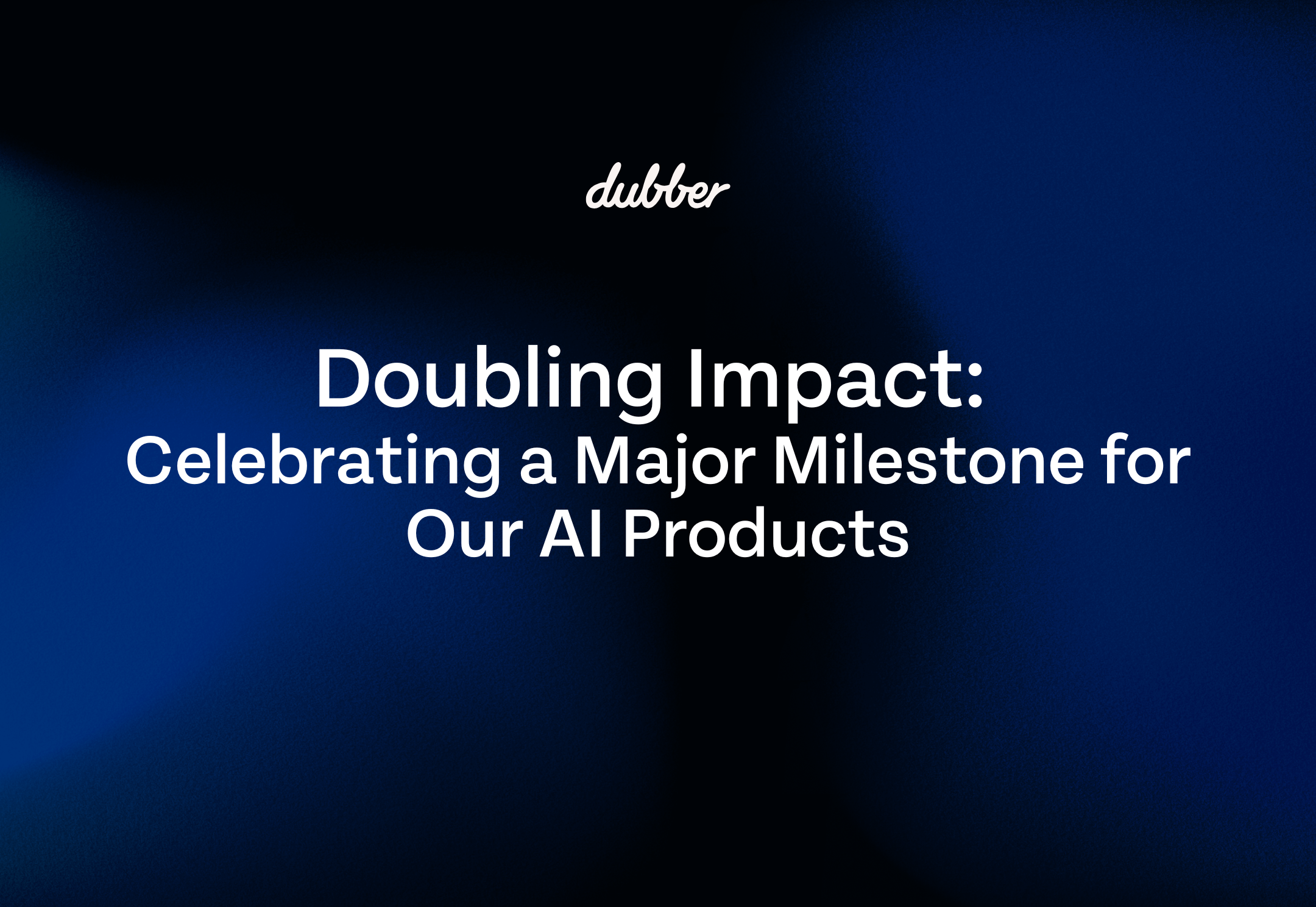
This week at Dubber, we reached an exciting milestone worth celebrating.
Over the past year, the number of calls processed on Dubber’s global AI platform has more than doubled. This growth is a reflection of the increasing trust our Partners and their customers around the world have in our solutions.
At the heart of this achievement is something simple but powerful: helping real people, not bots, deliver better service. Every day, our Sales & Customer Experience Insights are enabling and empowering frontline teams to understand their customers more deeply, respond with empathy, and build stronger connections that drive loyalty and business performance.
For us, this milestone isn’t just about scale, it’s about impact. Doubling call processing means doubling the opportunities to improve conversations, strengthen relationships, and transform the way businesses serve their customers.
And we’re only just getting started. With our talented AI Product team driving new capabilities set to roll out soon, our entire team is focused on accelerating this impact even further, giving businesses smarter tools, deeper insights, and the confidence to put people at the centre of every interaction.
A huge thank you to our customers, partners, and team who made this possible. Here’s to doubling down on the future of conversation intelligence.
For any questions or more information about Dubber’s AI platform, connect with us here contactus@dubber.net
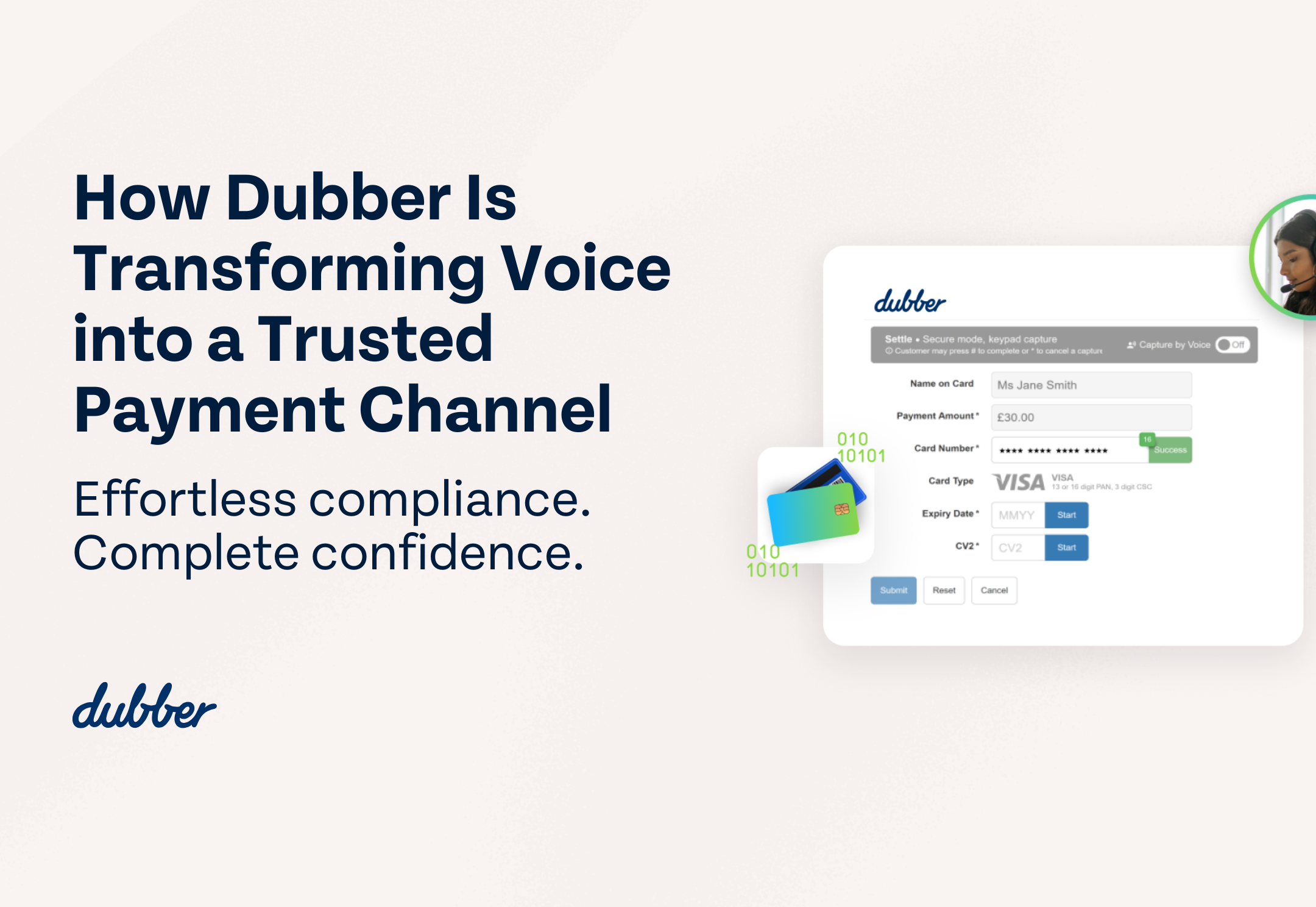
Dubber is changing the way businesses accept payments by turning voice communications into secure and trusted payment channels that customers can rely on.
As eCommerce and digital checkouts advance, traditional phone payments can be inefficient, insecure, or non-compliant in many organisations. By enabling compliant and real-time transactions within conversations, Dubber turns voice into a trusted, intelligent payment channel across networks, platforms, and regions.
The Problem with Traditional Phone Payments
- Manual processes expose sensitive card details to risk
- IVRs and redirects frustrate customers and slow transactions
- Compliance (like PCI DSS) becomes expensive and complex
- Payment data is siloed from business systems
The Dubber Solution
Dubber Payments empowers businesses to accept payments directly within live conversations, on calls, video meetings, and across telecommunication networks. It’s a fully PCI-compliant solution that works across platforms like Microsoft Teams and Webex Calling, without exposing sensitive payment information to agents or internal systems.
We offer three secure and compliant payment methods:
- Agent Pay: Collect payment details during calls without interrupting the conversation or putting customers on hold, using a safe and automated process.
- Pay-By-Link: Send customers a payment link via SMS, email, or directly on a webchat session, with extra protection through customer security authentication.
- IVR (Interactive Voice Response) Assist: Integrates with existing IVR platforms to capture and protect payment card data entering the business environment, using the same secure integration with the payment service provider as the agent pay service. It works in touch tone and speech enabled modes, without the need to switch vendors or go through costly system changes.
To further protect sensitive data, Dubber’s AI-powered redaction technology automatically removes payment details (such as card numbers, CVVs, and personally identifiable information) from call recordings and transcripts for increased privacy and compliance.
Whether businesses are handling payments in contact centers, on-site or with remote teams, Dubber Payments improves transaction efficiency and builds greater customer trust.
If you have any questions or would like to learn more about Dubbers Payments, connect with us at contactus@dubber.net.
Please note that Dubber Payments is currently only available in the UK.
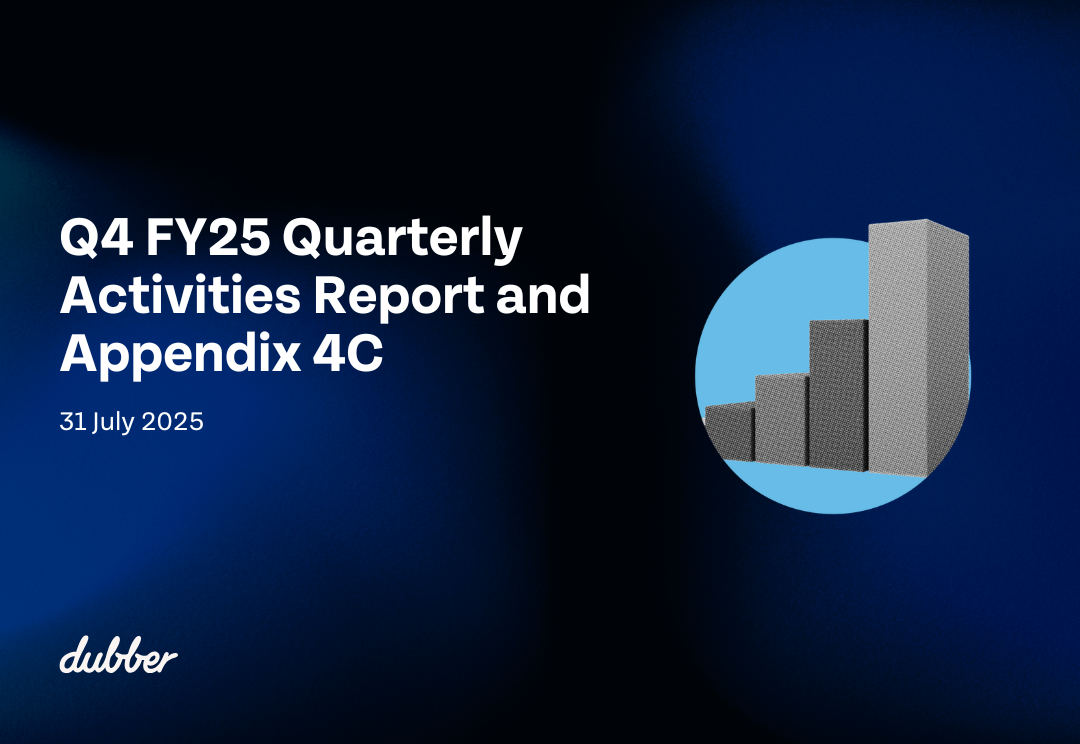
Melbourne, Australia: Dubber Corporation Limited (ASX:DUB) the leading conversation capture and intelligence platform for service providers and their customers globally, today released its Q4 FY25 quarterly report.
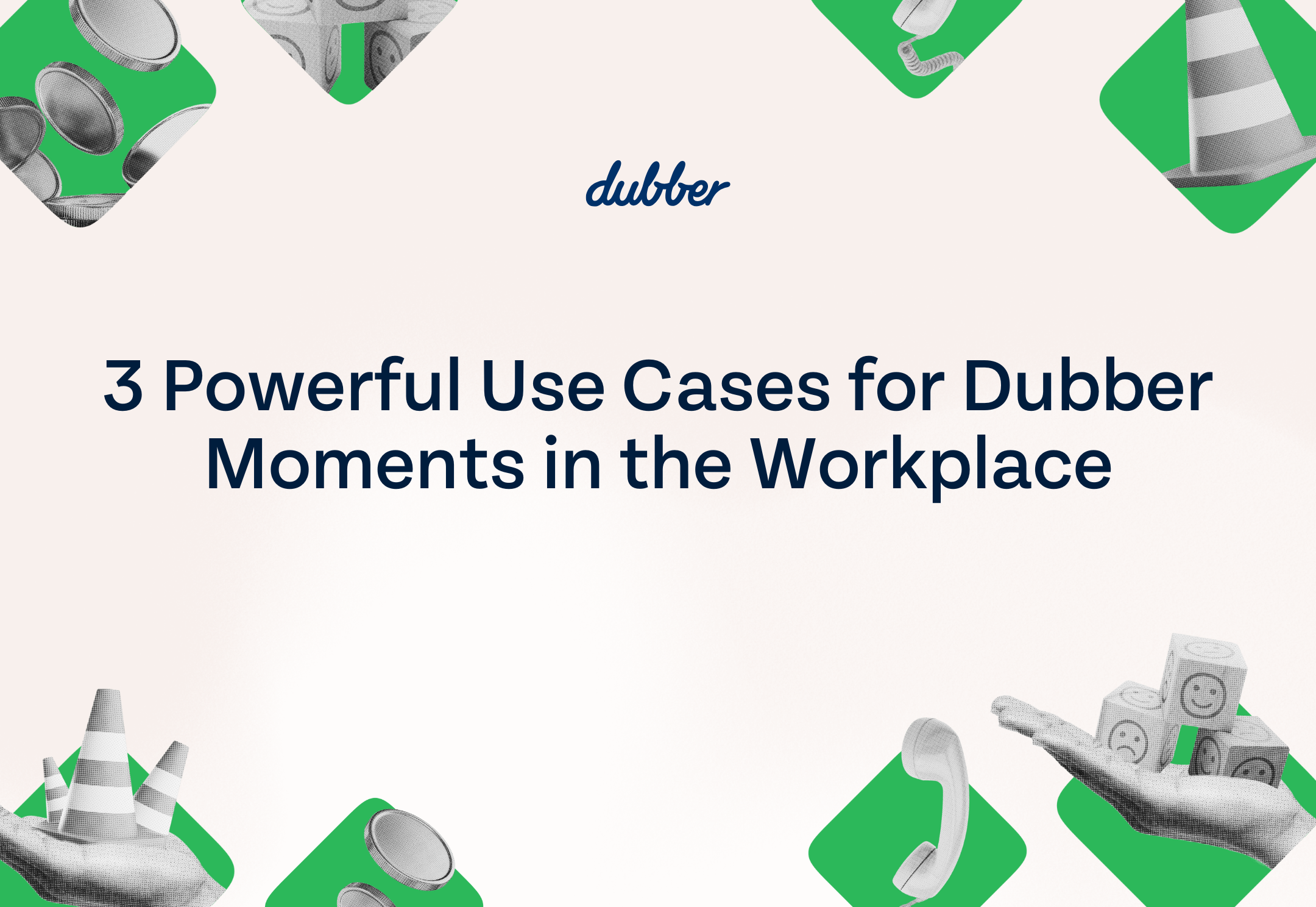
Dubber Moments, powered by advanced and patented AI, transforms every conversation into immediate and actionable insights that help teams perform at their best. Whether you’re leading people, making sales, or supporting customers, Dubber turns voice data into valuable intelligence that drives organisation-wide growth and success.
Here’s how three different roles are using Dubber Moments:
1. Chief People Officer: Protect Employees and Customers
As ESG policies shape corporate responsibility, companies are focusing on employee wellbeing and respectful customer interactions. With Dubber, they can automatically detect abusive or harmful language in real-time. This empowers HR and People teams to respond to incidents quickly, support employees effectively, and build a culture of safety and accountability, all while meeting compliance requirements.
Dubber Moment: Abuse
2. Chief Revenue Officer: Improve Sales Performance
Sales leaders have a clear need to invest in initiatives that improve the effectiveness and efficiency of their teams in reaching sales goals and targets. Dubber helps them understand what closes deals and where opportunities are being lost, giving them the clarity to act with confidence. By identifying the key moments, phrases, and behaviours that lead to a successful close across every sales rep and call, leaders can replicate best strategies, improve training and coaching, measure performance, and increase conversion rates and revenue.
Dubber Moment: Sales Close
3. Head of Customer Service: Easily Resolve Complaints
Effectively capturing and addressing complaints heard by customer service teams is important for delivering exceptional service that protects brand reputation and customer loyalty. Dubber automatically identifies and categorises complaint topics and trends across every call, providing real-time insight into challenges customers face. This gives teams the ability to resolve complaints faster and reduce back-up, but also to find underlying product or service issues. By acting on these insights, businesses can improve their offerings and strengthen the overall customer experience to build lasting relationships.
Dubber Moment: Complaints
Have questions or want to see Dubber Moments in action? Get in touch with us here: contactus@dubber.net.
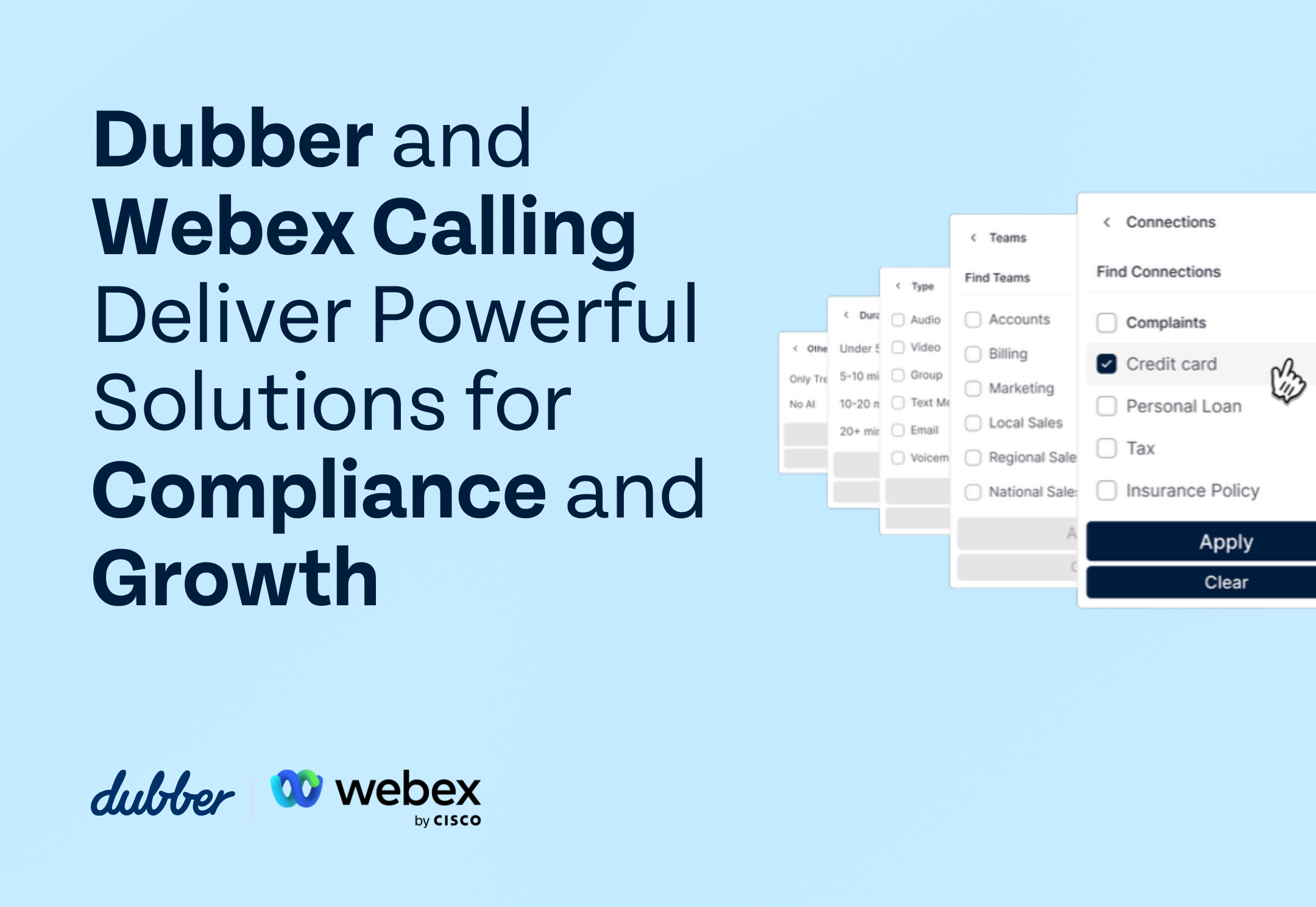
Cisco’s Webex Calling already offers a secure, reliable, and scalable platform for businesses to connect. However, when paired with Dubber, it becomes a powerful tool to generate and utilize actionable insights from every voice, video, and chat conversation.
Together, we’re changing how financial services (and other regulated industries) engage with clients and manage operations. Dubber’s cloud-native and scalable solution is integrated seamlessly with Cisco Webex Calling, providing an all-in-one way for organizations to capture and analyze every interaction in real-time to strengthen client interactions, meet regulatory adherence, and improve efficiencies.
Dubber’s Value for Webex Calling Users in Financial Services
Ensure Regulatory Compliance: Automatically capture and store all client interactions to meet critical financial regulations and simplify audits.
Real-time Risk Mitigation: Instantly flag and action non-compliant behaviors, such as unsuitable product recommendations or misleading statements.
Generate Revenue: Identify upselling and cross-selling opportunities during client conversations.
Strengthen Client Trust and Satisfaction: Address client concerns by understanding sentiment and key issues for a more personalized service experience.
Want to learn how financial services can deliver exceptional value in an increasingly complex regulatory landscape?
Join our upcoming webinar on Tuesday 22nd July, 2025 to see how Cisco’s Webex Calling and Dubber are revolutionizing compliance and operations for financial services and beyond.
Register for the webinar here
For any questions contact us here: contactus@dubber.net.
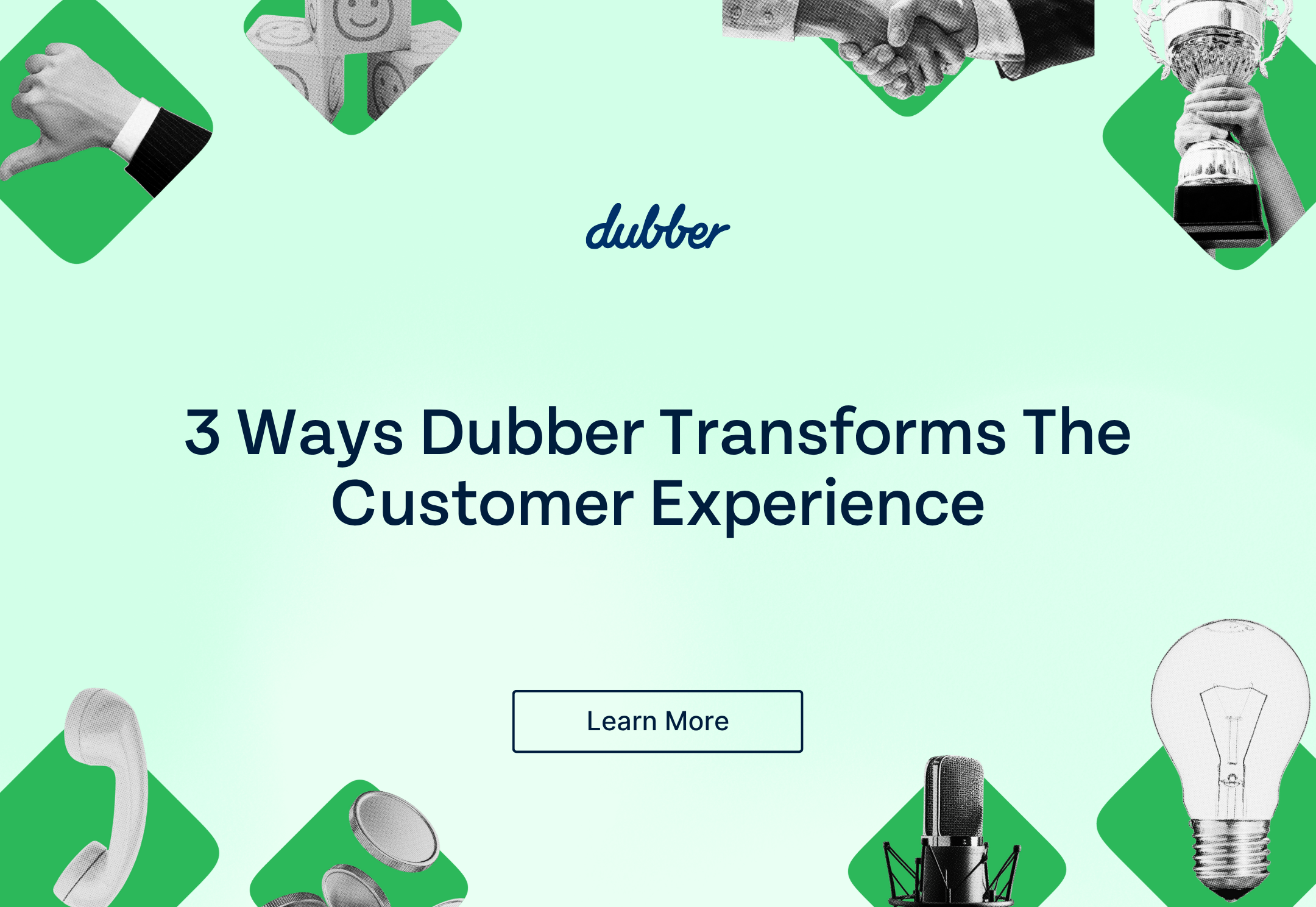
Smart, secure, and insightful communications help deliver exceptional service for businesses and their valued customers. At Dubber, we are redefining how industries engage with the people they serve by capturing and analysing conversations in real time to provide powerful opportunities to improve service, build trust, and gain a competitive edge.
3 Ways Dubber is Transforming the Customer Experience:
Better Care for Healthcare Patients
In healthcare, clear and compliant communication can be the difference between a positive outcome and a mistake. It’s not just about operational efficiency, but protecting patients and ensuring they feel heard, understood and safe.
The result? Healthcare professionals can review details and reduce miscommunication, for more accurate and personalised care, stronger patient trust, improved health outcomes.
Building Trust and Transparency in Financial Services
Clients expect transparency, security, and professionalism at every touchpoint in financial services. With Dubber, firms can automatically capture and store calls, video meetings, and messages across all platforms, creating a complete, compliant record of every interaction.
The result? Strengthened client trust through a clear commitment to accountability, leading to stronger relationships and better alignment of products and services with their needs.
Personalisation at Scale in Retail
Dubber gives retailers access to rich insights from real customer conversations, helping teams deliver personalised experiences. By capturing interactions across voice and digital channels, businesses can identify patterns, preferences, and pain points in real time. This allows for faster resolutions, more relevant recommendations, and a tailored customer experience.
The result? Stronger customer satisfaction, increased loyalty, repeat business, and a competitive edge in a saturated market.
Regardless of industry, Dubber supports communications to become an opportunity to listen better, act smarter, and deliver more value to customers.
For any questions, contact us here: contactus@dubber.net
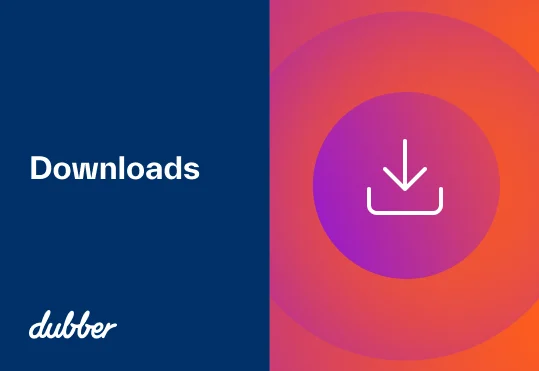
Corporate Governance Statement
As at 30 June 2025 and approved by the board.
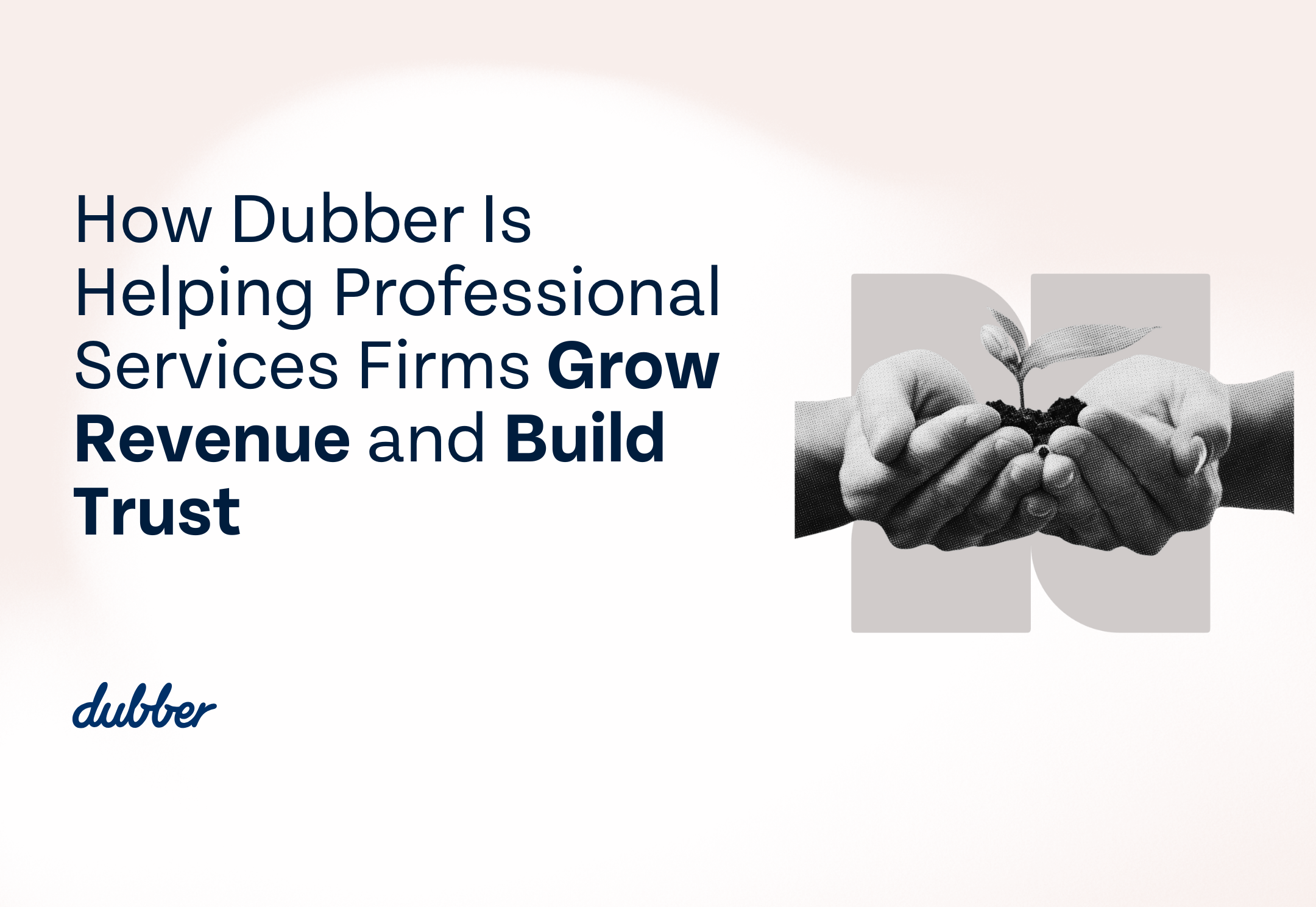
With the professional services industry such as legal, consulting and accounting firms heavily trading on expertise and knowledge, success and business growth can depend on leveraging every conversation. Dubber is supporting these firms to capture interactions and, using advanced and powerful AI, turn them into immediate, actionable and measurable business insights.
Protect Revenue Growth
Dubber provides an indisputable record of client conversations that helps firms make sure billable time is accurately captured and disputes are quickly resolved.
By keeping track of all interactions, businesses can reduce revenue leakage, find missed sales opportunities, ensure advice or product offerings are tailored to each client’s needs, and strengthen financial performance to position themselves for sustained business growth.
Minimise Compliance Risk
Professional services operate under strict regulatory requirements, and Dubber helps minimise the risk of non-compliance by ensuring every conversation is securely stored in line with industry-specific regulations and global data standards.
By recording calls, video meetings, and messages, in a compliant, searchable format, we make it easy to retrieve audit-ready records for compliance reviews, accelerate dispute resolution and lower the risk of penalties and reputational damage.
Improve Client Trust and Retention
Clear and documented conversations build client confidence and reduce misunderstandings. By automatically tracking commitments, identifying missed actions, and providing proactive follow-up, firms can improve accountability and deliver a consistent client experience that drives satisfaction and long-term loyalty.
Spend less time documenting and more time delivering exceptional client outcomes. To learn more, contact us here: contactus@dubber.net
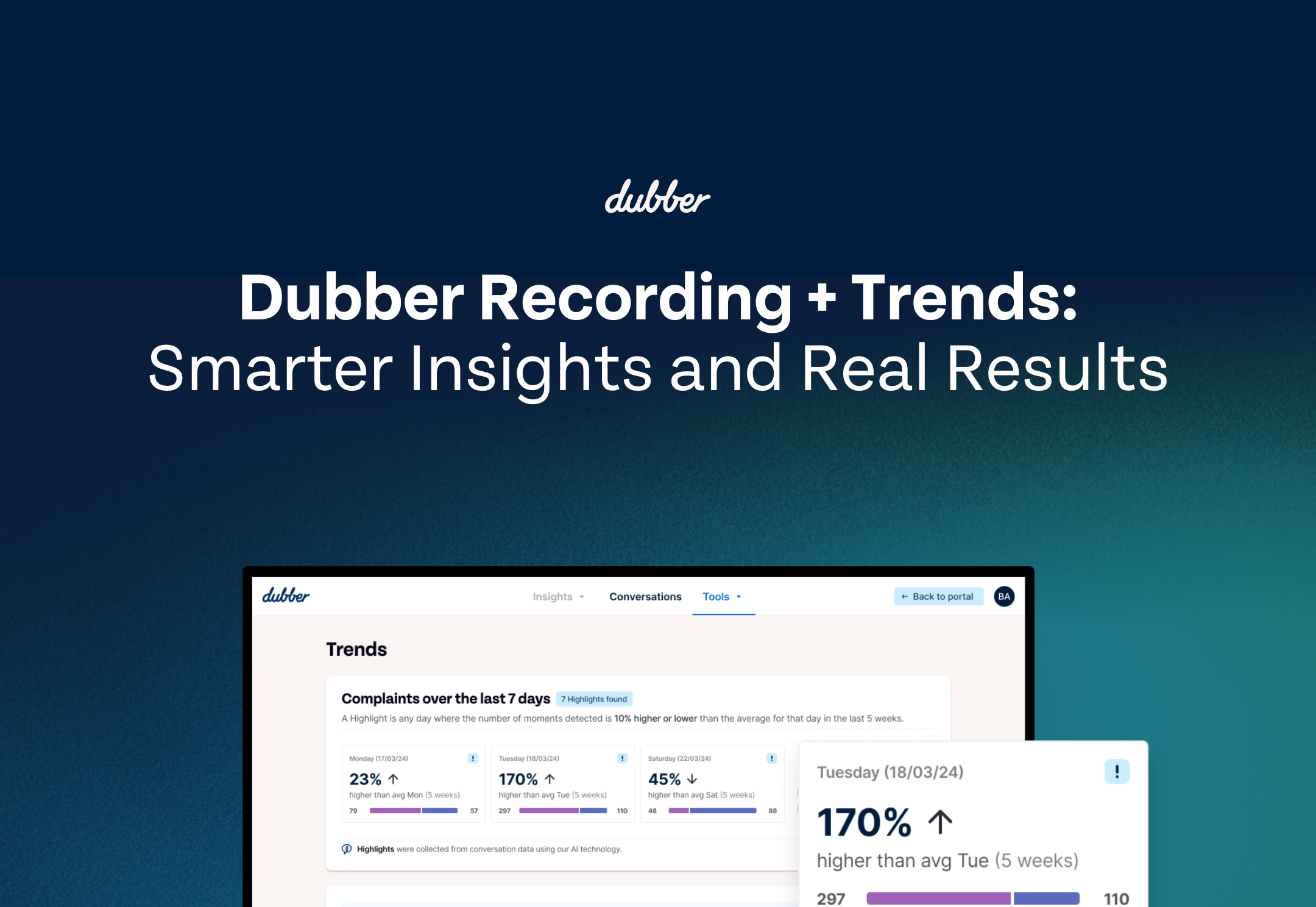
Helping Businesses Realise the Power of AI
The real challenge for businesses today? Unlocking the true value of embedding AI into their day-to-day. That’s why we created Trends, it’s like a tasting plate for conversation intelligence, giving our partners an easy way to showcase just how much insight can be uncovered from everyday conversations.
The response has been incredible, so much so that we’re now adding even more to the smorgasbord of value! When you add Trends to Dubber Recording, you now also get conversation summaries and sentiment insights on the house. More value, more flavour, more reasons to dig in and a better chance of driving upsell to higher value products and increased revenue.
Key Features of Dubber Recording + Trends:
Conversation Summary
Our AI automatically summarises your conversations, making it easy to quickly grasp the key points and understand what matters most.
Transcription
Get complete visibility with a full, searchable transcript of the entire conversation.
Highlights
Reveal key business trends across all conversations with powerful insights from one of our Dubber Moments.
Working closely with our partners, we’ve brought this to market to make conversation intelligence available to businesses of any size. And it’s working, we are seeing strong uptake, as global teams are using Dubber Trends to respond faster, make informed decisions, and find new revenue opportunities.
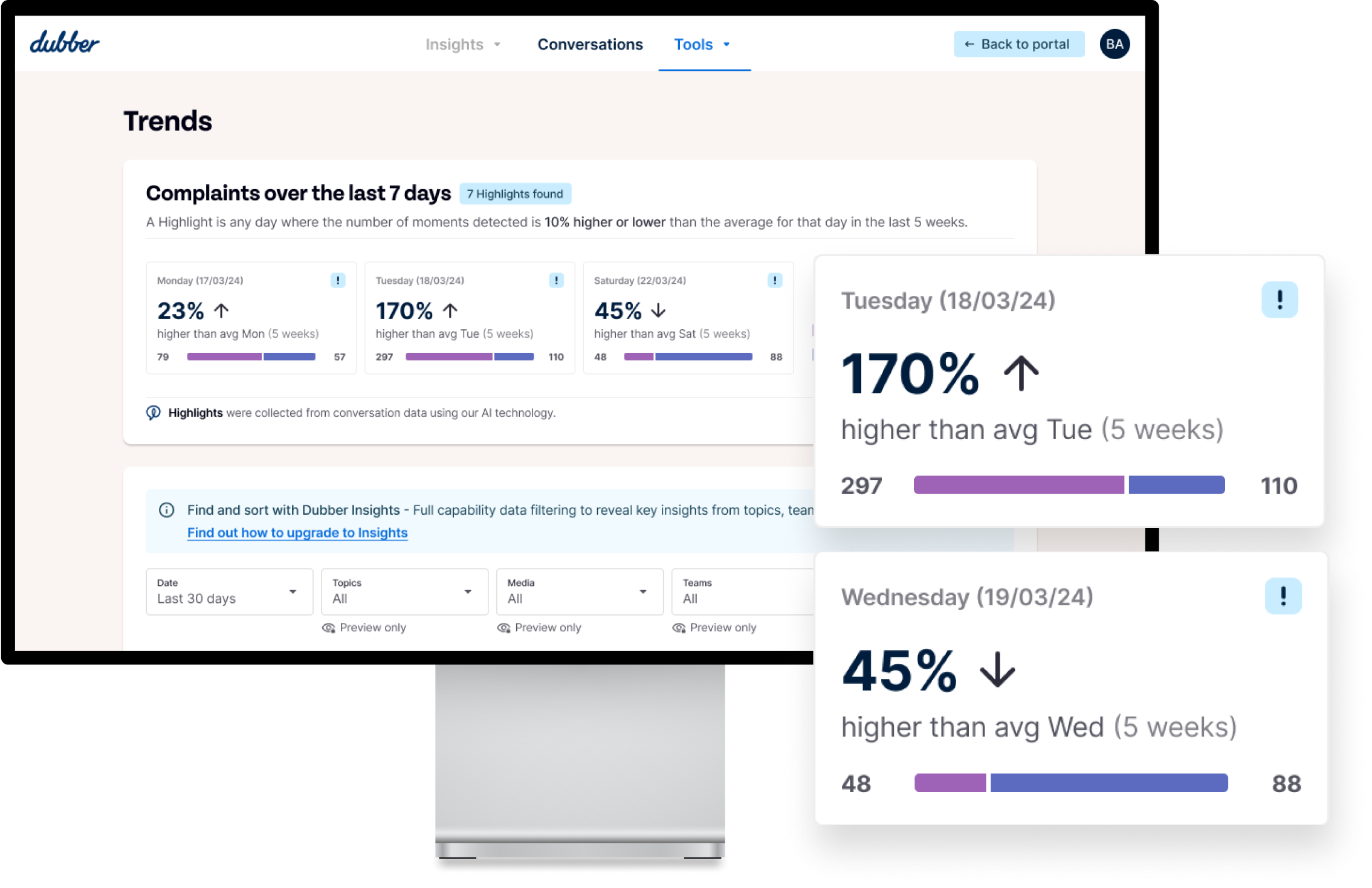
With our initiative Trends dashboard, businesses gain real-time visibility into customer sentiment shifts, complaint spikes, and underperforming sales calls enabling them to act immediately, accordingly, and with confidence to drive better results. By continuously adding more value into our solutions, we’re helping businesses grow with tools that are easy to use, scalable and support smarter operations for better outcomes.
Dubber Recording + Trends gives visibility into business conversations that drive action. To learn about the value we can bring to your business or to request a demo from our team, contact us here: contactus@dubber.net
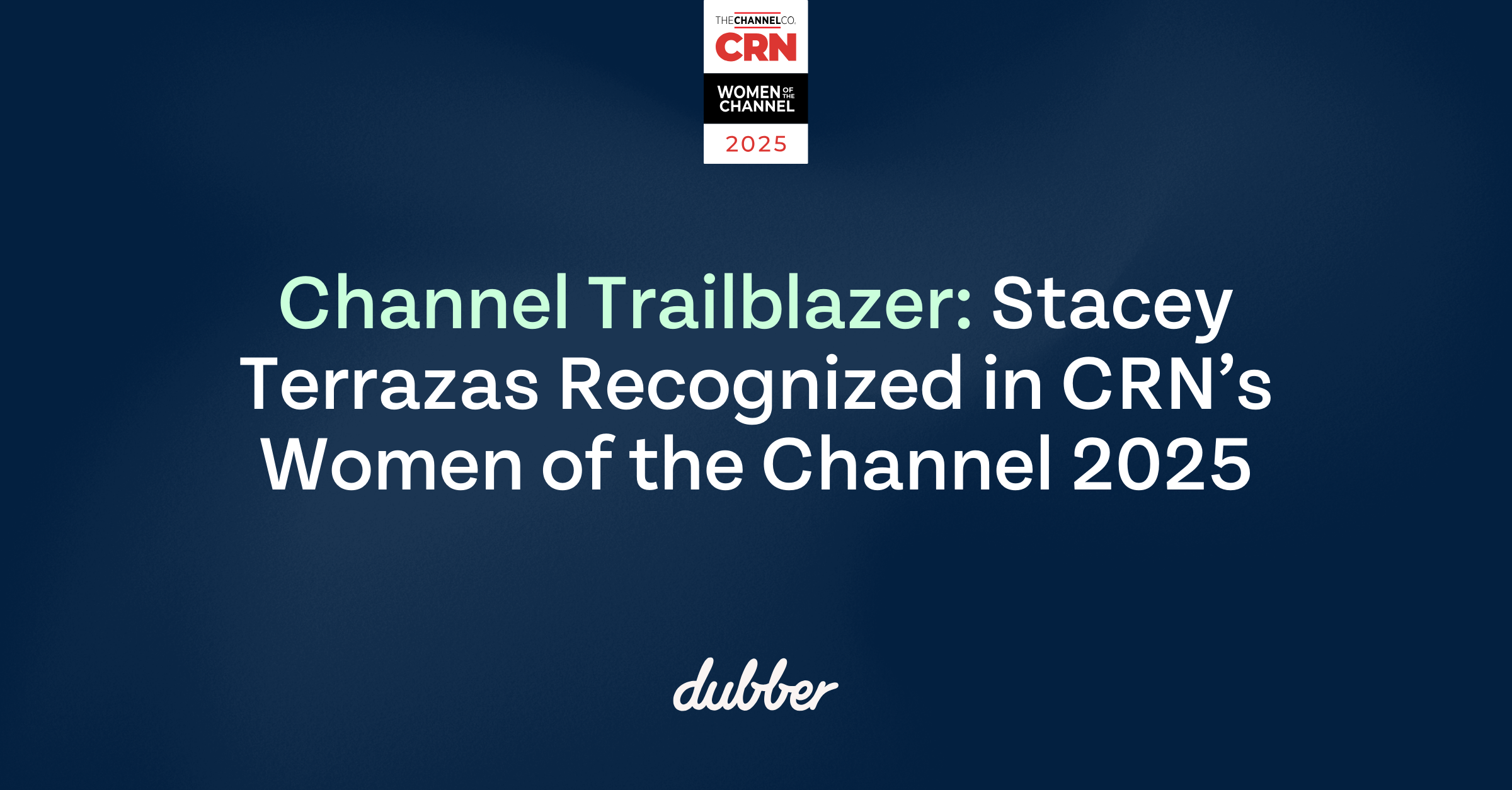
We’re excited to announce that Stacey Terrazas, Vice President of Sales, Americas, and a driving force in Dubber’s global partner strategy, has been named on the 2025 CRN Women of the Channel list. This annual and prestigious list by CRN celebrates influential women across the IT channel landscape who are shaping the future of the industry through innovation, leadership, and commitment to excellence.
Stacey’s leadership has played a key role in strengthening Dubber’s sales and channel ecosystem and accelerating the growth of our call recording and voice intelligence solutions. Her strategic vision and passion for enabling partners has helped expand Dubber for service providers and enterprises across industries, empowering them with business intelligence for compliance, operational efficiency and organizational growth. From driving scalable partner programs to leading high-performing teams and deepening channel engagement, Stacey continues to drive impact and sales excellence at Dubber.
“I’m honored to be recognized alongside such inspiring women who are shaping the channel and redefining leadership in Technology. At Dubber, I’ve had the opportunity to collaborate with teams and partners who are equally dedicated to using voice data to achieve significant business results. This recognition is a reflection of that shared success and a reminder of the importance of creating more opportunities for women in sales and leadership roles.”
– Stacey Terrazas
Congratulations Stacey, and thank you for all of your hard work, we are proud to celebrate this with you.
The 2025 Women of the Channel will be featured in the June issue of CRN Magazine, with online coverage at www.CRN.com/WOTC.
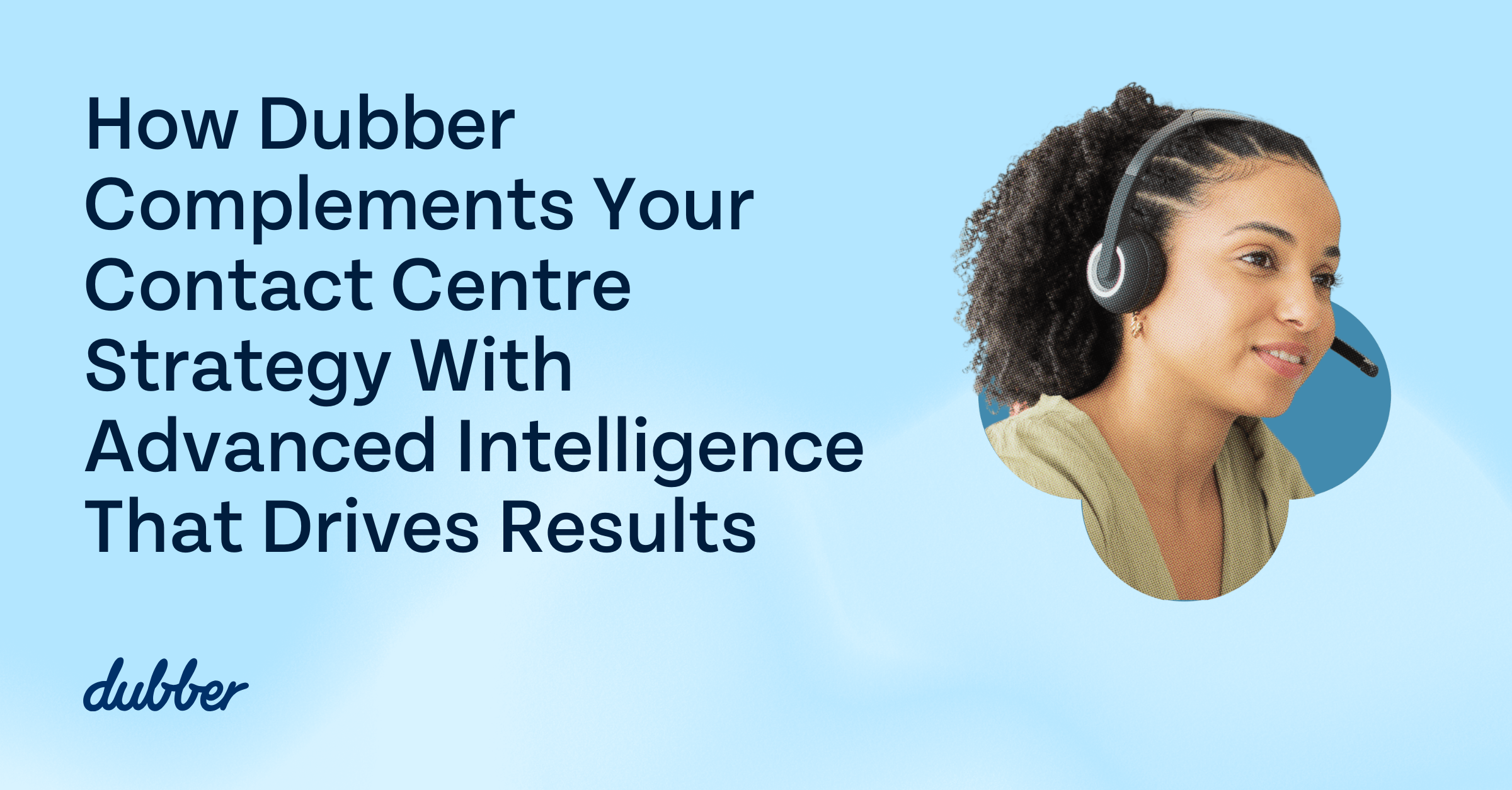
Traditional contact centre platforms capture and manage conversations, but few turn them into meaningful intelligence for business growth. Dubber provides enterprise-wide intelligence, identifying trends in complaints, security concerns, churn signals, and sales opportunities across thousands of calls. We are designed to work alongside your existing tools, capturing every conversation to deliver real-time, actionable insights that drive smarter decisions and tangible results.
Call Visibility for Smarter Contact Centre Operations
Dubber captures and analyses all conversations, automatically. This gives Contact Centres a complete and clear view of performance, risk, and customer sentiment without changing workflows or requiring expensive add-ons.
With this visibility, Contact Centre teams can:
- Find what’s driving customer sentiment by analysing trends and pain points across calls, rather than relying on after-call notes or feedback surveys.
- Identify sales and process inefficiencies with context and visibility into where sales stall or agents need support.
- Detect compliance risks as they happen, such as missed legal disclosures or sensitive data exposure, with audit-ready records built into the process.
- Capture customer insights to inform product and service improvements, messaging strategies, and marketing campaign effectiveness.
- Improve agent performance and staff development by identifying best-practices for communication strategies, dispute resolution, and targeted training insights.
- Allocate resources more effectively using real data that shows recurring workload and service issues.
- Benchmark individual, team, and regional performance with dashboards that provide a real-time view of key metrics.
Dubber doesn’t replace your contact centre solution; we complement it with advanced voice intelligence that strengthens service quality and informs decisions across sales, CX, compliance, marketing, and operations to create immediate value from every customer interaction.
Don’t hesitate to contact us to learn more: contactus@dubber.net

Retail is one of the most competitive, customer-driven industries in the world. To stay ahead, retailers need tools that not only collect data, but deliver real-time and valuable insights that improve sales, engage staff, and keep customers returning.
Here are three reasons why retailers around the world are choosing Dubber:
1. Increase Sales with Insights into Customer Needs & Upsell Opportunities
Dubber turns every conversation into an actionable data point that reveals what customers are asking for, what objections they have, and how staff are responding.
With Dubber, retailers are identifying trending product requests, managing inventory more effectively, forecasting demand, detecting common sales objections, and recognising upsell or cross-sell opportunities in real-time. Dubber surfaces insights that drive smarter stock decisions, pricing strategies, and sales team performance, all drawn directly from real customer conversations.
2. Protect Brand Reputation with Built-In Quality Assurance
From heated customer complaints and mishandled return policies to inconsistent service across locations, Dubber compliantly captures every customer conversation. Using advanced AI, retailers can quickly detect early signs of risk and take proactive action in line with any industry regulations and company policies to deliver exceptional service without disrupting operations.
3. Reduce Staff Burnout for Better Interactions
Dubber gives leadership visibility into staff experiences, using sentiment analysis to identify patterns of burnout, disengagement, or problematic customer behaviour. By flagging abusive or inappropriate calls, Dubber helps management respond quickly, protecting staff and reinforcing a culture of respect. Supported employees stay with companies longer, excel in their roles, and deliver the kind of service that keeps customers coming back.
Dubber is helping retailers turn their conversations into checkout ready intelligence that delivers immediate, measurable value.
Contact us to learn more: contactus@dubber.net
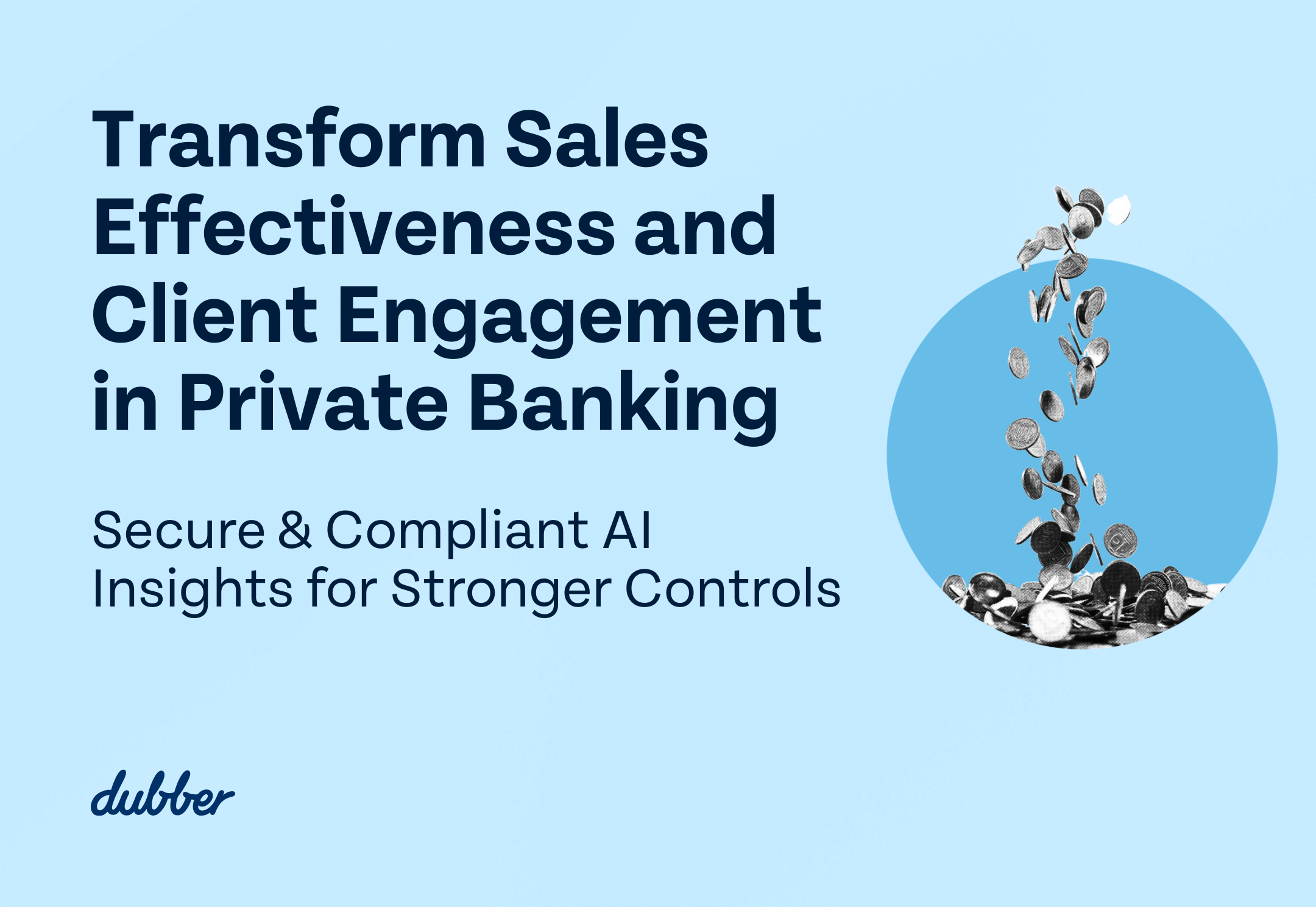
In Financial Services, every client interaction is a transaction in reputation, trust, value, and compliance. As conversations shift across mobile, video, and voice, many banks lack insight into what is said in the moments that build or break client relationships. Dubber is changing this by capturing and analysing every interaction, and providing actionable intelligence that transforms conversations into strategy, performance, and protection.
Strengthen Controls in High-Risk Selling
Private banking teams are using Dubber’s conversation intelligence platform to gain immediate insight into how financial products are positioned, discussed, and received during conversations. Teams can see who is selling which products and whether each sale meets the relevant regulatory standards and internal policies, providing oversight without disrupting workflows. Misstatements and mis-selling risks are flagged in real-time, while effective communication strategies can be identified to be coached and shared across teams. This visibility is helping banks stay closer to their clients and maintain better control in increasingly complex business environments.
Managing Complaints in Line with Industry Regulations
When handling complaints, private banks using Dubber no longer need to rely on recollections or summaries. We eliminate ambiguity by linking each complaint to the product, service, and recorded conversation for full compliance with any regulatory standards. This allows for faster, more transparent resolutions supported by compliant, evidentiary data that can be used in internal and external audits and reviews. Beyond complaint resolution, banks are leveraging these insights to find patterns in client feedback and make improvements to messaging, service, and product delivery.
Supporting Client-Facing Teams
Dubber is helping private banks create safer and more supportive environments by detecting and escalating instances of verbal abuse, aggression, or inappropriate conduct. These insights allow banks to support their staff and reinforce behavioural standards to navigate high-pressure and sensitive conversations.
By delivering deep insight into sales effectiveness and client needs, we help reduce compliance risks, improve client outcomes, strengthen team performance, and become a more trusted institution.
Let Dubber turn your banking operations into a valuable asset. Contact us to learn more: contactus@dubber.net
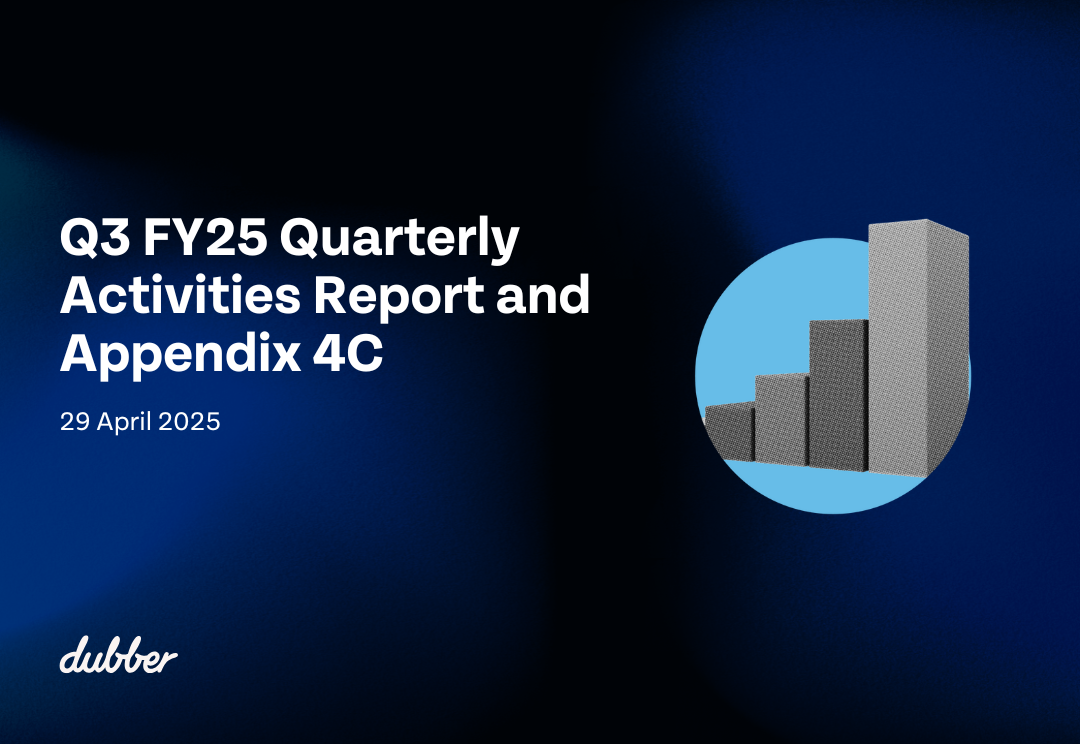
Melbourne, Australia: Dubber Corporation Limited (ASX:DUB) the leading conversation capture and intelligence platform for service providers and their customers globally, today released its Q3 FY25 quarterly report.
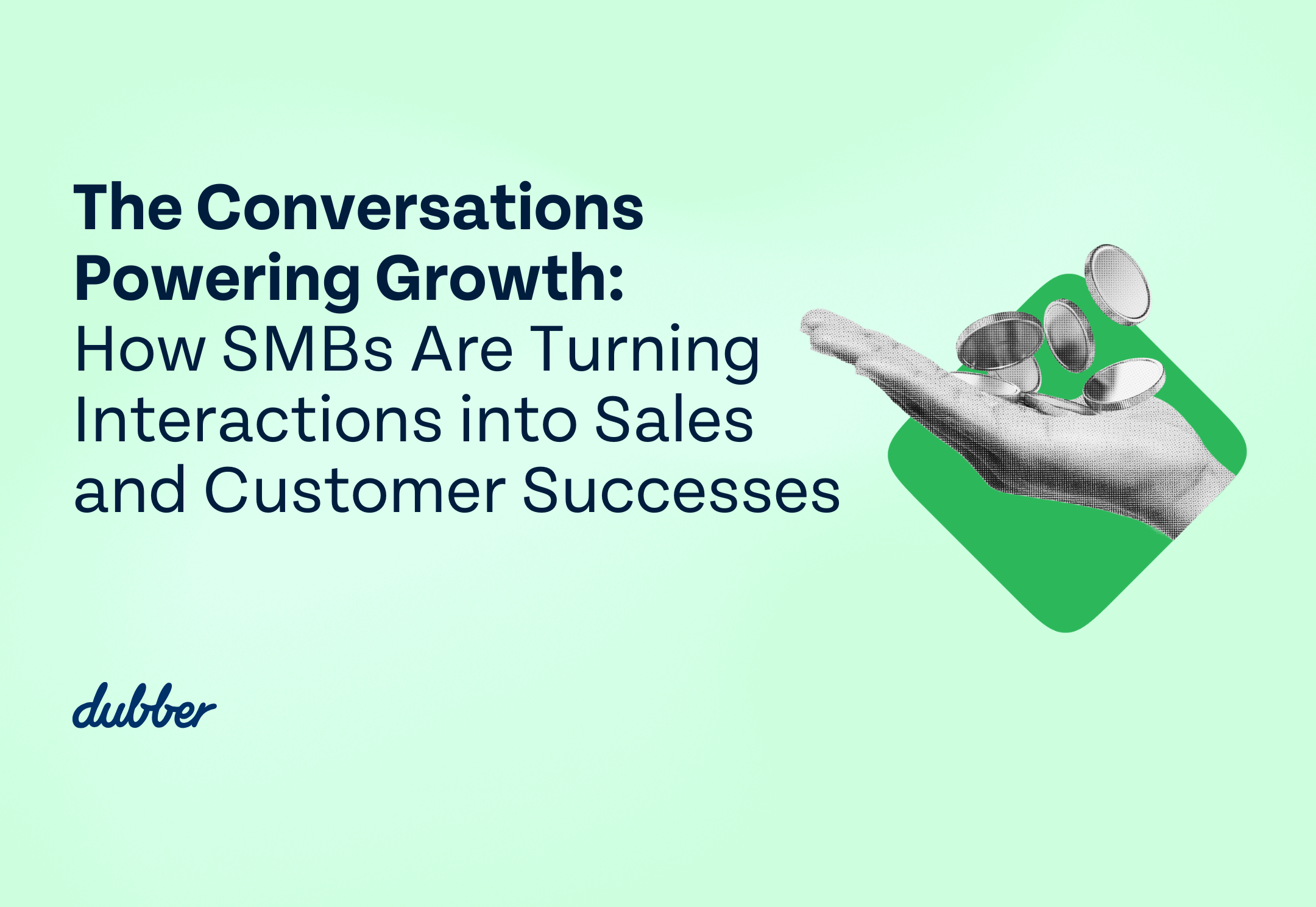
Valuable conversations happen across your organisation every day. From sales calls and customer service interactions to HR check-ins, these touchpoints are filled with insights that often go unrecorded, unanalysed, and underutilised. Dubber helps small and medium businesses capture and transform these everyday conversations into actionable business intelligence that is driving growth, smarter decisions, and stronger relationships.
Improving Sales by Listening
Customer conversations contain signals about what people are buying, what they want next, and what competitors they may be considering. With Dubber, businesses are able to tap into these insights. By automatically capturing calls and applying AI to highlight key moments, sentiment, objections, and questions, sales leaders can use real calls to coach teams, refine messaging based on proven success, and react quickly to shifting customer priorities. Listening to conversations at scale enables SMBs to build sales strategies based on real-world behaviour for higher conversions, a stronger pipeline and better customer relationships.
Analysing Complaints for Advantage
When customers voice pain points or provide feedback, they offer a roadmap to improvement. Trends across conversations can reveal what traditional surveys miss, such as shifts in sentiment, recurring issues, and unmet or emerging needs. These insights are uncovered by analysing calls at scale, where repeated themes and tones surface over time through Dubber’s AI-powered analysis. By identifying these patterns in complaints, SMBS can support their teams with the insights needed to drive product enhancement, improve marketing campaigns, implement policy changes, and create customer engagement strategies.
Building a Culture of Accountability
Dubber provides businesses the ability to analyse internal conversations in a way that supports growth, not surveillance. By creating an environment where expectations are clear and interactions are reviewable, businesses are empowered to build accountability into daily operations to support fair conflict resolution, strengthen leadership values, and encourage teams to collaborate effectively.
SMBs using Dubber are growing revenue, retaining more staff and customers, and making smarter decisions by acting on the key topics already being discussed within their businesses. Dubber records conversations, and surfaces the insights that are hiding in plain sight, delivering measurable impact without adding complexity to your day.
Contact us to learn more: contactus@dubber.net
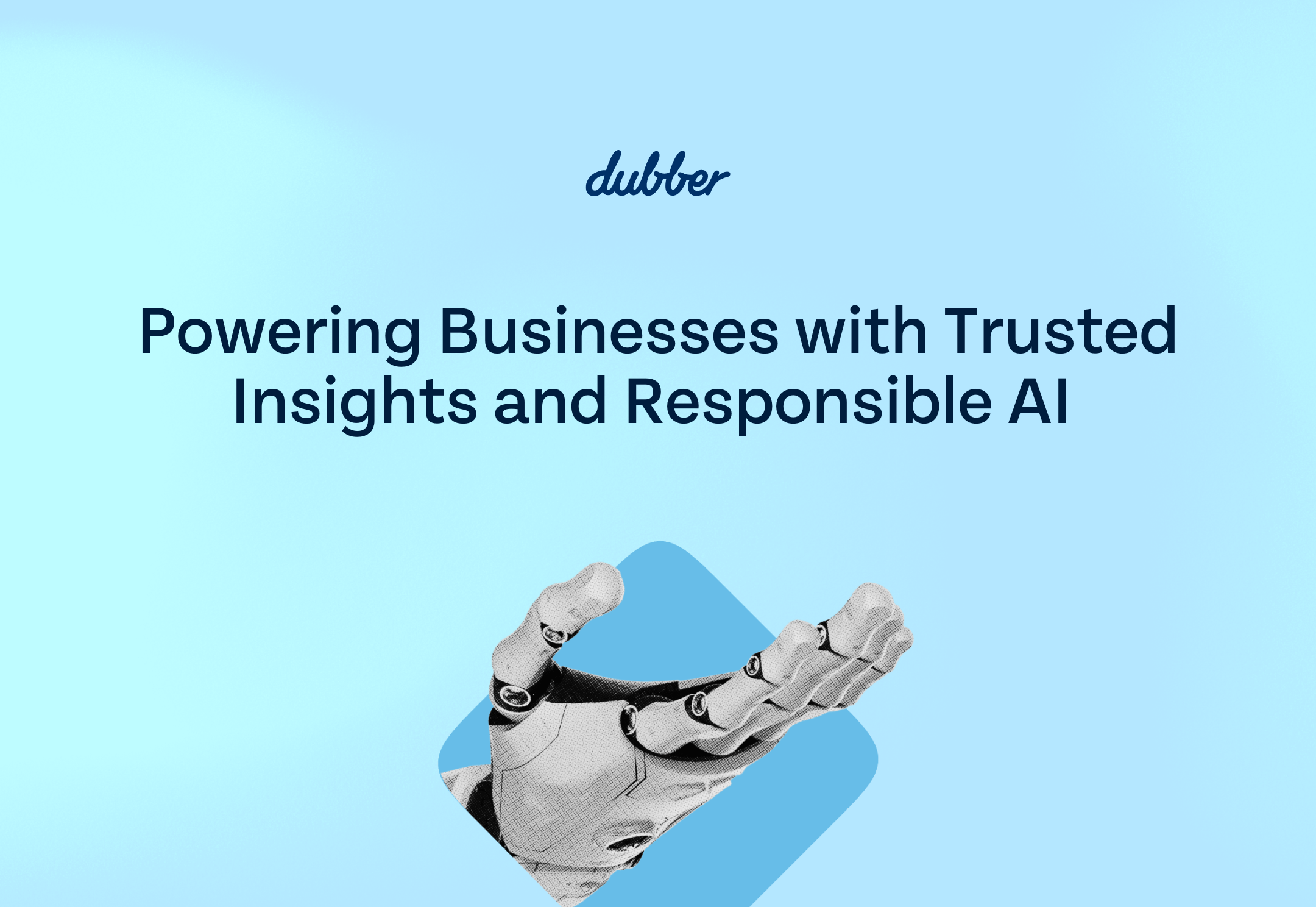
With trusted data and responsible, advanced intelligence powering every insight, Dubber is equipping organisations across industries to extract meaningful, accurate, and traceable information that delivers immediate business value.
Extract Trusted Insights from Your Data
Trust is the foundation of any effective intelligence platform. Without reliable data, AI becomes unpredictable, and can introduce risk rather than reduce it. At Dubber, we’ve built our AI powered insights so that every data point can be traced, verified, and acted on with certainty.
Our patented technology gives us full control over how your data is captured, processed, and protected. This means we can capture the most valuable information from your conversations in ways that are fully auditable and transparent. With the ability to trace the source of any insight in just three clicks, you can see exactly where the data came from, how it was processed, and how insights were extracted. This level of visibility builds business confidence, because when you understand your data, you can trust the decisions it informs.
Using AI with Responsibility
As AI becomes widely embedded across customer service, compliance, and operations, businesses have a duty to ensure it’s used ethically and responsibly, with full transparency and human oversight. At Dubber, our AI is continuously refined, trained, and reviewed by our expert team who understand the business outcomes it supports for fairness, relevance, and accuracy at every stage.
The Dubber platform is deployed with the highest standards of quality, security, and compliance aligned to global data protection and AI ethics. Through responsible AI, businesses gain the ability to drive sustainable growth without compromising on trust or integrity, delivering advanced voice intelligence that is as responsible as it is powerful.
When your AI is responsible, your data becomes trustworthy and when your data is trusted, your insights become powerful. We’re committed to delivering solutions that you can trust. Contact us here for more information: contactus@dubber.net
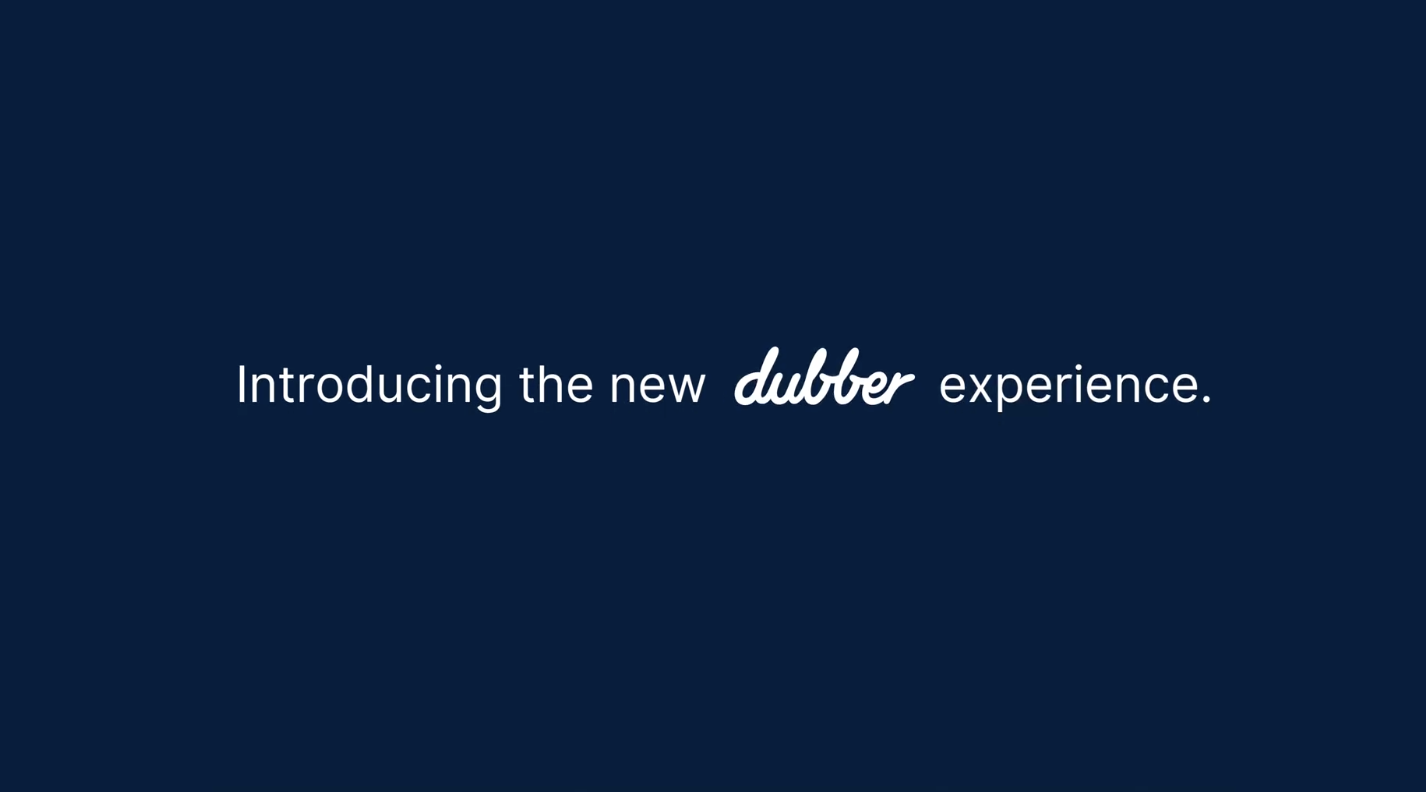
We’re excited to announce that the new and significant upgrades are now live on the Dubber Platform! These enhancements are designed to make your Dubber user experience even more powerful, with deeper insights, and expanded AI capabilities – right at your fingertips.
Available immediately, all Insights & Trends customers can effortlessly gain even more value from their conversations, for smarter decisions, strengthened compliance and risk mitigation, and a greater understanding of your customer than ever before.
The new Dubber experience
No Setup Required – Immediate Value
Even with all the improvements, there’s still no complex setup or configuration needed- simply turn it on and start gaining insights, immediately.
Self-Learning AI – Smarter Over Time
Our AI continuously learns from your conversations, refining its understanding of your business, delivering enhanced insights specifically tailored to accelerate decision-making, and driving smarter customer and business outcomes.
Proactive Notifications – Stay Informed
Get weekly notifications and updates on trends, like patterns, shifts, and signals that matter, so you never miss key insights.
Seamless Integration – Works Where You Do
Unlock greater value from your data with Dubber’s enhanced APIs. Seamlessly integrate recordings, insights, and metadata into your existing business workflows, tools, and platforms.
Enhanced Reliability – Trusted, Actionable Intelligence
Improved platform security and reliability deliver accurate, meaningful insights tailored to your business needs, now reinforced by Multi-Factor Authentication for even stronger access control and data protection.
What these upgrades mean for you
All customers on our AI plans can now experience these business intelligence upgrades for:
- More powerful analytics across all Dubber Moments
- Deeper insights into business intelligence and behavioural analytics
- Increased confidence in data-driven decision-making for immediate business impact
- Enhanced conversation actions for precise record-keeping and improved efficiency
These upgrades are just one part in our commitment to delivering world-class, cutting-edge solutions to our current and future partners. With our dedicated AI team driving constant innovations and advancements, we remain focused on empowering our users with intelligent, actionable insights.
To learn more about what these upgrades mean for you, email us at contactus@dubber.net.
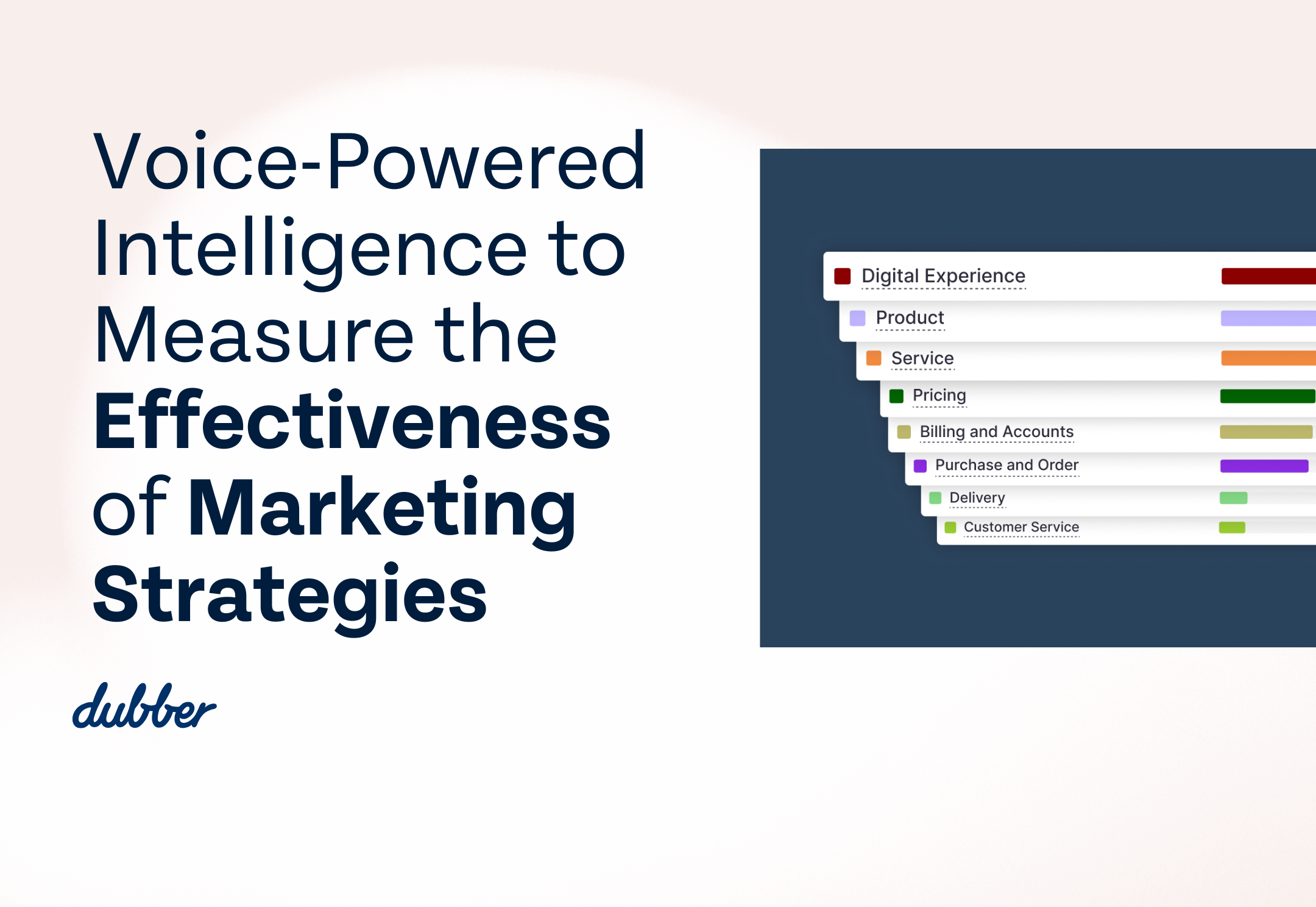
Marketing strategies and campaigns are designed to capture attention and influence buying decisions, but traditional metrics like clicks and impressions measure only part of their impact. The key value lies in understanding customers’ sentiment, hesitations, feedback, and intent. Every conversation with current or prospective customers is filled with valuable insights for growth, and by listening and analysing these at scale, businesses gain immediate insights to refine marketing strategies for greater effectiveness.
Analyse how your marketing efforts are performing
Businesses are already finding value with Dubber, seamlessly capturing customer conversations at scale to track and evaluate marketing performance.
“Dubber has given us the ability to quickly assess if our promotional campaigns are actually resonating and connecting with customers and if they are contributing to positive sales and business success.”
– Marketing Director at a Leading Automotive Company
Using our patented, award-winning AI technology, Dubber provides visual insights into which products and services are being discussed, monitors customer sentiment (are they excited, disappointed, or confused?), and correlates feedback with actual sales and product performance. This provides businesses deeper insight into how messaging is being received and if its driving conversions, allowing them to adjust and launch future campaigns for success, based on real conversations and data.
Use customer insights for business growth
Dubbers real-time insights helps you understand what’s happening in sales conversations with feedback that goes beyond survey responses and engagement metrics.
Customer Interactions provide crucial insights into brand perception, conversation patterns, product-market fit, and emerging trends. By analysing these conversations, businesses can recognise unmet needs that otherwise go unnoticed and strengthen their product or service messaging. By identifying where sales are stalling, due to pricing hesitations, unresolved objections, or ineffective messaging, Dubber gives you the ability to refine your strategies to improve sales performance and revenue.
Dubber’s AI-driven solution helps businesses measure their marketing performance by turning discussions into data-driven decisions. To learn more about how Dubber delivers results across any industry, get in touch with us at contactus@dubber.net.
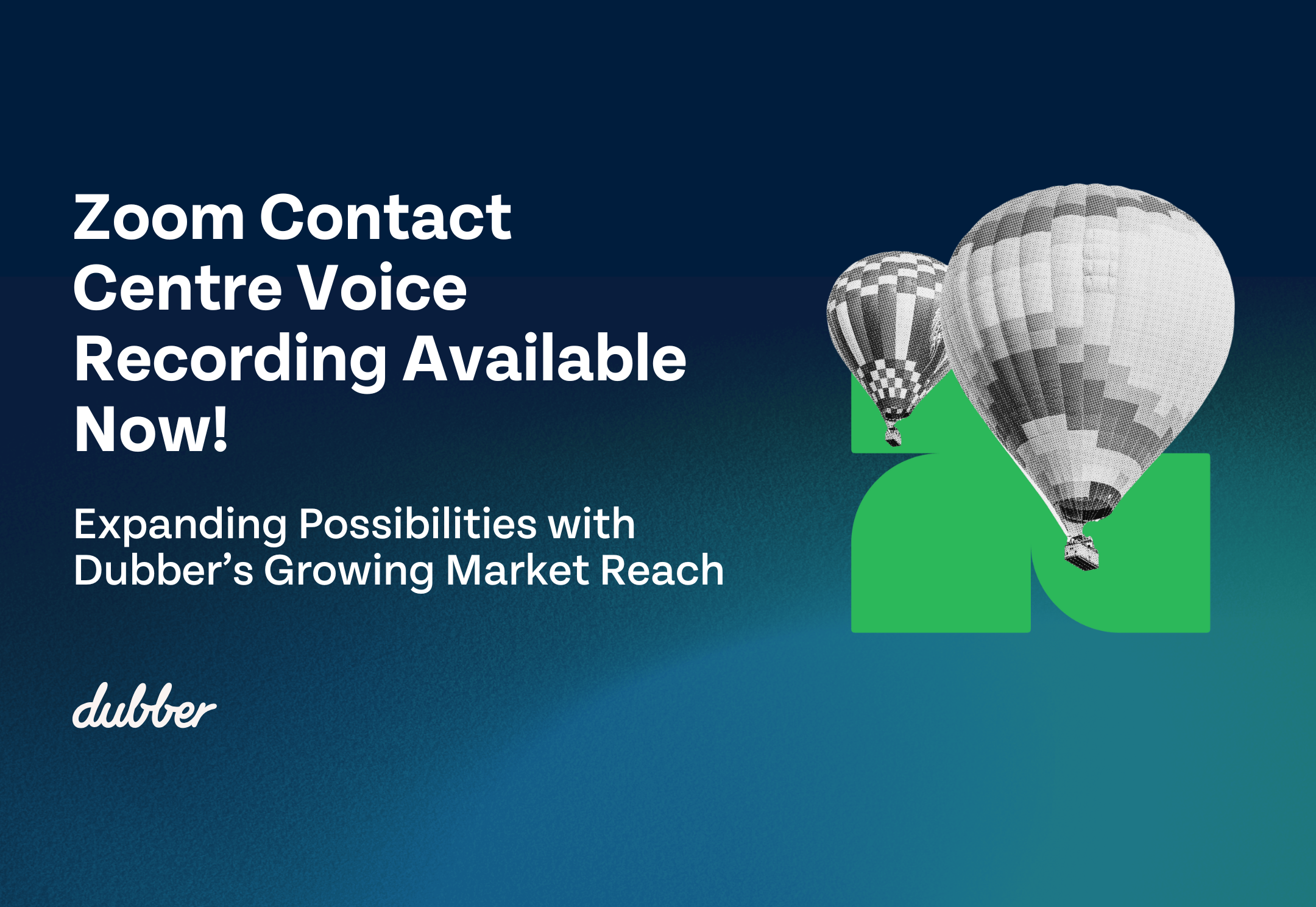
We are excited to announce a major new addition to Dubber’s capture capabilities: the ability to record voice recordings from Zoom Contact Centre! This enhancement is another significant step forward as we continue to grow our footprint in the Contact Centre and Conversation Intelligence market.
This latest addition to our product suite builds on our existing integrations with Zoom Phone and Zoom Meetings, further establishing Dubber as a leader in delivering seamless, scalable, and reliable recording solutions and directly expanding our addressable market. By leveraging Dubber, contact centres can transform every conversation and interaction their agents are having into actionable intelligence – automating compliance, improving agent performance, and gaining valuable customer insights for business growth.
Other Updates
In recent months, we’ve also rolled out updated voice recording solutions for Amazon Connect and Webex Contact Centre, solidifying our position in an industry experiencing unprecedented growth. This enhancement expands Dubber’s extensive coverage, which already includes leading platforms such as Microsoft Teams, BroadSoft, Cisco Webex, and RingCentral,
The global contact centre market is thriving, with key players like Amazon Connect, Webex Contact Centre, Microsoft Dynamics 365, and Zoom Contact Centre all driving demand for intelligent voice recording solutions. Dubber is uniquely positioned to help businesses deliver unparalleled value through enhanced compliance, reduced costs, increased productivity, customer experience, and business intelligence.
Our commitment to continuous innovation means we’re constantly advancing what Dubber can offer: delivering more powerful insights, seamless integrations, and positioning ourselves as a trusted and leading partner for businesses navigating the future of customer service.
With our expanded capabilities and ongoing innovation, Dubber is here to help your contact centre drive transformative outcomes.
Contact us to learn more: contactus@dubber.net
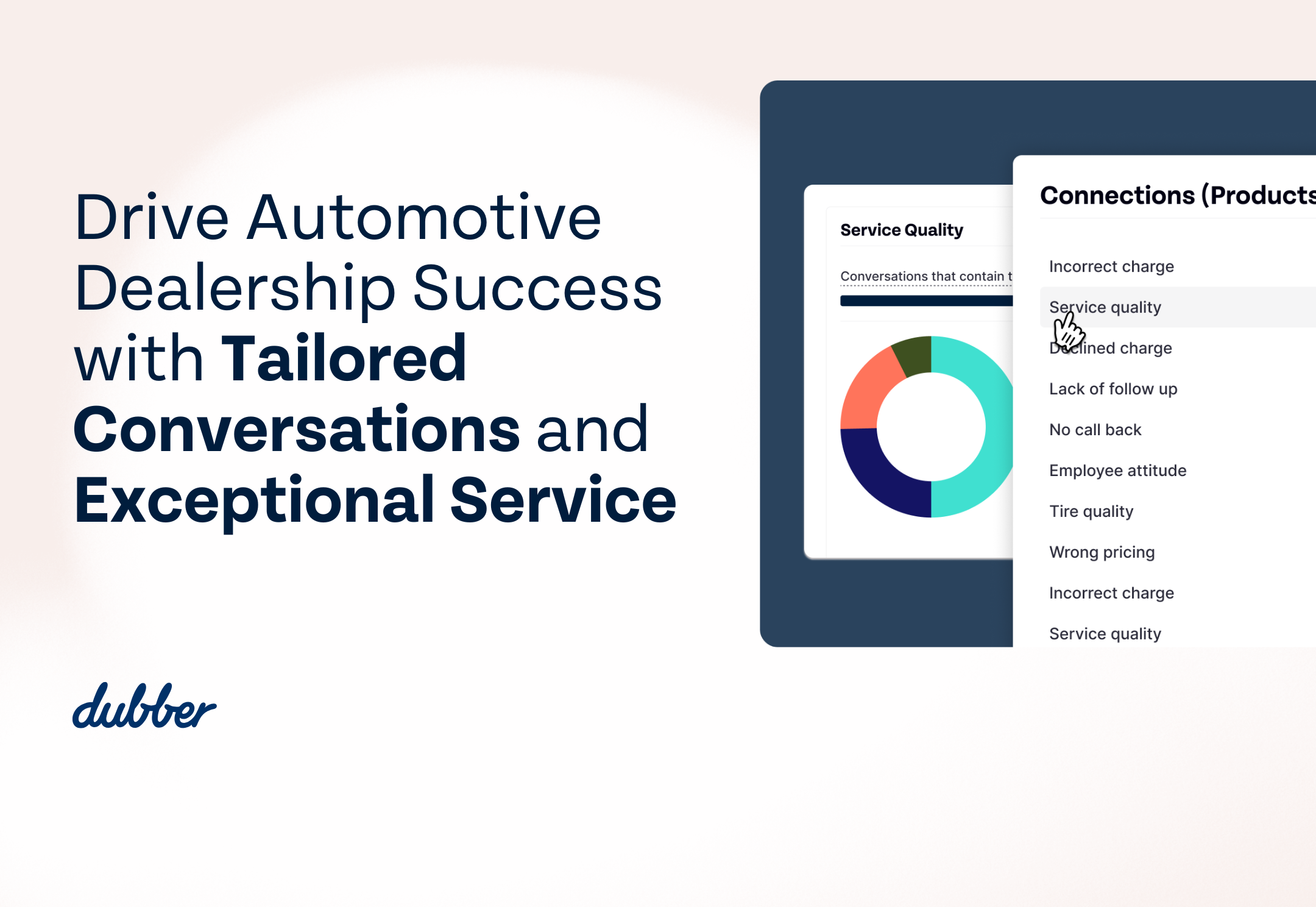
Automotive dealership success relies on providing quality vehicles and parts, along with delivering valuable customer experiences. Dubber helps dealerships prioritise exceptional service by understanding customer needs and streamlining sales processes leading to improved customer loyalty, higher conversion rates, and increased repeat business.
Increase Sales Performance with Tailored Customer Conversations
Each conversation is an opportunity to address customer needs and move towards closing a sale. With analysis overview information and comprehensive insights of conversations like sentiment monitoring, Dubber supports dealerships in identifying key opportunities to maximise engagement and sales conversion success.
For example, during customer inquiries, dealerships can pinpoint exact moments where a small, yet crucial, action such as confirming a specific showroom booking time or test drive, can significantly increase the likelihood of securing an appointment. And when financial constraints are preventing a sale commitment, Dubber can quickly flag this for staff to offer targeted solutions like coupons, or financing options. By revealing unseen and data-driven opportunities, dealerships create a more proactive sales process, increase showroom visits, and provide immediate value to the customer.
Address Concerns and Provide Better Service
Addressing service queries go beyond finding the solution, but also informing customers and managing their expectations. By leveraging fact-based data, dealerships can streamline and strengthen customer interactions with consistent, proactive communication.
With Dubber, automotive dealerships can be notified when a key gap in communication is identified during the servicing process, such as when customers are not receiving timely status updates or next steps, especially in workmanship complaints. By providing clear information of when they will be contacted again or how long a resolution will take, dealerships can improve customer confidence, satisfaction and service experience.
By leveraging Dubber, dealerships gain a powerful tool that turns every conversation into an opportunity to improve the service experience for both the dealership, and the customer.
For questions or to learn more, contact us here: contactus@dubber.net.
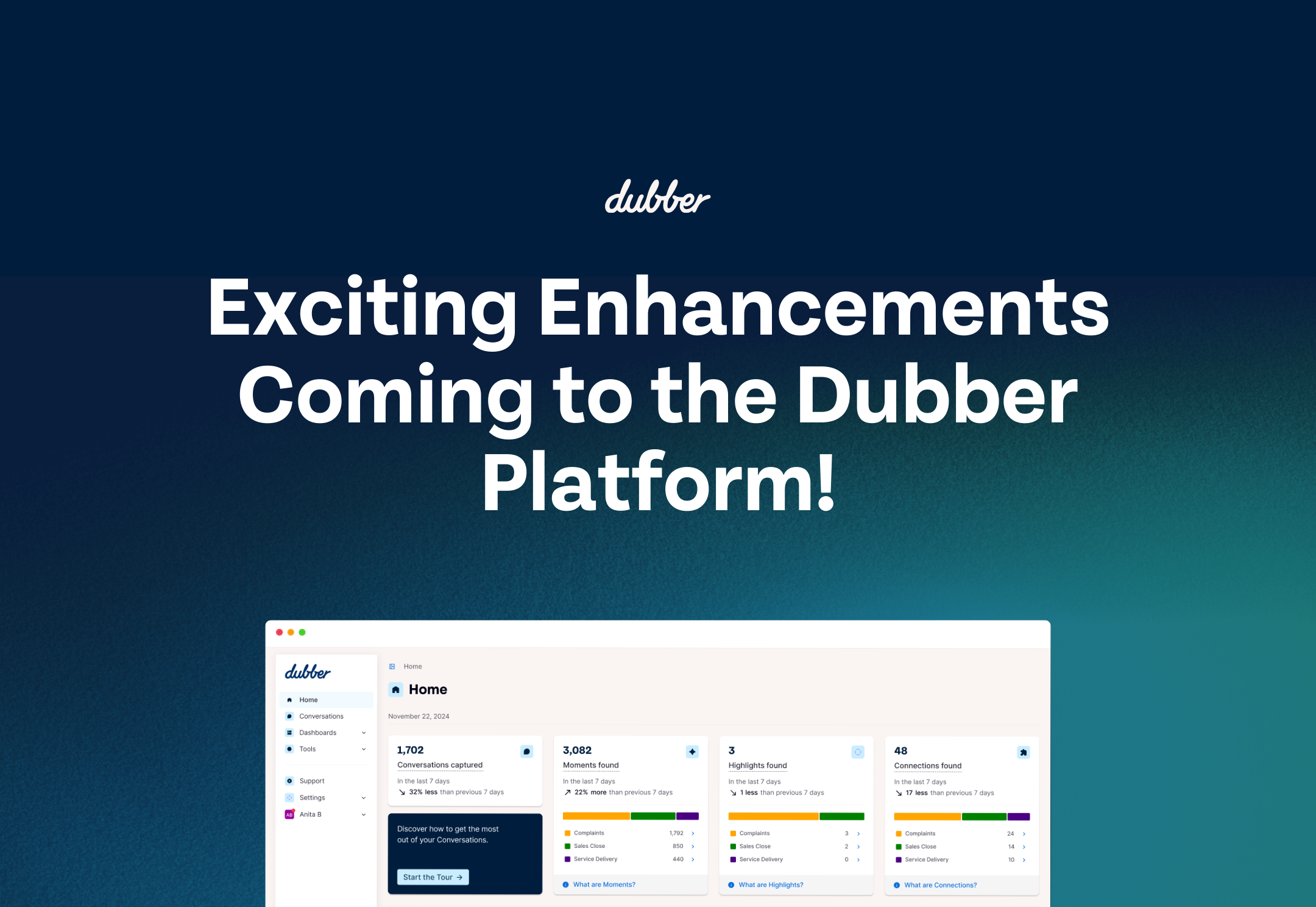
We’re excited to unveil a series of powerful updates coming to the Dubber Platform in the months ahead! These enhancements will redefine the user experience, providing deeper insights, improved analytics, and expanded AI capabilities—helping you and your customers unlock even greater value from every conversation.
What’s Changing?
By the end of this month, all customers on our AI product plans will gain access to significant upgrades in business intelligence. Whether you’re using Dubber Insights, Unified Capture + Insights, or Dubber Recording + Trends, you’ll soon experience:
- More powerful analytics across all Dubber Moments
- Enhanced business intelligence for deeper insights
- Greater confidence in data-driven decision-making
These improvements empower you to extract meaningful trends, optimise operations, and maximise the value of your captured conversations.

But That’s Just the Beginning!
In addition to advancing our out-of-the-box business intelligence capabilities, we’re rolling out enhancements across our standard AI features, including:
- Upgraded Conversation Highlights – Instantly pinpoint the most critical moments within your conversations, now with improved accuracy and detail across all AI products.
- Advanced Sentiment Analysis – Gain a more nuanced understanding of conversation sentiment, now with speaker-specific sentiment breakdowns.
- Streamlined Conversation Actions – Keep track of key action items from every discussion, ensuring nothing slips through the cracks.
More to Come for Voice Recording Customers
We’re also working on an exciting roadmap of additional enhancements for our voice recording solutions, set to launch later next quarter. Stay tuned for more details on these upcoming innovations that will further enhance the Dubber experience.
We can’t wait to show you these improvements and discuss how they can elevate the value you’re delivering to your customers—empowering them to capture, understand, and act on their most valuable conversation data like never before!
Watch this space for more updates!
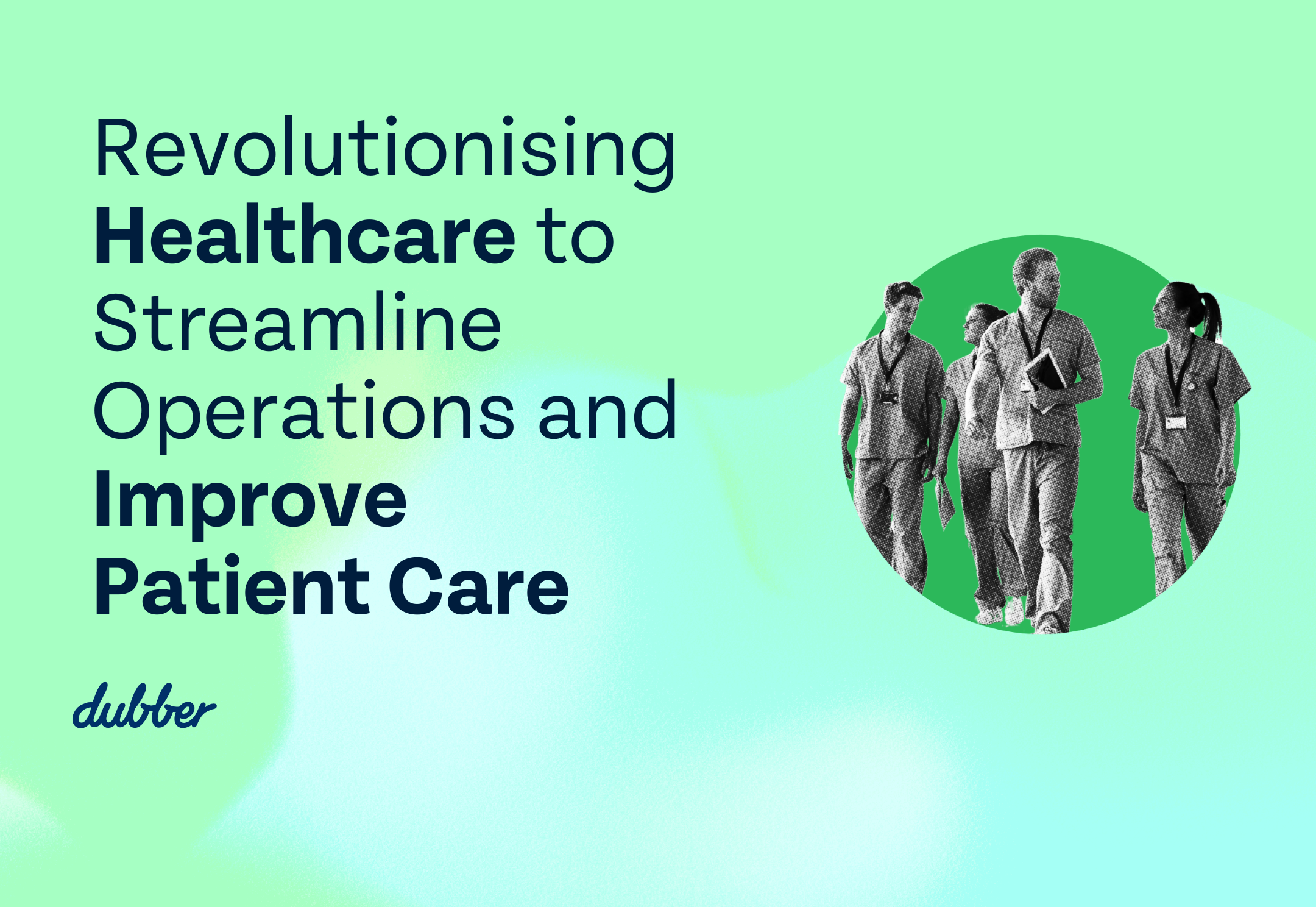
Healthcare systems are under constant pressure to do more with less. Dubber’s AI-powered insights are designed to maximise efficiency and customer service operations in healthcare, for smoother care coordination and stronger patient relationships.
Drive Productivity and Operational Performance
Amid budget cuts and growing regulatory demands, healthcare providers face challenges to deliver quality care while adhering to internal and external duty of care standards, such as HIPAA and GDPR.
Dubber can help ease these burdens by better organising patient consultations, tracking sales activities, and providing in-depth data on patient history and preferences. By providing healthcare providers with immediate and actionable insights, we ensure compliance with regulations while enabling informed decision-making that improves care efficiency. This not only drives the performance of teams, but also leads to better patient outcomes and maximised care delivery effectiveness, for both operational success and patient satisfaction.
Enhance Productivity of Sales Teams
Healthcare sales teams engage with vast networks, and with Dubber’s conversation intelligence this helps them sell smarter. AI-driven insights surface key signals, track objections, and refine messaging. Automated summaries, conversations actions and sentiment analysis reduce admin work. With full visibility into performance trends, teams close deals faster and more effectively.
Improve the Staff and Patient Experience
Improving the patient experience starts with understanding their needs. Our AI tools immediate feedback on patient interactions, allowing healthcare providers to address any concerns quickly. By compliantly identifying trends in patient complaints and identifying moments of positive engagement, Dubber supports a healthcare provider delivering tailored care that builds trust and strengthens relationships with patients. Additionally, by offering insights into staff interactions and workloads, healthcare teams can better manage stress and balance responsibilities, fostering staff wellbeing and their ability to deliver compassionate, high-quality service and care.
With Dubber’s solutions, healthcare providers can optimise internal processes, whilst strengthening customer service and patient experiences.
For questions or to learn more, contact us here: contactus@dubber.net.
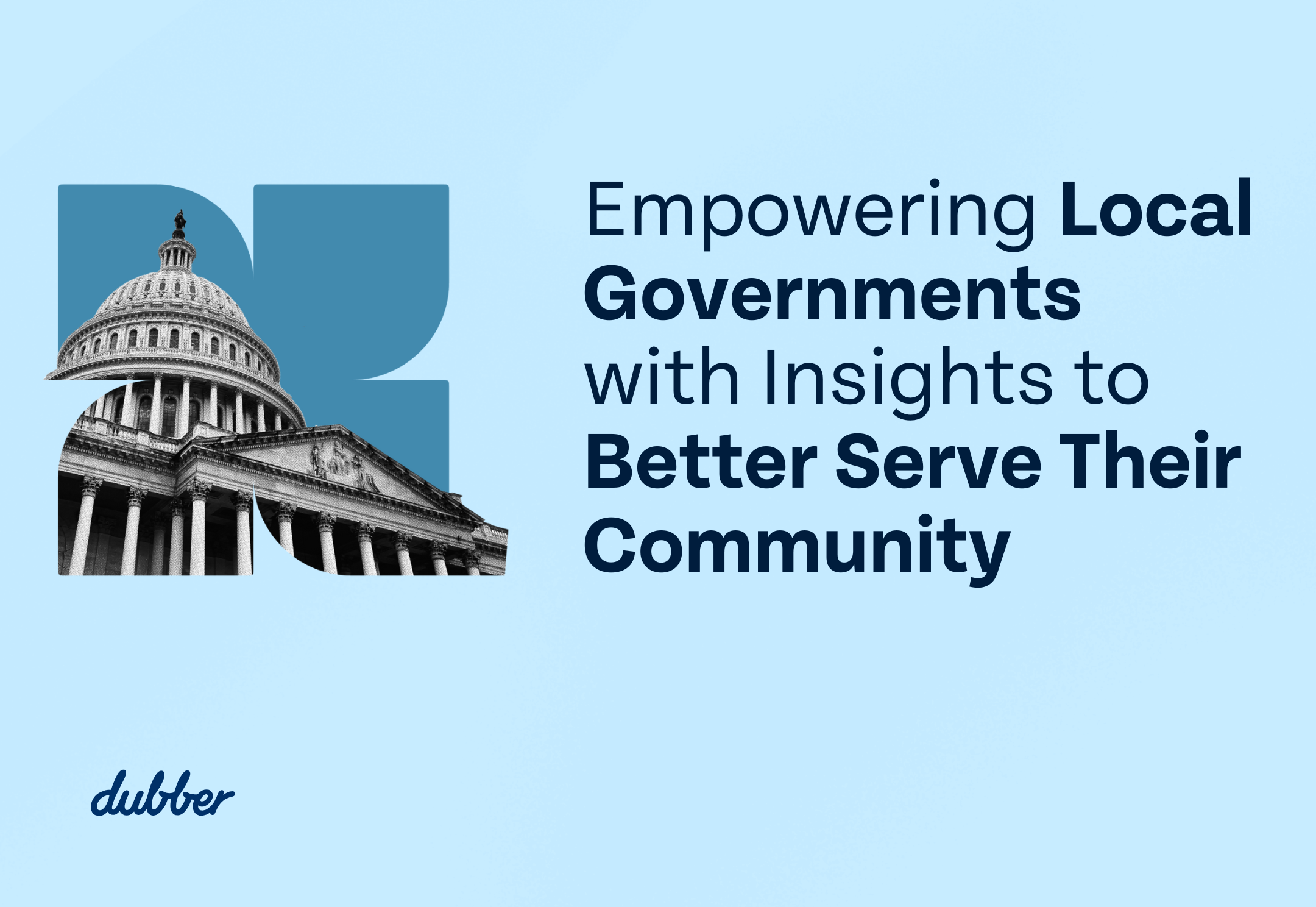
Dubber strengthens relationships between local governments and the communities they serve, by transforming everyday interactions into immediate and valuable insights. With Voice Recording and Powerful AI Insights, governments can make more informed decisions to drive continuous improvement in service quality and community satisfaction.
Efficiently Address Community Service Requests
Local governments often manage an overwhelming volume of service requests, from pothole repairs to noise complaints to waste disposal. Tracking, analysing and addressing these requests manually can be a time consuming and error-prone process.
Dubber offers an efficient and compliant solution for this process by transforming community conversations into actionable data. By categorising calls – such as parking violations or animal control concerns – local governments can respond quickly and prioritise services with the highest demand and community impact. Through this, governments can identify common service request trends, optimise their resource allocation, and improve service delivery responsiveness to ensure taxpayer dollars are spent where they’re wanted and needed most.
Improve Community Experience and Satisfaction
Dubber elevates community experience and satisfaction by providing valuable insights into recurring community service issues that need attention and highlighting areas where residents are most satisfied correlating them with specific services.
By monitoring trends and complaints across departments local governments can proactively address concerns and deepen their understanding of needs, creating a more transparent relationship with their residents. This data-driven approach helps establish clear standards for managing community engagements ensuring employees receive the training and support needed to handle conversations effectively, resulting in a higher quality of customer service and stronger connections with the community.
For questions or to learn more about how Dubber is transforming the way local governments connect with their residents, contact us here: contactus@dubber.net.
Additionally, check out our case study with Devonport City Council to explore firsthand how they’ve transformed call centre interactions and enhanced council decision-making by leveraging Dubber.
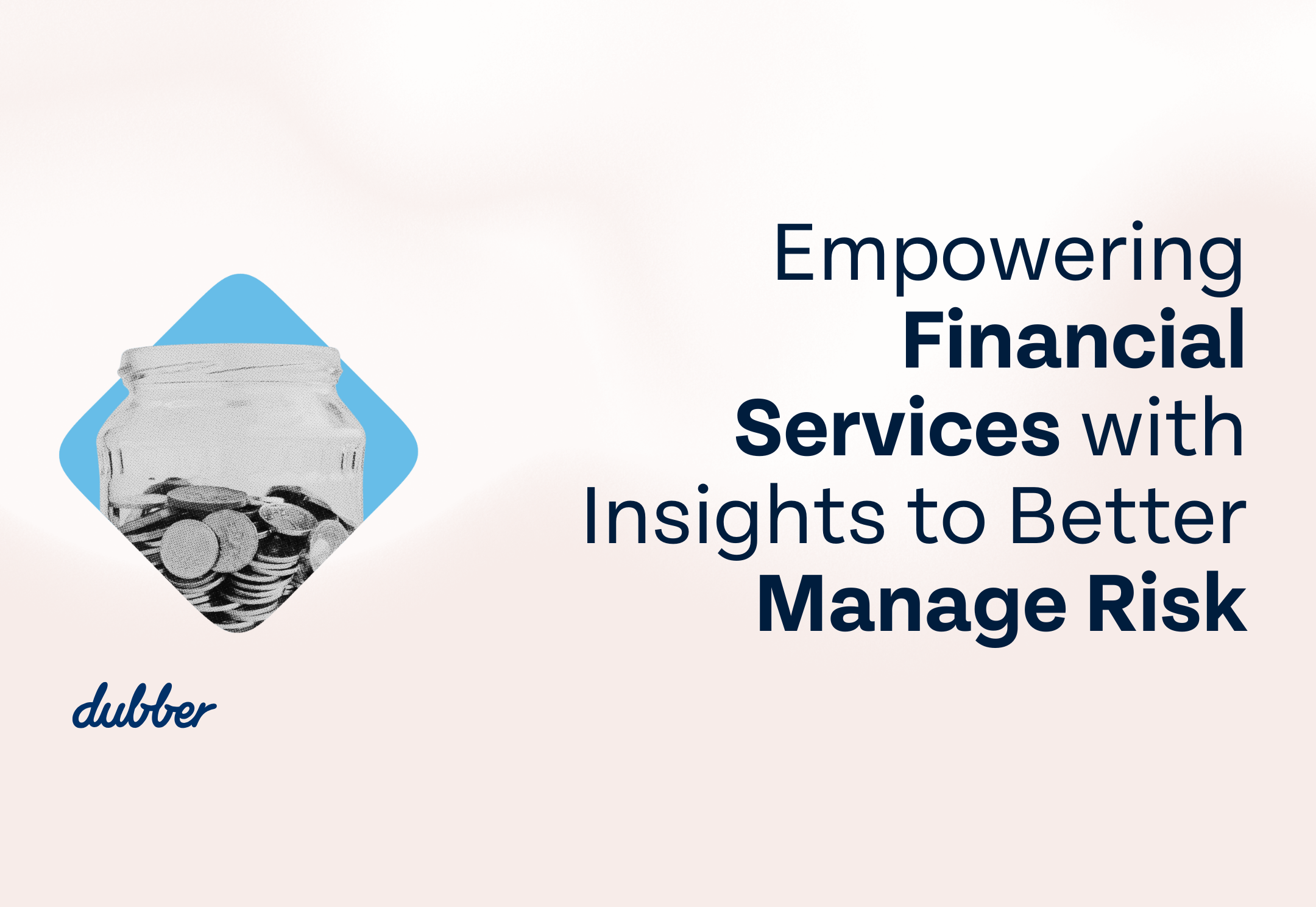
Dubber’s Compliant Conversation AI helps financial services manage challenges associated with risk management, compliance, and both client and employee experiences, with actionable insights and proactive solutions.
Strengthen Compliance in High-Risk Selling Activities
Compliance is essential when selling high-risk products, such as new investment products or complex plans to protect both clients and the institution from significant risks.
Real-time monitoring of sales interactions helps ensure products are suited to clients’ financial goals and risk profiles, while identifying opportunities for upselling or cross-selling services that better meet clients’ evolving needs. With AI-powered, conversation AI, institutions can track non-compliant behaviours, such as misrepresentation or unsuitable product recommendations. By proactively tracking these issues and other high-risk sales activities, financial services can intervene early, provide proper disclosures, and make sure sales teams are adhering to regulatory guidelines.
With accurate, data-backed insights, managers can review conversations and refine strategies to improve productivity of the sales team through access to more detailed customer information imported into internal business workflows.
Better Manage Client Complaints to Drive Success
Financial services are required to manage client complaints in a fair and transparent way, adhering to internal policies and external regulatory standards to avoid any violations and penalties.
By analysing conversations, Dubber identifies and categorises complaints related to specific issues, such as product quality, service delays, or billing discrepancies. This streamlined and compliant process increases transparency for client success and equips employees to manage these interactions effectively by providing clear details and actionable insights into concerns. Financial services can uncover patterns and trends across these interactions to identify potential threats, such as fraud, compliance risks, or evolving customer needs, allowing for timely action and prevention before they impact the organisation.
In financial services, the cost of non-compliance, ineffective customer service, and poor risk management can have serious financial and reputation consequences. For questions on how Dubber can deliver tailored solutions that improve the customer experience and increase lifetime value, contact us here: contactus@dubber.net
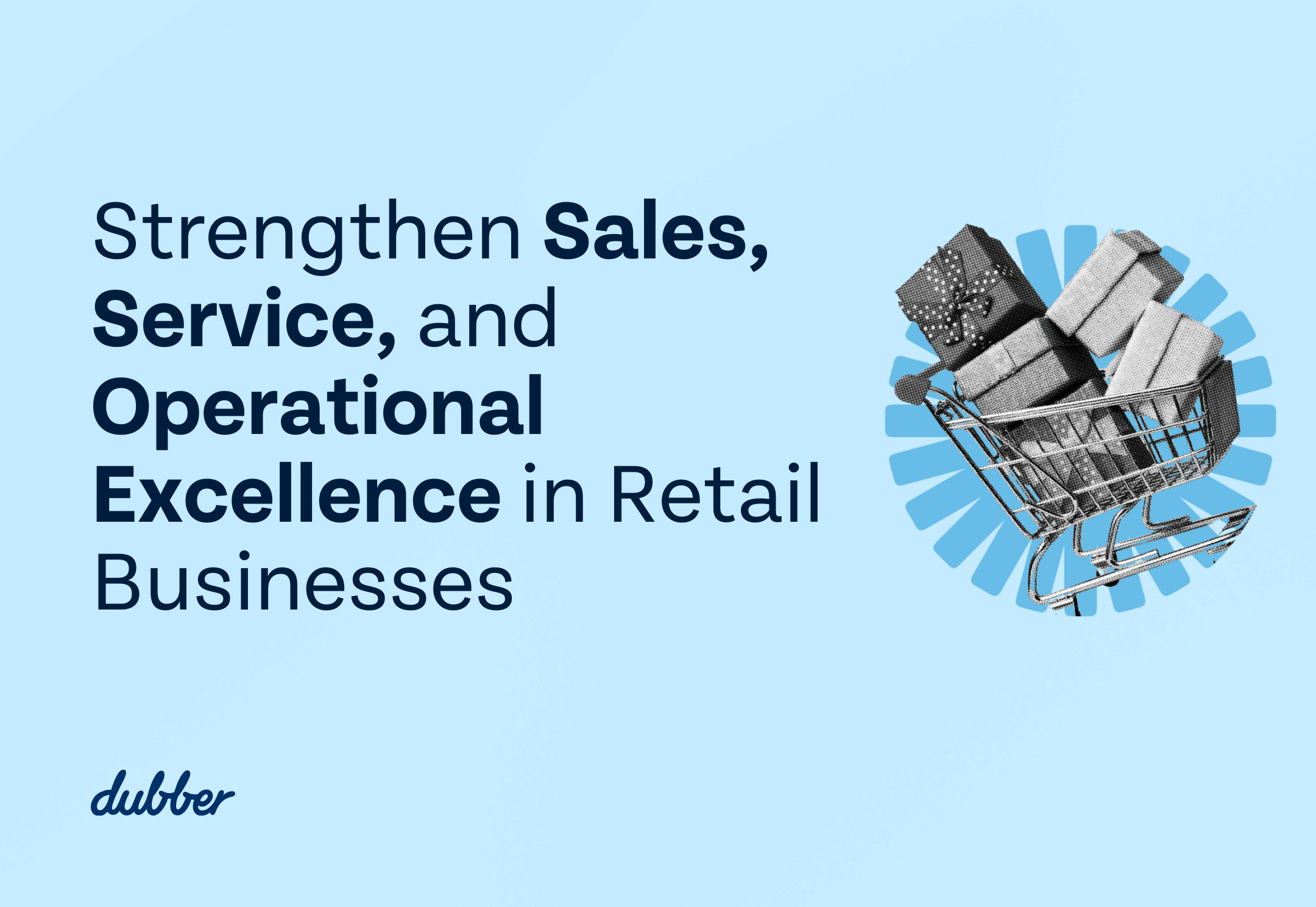
Dubber’s advanced Conversation AI is a game-changer for retail businesses looking to strengthen their business operations and generate growth. With actionable insights, we deliver real, tangible results that transform how retailers manage their in store and online interactions.
Smarter Sales and Inventory Decisions
Retailers can gain a competitive edge by tracking product requests across store networks for smarter stock management and effective marketing strategies. By analysing customer conversations, businesses can identify trends in what’s selling, what’s in demand, and where stock levels need to be adjusted.
Dubber also identifies key upselling moments, helping teams maximise sales opportunities. By detecting customer objections and understanding the reasons behind their purchase hesitation (expectations, competitor offerings etc.), retailers can reduce post-purchase dissonance and extract valuable insights to refine their sales approach, pricing, and competitive positioning.
Building Customer Loyalty Through Better Service
By categorising frequent complaints—such as product availability issues or technical challenges—businesses can proactively address recurring problems across all locations. Identifying shifts in customer sentiment, whether due to long wait times or product dissatisfaction, enables retailers to act swiftly, preventing lost sales and negative reviews. Additionally, recognising and reinforcing positive interactions helps replicate best service practices, ensuring a consistently high-quality experience that drives repeat business.
Supporting Employee Wellbeing for Improved Performance
When employees feel confident and well-equipped to handle customer interactions, they provide better service, leading to increased sales. Dubber helps businesses by detecting inappropriate or abusive interactions, enabling swift intervention. Your retail staff may face frequent calls from inpatient and rude customers who harass or threaten them, often without your knowledge. With Dubber’s Conversation AI, businesses can proactively identify these incidents, implement targeted support and training, foster a positive work environment, reduce employee turnover, and enhance the overall customer experience.
For questions on how we generate immediate business value for retail businesses and services, or other industries, contact us here: contactus@dubber.net

By analysing customer and sales team conversations, automotive dealerships can unlock powerful and actionable insights that boost productivity and improve the customer experience.
With leading voice recording and AI technology, Dubber captures and transcribes every conversation, providing in-depth visibility for automobile dealership teams to turn everyday conversations into valuable insights.
Drive More Showroom Visits: AI-Powered Insights for Sales Lead Conversion
For sales teams, Dubber’s advanced AI provides in-depth visibility into how effectively conversations are converted into appointments. Dealerships can monitor the number of conversations where test drives are offered, identify common sales objections (pricing, features, availability etc.), track follow-up offers that result in further conversation, and analyse the time spent on sales activities versus non-sales tasks at an individual, team, and dealership level.
By understanding the key interactions between sales teams and current or potential customers, dealerships can automate workflows, eliminate inefficiencies, and maximise conversion rates through tailored strategies that refine sales processes and team performance.
Elevate Service Excellence: AI-Powered Insights to Resolve Recurring Customer Issues
Beyond sales, Dubber empowers customer service teams to closely monitor customer feedback through conversations with service centre staff. Dealerships can categorise and track complaints, such as vehicle repair issues, service quality, part replacements, and more, helping to pinpoint common pain points.
This real-time data strengthens service quality by improving first-contact resolution rates and establishes best practices to streamline service processes such as inventory management and service scheduling.
Protecting Your Team: AI-Driven Insights for a Safer, Supportive Workplace
With Dubber, automotive dealerships can cultivate a safe and supportive work environment by identifying instances of inappropriate or abusive customer interactions. Our AI analyses conversations in real-time to flag abusive language and threatening behaviours, and by detecting these early, dealerships can track the frequency and severity of incidents and implement proactive measures. With these data-driven insights, automobile dealerships can take steps to protect employee wellbeing and foster a positive workplace.
Dubber is helping automotive dealerships enhance business performance and value whilst creating more meaningful relationships with their employees and customers.
For questions or queries on how we can drive success for Automotive businesses contact us here: contactus@dubber.net
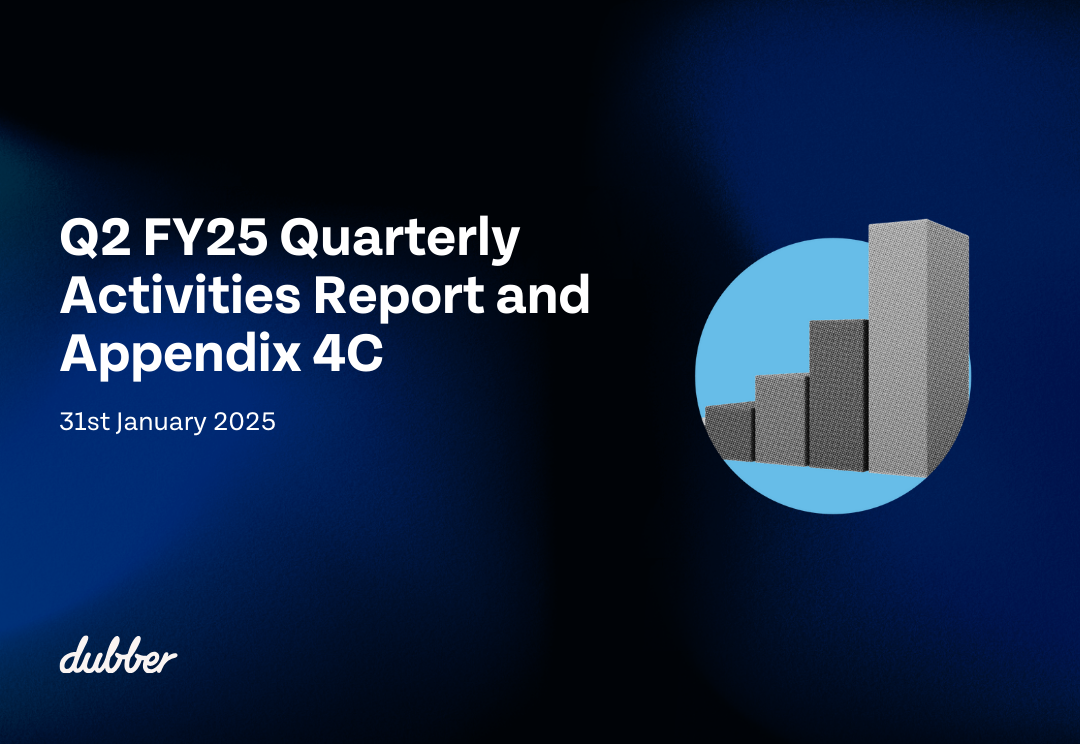
Melbourne, Australia: Dubber Corporation Limited (ASX:DUB) the leading conversation capture and intelligence platform for service providers and their customers globally, today released its Q2 FY25 quarterly report.
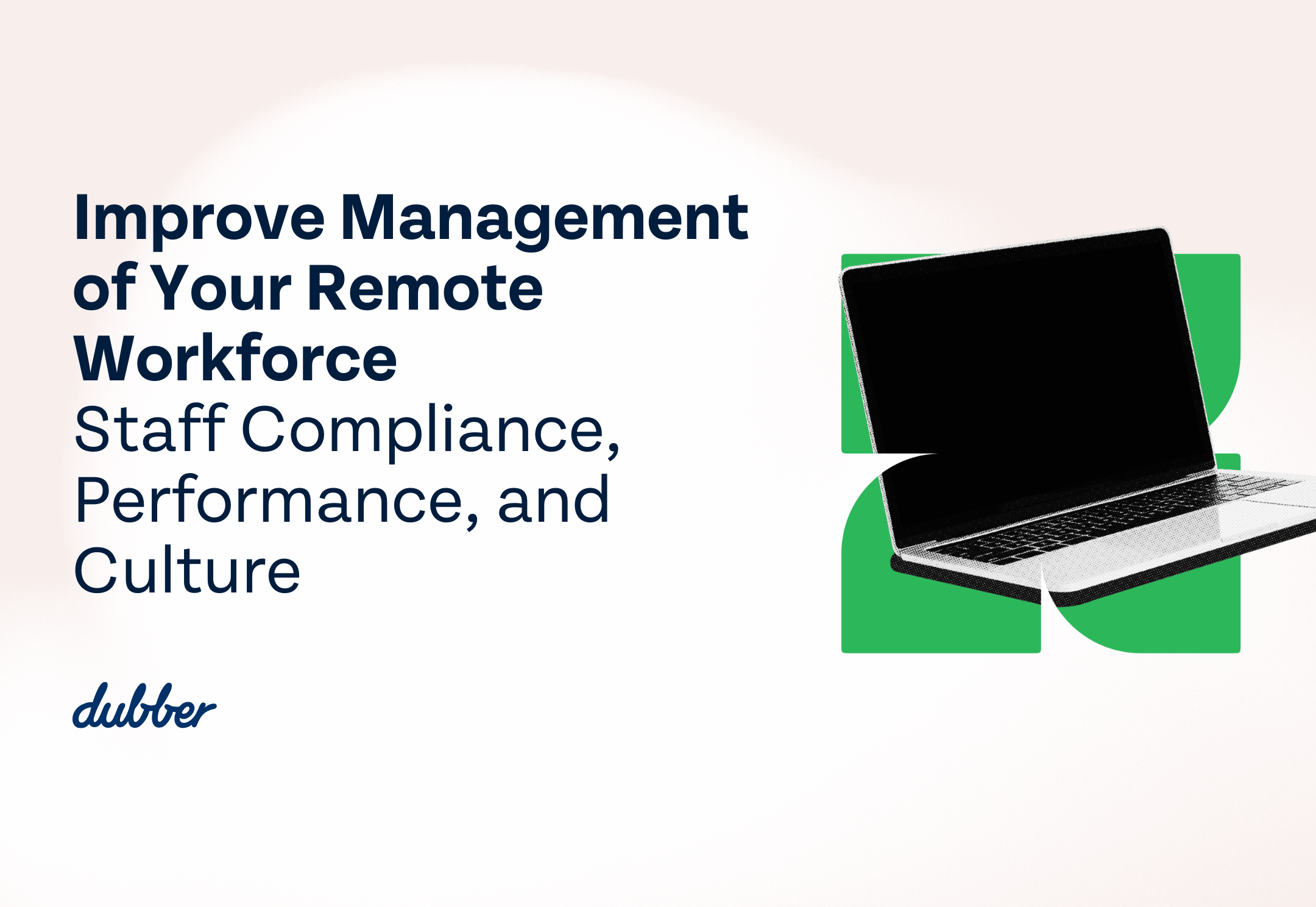
Managing a highly mobile workforce presents unique challenges such as ensuring compliance, tracking performance, and providing effective training without in-person supervision. Businesses with teams on the road, working from home or in hybrid situations need solutions that can provide immediate value, efficiently connect and manage teams, and support long-term growth.
Staff Compliance with Internal Policies and Regulations
Dubber automatically records and securely stores every call, providing a clear audit trail for all customer interactions. This ensures that staff comply with company policies and regulatory requirements at all times. With built-in oversight, businesses can actively monitor adherence, prevent HR issues, and enforce compliance across teams—regardless of their working location.
Streamlining Training and Performance Tracking
Call recordings and transcriptions provide actionable, valuable data, and by capturing conversations from team members in real-time, Dubber builds a compliant and centralised resource.
Businesses with mobile workforces may struggle with the ability to monitor and assess employee contribution, as it becomes more difficult to ensure they are engaging in meaningful conversations, adhering to company policies, and delivering the expected output.
With the Dubber platform , managers can manage the conversations of their teams and where appropriate reinforce best practices, highlight successful strategies, address areas of improvement, and monitor overall performance.
Building a Collaborative Team Culture
With collaboration through real-time call insights, managers can share successful sales strategies, common challenges, and key takeaways from conversations. By sharing these learnings, teams exchange knowledge and best practices can be implemented.
Simplifying Remote User Activation and Onboarding
Dubber’s open API and seamless integrations allows managers to activate new users from anywhere, speeding up the onboarding process through a frictionless experience.
Managing highly mobile and dispersed workforce comes with challenges, but with the right tools, it can become an opportunity for growth. Dubber is here to help.
For questions or queries on how we can drive success for your business contact us here: contactus@dubber.net
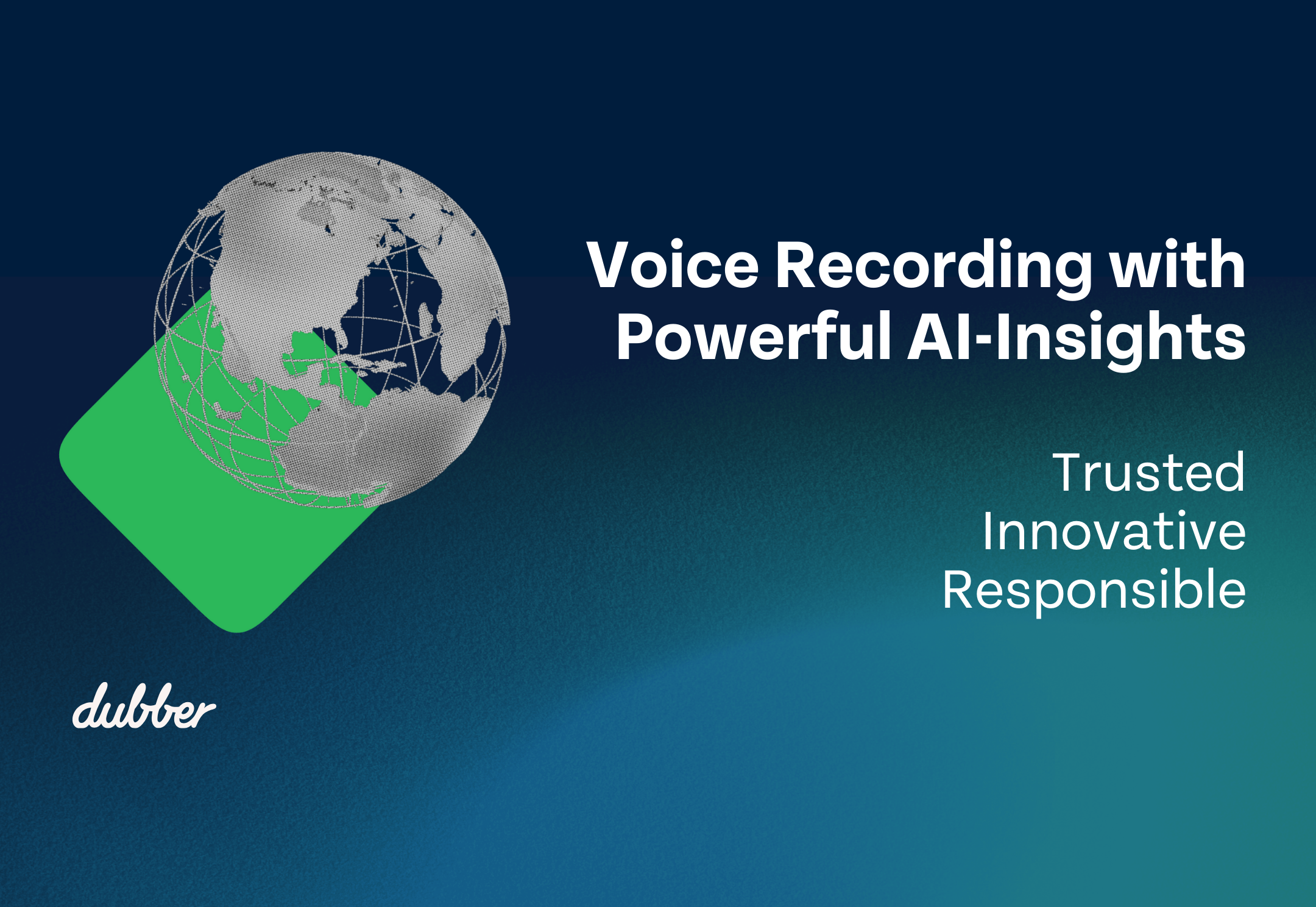
As we look ahead to 2025 and beyond, Dubber is focused on delivering the next generation of voice recording and powerful AI insights, while building more meaningful connections with our customers and partners worldwide.
Building Trust with Technology
Businesses need solutions they can rely on to provide secure, seamless, and compliant communication experiences. Dubber has earned the trust of businesses worldwide by delivering reliable and efficient solutions that meet the highest standards of compliance. We work, and continue to grow, with telecommunications providers and organisations to offer trusted, actionable solutions that deliver immediate business value.
By prioritising transparency, security, and innovation, we provide full visibility into our security practices through our Trust Center, reinforcing Dubber’s commitment to data protection and regulatory integrity.
Driving Innovation for the Future
From voice recording to our AI-powered conversation intelligence, our team of expert engineers and data scientists are continuously developing and executing new capabilities that deliver deeper insights and value for our users.
Through ongoing research and development, we are focused on reshaping industries and empowering businesses to increase operational efficiency, remain competitive, and improve business decision making.
Leading with Responsibility
As we build for the future, we are committed to responsibility by prioritising ethical practices, regulatory compliance, and the highest standards of quality. This is reflected in the way we work and how we develop and distribute our solutions.
Our in-house AI models are rigorously trained, tested, and deployed to ensure transparency and accountability at every stage. Being responsible also means making our solutions accessible, easy to deploy, and compliant, supported by quality assurance processes and an ongoing focus on data security.
By using ethical and responsible AI practices, we’re delivering not only performance and security, but a peace of mind for our partners and customers.
As we continue to innovate and grow, Dubber remains focused on being a trusted partner, a leader in AI-driven communication solutions, and a company committed to the highest standards of responsibility. We look forward to driving value with you.
Contact us with any questions or inquiries.
Learn about Dubber on Microsoft Teams:
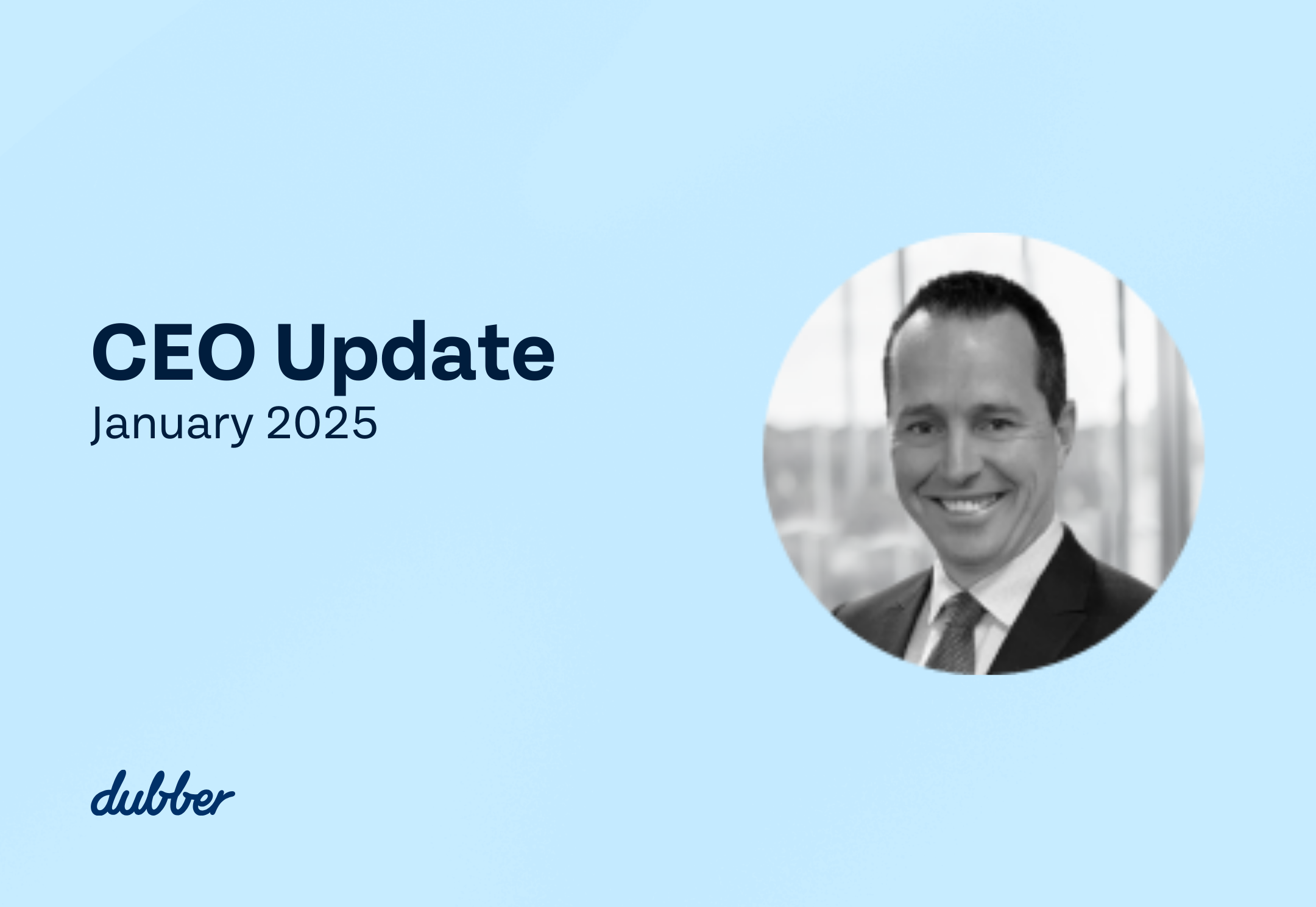
Happy New Year, everyone! As we step into 2025, we’re energised by the opportunities ahead and the incredible momentum already building across our business.
This year, we’re starting strong with a bold initiative to reposition our market-leading AI. These updates are focused on accelerating the uptake of Dubber Insights across a broad range of segments that include Automotive, Retail, Financial Services, Construction, Healthcare and Government. With Conversation AI we’re setting a new standard for value and innovation—ensuring both our partners and customers stay ahead of the curve.
Our platform investments from the last quarter have already started delivering significant value to our customers. Key highlights include the launch of our AI self-learning feature, which customises deeper insights across all our Dubber Moments, accessible to all customers with no effort required. We also enhanced call recording capabilities for Webex Contact Centre and Zoom, alongside updates to our technology supporting MS Teams. These advancements further strengthen our competitive position in call recording and conversation AI.
We’re also thrilled to welcome a dynamic new board that shares our vision for growth and leadership. Across the organisation, there’s an undeniable buzz of excitement as we see our positive culture driving fresh energy into everything we do. From a strong start in sales to a renewed commitment to building the features within our platform that secure our market leadership, it’s clear that 2025 will be a year of impact.
To our valued partners, customers, and dedicated team members: we hope you enjoyed a well-deserved break and feel as recharged as we do. Together, we’ll achieve extraordinary results, and we can’t wait to share this journey with you.
Looking forward to an incredible 2025 with our partners and customers!
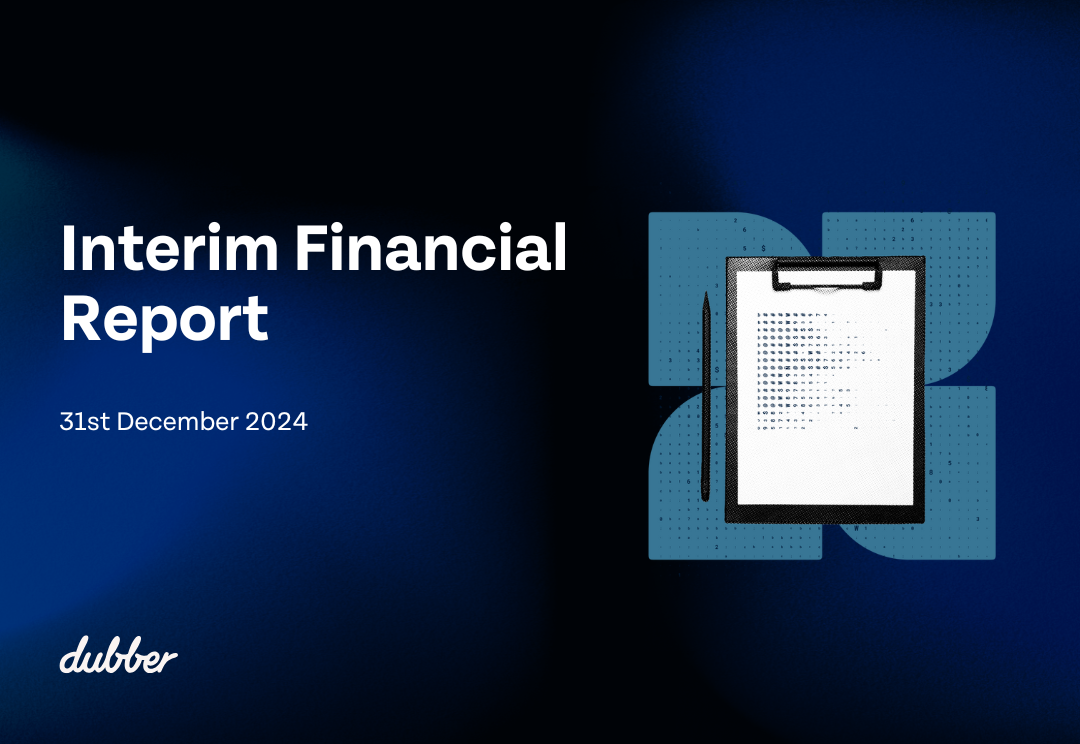
Melbourne, Australia: Dubber Corporation Limited (ASX:DUB) the leading conversation capture and intelligence platform for service providers and their customers globally, released its Interim Financial Report for the half-year ended 31 December 2024.
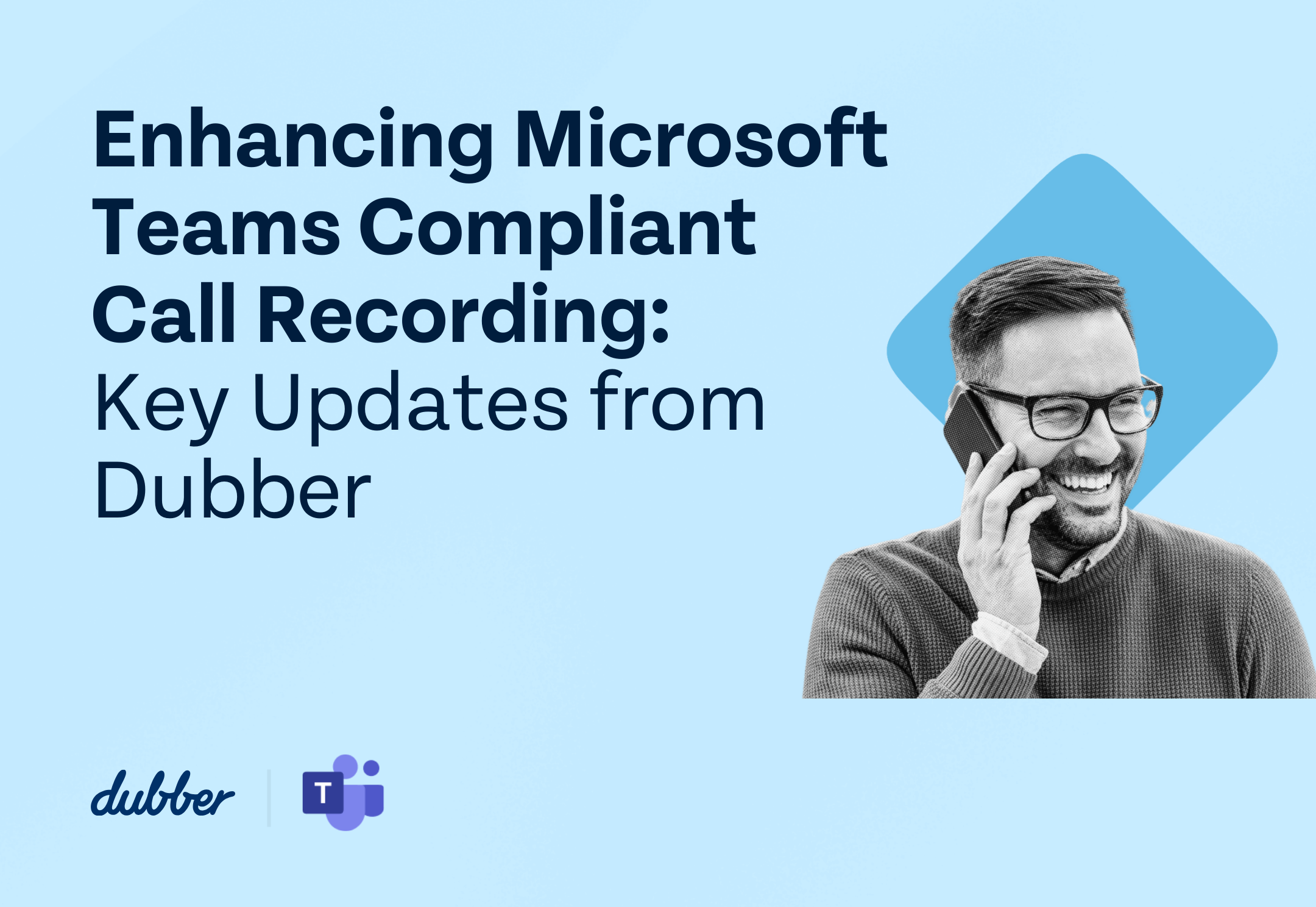
With the continued rise of hybrid and remote work, Microsoft Teams has become a cornerstone of modern business communication. With more than 320 million endpoints on Teams Meetings and 20 million on Teams Phone, Dubber’s commitment to enhancing call recording capabilities and providing comprehensive solutions remains stronger than ever.
We have recently rolled out a series of important and enhanced updates to our Microsoft Teams call recording solution, bringing greater functionality and improved user experience. If you missed it, or if you’re looking to explore how these improvements can continue to benefit your organization, here are the key enhancements designed to optimize your compliance and data capture strategies.
Advanced Recording Capture Controls
Dubber’s call recording solution for Microsoft Teams offers even more flexibility with advanced recording controls. Businesses can choose exactly what they want to record, whether it’s internal calls, external calls, or meetings with clients versus colleagues. This level of granularity helps tailor solutions to specific organizational needs and gives more control in customizing recording strategies.
Simplified Set-up for Faster Deployment
The updates eliminate complex account setup processes, making the entire process more intuitive and efficient. This streamlined system enables partners and enterprise customers to quickly deploy Microsoft Teams call recording across multiple accounts with minimal effort. With fewer technical barriers and faster implementation, businesses can start capturing valuable conversation data without delays, for quicker access to the insights they need to drive better outcomes.
Reliability and Scalability for Global Teams
Dubber’s call recording solution is built for global scalability and reliability, ensuring that every call is captured, no matter where or when it occurs. Our setup ensures that there’s always a bot available to service calls, even in the busiest global environments. Whether you’re managing large meetings across time zones or scaling up during peak periods, it automatically adapts to meet your business needs – no manual intervention required.
We remain committed to evolving our platform to ensure that our partners and customers have the tools they need to stay compliant and gain valuable insights from their conversation data.
To hear Vish Kaimal, Dubber’s Product Lead speak more about these updates, and how they are transforming Teams Recording, watch the video here:
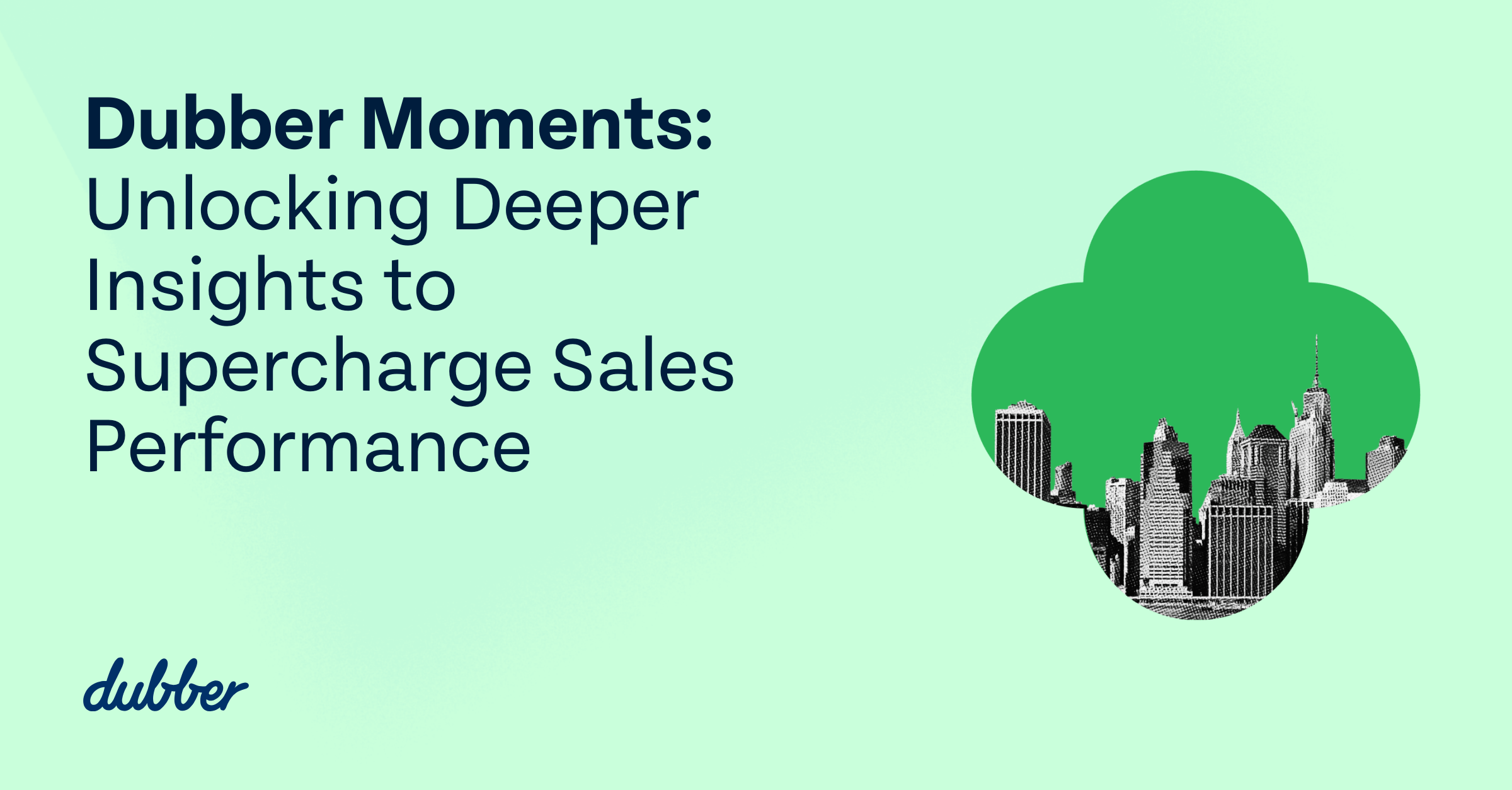
Sales managers often come to us with a simple request: they want to better understand the conversations their teams are having with customers. Their first instinct is usually to conduct a focused search into their conversation data. After all, tracking specific topics—whether it’s certain products, service points, or pricing discussions—is essential for managing key metrics and aligning sales efforts with strategic goals. But when it comes to conversation intelligence, there’s an opportunity to move beyond just looking for what you think you should find.
In our discussions, we heard a frequent request: sales leaders wanted a clear way to validate that their teams were discussing the products and services most relevant to their business. And, with Dubber’s Moments—a targeted tool aimed at improving the visibility of high-stakes conversations, like those related to closing sales—they found a solution. This tool initially allowed managers to zoom in on the content of these discussions and quickly confirm whether strategic topics were covered. But, as they soon discovered, there was more value in conversation intelligence than a single-threaded view could capture.
For the first time, managers were able to see beyond isolated conversations and gain a broader view of all customer interactions. This panoramic view fundamentally changed their perspective. Instead of merely verifying individual interactions, managers gained insights into larger patterns, emerging customer needs, and unanticipated obstacles. It revealed not only what was being discussed, but also highlighted gaps and opportunities to refine their training and support for sales teams.
This new perspective demonstrates the value of open-ended exploration in conversation data. A focused search can give managers the data they think they want—but the broader view can reveal data they didn’t know they needed. Through this lens, conversation intelligence becomes more than a simple audit tool. It evolves into a powerful asset that supports strategic adjustments, whether that’s enhancing team training, refining messaging, or identifying new areas of growth.
With Dubber Moments, managers are now able to provide real-time feedback, helping their teams have the right conversations and equipping them with the support they need to succeed. By starting with focus but expanding to perspective, true value is uncovered, making every customer conversation a building block for a stronger sales strategy.
At Dubber, we’re not just about giving managers the ability to track keywords or topics. We’re about empowering them with a deeper understanding—an open view that brings true perspective, enriching every interaction and driving a smarter path forward for sales teams and organizations alike.
Contact us to find out more.
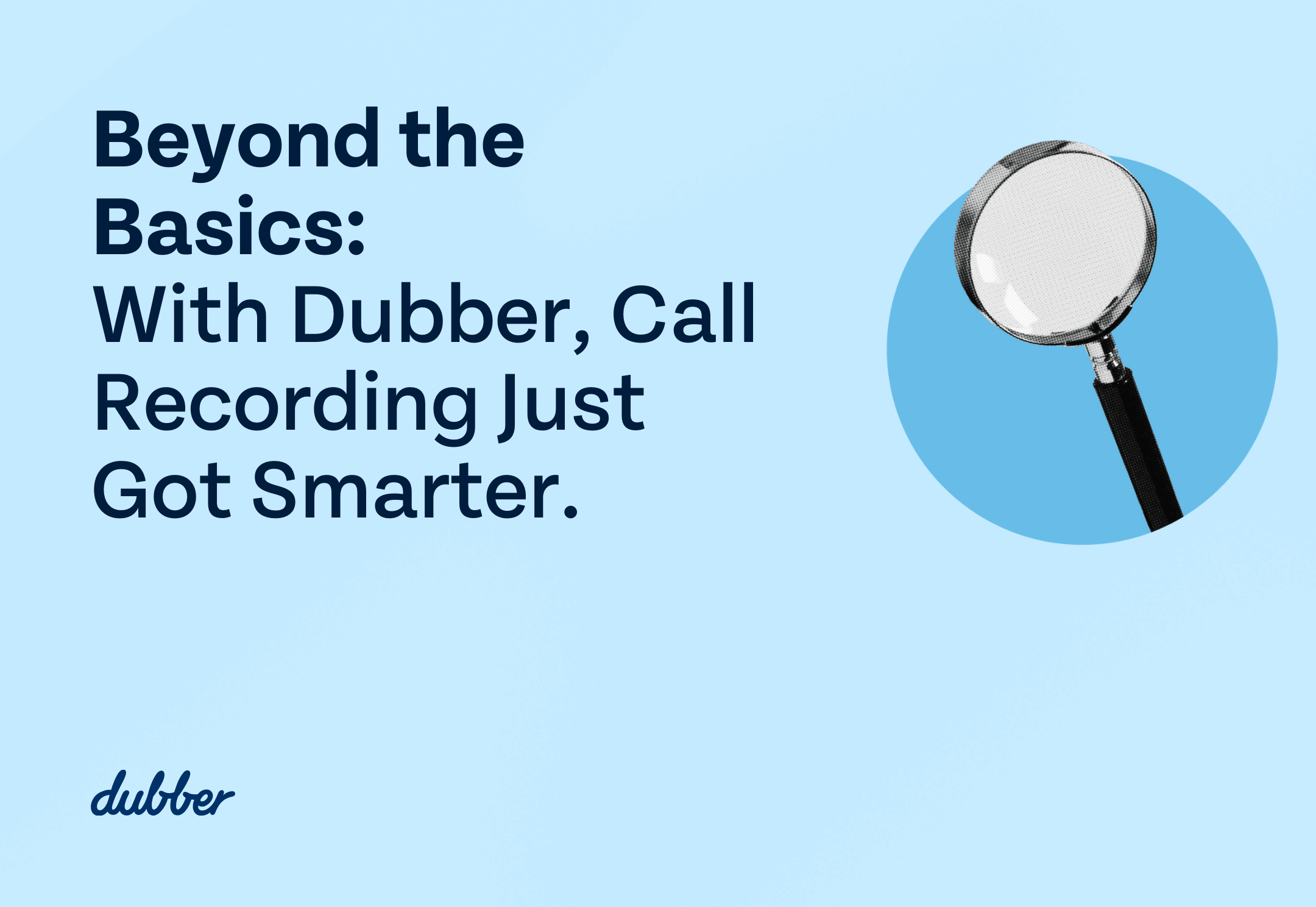
Simply recording calls is no longer enough. Organizations need more than just compliance and records; they need insights that drive business growth whilst enhancing the customer experience. Dubber Recording + Trends is redefining what call recording can achieve.
Why Recording Calls matters
Call Recording has become a crucial tool for businesses looking to improve operations, ensure compliance, and improve the customer experience. However, many solutions available in the market treat recording as just that – a basic functionality. At Dubber, we believe that it should be so much more.
Dubber Recording + Trends
Dubber Recording + Trends merges compliant call recording with cutting-edge AI-driven conversation intelligence. This isn’t just about capturing conversations; it’s about transforming them into actionable insights for optimized internal and external operations.
One of the standout features of this solution is Highlights. This powerful tool enables users to easily identify key Trends, or recurring topics, happening within conversations.
Picture this:
A customer service manager receives a report indicating a spike in call volume related to a specific product. With traditional call recording, they would have to sift through countless conversations to identify the root cause. With Highlights, they can quickly pinpoint that common issue, and armed with this information they can take immediate action, whether it’s escalating the issue, or proactively reaching out to the specific affected customers to offer solutions.
Similarly, a sales team notices an unexpected decrease in performance over the past few weeks. Instead of relying on general metrics or dismissing it as seasonal slowdown, the sales manager can turn to Highlights and could discover that there has been a shift in customer sentiment as many client’s express concerns about pricing compared to competitors. With this insight, they can adapt their pitch, offer an incentive, or consider adjusting their pricing strategy to meet market demands.
With Highlights, your customers gain the ability to act faster, make informed decisions, and drive better, mutual business outcomes for you and your customer.
Call recording with Dubber isn’t just a service; it’s a strategic advantage. By integrating AI-driven conversation intelligence with compliant recording, we help businesses harness the power of their conversations.
Are you ready to transform your call recording experience? Let’s talk about how Dubber can elevate your organization today: contactus@dubber.net.
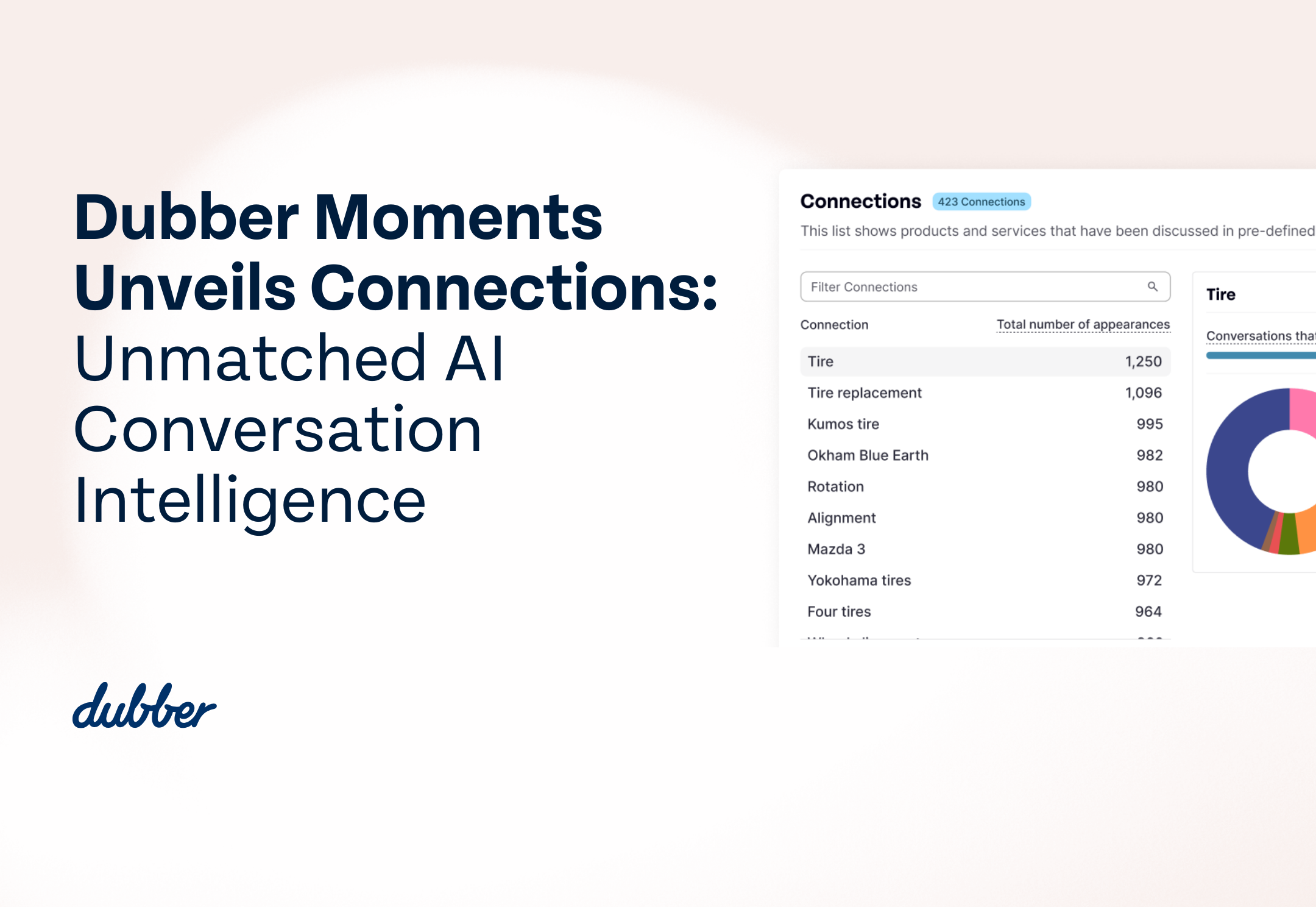
Meaningful customer interactions are increasingly important, and grasping the intricacies of conversations can set businesses apart. Making and understanding these connections are at the heart of successful business operations, as they shape our interactions, influence strategic decisions, and drive growth.
That’s why we’re excited to introduce Connections. As a standout feature in our AI-driven conversation intelligence platform, Dubber Moments, Connections empowers businesses to unlock deeper insights tailored to customers’ unique business needs, reshaping every interaction into a strategic opportunity for growth.
The Power of Connections
Dubber Connections takes conversation intelligence to the next level. Unlike traditional keyword searches that merely skim the surface, this groundbreaking feature identifies specific product names, services, or brands within each Moment in conversations. It aggregates data on mentions, customer segments, and trends, providing organizations with a comprehensive understanding of their marketing presence and potential opportunities.
With Dubber Connections, you can uncover insights that matter most, leading to smarter strategic decisions.
Why Choose Dubber Connections?
Tailored Insights
Deliver insights that align with your customer’s specific business needs enabling more effective decision making.
Improved Market Understanding
With deeper analysis, businesses can grasp their market presence and identify new opportunities.
Seamless Integration
Dubber Moments can be seamlessly integrated into your existing operations, allowing you to harness these capabilities with minimal disruption.
Competitive Edge
Differentiate in a saturated market with advanced insights that traditional solutions cannot match.
The launch of Dubber Connections is more than just an upgrade; it’s a commitment to innovation and excellence in conversation intelligence. We invite our partners to explore how this feature can elevate your offerings. If you’re not yet leveraging our advanced AI capabilities, now is the time to discover the unparalleled advantages that Dubber Moments can provide.
Join us in connecting the dots for your customers – let’s redefine what’s possible in conversation intelligence.
Ready to learn more? Contact us today to see how you can start offering Dubber Moments to your customers.
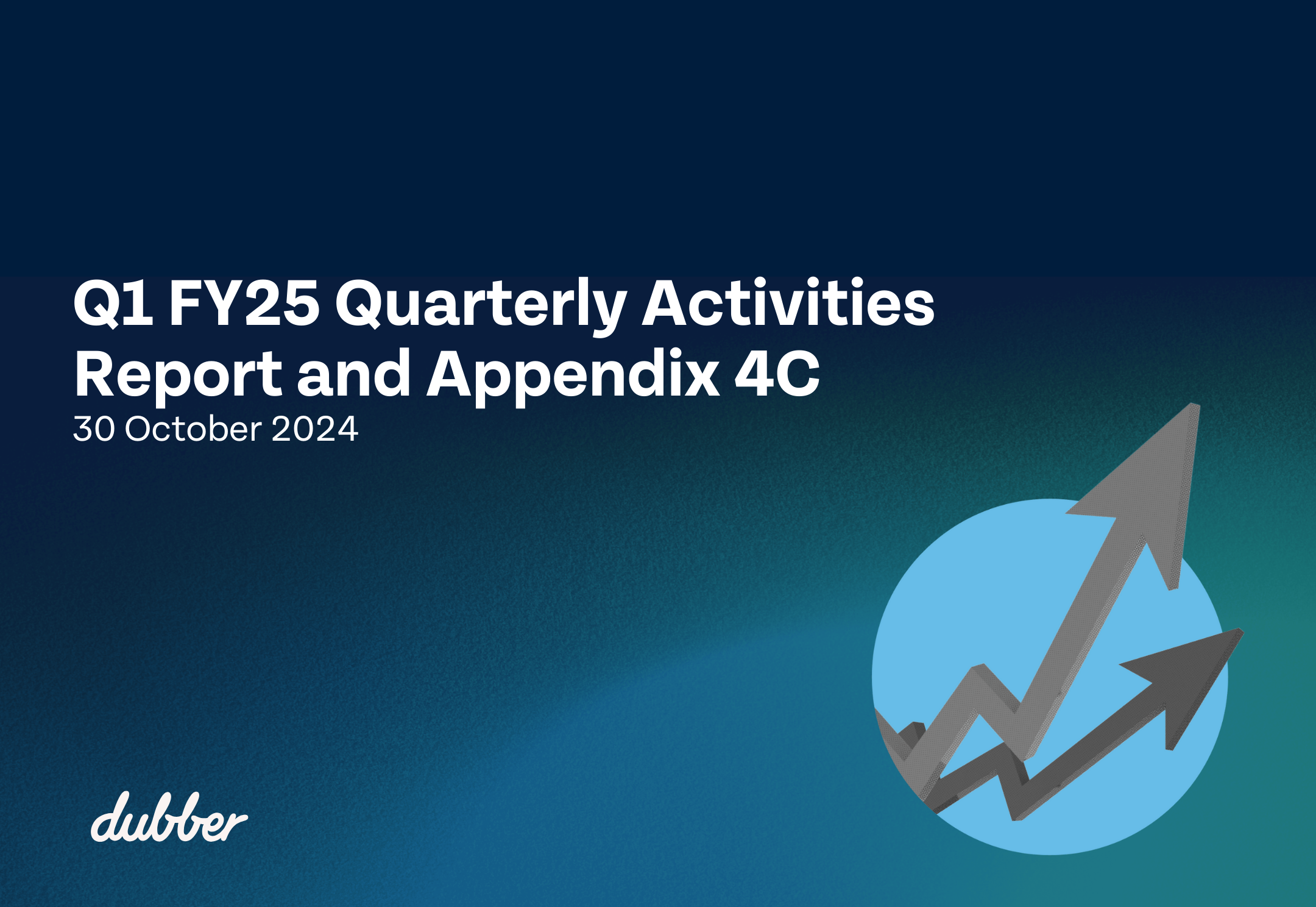
Melbourne, Australia: Dubber Corporation Limited (ASX:DUB) the leading conversation capture and intelligence platform for service providers and their customers globally, today released its Q1 FY25 quarterly report.
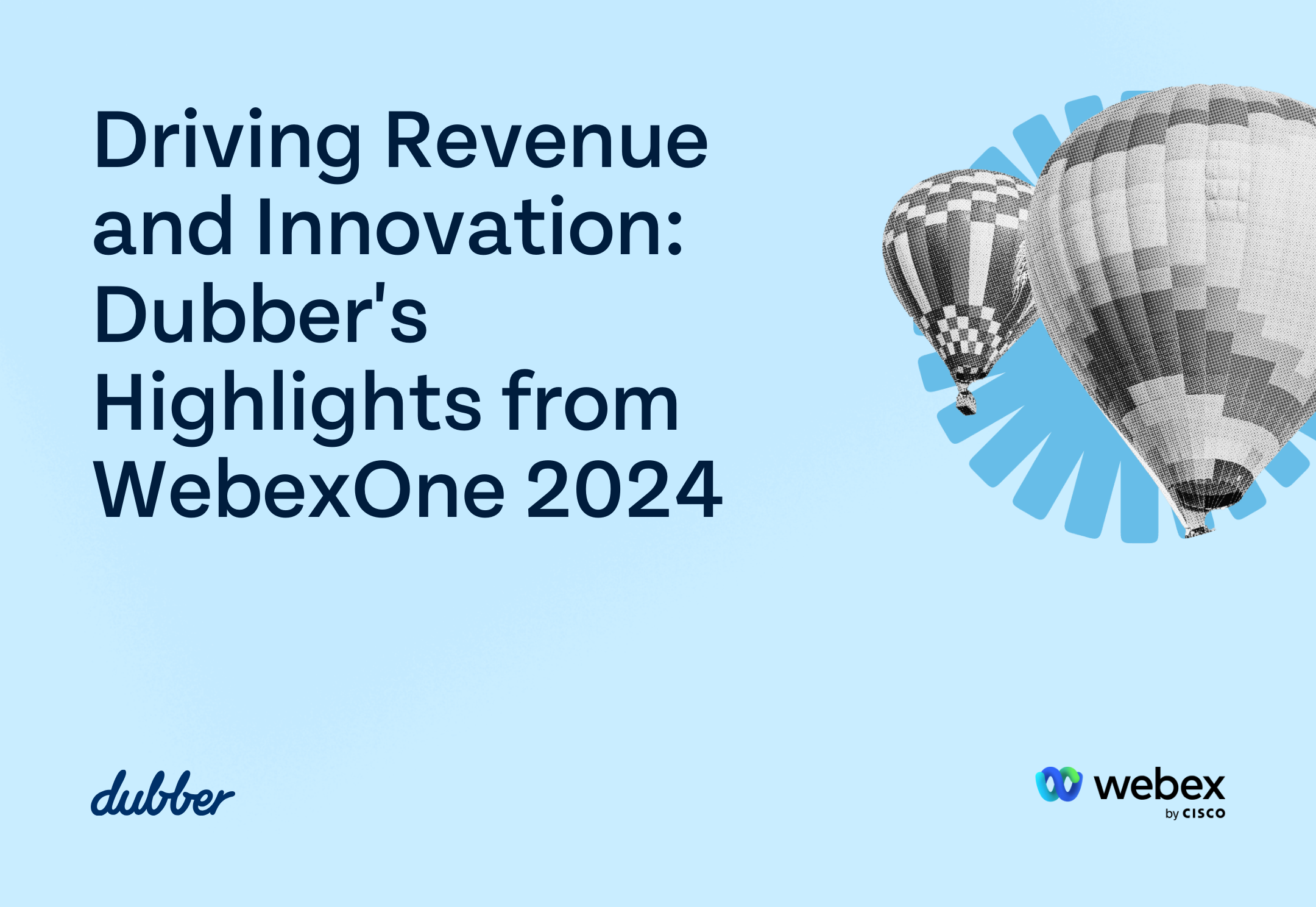
Another WebexOne in the books! As a proud Cisco partner, Dubber was thrilled to sponsor the event and showcase our commitment to enhancing communication and driving revenue growth for Cisco partners, sellers, and customers. With our latest product expansions and integrations available on Cisco, we’re redefining the possibilities in conversation capture and business intelligence.
As expected, AI was a significant focus at the event, highlighting how technology is reshaping communication strategies across different industries. Attendees explored the transformative power of AI, discussing its role in automating processes, enhancing customer experiences, and providing business insights that were previously unattainable.
Dubber engaged in conversations around the future of AI-driven solutions and their ability to analyze large amounts of data quickly, offering actionable insights that inform business strategies. This evolution is particularly relevant in today’s fast-paced and digital environment, where businesses must adapt swiftly to changing customer expectations. Dubber’s AI, built from the ground up, is specifically designed to harness these capabilities, providing seamless integration and real-time analysis that empower organizations to unlock the full potential of their conversations. Our proprietary AI technology ensures that every interaction becomes a source of valuable insights, driving smarter decision-making and enhancing operational effectiveness.
We took the opportunity to discuss our new product offerings, Dubber Recording + Trends and Dubber Unified Capture + Insights. These innovations leverage our market-leading call recording capabilities while integrating advanced AI-powered conversation intelligence. By analyzing conversations in real time, organizations can uncover actionable insights that drive better decision-making and enhance customer interactions.
Dubber’s updated products not only provide a more extensive offering to meet the diverse needs of our customers, but also present a significant opportunity for Cisco partners and sellers to drive revenue per user on Webex. Dubber users can now seamlessly upgrade and deploy paid SKUs directly within the Cisco Control Hub, simplifying the upgrade process and encouraging a seamless transition to premium offerings. This streamlined approach is designed to boost user adoption of Dubber’s advanced technology, increasing ARPU for partners and sellers alike.
Whether you are deploying Webex for small businesses or large enterprises, Dubber’s solutions automatically deliver insights across the entire organization. Looking ahead, further enhancements in our integration with Cisco will focus on improving awareness and engagement, ensuring sustained revenue growth and greater value for customers.
Thanks again to the Webex team for having us, let’s continue to drive innovation and unlock value together!
To learn more about Dubber’s solutions available on Cisco Commerce Workspace (CCW), contact us at cisco@dubber.net.
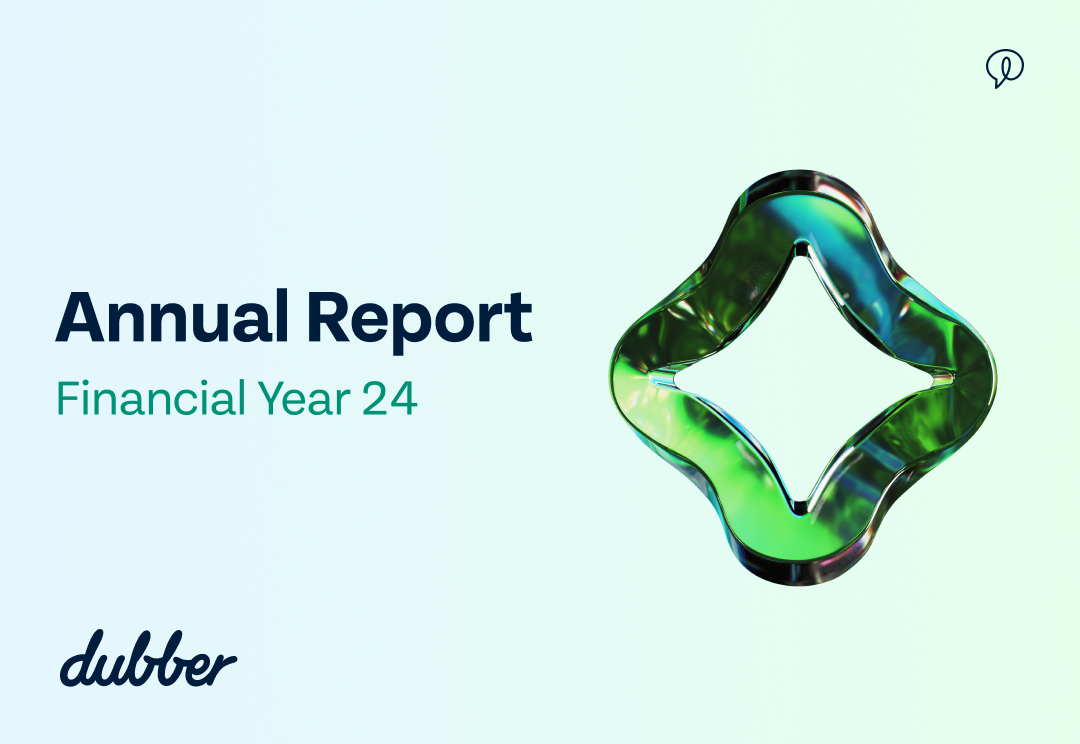
Melbourne, Australia: Dubber Corporation Limited (ASX:DUB) the leading conversation capture and intelligence platform for service providers and their customers globally, today released its FY24 Annual Report.
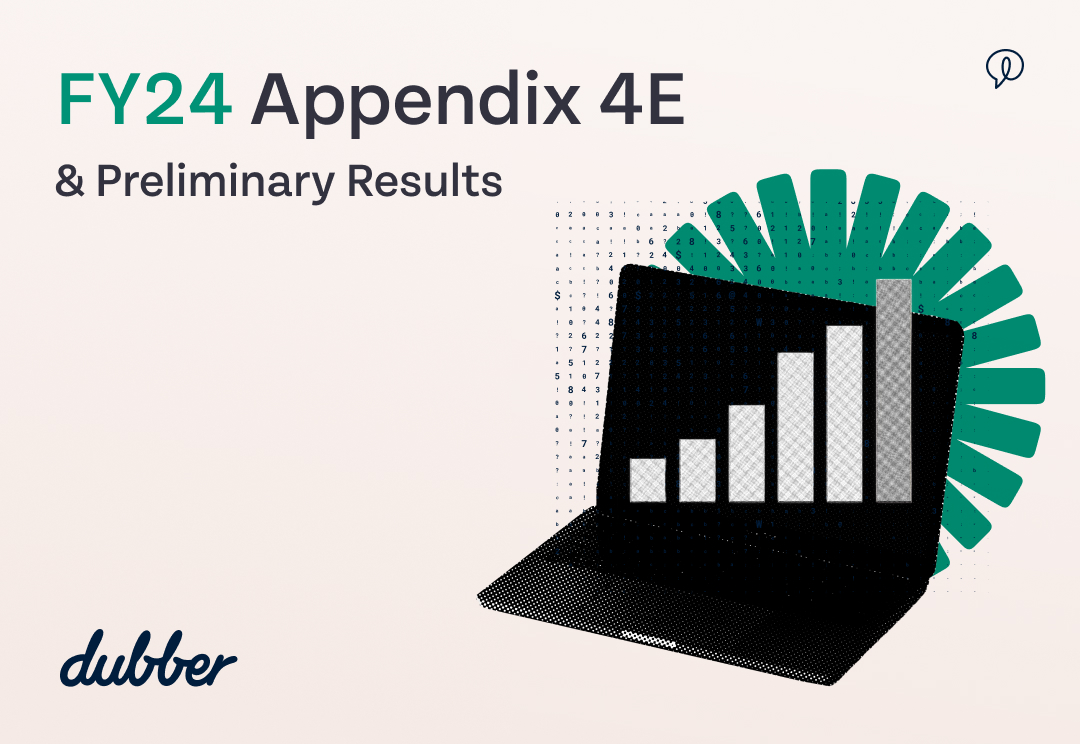
Melbourne, Australia: Dubber Corporation Limited (ASX:DUB) the leading conversation capture and intelligence platform for service providers and their customers globally, today released its FY24 Appendix 4E & Preliminary Results.

Introduction: The Convergence of UCaaS and CCaaS
In the ever-evolving world of customer service, Contact Center as a Service (CCaaS) has become a game-changer, expected to grow by 19.1% annually from 2023 to 2030. This growth is largely driven by the surge in remote workforces, emphasising the need for flexible solutions. CCaaS provides the infrastructure and tools for quality customer service, regardless of location.
In parallel, Unified Communications as a Service (UCaaS) has made its mark in contemporary business operations, seamlessly integrating various communication tools (such as instant messaging, video conferencing, and VoIP) into a unified, cloud-based platform. The convergence of UCaaS and CCaaS is reshaping the landscape, streamlining operations and enhancing customer outcomes.
Despite this evolution, some platforms, while offering built-in solutions for recording content, may lack the advanced data and control capabilities vital for regulated environments. Operating on isolated data sets, these platforms risk providing an incomplete understanding of the comprehensive customer context, especially in scenarios requiring strict compliance adherence.
Solution? Dubber’s Innovative Integration with Webex Contact Center
Dubber introduces an innovative integration tailored for Webex Contact Center, taking its ongoing support for Webex to new heights and bringing a variety of benefits for businesses. Let’s dive in:
Benefits of Dubber on Webex Contact Center
- Dubber on Webex Contact Center offers businesses a secure and compliant call recording solution, leveraging conversation intelligence for powerful insights derived from every conversation.
- Dubber on Webex Contact Center empowers businesses to utilise the entire Webex suite across front-line, knowledge workers, and contact centres. All activities are conveniently captured through one unified Dubber solution, offering a streamlined, single pane of glass for managing call-captured content. It’s worth noting that this is complemented by Dubber being a standard feature in all Webex Calling services, with our licensing seamlessly integrated into the entire Webex suite.
- Dubber equips your business with robust monitoring and reporting tools, offering a clear view of call quality, compliance, and customer service.
- The integration with Webex Control Hub portal and Single Sign-On feature adds a layer of convenience, minimising administrative hassles and ensuring a seamless user experience for your team.
- The integration also brings Dubber Moments, our award-winning, AI-powered conversation intelligence solution, (including our themes: Voice of Customer, Employee Safety & Wellbeing, Sales Performance and Security & Compliance) as a readily available feature for Webex CC.
Seamless Onboarding: Your Fast Track to Success
Getting started with Dubber for Webex Contact Center is a breeze. Whether you opt for Dubber Unified Capture or Dubber Insights package through CCW, our streamlined onboarding process ensures you hit the ground running, unlocking the full potential of your customer service.
Conclusion
Dubber stands out as the top choice for businesses requiring comprehensive solutions for their contact centres, with its advanced features and capabilities positioning Dubber as a leading provider for diverse requirements beyond call recording.
Ready to explore how Dubber can transform your contact center? Let’s chat today and uncover the possibilities!
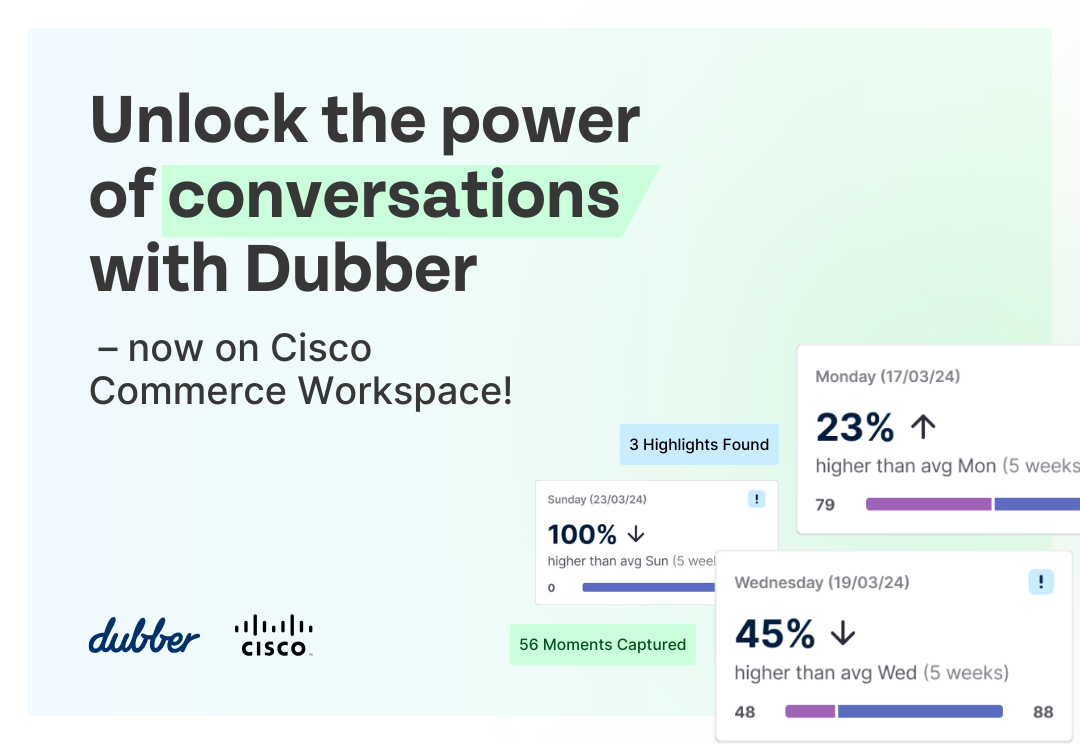
Dubber, the global leader in Conversation Capture & Conversation Intelligence is pleased to announce the expansion of its offerings on Cisco Commerce Workspace (CCW) to include our latest growth products, available immediately. Powered by Dubber’s proprietary AI technology, this update broadens the scope of Dubber’s out-of-the-box solutions for Cisco partners and customers, providing seamless access to cutting-edge call recording and actionable business intelligence capabilities that drive revenue growth.
At Dubber, innovation drives everything we do. Our latest AI-powered solutions capture critical moments in conversations, detect emerging trends, and deliver actionable insights instantly—without any setup required. The integration of Dubber Moments with Dubber Recording provides users with immediate access to the Trends dashboard on the Dubber Platform, unlocking powerful insights that elevate customer experiences and optimize sales team performance. Demonstrating the true potential of conversation intelligence, this integration showcases the value derived from the advanced AI capabilities of the Dubber Platform and paves the way for upselling to more sophisticated solutions powered by our state-of-the-art AI.
New CCW Dubber products:
Dubber Recording + Trends: Leverages Dubber’s market leading call recording with access to AI powered conversation intelligence to analyze conversations in real-time. By combining powerful call recording with actionable trend analysis, this value-packed solution allows businesses to uncover actionable insights from their communications.
Dubber Unified Capture + Insights: Features market leading unified conversation capture with access to AI powered conversation intelligence. This solution provides comprehensive conversation capture across multiple channels, delivering exceptional value by transforming every interaction into meaningful intelligence. With exclusive access to One Moment, you gain holistic and transformative insights that enhance decision-making and drive business success.
“We are excited to extend our product offering with Cisco, delivering unparalleled access to the innovative capabilities of the Dubber Platform,” stated Adrian Di Pietrantonio, EVP of Global Partners at Dubber. “This partnership empowers Cisco Partners to harness the power of Dubber Moments, our patented, award-winning conversation intelligence that unlocks business insights from call recordings and paves the way for Cisco Partners to grow revenue and provide more value to their customers.”
Dubber remains the only fully embedded, fully automated OEM Recording and AI solution in Webex, setting a new standard for communication intelligence. This expansion is significant in Dubber’s ongoing collaboration with Cisco, reinforcing our shared commitment to delivering cutting-edge communication solutions to businesses worldwide.
For more information about Dubber solutions available on Cisco Commerce Workspace (CCW), contact us at cisco@dubber.net.
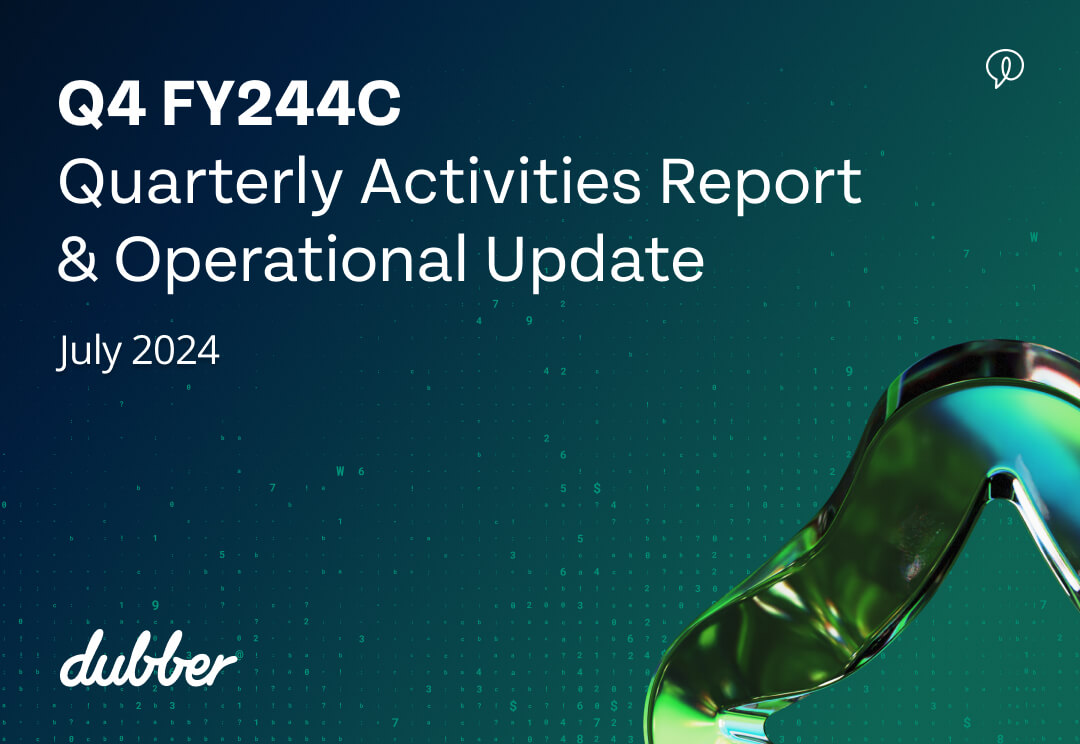
Melbourne, Australia: Dubber Corporation Limited (ASX:DUB) the leading conversation capture and intelligence platform for service providers and their customers globally, today released its Q4 FY24 quarterly report.
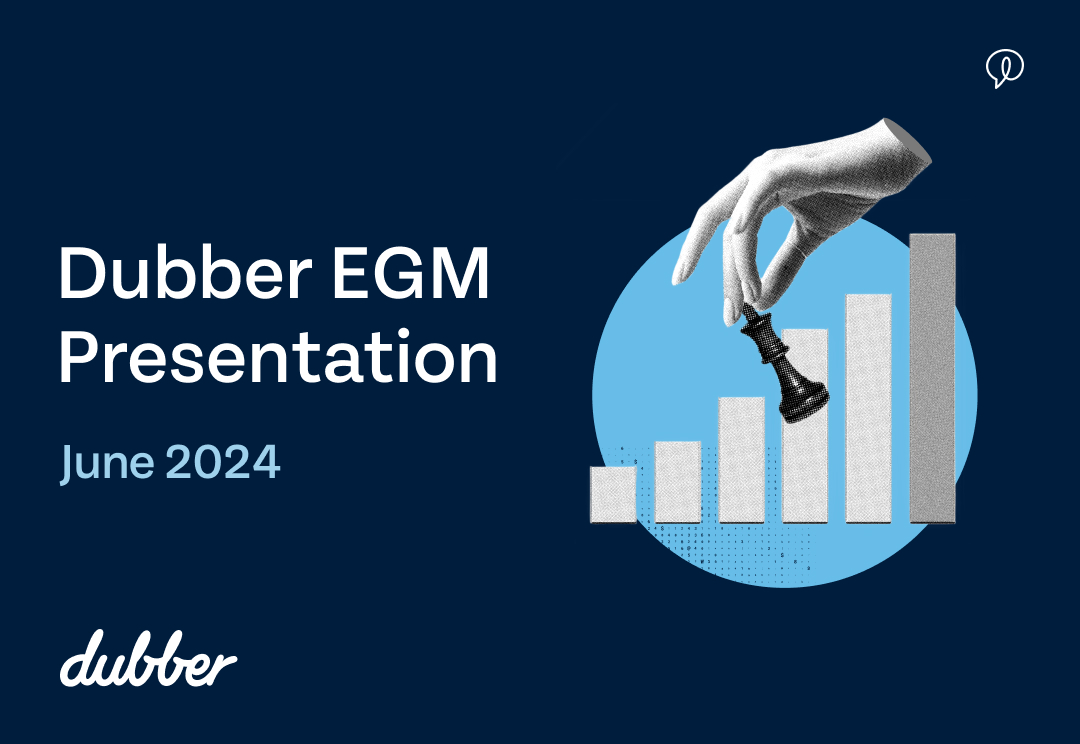
Melbourne, Australia: Dubber Corporation Limited (ASX:DUB) the leading conversation capture and conversation intelligence platform for service providers and their customers globally, was pleased to present an update to investors at the Executive General Meeting held on 24th June 2024 .

In today’s fast-paced business environment, staying ahead requires more than just keeping up with technology – it means leveraging it to its fullest potential. Dubber’s integrated solutions for Microsoft Teams are designed to revolutionise your business operations, whether you’re focusing on compliance, customer experience, sales performance, or dispute resolution. By capturing and analysing every conversation, you unlock valuable data that drives better decisions and outcomes.
Why Dubber for Microsoft Teams?
- Seamless Integration: Say goodbye to complicated setups. Dubber’s native integration with Microsoft Teams ensures every call and interaction is automatically recorded with just a few clicks. Focus on what matters most while Dubber handles the rest.
- Unmatched Compliance and Security: For many organisations, compliance is a critical concern. Dubber addresses this by meeting stringent standards, including PCI, HIPAA, and GDPR. Our platform features enterprise-grade security and data sovereignty, ensuring your recordings are stored in regional hubs for maximum protection and compliance.
- AI-Powered Insights: Dubber isn’t just about recording conversations – it’s about transforming them into actionable insights. Our advanced AI capabilities include sentiment analysis, keyword searches, transcriptions, and real-time alerts. With Dubber Moments, our patented, cutting-edge AI technology, you can pinpoint and analyse crucial moments in conversations to boost decision-making and operational efficiency.
With Dubber Moments, you can:
- Gain Deeper Insights: Uncover valuable insights from your conversations that were previously inaccessible, enabling you to make informed decisions that drive growth and efficiency.
- Enhance Customer Experience: Understand your customers better by analysing their interactions, leading to personalised experiences and strengthened relationships.
- Improve Operational Efficiency: Streamline workflows and identify areas for optimisation by harnessing the power of AI-driven conversation analytics
- Scalable and Flexible: Traditional recording solutions often fall short when it comes to scalability. Dubber’s cloud-based platform grows with your business, eliminating the need for additional hardware. Our flexible subscription plans cater to organisations of all sizes, offering a cost-effective solution that evolves with your needs.
Introducing Advanced Media Recording Control: A Game-Changer
We’re excited to announce our latest feature for Microsoft Teams: Advanced Media Recording Control. This innovative tool allows users to record video and screen shares separately during Teams meetings. Here’s how this feature can transform your organisation:
- Enhanced Compliance: Tailor your recordings to meet local regulations by capturing only what’s necessary. This targeted approach ensures compliance without excess data.
- Optimised Storage Costs: Reduce storage expenses by avoiding unnecessary video recordings. Manage your data more efficiently and cost-effectively.
- User Empowerment: Choose between recording the full meeting or just the screen shares. This flexibility allows you to capture the most relevant information, enhancing the overall user experience.
Developed in response to customer feedback and market demands, this feature highlights our commitment to providing solutions that adapt to your evolving needs.
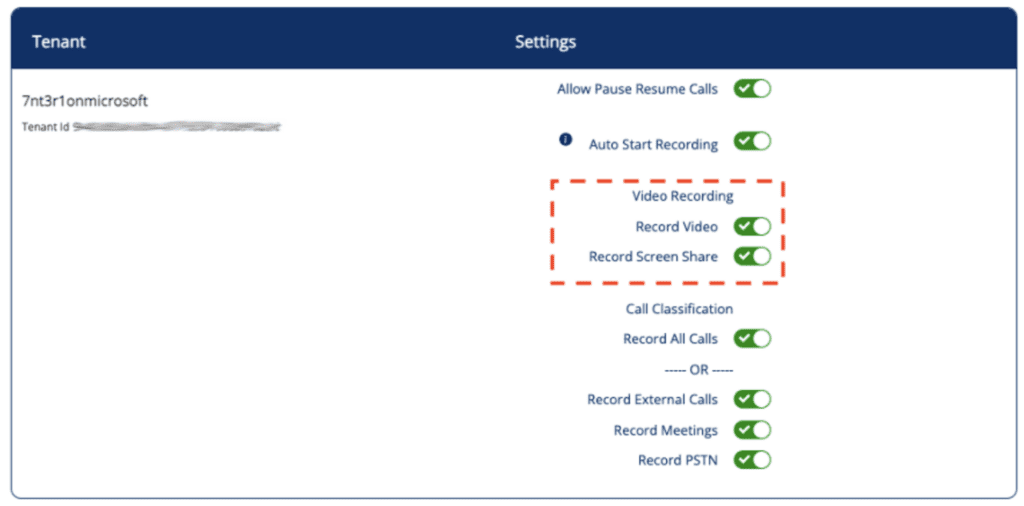
Unlock New Possibilities with Dubber
Discover how Dubber can revolutionise your Microsoft Teams experience. Contact our support team to learn more about how you can leverage Dubber’s advanced features to drive your business forward.
Embrace the future of communication with Dubber—where every conversation counts.
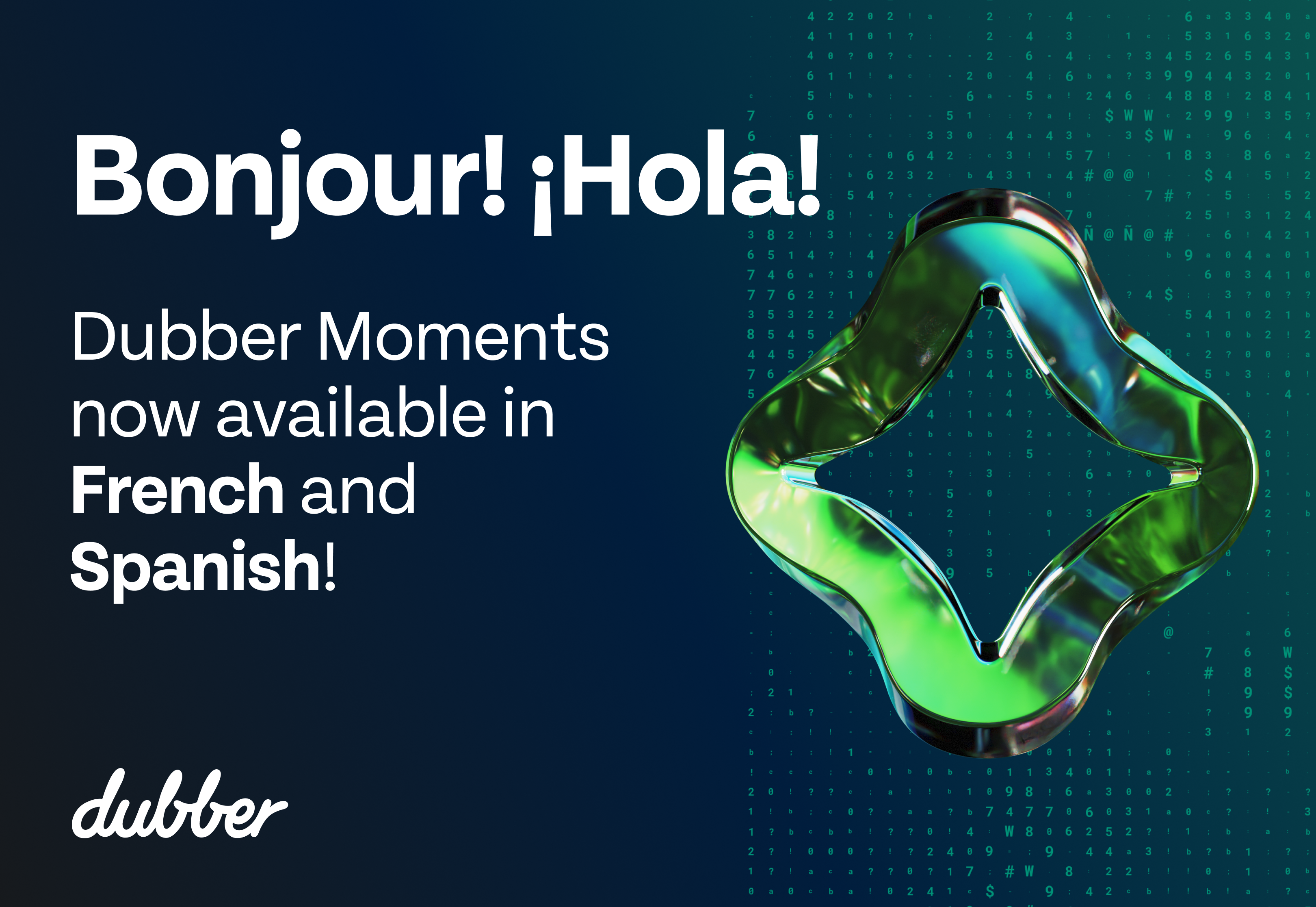
We are thrilled to announce that Dubber Moments, the ultimate solution for unlocking the true value of business conversations, is now available in French and Spanish! Say au revoir to language barriers and hola to revealing insights effortlessly!
Dubber Moments has already been making waves as an award-winning AI-powered conversation intelligence solution, excelling in transforming conversations into actionable business insights. Now, with Dubber Moments available in French and Spanish, we’re making it easier for even more businesses to leverage the power of conversation intelligence.
What sets Dubber Moments apart is its ability to analyse entire conversations, connecting and correlating key moments across interactions. It’s cloud-based, easy-to-use, and delivers unparalleled business intelligence instantly.
Don’t let your conversations go untapped! Reach out to Dubber today and see how you can elevate your business conversations to a whole new level.
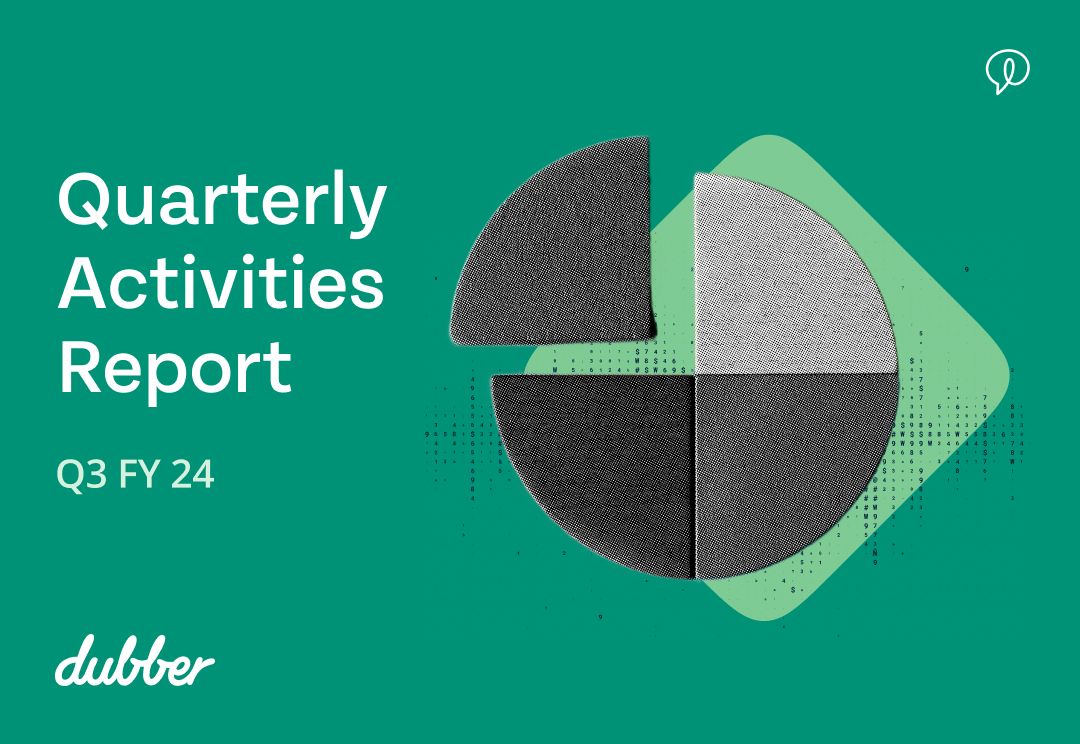
Melbourne, Australia: Dubber Corporation Limited (ASX:DUB) the leading conversation capture and intelligence platform for service providers and their customers globally, today released its Q3 FY24 quarterly report.
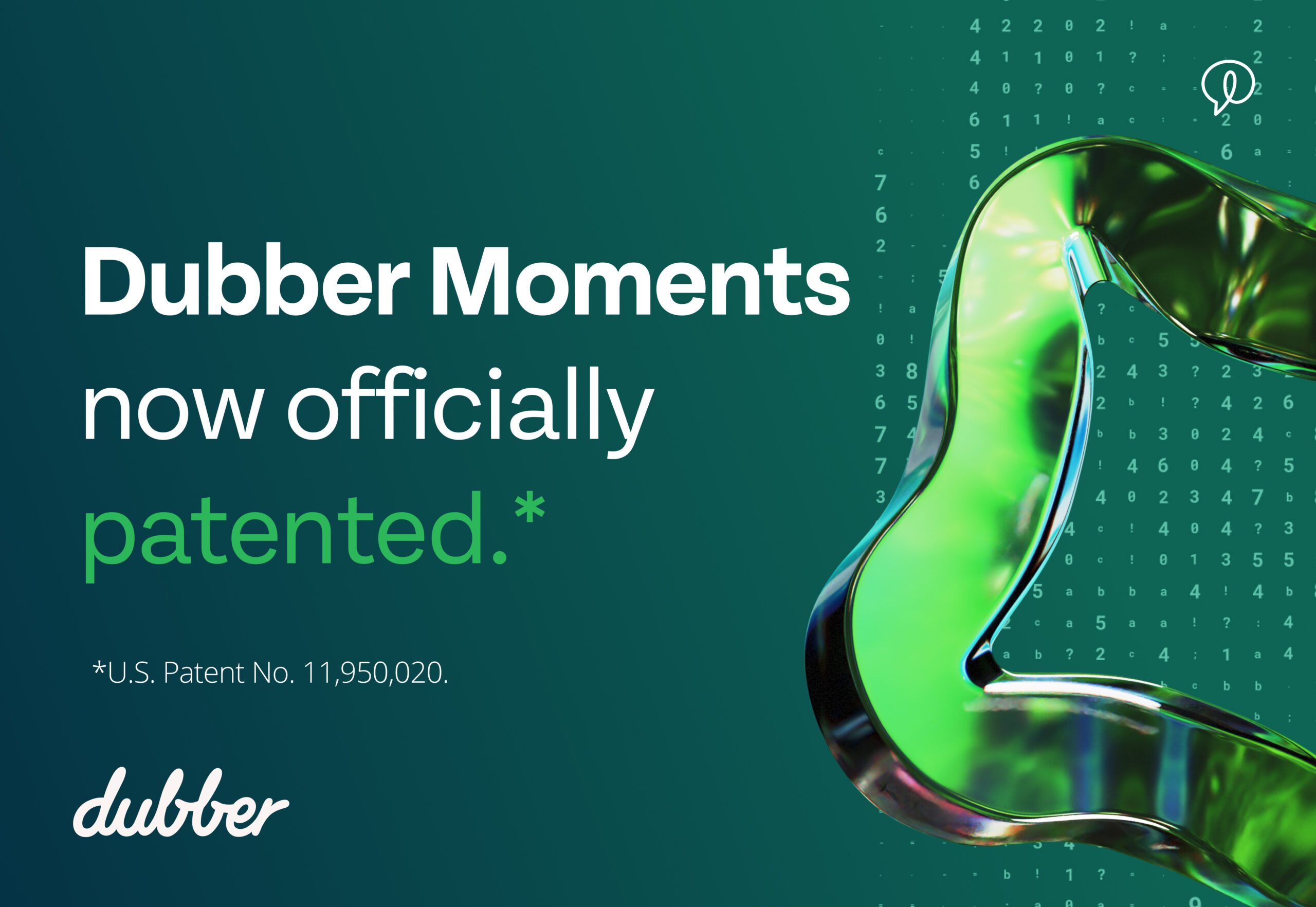
We’re very proud to announce that Dubber Moments, our cutting-edge AI-powered conversation intelligence solution, has officially received patent approval from the United States Patent and Trademark Office. This marks a significant milestone in our journey of innovation.
Dubber Moments is the ultimate solution for unlocking the true value of business conversations. With its unique ability to analyse the context of entire conversations and connect key moments across interactions, Dubber Moments delivers immediate business intelligence in ways never experienced before.
This patent approval further solidifies our position as leaders in the conversation intelligence space. We’re proud to lead the way and excited to continue delivering innovative solutions to our customers.
Stay tuned for more updates as we celebrate this achievement and explore new opportunities to leverage our patented technology for even greater impact.
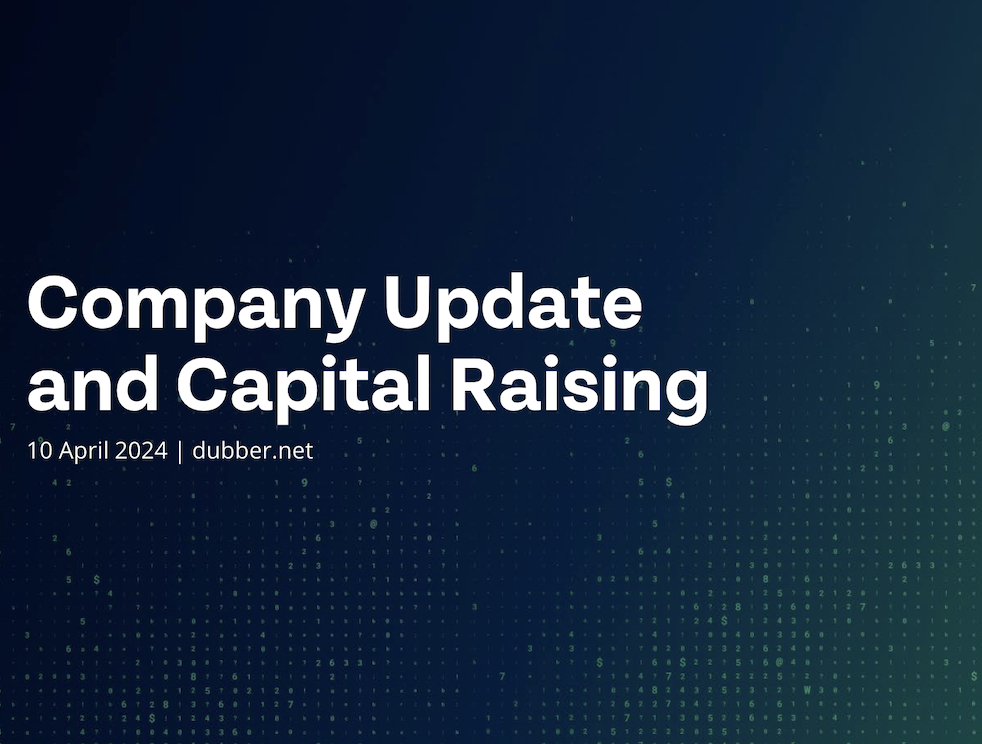
Melbourne, Australia: Dubber Corporation Limited (ASX:DUB), the leading conversation capture and intelligence platform for service providers and their customers globally, investor presentation to provide a company update and details on the capital raise.
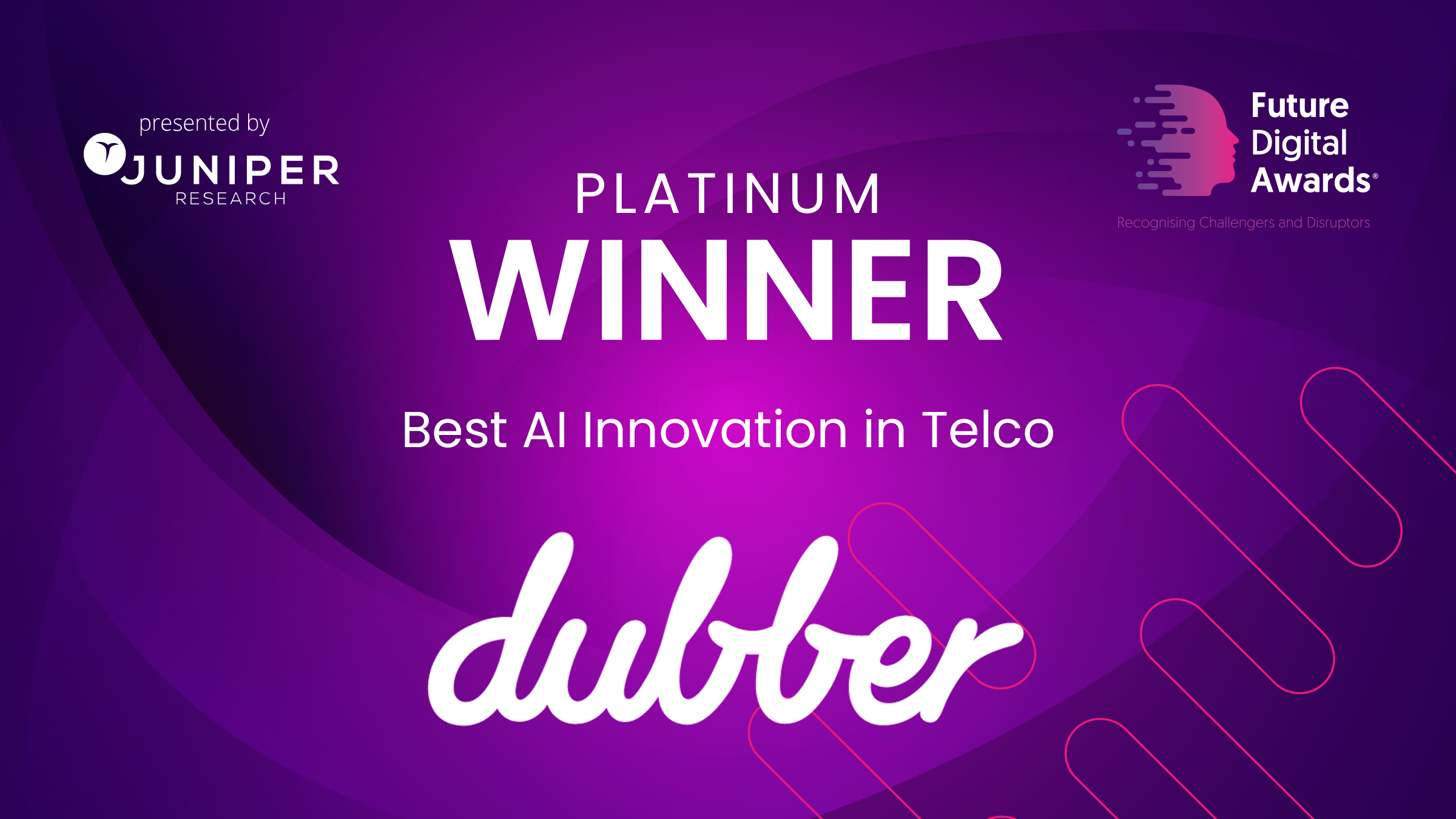
We’re thrilled to announce that Dubber Moments has been honoured as the Platinum Winner in the Best AI Innovation in Telco category at Future Digital Awards for Telco Innovation 2024. The awards mark our second major industry win since the release of Dubber Moments in June 2023. This accolade follows closely after our “Best AI Product in Telecom” award at the esteemed CogX Festival. We’re delighted to see the industry acknowledging the transformative power of Conversation Intelligence and the vital role of voice data in the future of telecom.
The Future Digital Awards, presented by Juniper Research, a leading analyst house specialising in fintech, telecommunications, and IoT, represents the best in technology innovation. Winning the Best AI Innovation in Telco category against a host of innovative competitors is a fantastic milestone for us. This award signifies the industry’s recognition of our commitment to pioneering AI solutions for providers and reshaping the future of telecom with Conversation Intelligence.
Cutting Edge AI for Providers & Users
Dubber Moments revolutionises the offerings of providers, enabling them to supply immediate, out-of-the-box AI insights for customers. Its sophisticated AI and natural language processing capabilities allow for an in-depth analysis of conversations, identifying key moments based on context, not transcripts. From detecting actions and complaints to uncovering various conversational nuances, Dubber Moments offers actionable intelligence from each conversation. This is pivotal for service providers and businesses looking to gain insights from their conversations without extensive in-house AI resources.
Dubber Moments is a revolutionary opportunity for providers to deliver AI functionality to organisations of any size, or embedded in their own network to enhance the communications experience for any user on their network.
“Dubber Moments enables simple understanding of areas which fundamentally affect a business such as voice of the customer, employee safety and wellbeing, and sales performance” said James Slaney, COO of Dubber.
“We are continuously expanding the capabilities of Dubber Moments, releasing new Moments like ‘Abuse’ to recognise harassment and enhance staff wellbeing and ‘Sales Close’, which allows sales leaders to proactively analyse and provide meaningful feedback to ensure their teams’ optimal performance.”
“We’re so proud of the immediate impact that Dubber Moments has for customers of all sizes and are pleased to receive this recognition at the Future Digital Awards. It is a testament to our team’s vision for transforming communications across Service Provider networks into valuable, insightful data. This award not only highlights our innovation but also signals the significant impact our technology is poised to have across the communications sector.”
A Bright Future
Securing the top spot at the Future Digital Awards is not just an occasion for celebration at Dubber; it’s a powerful validation of the continuous hard work and innovation demonstrated by our team. These awards are more than just accolades, they are a testament to our commitment to leading innovation in the telecom industry through AI.
To see an example of Dubber Moments in action, click here to learn more about how Devonport and Dubber used AI-powered Moments to change the way their call centre interacted with residents and provided valuable insights for the Council to make data-based decisions.
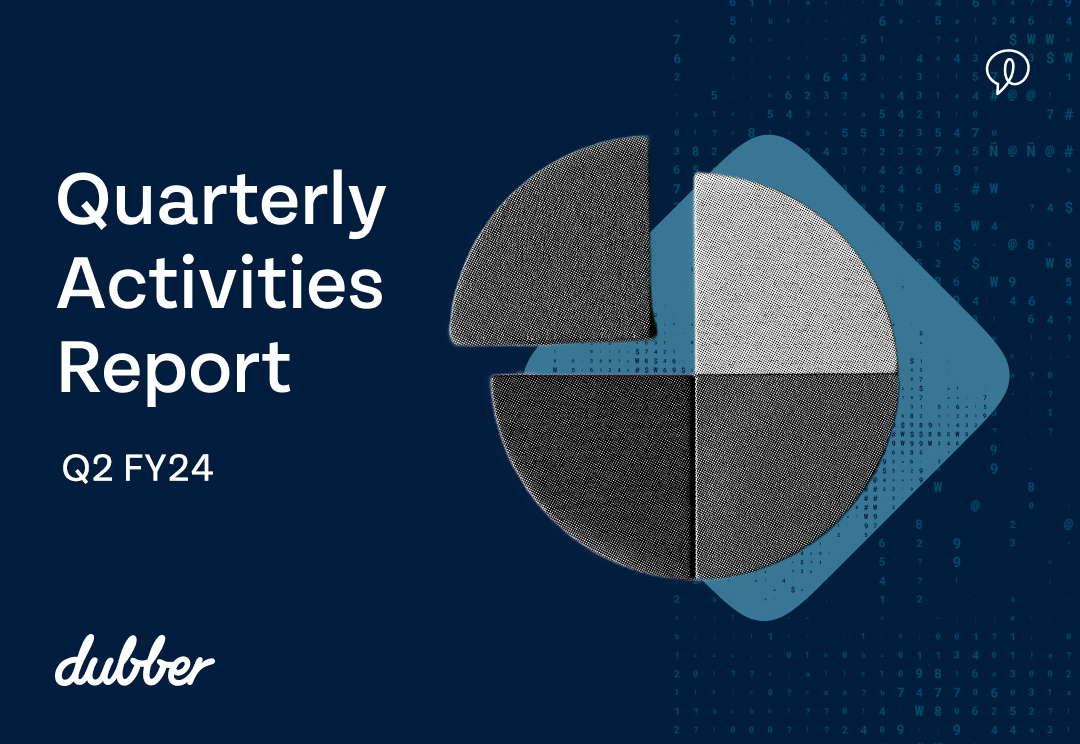
Melbourne, Australia: Dubber Corporation Limited (ASX:DUB) the leading conversation capture and intelligence platform for service providers and their customers globally, today released its Q2 FY24 quarterly report.
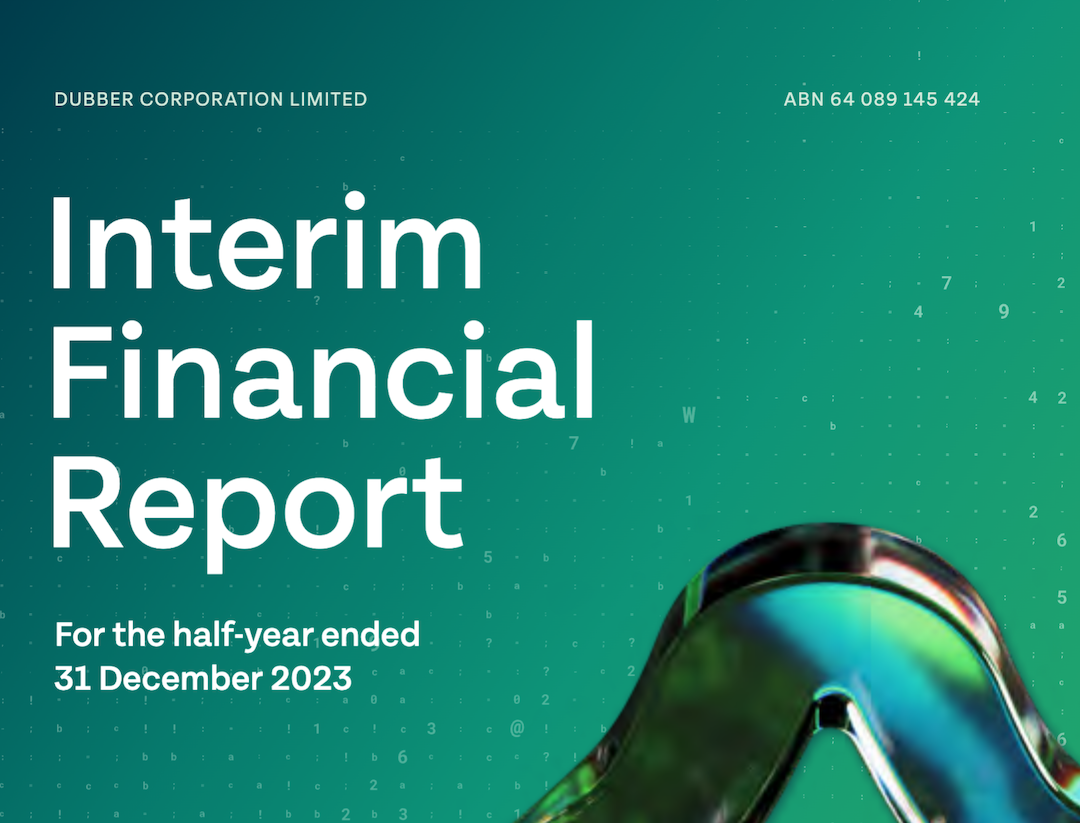
Melbourne, Australia: Dubber Corporation Limited (ASX:DUB) the leading conversation capture and intelligence platform for service providers and their customers globally, released its Interim Financial Report for the half-year ended 31 December 2023.
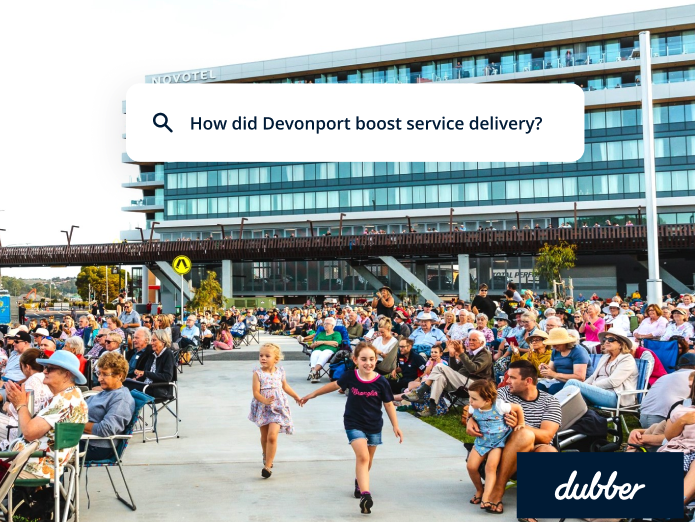
“We were enthusiastic about collaborating closely with Dubber on their Dubber Moments initiative to leverage additional artificial intelligence capabilities within the solution. Each of our voice calls captures a wealth of valuable content, and utilising Al to pinpoint moments of complaint within these calls, where service issues within the community may be identified, holds significant value.”
Devonport City Council (DCC) is a local government body situated in the Northwestern region of Tasmania, serving a population exceeding 26,000 residents. DCC operates a call centre dedicated to facilitating support services offered by the council to its community. The council, characterized by its modern and forward-thinking approach, has effectively harnessed the advantages of digital transformation throughout all its operational facets, including the call centre. This strategic initiative has yielded enhanced operational efficiency for council staff and an improved level of service delivery to the community.
In 2021, Devonport recognised the importance of gauging customer sentiment concerning their service delivery. Acknowledging the axiom that one cannot effectively manage and enhance what is not quantified, they proactively engaged their telecommunications partner, Telstra, in pursuit of viable solutions. The outcome of this collaborative effort was the adoption of Dubber.
As a Telstra TIPT (Telstra Internet Protocol Telephony) customer who had already migrated their telephony services to the cloud, integrating Dubber into their operations was a seamless process, requiring only a day for activation. Consequently, calls were promptly recorded, and customer sentiment was systematically captured. Following a successful three-month trial period, Devonport swiftly grasped the inherent value of Dubber’s capabilities.
Fast forward two years, and Devonport had reached a point where they were poised to progress to the next phase: harnessing the power of artificial intelligence (AI) to further enhance their customer service initiatives.
Learn more about how Devonport and Dubber used AI-powered Moments to change the way their call centre interacted with residents– and provided valuable insights for the Council to make data-based decisions.
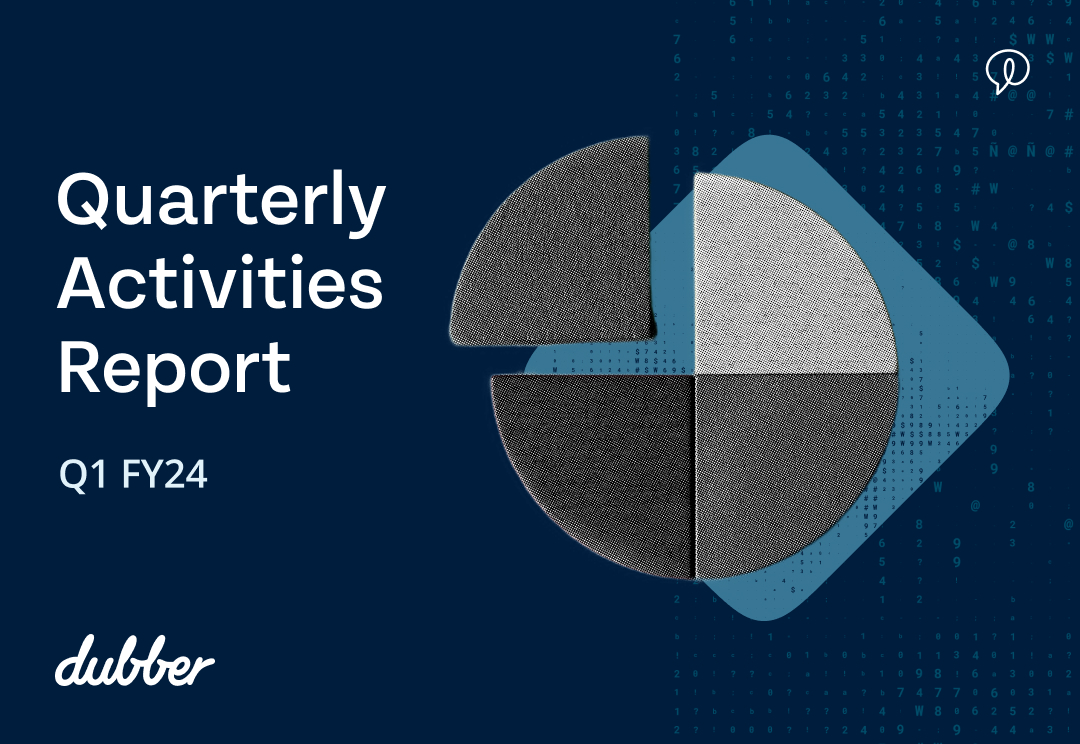
Melbourne, Australia: 26 October 2023 – Dubber Corporation Limited (ASX:DUB) (‘Dubber’
or ‘the Company’), the unified call recording and conversation intelligence platform designed
for global Communication Service and Solution Providers, today released its Q1 FY24
Appendix 4C and is pleased to provide this Quarterly Activities Report.
Q1 FY24 Highlights
● Revenue of $9.8m in Q1 FY24 up 10% on Q4 FY23 and 46% on Q1 FY23.
● Run-rate of $5m quarterly cash savings from FY23 restructuring programme
achieved in the quarter with operating cash costs including finance lease
repayments1 of $17.2m in the quarter, down 8% from $18.6m in Q4 FY23.
● Net operating cash outflows including finance lease repayments1 of $8.2m in Q1
FY24, down 3% from Q4 FY23 and down 20% on pcp.
● Operating cash receipts for the quarter were $9.0m, down 12% on Q4 FY23, and
down 5% on pcp reflecting expected seasonality.
● Capital raise undertaken raised $9.1m (net of issue costs) in the quarter.
● Cash on hand at 30 September 2023 was $33.7m.
● Deployment of Dubber Moments (Artificial Intelligence) solutions to customers
underway in the quarter.
● Dubber Moments recognised as ‘Best AI Product in Telecom’ at prestigious CogX
awards.
● Cisco Foundation programme moves to advanced revenue tier due to increased
uptake.
● Continued market penetration with new network agreements signed across the
Americas, Europe and APAC in the quarter, with 210+ Communication Service
Providers agreements in place at 30 September 2023.
● The Company reiterates its previously advised expectations for FY24 of revenue of
$45m and costs of $65m (excluding share based payments, goodwill impairment and
FX gains/losses).
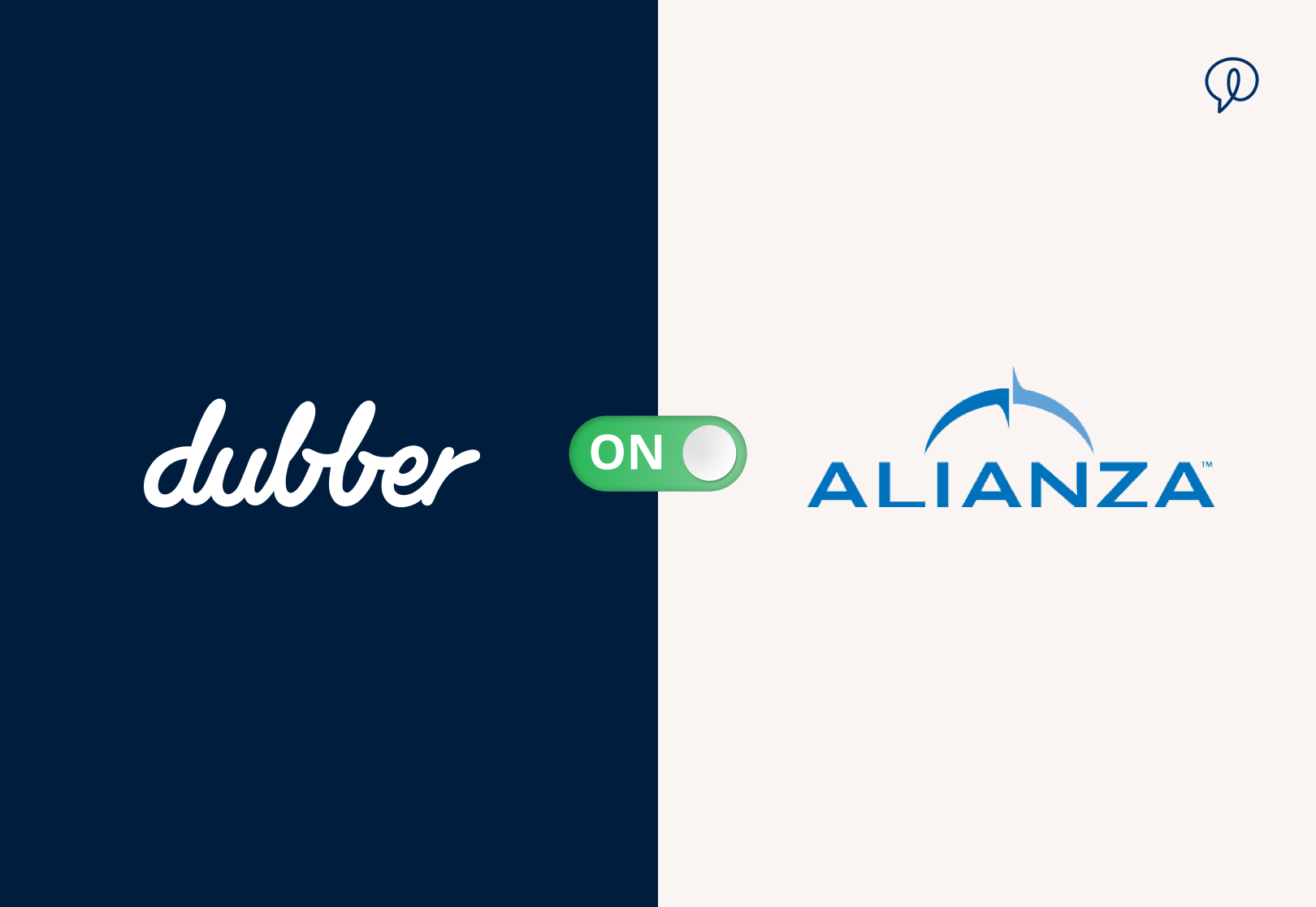
Dubber & Alianza Collaborate to Elevate Cloud Communications for CSPs Worldwide
Cloud communications provider makes cutting-edge conversational intelligence available to a network of over 200 communication service providers
DALLAS and MELBOURNE – October 10, 2023 – Dubber Corporation Limited (ASX: DUB), the global leader in conversational intelligence and capture, today announced a new strategic alliance with Alianza, the communications cloud for service providers, in which Dubber will be providing state-of-the-art conversational intelligence solutions into the Alianza platform. This new offering will assist in extending the benefits of AI-driven insights to a platform of more than 200 communication service providers (CSPs).
Redefining Communication with AI
As a leading cloud communications company with a diverse range of CSP customers, from emerging to established Tier 1 providers, Alianza is dedicated to driving innovation for its service providers.
With the integration of Dubber’s suite of capture tools and AI-driven insights, Alianza will equip CSPs with cutting-edge capabilities to put them at the forefront of the global shift towards conversational intelligence. This includes unified recording, in-depth analytics, and voice AI, enabling service providers to extract maximum value from communication data and provide end users with services that are uniquely differentiated.
“Dubber provides innovative, value-added services to our service providers as an integrated part of Alianza’s robust cloud communications product suite,” said Dag Peak, Chief Product Officer, Alianza. “Dubber’s market-leading ability to provide unified call recording and advanced analytics at scale complements our cloud-native solution perfectly.”
Leveling the Playing Field
In an era where artificial intelligence is allowing smaller players in the market to leverage the capabilities of industry giants, Alianza’s decision to make advanced conversational intelligence available to its CSPs is both strategic and timely. This new partnership allows Dubber to extend its leading conversational intelligence solutions to Alianza’s extensive CSP customer base, furthering the company’s mission to ensure businesses extract valuable insights from their communications.
Dubber’s approach goes beyond transcription by using AI to capture content and transform pivotal points in conversations into actionable insights. This helps service providers differentiate their business, innovate, and monetize their networks.
“Alianza is well known in our industry for their relentless focus on delivering an exceptional customer experience. They have invested significant resources in building their own truly cloud-native, carrier-grade communications platform built for service providers and their customers,” said Steve McGovern, CEO, Dubber. “Like Dubber, Alianza recognizes the value of delivering a cloud platform to service providers and our companies share a common vision of where our industry is headed. As voice data capture becomes increasingly critical for service providers and end-users alike, we look forward to working closely with their team to provide Dubber’s platform-as-a-feature and call recording capabilities as an integral part of their Business Cloud Communications solution.”
About Dubber:
Dubber, the global leader in network based conversation intelligence, offers cutting-edge solutions designed to enhance communications for end users and benefit our Communication Service Provider (CSP) partners. Listed on the ASX, the company’s innovative cloud platform connects to over 205 CSPs, capturing crucial information from voice, video, chat, and SMS data, also known as ‘Moments.’ By harnessing advanced capture and AI technologies, Dubber transforms these moments into valuable business insights, enabling CSPs to differentiate, innovate, and monetize their networks.
About Alianza:
Alianza is the communications cloud for service providers. We help our customers supercharge growth, reduce costs, and transform into modern techcos. With Alianza, service providers can navigate the end of the softswitch era and upgrade to a cloud-native solution to power both legacy voice and next-gen cloud communications services — including cloud meetings, collaboration, and text messaging. Our team of experts are passionate about simplifying service delivery and ensuring first-rate customer experiences for more than 200 service providers. Learn more about our solutions at www.alianza.com and follow us on LinkedIn and Twitter.
For more information, contact:
Dubber Investors and APAC Media
Terry Alberstein terry@navigatecommunication.com.au
+61 (0) 458 484 921
Dubber Americas and EMEA Media
Jake Galland – Account Manager, TFD, jake@wearetfd.com
+44 7780 866874
Alianza, Inc. Media
Justin Cooper
Executive Vice President, Marketing
pr@alianza.com

October 4 | Dubber HQ, 2 Russell St Melbourne
Dubber was pleased to host its’ first investor day, held at Dubber’s Melbourne HQ. Investors had the opportunity to get a deeper and broader understanding of the business by hearing from and engaging with key management and executives.
In case you missed it, you can watch the replay here.
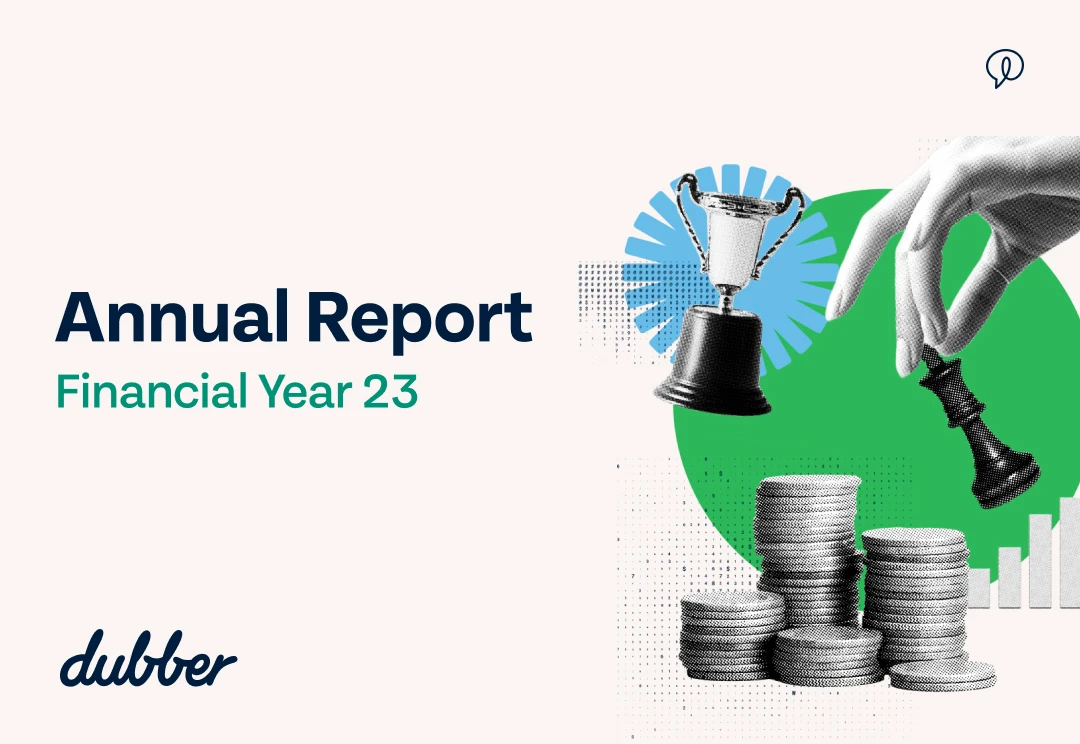
Dubber Corporation Limited (ASX:DUB) the leading conversation capture and intelligence platform for service providers and their customers globally, today released its Annual Report to Shareholders for the year ending 30 June 2023.

Dubber Corporation Limited (ASX: DUB), the global leader in conversation intelligence, has been awarded “Best AI Product in Telecom” for Dubber Moments, its revolutionary voice AI solution, at the prestigious CogX Awards in London.
The CogX Festival is the world’s largest gathering of CEOs, entrepreneurs, academics, artists, activists and policy makers working together to address the biggest questions, achievements and challenges of the influential technologies shaping our future. The awards ‘celebrate change makers and innovators impacting our world in the last 12 months, those innovators, visionaries, and change makers who are helping us get the next ten years right,’ and are voted on by independent global industry leaders.
Dubber Moments Takes The Prize for “Best AI Product in Telecom”
The recognition of Dubber Moments as a best-in-class AI product is testament to its potential to reshape communication experiences. As a trained AI service, Dubber Moments offers a revolution for communication service providers by unlocking the vast amounts of voice data traversing their networks and providing out-of-the-box insights for their customers.
Powered by advanced artificial intelligence and natural language processing capabilities, Dubber Moments analyses conversations to pinpoint pivotal moments based on contextual understanding. Actions, complaints, and a variety of additional conversational points can be automatically detected and flagged for action. By identifying these critical segments, Dubber Moments generates immediately relevant insights from voice data.
Rather than simple transcripts, end users and businesses can now enjoy actionable intelligence from every conversation. This has implications for any service provider or business seeking to unlock added insight from their conversations, without the need for large in-house AI budgets and teams. Dubber Moments is connected to the largest service provider networks across the world and empowers them to deliver innovation and differentiation within their offerings.
“We are thrilled to be honoured by CogX for our advancements in delivering AI innovation that has the ability to have significant impact for the telecommunications sector,” said Steve McGovern, CEO of Dubber. “Dubber Moments highlights our vision of turning the communications across Service Provider networks into usable data which can then be elevated into Conversation Intelligence products providing game changing value for Service Providers and their customers. ”
Revolutionising Comms
Dubber’s Platform is uniquely designed to capture communications data, at scale, across Service Provider networks and Dubber Moments has the potential to revolutionise the communications industry by creating and delivering content directly from that data with endless user applications.
Dubber Moments can be packaged either as a network feature, embedded and standardised within a telecommunications offering, or as specific insights across an entire business. In either case, Dubber Moments delivers value previously unattainable directly from the network.
The company invested heavily in advanced AI engineering to develop the Dubber platform and the growing Dubber Moments product suite. “We believe that individuals and businesses will have enhanced expectation levels regarding their communications experiences and, for a Service Provider, AI is no longer a nice-to-have – it’s a competitive necessity,” said McGovern. “We are committed to pushing the boundaries of conversation intelligence, empowering individuals and organisations with insights that enable smarter and elevated decisions.”
Looking ahead, as part of the continuing evolution of Dubber Moments, near term future product releases will help organisations improve customer experiences, boost team performance, address employee wellbeing and enhance employee engagement.
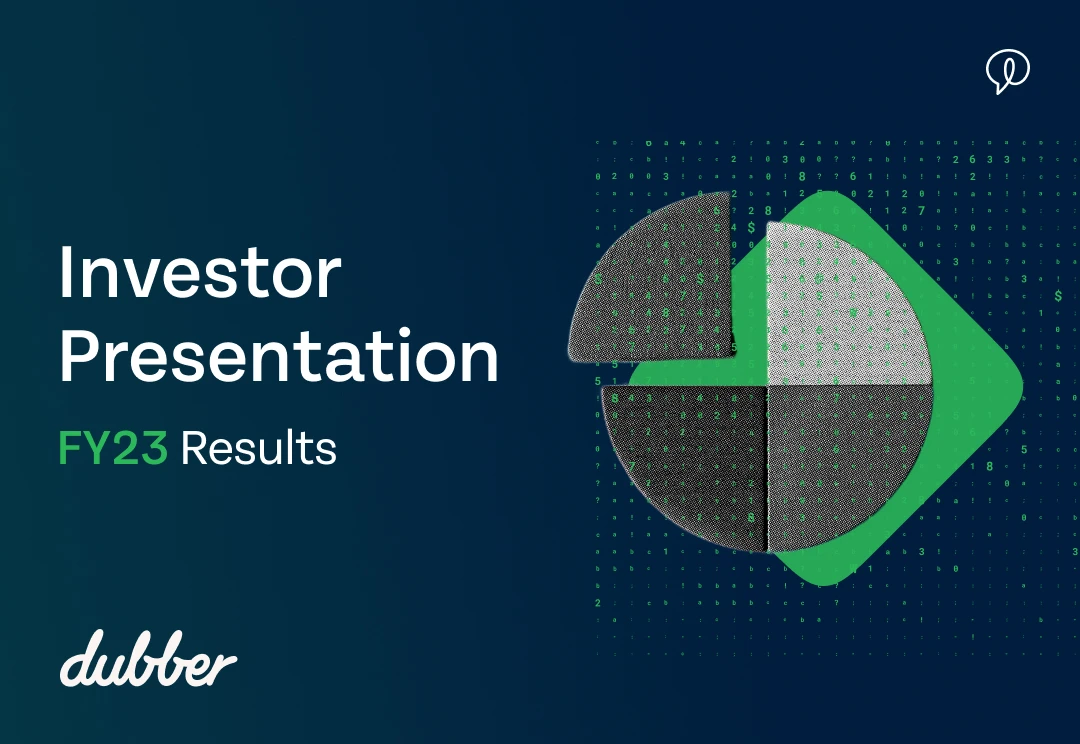
We had the opportunity to take Shareholders through Dubber’s investor presentation providing an overview of FY23 performance and FY24 outlook.
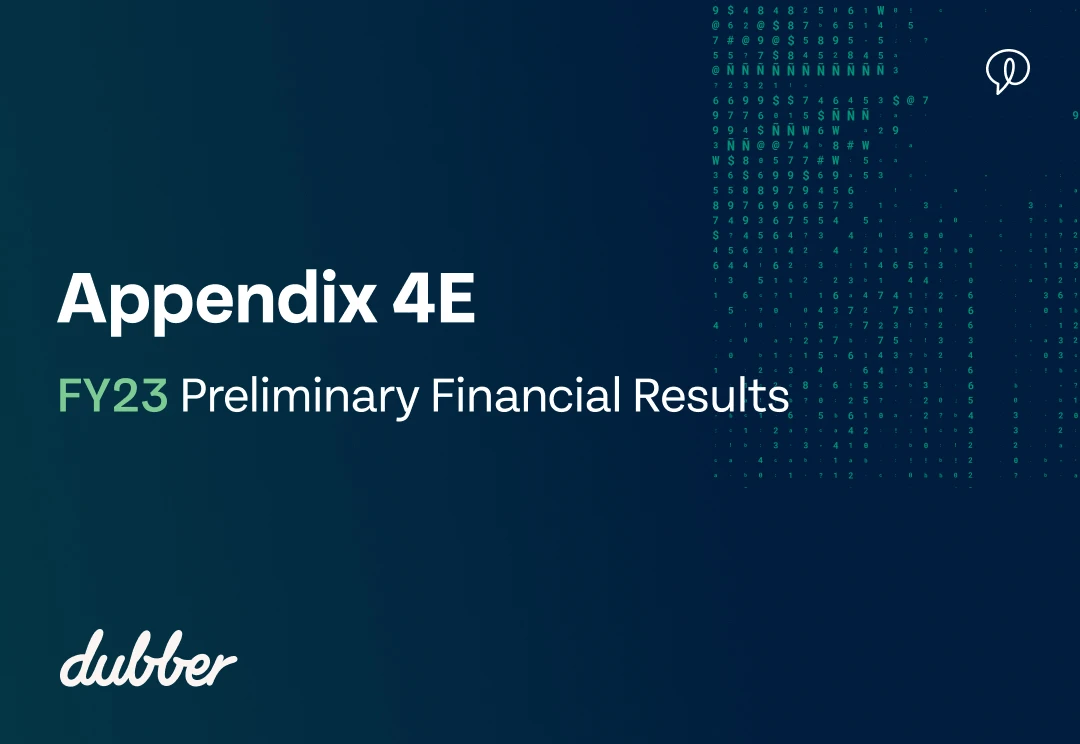
The Appendix 4E Preliminary Final Report prepared in accordance with ASX Listing Rule 4.3A.
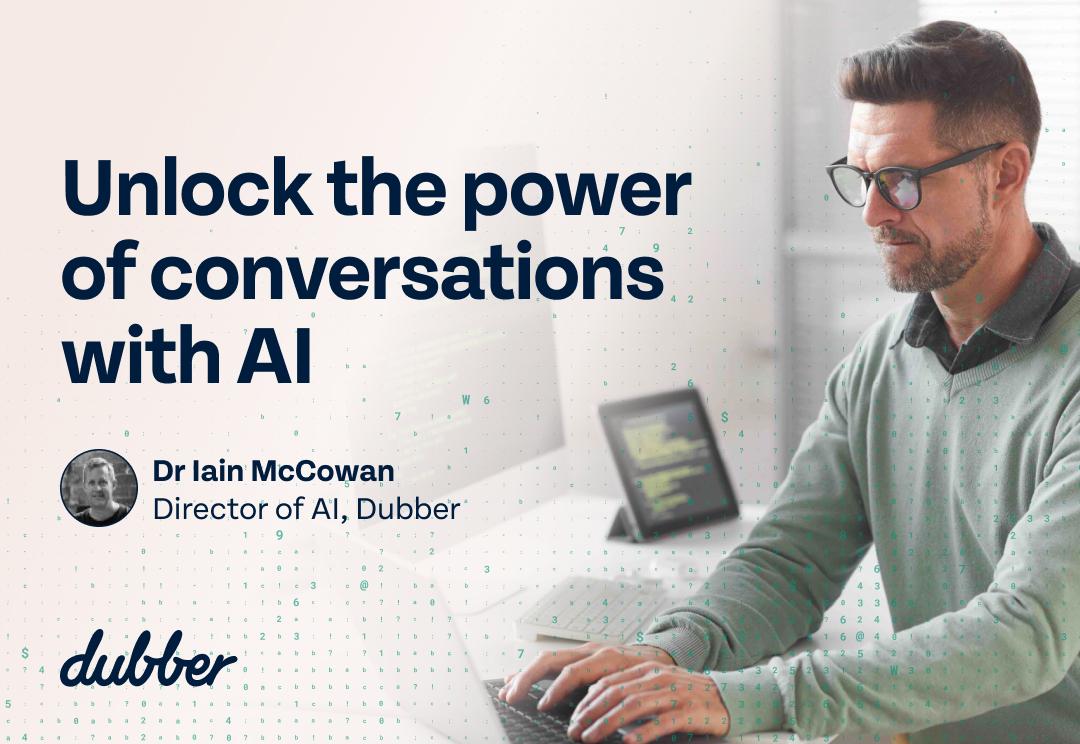
As someone working in the domain of conversational speech and language AI for over 25 years, from researching speech recognition in smart meeting rooms through to developing commercial products and services, it’s been an incredible journey seeing the technology evolve.
Along the way, I’ve learned that while we often focus on new technological capabilities, real value is only unlocked when we deliver that within a user experience that helps people achieve the actual job that they need to do, or the problem that a business needs to solve.
Another key learning has been that, while technology changes at a rapid pace, the millions of meetings and business calls taking place around the world each day are just conversations between people, and the fundamental nature of conversations never changes.
Conversations are dynamic interactions that unfold naturally, and so at first glance transcripts lack the readability and structure of authored text documents. There is, however, an organic structure to all conversations. They are set within a context, involving people with roles interacting in speaking turns similar to paragraphs in a document. Like chapters in a book, conversations progress through high-level discussion threads or topics, whether imposed by an agenda, or emerging naturally.
Ultimately, meaningful conversations include key passages worth highlighting – Moments of significance. Which specific Moments are significant depends on the context of the conversation. It could be someone saying they will follow up on an item tomorrow, or raising dissatisfaction with a product.
This perspective led us to develop Moments as a powerful way to deliver practical insights from business conversations. As our first Moment, we found Complaints have significance to a range of organisations seeking to improve how they serve their customers. Other Moments are in the pipeline – such as one that detects when staff suffer verbal abuse on a call, helping businesses provide a safer working environment.
The public awareness of AI skyrocketed with the launch of Chat GPT and now AI is everywhere. These technologies have, however, been steadily evolving over a long period of time. The Transformer neural network architecture underlying current language models was proposed back in 2017, and models have been steadily growing in capacity since then. Another big step forward in this field was around 2018 when automatic speech-to-text reached human-level accuracy at transcribing conversations.
While these things have been brewing for many years, there is no question that in recent months we have witnessed an enormous step forward in the capabilities of Large Language Models. For me, the biggest change has been the naturalness of the responses these models generate to a broad array of questions or prompts, across industries and languages. From our perspective, what this means is that we can now distil long call transcripts into readable summaries and key points just like notes a person might have taken. For an end user this is a game changer – let’s face it, someone rarely has time to read a full transcript, they are mostly interested in just a few key moments.
In my role it’s important to stay at the forefront of this ever-evolving landscape. One way we do this is by fostering strong relationships with key technology partners and university research groups. This helps us see ahead to what is coming in the near-term as well as over the horizon. This highlights one of the benefits that customers gain from our cloud-based product – we seamlessly deliver the most up to date in AI technology for them to tap into. For them, it’s out of the box and scalable, without requiring them to invest in people, development or budget to implement, maintain or upgrade.
So while much of the world woke up to AI when Chat GPT was released, our conversation intelligence platform has been in development at Dubber for some time – particularly over the two years since acquiring Notiv. This platform allows us to deliver cloud-based AI-powered product experiences in a flexible, responsible way. This has positioned us to quickly launch the Moments product on a global scale through Service Providers.
Having done the heavy lifting, we’re now in the process of developing and rolling out a range of new Moments. How do we do this? We start with market research to define a Moment with value across a broad set of companies. We then collaborate closely with early adopter customers to evaluate and refine the Moment on their calls, validating the benefit to their business. An initial customer took 40,000 of their calls through this process, and for the first time they could see what people were complaining about, both at a macro level as well as being able to drill down into a specific conversation, helping them improve their customer experience and business performance.
Who do these use cases apply to? I honestly think the answer is ‘every business’. From a small business, to mid-size, up to enterprise, every company wants to hear directly from their customers to improve their business.
Technology evolves, but humans will always communicate through natural language. With Dubber in the network we can help service providers and their customers unlock the full value of their conversations. The use cases for ‘Moments’ are seemingly endless. Personally, my favourite moment is seeing one of our customers gain a new insight into their business and then realise that it was hiding in their call data all this time, just waiting to be uncovered!
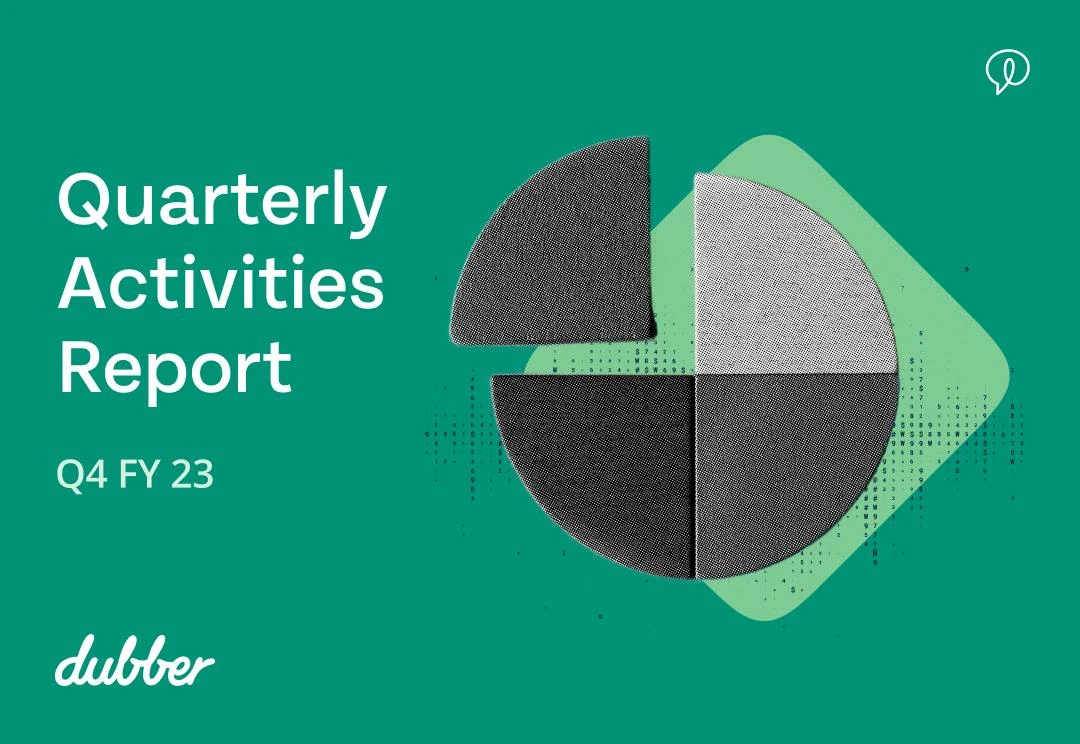
Dubber Corporation Limited (ASX:DUB) the leading conversational intelligence and unified recording platform for service providers and their customers globally, today released our Q4 FY23 quarterly report.
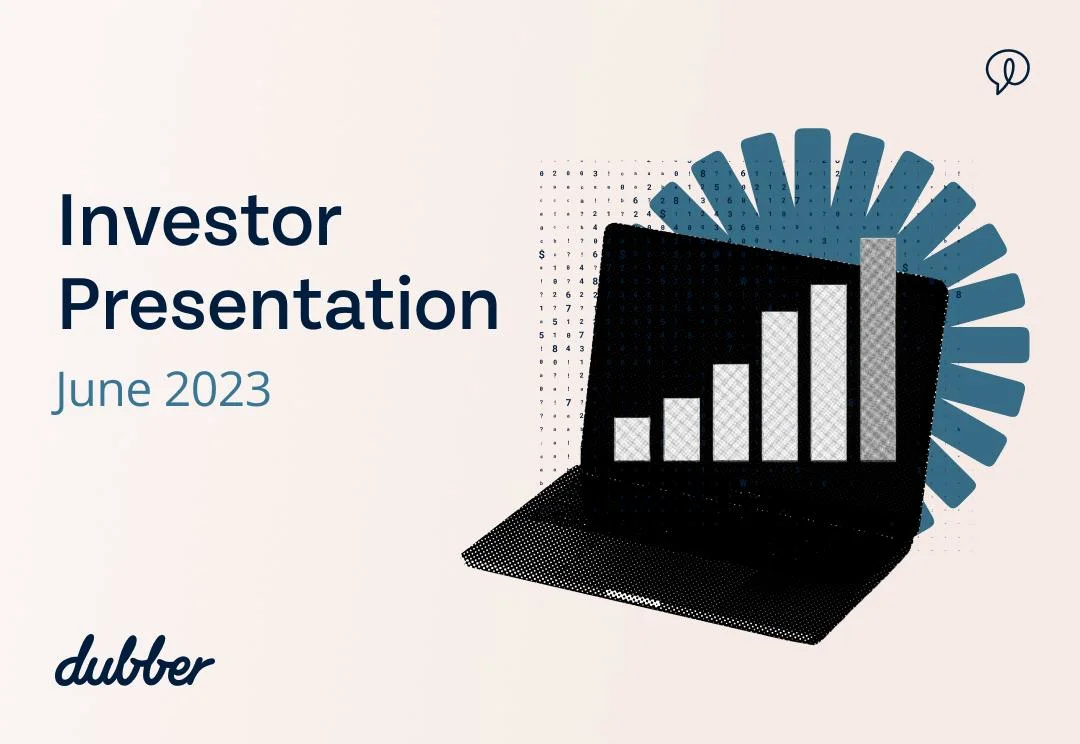
We had the opportunity to take Shareholders through Dubber’s investor presentation and why we are so excited about the opportunity ahead of us.
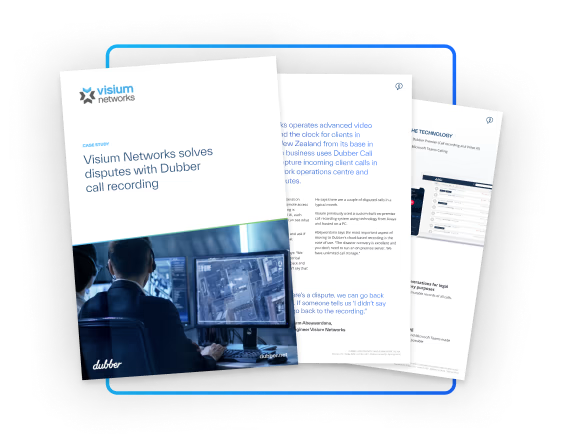
“With Dubber, if there’s a dispute, we can go back and review the calls. If someone tells us ‘I didn’t say that’ we can go back to the recording.” Charm Abeywardana, Lead IT Engineer, Visium Networks
Learn how Visium Networks improved dispute resolution by quickly searching, retrieving and replaying disputed calls
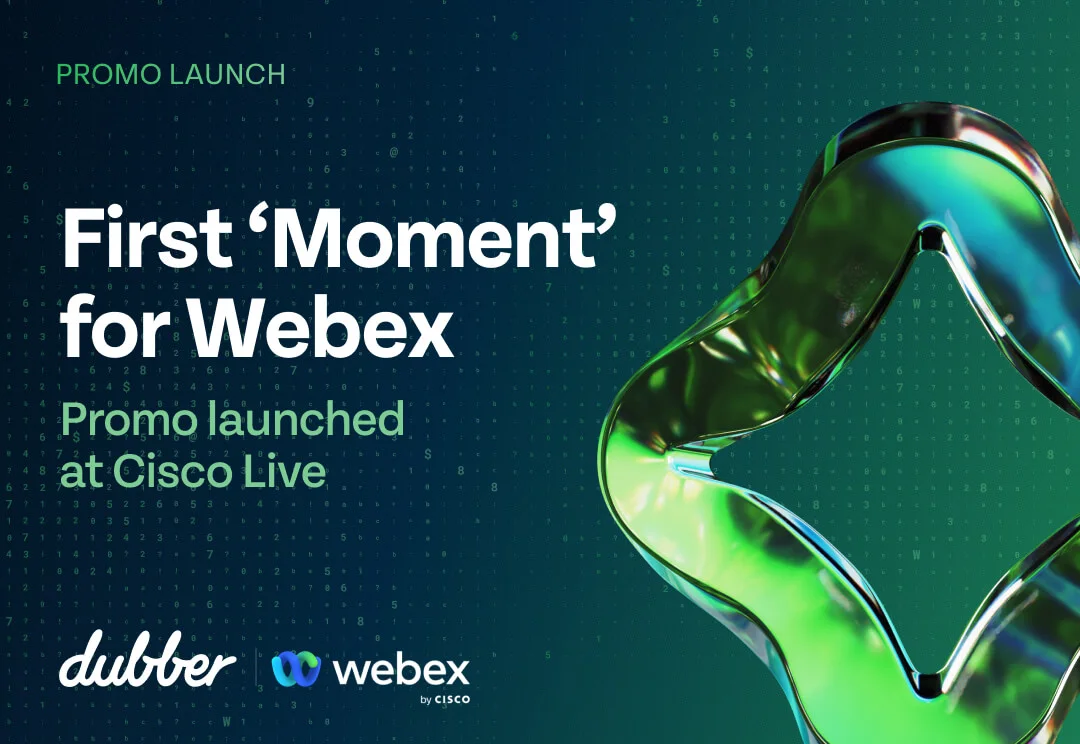
Dubber, the global leader in network based conversation intelligence and capture, launched last week Dubber “Moments”, a revolutionary AI product designed to redefine what individuals and organisations expect from their communications.
Dubber is the capture capability provided as a standard feature in Cisco Webex Calling and UCMC via the ‘Dubber Go’ feature and the company sees Cisco Live in Las Vegas, as the perfect opportunity to announce the release of the first Dubber Moment – Complaints, supporting Webex and the Cisco collaboration product suite. ‘Moments’ has the potential to revolutionise the user experience and drive tangible accretive benefits for customers and the Cisco sales channel.
Leap forward in AI
Going beyond the words and identifying the context within the conversation, Dubber has advanced AI to deliver actionable insights immediately when activated.
Dubber Moments is a growing family of out of the box capabilities, with the first being the ‘Complaints Moment’, which focuses on improving interactions between a business and its customers. This moment automatically detects a complaint and other relevant intelligence with the call or video so that a user can understand a single complaint, but also correlate across an entire organisation for a much deeper business insight.
With the use case being applicable for all businesses, Dubber has built the functionality to accommodate a light user or somebody looking to drill deeper into the data. As the insights are delivered out of the box, none or minimal training is required to understand the results.
Furthermore, various enhancements have been made to the Dubber AI functionality. Users are no longer required to manually scroll through transcriptions to comprehend the context of a conversation. Instead, we now offer a succinct summary for each conversation. Additionally, conversations are presented in the form of chapters, where the key topics discussed in each chapter are highlighted, enabling users to quickly locate the desired content. Moreover, the sentiment analysis has been improved, facilitating a better understanding of the changes in sentiment throughout the entire conversation.
Available via CCW
This is a first release of its kind that can provide immediate access to insights from the moment it is switched on for any Webex or Cisco collaboration suite solution.
Sellers of these services within the Cisco community can now include a value added solution without adding any deal complexity or risk, with a clear customer benefit that can only help expand an addressable market, drive new deals and expand their value.
Adding Dubber Moments is a seamless and easy upgrade from Dubber Go recording which is embedded in every Webex Calling and UCMC subscription.
The new feature will be available via CCW within the ‘Dubber Premier’ package from today and the soon to be released ‘Dubber Insights’.
Promotion
Dubber believes that this new functionality can benefit any business. To increase adoption, a range of promotional campaigns are launching today for 3 months to Cisco sellers and partners to help drive uptake and adoption.
If you’re attending Cisco Live, we recommend that you visit the Dubber team to understand how you can provide this new functionality to your customers. Also, please email us at getmoments@dubber.net if required.
About Dubber:
Dubber, the global leader in network based conversation intelligence, offers cutting-edge solutions designed to enhance communications for end users and benefit our Communication Service Provider (CSP) partners. Listed on the ASX, the company’s innovative cloud platform connects to over 170+ CSPs, capturing crucial information from voice, video, chat, and SMS data, also known as “Moments.” By harnessing advanced capture and AI technologies, Dubber transforms these moments into valuable business insights, enabling CSPs to differentiate, innovate, and monetise their networks.
For more information, contact:
Dubber Investors and APAC Media
Terry Alberstein terry@navigatecommunication.com.au
+61 (0) 458 484 921
Dubber Americas and EMEA Media
Jake Galland – Account Manager, TFD, jake@wearetfd.com
+447780866874
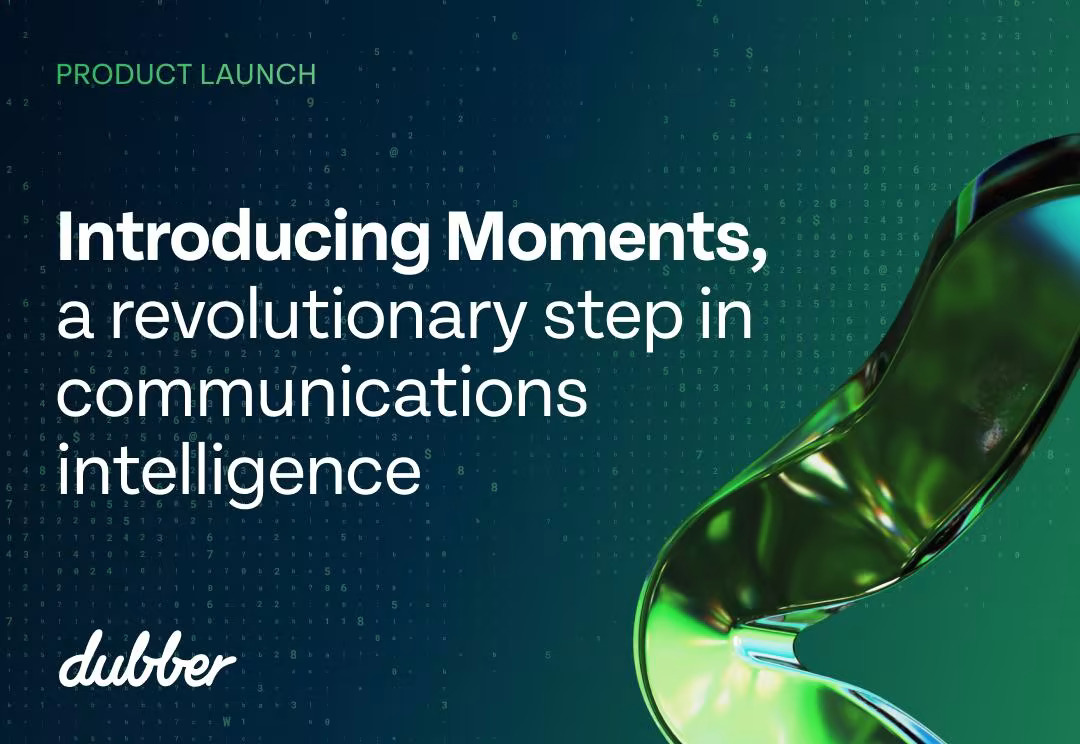
Dubber, the global leader in network based conversation intelligence and capture, has launched ‘Moments’, a revolutionary AI product designed to redefine what individuals and organisations expect from their communications and bring a new level of engagement between Dubbers 170+ global service provider Partners and their customers.
Changing Communications Forever
Since its founding in 2011, Dubber has consistently been at the forefront of pioneering solutions for Communication Service Providers and their customers. Today, it supports over 170 service providers and thousands of businesses across the globe by capturing and analysing conversations at volume across an entire network. The Dubber vision has been to move beyond traditional transcription alone towards addressing all modern business needs with the development of actionable, meaningful insights that can truly inform business strategies directly from the Service Provider network.
In response to these evolving demands, Dubber has released their out of the box solution family called ‘Moments’. This growing suite of features, powered by advanced AI and conversation intelligence, goes beyond the words and identifies the context within the voice conversation.
A single identified ‘Moment’ provides immediate benefit within a conversation, but when correlated across an entire organisation it creates amazing ‘Insights’. Employing data visualisation, Insights provides an intuitive snapshot of communication patterns and trends, transforming complex data into understandable intelligence for individuals and all sizes of business.
Future product roadmap releases will include a range of new ‘Moments’ that will help organisations to improve customer experience, enhance the performance of individuals, teams and improve employee engagement.
Decoding the Conversation
Following research into business-critical conversations, led by Dr. Iain McCowan, head of Dubbers AI Labs, the initial rollout will begin with the ‘Complaints Moment’, which pinpoints customer complaints and related topics within conversations. This ‘Moment’, part of the customer experience family of ‘Moments’, enables all organisations to promptly gain insights into customer grievances and handle them effectively.
Following this, ‘Actions Moment’ will be launched as a network feature, enhancing Dubber’s technology by detecting commitments made during conversations and converting them into tasks or reminders which has the ability to revolutionise the relationship with service providers and their customers.
The Revolution of Communications
With Communication Service Providers globally facing the challenges of commoditisation and ongoing cost pressures, it’s smart to consider new ways to leverage their networks, build new revenues and delight customers at the same time. Dubber enables service providers to consistently deliver innovation and value to their customers, helping them to understand and action intelligence based on outcomes produced through Dubber ‘Moments’ directly from their networks.
Steve McGovern, CEO of Dubber, stated, “We have been promoting a view for many years that AI will be a part of every telephony service and have built the Dubber platform to enable that eventuality. Dubber is designed specifically for Service Provider delivery as opposed to direct end user integration since we believe that the network is the source of any communication and the SP’s have the ability to provision, bill and support at scale.
To us, it just makes sense.
With the launch of ‘Moments’ we’re taking a significant step towards fulfilling that philosophy and fundamentally transforming communications. Despite the evolving ways in which we communicate, the core nature of conversations remains unchanged. There are always key moments within a conversation that yield new intelligence, inspire action, or deepen understanding. ‘Moments’ captures these pivotal points from any conversation on the network and transforms them into insights, delivering tangible business value and empowering service providers to redefine their offerings directly from their networks.”
Stuart Pritchard, Vice President, Optus Enterprise, speaking at the launch of ‘Moments’ said, “AI is becoming broadly part of our lives and customers are expecting to seek benefits from it. When AI can be used to directly solve business challenges, effectively out of the box, it simplifies the customer’s decision making and assists our sales teams. Currently, Dubber is assisting Optus in a special campaign that promotes the Dubber AI functionality around automatically detecting complaints for organisations and summarisation of calls for each user.”
McGovern added, “At Dubber, AI isn’t just a buzzword – it’s the key to unlocking the value of conversations happening across service provider networks. In effect, we are bringing the network to life enabling the content and packaging it into valuable outcomes which can be accessed via Dubber’s applications, via direct network based notifications or via API.
With the unprecedented volume of data available to train our Dubber AI engine, we’re turning every conversation into a chance to extract valuable moments that can enhance customer understanding, elevate employee experience, and identify product improvement opportunities.”
Find out more about ‘Moments’ here.
About Dubber:
Dubber, the global leader in conversational intelligence, offers cutting-edge solutions designed for CSPs to get the most out of their data. Listed on the ASX, the company’s innovative cloud platform connects to over 170+ service providers, capturing crucial information from voice, video, chat, and SMS data, also known as “moments.” By harnessing advanced capture and AI technologies, Dubber transforms these moments into valuable business insights, enabling CSPs to differentiate, innovate, and monetise their networks.
For more information, contact:
Dubber Investors and APAC Media
Terry Alberstein terry@navigatecommunication.com.au
+61 (0) 458 484 921
Dubber Americas and EMEA Media
Jake Galland – Account Manager, TFD, jake@wearetfd.com
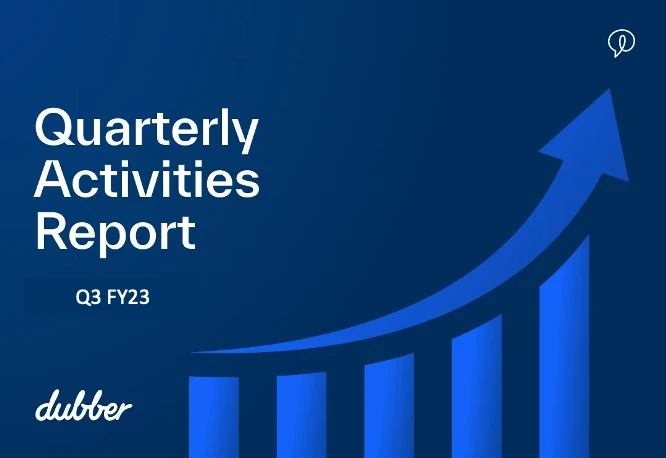
Melbourne, Australia: 30 April 2023 — Dubber Corporation Limited (ASX:DUB), the leading unified call recording and conversational intelligence platform to global telecommunication service and solution providers, today released its 3Q FY23 Appendix 4C and is pleased to provide this Quarterly Activities Report
3Q FY23 Snapshot
- Strategy alignment and restructuring programme largely completed and on track to deliver $5m+ of quarterly cost savings from FY24 financial year, with $1m already realised and $2m to be achieved in Q4 of FY23.
- Adjusted Recurring Revenue1 of $7.4m up 10% on Q2 FY23 and 17% on pcp.Operating cash receipts for the quarter were $8.1m, and $25.9m for FY23 YTD, up 12% on pcp.
- Approximately $6m in additional revenues already committed for FY24from existing communication service provider agreements.
- Cash operating costs excluding one-off payments reduced in the quarter by $1m.Cash on hand at 31 March 2023 was $40.2m.
- Vodafone UK customer migration commenced.
- Alianza chooses Dubber for its UC platform for 200 service providers.Cisco accelerates sales of Webex Calling to in excess of 10m subscriptions, each one of which will feature ‘Dubber Go.’
- Expansion of communication service provider footprint into Central and South America.Dubber AI (Artificial Intelligence) enabled packaged solutions with out-of-the-box benefits now available via communication service providers.
- Neil Wilson appointed as Chair.
- Andrew Demery appointed as CFO.
- McLaren Formula 1 driver Oscar Piastri appointed as Dubber global ambassador.
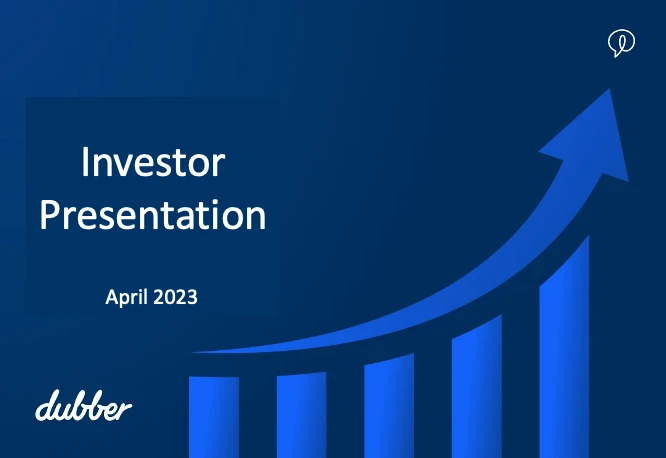
Today we had the opportunity to take Shareholders through Dubber’s investor presentation and why we are so excited about the opportunity ahead of us.

MELBOURNE, Australia – 29 March 2023 – Dubber Corporation Limited (ASX: DUB), the global platform that is driving revolutionary change in the communications industry, and Australian F1 driver, Oscar Piastri, are proud to announce an exciting partnership that unifies their shared passion for technology and data-led improvements.
Both Oscar and Dubber operate in fields where the smallest of improvements can shape the ultimate success.
Dubber was founded in 2011, the same year that Oscar entered his first karting races in Melbourne, and both are now challenging on the world stage in their respective fields.
Oscar secured a record-breaking run of three consecutive championship titles in Formula Renault Eurocup, Formula 3 and Formula 2 before entering the first stage of his Formula 1 career with McLaren. His debut F1 season, where he lines up as the youngest driver on the grid, represents the culmination of a 12-year dream that began in the Melbourne suburb of Brighton.
Oscar is returning to his home city, also the home of Dubber’s global headquarters, for the Australian Grand Prix at Albert Park on 2nd April 2023.
Dubber and Oscar’s partnership includes branding, messaging and customer engagement as he competes in his debut season on the biggest stage in motorsport which encompasses 23 Formula 1 races in the 2023 calendar.
In F1, more than any other sport, a commitment to improve technology and processes is paramount to success. Performance is heavily reliant on insights and data that can power critical competitive advancements.
Likewise Dubber enables its global Service Provider partners and their customers to improve their performance and competitive advantage with data and insights, in our case, from conversations and customer interactions.
Neil Wilson, Chairman of Dubber, commented: “Dubber has been working with Oscar and his team over the last year to develop a partnership which reflects our aspirations and values. Oscar is a tremendous talent backed by hard work, ambition and determination. We also share the common goal of turbocharging performance in our respective fields through technology and analytics where the slightest insight and improvement can make a world of difference. We look forward to Oscar passing on some of those insights to our customers.
“We are delighted to be partnering with Oscar as he embarks on the start of his F1 journey. In a visit to our Melbourne headquarters in January, Oscar inspired our team with his vision and commitment to delivering the highest possible standards to the Dubber team.
“We’re all behind him and will be following his progress closely.”
Oscar Piastri, F1 driver, added: “I am massively grateful to Dubber for their backing and support. I am thrilled to be aligned with such a cutting-edge and forward-thinking company and can only thank all the Dubber family for the warm welcome they have given me.
“It means a lot to me that the team at Dubber want to be part of my journey and will be supporting me all the way.”
About Dubber:
Dubber enables Service Providers to unlock the potential of the network – turning every conversation into an exponential source of value for differentiated innovation, retention and revenue. Listed on the ASX, Dubber is the clear market leader in conversational intelligence and capture – embedded at the heart of over 175 service provider networks.
For more information, please visit Dubber at www.dubber.net or contact:
Dubber – Investors & APAC
Terry Alberstein
terry@navigatecommunication.com.au
+61 (0) 458 484 921
Dubber – EMEA & The Americas
Stephanie Forrest – CEO, TFD
dubber@wearetfd.com
+44 7951 786435

Dubber Corporation Ltd (ASX: DUB) (Dubber or Company) is aware of media and regulatory reports indicating a potential closure of Silicon Valley Bank (SVB) operations in the US and UK. The Company is continuing in its efforts to recover these funds and there is no material impact on Dubber’s liquidity position or operations as a consequence of this event.
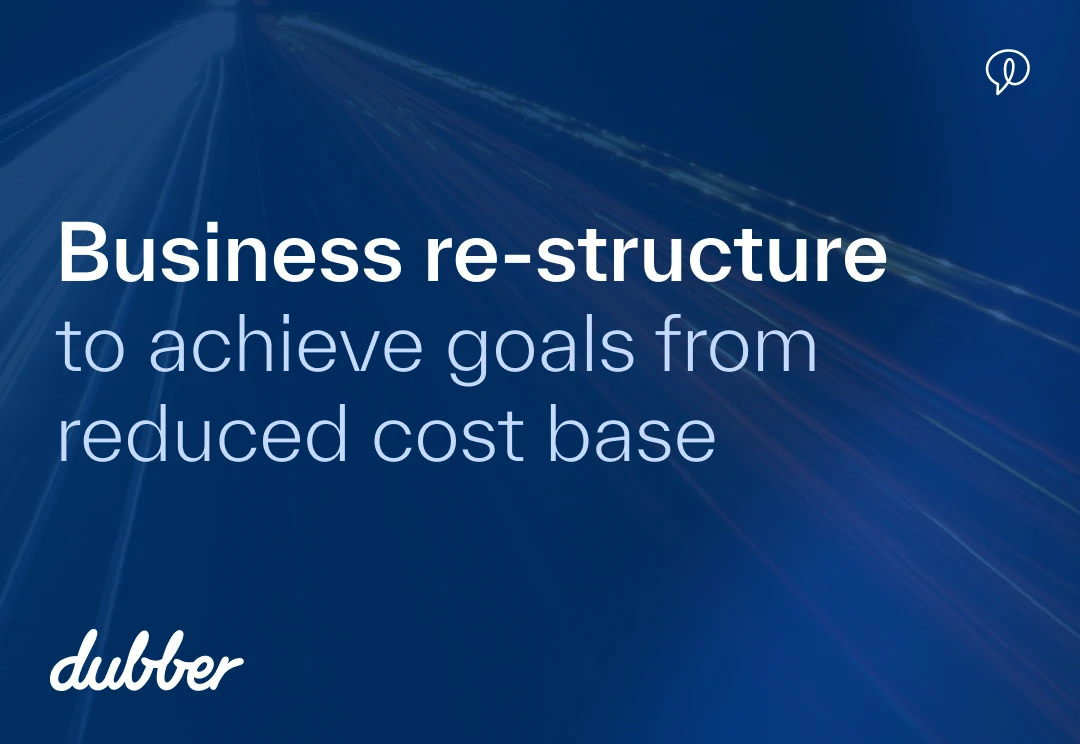
Dubber Corporation Ltd (ASX: DUB) has completed a review of efficiencies and costs across its global operations and will implement a restructure of its business. This is expected to deliver in excess of $5 million in savings per quarter without impacting the Company’s revenue growth potential or customer service.
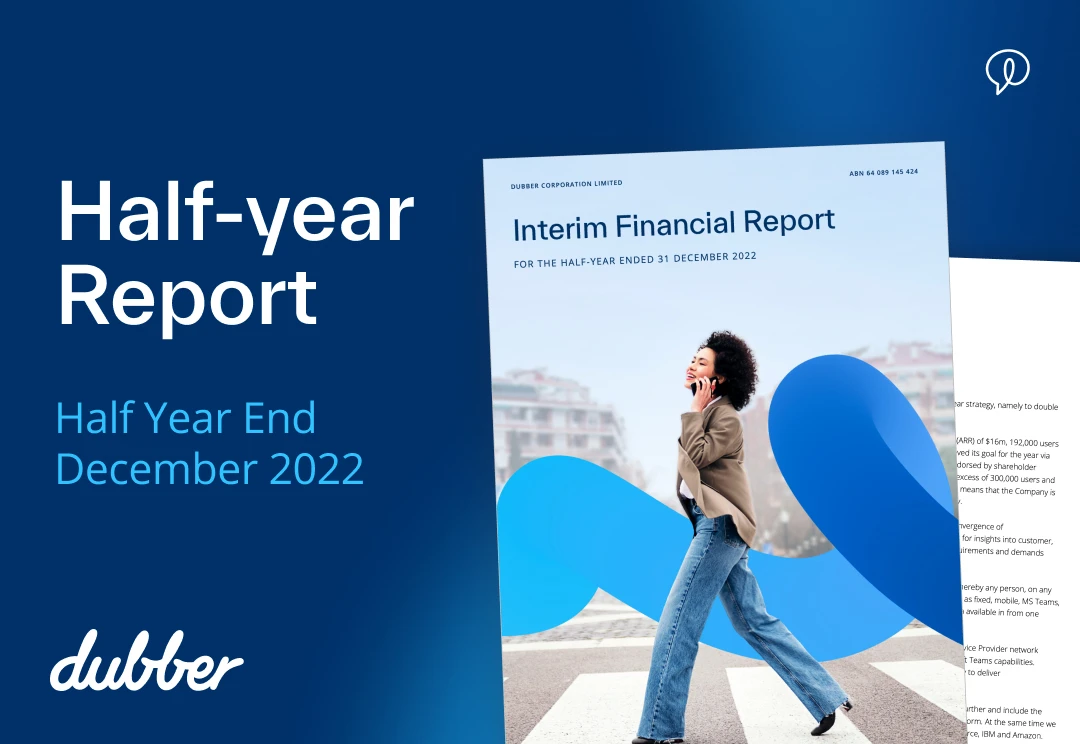
Dubber Corporation Limited (ASX:DUB) the leading conversational intelligence and unified recording platform for service providers and their customers globally, today released its Interim Financial Report for the half-year ending 31 December 2022.
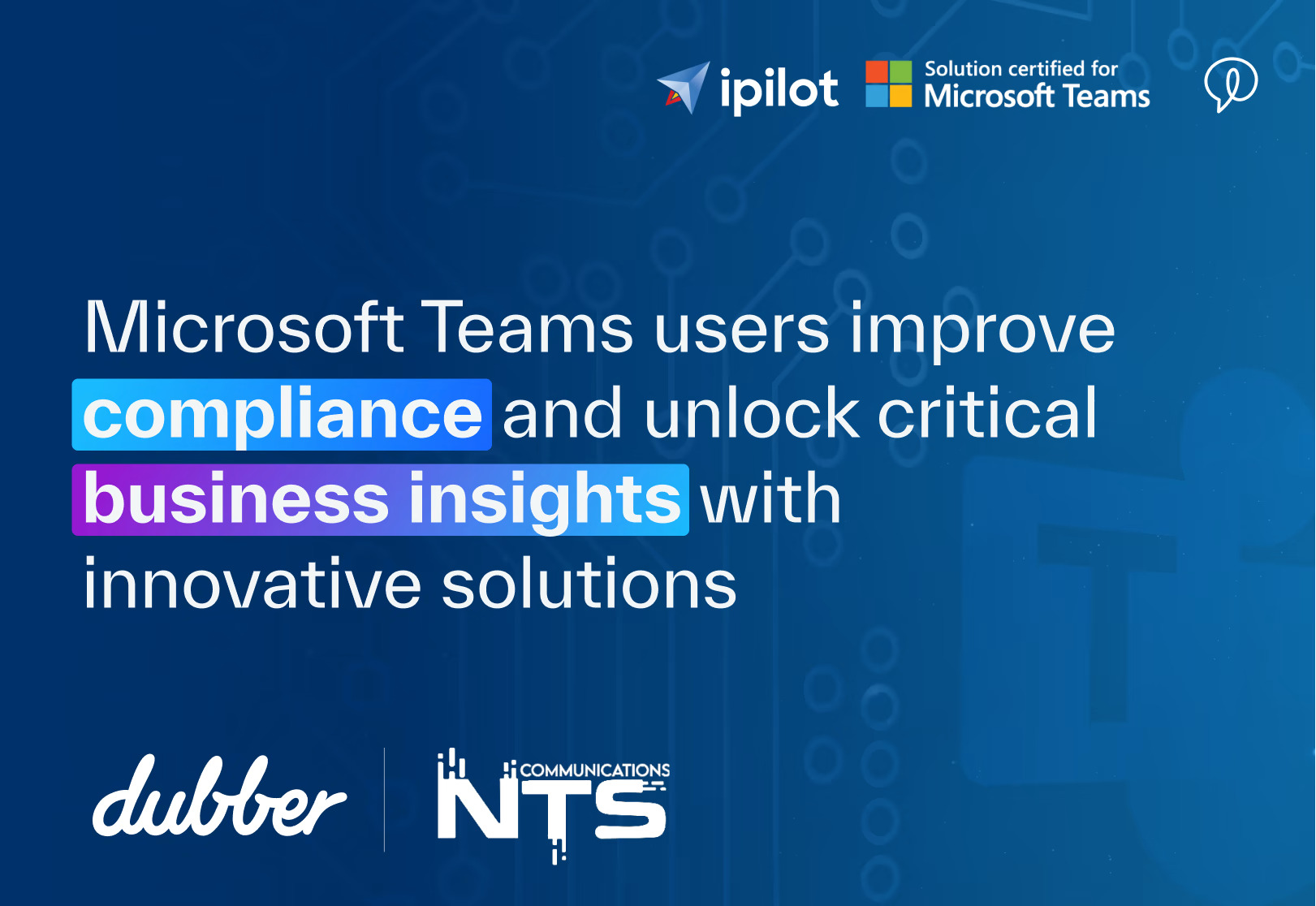
Together, Dubber & NTSCOM are helping Microsoft Teams users meet compliance requirements, elevate customer experience, automate workflows, and increase productivity across a wide array of business verticals. Customers have immediate and seamless access to Dubber’s compliant and secure conversation capture and insights solution through NTSCOM via iPILOT.
Businesses in regulated industries can now create a compliant, easily accessible recording of every conversation in one place – critical for meeting regulatory compliance mandates. With the recent trend towards hybrid and remote working, the explosion in the usage of communications platforms like Microsoft Teams has never been more important.
However, there is an opportunity for businesses to do more with their conversation data beyond compliance. Dubber and NTSCOM are enabling businesses to improve business outcomes.
Here are a few sector-specific examples:
Healthcare
The healthcare landscape is constantly changing, so Dubber and NTSCOM have partnered to deliver flexible solutions for customers in this sector. Organizations can now keep up pace with changing compliance requirements, but also use information-rich conversation data to improve the quality of healthcare provided and staff productivity.
In October of 2022, the Centers for Medicare & Medicaid Services (CMS) strategic vision of expanding access to affordable health care and improving health equity was advanced when, under the Affordable Healthcare Act, new compliance and recording rules went into play. During the enrollment period, Medicare & Medicaid Services will require all supplemental insurance sellers to record and retain all marketing and sales conversations for 10 years. See CMS Recording Mandate.
The use of telemedicine has increased significantly over the past few years as well, and voice intelligence plays an increasingly essential role in accelerating better-automated customer experience with telemedicine – both for providers and patients. With Dubber, customers can:
- Improve patient outcomes and resolve disputes through the elimination of manual note-taking with automated transcriptions
- Meet regulatory and legal requirements (CMS Mandate)
- Seamlessly monitor and supervise to maintain conduct standards, safeguard electronically protected health information, and avoid any data breaches (ePHI)
Education
While local, state, and Federal education policies may differ, the need for unified call recording has never been so crucial in education. The pandemic provided the opportunity for a surge in online instruction: whether asynchronous, synchronous, or hybrid, many institutions are continuing to offer multiple ways to complete coursework. There is now an increased need for accessibility, accountability, and capturing lectures, group work, and other in-class activities. All this is essential to improve online learning standards for stakeholders at all levels: teachers, students, parents, administration and government agencies.
Institutions at all levels heavily use video conferencing and collaboration tools such as Microsoft Teams to engage students and improve performance. Integrating Dubber’s suite of voice recording tools allows customers to:
- Uncover student insights and provide a record of student contacts and conversations
- Capture learning on every platform without the cost and limits of application-specific and legacy platforms
- Meet compliance mandates for education at all levels
Government
Governments, too, are increasing their use of innovative technology. This provides huge benefits to oversight, employees, and the public.
Technology with value-added services such as Dubber increases organizational efficiencies, minimizes spending across all departments and simplifies the processes that inherently bog down public service. Dubber allows federal, state, and local governments to:
- Quickly, accurately and easily fulfill compliance and public information requests.
- Obtain high-quality training and recording insights that can be used to improve coaching, as well as employee onboarding and upskilling
- Improve data collection for feedback to other governmental agencies or departments
- Enhance public safety with the capture and storage of critical communications
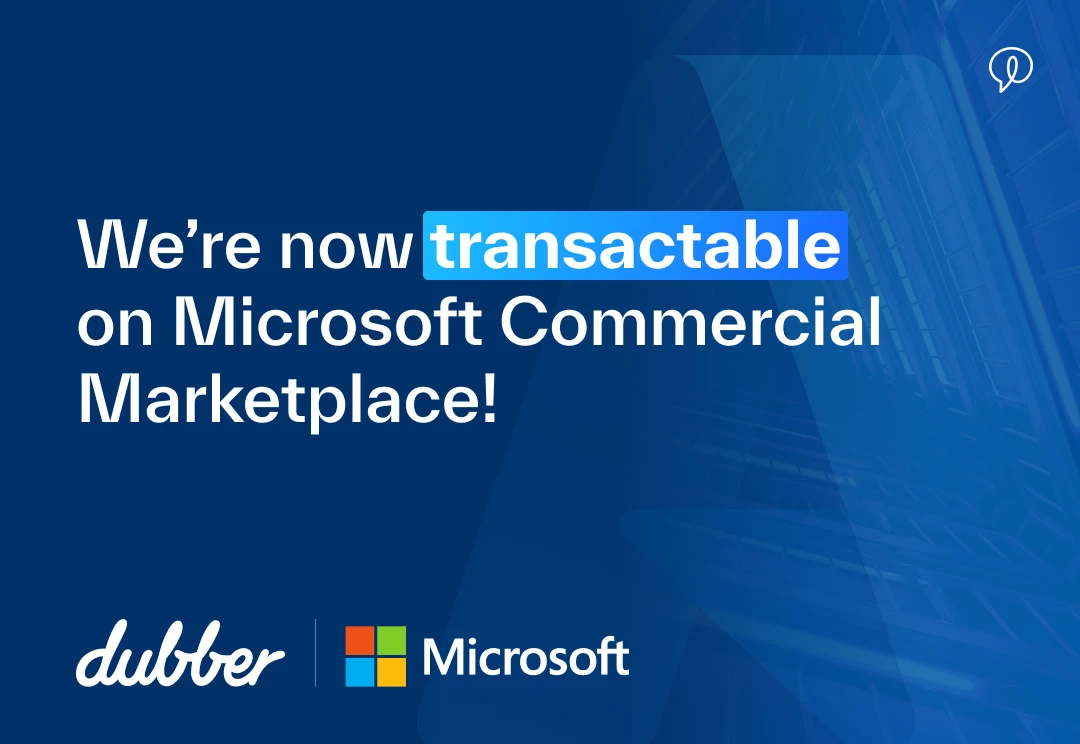
Dubber’s leading conversation capture and intelligence solutions can now be purchased by customers and partners directly through the Microsoft Commercial Marketplace, which includes
the Azure Marketplace and Microsoft Appsource. The marketplace connects to over 4 million monthly active shoppers and more than 90,000 CSP (Cloud Solution Providers) globally.
This follows Dubber’s recent achievement of Azure IP Co-Sell Incentive Status– a collaborative agreement that enables Dubber to work directly with Microsoft sales teams and Microsoft partners on joint selling opportunities.
These two major milestones demonstrate the important and strengthening relationship between Dubber and Microsoft. The accomplishment also reflects Dubber’s continued commitment and focus on driving Azure consumption and becoming the leading compliant Microsoft Teams capture and insights solution in 2023.
Together, Dubber and Microsoft are enabling partners and their customers access to a conversational capture and intelligence platform that is Microsoft certified and ensures compliance with all major global communications regulations.
Microsoft Commercial Marketplace Transactable
There are four Dubber products available on the Commercial Marketplace: Dubber Recording (available via select partners), Dubber Unified Capture, Dubber Insights, and Notes Pro by Dubber. These solutions enable organisations to unlock the potential of every conversation and deliver critical business insights for compliance, CX, dispute resolution, productivity, coaching and more. For Service providers looking to transact through the marketplace, this solution allows a secure and rapid path to differentiation and revenue.
What does this mean for customers?
Dubber is “Azure benefit eligible” which means that eligible end customers can use purchases of Dubber to contribute towards their Microsoft Azure consumption commitments (MACC).
What does this mean for partners?
Resellers and communication service providers (Microsoft Cloud Partners) can benefit from a simple transaction and payment process, including guaranteed on-time payment by Microsoft. By transacting Dubber in the marketplace, resellers may also receive additional opportunities with Microsoft managed customers.
Additionally, communications service providers can take advantage of a zero cost and expedited means of transacting Dubber sales without having to “productise” the solutions.
About the Azure Marketplace:
The Azure Marketplace is an online market for buying and selling cloud solutions certified to run on Azure. The Azure Marketplace helps connect companies seeking innovative, cloud-based solutions with partners who have developed solutions that are ready to use.
Want to learn more?
Visit Dubber on Microsoft Appsource
Visit Dubber on Azure Marketplace
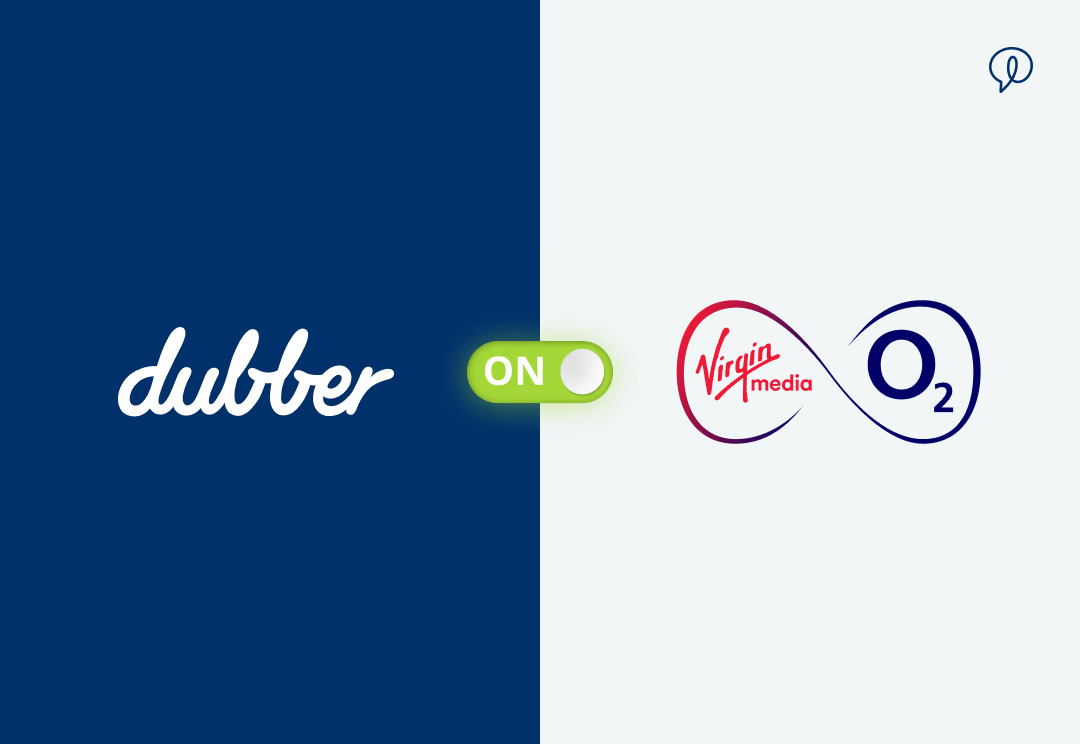
- Expanded mobile recording capabilities from Virgin Media O2’s network now available to small to medium-sized business (SMB) and public service sector customers
- Significantly extends the existing relationship where Dubber is the Mobile recording service for enterprise customers
- Unified recording and intelligence ties in mobile, Microsoft Teams, Cisco, and Zoom with transcription and sentiment analysis using AI
- Intelligent call recording and Dubber AI switch on immediately to deliver value across compliance, customer, people, and sales
Melbourne, Australia and LONDON – 15 February 2023 – Dubber Corporation Limited (ASX: DUB), the leading unified recording and intelligence platform for service providers and their customers globally, has significantly expanded its partnership capability with Virgin Media O2 Business giving customers an increased range of mobile recording services and access to connected systems via one platform, provided over Virgin Media O2’s network.
Virgin Media O2 is one of the UK’s largest telecommunications service providers with more than 47 million UK connections across broadband, mobile, TV and home phone, and passes 16 million premises with its own fixed network. This expanded partnership, which transitions Dubber from a vendor to a strategic partner for unified recording and intelligence, will provide Virgin Media O2 Business customers with access to the full Dubber product suite.
Customers will benefit from additional services ranging from AI-enabled transcription to sentiment analysis, with support for platforms including: Cisco Webex (CSCO), Microsoft Teams (MSFT) and Zoom (ZM)enabling customers to host and track recordings across a range of systems through a single, secure platform. Expanding on these benefits, the Dubber product suite provides intelligent features to support businesses in meeting client needs. This goes beyond traditional transcription services to provide sentiment analysis of secure and consensual recordings; features that can be used by businesses to support a range of purposes including customer service and dispute resolution to regulatory compliance, sales automation and intelligence, productivity, and employee training.
Dubber and Virgin Media O2 Business’s partnership will enable customers to unlock the potential of every conversation across mobile and unified communications. Last year, Gartner predicted that ‘in 2025, 75% of conversations at work will be recorded and analysed’ enabling businesses across all industries to discover added organisational value. Dubber is ahead of the curve with tasks such as compliance, workplace engagement and training all being answered through a service-native solution that switches on with a click.
Andrew Halliwell, Product Director, Virgin Media O2 said:
“This expanded partnership creates new opportunities for our long-term relationship with Dubber and extends a wider range of services to our customers. The Dubber product suite coupled with Virgin Media O2’s mobile and broadband network will provide our SMB and public sector customers with greater mobile recording insights in one place, enabling them to make more informed decisions to address their productivity, compliance and intelligence needs.”
Steve McGovern, CEO, Dubber:
“Today’s announcement is a testament to the strength of the partnership between Dubber and Virgin Media O2 and our shared vision for a fully automated and self-service cloud solution. Addressing unified recording and intelligence on both mobile and UC networks unlocks a significant addressable market for both Dubber and VMO2 – enabling more conversations than ever before to be tapped for insights. We look forward to continuing to work closely with VMO2 to deliver greater value to their users as we develop the next generation of unified recording services together.”
ENDS
About Dubber:
Dubber enables Service Providers to unlock the potential of the network – turning every conversation into an exponential source of value for differentiated innovation, retention and revenue. Listed on the ASX, Dubber is the clear market leader in conversational intelligence and unified recording – embedded at the heart of over 175 service provider networks.
For more information, please visit Dubber at www.dubber.net
About Virgin Media O2
Virgin Media O2 launched on 1 June 2021, combining the UK’s largest and most reliable mobile network with a broadband network offering the fastest widely-available broadband speeds. It is a customer-first organisation that brings a range of connectivity services together in one place with a clear mission: to upgrade the nation. Virgin Media O2 is the corporate brand of the 50:50 joint venture between Liberty Global and Telefónica SA, and one of the UK’s largest businesses.
The company has 47 million UK connections across broadband, mobile, TV and home phone. Its own fixed network currently passes 16.0 million premises alongside a mobile network that covers 99% of the nation’s population with 4G, and more than 800 towns and cities with 5G services targeting 50% population coverage in 2023.
For more information, contact:
Investors & Media
VMO2
Leia Karam
leia.karam@virginmediao2.co.uk
+44 (0)7478 693 445
Dubber
Terry Alberstein
terry@navigatecommunication.com.au
+61 (0) 458 484 921
Dubber EMEA
Stephanie Forrest
Stephanie@wearetfd.com
+44 7917 695 755
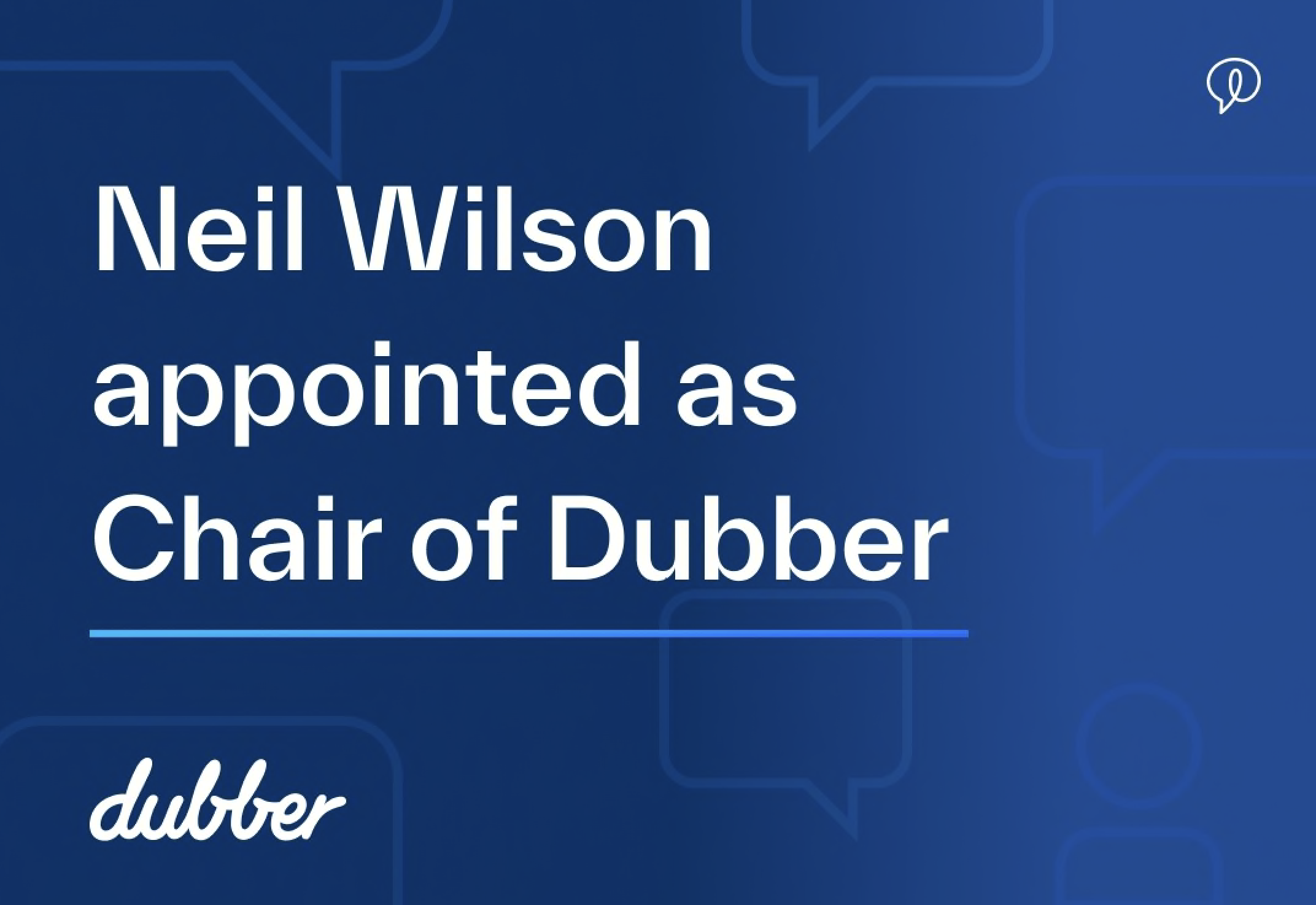
Dubber Corporation Ltd (ASX: DUB) (Dubber or the Company) is pleased to announce the appointment of Neil Wilson as Chair effective today.
Neil is an experienced business leader and entrepreneur with corporate, start-up, founder and public company experience. He holds a Bachelor of Business degree and is a CPA and Member of the Australian Computer Society.
Neil is a practitioner in the digital and technology domain and has extensive experience in general management and CEO management across private and public company scenarios.
He held the position of Managing Director and Chief Executive Officer of Oakton Limited (ASX:OKN), until its acquisition by Dimension Data in 2014. He completed a three-year term as the CEO of the Victoria Racing Club (VRC) and has been the VRC Chairman since November 2020.
Neil is currently Chairman of Nexon, a non-executive director of ASX-listed Knosys Limited and a member of Advisory Boards for several private technology and digital companies. He continues to be a regular keynote speaker at industry and investor forums and presents to boards and executive committees on digital and technology directions and the value of a data and an information focus.
Following Neil’s appointment by the Board, Peter Clare steps down as Chairman and has resigned as a director, effective 28 February 2023.
Steve McGovern, CEO, Dubber: “The Dubber team is excited to have Neil Wilson join the Company as Chair. Neil brings with him an expert insight into the sector which will be pivotal to Dubber’s aspirations for digital data transformation.
“We would also like to thank Peter Clare who has been Chair for over 5 years. During his tenure Peter oversaw the transition from a small business into a globally recognized leader in its field. We wish Peter well in pursuit of his many other interests.”
Neil Wilson commented: “Dubber is a great example of a next generation company in the digital and data sector. The local and global opportunities are immense, and I am privileged to be joining the company at this stage of its evolution.”
Mr Wilson has agreed to be remunerated for this role partly in cash and partly in equity. Accordingly, subject to shareholder approval, he will be invited to participate in the Company’s equity incentive scheme and be granted the following securities subject to the Company’s equity incentive scheme rules:
311,084 zero exercise price options; and 600,000 “Remuneration Options” exercisable at $0.50 each on or before 31 July 2027 vesting equally (ie 200,000 options on each occasion) on achievement of share price targets of $0.75, $1.00 and $1.50
(calculated using a rolling 20 day VWAP of Company’s shares traded on ASX).
This announcement has been approved for release to ASX by the Board of Directors.

During 2022, Senior researchers at the Dubber AI Centre of Excellence, worked with leading university groups to co-supervise student projects and internships across Honours, Masters and PhD levels.
“We’re proud to be helping foster emerging talent in speech and language AI in Australia by partnering with local universities. These connections are a great way for us to keep track of the latest academic advances, while giving students the opportunity to work on problems with practical applications.” Dr Iain McCowan, Director of AI at Dubber
“The School of Electrical Engineering and Telecommunications is pleased to be partnering with innovative Australian industry partners like Dubber to develop new digital signal processing and machine learning capability. These honours thesis topics jointly supervised by Dubber experts provide invaluable workplace-relevant skill development for UNSW Engineering students, and build industry-university collaboration” Professor Julien Epps, Head of School of Electrical Engineering and Telecommunications, UNSW
The projects showcased a range of innovative conversational AI initiatives. As we look forward to welcoming a new cohort in 2023, here is a summary of the projects we enjoyed supporting in 2022:

Darshana Madduma – PhD Internship
University: Professor Sridha Sridharan, QUT.
Title: Evaluation of the Applicability of Audio Transformer Networks for Speaker Diarization.
Darshana investigated how emerging pre-trained general acoustic models can be applied to multiple end tasks, with an initial focus on automatically segmenting speaker turns in conversations. These models have the promise of increased accuracy while sharing computational resources across different tasks.
Jack Murray – Honours Project
University: Dr Vidhyasaharan Sethu, UNSW
Title: Modern Speech Representation Frameworks for Spoken Language Identification and Segmentation
As speech technologies advance, we face the problem of providing equal access to multilingual speakers, and speakers of less common languages. Some issues with existing systems are that they often support only one language at a time and are usually trained using thousands of hours of labelled data. For less common languages, these large, labelled datasets often don’t exist. Jack’s project implemented a language segmentation algorithm trained on a minimal amount of data by leveraging pre-trained general acoustic models. This could form the basis of a system to segment and transcribe conversations that contain multiple languages.
“It was great having Dubber AI experts supporting my project. Not only did I learn a lot more than I would have on my own, but it was also really motivating to see practical applications of this type of research”
Jack recently came second (out of around 200 entries) in EE&T’s Thesis Poster Competition, as judged by industry, alumni and academics. Congratulations, Jack!
Pavithra Bharatham Rengarajan – Masters Project
University:Dr Lingqiao Liu, University of Adelaide (AIML)
Title: Unsupervised Dialogue Segmentation with Next Sentence Prediction
Automatic segmentation of a conversation into topics is a key task towards effective presentation or summarisation of meetings. This is a difficult problem however, and large annotated datasets for this task are not readily available. Pavithra’s project focused on unsupervised techniques that could be used with limited data. The most promising approach used Next Sentence Prediction (NSP) from the Bidirectional Encoder Representations from Transformers (BERT) model to identify the change of context or direction of a conversation transcript.
Madeline Younes – Honours Project
University: Associate Professor Beena Ahmed, UNSW
Title: Exploring Transfer Learning for Arabic Dialect Identification
The goal of Madeline’s project was to automatically distinguish between different spoken Arabic dialects to help improve transcription accuracy. Given there are scarce data resources for many of these dialects, a novel approach to Dialectal Identification (DID) was investigated by leveraging pre-trained acoustic models. A multi-stage approach was developed to first classify into one of four umbrella Arabic dialects, and then into a more fine-grained regional DID with seventeen dialects.
Erin Moss – Honours Project
University: Associate Professor Beena Ahmed, UNSW
Title: Domain Specific Sentiment Analysis
Erin’s project investigated how first determining the domain context (topic, or subject matter) could be used to improve training of sentiment classification models for Natural Language Processing. The system developed included a first statistical model to detect the domain, followed by a second stage where this information was used to select a specialised lexicon on which the sentiment analysis classifier was trained.
We’re helping service providers and organisations unlock the full potential of conversations.Learn more about the Dubber AI Centre of Excellence.
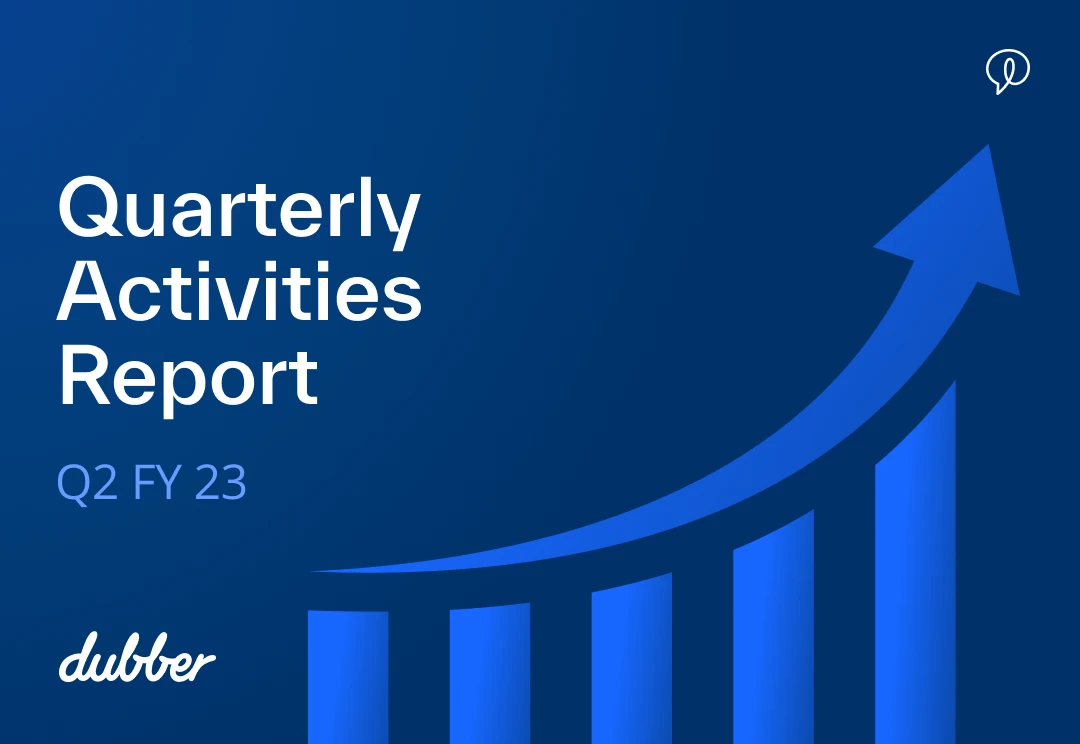
Melbourne, Australia: 31 January 2023 — Dubber Corporation Limited (ASX:DUB), the leading unified call recording and conversational intelligence platform to global telecommunication service and solution providers, today released its 2Q FY23 Appendix 4C and is pleased to provide this Quarterly Activities Report
2Q FY23 Snapshot
- Operating cash receipts for the quarter were $8.3m (up 48% PcP)
- Cash on hand at 31 December 2022 was $56.7m
- First Foundation contract for Dubber Notes secured with North American Microsoft
Teams Service Provider, Ziro - Leading UK service provider Gamma contracts initially for the launch of Dubber
recording and AI services and migration of existing recording users - Vodafone expands contract with Dubber services launched into UC and mobile
networks in Europe, initially with Vodafone UK, and Vodafone Germany - Virgin Media-02 expands existing contract to wider customer base
- US service provider NTS announces the launch of its Dubber service
- Alianza chooses Dubber as the embedded recording and AI service for its UC
platform serving as a core network for over 200 Service Providers - JB Hi-Fi Business contracts as the largest distribution partner for Telstra business
services - Ernst & Young Melbourne appointed as the Company’s new auditor
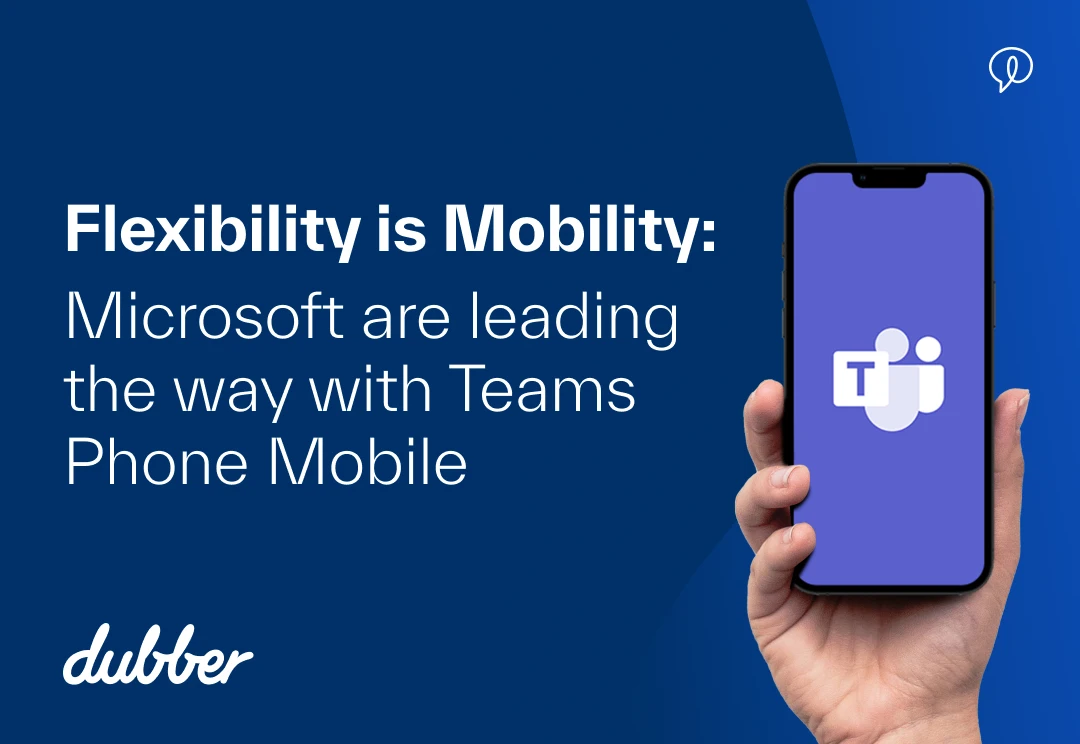
At the end of last year Cavell offered key spokespeople from our industry to step up, discuss and debate the Microsoft roadmap at their London event. If one message stood out above the rest, it’s that the Microsoft Teams growth spurt is far from finished. Teams is a somewhat unexpected high achiever across the board, with 53% of organisations globally choosing it over other collaboration tools. In fact, monthly user numbers for Teams are rumoured to hit an impressive 300 million in Q1 23. With a self-proclaimed focus being put into Microsoft’s relationship with Telephony, it’s an exciting time to be in the Service Provider seat and ride the investment that this juggernaut is pumping into the Mobile landscape.
Digging into Microsoft’s Teams platform development, it seems productivity is still king when it comes to measuring ROI. Empowering organisations with the means to collaborate remotely is critical, with ‘in office’ numbers failing to rise after the pandemic shift (the full-time adoption of hybrid working is now commonplace.) With over 450+ new features released in the past year alone, MS Teams is the obvious choice for companies embracing the modern workplace, and the proof is in the numbers. A cool 33% of organisations swapped to MS Teams from another platform in 2022. So, in the words of Microsoft’s Nick Hedderman, Teams is providing over half the planet with its ‘digital fabric.’ The reason for that seems clear, it’s productivity-centric with a strong development roadmap and a reputation built over decades.
We all want to connect and communicate in our own way- we have our best ideas when we feel relaxed. Microsoft have taken this notion and thrown their energy into Teams Mobile, the next step in creating true flexibility on a collaborative platform. Throughout the day, speakers continued to voice the value of telephony investment, with particular emphasis on Operator Connect. For end users looking to grow and scale their offering, Operator Connect provides the simple UX that customers are looking for- a solution that will unify their organisations’ telephony with certainty. As Marc Burkhard of Swisscom rightly put it: ‘we will become mobile first in the future’. With this in mind, the Operator Connect piece is critical for larger organisations to connect and expand their Teams Mobility in 2023 and beyond.
If Microsoft were clear on their telephony investment, the Service Providers drilled home the need to make those services stand out in a crowded arena. According to Andrew Small of BT: ‘it’s about differentiating the entire end-to-end customer experience.’ This is where revenue boosting platforms like Dubber come in. Adding voice AI and business insights to the Teams offering to improve the day-to-day of both user and manager. Throughout the event, it was obvious that the pressure is on to make the most of the financial investment in 5G and mobile. For Service Providers, differentiators like Dubber who are focused on adding retention, strategic partnership and revenue to the Teams mobile offering are a welcome gift.
If you only took away two learnings from the event it should be these: Microsoft are heavily invested in Telephony, with Teams Mobile set to transform the platform. Tools that create differentiation like Dubber are pivotal to helping SPs increase their Teams adoption and stand out in a competitive landscape. And secondly, Operator Connect is the gateway to scaling your telephony and improving revenue. Overall, the atmosphere in the room was a united one, the general consensus? ‘We’re better together’.
To dive into the detail around these points, you can check out the full webinar on-demand here.
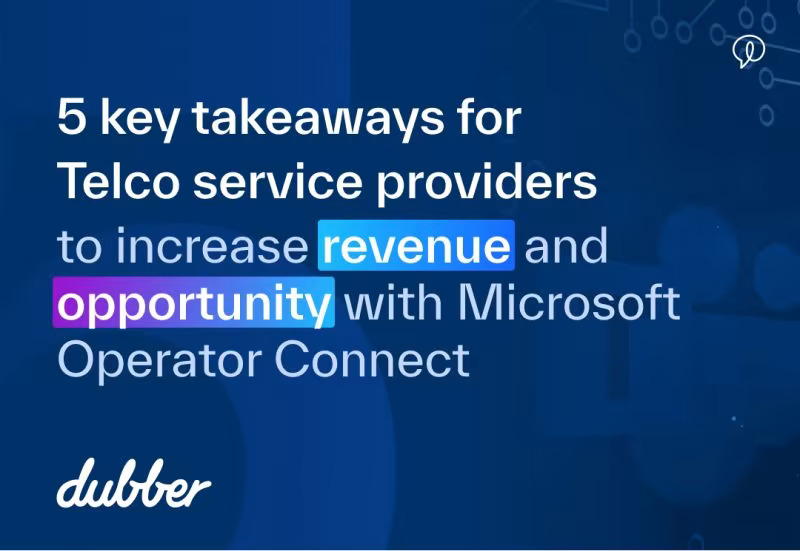
Tom Arbuthnot is co-founder of Empowering.Cloud, a Microsoft Teams Industry Professionals Community., who also offer enablement programs for enterprises and Microsoft partners.
Tom hosted Dubber’s recent webinar about the opportunities to add services and revenue around Microsoft Teams Operator Connect. The panel included Timoor Husain of Microsoft, Mark Bunnell of Nuwave and Adrian di Pietrantonio of Dubber.
This blog summarises some of the key takeaways. To check out the entire webinar please click here.
Microsoft is scaling and simplifying PSTN connectivity for the customer and the service provider
Microsoft Teams Operator Connect has been in the market for over a year, and progress and adoption have been good. There are 43 Operator Connect service providers, and many more are coming. In this model, the operator is directly connected to Microsoft, which makes it very simple for the operator and customer to provision phone numbers.
Microsoft has been bringing telephony to their Unified Communications proposition for over 14 years. Traditionally, this involved customers deploying and managing their own session border controller infrastructure and connecting to the service provider with SIP trunks. This traditional model was quite complex, requiring a lot of infrastructure and professional services.
Operator Connect offers a much simpler model, which goes some way to explaining the quick uptake and adoption by Service. It sits alongside Microsoft’s Calling plans and Direct Routing as one of four options for PSTN connectivity for Teams users.
Teams Phone Mobile is the latest connectivity option to hit the market from Microsoft, running on the back of the operator connect platform. It will offer the new ability to be a single mobile/cell number for your mobile and Teams. One of the benefits is that a single Teams-certified recording platform like Dubber can record and capture both the Teams and the mobile calls.
Combined, these four options give customers the choice to pick the combination that is right for them and personalise their experience of MS Teams. This level of choice also increases competition in the service provider market.
Customers want to reduce infrastructure and reduce costs
Customers are rapidly moving to Cloud Telephony platforms like Teams Phone. They are moving away from complex on-premises infrastructure, such as local SBCs, in favour of scalable cloud services.
I observed that with the acceleration of Microsoft Teams Phone, customers are often taking the opportunity to reassess their PSTN service provider choice and are looking to optimise spending and ROI on tech investment.
There is an increasing demand for self-service solutions. Mark Bunnell, COO Nuwave, noted 70% of Nuwave’s customers are moving to self-service cloud management.
There is no doubt that while Teams Phone is a rapidly growing market, there is competitive and margin pressure on service providers. Microsoft expects more providers to join Operator Connect in the future. With over 53% of organisations already choosing teams over other communication tools.
There are opportunities to add value and revenue with additional services customers need
While there is pressure on the minutes business, and it is getting somewhat commoditised, some great opportunities exist to differentiate and add value. Microsoft Teams is an ecosystem solution, meaning you need many components from different Microsoft partners to complete the customer solution. These include PSTN connectivity, recording, contact centre, eCDN, reporting and devices.
Service providers are in a great position to build out their offering with telco-related services like recording, business insights, compliance and contact centre. Differentiating services in this way empowers customers to unlock the value ‘in’ the network, improve stickiness and boost revenue.
Timoor Husain, Microsoft, noted the opportunity to offer the even fuller Microsoft 365 stack as an operator as a true managed service.
Mark also pointed out that there is still a lot of complexity in enterprise telephony and that does provide opportunities.
Operator Connect Accelerators like Nuwave can increase speed to market and allow you to add additional services
Nuwave offers service providers a platform you can integrate to quickly get onto Operator Connect and give your customers a full self-service experience. They are one of Microsoft’s certified Operator Connect Accelerator partners.
Beyond Operator Connect, Nuwave has already integrated with Dubber and can add additional revenue-generating services for your customers, such as Contact Center and Dubber recording. All from a single platform.
If service providers prefer, they can also integrate Dubber directly into their service provider network.
With Dubber, you can offer recording and data insights for traditional PSTN calls and all Teams’ VoIP calls and meetings
Dubbers’ platform is specifically for service providers. Adrian di Pietrantonio noted Dubber works with over 175 providers.
Dubber allows operators to offer cloud-based Teams certified recording for customers for compliance and productivity improvements. Beyond compliance, increasingly required by customers in all markets, customers and providers are leveraging recording data and offering new value-added services. With Dubber, recording can be extended beyond just the PSTN calls into the customers’ Teams’ VoIP calls and meetings, which is essential for complete customer coverage.
To dive into the detail around these points, you can check out the full webinar on-demand
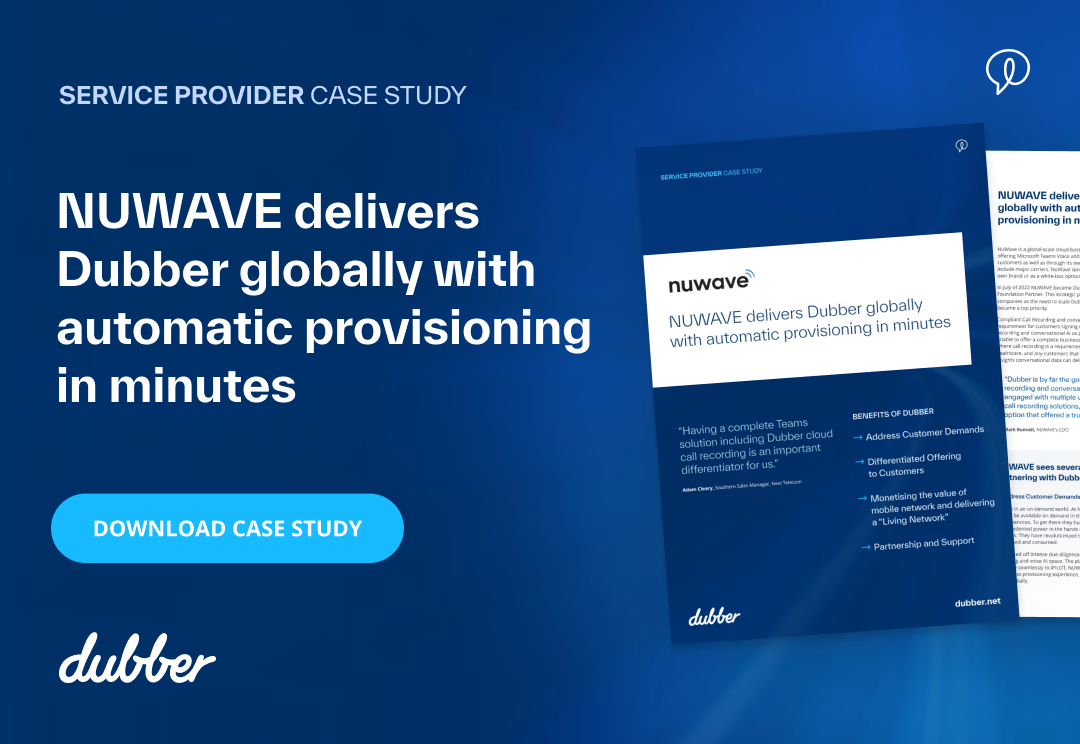
In July of 2022, NUWAVE became Dubber’s first Operator Connect Foundation Partner. This strategic partnership decision was pivotal for both companies as the need to scale Dubber’s technology quickly and globally became a top priority.
With Dubber’s Unified Conversational Recording (UCR) capabilities integrated into iPILOT and available to all NUWAVE customers as an entry-level solution at no cost, NUWAVE deploys the Dubber platform with instantly automatic provisioning.
NUWAVE and its partners can then choose to work with Dubber to introduce customers to richer and more comprehensive conversational recording and AI solutions to address a broad range of business needs by unlocking valuable information and insights from conversations across their voice and video calls.
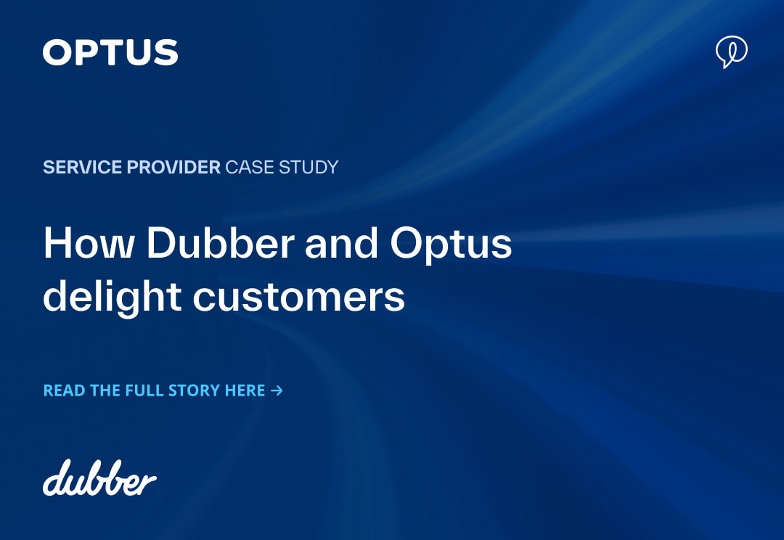
“Optus is a challenger brand”, says Catherine Yue, Senior Director of Mobile for Optus Enterprise and Business. “We’re not the incumbent and we are in a quite different place in the market. We need to do things differently. For us that means looking for products and services we can use to delight and inspire our customers. Things like Dubber.”
Yue says her team looks for propositions which can improve the customer experience and the employee experience for Optus’ enterprise and SMB customers. “Dubber is very much focused on both, you can see it from a management perspective and an employee perspective. It answers their need to collect better insights and improve what they are doing and that means that in turn it helps them improve their customers’ experience.”
Delighting the customer cuts to the core of Optus’ philosophy. Yue says it’s what sits at the core of mobility and how Optus aims to carve out a greater share of the B2B mobility market. It’s not only enterprise and business customers. She says: “I look at what my colleagues are doing on the consumer and prepaid markets and it’s much the same. When you’re a challenger brand you have to find different focus areas.”
Optus was first introduced to Dubber when the company’s financial services team needed to find tools that could help customers deal with compliance requirements. Dubber ticked that box. Then, Yue says; “Once we double clicked on it and saw what it could do, we realised Dubber was much larger than financial services. We talked to our customers and quickly found there are so many other use cases. It could be in retail, legal, entertainment or in healthcare. We found there is so much that our customers can do with it.”
While Dubber has the ability to drive new revenue streams for a carrier like Optus, Yue says it makes for stickier customers. “Of course we want to increase the revenue from our customer base, but we can only do that if we have a proposition which resonates with customers and adds value. We want to offer them something that’s compelling and relevant.”
It’s still early days for Optus Enterprise and Business and Dubber, yet Yue says her team are already having conversations with customers about empowering their people to elevate their work to another level. It’s no longer just about a mobile device and voice, it’s about what else can be done.
Because Dubber is native on the Optus network, Yue says it makes it simpler for customers. She says: “It’s not like you have to go through an app or anything else, you actually just make a call and it records. There’s no additional action.”
For Yue and Optus, being able to partner with technology providers like Dubber is central. “Our portfolio is stronger because of our partnership. Dubber’s experience globally and the technical resource compliments us as a carrier. The partnership with the sales and marketing teams is also valuable. We can deliver a much stronger proposition because we partner.”
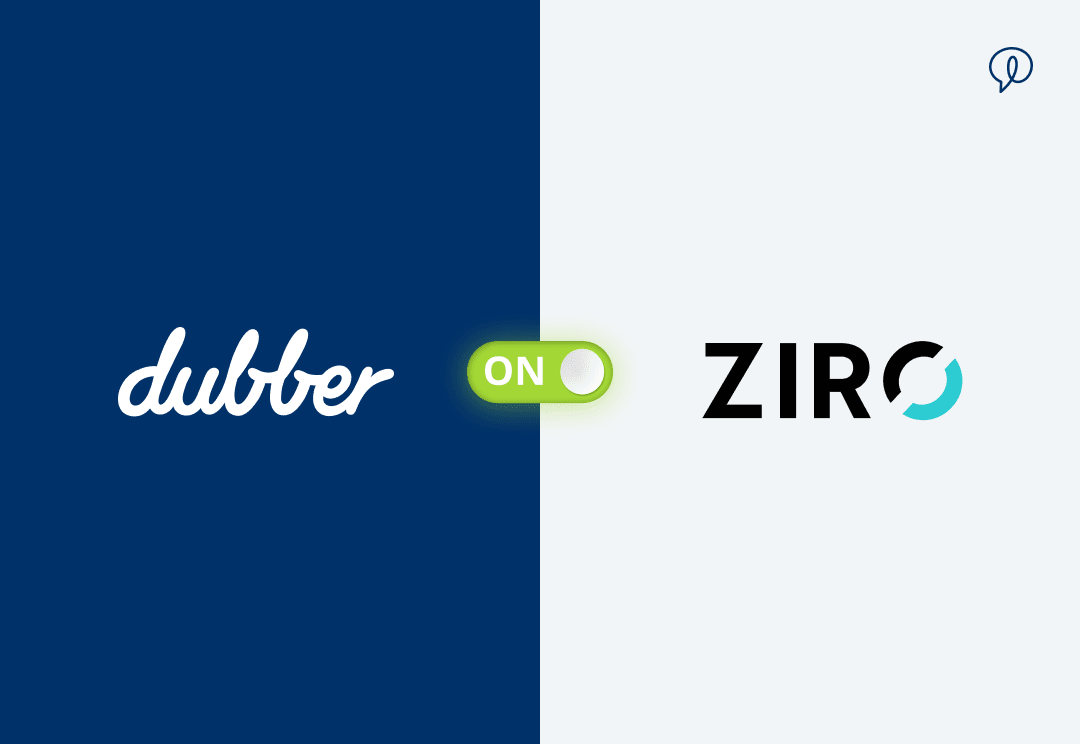
- ZIRO and Dubber sign Foundation Agreement enabling every customer to turn calls into AI driven notes and productivity outcomes for MS Teams
- Launch of Revolutionary out-of-box productivity for MS Teams, with ZIRO embedding Dubber Moments subscription as a standard feature for every user
- ZIRO and Dubber collaborate on growth, upsell to Dubber Notes for MS Teams
- ZIRO launching Dubber Moments and Dubber Notes for MS Teams launching January 2023
Melbourne, Australia, LONDON, DALLAS – 7 December 2022 — Dubber Corporation Limited (ASX: DUB), the leading conversational intelligence and unified recording platform for service providers and their customers globally, announced it has signed a Foundation Partner agreement with ZIRO, based in South Denver, Colorado, servicing customers in Canada and the United States. The partnership agreement encompasses a range of Dubber’s products, as well as newly released Dubber Moments and Dubber Notes for MS Teams. ZIRO will be launching the relationship to their customers in January 2023 with Dubber supporting their growth via the Dubber Foundation program.
ZIRO is focused on delivering increased value to their end users. By embedding Dubber Moments within all MS Teams subscriptions provided by ZIRO, their end users get an out-of-the-box productivity feature, with outstanding user experience, differentiated from other providers and powered by Dubber.
Dubber Moments users have the option to upgrade with a click to the fully featured Dubber Notes for MS Teams subscription, which provides a complete automation of meeting and call note taking including AI features such as auto actions items, sections of conversations, speakers, topics and Dubber Moments. Via a collaborative process between Dubber and ZIRO through various channel marketing activities, users will be shown the benefits of upgrading to Dubber Notes for MS Teams.
Dubber’s Unified Recording and Unified Recording + Insight suite of packages will also be available via ZIRO.
Steven Karachinsky, CEO, ZIRO:
“We’re thrilled to partner with Dubber because they share our passion for innovation and no-hassle values. They take recording to a whole new level by making it accurate, compliant, and actionable. That speaks volumes to us and to our customers, especially those in healthcare and financial institutions. How many times have we sat in meetings and either forgotten to take notes or dreaded making sense of a native app’s transcription? With Dubber, those days are over.
“We look forward to working with Dubber and to continue providing more value to customers by making UC easier than ever.”
Steve McGovern, CEO, Dubber:
“We’re really pleased to be launching a ‘Notes’ based Foundation program with ZIRO which will enable a fantastic user experience for their customers. ZIRO’s passion for innovation and market leading features for their Unified Communications services fits perfectly with the aspirations of Dubber’s ground-breaking platform. Customers can put away their pen and paper and enjoy AI driven note taking as a source of information and productivity without having to rely on ‘whole of conversation’ transcription.
“We look forward to working with ZIRO to help them capitalize on their differentiated product offering to continually deliver more outcomes for more customers, turning UC into an increasingly valuable tool at the core of everyday life and business workflows.”
Background:
The Dubber Foundation program is a solution and engagement model which sees Dubber being made available for every user opening up capabilities for differentiation at a Service Provider level.
With the Foundation program a Dubber product is embedded as a standard feature into every service to the end customer. The program then sees both Dubber and the Service Provider engage directly with the customer to introduce higher value products which provide benefits to the customer and drive accretive revenues, improved margin, differentiation and retention for the Service Provider.
About ZIRO:
ZIRO is the only solution provider making Unified Communications simple and easy. We help enterprise IT teams select, set up, and manage their phone, contact center, and meeting room tech with a partner they can trust. With over a decade of UC know-how, ZIRO is changing the status quo so companies can solve their biggest IT challenges without the hassle. For more information, visit https://goziro.com.
About Dubber:
Dubber enables Service Providers to unlock the potential of the network – turning every conversation into an exponential source of value for differentiated innovation, retention, and revenue. Listed on the ASX, Dubber is the clear market leader in conversational intelligence and unified recording – embedded at the heart of over 175 service provider networks.
For more information, please visit Dubber on www.dubber.net or contact:
Dubber Global Investors & Media
Terry Alberstein
terry@navigatecommunication.com.au
+61 (0) 458 484 921
Ziro Investors & Media
Achim Klor
aklor@goziro.com
+1 514-379-2128
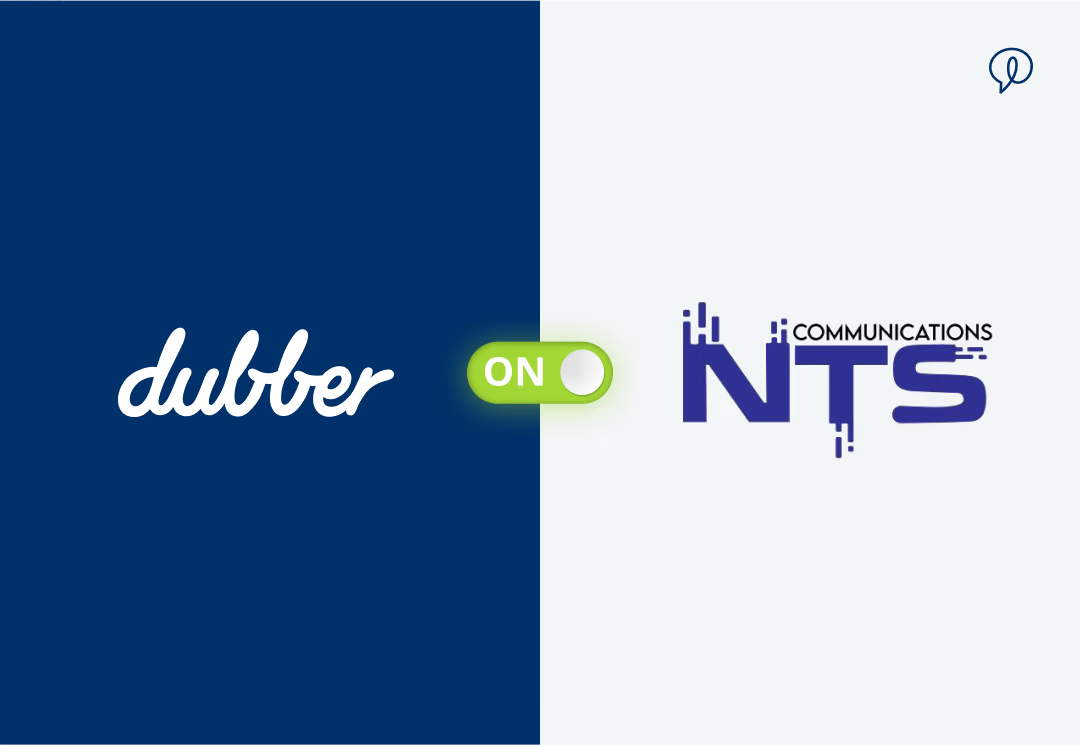
- NTSCOM launches Dubber for Microsoft Teams across its broad installed base
- NTSCOM utilizing Dubber’s existing integration for MS Teams via iPILOT, servicing enterprises in North America, EMEA and South East Asia
- Dubber – a leading certified recording service for compliant call recording on Microsoft Teams – enables NTSCOM customers and its partners to switch on and deliver value immediately, with first significant large enterprise commencing deployment
- Enhances Dubber’s position as the supplier of choice for MS Teams via Service Providers
Melbourne, Australia, and LONDON, DALLAS – 7 December 2022 — Dubber Corporation Limited (ASX: DUB), the leading conversational intelligence and unified recording platform for service providers and their customers globally, announced that it has signed an agreement with NTSCOM. NTSCOM is headquartered in Las Vegas, Nevada, and delivers services across the United States and internationally.
Dubber will further elevate NTSCOM offerings to automate conversational intelligence and unified recording, extending its ability to bring innovative solutions to Microsoft Teams. With a broad installed base spanning government, education, and healthcare sectors – all heavily regulated industries – Dubber’s compliant conversational intelligence will ensure regulatory mandates are met and the insights contained revealed.
Michael Abenhaim, Dubber SVP of Americas:
“Dubber’s service, integrated with iPILOT, will be seamlessly provisioned with NTSCOM offerings and Microsoft Teams, enabling Dubber to be uniquely delivered as a service so that NTSCOM, its customers, and partners can switch on and deliver value immediately.
NTSCOM is an important component of our service provider partnership strategy and we aim to become a key attribute to their success. By coming together, we provide the key value differentiation customers are looking for, and service providers require, to continue meeting the needs of the quickly evolving telecommunications landscape. Everyone at Dubber and NTSCOM is very excited by this new partnership.”
Aaron Barnes, NTSCOM CEO:
“We are thrilled to partner with Dubber as their solutions are a natural fit into our current offerings and are immediately available from our network. We have already commenced deploying Dubber services into major enterprise accounts such as TD SYNNEX and Konica Minolta.
While compliance recording and analytics are integral to furthering our customers’ experience, we’re equally excited about the opportunity to address the need for automated workflows and productivity based insights on Dubber. Adoption of the Dubber platform illustrates NTSCOM’s commitment to delivering the best-in-industry solutions to enhance our customer experiences.”
About NTSCOM:
NTSCOM was established in 1988, and now with over 200+ employees nationally and the #1 MSP for Nuwave’s iPILOT, we are here to help enhance and contribute to the growth of the tech world in the best way possible. NTSCOM provides strategic consulting technology services and managed services to commercial, not-for-profit, and government organizations. Our risk mitigation and disaster recovery processes can mobilize the right people, with the right skills, to ensure organizations obtain long-term success with their technology goals.
As a Microsoft Operator Connect partner, NTSCOM has over 20 years of experience in the carrier industry. Together with iPILOT, NTSCOM automates both Direct Routing and Operator Connect capabilities for carrier-hosted session boarder controllers (SBCs), on-premises SIP trunks, or bring-your-own SBCs, carriers, and operators.
NTSCom is a Global telecom solutions provider, together with its subsidiaries and partners operate as an Integrated Communications Service Provider. NTSCom provides a range of communications services for business telecom channels.
NTSCom’s services include Local and Long distance, Toll-Free, SMS / MMS, Voice, Internet access, Broadband and our first in class provisioning tool, iPilot.
NTSCom is headquartered in Las Vegas, services are delivered across the United States, Western Europe, and Southeast Asia via our vast cloud network. In addition, we offer termination and origination, International Termination, local and long-distance voice telephone services.
About Dubber:
Dubber enables Service Providers to unlock the potential of the network – turning every conversation into an exponential source of value for differentiated innovation, retention, and revenue. Listed on the ASX, Dubber is the clear market leader in conversational intelligence and unified recording – embedded at the heart of over 175 service provider networks.
For more information, please contact:
Dubber Global Investors & Media
Terry Alberstein
terry@navigatecommunication.com.au
+61 (0) 458 484 921
NTSCOM Investors & Media
Ashley Donahue
SVP of Business Development and Marketing
+1 725 228 9765
For more information, please visit NTSCOM at www.allipilot.com
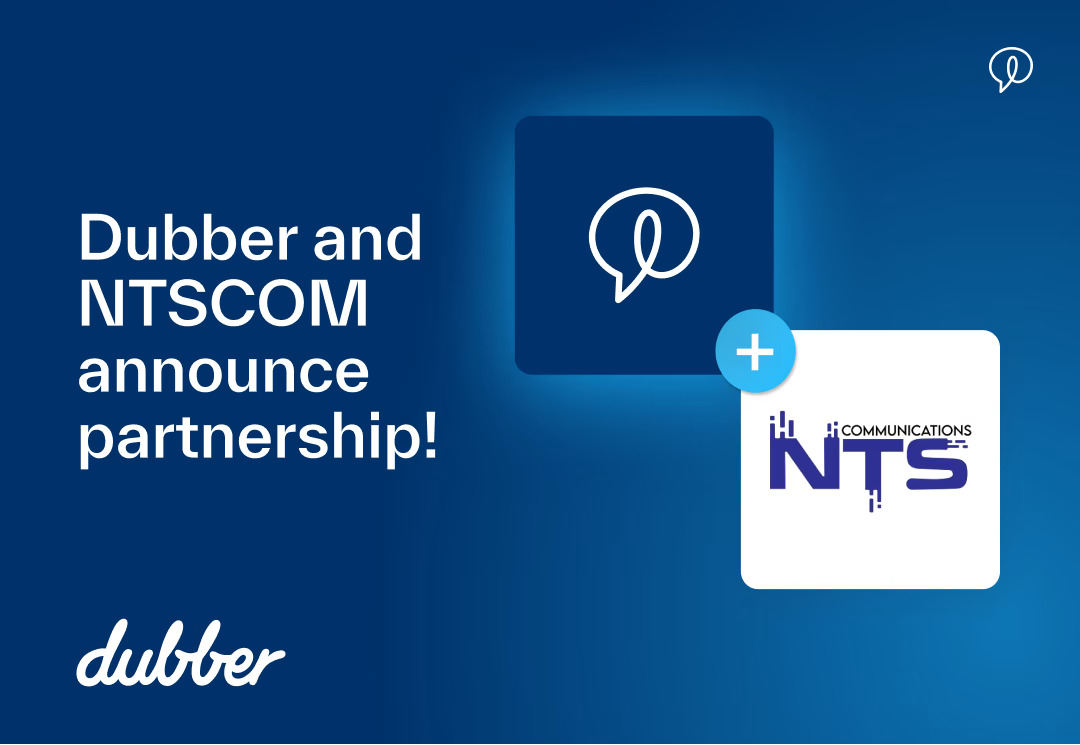
We are pleased to announce that we have formally partnered with NTSCOM who is launching Dubber solutions through iPILOT across the United States!
NTSCOM is a Microsoft Operator Connect partner with 20+ years of experience in the carrier industry. Together with NUWAVE’s iPILOT, NTSCOM automates both Direct Routing and Operator Connect capabilities while solving for carrier-hosted SBCs, on-premises SIP trunks, or bring-your-own SBCs, carriers, and operators. Headquartered in Las Vegas, Nevada, NTSCOM delivers services across the nation as well as internationally in Western Europe and Southeast Asia.
As an integrated global telecommunications solutions provider, NTSCOM provides a range of communications services for business telecommunication channels. Natively integrated into the iPILOT provisioning -portal, partnering with Dubber enables NTSCOM’s offerings to include seamless automation for unified recording and conversational intelligence, expanding the distribution of industry-leading solutions and enhancing customer experience and business intelligence.
Commenting on the announcement, Aaron Barnes, NTSCOM CEO said: “We are thrilled to partner with Dubber as their solutions are a natural fit into our current offerings and are immediately available from our network. We have already commenced deploying Dubber services into major Enterprise accounts such as TD SYNNEX and Konica Minolta.
While compliance recording and analytics are integral to furthering our customer experience, we’re equally excited about the opportunity to address the need for automated workflows and productivity based on Dubber insights. Adoption of the Dubber platform illustrates NTSCOM’s commitment to delivering the best-in-industry solutions to enhance our customer experiences.”
As NTSCOM serves customers across government, education, and healthcare sectors, complying with industry regulations and mandates is of the utmost importance. Dubber’s compliant conversational intelligence platform plays a crucial role in ensuring compliance mandates are met for both internal and external duty of care standards. Dubber’s software entitles NTSCOM’s customers to use conversational intelligence to reveal insights that are aligned with industry regulations and guidelines.
This strategic partnership mutually benefits both companies as NTSCOM brings forward solutions to improve customer experience, Dubber is deploying solutions and expanding its reach across the United States.
“Our service, integrated with iPILOT will be seamlessly provisioned with NTSCOM offerings and Microsoft Teams, enabling Dubber to be uniquely delivered as a service so that NTSCOM, its customers and partners can switch on and deliver value immediately.
NTSCOM is an important component of our service provider partnership strategy and we aim to become a key attribute to their success. By coming together we provide the key value differentiation customers are looking for and service providers require to continue meeting the needs of the quickly evolving data-shaped landscape. Everyone at Dubber and NTSCOM is very excited by this new partnership.” – Michael Abenhaim, Dubber SVP of Americas Sales.
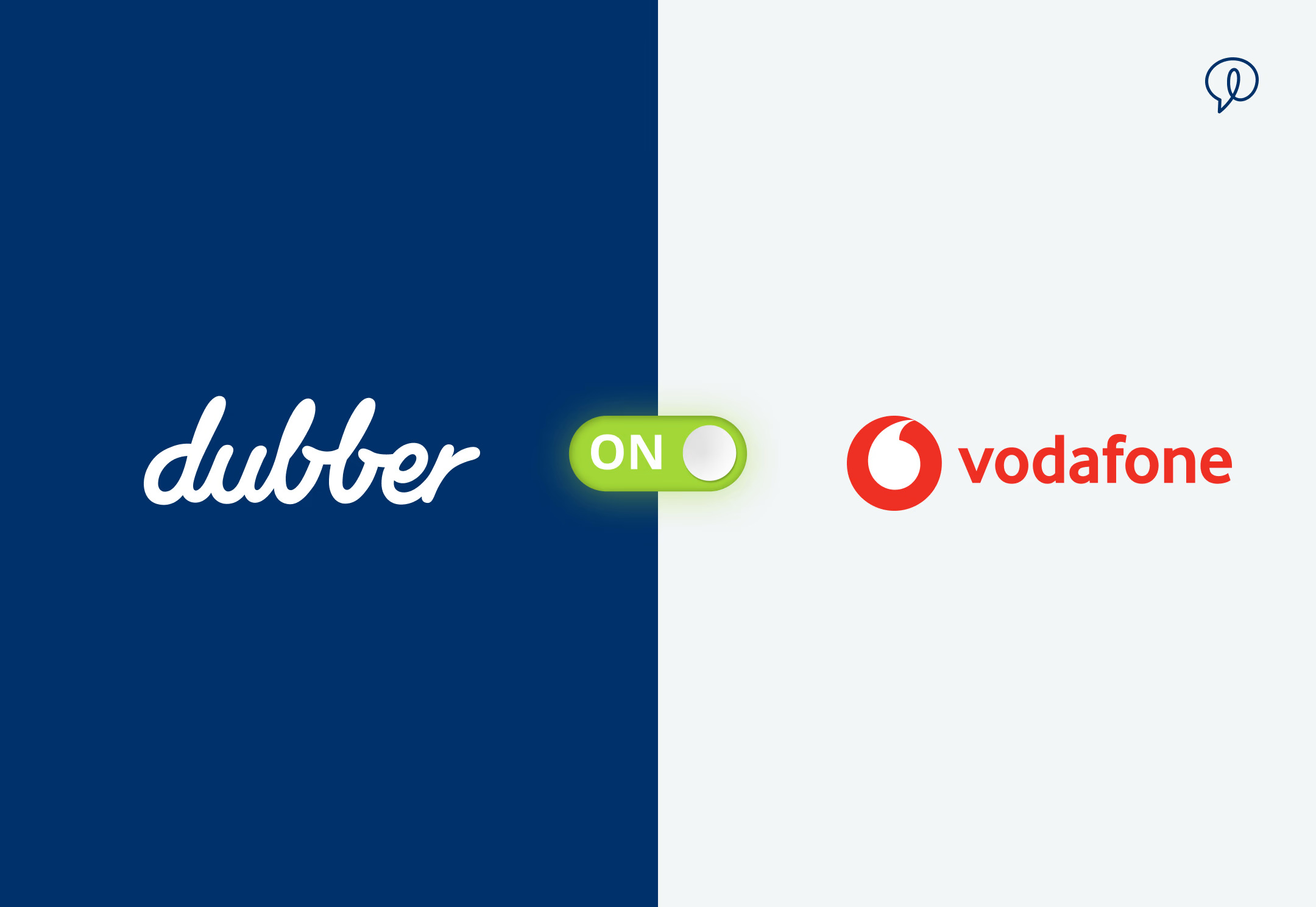
- Comprehensive agreement framework with Vodafone Group
- Dubber released on Vodafone mobile networks targeting business customers of Vodafone initially in the UK and Germany
- Transition of existing Mobile Recording subscribers to the Dubber Platform commenced
- All of Dubber’s existing Unified Recording feeds will be available to Vodafone business
customers (including Cisco Webex, Microsoft Teams and RingCentral)
Melbourne, Australia and LONDON – 1 December 2022 — Dubber Corporation Limited
(ASX: DUB), the leading conversational intelligence and unified recording platform for service providers and their customers globally, has reached an agreement with Vodafone Group Plc to offer recording and AI services directly from Vodafone mobile networks, targeting Vodafone business customers initially in the UK and Germany.
Vodafone will capitalise on Dubber’s platform and alignment to a Service Provider’s method to market, to enable Vodafone to seamlessly deliver recording and conversational AI capabilities across Mobile and Unified Communication services (including Cisco Webex, Microsoft Teams and RingCentral) across multiple European markets. A single view of conversations with end users across fixed and mobile networks will also deliver new personalised services and provide better customer experience.
Work has commenced to migrate Vodafone’s existing mobile recording customer base to an improved service on the Dubber platform and the companies will jointly explore new commercial opportunities to deliver additional Dubber services to Vodafone customers.
Barry McSorley, Head of Unified Communications and Platforms, Vodafone, said: “We are drawing on the strength of our geographical presence coupled with Dubber’s market-leading platform to help our business customers transform their interactions with end-users. Greater data insights and enhanced compliance across multiple markets with a common, advanced hosted recording service, enables our business customers to expand and improve customer trust and loyalty with their own customers.”
Steve McGovern, CEO, Dubber, said: “Vodafone is a very important relationship for Dubber and we are pleased to partner with them in Europe to support the needs of their business customers with unified recording and conversational AI directly from the Vodafone mobile network.”
“Dubber is about cost benefits, technology advantage and speed of provisioning and this will enable Vodafone to expand its existing recording subscriber base to a broader range of businesses. The calls across the Vodafone network contain an enormous amount of content, and deployment of the Dubber platform will enable an expansive range of differentiated products and services.”
“Dubber and Vodafone have developed a strong co-engineering relationship with cross-company teams working together to plan, design, and develop the next generation of recording supported by a shared vision for a fully automated and self-service cloud solution.”
“Our initiative with Vodafone will deliver accretive revenue for Dubber and a larger addressable market. We look forward to extending our relationship with Vodafone into the future with a platform that will evolve and deliver greater value into the Vodafone network.”
ENDS
About Dubber:
Dubber enables Service Providers to unlock the potential of the network – turning every conversation into an exponential source of value for differentiated innovation, retention, and revenue. Listed on the ASX, Dubber is the clear market leader in conversational intelligence and unified recording – embedded at the heart of over 175 service provider networks.
For more information, please visit Dubber on www.dubber.net
Global Investors & Media
Terry Alberstein
terry@navigatecommunication.com.au
+61 (0) 458 484 921
EMEA Media
Annabel Clementson
annabel@wearetfd.com
+44 (0)7951 786 435
For more information from Vodafone Group contact: Media Relations – GroupMedia@vodafone.com
About Vodafone:
Unique in its scale as the largest pan-European and African technology communications company, Vodafone transforms the way we live and work through its innovation, technology, connectivity, platforms, products and services.
Vodafone operates mobile and fixed networks in 21 countries, and partners with mobile networks in 48 more. As of 30 June 2022, we had over 300m mobile customers, more than 28m fixed broadband customers and 22m TV customers. Vodafone is a world leader in the Internet of Things (IoT), connecting around 160m devices and platforms.
We have revolutionised fintech in Africa through M-Pesa, which celebrates its 15th anniversary in 2022. It is the region’s largest fintech platform, providing access to financial services for more than 50m people in a secure, affordable and convenient way.
Our purpose is to connect for a better future by using technology to improve lives, digitalise critical sectors and enable inclusive and sustainable digital societies.
We are committed to reducing our environmental impact to reach net zero emissions across our full value chain by 2040, while helping our customers reduce their own carbon emissions by 350m tonnes by 2030. We are driving action to reduce device waste and achieve our target to reuse, resell or recycle 100% of our network waste.
We believe in the power of connectivity and digital services to improve society and economies, partnering with governments to digitalise healthcare, education and agriculture and create cleaner, safer cities. Our products and services support the digitalisation of businesses, particularly small and medium enterprises (SMEs).
Our inclusion for all strategy seeks to ensure no-one is left behind through access to connectivity, digital skills and creating relevant products and services such as access to education, healthcare and finance. We are also committed to developing a diverse and inclusive workforce that reflects the customers and societies we serve.
For more information, please visit www.vodafone.com, follow us on Twitter at @VodafoneGroup or connect with us on LinkedIn at www.linkedin.com/company/vodafone.
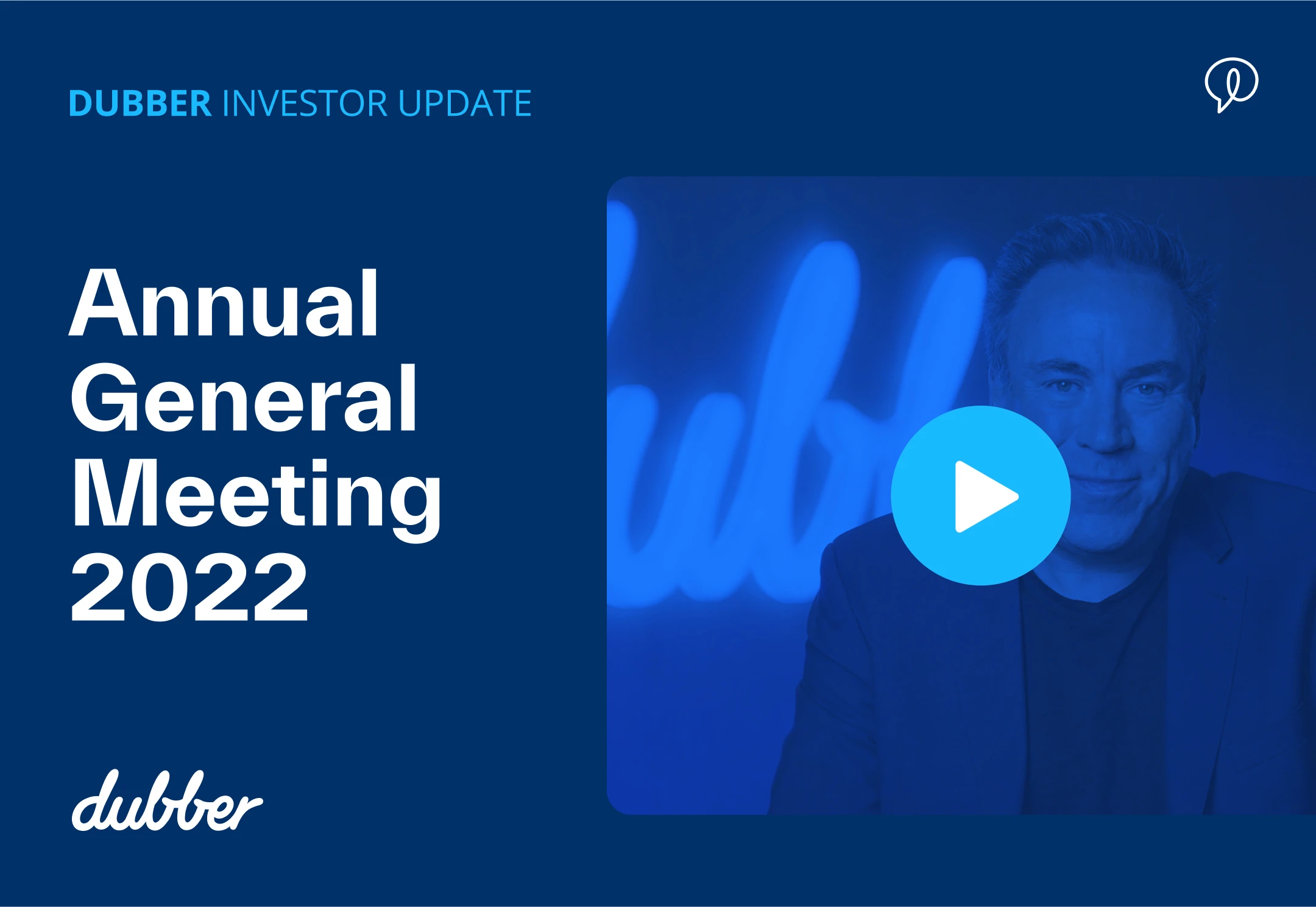
Today we had the opportunity to take Shareholders through Dubber’s strategy and why we are so excited about the opportunity ahead of us.
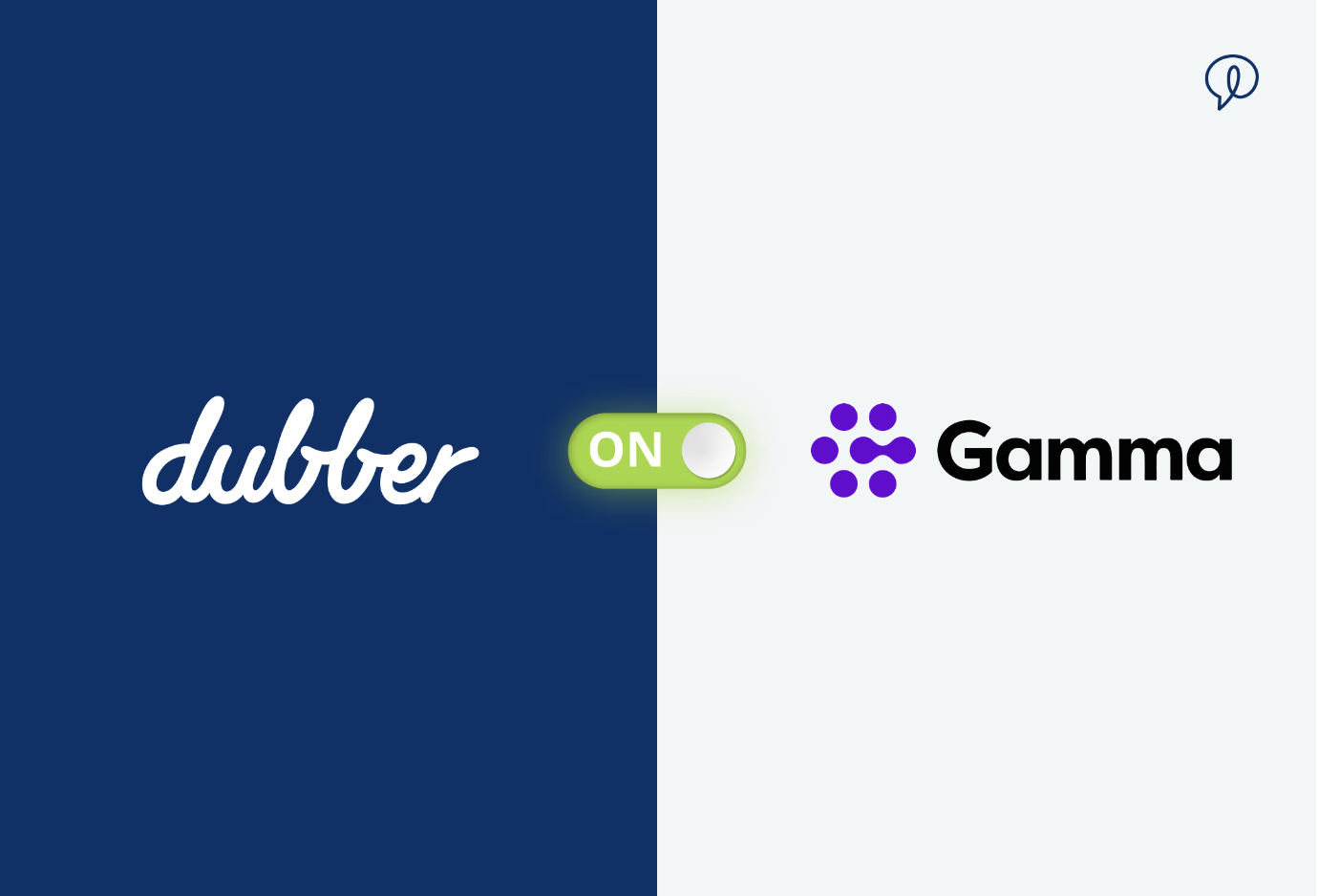
- Gamma launches Dubber intelligent call recording and Dubber AI, enabling partners and customers to unlock the value in voice
- Dubber is the exclusive vendor for MiFID II compliant call recording on Microsoft Teams via Gamma partners
- Available across Gamma’s Microsoft Teams voice enablement portfolio
- Dubber is a leading certified recording service for compliant call recording on Microsoft Teams
London, United Kingdom; Melbourne, Australia – 15 November 2022 — Dubber Corporation Limited (ASX:DUB), the leading conversational intelligence and unified recording platform for service providers and their customers globally, is pleased to announce it has been selected by Gamma Communications plc (“Gamma”). Gamma can now provide intelligent call recording as a service, applicable for general business and regulated compliance requirements, plus Dubber’s leading conversational AI on Microsoft Teams.
Gamma is one of the most significant telecommunications service providers in the United Kingdom. Their network of over 1,600 channel partners will now be able to sell Dubber across all of Gamma’s Microsoft Teams voice enablement portfolio. Gamma has been a Gold Partner with Microsoft for 15 years and is one of a small, select group of providers specifically picked by Microsoft to offer Operator Connect in the UK.
In November 2021, Dubber was one of the first solutions to achieve certification for compliant call recording on Microsoft Teams. Dubber’s technical ability has provided benefits to companies of any size to ensure voice conversations on Microsoft Teams are recorded and stored in a compliant manner.
Businesses with a regulated recording need can now enhance their activities by utilising the advanced Dubber platform, which unlocks the value in conversations with conversational intelligence, and real-time text and speech-based insights to improve information accuracy, productivity and streamlined communication.
Simon Broadbent, SVP of Sales, Dubber EMEA: “The Dubber team are proud and excited to partner with Gamma to bring intelligent conversational capture on Microsoft Teams recording to their extensive network of channel partners and loyal customer base.
The unique thing about Dubber is that it is delivered as a service enabling Gamma, its customers and its reseller network to switch on and deliver value immediately.
Gamma has been at the forefront of the unprecedented adoption of Unified Communications in the UK market in the last 15 years. This partnership presents a great opportunity to further conversational intelligence innovation for Microsoft Teams users going forward.”
Chris Wade, Chief Marketing and Product Officer, Gamma: “It’s widely reported that three-quarters of conversations taking place at work over collaboration tools such as Microsoft Teams will be recorded by 2025. That clearly shows that this capability is driving improvements in customer experience, training and compliance across voice and video.
We’ve teamed up with Dubber so our Channel Partners can offer this valuable service to their customers, enabling them to unlock the value in voice AI technologies through Gamma to capture critical voice data securely.”
About Dubber:
Dubber enables service providers to turn existing networks and services into an exponential source of value for differentiated innovation, retention, and revenue. Dubber is the clear market leader in conversational intelligence and unified recording – embedded at the heart of over 175 service provider networks and services and used daily by over 580,000 subscribers worldwide.
For more information, please visit Dubber at www.dubber.net
Global Investors & Media
Terry Alberstein
terry@navigatecommunication.com.au
+61 (0) 458 484 921
EMEA Media
Annabel Clementson
annabel@wearetfd.com
+44 (0)7951 786 435
About Gamma:
Gamma is a leading supplier of Unified Communications as a Service (UCaaS) in the UK, German, Spanish and Dutch business markets. It is AIM listed and employs 1650 people. With a range of UCaaS, Mobile and Connectivity services, Gamma provides robust and secure solutions that enable organisations to communicate, collaborate and offer a better customer experience.
Gamma’s largest market is in the UK where the company’s network-based services are supplied to SME, Public Sector and Enterprise markets through a network of 1000+ channel partners and its own direct sales and support capabilities. In 2021 Gamma acquired Mission Labs, a well-established UCaaS technology business which has built a reputation for creating technologically advanced solutions and delivering great service to its customers and partners. The acquisition has enabled Gamma to enhance and expand its cloud contact centre (CCaaS) technology as well as accelerate its digital channel strategy.
Gamma is expanding its UCaaS presence in Europe with a family of businesses focusing on digital automation, delivering Gamma-powered services to SME customers largely via a network of channel partners in Germany, Spain, and the Benelux region.
Contact
Paul Aitkenhead, 07791569612
paul.aitkenhead@gamma.co.uk
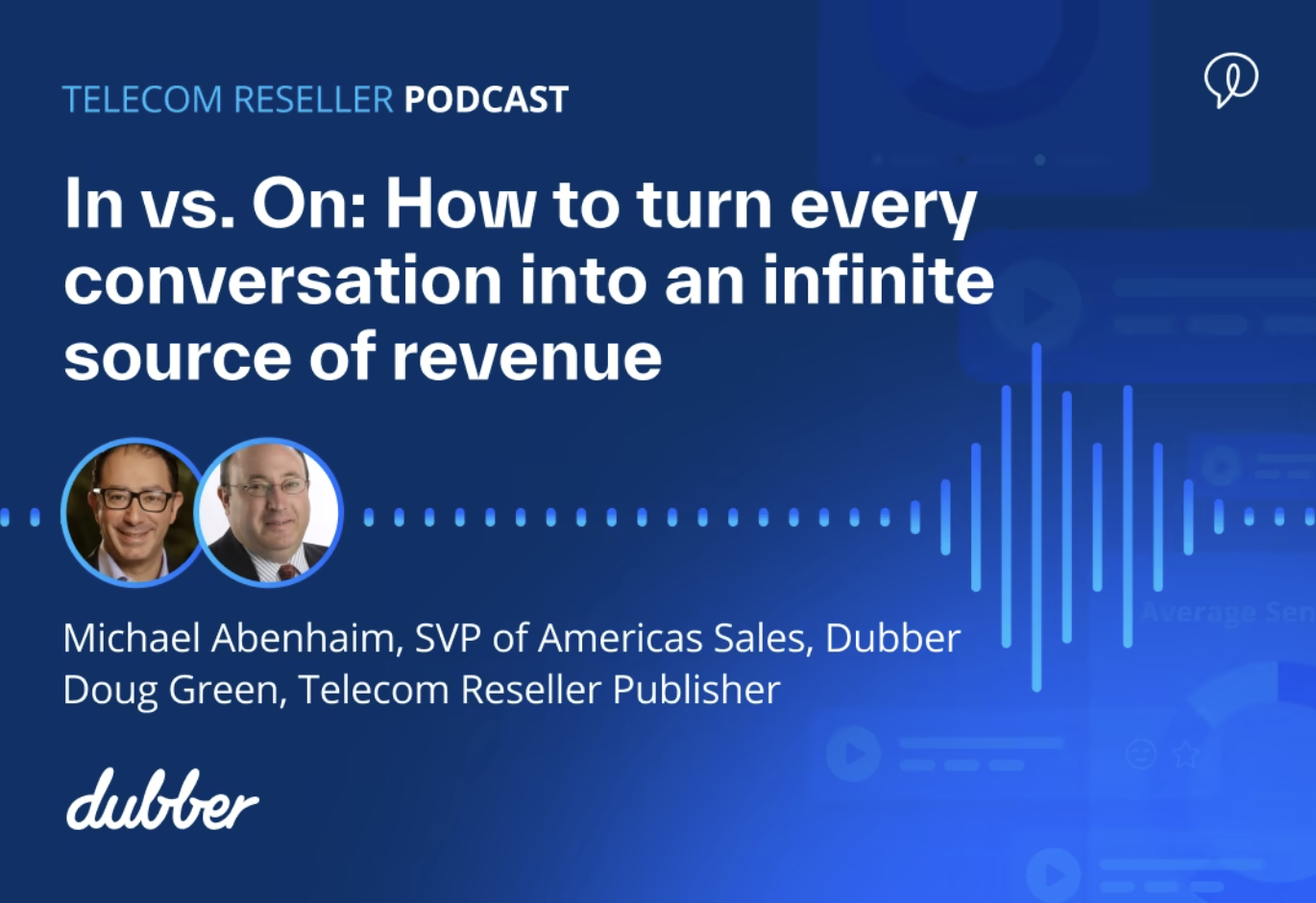
“Once you understand what isn’t working… the answer really becomes more clear,” says Michael Abenhaim, SVP of Americas Sales at Dubber.
Abenhaim describes a seismic challenge facing the service provider community and discusses a path forward. Native services and applications offered at a higher margin and lower cost, underpinned with 100% customer ownership will, according to Abenhaim, deliver the differentiation SPs and customers are looking for, but without deep partnering this solution is still difficult to realize. “By making conversational intelligence native on their network, service providers set the building blocks in place to deliver unique and valuable intelligence back to their customers in ways others are not or cannot,” Abenhaim adds.
In this podcast, Abenhaim opens the idea of conversational data as a place for providers to tap into, offering their customers an invaluable intelligence resource, and unlocking an underpenetrated revenue stream.
Dubber enables SPs to create infinite value by using technology to generate visibility within networks. Unlocking the value of the network starts IN the network.
Listen to the full podcast
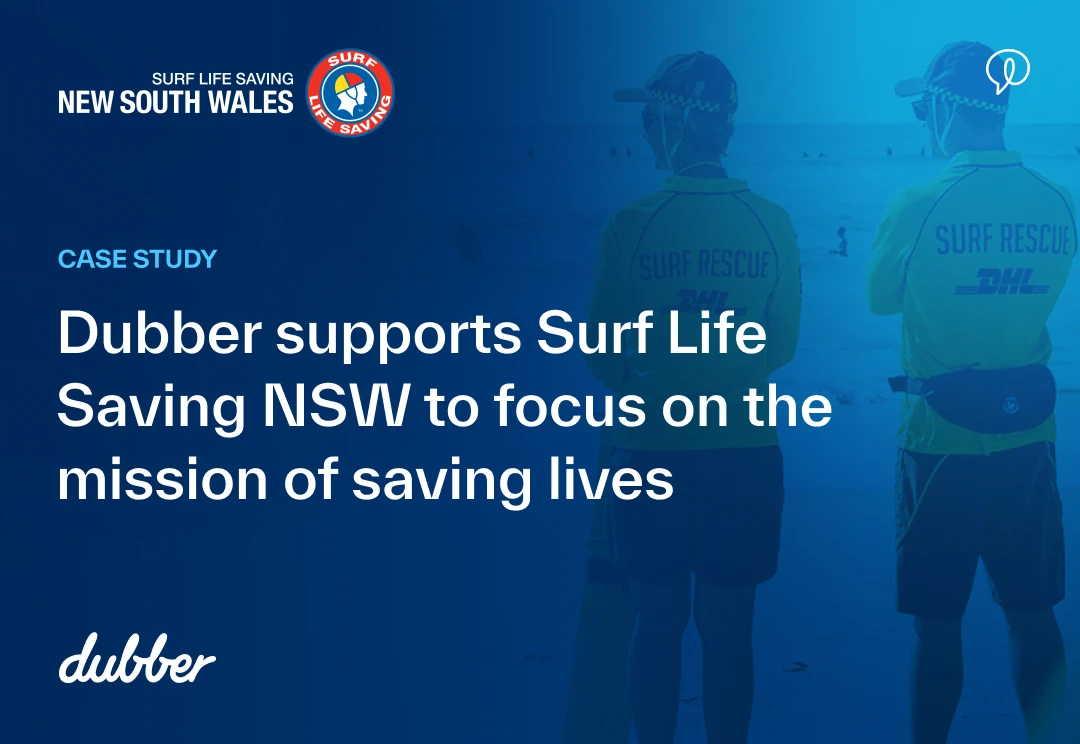
Surf Life Saving New South Wales (SLSNSW) uses Dubber call recording and voice AI to create records which may be needed if there is an investigation into the way it responded to a rescue request.
Chief Information Officer, Matthew Ingersole says SLSNSW frequently needs to provide evidence in coronial inquests and other official enquiries when there is a loss of life, insurance claim or reportable incident. He says: “Recording and transcribing all of the phone calls with Dubber is an important part of that”.
SLSNSW is an emergency service dedicated to saving people from drowning along the 2100 km New South Wales (NSW) coastline. While the organisation’s 79,000 members are a familiar presence on the states’ beaches all year around, its responsibility extends beyond to the entire NSW coastline. There are around 25,000 volunteer lifesavers at 129 local clubs and about 1000 professional lifeguards. SLSNSW co-ordinates all rescue activities from its State Operations Centre at Belrose in Northern Sydney.
Ingersole says that as well as evidence for inquests and investigations there are other situations where the organisation needs to provide evidence of the actions it takes. “We do all this through our information management systems, but we back up and reinforce this through call recording. We record all the calls that come into the operations centre as well as all the radio traffic, that way we get a complete picture of what happens”, he says.
Calls come into the centre from multiple locations. It could be a member of the public who spots someone in trouble and phones in, duty officers patrolling beaches might radio into the centre and the police have a direct line for emergencies.
He says Dubber is ideal for his organisation’s needs: “We like that there is a date and timestamp, so we know exactly what time a call came in and exactly what time we responded. This provides a chain of evidence which can be helpful if we ever need to show an investigation that we acted appropriately. It’s also useful for educating staff on how to handle calls.”
There is still a system for recording incidents, but Ingersole says the big advantage of Dubber for its operators is that they can get on with responding to the call, as the recording is automatic. In the past, the operations team would have needed to make manual notes at a critical time of allocating resources.
Every moment counts when calls come into the operations centre. The average time for a rescue is 10 to 15 minutes from when the call comes in and shaving seconds off the call response can save lives.
Ingersole says: “Where we can, we’d prefer to ditch the report writing and concentrate on getting someone into the water and performing a rescue. That’s the number one priority. Documenting the incident is very much the secondary priority.”
He says with the Dubber platform, an operator can go back after dealing with the call and replay it. “And now that we’ve added Dubber transcription they can copy the content of the entire call and paste that into the incident log as well. That’s a massive time saving for us and helps with accuracy.”
Away from reporting, SLSNSW uses Dubber call recordings to put together case studies for staff training. “We can put the telephone calls connected to an incident together with any radio messages in sequence and show new operators what the final report looked like. It means they get to see a real-world example. We find that it is powerful from a training perspective,” Ingersole says.
SLSNSW also uses Dubber’s AI-enabled sentiment analysis to get an overview of incoming calls. Ingersole says the organisation can see where operators may need extra coaching on the best way to handle incidents.
“Finding calls is easy, thanks to the user interface which simplifies searching and allows call tagging. This is a powerful feature for SLSNSW because at times staff need to find, tag and batch all the calls related to an incident,” he says.
Before moving to Dubber, SLSNSW used on-premise call recording. Ingersole says there was a problem with network updates breaking that system and it was unable to capture mobile phone calls. Moving to the cloud with Dubber, natively integrated into Telstra’s infrastructure solved both problems.
He says: “Through Dubber, Telstra Liberate and TIPT all working together we can record all calls including mobiles. We’re really happy with Dubber. The Dubber-Telstra partnership makes it so easy. We just pay a monthly fee, and it all just works. We don’t need to worry about hosting it ourselves.”
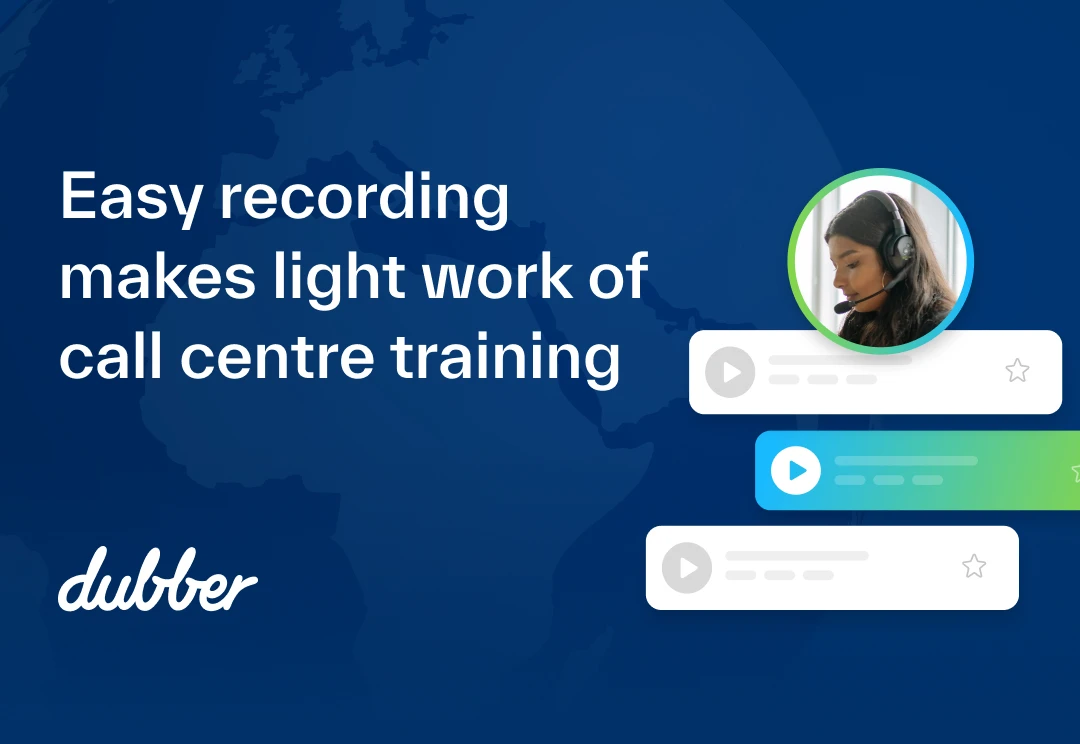
Skills trainers know learning by example is an effective and fast way to teach new ideas. One of its strengths is in helping learners understand how to avoid common mistakes.
We learn by example all our lives. As small children we work out general rules by observing good and bad examples in the world around us.
As adults, we sharpen skills or improve techniques by observing best practice.
That was easier when we all worked side-by-side. The Covid pandemic and dealing with remote workforces brings new challenges for trainers.
Learning by example
Now customer service team leaders can use learning by example to train call centre staff.
At Devonport City Council in Tasmania, Customer Services Coordinator Danielle Harvey asks team members to identify calls that she should listen to in order to provide coaching on providing better answers.
The Council uses Dubber’s cloud-based call recording software simplifies capturing calls for training use.
This approach works just as well when teams are dispersed. Because Dubber is cloud-based, it captures calls in a central location where they can be shared with every team member.
Teams or individuals can review earlier calls and identify points where conversations took a turn for the worse.
Likewise, they can review calls, listening and analysing successful conversations. Trainers can build a library of real world best-practice examples.
Identify knowledge gaps
By listening to team members’ calls, trainers can identify knowledge gaps where staff might need extra coaching.
Soma IT, a managed services provider, uses Dubber to review calls made by staff. COO Aaron Prout says his organisation makes sure team members have a full understanding of the products and services they sell. If not, extra training is given.
They can get a better understanding of how callers respond to scripts or set questions. It may be that these need tweaking to be better understood or to get better answers.
Leaders can identify if team members miss opportunities to upsell. This can involve playing calls back and then reminding team members: “this point in the call would be a good moment to mention X”.
The flip side of this is training team members on what they should not say.
Australia’s anti-hawking legislation means financial services businesses are not allowed to cross sell.
Avoid problems
Reviewing calls means trainers can identify where team members get close to crossing the line. They can coach them on how to avoid problems.
Dubber is ideal for recording calls for training use. It’s cloud based and works at the network level.
That means team leaders can cost-effectively capture all incoming voice communications. It doesn’t matter if they are traditional land-line, VoIP, mobile or via Zoom, Webex or Microsoft Teams, Dubber will get them all. Dubber can also capture calls when team members work from home.
Trainers can instantly replay calls recorded using Dubber anywhere they have a connection. There’s a web portal and a mobile app. Searching for specific calls is simple with a “google-like” search. Calls can be accessed by team member, customer or by using keywords.
Learn More
If you would like to discover how Dubber’s Unified Call Recording and Voice AI can help your call centre training, contact us today.
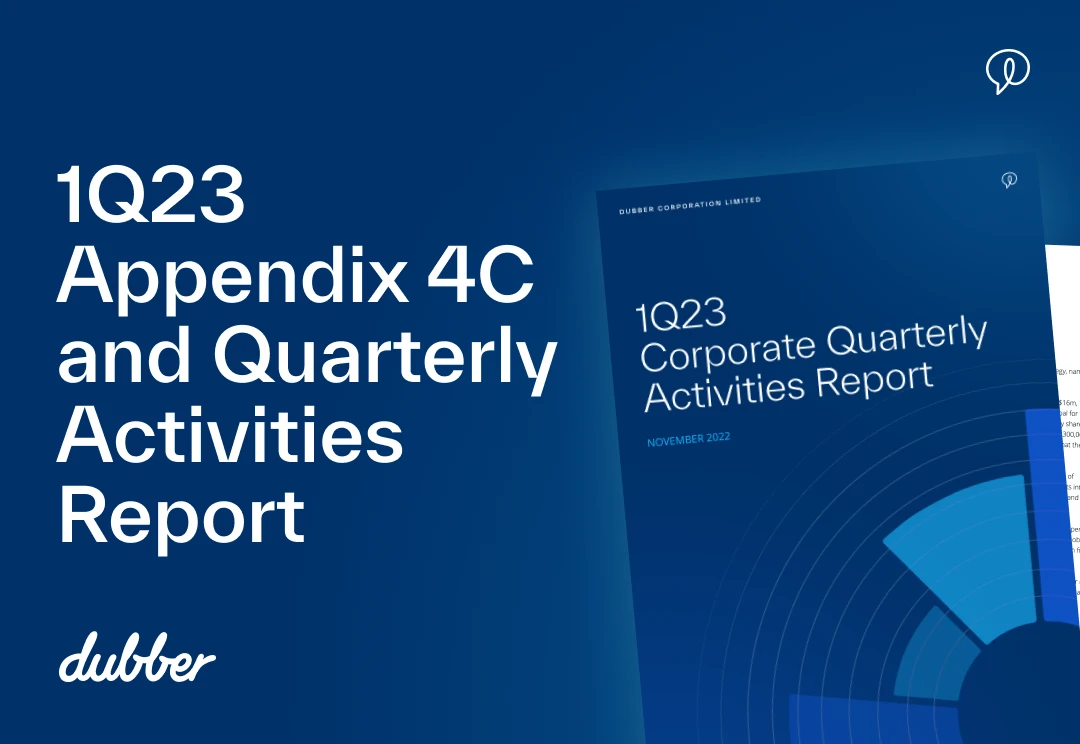
Melbourne, Australia: 25 October 2022 — Dubber Corporation Limited (ASX:DUB), the leading unified call recording and conversational intelligence platform to global telecommunication Service and Solution Providers, today released its 1Q FY23 Appendix 4C and Quarterly Activities to 30 September 2022.
1Q FY23 Commentary
- Operating cash receipts for the quarter were $9.5m (up 42% QoQ)
- Operating cash costs increased by $500k in the September quarter to $20m
- Net cash operating outflows were reduced by $2.5m compared with the June quarter.
- Cash on hand at 30 September was $73.8m. Dubber is fully funded to operate cash flow break even.
- Revenue was $6.6m (down 3% QoQ, up 10% YoY)
- Dubber extended its Service Provider footprint with commercial agreements with Ziggo (Vodafone Netherlands), 3 (UK) and NTS (USA)
- Dubber was accepted for the ‘IP Co-sell’ programme with Microsoft.
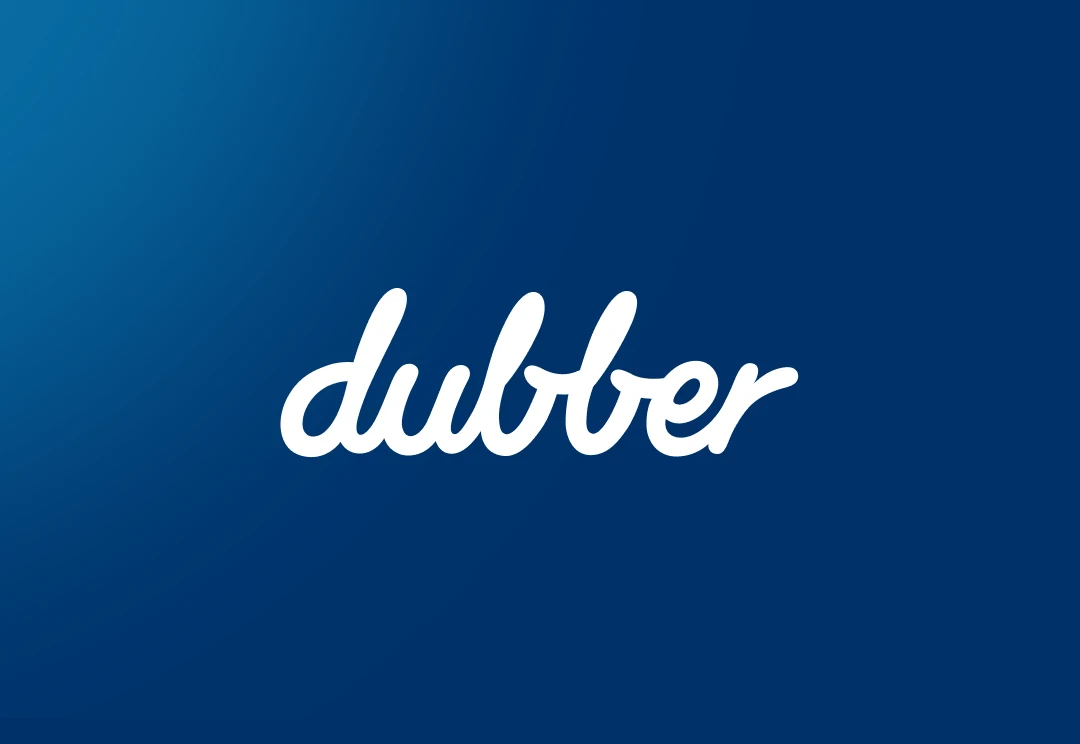
Dubber announces the 2022 Notice of Annual General Meeting of Shareholders will be held at 4:00pm (AEDT) on Monday, 21 November 2022. This year’s meeting is hybrid and will be held virtually via a web-based portal and physically at Punthill Little Burke Apartment Hotel, Lonsdale Room, 11-17 Cohen Place, Melbourne Vic. 3000.
The Explanatory Statement to the Notice of Meeting provides additional information on matters to be considered at the Meeting.
Shareholders who wish to attend the Meeting virtually must first register their attendance with the Company by no later than 4:00pm (AEDT) on 20 November 2022, the day prior to the day of the Meeting, by email to the Company Secretary, Ian Hobson at ian.hobson@dubber.net.
Please include the Shareholder’s name, address and HIN or SRN when registering with the Company Secretary. The Company will then email the details to participate in the virtual Meeting via zoom (a web-based meeting portal) to the Shareholder.
The Notice of Annual General Meeting, Explanatory Statement and Proxy Form should be read in their entirety. If Shareholders are in doubt as to how they should vote, they should seek advice from their independent professional advisers prior to voting.
Should Shareholders wish to discuss any matter please do contact the Company Secretary by telephone on +61 (0)8 9388 8290.
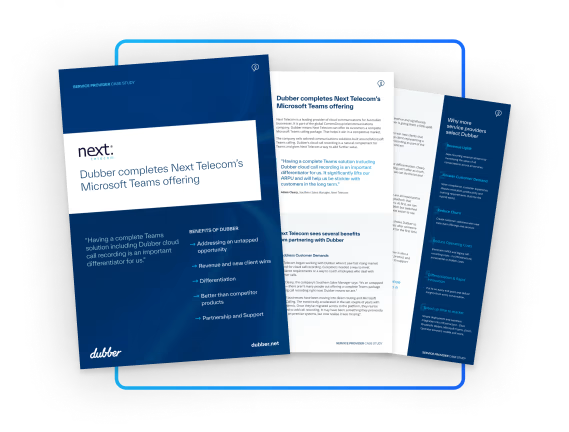
Adam Cleary says Dubber enables them to meet customer demand. The Southern Sales Manager for Next Telecom says: “Having Dubber means people come to us and buy our solution where they want call recording for Microsoft Teams Calling or need it as part of a bigger picture. It’s an untapped space – there aren’t many people out offering a complete Teams package right now; Dubber means we are.”
Next Telecom began working with Dubber when it saw fast rising market demand for cloud-based call recording. The Australia-based provider of wholesale telecommunications products and services sells to clients around the world. Today Next Telecom has operations in Australia and New Zealand and globally via parent company Comms Group.
“A lot of businesses have been moving into direct routing and Microsoft Teams Calling. The trend really accelerated in the last couple of years with the pandemic. Once they’ve migrated across to the platform, they realise they need to add call recording. It may have been something they previously did with on-premise systems, but now realised it was missing”, Cleary says.
He says Next Telecom needed a product to meet growing customer demand: “They need call recording for compliance or employee coaching.”
Dubber gives Next Telecom a way to generate revenue and boost ARPU. Cleary says “We’re seeing approximately a 50% revenue increase per user when we add Dubber to a standard Teams Calling plan”.
Learn how Dubber enables Next Telecom to drive new revenue streams, deliver differentiated solutions and address customer needs.
Also importantly, it means Next Telecom can offer an end-to-end Teams solution. He says: “There are a lot of people offering Teams, but without call recording, it is not complete. With Dubber call recording together with our contact centre solution and analytics solution we can cover 90 per cent of the needs of the market that we deal with.”
This gives Next Telecom an important point of differentiation. Cleary says most of the companies offering Teams Calling can’t offer as much: “We wanted to be able to tell clients that we can do the lot and address all their requirements.”
While Dubber does generate revenue for Next Telecom, it is equally powerful for the way it enables Cleary to win new clients that might otherwise look elsewhere. He says one large client representing a significant amount of business needed cloud call recording as part of the solution and offering Dubber helped him secure the contract.
Cleary says: “We needed a call recording platform that worked with Microsoft Teams and spoke to a few vendors. At first, we ran with a different platform before we were introduced to Dubber but switched quickly mainly because Dubber has a simpler interface, is easier to use and has a more competitive price.”
Now Cleary uses that simplicity as a selling point when he shows Dubber to his clients: “The first time I demoed Dubber was five minutes after someone gave me the login details to a demo portal. I was demoing it for the first time and had no dramas.”
The depth of partnership and local support provided by Dubber is also a huge advantage. It is a genuine partnership that goes beyond product and technical support – Next Telecom can call on the Dubber team to support RFPs as well as larger customer opportunities.
Managed services provider BizPro IT Services is a Next Telecom reseller. Director Jae Atkins says he uses Dubber in the business and uses the experience to help sell it to his small business customers.
He says: “As a managed service provider, we deal with people who are having computer issues and that means they are already frustrated when they call us. We had a few issues where clients were being difficult and getting aggressive. With Dubber call recording I can easily find and listen to a call and coach the staff member on how to handle the incident.”
Atkins says, “Now we’re taking that to our clients. Because Dubber has worked so well for us, we can share our experience to sell more.”
There is a massive migration to cloud-based products, particularly with the growth in hybrid and remote working. He says: “It’s become essential for small to medium businesses to move on-premise solutions into the cloud – and Dubber being a cloud solution is an important selling point.”
Atkins, like Cleary, is drawn to Dubber’s simplicity. He says being able to simplify technology for his customers is a large part of what BizPro does. “The responsibility is on us to make sure we are offering the best vendor solutions. Offering a complete solution gives us the best opportunity with clients. We try to simplify everything for our clients.”
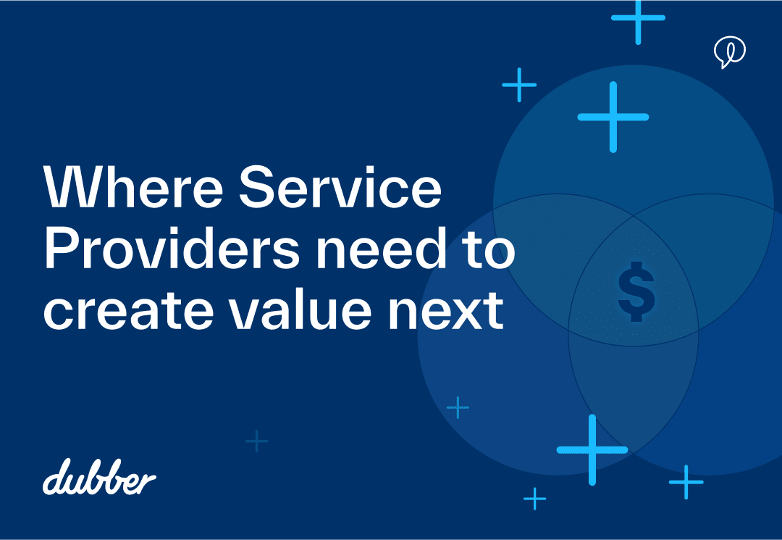
Conversations with leading service providers reveal common themes.
- How do we increase margins at a time when lower yield UC services are an increasing part of our overall sales?
- How do we deliver value from heavy infrastructure investments like 5G?
- How do we differentiate our services and create new sources of value?
Answering these questions often started with new offerings running over the top of the network. Could we offer streaming services? Could we sell applications? Could we bundle tangential services – like contact centre software?
The answers to these questions lead to a new set of issues. Costs and complexity of sales and marketing increased. Margin was small and elusive. Service and maintenance costs escalated as the Service Provider often became the first point of contact for issues related to third-party services. And, because often what was offered elsewhere, differentiation was weak.
The net result was more money was made by those running on the network, with value accruing to them and not the Service Provider – and the Service Provider incurred the costs of running the network.
“There is probably no other industry that has contributed more in the last 25 years to the welfare and productivity and expansion of economies as the telecom sector. … And you are right. We have not been able to capture a significant part of the new value chain.
… Today roughly 56 per cent of the capacity of the network—of the European networks in this case—is being used by only five over-the-top [OTT] players that pay nothing for the use of the network.”
José María Álvarez-Pallete López ,chairman and CEO of Telefónica S.A. and board chairman of GSMA, Mckinsey Journal, 2022
In the network is the answer.
Service Providers are increasingly scaling back non-core over-the-top service offerings, reducing cost and complexity and returning their focus to extracting the value from services in the network.
This shift in focus is increasingly centred on one of the primary reasons networks exist – conversations in all their forms: voice, video, and text. Rather than simply focusing on monetising the connection that makes the conversation possible, the question is how to turn those conversations into a source of value for the customer and Service Provider.
A new generation of network-embedded services unlocks the ability to turn conversations into data and render that data meaningful through AI, machine learning, and natural language processing.
Imagine a Cisco Webex meeting taking place and the actions automagically summarised in a branded widget exclusive to a Service Provider and their customers. Or a crucial moment in a conversation between a tradie and their client being transcribed and summarised in a text for the tradie to share with other workers on the job. How about a customer satisfaction app unique to a Service Provider summarising customer satisfaction ratings from that day’s service calls, keywords, and agent performance?
Before today, doing any of this required heavy-weight enterprise applications, complex integration and a myriad of increasingly complex services.
Today, this is possible thanks to a new generation of network native services, instantly provisioned and integrated with the Service Providers’ billing engines. The workloads and costs associated with legacy transcription services are replaced with new services concentrating on where the conversations’ value occurs. And critically, the resulting data becomes a customer magnet, reducing churn and creating a foundation on which any number of new innovative services can be created.
Unlocking the value of the network starts in the network. It is the first place to begin improving revenue, retention and innovation.
Service Provider Trends Outlook 2022.
Why Enterprises Are Looking to Switch Service Providers in 2022 – And What You Can Do to Stop It. Explore all the findings in Service Provider Trends Outlook 2022.
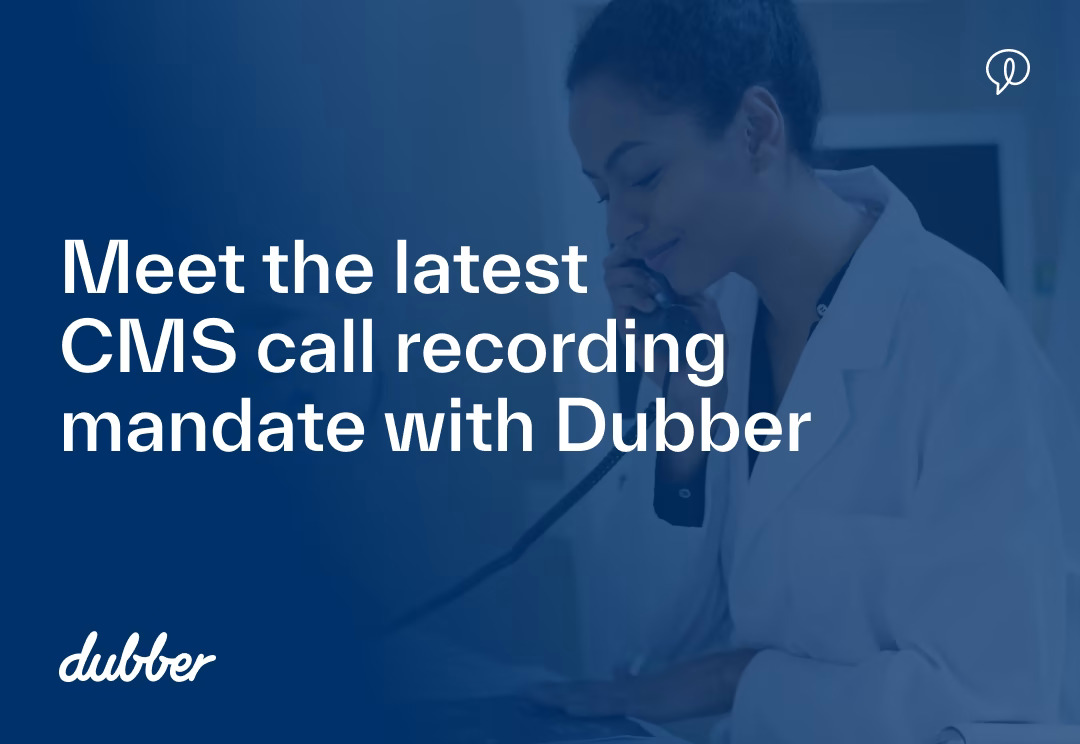
May of 2022, Medicare & Medicaid Services mandated specific compliance and recording changes that go into effect on October 1st 2022. During the enrollment period, Medicare & Medicaid Services will require all supplemental insurance sellers to record and retain all marketing and sales conversations for 10 years.
Under the Affordable Healthcare Act, the Centers for Medicare & Medicaid Services (CMS) ruling progresses its strategic vision of expanding access to affordable health care and improving health equity. The ruling will affect and support the 53 million Americans enrolled in Medicare health or drug plans and their healthcare providers.
“This spring, Centers for Medicare and Medicaid Services (CMS) announced Final Rule CMS-4192-F. Part of this ruling requires Third Party Marketing Organizations (TPMO) (TPMO definition includes organizations and individuals, including, independent agents and brokers) to record all sales and marketing interactions in their entirety, including plan enrollment, with beneficiaries that take place over the phone. This applies to all current and new Medicare Advantage and Medicaid beneficiaries. Agents are also required to maintain these recordings for 10 years. Please note that we’ll be requesting the required call recordings when we perform our sales audits.” – Premera Blue Cross
Among these changes, the ruling notes:
CMS is finalizing changes to marketing and communications requirements that will protect Medicare beneficiaries by ensuring they receive accurate and accessible information about Medicare coverage.
As healthcare agents and insurance brokers are third-party marketing organizations, to retain an accurate record of contact, they are mandated to record all calls with both clients and prospects where Medicare Advantage and Medicare Part D plans are discussed.
With Dubber’s conversational call recording and intelligence platform, healthcare professionals and the healthcare industry are able to meet these new requirements:
- Compliance and regulatory management
Compliantly record, securely store and encrypt all conversational data required by HIPAA, GDPR, PCI DSS, KYC, Dodd-Frank, MiFID II, and more in the Dubber Conversation Intelligence Cloud. - Critical data archiving and record management
Capture, preserve, recover and archive valuable conversational data. Empower comprehensive and continuous compliance control. Enact legal hold. - Rapid investigations and discoverability
Real-time search and reporting. Surface crucial conversations to support rapid investigation and effectively respond to audit requests quickly and accurately. - Integrate
Easily integrate metadata and insights using the Dubber API with compliance management platforms, CRM and big data sets.
With a compliant, cost-effective and secure conversation capture solution, available via a SaaS model, healthcare providers and agents can not only meet the new legal mandate, but they can reduce their risk, monitor processes and patient service, all while eliminating errors in communication. Dubber is deployed immediately to satisfy the voice-based record-keeping needs of operations and patients to meet both the external and internal duty of care standards.
As healthcare agents and insurance brokers are third-party marketing organizations, to retain an accurate record of contact, they are mandated to record all calls with both clients and prospects where Medicare Advantage and Medicare Part D plans are discussed.
With Dubber’s conversational call recording and intelligence platform, healthcare professionals and the healthcare industry are able to meet these new requirements:
- Compliance and regulatory management
Compliantly record, securely store and encrypt all conversational data required by HIPAA, GDPR, PCI DSS, KYC, Dodd-Frank, MiFID II, and more in the Dubber Conversation Intelligence Cloud. - Critical data archiving and record management
Capture, preserve, recover and archive valuable conversational data. Empower comprehensive and continuous compliance control. Enact legal hold. - Rapid investigations and discoverability
Real-time search and reporting. Surface crucial conversations to support rapid investigation and effectively respond to audit requests quickly and accurately. - Integrate
Easily integrate metadata and insights using the Dubber API with compliance management platforms, CRM and big data sets.
With a compliant, cost-effective and secure conversation capture solution, available via a SaaS model, healthcare providers and agents can not only meet the new legal mandate, but they can reduce their risk, monitor processes and patient service, all while eliminating errors in communication. Dubber is deployed immediately to satisfy the voice-based record-keeping needs of operations and patients to meet both the external and internal duty of care standards.
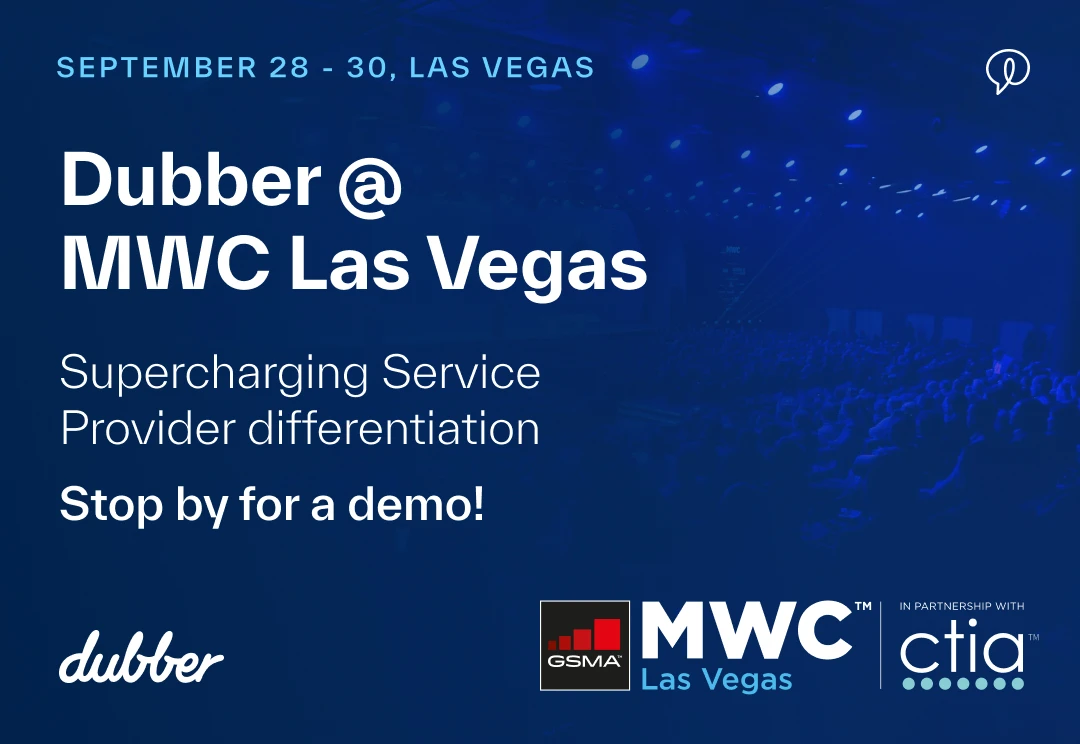
A common theme emerges in our conversations with service providers – how to drive differentiation from the massive investment in new technology such as 5G and Unified Communications while at the same time increasing revenue and EBITA performance.
The answer is in the network – in every conversation. That’s why we’re excited to be at Mobile World Congress, Las Vegas, showcasing how the Conversation Cloud and Dubber platform can deliver data-rich insights gathered across any platform on any device. Adding AI to every end-point unlocks revenue, retention and differentiation.
Gartner predicts that “By 2025, 75% of conversations at work will be recorded and analyzed, enabling the discovery of added organizational value or risk.”
This supports the demand for call recording and conversational intelligence we are experiencing today. Differentiation is critical to driving revenue and retention. Unlocking the insights hidden within conversational data exposes opportunities for improving CX, EX, productivity, training, expedited dispute resolution, and areas where revenue is lost.
We are unlocking this significant market opportunity with our more than 175 service provider partners.
See us at booth W2.910, where the Dubber team will demonstrate how the Dubber platform is modernizing over 175 service providers’ approaches to recording by unifying content and data from all end-points and enriching every conversation with AI-powered Conversational intelligence. Don’t miss out!
Come by and receive a demo! We’ll have all the usual conference fanfare – great prizes, a sentiment analysis game, and a great magic act that you will have to see to believe!
So if you are attending #MWC22, visit the Dubber team for a chat and a demo on how putting Dubber on your voice, video, and chat offerings can help deliver ROI on your 5G investments. You don’t want to miss this!
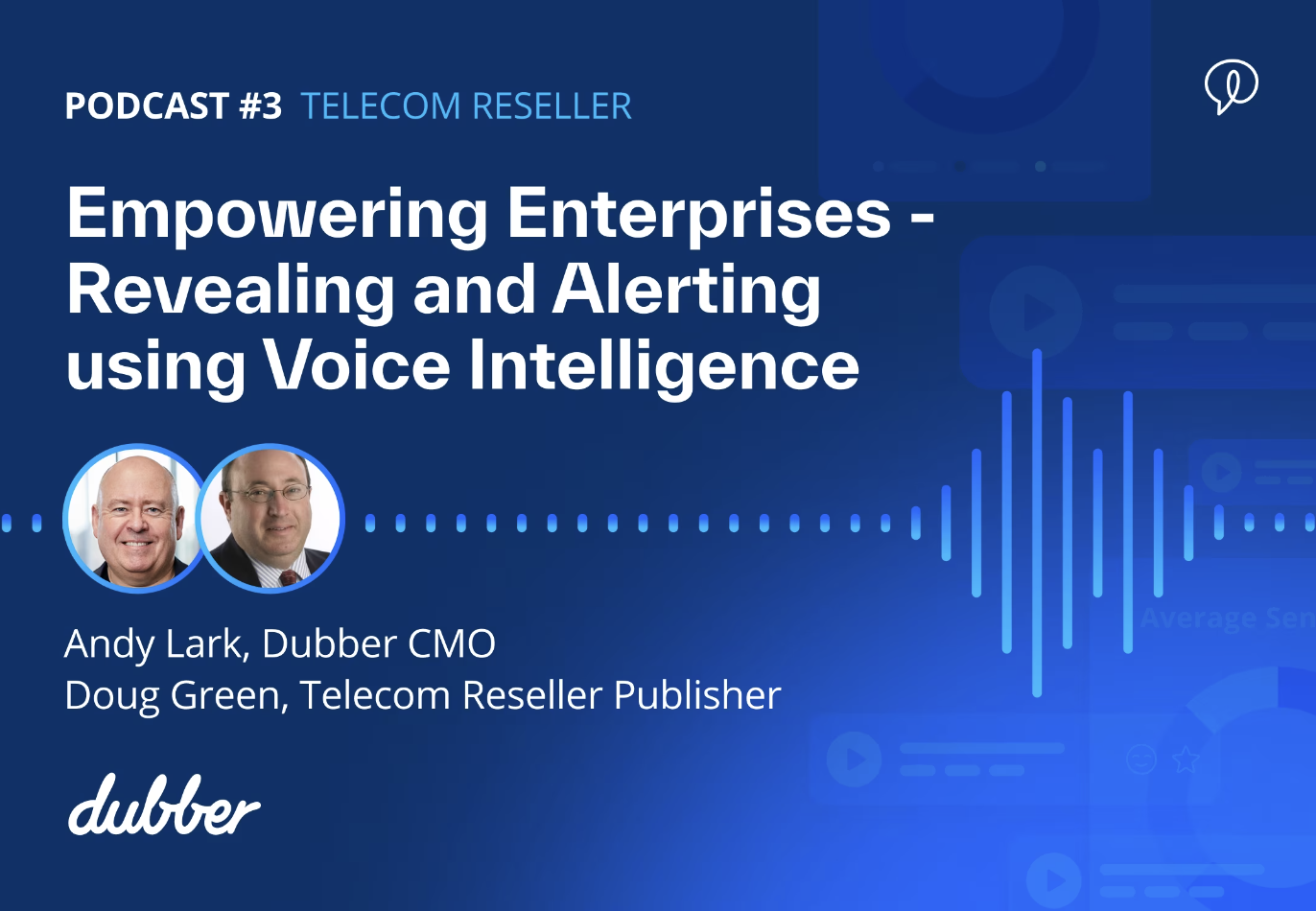
“We’re in a really significant wave of change,” says Andy Lark, CMO of Dubber. As ever, according to Lark, the economics of change quietly move the more visible technology of change. The need for companies to grow revenue and to improve revenue, are causing them to look for, and in some cases, to allow for, technology advancements that can enable them to achieve their goals.
In this podcast, Lark stresses the accessibility of those improvements and the centralist of the SP. Cloud communications, cloud computing, AI and ML, are delivering technologies that were once available only to the world’s largest technology companies to now be available to the local veterinarian.
“What if there was no gap,” speculates Lark about the way that sales teams often ignore sales tools such as CRMs. Events, ideas, and comments are literally lost, and a valuable, well-intentioned sales process is undermined.
Now, according to Lark, there’s the possibility of recording and capturing events, ideas, and comments in a way that really works with the personas of the people involved. SPs looking to monetize opportunities, need to take a close look at these possibilities for their customers. Lark tells us that productivity improvements can be sold but it must be tangible. Being able to give back a customer the lost time he now dedicates to making meeting notes is an example of this sort of offering real world gains.
Listen to the full podcast

Discover how you can record calls, monitor breaches and store conversations in the cloud – all while being compliant. Download the Dubber call recording compliance checklist now.
In a world of Zoom and Microsoft Teams calls, it’s essential to stay on top of call recording compliance. Legacy, location specific call recording systems are in the past. The world has adapted to a new way of working, but the compliance rules and regulations remain the same.
Download our call recording compliance checklist to:
- Learn what unified call recording is and why it’s essential
- Meet regulations like AML/CTF, RG271, Hayne Royal Commission bills, HIPAA, GDPR, PCI DSS, KYC, Dodd-Frank, MiFID II, and more
- See how Dubber AI can proactively mitigate fraud and compliance risks
- Learn how to achieve continuous compliance – whether your employees are texting, calling or messaging
- Understand how storing your call recordings in the cloud can make accessing recordings easier and prepares you for legal hold requests
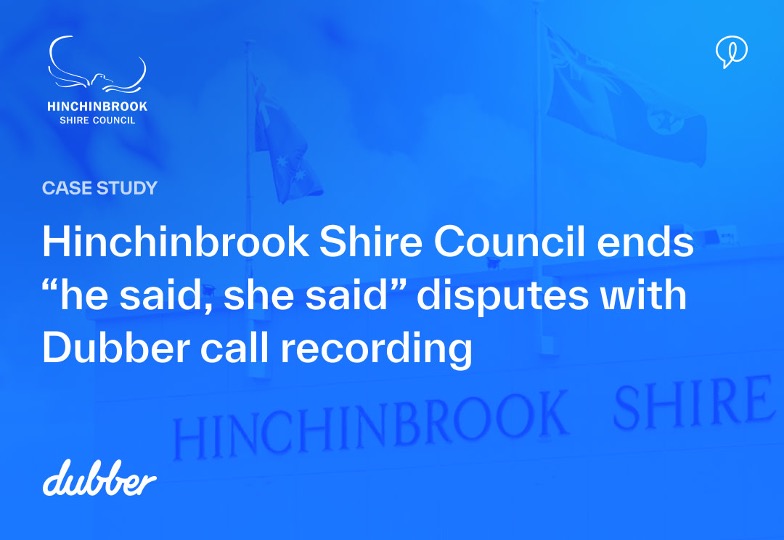
Many of the people who deal with Hinchinbrook Shire Council are not comfortable with connecting online. “That means they are more likely to use their phones to contact the council than go through online channels”, says Emma Prior, the council’s administration services team leader. **
“We use Dubber Call Recording for our main customer service centre. Our rates team and the regulatory compliance team also all have their phones recorded. We use the recording to deal with contentious issues – we get a lot of ‘he said, she said’ with our customers. We use the recordings to back us up.”
She says the move to call recording came from when the council would do rates debt collection.
“Part of our process is to place reminder calls to home owners. But people would deny they were called or claim that they had missed the call and there wasn’t a message.
“Now we can say: hang on, we have this recording to show that we did speak to you or leave a message on a particular date. That was the driver for getting recordings in the first place, from there we have gone on to use it in other areas.”
Prior’s team deals with a variety of calls. “Rates are the main ones, then there are roads, animals and cemetery enquiries. Hinchinbrook also handles food licensing. We get all sorts of things, we field things that aren’t even council matters.”
Information services manager Steven Veltmeyer says there are 20 Dubber Cloud Call Recording licences at the council.
He says; “Until now we have operated as separate divisions, but we are in the process of centralising all incoming calls to go through our main customer service centre. Now that we are rolling out Microsoft Teams, it will be easier to keep control of these calls”.
Hinchinbrook Shire Council was the first council in Queensland to roll-out Microsoft Teams as its sole solution and the first in the state to use Dubber Cloud Call Recording on Teams.
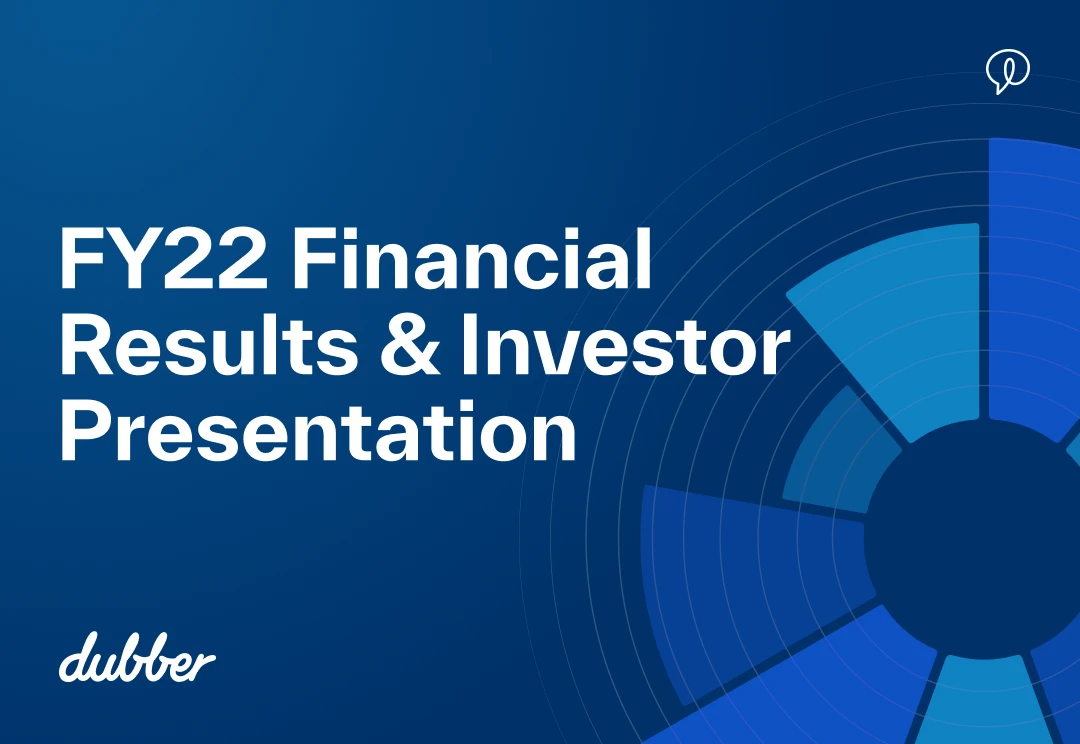
Dubber delivered significant revenue growth and increases across all key metrics in the 2022 financial year (FY22) reflecting demand from service providers for new sources of value. Dubber’s core strategy, to create value for services providers through unified recording and conversational AI as a core network service, adds incremental revenue, retention and differentiation based on meeting the needs of every user of business communications services globally.
FY22 Performance Highlights & Key Metrics (pcp)
- Substantial organic growth in all core business indicators
- Capital raise of $110m at $2.95 per share in July 2021; business objectives fully funded
- Completed integration of Notiv and Speik acquisitions – expanding commercial opportunities
- Investment in the AI and NLP capability on the Dubber platform to meet customer demand
- Extended relationships with service providers; expansion of Foundation Partner program
- Expanded global footprint; key executive appointments in technology, product and sales capability
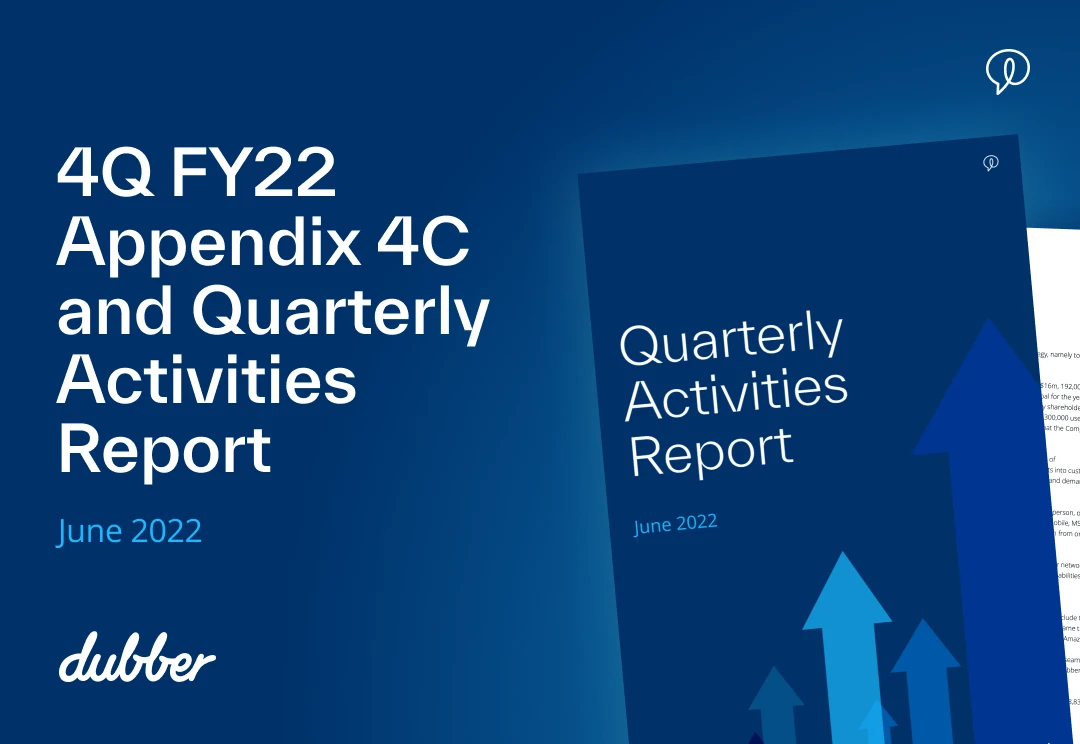
28 July 2022 Melbourne, Australia: Dubber Corporation Limited (ASX:DUB) (‘Dubber’ or ‘the Company’), the leading unified call recording and voice intelligence platform to telecommunication service providers globally, today reports its 4Q FY22 Appendix 4C and Quarterly Activities to 30 June 2022.
4Q FY22 Highlights
- Annualised Recurring Revenue (ARR) increased by $5m QoQ to $59m (+51% pcp)
- Operating Revenue increased to $10.3m1, up 12% QoQ (+41% pcp)
- Total annual revenue increased to $36m1, up 75% on the previous financial year
- Cash receipts for the year were $29.9m, up 48% on the previous financial year
- Gross Margin on current revenues exceeded 70%
- Dubber subscribers exceed 580,000 (+38% pcp)
- Cash on hand at 30 June 2022 was $84.3m
- Dubber is fully funded and continues to invest in contracted and future growth with a focus on winning new service providers and expanding organic growth of users via the Dubber platform
- Appointments: Sarah Diamond (to be appointed) as Independent Non-Executive Director; Michael Abenhaim, SVP, Americas
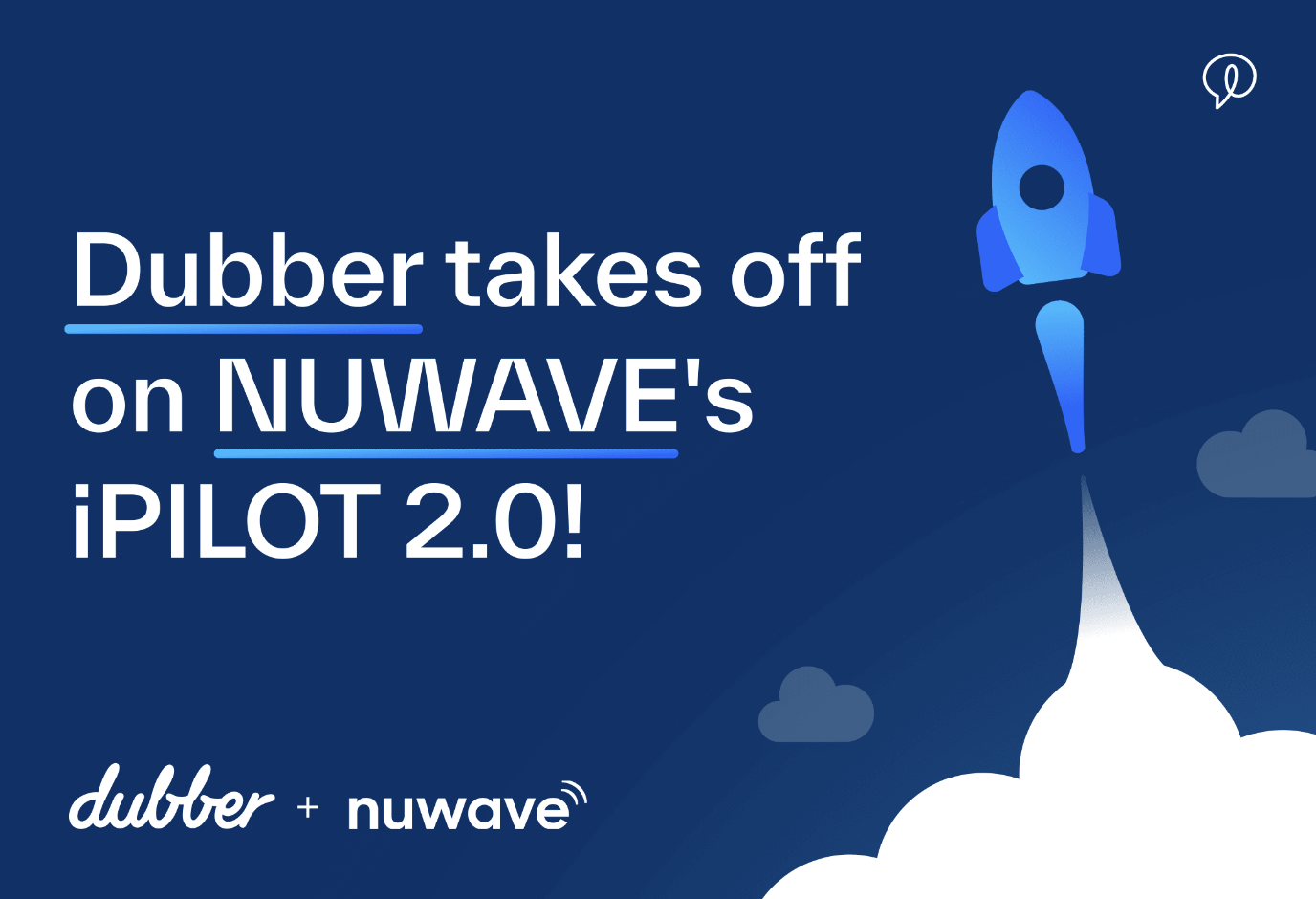
We are thrilled to announce that NUWAVE is now a Dubber Foundation Partner – and as of August 1st, 2022, we are taking off on NUWAVE iPILOT 2.0!
NUWAVE has 20+ years of delivering first-class communications services to customers worldwide and provides an intuitive, all-in-one solution for Microsoft Teams Telephony and Voice Service.
As one of the only global certified value-added resellers (VARs) in Microsoft’s Operator Connect Accelerator Program, NUWAVE has developed a unique provisioning and lifecycle management system for Microsoft voice users called iPILOT. The services suite allows service providers and enterprises to quickly and easily deploy Microsoft Teams Voice services including rapid migration, provisioning, capacity management, support, integration, and analytics.
Microsoft Teams has more than 270 million monthly active users, and NUWAVE is one of the fastest-growing providers of Microsoft voice services in North America. Steve McGovern, Dubber’s CEO, sums it up perfectly: “NUWAVE is an outstanding partner that has ‘cracked the code’ with Microsoft Teams Voice services.”
What this partnership means for you
As a Dubber Foundation Partner, Dubber Unified Conversational Recording (UCR) and voice data services are now integrated into iPILOT 2.0 and available to all NUWAVE clients as an entry-level solution at no cost. Now NUWAVE customers can easily harness the power of Dubber to unlock valuable information and insights from conversations across voice and video, all without the need for expensive hardware.
“We are excited to be partnering with Dubber. Dubber’s unique scalability fits perfectly with our view of what cloud voice users, enterprises and service providers are demanding. By integrating Dubber into iPILOT, we’re able to build on our iPILOT platform and provide service providers with extremely valuable, margin enhancing services that in return will help their customers extract even more value from their voice and video calls. “
–Mark Bunnell, NUWAVE COO
Moving forward, NUWAVE and its partners will work with Dubber to introduce customers to richer and more comprehensive conversational recording and AI solutions. This will make it possible for customers to address a broad range of business needs by unlocking valuable information and insights from conversations across their voice and video calls.
So what are you waiting for? Turn on Dubber on iPILOT 2.0 today!
Check out the full NUWAVE partner announcement here.
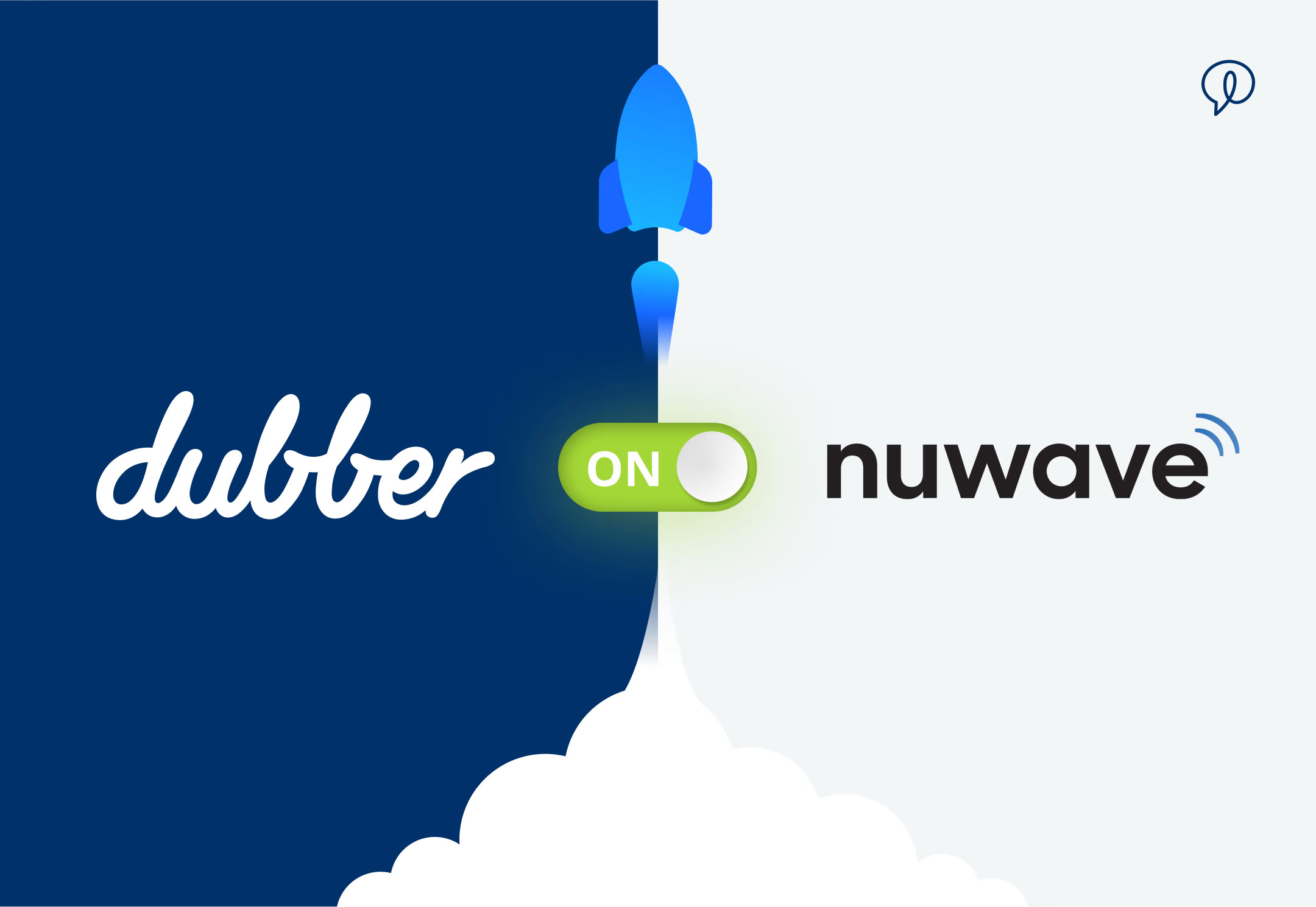
Melbourne, Australia, London, UK, Dallas, USA – 26 July 2022 — Dubber Corporation Limited (ASX: DUB) (Dubber) announced that it has signed a Foundation Partner agreement with Nuwave Communications, Inc. (NUWAVE). NUWAVE, based in Las Vegas, Nevada, is one of the fastest growing providers of Microsoft voice services in North America and a key player in the Microsoft Operator Connect calling program.
Dubber Unified Conversational Recording (UCR) and voice data services are now integrated into iPILOT and available to all NUWAVE clients from August 1.
Microsoft Teams has more than 270 million monthly active users, making it the world’s fastest growing and most popular business communication suite. NUWAVE is a global communications and cloud platform as a service provider with a focus on simplification, automation, and innovation. They continue to provide many industry-first solutions which facilitate customer cloud communication adoption.
Steve McGovern, Dubber CEO: “NUWAVE is an outstanding partner that has ‘cracked the code’ with Microsoft Teams Voice services. They attack and remove complexity at every level, making it simple and easy for service providers and enterprises through iPILOT to quickly get the most out of their Microsoft Teams environments. They are an ideal partner for Dubber as we both work to enhance customer value and revenue for service providers in their Teams deployments.”
“We are seeing continued momentum for our Foundation Partner model in which Dubber’s unified conversational recording platform is embedded as standard, providing immediate and accretive revenue to both ourselves and our partners.”
Mark Bunnell, NUWAVE COO: “We are excited to be partnering with Dubber. Dubber’s unique scalability fits perfectly with our view of what cloud voice users, enterprises and service providers are demanding. By integrating Dubber into iPILOT, we’re able to build on our iPILOT platform and provide service providers with extremely valuable, margin enhancing services that in return will help their customers extract even more value from their voice and video calls.”
As a Foundation Partner, NUWAVE will provide partners and customers with the option to instantly provision access via iPILOT to Dubber’s industry-leading conversational recording capabilities as an entry level solution at no cost to NUWAVE customers and partners.
NUWAVE and its partners can then choose to work with Dubber to introduce customers to richer and more comprehensive conversational recording and AI solutions to address a broad range of business needs by unlocking valuable information and insights from conversations across their voice and video calls.
Dubber supports differentiation and revenue opportunities for service providers that continue to scale their voice services to enterprise, SME and government customers on Microsoft Teams. Dubber’s Unified Recording and Conversational Data and AI services enable compliance, training, customer service, dispute resolution and remote workforce enablement without the requirement for hardware or capital expenditure.
As a unique platform provider and carrier in Microsoft’s Operator Connect Accelerator Program, NUWAVE has developed a powerful provisioning and “lifecycle” management cloud based platform for Microsoft voice users called iPILOT. The iPILOT platform allows carriers, cloud service providers and enterprise organizations to quickly and easily deploy Microsoft Teams Voice services including rapid migration, provisioning, capacity management, support, integration and analytics. It automates for both Direct Routing and Operator Connect capabilities while also providing support for carrier hosted SBCs (session border controllers), on-premises SIP trunks, and “bring your own Network” for carriers and operators.
About NUWAVE:
NUWAVE is a global communications and cloud platform as a service provider with a focus on simplification and innovation which continues to provide many industry-first solutions which facilitate customer cloud communication adoption. NUWAVE’s iPILOT platform enables automation, provisioning, and analytics for cloud communications, and helps to improve upon the UC voice management experience. NUWAVE’s iPILOT™ and SYNTHESIS™ platforms together can provide Carriers, CSPs or SIs with a turnkey, globally scalable solution to offer an industry leading Cloud Phone BYOC program for their partners and customers. To learn more about iPILOT™, SYNTHESIS™ and NUWAVE, please visit www.NUWAVE.com or www.iPilot.io.
About Dubber:
Dubber enables service providers to unlock the potential of the network – turning every conversation into an exponential source of value for differentiated innovation, retention, and revenue. Listed on the ASX, Dubber is the clear market leader in conversational intelligence and unified conversational recording – embedded at the heart of over 170 service provider networks and services and used daily by over 500,000 subscribers worldwide.
For more information, please contact:
Investors:
Simon Hinsley
simon.hinsley@dubber.net
+61 (0) 401 809 653
Media & Investors
Tanya Thomas
tanya.thomas@dubber.net
+61 (0) 474 470 405
USA Media
Lauren McNamara
lauren@guyergroup.com
+1 914.610.0221
EMEA Media
Annabel Clementson
annabel@wearetfd.com
+44 7951 786435
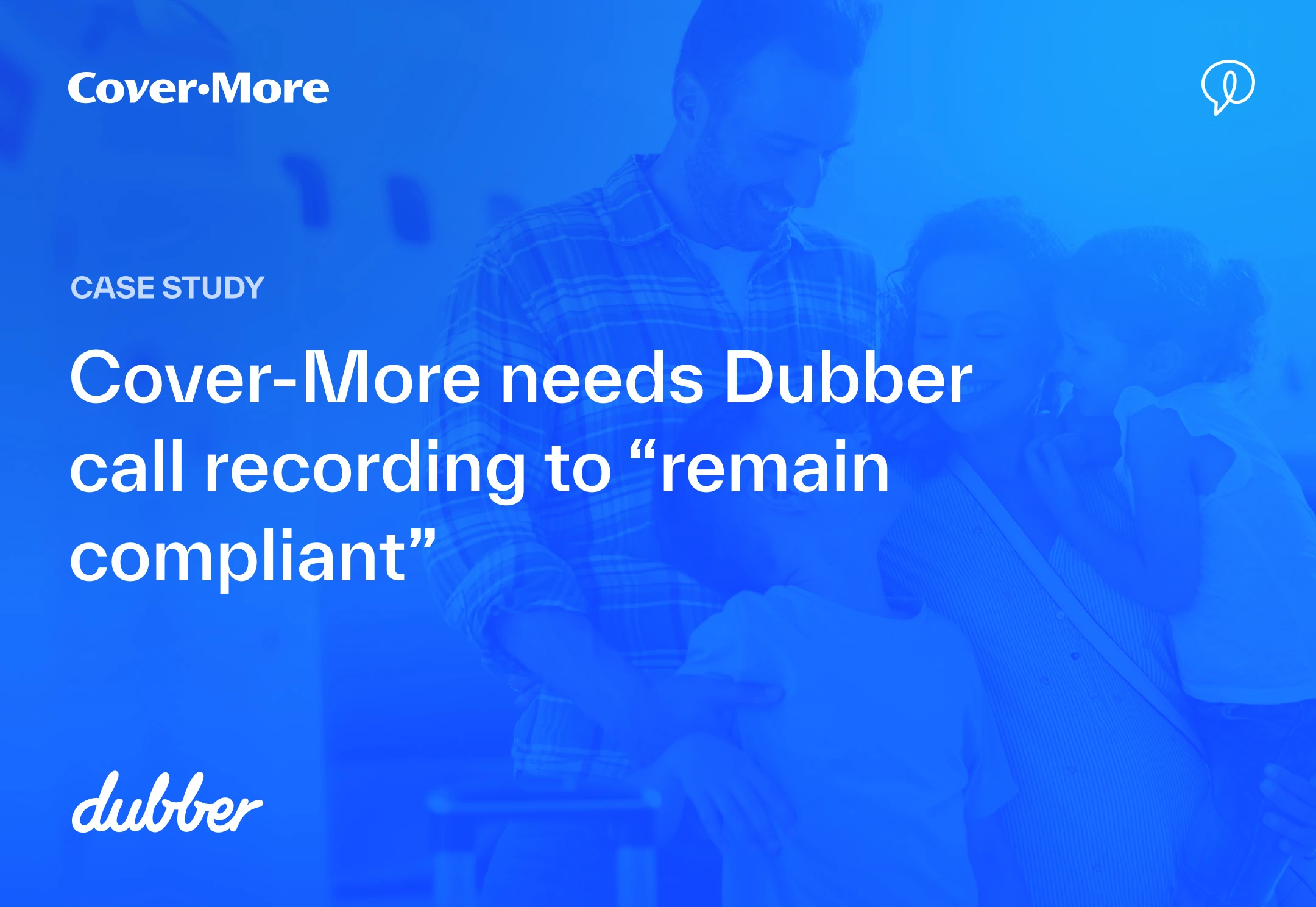
Claims specialists working for global travel insurance assistance provider Cover-More Group, in Australia, use Dubber call recording for auditing, compliance and legal purposes.
Cover-More provides medical and risk management assistance to people travelling for business and pleasure. It has offices in 15 countries and is part of the Zurich Insurance Group. The business deals with millions of customers every year.
Peter Valdes, who leads Cover-More’s global telephony and unified communications team, says Dubber call recording is available on demand to every member of staff. The company uses it to record all non-contact centre calls across the business. The main user is the Claims Team: people working in that team have it switched on permanently.
He says Cover-More had previously used on-premise-based call recording but when the business moved to Cisco Webex it wanted to give the Claims Team its own call recording system. Kytec, Cover-More’s integration partner, recommended Dubber because of its ability to integrate smoothly with Webex.
While the Claims Team is based in Brisbane, having call recording in the cloud means team members could work from home or from the Sydney office.
“The Claims Team records all calls,” Peter says. “This protects the customer as well as ourselves. That way any information we get over the phone can be relied upon if there is a dispute or if incorrect information is provided.”
“The team leaders use call recording to listen to any call that a staff member flags as concerning or suspicious. If we deny a claim because of inconsistent statements, we may need to rely on the recording as evidence of this if the customer disputes our decision.
“We also provide transcripts for any call when it is requested.”
Cover-More is a complex business, Peter says.
“We have two main business units: travel insurance and medical assistance. Thousands of calls come into our contact centre each day.”
The details of all the customer calls are input to Cover-More’s CRM system.
Peter says he uses Dubber himself to record calls on his work phone.
“I think it’s great. The portal is simple to use. Finding calls is straightforward; you look for the time, date and who picked up the call, then hit play. You can tag it for later or download it.”
Longer term Peter plans to look at integrating Dubber with other systems and at ways of making the information captured in Claims Team calls available to other business units.
Want to learn more?
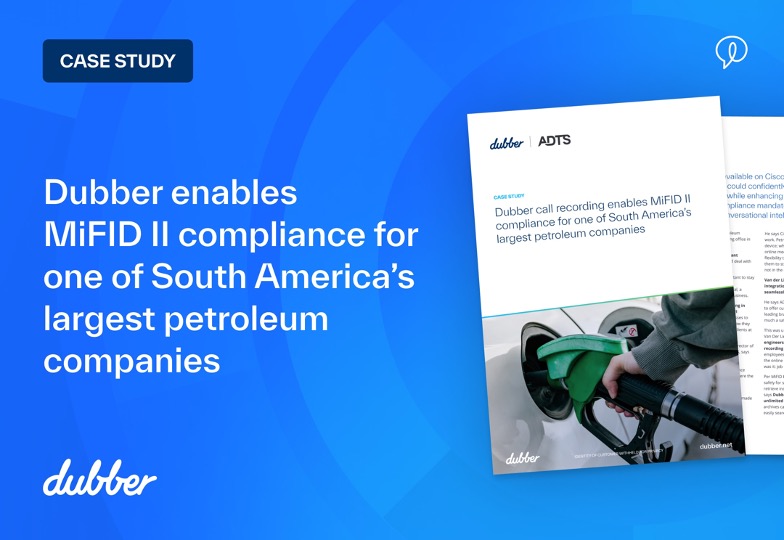
Having Dubber available on Cisco Webex Calling meant one of South America’s largest petroleum company could confidently migrate its communications while enhancing its ability to meet the ever growing compliance mandates through unified call recording and conversational intelligence.
One of South America’s largest petroleum company, and a member of the Fortune Global 500 list, needed a compliant and intelligent solution for recording calls and conversations.
Traders working there take important incoming sales calls from buyers and deal with other business partners.
As part of a global business, it is important to stay in regular contact with the business’s headquarters in South America. Availability is vital, a missed call can mean losing valuable business.
They needed unified call recording in order to comply with Europe’s MiFID II directive. The directive requires businesses to keep good records of transactions to show they have acted in the best interests of their clients at all times.
Bernhard van der Linde, the managing director of their local technology partner ADTS, says that when it looked around for the best combination of telephony and unified call recording to meet the company’s compliance needs, it found Dubber and Cisco Webex were the best fit.
The customer consulted ADTS as its trusted technology partner and after due diligence made the decision.
He says Cisco Webex is the best tool for this work. Their employees can make calls on any device; whether phone calls, video conferences or online meetings. Webex Calling gives them the flexibility they need to move around and allows them to stay connected at all times, even when not in the office.
Van der Linde says “Dubber’s strong Webex integration was the key. It could be installed seamlessly without any disruption”.
He says ADTS finds Dubber to be an easy solution to offer customers because it is recognised as the leading brand, ticking all the boxes and very much a safe choice.
This was underlined by the installation process. Van Der Linde said: “it was super simple, our engineers exchanged data, switched on recording and it just works. We gave employees an initial training and showed them the online resources available from Dubber. That was it: job done.”
Per MiFID II, the customer must store all records safely for seven years and be able to find and retrieve individual calls at any time. Van der Linde says Dubber is ideal for this as it offers unlimited usage and storage, and never archives calls so everything is available to be easily searched and played back instantly.
He went on to say, ““We already knew Dubber and were pleased to be able to use them with Cisco Webex. The migration to Webex with Dubber was easy and without disruption, best of all we know our client has access to the best tool we know for managing MiFID II compliance requirements”.
Want to learn more?
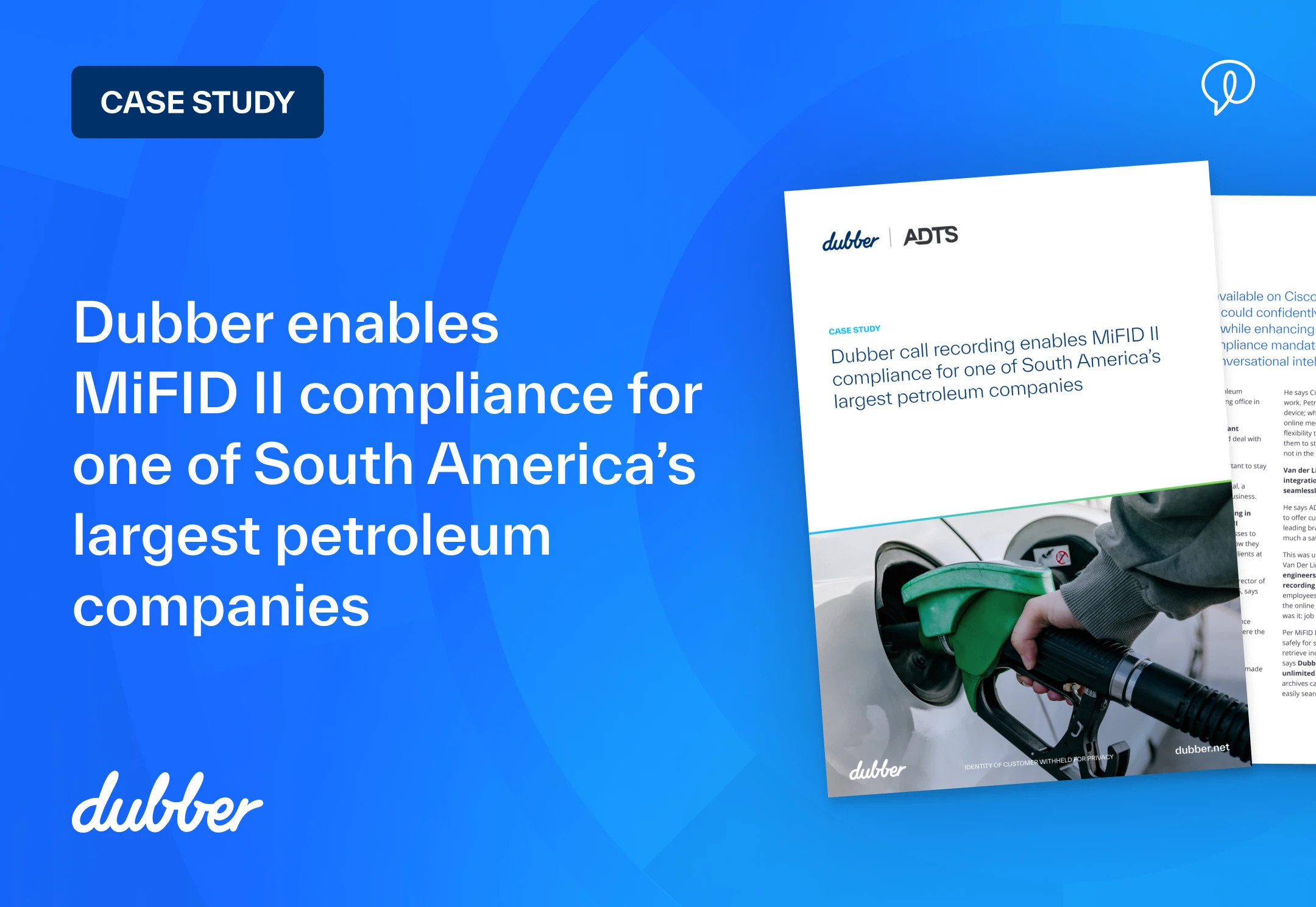
Having Dubber available on Cisco Webex Calling meant one of South America’s largest petroleum company could confidently migrate its communications while enhancing its ability to meet the ever growing compliance mandates through unified call recording and conversational intelligence.
One of South America’s largest petroleum company, and a member of the Fortune Global 500 list, needed a compliant and intelligent solution for recording calls and conversations.
Traders working there take important incoming sales calls from buyers and deal with other business partners.
As part of a global business, it is important to stay in regular contact with the business’s headquarters in South America. Availability is vital, a missed call can mean losing valuable business.
They needed unified call recording in order to comply with Europe’s MiFID II directive. The directive requires businesses to keep good records of transactions to show they have acted in the best interests of their clients at all times.
Bernhard van der Linde, the managing director of their local technology partner ADTS, says that when it looked around for the best combination of telephony and unified call recording to meet the company’s compliance needs, it found Dubber and Cisco Webex were the best fit.
The customer consulted ADTS as its trusted technology partner and after due diligence made the decision.
He says Cisco Webex is the best tool for this work. Their employees can make calls on any device; whether phone calls, video conferences or online meetings. Webex Calling gives them the flexibility they need to move around and allows them to stay connected at all times, even when not in the office.
Van der Linde says “Dubber’s strong Webex integration was the key. It could be installed seamlessly without any disruption”.
He says ADTS finds Dubber to be an easy solution to offer customers because it is recognised as the leading brand, ticking all the boxes and very much a safe choice.
This was underlined by the installation process. Van Der Linde said: “it was super simple, our engineers exchanged data, switched on recording and it just works. We gave employees an initial training and showed them the online resources available from Dubber. That was it: job done.”
Per MiFID II, the customer must store all records safely for seven years and be able to find and retrieve individual calls at any time. Van der Linde says Dubber is ideal for this as it offers unlimited usage and storage, and never archives calls so everything is available to be easily searched and played back instantly.
He went on to say, ““We already knew Dubber and were pleased to be able to use them with Cisco Webex. The migration to Webex with Dubber was easy and without disruption, best of all we know our client has access to the best tool we know for managing MiFID II compliance requirements”.
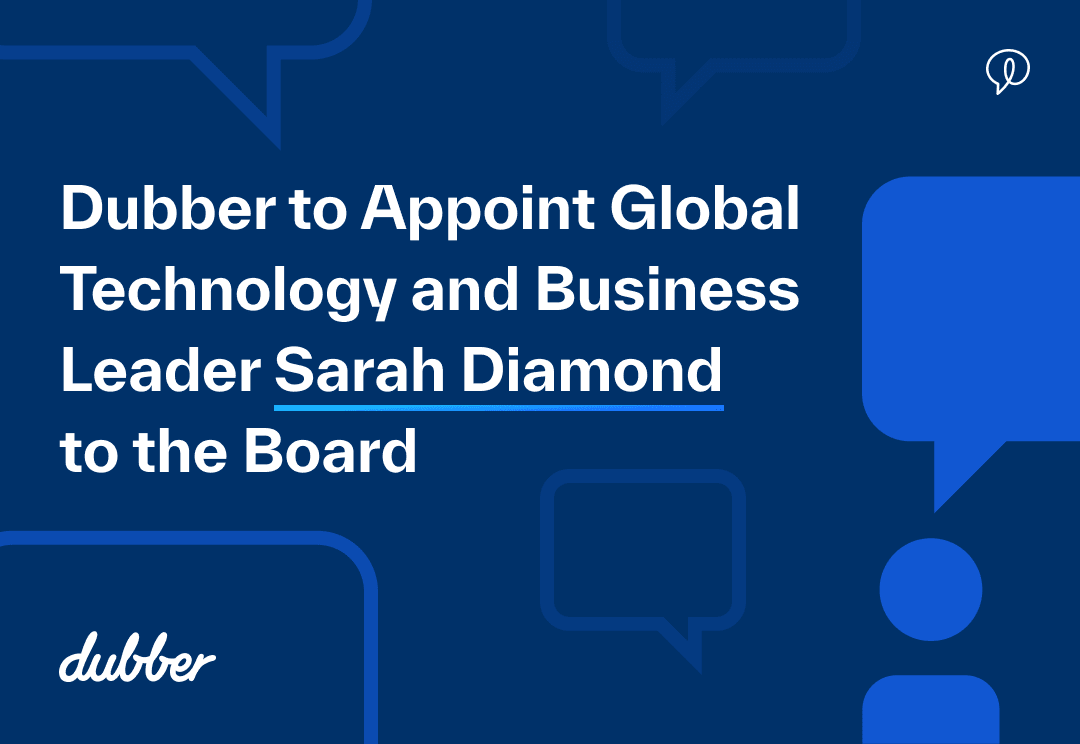
Sarah Diamond will join Dubber’s Board as a Non-Executive Director, bringing a wealth of international experience in business and technology to the company.
Peter Clare, Dubber’s Chairman, said the Board is delighted to welcome Diamond, and the appointment will help drive the growth and future success of the business.
“Sarah brings a wealth of experience and capability relating to a multitude of key areas in which Dubber is focused. We look forward to working with her as we grow the company’s profile globally,” Clare said.
Sarah Diamond is a recognised global executive with deep experience in the financial services, technology, consulting and regulatory sectors. Over the course of her 30 plus year career, Diamond has worked with most major banks, Wall Street firms, exchanges, and regulators. A global leader, Sarah has led teams across cultures and time zones in Europe, the United Kingdom, China, Japan and the U.S.
As the Global Managing Director, Financial Services at IBM, Diamond managed a $10B P&L and was responsible for helping top 50 global financial services clients embrace digitization to grow their businesses while creating customer value within the rapidly changing regulatory, business and technology landscape.
Additionally, she served as Vice Chair of the Advisory Board of Directors and senior advisor to the Chairman and CEO of the Promontory Financial Group, an IBM company.
Prior to joining IBM, she served as senior vice president in charge of capital markets at KPMG, after launching her career in international banking at Chemical Bank in London.
Download the full ASX Announcement below.
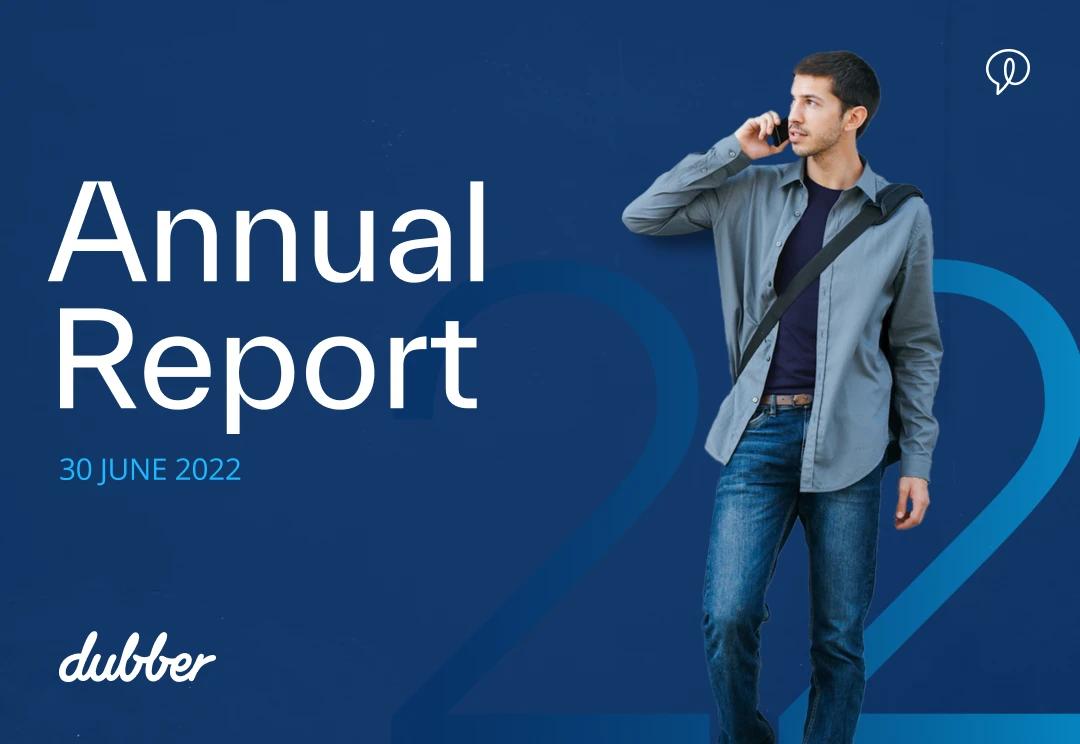
Dubber Corporation Limited (ASX:DUB) the leading conversational intelligence and unified recording platform for service providers and their customers globally, today released its Annual Report to Shareholders for the year ending 30 June 2022.
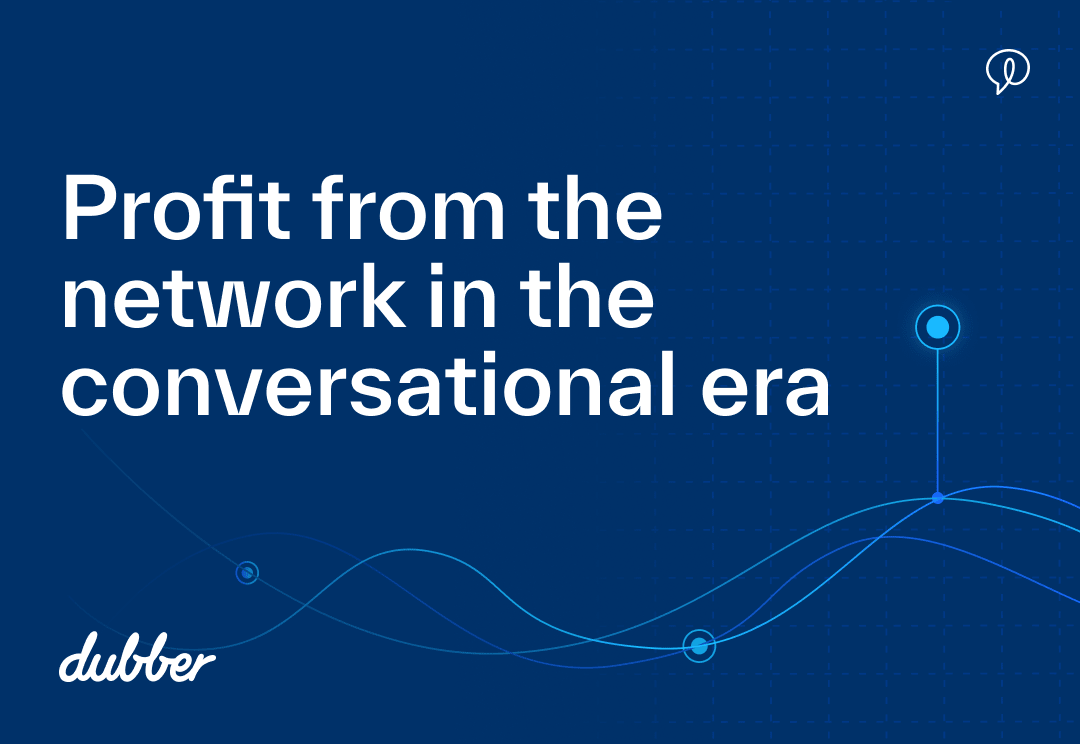
Our recent research with AT&T showed that 72% of businesses lack a clear hybrid-work strategy. The findings also show other sentiments and challenges around Covid-driven hybrid working, including lack of innovation, insufficient oversight and cultural shifts.
But. Hybrid work will be the default by 2024. Half of the work will be performed offsite: 81% believe hybrid work will be the foremost working model by 2024, with 56% of work done offsite.
Artificial intelligence and machine learning were identified as the leading transformative technologies in the survey, with their intrinsic value identified specifically in the areas of employee training, intelligent enterprise search and learning and conversational help.
AI is a great example of the dilemma facing most service providers – how to monetize a transformative technology – does this opportunity get left to those running on the network – or, can AI on both the end-point and in the core of the network usher in a new era of conversation-based services?
Address the challenges at the network level
The issues emerging in addressing both AI and Hybrid Working as opportunities are challenged by macro issues: Businesses and consumers increasingly relate more to the app or service than the businesses that made the conversation possible – as a result, even the new 5g opportunity is relatively undifferentiated. Without new services and innovation based on AI, differentiation is unattainable, resulting in churn – a dependence on price and packaging, and balance sheet impacts from decreasing revenue and margin.
The question is will the shifts increase the value of the network to you, the Service Provider? Empowering increasing ROIC, revenue, retention, and differentiation; will they open opportunities for innovation for the service provider, allowing for innovation-powered differentiation?
Or will they deliver a more powerful platform to others? Those running on top of the network have shown us that revenue doesn’t return to the source of where value was created. But what if there was a way? This is why we started Dubber – not just to record calls but to deliver value from the network from our Platform.
Delivering on the promise and value with the Conversation Cloud
The new conversational era will be powered by the Conversation Cloud – the one place conversations can be retained, refined and AI-enriched to create value. Many of you who know Dubber may gravitate towards thinking that we are a call recording company… and that is understandable. The platform, however, has been designed to match the philosophy, namely that capturing the conversation should be from the source of that conversation – the network. Call recording, as tangible as it is, was only ever going to be the start. You’ve all heard the word ‘platform’ after the term ‘cloud’; it is the most overused and over-abused term in our vernacular.
That’s what Dubber is, a single global platform that enables service providers to deliver features at scale anywhere across the network. Features that enable value to be created from any conversation on the network, features that unlock content insights, features that enable the prospect for innovation, features which can create new and needed experiences for customers, and features that drive revenue from the source of their creation – the network.
Dubber is not your typical ISV partner, looking for re-sale partnerships with all the challenging sales motions that that entails to ultimately deliver unilateral value around our own detached technologies and customer base. We believed that the focal point needed to be the Service Provider for two key reasons: Firstly, because we believe that that would provide the best customer experience, and secondly, that would drive value throughout the supply chain. To do that, we need to be on board with you in every sense.
Solutions delivered to you should enhance the value of the network through differentiated services, not monetize the network at your expense. Those solutions should be burdenless, deployed with simplicity and scale, on with a click and integrated easily with provisioning and billing. And that they must unify applications and end-points, so conversations – text, video, mobile, UC could be accessed and enriched in one conversation cloud.
And that this could enable endless AI-based innovation opportunities for service providers with minimal CAPEX.
Reimagining the value of the network starts with reimagining the value of a conversation. And that begins with unlocking the value of content. Network operators generate an average of 10 to 15 per cent of their revenues outside of core connectivity; the type of services we deliver have the potential to double that. And this increases further when the customer adds other communications services to the Conversation Cloud.
The monetization opportunity is immense. Take any conversation – serve new applications – native widgets and or notifications. Let me give you a few examples of what we see as an exciting opportunity.
The emergence of new network services
We launched Notes by Dubber at Mobile World Congress. Deployed at the heart of a Service Provider network, users now get any meeting or call transcribed, turned into actions, with highlights and more. Enabling users to review meetings that they weren’t able to attend on the way home and easily share highlights for action by others.
The use cases run across all demographics, from consumer through to small businesses and enterprises. For example, say, on a mobile network, I could get a text nudge following a call with all the key actions from the call. Or a reminder of a meeting I committed to during the conversation to drop onto my calendar. Or perhaps my service and mobile might come with an app that quickly flags to me customer and employee sentiment for that day and gives me snippets from customer calls I should know about. Let’s say I’m a major bank, and I might have provided to me by my Service Provider a fully integrated compliance reporting dashboard that gives me total visibility into calls that potentially breach policies.
Or a simple search console that enables me to pull up highlights, a recording or a transcript of any conversation across the business. That same application would prove invaluable to HR, dispute resolution teams, or customer service managers. All of this is possible today. And this is just the start of a new era in which every conversation is a source of value for the service provider turning the network into an innovation factory with endless new services created and deployed with minimal CAPEX investment.
In most media industries, there is a well-known saying that content is king when it comes to future value. The networks which you operate contain an enormous amount of content that, to date, remains untapped. Every day, huge amounts of calls or conversations go across those networks and disappear into a vacuum. Others land on third-party infrastructure and applications where they are monetized independently of the service provider. One key question is how quickly can that change?
Reimagine the value of your network today
‘Speed to market’ is a familiar imperative that is identified by analysts and management alike. The Dubber platform is ready to go, as are primary revenue-generating applications which can deliver that content in the network.
What if this took months, not years and what if revenue flowed in days? And what if it did that without traditional CAPEX and OPEX burdens? We see an incredible opportunity to help to redefine the value of every network through the Conversation Cloud and Dubber Platform. It starts with a new form of partnership between companies like Dubber. One where we all benefit from increasing the value of the network and expressing the life of the network and conversations in new ways.
Customers are going to benefit from it; more than that, they are going to require it and what better way to serve it to them than directly from the network.

by Bill Bennett
Service providers have an opportunity to recapture the value in their infrastructure.
Telecommunications technology changes fast. Telcos and other service providers face ever-increasing infrastructure investments to stay competitive. Upgrading mobile networks to 5G or building fibre to the premise needs more capital.
Each year they spend hundreds of billions of dollars. There is no let-up in sight.
Meanwhile, there is no corresponding revenue rise. Customers get more data and faster data with each passing year although the price they pay remains steady. They get more reliable connections. Traditional telecommunications companies around the world built networks that millions turned to when they had to work from home.
When they look at the future through a traditional telco lens, they see few opportunities to add value.
Competing with free
Moreover, the value-added services telcos were able to sell in the past are now given away for free.
Technology companies provide free or low-cost digital services running on top of fixed-line and wireless networks, often, but not always, funded by advertising sales.
Take the free messaging offered by Facebook, Google and Apple. It can be advertising-supported or as a lure to sell hardware or other digital services. Zoom, Teams and Webex replace telco-provided video conferencing. The list of free or low-cost over-the-top services goes on.
Streaming video, music and gaming are other classes of over-the-top services that rely on networks built and maintained by telcos
To rub salt in the wounds, over-the-top companies continue to clock up record revenues and enjoy high margins.
Meanwhile, telecommunications experiences flat to decreasing revenues, increasing capital outlay requirements and reducing opportunities to differentiate.
Telco share of the online digital universe is decreasing
When comparing telcos to these tech companies the numbers make for sobering reading. The profits of the world’s top 25 telcos has fallen 46 percent. Their share of revenue is down 40 percent. Their share of the market cap dropped 60 per cent.
Meanwhile, the likes of Google, TikTok and Zoom are heading in the opposite direction. It’s no coincidence that Apple and Microsoft are among the world’s most valuable companies.
The telco sector’s long-time fear of becoming little more than a series of pipes could soon be reality. There’s irony in this: none of the new value the over-the-tops generate would be possible without the networks. They are the enabling technology.
There are other challenges. Governments around the world have different regulatory goals, but their rules often work to increase competition, which in turn keeps margins low. It’s not unusual for telcos in a contested market to compete all the profit away.
The logical conclusion of where the markets are heading is that telcos have lost the battle for opportunities on the network. However, things are quite different if we look in the network.
The opportunity is in conversations & content
All the extra value created by over-the-top companies comes from conversations. People and businesses need to communicate with each other. It remains as valuable as ever.
For over-the-top companies, those conversations take place on top of the network.
There is another set of conversations with untapped value. We’re talking here about the millions of conversations people have every day when they make voice calls on their mobiles or fixed-line phones through traditional telecommunications networks.
These conversations take place in the network.
Each of those conversations could hold as much value as those taking place on the over-the-top services. They represent an opportunity for telcos to win a much higher average revenue per user.
Moving beyond connectivity
Telcos have found it hard to move beyond connectivity in the past. There are huge barriers. Over-the-top players are not restricted by national boundaries, networks inevitably are.
The skills needed to develop and market digital services were expensive and hard to attract to firms unable to distribute start-up equity or offer seemingly unlimited career opportunities. That’s less the case today, skills are more widespread and, thanks to the cloud, technologies often need less complex integration.
Tapping into the conversations that take place in a network is one set of opportunities beyond connectivity. Other trends have potential.
Organisations with large on-premise call centres are shifting to cloud-based systems. They need flexibility and to be able to support new modes of working including home-based call centre staff.
Bigger than connectivity
Connectivity services typically deal in large numbers: customers serviced, call minutes, data traffic and so on. The numbers can be equally large beyond connectivity.
And unlike connectivity, where the number of customers is at saturation point, the market for in-network services holds huge growth potential. The examples are endless:
- Deployed at the heart of a Service Provider network, Dubber Notes users now get any meeting or call transcribed – turned into actions – with highlights and more. A user can review meetings I wasn’t able to attend on the way home and easily share highlights for action by others.
- Another service might deliver a text nudge following a call with all the key actions from the call. Or a reminder of a meeting I committed to during the conversation to drop onto my calendar.
- Or, mobile services might come with an app that quickly flags customer and employee sentiment for that day – and provides snippets from customer calls a manager should know about.
- A major bank could receive from their Service Provider a fully integrated compliance reporting dashboard that gives total visibility into calls that potentially breach policies. Or, a simple search console that enables them to pull up highlights, a recording or a transcript of any conversation across the business. That same application would prove invaluable to HR, dispute resolution teams, or customer service managers.
All of this is possible today. And this is just the start of a new era in which every conversation is a source of value for the service provider – turning the network into n innovation factory with endless new services created and deployed with minimal CAPEX investment.
Many of today’s business challenges are best dealt with from in-network services
Many businesses face challenges that are best addressed by value-added services telcos can offer from within their networks. There’s an ever-increasing compliance load, especially of those companies operating in and around the finance sector where record keeping becomes critical.
Conversational intelligence is an ideal way to capture the necessary information. It makes sense to do that at the network level. It makes even more sense for capturing and mining the conversations in the Network to take place in the Cloud where vast amounts of data can be stored safely and securely.
AI opens the door to a new frontier
Moving from connectivity services to capturing vast amounts of conversational recording data opens the door to new frontiers with even greater potential to disrupt and reshape telco business models. Voice call recordings already enable AI technologies like sentiment analysis, where customers can instantly read reports on how customers respond to conversations.
Understanding this opportunity changed our orientation at Dubber from the utility of call recording to the creating a platform that will enable value to be created from any conversation on the network – to enable the content on the network to unlock new sources of innovation and the creation of new, needed experiences for customers.
We believed that the majority of providers looking to enhance the value of the network had it wrong and we would get it right – and that the focal point needed to be the Service Provider:
- Solutions delivered to you should enhance the value of the network through differentiated services – not monetize the network at your expense
- Those solutions should be burdenless – deployed with simplicity and scale – on with a click – integrated easily with billing and provisioning
And that they must unify applications and end-points. So conversations – text, video, mobile, UC – could be accessed and enriched in one conversation cloud. - And that this could enable endless AI-based innovation opportunities for service providers with minimal CAPEX
Mining the gold in the network starts with native services the Service Provider can monetize and provides the pathway to increased revenue, retention and differentiation.

Download the case study to learn how Surf Life Saving NSW can focus on the mission of saving lives with Dubber call recording and AI.
Learn how Surf Life Saving NSW:
- Gathered crucial evidence with accurate and immutable records of all calls for coronial enquiries and investigations.
- Saved critical time with automatic transcriptions of every call that can be copied and pasted into incident reports saving critical time.
- Used AI-powered sentiment analysis to identify calls needing further review, and listened to recordings for staff training.
“Dubber improves our response speed. It frees up the operators to focus on the rescue, helps us prepare evidence for coronial enquiries and improves reporting accuracy. Together these make us more professional as an organisation and an emergency service.”

Melbourne-based enterprise tech solutions provider Rubicon 8 uses Dubber to understand immediately how customers react to help desk support – without asking them to fill in post-call questionnaires.
Rubicon 8 General Manager Pat Bombardieri says his company uses Dubber to understand managed services team performance.
“We specialise in providing ICT solutions to enterprise organisations, helping them leverage their technology to unlock their business potential. We have a wide delivery framework, and one of the things we do is manage our customer’s IT infrastructure, handling all the support for their desktops and their servers.
“There is a team of engineers sitting on our help desk. Some work remotely and some work in the office, taking phone calls from customers and providing them with support over the phone.
Rubicon 8 uses Dubber running on Cisco Webex to record and store all the support phone calls. After a call ends Dubber’s artificial intelligence gives managers an indication of how that call went.
“It tells us if the customer went away happy or not. The AI does the evaluation and we get a notification in the form of a smiley face when the call went well and a cross face if it didn’t.”
Pat says this replaces the previous system, which involved sending our customers evaluation surveys after each call.
He says: “This was a manual process, and our customers found it monotonous. We know they have to fill in lots of surveys from other people they do business with and we didn’t want to keep adding to this.”
This method meant a lot of work for Rubicon 8. There could be 150 requests each day, across 50 or so customers. Analysing survey responses and pulling reports together was a full time job.
From Pat’s point of view, the purpose of the surveys was to understand the customer experience and to unearth what could be improved.
He says: “The AI in Dubber, ticked that box for us. It gave our team leader the opportunity to know immediately what happened. If we see something that indicates a customer was frustrated, a manager can go in and listen to the call and have a coaching conversation with the engineer.”
“Nobody likes it when their technology isn’t working, so when our customers call for support, the way we manage their experience is key to our business. We need to know if they are waiting too long on the phone when they call, or if they are not happy”.
After seven months using Dubber to monitor help desk calls, Pat’s team identified an issue where people who were working from home because of Covid were using the help desk for support with their home computers. Home computers are not covered by Rubicon 8’s service agreements. He says: “We don’t manage home computers because we can’t access and control them. We don’t know if they are safe and secure.”
These calls were taking up engineers’ time, but were not in Rubicon 8’s management agreements. Pat says this isn’t something that he would have learned with manual surveys, but it became apparent after listening to calls. This allowed the team to adjust and remind customers which devices are covered with helpdesk support, allowing Rubicon 8 to boost engineer productivity.

Did you catch Dubber on CommsDay?
Recently, James Slaney, Co-Founder and COO of Dubber, sat down with Grahame Lynch from CommsDay, to chat about the challenges Communication Service Providers are facing and how they are uncovering hidden value on their networks thanks to the power of Dubber.
“Service providers are telling us they have traditional issues such as differentiation. There are growth problems. They’ve got pressures with churn of customers. They’ve had massive investments in 5G and growing those networks and delivering; how can they leverage those investments and dragging the revenue or the benefits of those networks.” – James Slaney, Co-Founder & COO Dubber
Why Service Providers are turning to Dubber to unlock value from network conversations
Against a backdrop of regulatory and supply disruption, changing customer behaviours and tech innovation, service providers are under constant pressure driven by a need to differentiate mobile offerings, shifting value pools and profit erosion, resulting in decreasing returns on invested capital.
Dubber hits that sweet spot for Service Providers globally; as a network-grade service that’s embedded into the network. Dubber addresses traditional telephony, mobile networks, and Unified Communications services, unifying voice data and delivering insights, actions, and meaning from not only singular conversations but within departments, business functions, and the enterprise as a whole. Critically, Dubber network-native services enable service providers to unlock new revenue streams through conversations on their networks.
When, where and how conversations occur has changed
The conversational era is upon us. Gartner estimates that by 2025 – 75% of business conversations will be recorded and analysed for business intelligence and decision making. Covid has accelerated Hybrid work resulting in an explosion of end-points, conversation modalities and the imperative for businesses to digitise.
Despite the changes in where, when, how and on what device or platform conversations happen, the service providers’ network infrastructure underpins it. With the benefit of Dubber, service providers can orchestrate and enable customer, people, revenue, compliance intelligence, and dispute resolution by unifying voice data with AI, all from natively embedded services within the heart of the network. Dubber empowers service providers to position themselves to deliver and capture value answering their need to differentiate, create new value pools and retain customers.
The Dubber difference driving Service Provider differentiation, retention & profit
As a sticky product with cloud-native infrastructure and scalability that can be switched on with a click, over 170 service providers worldwide partner with Dubber to provide value for customers in a network-native, simple to deploy and flexible, innovative service.
The Dubber Difference:
- Embedded as a service and connected at a network layer – highly resilient and telco-grade platform
- Deliver differentiated services and accelerate innovation
- Increased revenue from an in-demand service – Near-instant time to market and revenue-generating from day one – Dubber is highly profitable, margin accretive
- Increased retention
- Requires no CAPEX neither for you (the CSP) nor for end-customers
- No unnecessary cumbersome installations required
- Intuitive cloud-native, easily accessible and modular
- Backed by comprehensive support (support, helpdesk, security)
- Tap into innovative capabilities such as NLP, AI & ML
Speak to us and learn how we enable service providers to unlock the potential in their networks.
Download the whitepaper by leading telecommunications industry analyst firm Cavell Group, to discover the key trends impacting service providers and what every service provider needs to do next.

As Cisco’s leading partner for Unified Conversational Call Recording and Voice AI, we’re looking forward to participating in Cisco Live from June 13-16 in Las Vegas as a Collaboration Village Sponsor.
This is your chance to see the only preferred native and embedded call recording solution at Cisco Live. Dubber is native as a standard feature in Webex Calling Multi-Tenant and Dedicated Instance – an immediate benefit to every customer and a pathway for every Cisco Partner and Seller to drive richer Dubber solutions with a click.
We’ll be demoing Dubber, showcasing case studies and have great prizes and gifts waiting. Come on by!
Dubber is proud to be the most complete recording solution on all major Cisco platforms. With Dubber, Cisco customers across all industries now have the opportunity to unify conversational data capture and analytics, revealing the critical insights largely left untapped within voice, video, and chat.
In response to the new reality of hybrid-working, the unification and capture of all communication is vital to the transformation of enterprise working models and in delivering advanced functionality to drive innovation and collaboration across organizations.
For Cisco customers, the Dubber platform drives innovation, revenue, and retention as a hyper-scalable and instantly deployable secure cloud-based solution. With just a click of a switch, users can securely share and unlock meaningful insights and actionable intelligence enriched with conversational metadata and unified in the Dubber Conversational Cloud.
Here are some of the highlights of what you can expect from Dubber at Cisco Live:
- Speaking session by Adrian, Di Pietrantonio, Co-Founder and Executive Vice President of Global Platforms & Partnerships at Dubber
- Join Adrian in the Collaboration Village on Wednesday the 15th of June at 3:30-3:45 pm for a session on how Voice AI can address the challenges associated with hybrid work and unlock valuable insights for your business.
- Visit the Dubber kiosk & chat with a voice data expert
- Visit us at the Collaboration Village, CL11 – E&F, and speak to one of our experts to learn how Cisco’s preferred private and compliant recording solution can be turned on and used in your enterprise.
- Loads of prizes are up for grabs!
- Don’t miss out on the chance to receive a free demo of Dubber on Cisco’s major platforms and go into the running to win Dubber merch or an Apple Airtag!
So, in the spirit of the Cisco Live 2022 event tagline “ALL IN”, we’d love for you to join us and go ALL IN with Dubber at Cisco Live. Come see us at the Collaboration Village, CL11 – E&F, from June 13-16 to learn more about how Dubber can optimize your business by helping to ensure compliance mandates are met, improve customer and employee intelligence, reduce revenue leakage, expedite dispute resolution and turbocharge productivity. You don’t want to miss this!
Book a face-to-face demo of our platform or a meeting with one of our senior executives at Cisco Live. We look forward to seeing you there!

Service provider communications infrastructure is the backbone of society. However, the ability to generate value from these networks has diminished and is increasingly challenged.
As a critical infrastructure, telecommunications is highly valued by businesses and the community and vital to the current and future success of the economy. Despite this, it is frequently viewed as little more than a utility. Understanding future value creation for service providers of every kind requires a shift in focus from the network as a utility to the network as an exponential source of value based on the content flowing on it. Doing so enables us to reimagine the potential of the network and unlock the huge social and productivity benefits that our sector can deliver.
Conversations are the life of the network
Conversations make the network – they are the life of the network. Hundreds of billions have been invested in network infrastructure to make them possible – with more still to come.
Despite this investment, we constantly hear from service providers about their difficulties extracting value from the network.
“Over the past decade, telcos have been under continuous pressure as their traditional value pools have gradually eroded and new growth horizons have proven elusive, driving return on investment capital (ROIC) ever closer to weighted average cost of capital (WACC).” – McKinsey, A Blueprint for Telecom’s Critical Reinvention.
Now, ROIC is barely higher than WACC and falling – caused by high and rising requirements to invest CAPEX into network infrastructure. Network expenditure is forecast to rise significantly over the coming years as operators deploy 5G and edge-cloud networks, recasting consumer and enterprise value propositions in the process.
At the same time, telcos have seen other players in parallel verticals monetise the value of the network. Globally, the share of profit of the top 25 telcos has declined by 46% versus internet companies; the share of market cap has declined by 60%, and the share of revenue has declined by 40%, all while Google, Microsoft, Zoom, Facebook et al. have grown exponentially.
The pressure is unrelenting with the accelerating growth of OTT providers and MVNOs. None of these companies would exist without the demand for a conversation on the network. The need to communicate – to collaborate on work – to connect with friends and family drives their value.
But if conversations are the life of the network – why haven’t we been able to monetise the content they are made of? Why isn’t every unit of a conversation a source of ever-increasing value? And, why are others making more money running on the network than those investing in the network?
Unlocking value from the network through conversations
Already, Gartner predicts that 75% of business conversations will be recorded by 2025. This isn’t for compliance or traditional call recording requirements as we know them today, but because conversations are an extremely content-rich source of data that is now able to be enriched with artificial intelligence (AI), machine learning (ML) and natural language processing (NLP). Together these technologies make it possible to surface customer satisfaction and revenue insights in real-time and resolve Customer and Employee disputes efficiently. And meetings turned from time-wasters to productivity boosters.
When, where and how conversations occur has changed substantially. A new conversational era is upon us with employee and customer behaviour leap-frogging ten plus years. Remoting working has been matched by an acceleration in remote selling and service.
In 2021, video conferencing skyrocketed, with 82% of Australians starting or increasing their usage. Much of this shift was accelerated by COVID and the drive to hybrid working – it didn’t just change where we work, but how we communicate and when we work. Unified Communications exploded – challenging Telcos across everything from control of the customer to tech to margin.
And the pace of this shift isn’t stopping. Global UC spending is projected to grow at a 5% CAGR to reach $53 billion in 2025. Microsoft has surpassed 270 million monthly active Teams users globally, while Cisco Webex Calling has hit a record 8 billion monthly calls. And in 2021, Zoom grew Australian users by more than 54 times. And now 5G is set to create further opportunity – mobile will matter more than ever before, resulting in more endpoints and new kinds of end-points more connected than ever.
So how to service providers extract value from these shifts?
The first step in extracting the value of content and conversations on the network – and this starts by turning them into meaningful data sources by embedding conversational capture as a native feature of the network. Compliant, secure and scaleable capture enables AI-enriched insights and data to be produced from transcribed content in full or fragments.
From content in the Dubber Conversation Cloud, new services and applications can be developed rapidly based on data derived from conversations. At the most basic level, new subscription-based services fuel potential revenue at twice that of the service costs.
Dubber’s suite of service provider embedded products capture conversations across all endpoints and unify them – representing a unique opportunity to generate value from the network, no matter how people communicate.
By increasing revenue, retention and differentiation, we can change the economics of the network together.
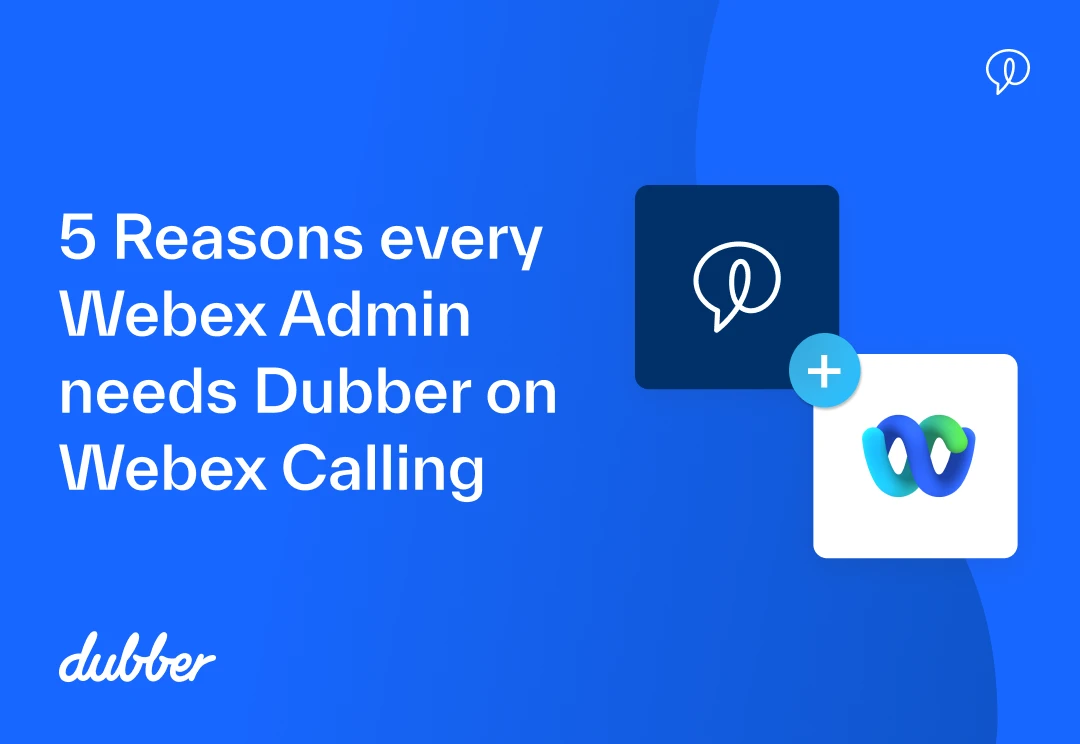
5 reasons why every Admin needs to turn on Dubber on Webex Calling
Dubber private and compliant cloud call recording is a native feature of Webex Calling, easily provisioned by any Webex Customer Administrator. More than half a million businesses and users (globally) have been using Dubber to record their crucial business conversations.
Are you the Control Hub Customer Admin?
Call recording insights are now considered imperative in achieving better business outcomes. Organisational leaders are looking for an edge, whether that’s better use of voice data or an increased ability to glean insights and intelligence from every business conversation.
Webex Calling customer administrators now play an essential role in enabling their business and users to unlock the value in every business interaction and power conversational intelligence at scale. With a predicted 75% of conversations being recorded by 2025 (Gartner), the trend is set to stick.
So how does Dubber on Webex Calling stand up against competitors and enable businesses of all sizes to achieve business outcomes? Here are five reasons.
5 reasons you need to switch on Dubber on Webex Calling for your business:
1. It’s FREE. Zero additional set-up cost. Zero additional hardware.
All Webex Calling users have access to Dubber’s enhanced cloud call recording capabilities at zero cost covered in their Webex Calling subscription. You can eliminate the cost of legacy call recording solutions today and simplify the pathway to unlocking the benefits of conversational insights and AI.
2. Natively embedded, instantly provisioned and intuitive onboarding
Dubber is the first multi-tenant call recording solution born in the cloud that’s natively embedded into Webex Calling. Dubber is securely interconnected to the Webex Cloud, making it simple, automated, and instant to switch on through Webex Control Hub. Admins have complete control and easy user management. Admins can effortlessly provision 1 or 1-thousand users or leverage dedicated customer success experts for support, including an intuitive concierge-level onboarding experience for admins.
3. Enhanced cloud call recording for business needs
All Control Hub admins need to do, is switch on call recording in Control Hub for their users. By doing that, they enable enhanced compliant cloud call recording capabilities for all Webex Calling users. All recordings are centralised in the Dubber portal with unlimited call recording, replay and download with 30-day storage. Dubber on Webex Calling users will have the ability to record, pause/resume and record on-demand on mobile or the Webex app (Desktop/mobile).
4. Centralise your voice data compliantly – Built for Hybrid (Webex Calling & Webex Dedicated Instance)
As an Admin, if you’re managing the transition from UCM on-premise to Webex Calling, you can use Dubber to meet all your call recording requirements. With Dubber, cloud call recording is compliant, secure and unifies your voice data in one platform. This approach enables a streamlined hybrid experience and management for you as the Administrator.
5. Dubber is a Cisco Solution Plus Partner
As a Cisco Solution Plus partner, Dubber has long been a trusted vendor across the Cisco ecosystem. For this reason, Cisco is Dubber’s first partner in the Dubber Foundation Partner program. The partnership unlocks for all Webex Calling & Webex Dedicated Instance customers a tailored, securely embedded and compliant cloud call recording, bringing a best of breed capability as a stand feature. For Webex Calling customers and customer Admins, the experience has been designed with ease of adoption and simplicity in mind. This makes Dubber the most complete recording solution available on all major Cisco and Webex platforms.
Interested in learning more?
Dubber on Webex Calling is making cloud call recording easier and more accessible for businesses to unlock the value of their rich conversational data. To learn more, get in touch with us here.
To compliment Dubber on Cisco, Dubber also has a range of solution packages purpose-built to solve Compliance, Customer, People and Revenue intelligence outcomes powered by Dubber’s voice-ai platform. Reach out here for a tailored demo.

Lights, camera, action!
We’re proud to announce our debut ‘Blockbuster’ sponsorship of Gamma’s 2022 Roadshow, ‘Gamma at the Movies’. This year’s theme is, ‘Mission Possible: Making new markets’.
Dubber is changing the economics of legacy on-premise call recording, opening up new opportunities for revenue growth, customer retention and product innovation with the Unified Call Recording and Voice Intelligence platform.
We’re excited to showcase the Dubber solution to Gamma channel partners up and down the country in June and showcase how they can start to 2X the value of every deal with compliant cloud-based conversational recording and voice AI.
- Tues 14th June – Vue, Glasgow Fort, Glasgow
- Wed 15th June – Vue, Salford Quays, Manchester
- Tues 21st June – Cineworld, NEC, Birmingham
- Wed 22nd June – Vue, Cribbs Causeway, Bristol
- Tues 28th June – IMAX, Waterloo, London
Innovate your UC offering and increase your ARPU today with Dubber – see you at the show!
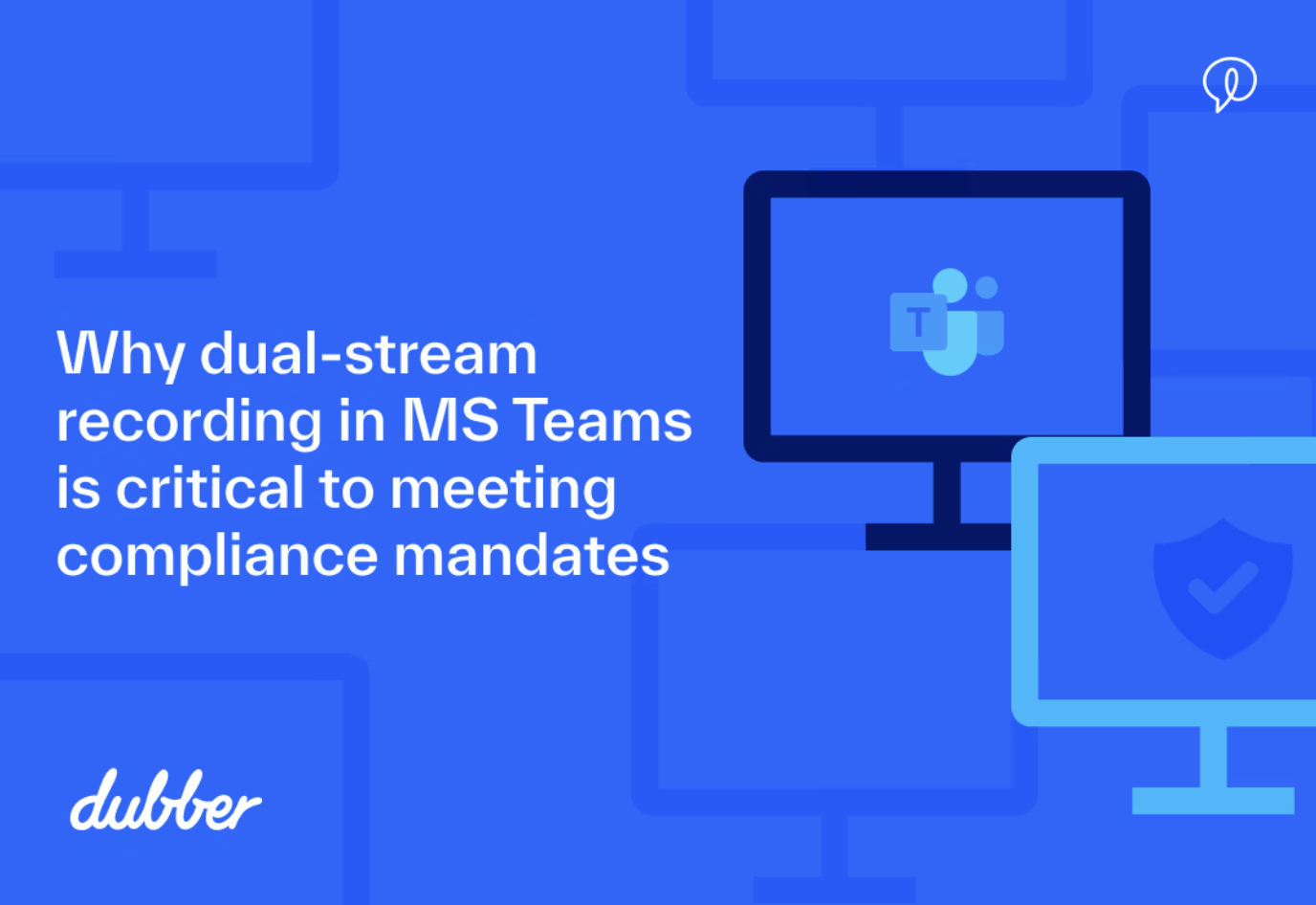
Who said what? Dual-stream recording on MS Teams is a way to end not knowing – critical for hitting compliance mandates within organisations. When dual-stream recording is switched on, call recording quality goes up.
Benefit: More accurate transcriptions, leading to better conversational intelligence insights
Benefit: Discrete record of who said what, even when both parties are talking at once
When a conversation happens on Microsoft Teams – whether it is a Teams-native platform conversation, or an Operator Connect call via Microsoft Teams Calling with PSTN integration – dual-stream recording can be your default option with Dubber.
How dual-stream recording for Microsoft Teams works on Dubber
Dubber’s dual-stream recording on Microsoft Teams records two audio separate streams – one for the host, one for the participant – in stereo recording.
On calls with more than two participants, the host speaker is recorded on one channel, with the other participants on the second channel.
In Dubber transcripts, the recording is then broken down to show the host as Speaker One (Left) and the participant as Speaker Two (Right). This also aids in transcription accuracy. When replaying recordings in their audio form, the host or speaker one will be reflected in the left headset channel and the participant or speaker two will be reflected in the right headset channel.
Why dual-stream recording is critical for compliance
In compliance activities, it is imperative that internal speakers’ words are captured succinctly, and always extracted as that person. Speaker identification through AI, such as in our Notes by Dubber application, is a handy tool, however for absolute knowledge of who said what, without the chance of misidentification, a dual-stream capture provides immutable proof. This also eliminates cross-talk, which can confound understanding and recall.
Example case: ASIC’s Best Interests Duty RG 273 obligations
Under ASIC’s Best Interests Duty RG 273 obligations, mortgage brokers must be acting in the best interests of the customer at all times. With Dubber, dual-stream recording can ensure the broker’s conversations are recorded and transcribed with full attribution and separation, plus stored and recalled for as long as is necessary.
Example case: FINRA Rule 3110. Supervision
Under FINRA Rule 3110, a system must be set up to supervise associated persons for compliance with applicable securities laws and regulations. This includes “review of securities transactions that are reasonably designed to identify trades that may violate the provisions of the Exchange Act, the rules thereunder, or FINRA rules prohibiting insider trading and manipulative and deceptive device.” By using Dubber’s dual-stream recording, this makes it easy to instantly review and recall conversations, even based on keywords or particular people.
Try dual-stream recording on Microsoft Teams to meet compliance mandates
Dual-stream recording is available now on MS Teams. Head to Microsoft’s AppSouce to get Dubber Unified Call Recording for Microsoft Teams or download our guide: How to ensure compliance on Microsoft Teams.
5G is here and the opportunities for generating growth on provider networks are immense. As a new study by Juniper Research suggests, “revenue generated from 5G services will reach $600 billion by 2026; representing 77% of global operator-billed revenue.”
The study highlights multi-device subscriptions as a critical focus, and points to an increasing explosion of devices and data communications.
Another driver of 5G services is the need for organisations to effectively communicate and collaborate under a now pervasive hybrid work model, where “AI & ML was surveyed to be the #1 enabling transformative technology.”
Where can communications service providers expect to see new opportunities?
The possibilities of 5G mean far lower latency, and higher throughput on networks. What this means is that applications running on 5G can be far richer in experience for users than what’s possible on 4G.
A big component of this will be collaborative work across the globe – across voice, video, and chat, with apps that can support AR and intelligence overlays. How, when, where, and why we communicate in our business and personal lives will be key.
“93% of business leaders agree that communication is the backbone of business” – The State of Business Communication, Grammarly
If every major communications service provider has 5G, and needs to charge more to support this investment, the question remains: “How do we create differentiated services that not only demonstrate the power of 5G but also drive switching and adoption?”
Boosting ARPU with conversational intelligence
“Flat/declining ARPU is making it more important than ever that CSPs target their network investments in areas with the highest potential for sustainable growth and optimal return on investment (ROI).” – Planning today for the networks – and revenue opportunities – of tomorrow, Infovista
“For service providers, this marks a critical turning point in translating the power of the data coursing through networks to true value – both in ARPU and for their customers.”
– James Slaney, COO, Dubber
Dubber’s network-embedded conversational intelligence capabilities that analyze and give insights across voice, video, and chat, make it an unparalleled opportunity to help organisations do hybrid work effectively on 5G.
Service providers have unprecedented data flowing in the content on their networks – and it’s largely untapped. 5G will result in an exponential data explosion and it’s up to service providers to capitalise on the value of that data.
A crucial key to unlocking the value of data on 5G is in transforming conversations on voice and unified communications services into data. Notes by Dubber does just this – driving revenue, retention, and differentiation. Unlike many applications built purely for end-users, Notes By Dubber starts as a core network service – instantly embeddable and scaleable.
Get in touch to learn more about how putting Dubber on your voice, video, and chat offerings can help deliver ROI on your 5G investments.
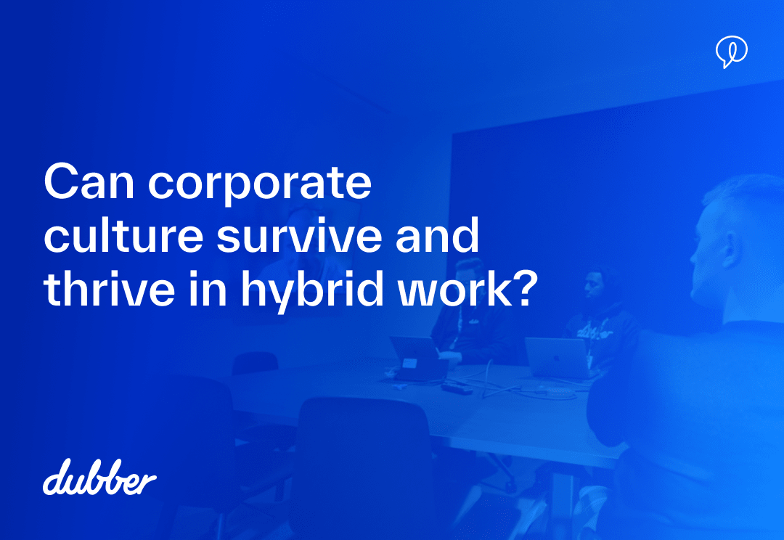
“The Pandemic has forever changed the trajectory of the work environment. CxOs understand this but culture, processes and technology are not yet mature enough to meet the expectations of today’s workforce.”
– 2022 Future of Work Study, Incisiv
Corporate culture is an intrinsic part of every business. When caring and order reign, and teamwork, trust, and respect are present, the workplace thrives. When company culture starts going south, employee engagement, loyalty, and retention rates go down, and conflict goes up. It’s a slippery slope, and many businesses have found it difficult to maintain a strong corporate culture in the shift to hybrid work.
Sustaining company culture is one of the top challenges facing businesses today in the shift to hybrid work. Why? Because distance and lack of modernised technology have caused friction in the workplace, which has led to a decline in satisfaction with company culture overall.
“Only 56% of C-suite executives believe they have been able to sustain their organization’s culture while working in a distributed working model”
– 2022 Future of Work Study, Incisiv
Service providers can help bridge the gap that has emerged in company culture by offering solutions that monitor and assess employee wellbeing across distance.
“Companies with strong culture achieve three times higher total return to shareholders than others.” – McKinsey, 2020
Dubber’s conversational analytics empowers businesses to bridge this gap – with insights into employee engagement, satisfaction, and connection collectively across the enterprise, as well as drilling down to the team or individual level. It’s a chance to put an end to not knowing. It’s also a chance to rebuild corporate culture to fit a hybrid work model, utilising the resources you already have to inform decision making. Dubber unifies conversations across all endpoints on phone, mobile, and Unified Communications platforms such as MS Teams, Cisco Webex, and Zoom for the full picture.
How conversational intelligence boosts company culture in hybrid work
- Know your people and teams with real-time sentiment analytics – by meeting, team or company-wide, whether in-person or online
- Replay, share and evidence crucial conversations to coach and resolve interpersonal issues based on exactly what was said in remote meetings
- Reduce meeting overload and burnout by enabling team members to quickly surface the parts of meetings relevant to them without having to attend the meeting
- Discover when teams are not communicating enough, to re-evaluate and reignite modern team-building practices
Service providers can enable their customers by offering Dubber as an essential service alongside their remote communications tool stack. Ask us how Dubber can help double your revenue on every endpoint.
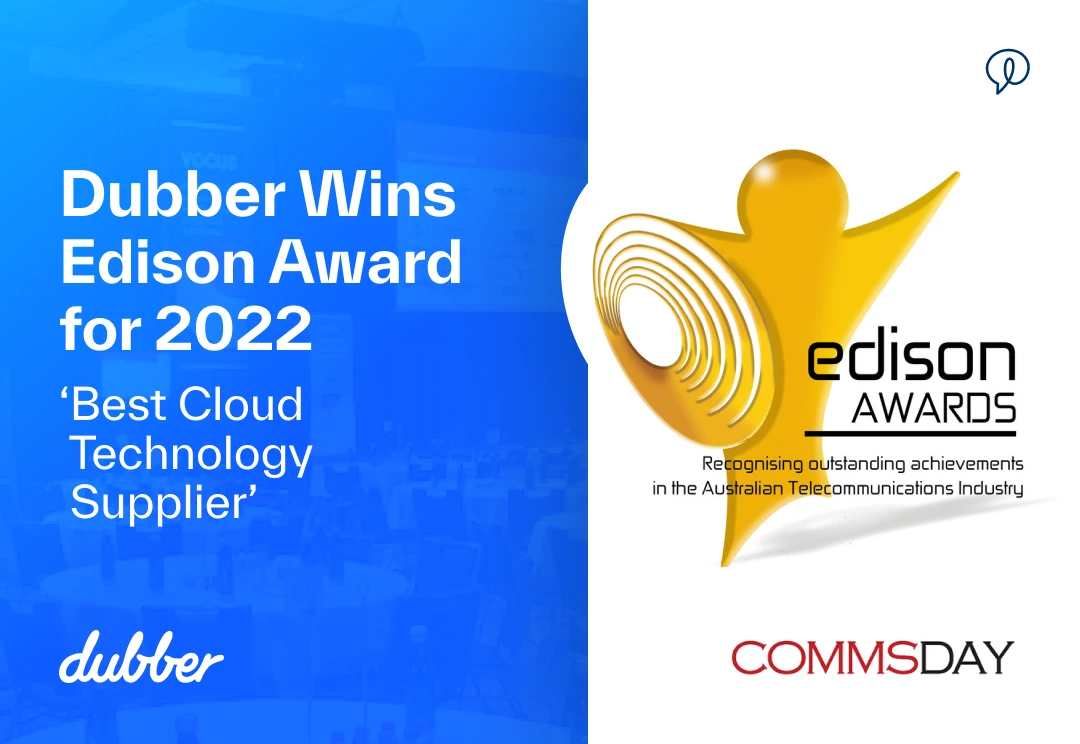
Melbourne, Australia – 4 May 2022 — Dubber Corporation Limited (ASX: DUB) (Dubber) is pleased to announce that it has been awarded “Cloud Technology Supplier of the Year” by CommsDay, at the CommsDay Summit in Sydney today.
The CommsDay Summit is Australia’s peak service provider event, drawing over 300 delegates and speakers from the service provider industry and government. The summit returned to an in person event this year after a two-year hiatus due to the Covid-19 pandemic. Keynote speakers focussed largely on dynamic industry transition and presentations were provided by Dubber CEO Steve McGovern along with Federal Communications Minister Paul Fletcher, Shadow Communications Minister Michelle Rowland, ACCC commissioner Anna Brakey, TPG Telecom CEO Inaki Berroeta, Vocus CEO Kevin Russell and other key industry executives.
Steve McGovern, CEO, Dubber: “We are delighted to have been selected as the Best Cloud Technology Supplier by CommsDay’s Edison Awards. This award is further recognition of Dubber’s role as a truly global platform that is helping service providers and cloud communications platforms transform the way they think about, and deliver, their services. With leading service providers globally utilizing the Dubber platform, we believe we are uniquely placed to be able to help carriers add value to their network offerings in a completely new way, by taking advantage of the content and conversations that are traversing their networks.”
Dubber’s cloud-native recording and intelligence solution is built to be embedded in telecommunications networks and unified communications solutions globally, unlocking the potential in every conversation with AI-enriched conversational data. The Dubber platform has been adopted by over 170 service providers globally including Telstra, Optus, AT&T and BT.
Grahame Lynch, CommsDay Founder: “Dubber has emerged as a truly underappreciated national treasure: developing an Australian designed call recording cloud solution and successfully exporting that to 170 service providers across the entire world. They are an amazing success story.”
About Dubber:
Dubber is unlocking the potential of voice data from any call or conversation directly from the network. Dubber is the world’s most scalable Unified Call Recording service and Voice Intelligence Cloud adopted as core network infrastructure by multiple global leading telecommunications carriers in North America, Europe and Asia Pacific. Dubber allows service providers to offer recording from virtually any source – turning them into AI-enriched insights for compliance, revenue, customer and people intelligence. Dubber is a disruptive innovator in the multi-billion-dollar call recording industry. Its Software as a Service offering removes the need for on-premise hardware, applications or costly and limited storage.
For more information, please contact:
Investors:
Simon Hinsley
simon.hinsley@dubber.net
+61 (0) 401 809 653
ANZ Media
Terry Alberstein
terry@navigatecommunication.com.au
+61 (0) 458 484 921
EMEA Media
Annabel Clementson
annabel@wearetfd.com
+44 7951 786435
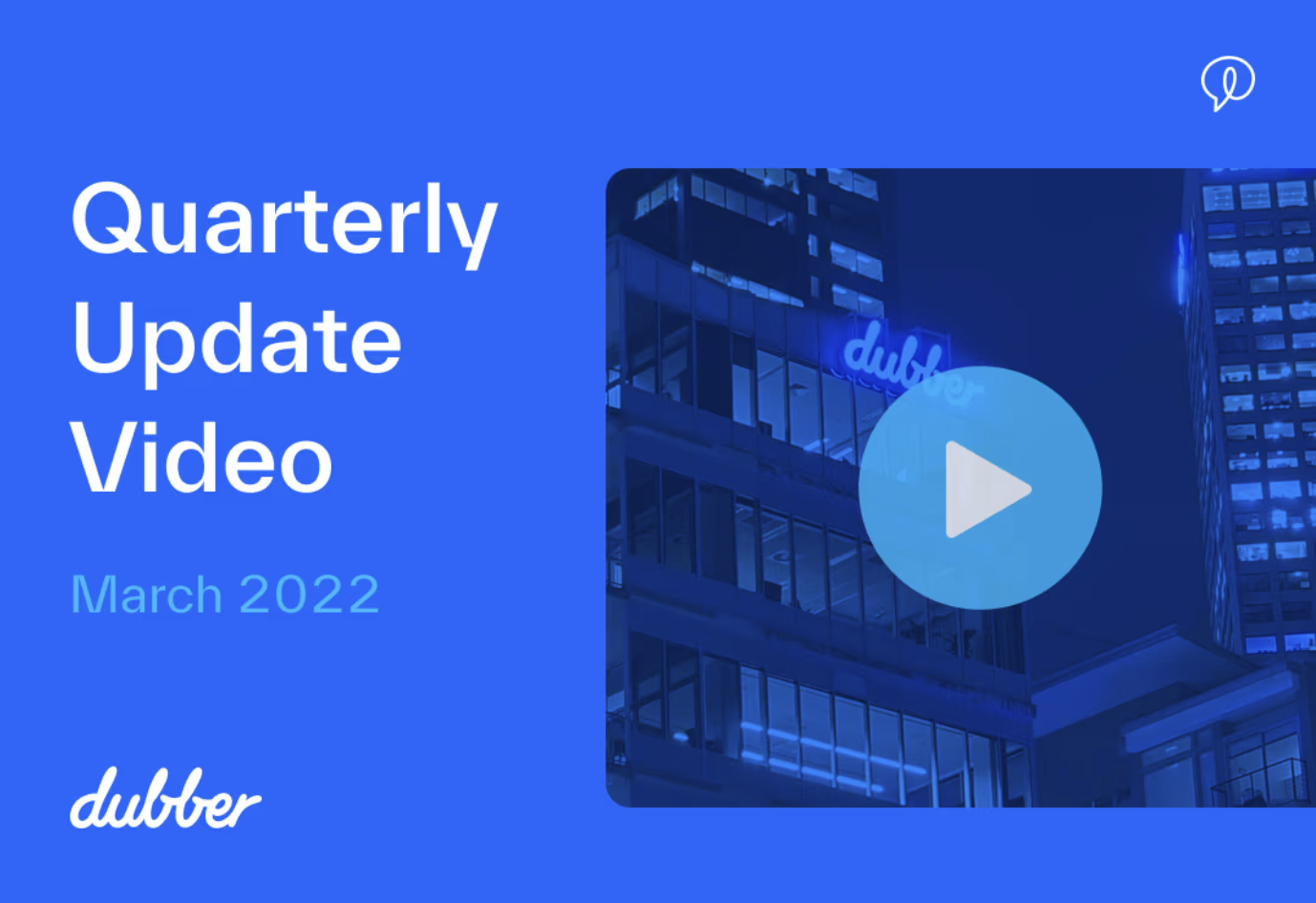
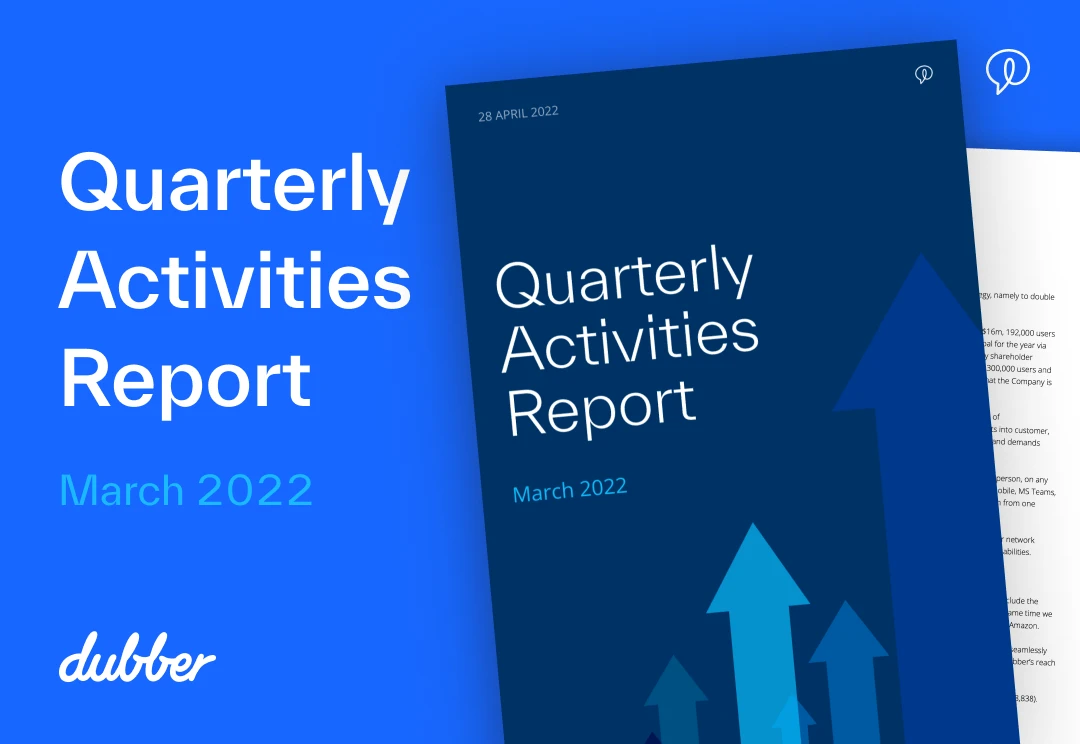
Dubber Corporation Limited (ASX: DUB) (‘Dubber’ or ‘the Company’), the leading global Unified Call Recording & Voice Intelligence cloud platform which provides innovative world leading products directly via Service Provider networks, today released its report on the Company’s operating activities along with the Appendix 4C for the quarter ended 31 March 2022.
Highlights within the Quarter:
- ARR increased by $5.1m QoQ to $55.1m (62% pcp)
- Revenue for 12 months to March 2022 was $33.7m consistent with reported ARR at March 2021
- Revenue increased by $900,000 QoQ to $9.25m (40% pcp)
- Cash receipts increased by $2.9m QoQ to $8.5m
- Net cash outflows decreased by $7.1m
- Dubber subscribers exceed 540,000
- Launch of Notes by Dubber at Mobile World Congress
- Finalised multiple network UCR agreement with TDC Nuuday of Denmark
- Established core infrastructure for acceleration of future growth
- Dubber is fully funded with in excess of $97.5m cash on hand
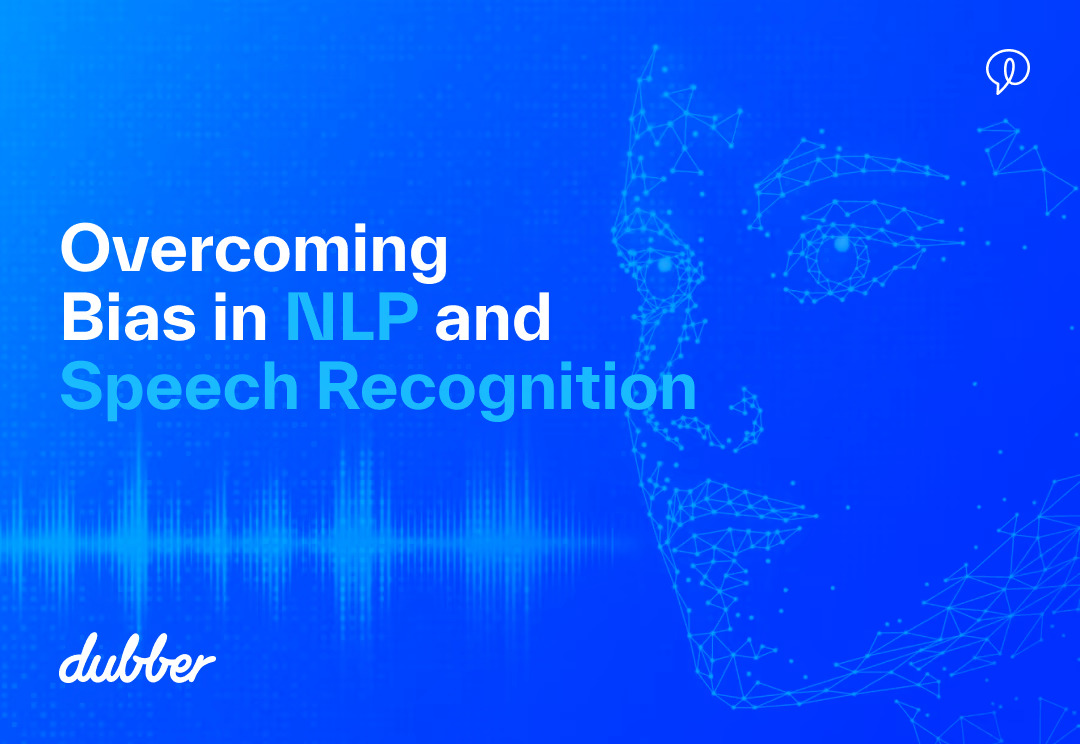
Iain McCowan, Director of AI at Dubber on Natural Language Processing, speech recognition and how to overcome the issue of bias in this technology
Natural Language Processing (NLP) is a specific type of AI technology that allows computers to comprehend text and speech, similarly to how a human would.
The practical implications and benefits of this technology are significant to business success. Now, computers are able to process, analyse and understand a wealth of information, not just from written text sources like libraries or the internet, but also from spoken conversations such as business meetings. With this, for example, organisations can have meetings automatically transcribed, saving a huge amount of time and money.
Some examples of how the application of NLP – specifically in – can help a business succeed are through:Looking specifically at speech-to-text and analysis, there is a number of applications where this type of technology can support businesses.
NLP can analyse the sentiment in customer conversations in real-time, alerting managers to potential conflicts requiring assistance, or suggesting to the operator a different script to follow. It can also gather the most important or impactful topics and themes raised in a meeting and turn them into meeting minutes, including action items.
With the ability to gauge employee engagement in particular projects, the technology can either support staff who are less engaged or offer enablement to those most engaged.
Finally, by determining customer interest levels in different brands, products or services during conversations, businesses can gain market insight through the analysis of speech. Despite these significant benefits, one key issue with this technology is bias. To learn more, we spoke to Iain McCowan, Director of AI at Dubber who shared his insight.
Why are there issues of bias in NLP and speech recognition? How does it occur?
Modern NLP models are trained on large datasets, so ultimately most bias comes from any bias inherent in the dataset. With the USA being the most significant economy, and the place where many recent NLP technologies have been birthed, historically, there have been significantly more language resources for US English than any other language or dialect. This has meant that most speech and language technologies, to this day, still provide the best accuracy and richest features for US English users. Another bias factor that may be present in data is historical bias, in which older training datasets may reflect outdated society stereotypes or biases.
In recent years, the bias from training data has been addressed through two main approaches:
- Collecting and improving the availability of more varied and up to date language datasets. An example of this is the Common Voice project by Mozilla.
- Focusing research on methods that improve performance for low resource languages, such as so-called self-supervised learning to pre-train NLP models that can be used for a range of end tasks without needing large annotated datasets. This makes it easier to learn models for less common languages where there aren’t many available large annotated datasets. One example is XLM-R.
These approaches can be used to address not just language diversity, but also to reduce bias against any under-represented population.
How does bias manifest itself in speech recognition software? What are the implications?
Bias can occur in speech recognition and NLP within a business in multiple ways, due to natural variations in speech and language usage that arise from factors such as personality, occupation, education, age, gender, etc.
Fundamentally, the most glaring bias issue in current systems is when speech-to-text recognition software simply misunderstands the speaker, and the incorrect words are noted down – or missed completely. For all intents and purposes, if we are trying to do processing and analysis of the spoken word, this speaker has no voice.
There are many reasons that misunderstanding of a speaker can occur:
- If the is multi-language and the business lacks the same breadth of languages in speech recognition systems and NLP models. With 7000+ languages across the globe, to be equitable to all employees, clients, partners, and customers, a business must ensure their NLP solutions provide equitable coverage of all languages spoken within and across the bounds of their organisation.
- Regionally, there are different dialects and accents that are unique, from US to UK English, Spanish as a second language speakers, African-American Vernacular English, and even differences between states in Australia. The models used must accommodate for all these to accurately understand what was said by all speakers.
- Different gendered speakers, and also children and elderly speakers may also sound different, so models must include these.
- Speakers with speech impairments can be misunderstood, so models must be trained to accommodate these people.
What is needed to overcome and regulate bias in NLP technology?
For NLP technology providers, there is a need to improve the diversity in underlying training data, as well as increase research into methods to improve performance for low resource scenarios, such as under-represented languages, dialects, ages or genders.
Businesses that are clients of NLP technology can influence this by insisting performance reporting is done across a range of these demographic factors and by selecting NLP technology vendors based on their accuracy across the board.
To reduce bias for their employees and customers, businesses should implement continual monitoring of NLP accuracy to ensure they are always using the best set of NLP technologies to suit their circumstances. This is not just a one-time decision – continual monitoring is required. For instance, the software can be used to alert on circumstances where a particular speaker is not making sense in the speech-to-text – a bias is occurring. By evaluating the speaker carefully, they can then seek to implement new models to accommodate them – and other people like them. A simple way this is often achieved in speech recognition is for employees to read a script during onboarding so that the technology can better learn their individual voices.
Another recent approach to effectively addressing bias is through NLP systems that incorporate active learning loops. This active learning approach allows companies, teams or individual users to provide positive or negative feedback on NLP outputs that allow the models to then adaptively improve for their specific usage over time. This can mean each individual can control and improve the accuracy of systems for their own usage, giving them the power to eliminate negative bias.
By building in activities and automation that help remove bias in NLP systems, businesses can ensure they are engaging ethically with all speakers, allowing everyone to be truly heard. Sharing voice data sets publicly, stripped of proprietary information, can also help evolve language models to be more inclusive.
This article originally appeared in AI Magazine.
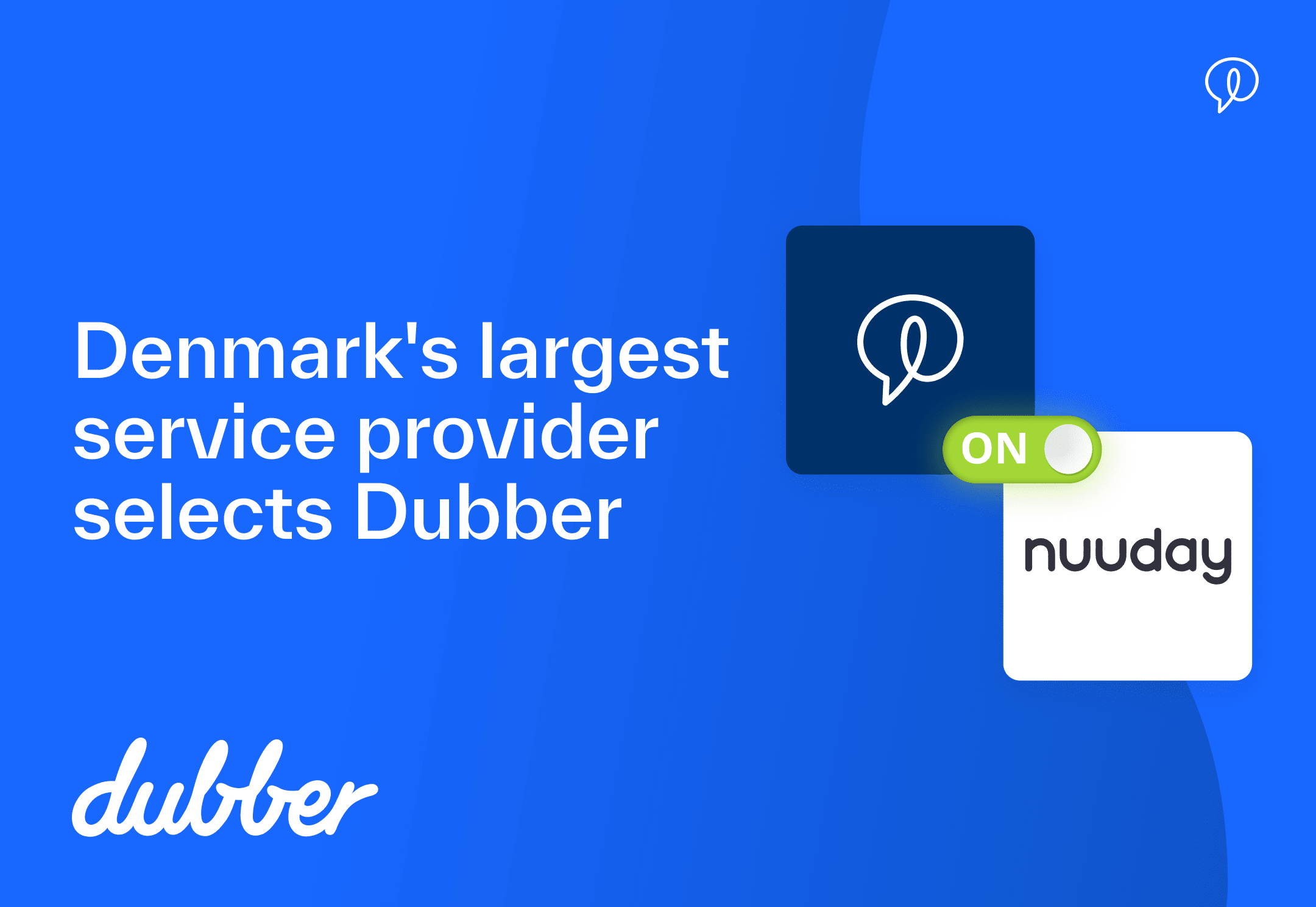
- Nuuday is Denmark’s largest telecommunications service provider
- Nuuday to deploy Dubber recording and AI for mobile and Unified Communications (UC)
- Nuuday to migrate existing recording users to Dubber platform
- Builds Dubber footprint across Nordics
- Service launching in Dubber Q4 FY2022
Melbourne, Australia – 23 March 2022 — Dubber Corporation Limited (ASX: DUB) (Dubber) is pleased to announce that its Unified Call Recording (UCR) and Voice AI platform has been selected by Denmark’s Nuuday for unified call recording and voice AI for mobile and unified communications (UC) customers.
Nuuday is Denmark’s largest telecommunications service provider, part of the national carrier TDC Group/ TDC Holding A/S. Dubber services will be available for TDC Erhvervs (a Nuuday brand) customers on their mobile and Unified Communications (UC) solutions in the first half of 2022. The deployment will also provide for the migration of all existing on-premise call recordings to the Dubber cloud platform, maintaining or exceeding compliance standards under legacy customer agreements.
Dubber UCR services will also be immediately available on TDC Scale, Nuuday’s Unified Communications solution for enterprise customers, while migrating existing recording services, and call recording data to the Dubber platform. This implementation will enable Nuuday customers to seamlessly add Dubber products to their existing Nuuday UC services while allowing for the rollout of additional Dubber solutions onto the TDC Scale service.
John Henriksen, CEO, TDC Erhverv: “Our new partnership with Dubber will provide a scalable and secure solution to meet our customers’ call recording requirements, across their mobile and Unified Communications services. Dubber’s solutions will easily integrate with our existing infrastructure and service offerings for all Danish businesses, reinforcing our ambition to constantly innovate to meet customers’ needs. With UC transforming the way businesses communicate, solutions like Dubber provide much-needed, secure and compliant functionality.”
Steve McGovern, CEO, Dubber: Nuuday is a recognised industry leader and one of the most progressive carriers in the European unified communications sector, with one of the largest customer bases on its Cisco/Broadworks UC network. We are delighted to be upgrading Nuuday’s existing recording installed base to the Dubber platform. These legacy services will now have all the inherent benefits of Dubber’s cloud platform, including fully compliant storage, search, transcription, and sentiment analysis – providing Dubber with an accretive increase to our ARR. Provisioning of the Dubber Platform across a broad addressable market will also enable Nuuday to utilise AI to transform data into valuable insights, driving revenue, retention, and differentiation. In addition, Dubber’s cloud-native, simple-to-deploy call recording platform provides Nuuday with an infinitely scalable solution that will grow as their customer needs grow.”
“Our agreement with Nuuday is another important milestone in establishing Dubber as the defacto call recording and conversational AI service for a telecommunications service provider. Through our innovative technology and partnering approach, we can deliver scale, carrier-grade performance and integration in the cloud, and the partnering model to enhance revenue for our service provider customers significantly,” added McGovern.
The Nuuday agreement will provide an accretive revenue stream for Dubber, with additional revenues determined by uptake of the services by Nuuday customers. This ASX announcement has been approved for release to ASX by Steve McGovern, CEO & Managing Director.
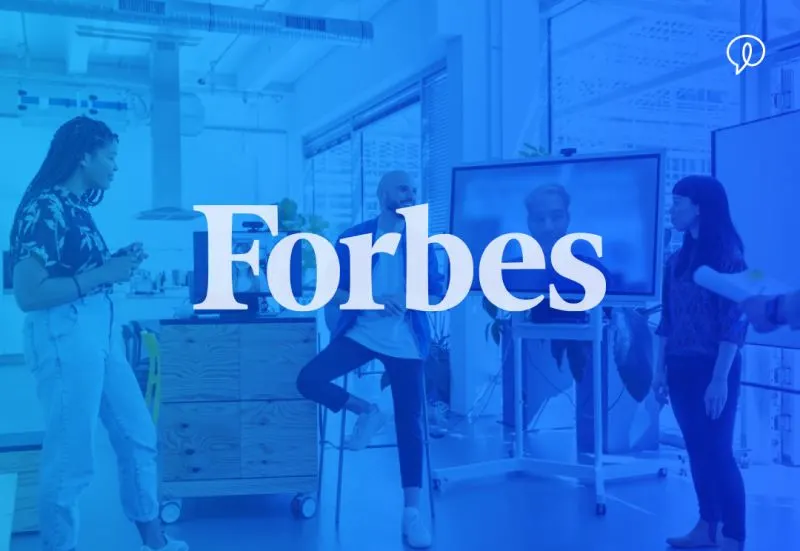
As companies are announcing their return-to-office policies, it appears that the trend heavily leans toward the hybrid model. After two years of people working remotely, the hybrid model—understandably—seems like a practical way to ease into commuting and working in an office setting.
To learn more about what businesses are doing regarding how people will work in the post-pandemic environment, AT&T launched a new future-of-work study. “The State of the Industry: Future of Work” survey, conducted on behalf of AT&T and Dubber Corporation Limited, was composed of 303 United States-based respondents, 87% above director level, across five key industries, with more than one million employees represented and 34% with companies over $1 billion in revenue.
The survey was created to gain insights from senior executives regarding current and future work models, challenges posed under new working models and technology accelerants to aid change in the way that businesses conduct work out to 2024.
Hybrid work isn’t without challenges. For instance, people complained that they were forced to commute three hours roundtrip to work in a cubicle, only to find that the folks they need to collaborate with aren’t even in the office. The person is left feeling frustrated, fuming that they are sending emails and jumping on Zoom calls in the office by themself, when they could have been home, saving the commute time and money for gas.
The results reveal that while hybrid is the preferred choice by many businesses, 72% of businesses lack a clear hybrid work strategy. The findings also show other sentiments and challenges around Covid-driven hybrid working, including lack of innovation, insufficient oversight, and cultural shifts.
This and other reasons have caused executives in the study to say, that although hybrid work will be “the default by 2024,” leadership is “exploring ways to overcome barriers caused by the new model of work, such as building culture remotely and the application of technology—specifically artificial intelligence (AI) and machine learning (ML)—in critical business use-cases.”
Alicia Dietsch, senior vice president of business marketing at AT&T, said about the survey, “There’s been a non-reversible shift in the way business is done thanks to the constraints of Covid-19. It’s clear that a successful talent program now requires a hybrid work policy, but that policy needs to be supported by a strategic tech-first cultural reset, to ensure business growth and competition.” Dietsch pointed out, “Firms need to ask themselves if they have the in-house expertise to achieve this, or whether it’s now time to go beyond a partner in remote infrastructure rollout to a partner in tech-first remote business strategy.”
Highlights Of The AT&T Study
- Hybrid work will be the default by 2024, and half of work will be performed offsite: 81% believe hybrid work will be the foremost working model by 2024, with 56% of work done off-site
- Vast majority of businesses lack a detailed hybrid work strategy: 72% lack a detailed strategy and 76% don’t have the right key performance indicators (KPIs) to support hybrid working models
- Tension between what employees want and what organizations prefer: 86% believe their employees prefer a hybrid work model, but 64% believe their organization prefers an on-premise work model
- 100% of respondents believe a hybrid work model will help attract young talent
It’s interesting to note how quickly things have changed. Last year redefined how companies conducted business with just 24% of respondents’ employees working onsite. Before Covid-19, these nontraditional work models were more likely to be viewed as employee perks.
Lack of workplace innovation, insufficient oversight, and cultural shifts were identified as three barriers to successful hybrid work, but respondents believe they’re not insurmountable. With investment in strategy, building culture remotely, and the application of technology—specifically AI—in critical business use cases, firms can transition to a successful hybrid-first work environment.
The top challenges to effective hybrid work identified by the chief experience officer—a C-suite business executive responsible for a company’s overall experience—include maintaining employee oversight, losing institutional or tribal knowledge, and sustaining company culture—all traditionally highly associated with in-person work.
Mass adoption of new work models has shown to be partially effective, with 79% of firms believing that employees have been productive, although not without resulting challenges, with only 45% confident in employee innovation throughout the period.
Gaurav Pant, cofounder and chief insights officer at Incisiv, said about artificial intelligence and machine learning, “Covid-19 has been the single most transformative event in shaping the future of work. Attitudes toward working models have dramatically transformed over the last 24 months, and the ‘hybrid’ working model will soon become the default. Firms need to upgrade their employee technology stack and undergo a cultural reset to prepare for this new normal.”
Artificial intelligence and machine learning were identified as the top transformative technologies in the survey, with their intrinsic value identified specifically in the areas of employee training, intelligent enterprise search and learning, and conversational help.
The research shows that while employee productivity is maturing, with high analytics adoption, other areas like revenue leakage and employee retention require further investment. A need for deeper analytics and insights, driven by AI, into both the customer and employee can be accomplished by mining and transforming data from remote conversations and interactions to build new models of operation in targeted business functions.
“We’ve taken the first steps into a ‘work-from-anywhere’ world. Removing employees from the workplace was necessary, but creating distance wasn’t,” said Steve McGovern, CEO of Dubber. “Our technology is served directly from AT&T’s networks, as part of an AT&T service enabling organizations to capture every conversation and turn them into data and seamlessly share insights as desired. Knowing and understanding how employees are performing and, indeed, their general welfare can have significant impacts on how businesses manage this hybrid workplace environment. This can be achieved via immediate customer insight including, for example, real-time sentiment analytics. AI makes it possible to mine this vast treasure trove of information,” McGovern added.
“Businesses moved with urgency to distance employees. Now, they need to do the same when it comes to deploying the tools needed to overcome distance. Closing the gap between a business and their customers and employees should be a priority for every executive and it’s available directly from the AT&T service.”
Hybrid Work: The New Way to Work
The “Future of Work” study highlighted that while many firms responded to a shift in working models as needed, this largely resulted in “Band-Aid” solutions to enabling hybrid work, with the majority lacking a detailed strategy to support it. The resulting length of time working remotely is now driving a cultural and technology reset in business to which AI and ML will be critical in delivering advanced functionality to drive innovation and collaboration.
- Hybrid work to advance diversity: 91% believe a hybrid work model will improve workforce diversity
- Cultural shift required: 58% believe they don’t have the culture to sustain a hybrid work model
- Hybrid working is impacting innovation and collaboration: 79% believe hybrid working is effective in driving productivity, but 45% feel it does not support innovation and 54% see it impacting collaboration
- Conversational help: 71% believe that AI and ML in conversational help will have an important business impact
- AI & ML in conversational insights is transforming work: With the tech having a high impact on employee productivity, customer intelligence, attracting new talent, revenue leakage, call center intelligence, and retaining talent
This article originally appeared in Forbes on 16 March 2022.

Solving compliance on Microsoft Teams
Businesses need to record their Microsoft Teams calls for various compliance reasons: including limiting liability, resolving disputes, and providing evidence of advice given, transactions, and trades.
Using Teams, shouldn’t mean compromising the compliance standards you set out to achieve or investing in more capital expenditure. The need for a unified and cost-effective approach to communication capture has never been more urgent.
What you’ll find inside
This guide will show how to create a secure, compliant and scalable system of record for every conversation – across Microsoft Teams and other communication channels in your business.
Learn
- Why compliance call recording is essential for Microsoft Team
- Why on-premise and hosted recording solutions aren’t viable post-COVID
- The 15 most important factors in choosing the right call recording solution for your needs

Are you ready for what comes next?
Download the whitepaper by leading telecommunications industry analyst firm Cavell Group, to discover the key trends impacting service providers and what every service provider needs to do next.
See What’s Inside
2022 will see the next major shifts in the global communications landscape. From a reassessment of the solutions deployed in the first wave of the pandemic through to the continued and rapid evolution business models to grow revenue, improve operating performance, and drive retention and differentiation.
This paper seeks to highlight key trends and potential paths forward for service providers.
Learn about:
- The key telecommunications industry trends including new and emerging competitors
- New ways to create value using a multipronged approach
- Emerging user trends driving new strategy such as fragmentation of communication
“Successful service providers will be driven by addressing short-term opportunities to seize untapped growth with a holistic approach to transformation.”
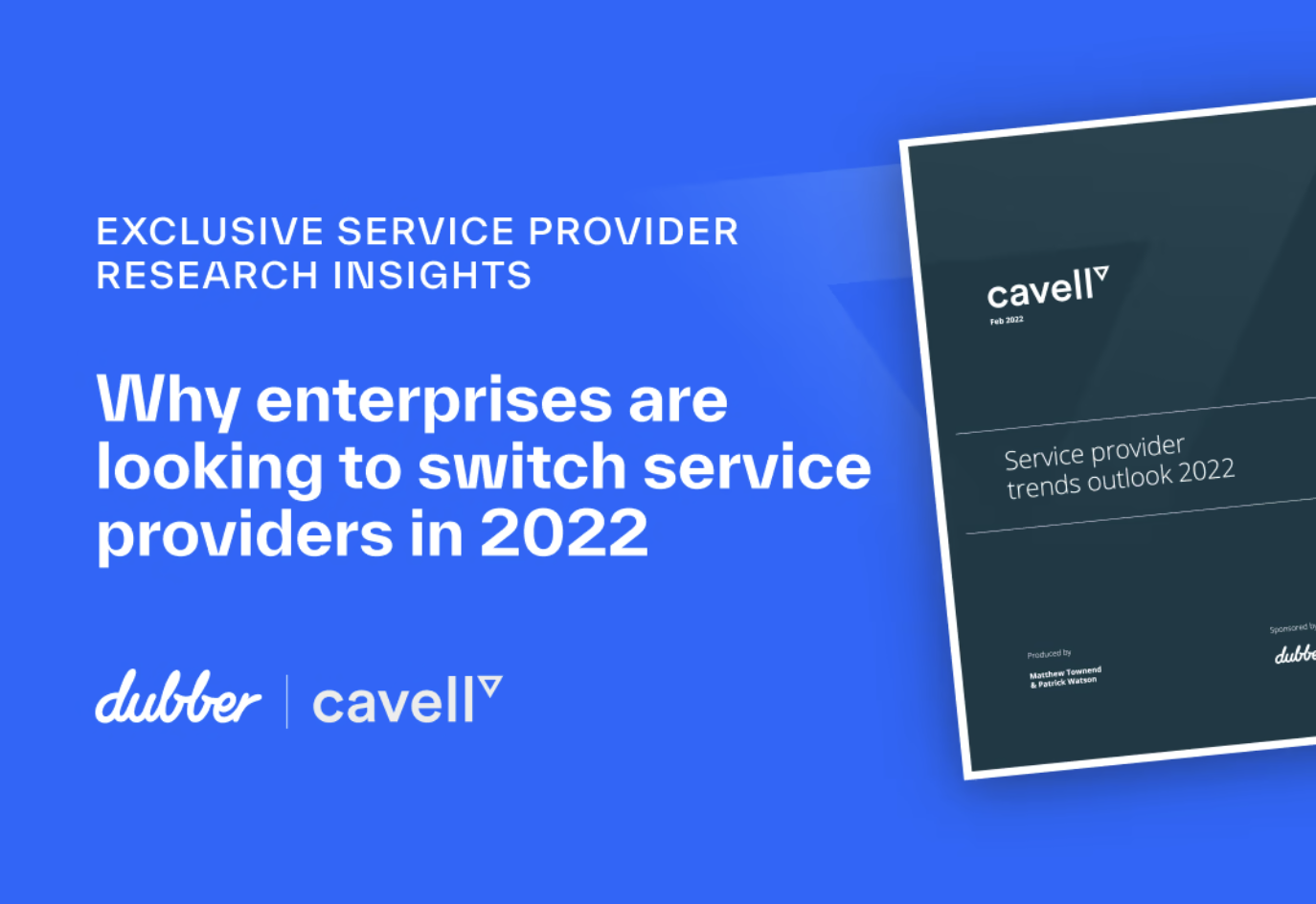
Barcelona, Spain (Mobile World Congress) and Melbourne, Australia – 2 March 2022 — Dubber Corporation Limited (ASX: DUB) (Dubber) today launched the results of a commissioned research study by Cavell Group, identifying the top trends service providers globally will be focusing on in 2022.
Throughout all the trends identified in the Cavell report, the lasting impact of the global pandemic on service providers and their business operations are clear. During the first wave of the pandemic, enterprises and carriers sought to rapidly deploy solutions to support remote access and business continuity. Now, these efforts are being superseded by a second imperative as enterprises seek to improve “band-aid” responses and address a more permanent state of hybrid working. In almost all areas of their business, service providers will continue to adapt to the dramatic changes in the workforce behaviour patterns that emerged in the global pandemic and will continue into 2022.
Major Trends Identified in the Report Include:
- The rapid rise of unified communications and a proliferation of communications channels have shifted the strategic planning of every service provider, increasing the pressure to create new sources of revenue and buttress margins, and to drive differentiation and retention
- Communication and collaboration solutions will continue to try and recreate in-person experiences. Distributed video, Unified Communication as a Service (UCaaS), Contact Centre as a Service, and CPaaS (Communications Platform as a Service) services will continue to be in high demand.
- Competition with hyper-scalers and OTT providers will intensify in 2022
- Compliance, security, governance, ransomware and risk mitigation solutions will drive a new wave of demand from enterprises as they look for ways to “tighten up” across all major infrastructure, including communications. Agile service providers and managed service providers will look to meet these requirements with new and differentiated service offerings
- Extracting additional value from service provider data, voice data, and other analytics services will provide service providers opportunities to differentiate their service offerings
Steve McGovern, CEO, Dubber: “As service providers move into 2022 and transition beyond the severe impacts of Covid-19, a set of new trends are poised to reshape the service provider landscape again. Dubber believes that 2022 will be a pivotal year for the global service provider industry as carriers seek to grow and adapt to the changes brought on by the mass distribution of workforces of the last two years. While the roll out of 5G services will continue to grab headlines in many countries, even bigger threats and opportunities exist that will remake what we view the traditional role of a service provider to be. We are very optimistic that strong growth opportunities will be available for Dubber and our service provider partners as we drive voice data and new value-added services that will improve business outcomes for our joint customers in the year ahead.”
Matthew Townend, Executive Director, Cavell Group: “The first wave of the global pandemic rapidly accelerated unified communications and mobile, changing the service provider landscape materially. The second wave will not be the same, with enterprises looking to bolster solutions deployed in the first with greater security and compliance; adapt to hybrid working as a permanent way of working; and secure greater intelligence and compliance from content. AI and automation based on conversational data are new frontiers for service providers and represent a significant opportunity to improve revenue, differentiation and retention.”
Resources:
About Dubber:
Dubber is unlocking the potential of voice data from any call or conversation. Dubber is the world’s most scalable Unified Call Recording service and Voice Intelligence Cloud adopted as core network infrastructure by multiple global leading telecommunications carriers in North America, Europe and Asia Pacific. Dubber allows service providers to offer conversational recording from virtually any source – turning them into AI-enriched insights for compliance, revenue, customer and people intelligence. Dubber is a disruptive innovator in the multi-billion-dollar call recording industry. Its Software as a Service offering removes the need for on-premise hardware, applications or costly and limited storage.
About Cavell Group:
Cavell Group is an EMEA-focused research, consulting, engineering and education services business with offices in Amsterdam, Brussels, London, and remote associates worldwide. Known as a leading provider of insight into the cloud communications and managed services markets, a key source of market intelligence for service providers, vendors and potential investors, Cavell Group was formed nearly 20 years ago, by a team of senior executives, who had been instrumental in building the early internet market both at UUNET and Level 3. Since 2003, the firm has delivered consulting services, research, due diligence and professional services solutions in over 50 countries worldwide. Cavell has built a strong reputation as leading analysts of the cloud communications market, providing strategic consulting and research in EMEA and the USA to service providers, vendors, manufacturers and private equity firms.
European/Mobile World Congress Media
Annabel Clementson
annabel@wearetfd.com
+44 7951 786435
A/NZ Investors
Simon Hinsley
simon.hinsley@dubber.net
+61 (0) 401 809 653
A/NZ Media
Terry Alberstein
terry@navigatecommunication.com.au
+61 (0) 458 484 921
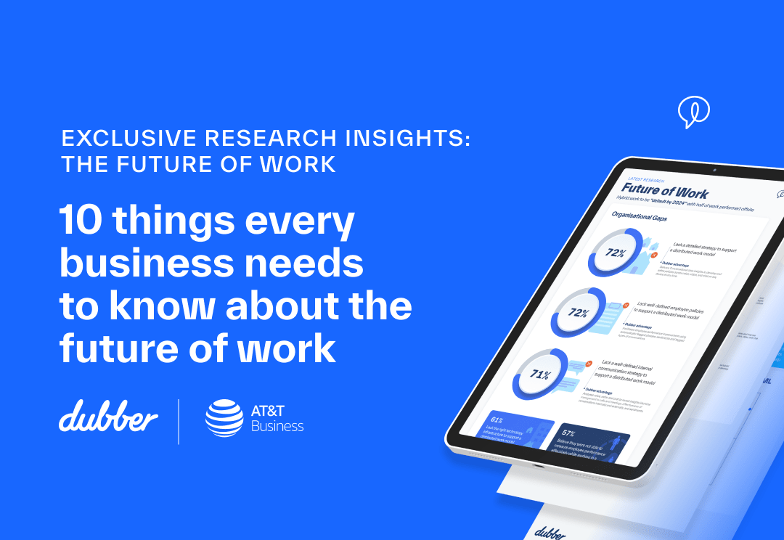
Dubber and AT&Ts “The Future of Work” study highlighted that while many firms had responded to a shift in working models as needed, this had largely resulted in “band-aid” solutions to enabling hybrid work, with the majority lacking a detailed strategy to support it.
The resulting length of time working remotely is now driving a cultural and technology reset in business – to which AI and ML will be critical in delivering advanced functionality to drive innovation and collaboration.
- Hybrid work the default by 2024: Half of work performed offsite: 81% believe hybrid work will be the foremost working model by 2024, with 56% of work done offsite.
- Oversight of employees challenged: C-level executives ranked employee oversight, losing institutional/tribal knowledge and sustaining culture as the primary challenges.
- Clear gap between C-suite and operational executives: Operational executives ranked onboarding, the lack of a comprehensive strategy, and technological debt as more significant than C-level executives.
- Tension between what employees want and what organizations prefer: 86% believe their employees prefer a hybrid work model but 64% believe their organization prefers an on-premise work model.
- Hybrid working strategy and policies are critical to talent attraction: 100% believe a hybrid work model will help attract young talent. 97% believe a hybrid work model will help attract new talent.
- Hybrid work to advance diversity: 91% believe a hybrid work model will improve workforce diversity.
- Cultural shift required: 58% believe they don’t have the culture to sustain a hybrid work model.
- Hybrid working is impacting innovation and collaboration: Hybrid working seen as effective in driving productivity – 79% but not supporting innovation – 45% and impacting collaboration – 54%.
- Conversational AI will make a difference: 71% believe that AI and ML in conversational help will have an important business impact.
- AI & ML in conversational insights is transforming work: With the tech having a high impact on Employee Productivity, Customer Intelligence, Attracting New Talent, Revenue Leakage, Call Center Intelligence, and Retaining Talent.
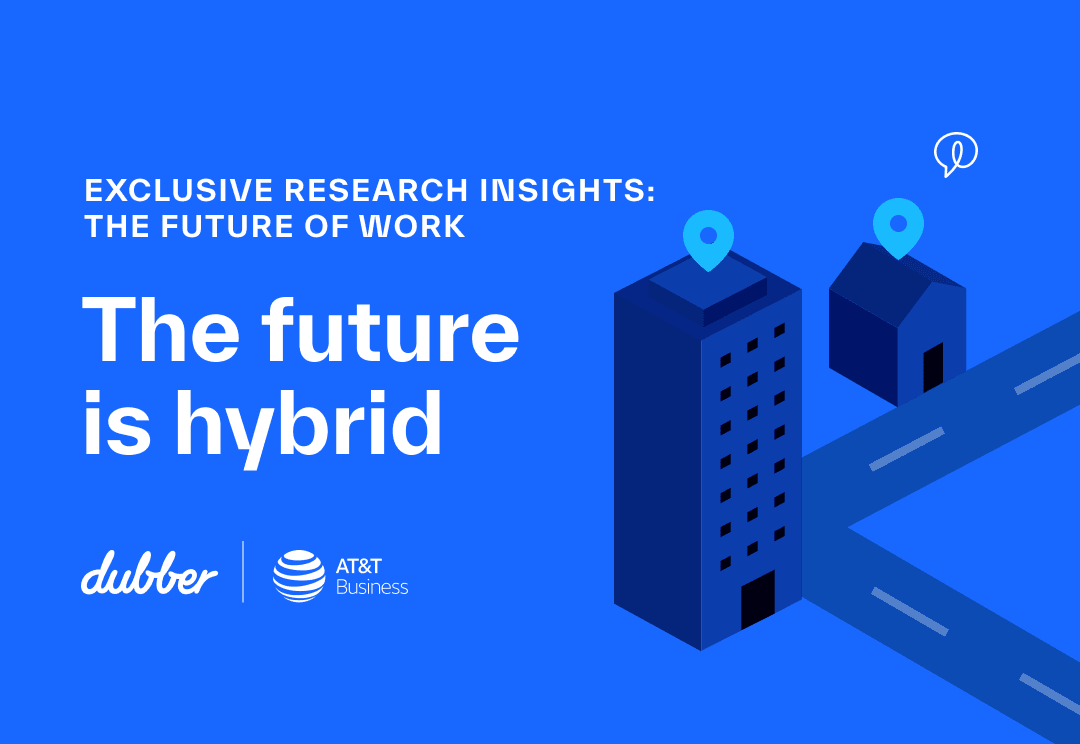
DALLAS and Melbourne, Australia – March 1, 2022 — AT&T* and Dubber Corporation Limited (ASX: DUB) (Dubber) today announced the results of primary market research gauging executive and employee attitudes to COVID-driven hybrid working.
The State of the Industry: Future of Work survey was created to gain insights from senior executives regarding current and future work models, challenges posed under new working models, and technology accelerants to aid change in the way that businesses conduct work out to 2024.
The research shows hybrid work – a mixture of onsite and remote work – will become the standard operating model across industries by 2024. Striking results included:
- Hybrid work the default by 2024, half of work performed offsite: 81% believe hybrid work will be the foremost working model by 2024, with 56% of work done offsite
- Vast majority of businesses lack a detailed hybrid work strategy: 72% lack a detailed strategy and 76% don’t have the right key performance indicators (KPIs) to support hybrid working models
- Tension between what employees want and what organizations prefer: 86% believe their employees prefer a hybrid work model but 64% believe their organization prefers an on-premise work model
- 100% of respondents believe a hybrid work model will help attract young talent
2021 was identified as a redefining year in how companies conducted business with just 24% of respondents’ employees working onsite. Before COVID-19, these non-traditional work models were more likely to be viewed as employee perks.
Lack of workplace innovation, insufficient oversight, and cultural shifts were identified as three barriers to successful hybrid work, but participants believed they were not insurmountable. With investment in strategy, building culture remotely, and the application of technology – specifically AI – in critical business use-cases, firms can transition to a successful hybrid-first work environment.
The top challenges to effective hybrid work identified by CXOs include: maintaining employee oversight, losing institutional/tribal knowledge, and sustaining company culture – all traditionally highly associated with in-person work. Mass adoption of new work models has shown to be partially effective, with 79% of firms believing that employees have been productive, although not without resulting challenges, with only 45% confident in employee innovation throughout the period.
Artificial Intelligence and Machine Learning (AI/ML) were identified as the top transformative technologies in the survey, with their intrinsic value identified specifically in the areas of employee training, intelligent enterprise search and learning, and conversational help.
The research shows that while employee productivity is maturing, with high analytics adoption, other areas like revenue leakage and employee retention require further investment. A need for deeper analytics and insights – driven by AI – into both the customer and employee can be accomplished by mining and transforming data from remote conversations and interactions – to build new models of operation in targeted business functions.
Alicia Dietsch, Senior Vice President, AT&T Business Marketing: “There’s been a non-reversible shift in the way business is done thanks to the constraints of COVID-19. It’s clear that a successful talent program now requires a hybrid work policy, but that policy needs to be supported by a strategic tech-first cultural reset, to ensure business growth and competition. Firms need to ask themselves if they have the in-house expertise to achieve this, or whether it’s now time to go beyond a partner in remote infrastructure rollout to a partner in tech-first remote business strategy.”
Steve McGovern, CEO, Dubber: “We’ve taken the first steps into a ‘work from anywhere’ world. Removing employees from the workplace was necessary but creating distance wasn’t.”
“Our technology is served directly from AT&T’s networks as part of an AT&T service enabling organizations to capture every conversation and turn them into data and seamlessly share insights as desired. Knowing and understanding how employees are performing and, indeed, their general welfare can have significant impacts on how businesses manage this hybrid workplace environment. This can be achieved via immediate customer insight including, for example, real-time sentiment analytics. AI makes it possible to mine this vast treasure trove of information.”
“Businesses moved with urgency to distance employees. Now they need to do the same when it comes to deploying the tools needed to overcome distance. Closing the gap between a business and their customers and employees should be a priority for every executive and, it’s available directly from the AT&T service.”
Gaurav Pant, Co-Founder/Chief Insights Officer, Incisiv: “COVID-19 has been the single most transformative event in shaping the future of work. Attitudes towards working models have dramatically transformed over the last 24 months, and the “hybrid” working model will soon become default. Firms needs to upgrade their employee technology stack and undergo a cultural reset to prepare for this new normal.”
Research Highlights & Background: Hybrid Work = The New Way to Work
The Future of Work study highlighted that while many firms responded to a shift in working models as needed, this largely resulted in “band-aid” solutions to enabling hybrid work, with the majority lacking a detailed strategy to support it. The resulting length of time working remotely is now driving a cultural and technology reset in business – to which AI and ML will be critical in delivering advanced functionality to drive innovation and collaboration.
Additional research highlights include:
- Hybrid work to advance diversity: 91% believe a hybrid work model will improve workforce diversity.
- Cultural shift required: 58% believe they don’t have the culture to sustain a hybrid work model.
- Hybrid working is impacting innovation and collaboration: 79% believe hybrid working is effective in driving productivity, but 45% feel it does not support innovation and 54% see it impacting collaboration.
- Conversational help: 71% believe that AI and ML in conversational help will have an important business impact.
- AI & ML in conversational insights is transforming work: With the tech having a high impact on Employee Productivity, Customer Intelligence, Attracting New Talent, Revenue Leakage, Call Center Intelligence, and Retaining Talent.
The Future of Work study from Incisiv was conducted on behalf of AT&T and Dubber Corporation Limited (ASX: DUB) (Dubber), between October 2021 – November 2021. The survey comprised 303 US-based respondents, 87% above Director level, across five key industries, with 1M+ employees represented, and 34% with companies over $1B in revenue.
About AT&T Communications
We help family, friends and neighbors connect in meaningful ways every day. From the first phone call 140+ years ago to mobile video streaming, we @ATT innovate to improve lives. AT&T Communications is part of AT&T Inc. (NYSE:T). For more information, please visit us at att.com.
About Dubber
Dubber is unlocking the potential of voice data from any call or conversation directly from the network. Dubber is the world’s most scalable Unified Call Recording service and Voice Intelligence Cloud adopted as core network infrastructure by multiple global leading telecommunications carriers in North America, Europe and Asia Pacific. Dubber allows service providers to offer recording from virtually any source – turning them into AI-enriched insights for compliance, revenue, customer and people intelligence. Dubber is a disruptive innovator in the multi-billion-dollar call recording industry. Its Software as a Service offering removes the need for on-premise hardware, applications or costly and limited storage.
For more information, please contact:
For AT&T:
Andrea Huguely
+1 (972) 207-8630
Andrea.Huguely@att.com
For Dubber:
Investors
Simon Hinsley
simon.hinsley@dubber.net
+61 (0) 401 809 653
Media
Terry Alberstein
terry@navigatecommunication.com.au
+61 (0) 458 484 921
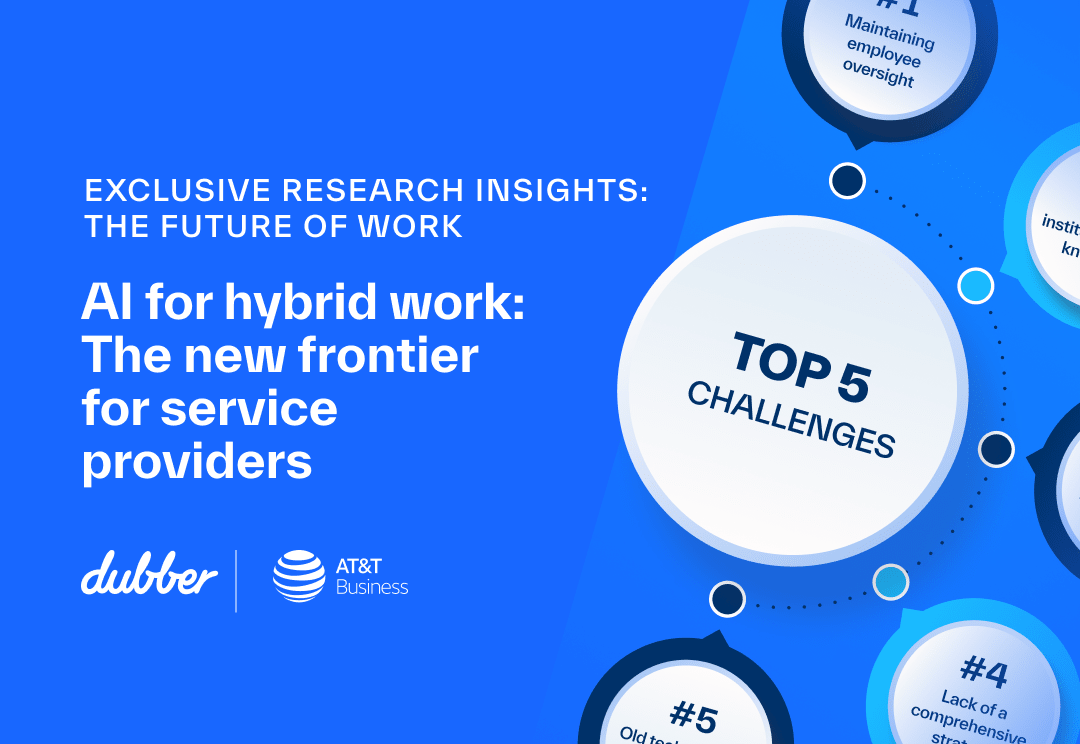
Hybrid work is here to stay, and will be the default working model by 2024.
It’s official, there’s no going back from hybrid work. But are businesses truly ready to run effectively in a hybrid environment? In new research, it’s clear that employees are all for it, but enterprises are accutely aware they don’t yet have the right technology, strategy, and KPIs in place to do it effectively. This is a massive market for service providers to capitalise on – and is just the beginning.
The Future of Work, a new study by Incisiv, conducted in November 2021 on behalf of Dubber and AT&T, surveyed executives across a broad range of industries to uncover insights into the current state of working models, and where businesses will be in 2024.
In Covid-19 recovery, businesses have spoken. Current and future working configurations have significant gaps in employee oversight and talent attraction, revenue leakage, and compliance activities. The only way to resolve these issues is to implement data capture and intelligence across all work communications. This represents a unique opportunity service providers to offer the infrastructure to do exactly this, across the breadth of communications services.
Data capture, aggregation, and analytics across all mobile, UC, video, and chat.
Who else has the capability to offer a unified data capture and analytics solution across mobile, fixed-line, and Unifed Communications services – Webex, Zoom, MS Teams, and more? Service providers must step up to offer enterprises the solutions they need to effectively do business in this new normal.
Unlock new revenue streams by:
- Assisting businesses to deploy optimal hybrid work infrastructure and services
- Rolling out AI/ML solutions for communications platforms and services
Dubber and Notes by Dubber are available for fast deployment across services, embedded in service provider networks. Our cloud-native offerings mean zero CAPEX or product management for you, with sales and service support thanks to our team.
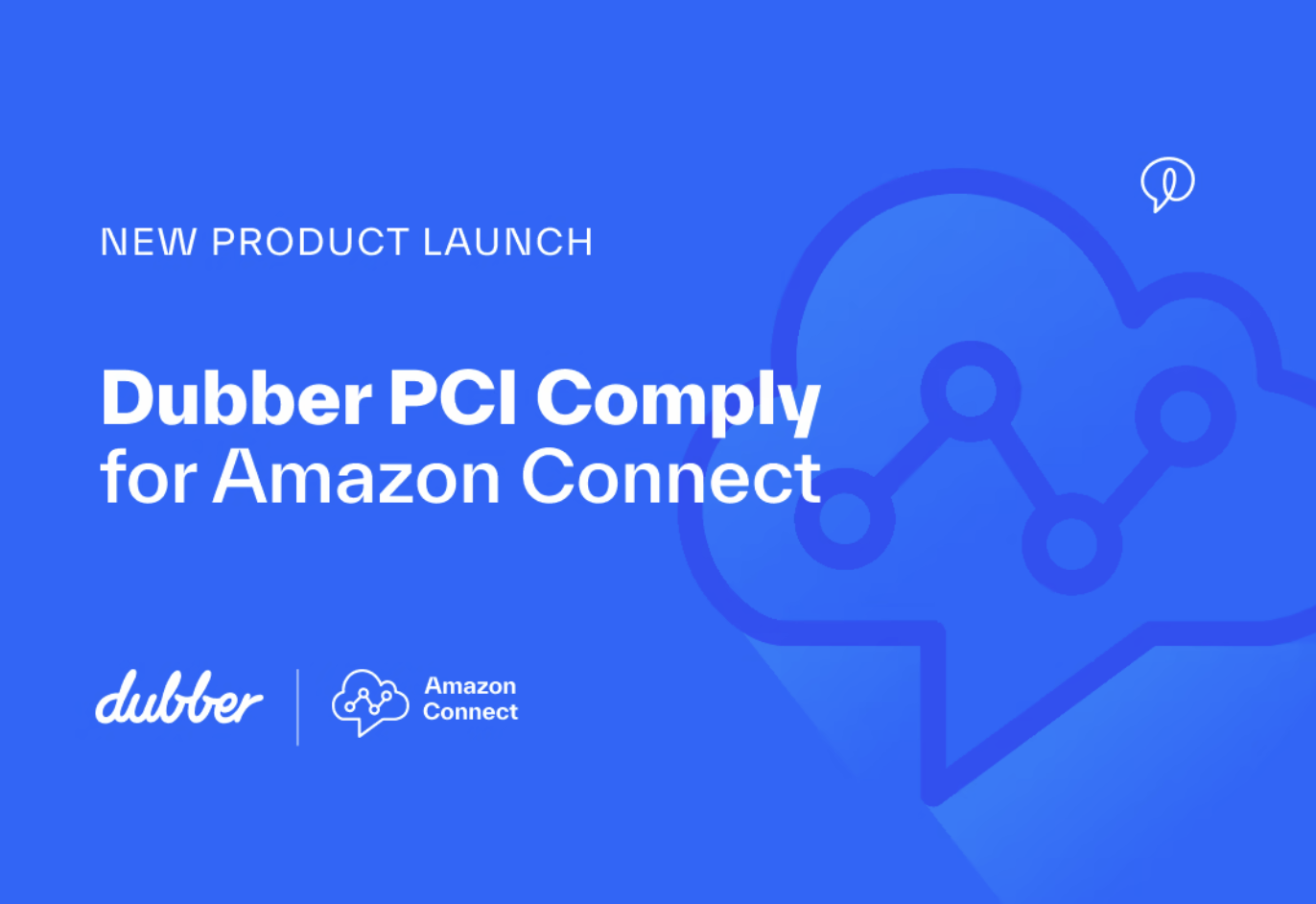
Many credit card processing solutions create serious PCI compliance risks for both consumers and businesses, leaving the door open for fraud, theft, and data leaks. However, with Dubber leading the industry in compliance and enterprise-grade security, a new solution is at hand for any communications on Amazon Connect, including contact centre, voice, IVR, and chat.
“Dubber PCI Comply offers any business seeking to process credit card information a cost-effective and easy to deploy cloud-native solution to achieve efficient PCI DSS compliance for any communication modality on Amazon Connect, including contact centre, voice, IVR, and chat.”
With our fully compliant technology, enterprises can feel secure that customers are not at risk of facing card fraud in payments — as a result, we are very excited to announce the launch of our new product, Dubber PCI Comply for Amazon Connect!
As the first PCI DSS solution for Amazon Connect, Dubber PCI Comply will change the way businesses take payments forever — providing complete security and peace of mind for both the enterprise as well as their customers. Dubber PCI Comply enables certified security and PCI-DSS compliant payments via voice calls, chat, and cloud-based communications platforms. Contact centres with Dubber PCI Comply on Amazon Connect can offer safer options that prevent customers’ credit card data from entering the enterprise environment, instead handling the data capture and processing via a trusted, secure third-party provider.
About Dubber PCI Comply – What does this mean for enterprises?
Dubber PCI Comply empowers businesses to facilitate simple, user-friendly and secure phone payments, ensuring that regulatory demands are satisfied and critical sensitive customer data is protected.
Businesses meet regulatory requirements and obligations around PCI DSS:
Enjoy the benefits of knowing customers’ and internally sensitive business information is protected by Dubber PCI Comply. Seamlessly integrated into Amazon Connect, the solution adheres to PCI DSS compliance standards and prevents any sensitive card data from entering the enterprise environment.
“PCI DSS compliance isn’t satisfied because of the deployment of Amazon Connect alone. It is the instant Dubber PCI Comply is deployed. The moment you start processing credit card transactions, you need PCI Comply. Dubber PCI Comply eliminates the need for, or the possibility that, agents see or enter credit card data. We believe our innovative approach such as via Amazon Connect is the best and most secure way of ensuring PCI compliance.” – James Slaney, COO, Dubber
Dubber PCI Comply to provide security amid customers payment information
Dubber PCI Comply is a secure phone payment platform that’s PCI DSS compliant, VISA Europe approved, PCI DSS V3.2, ISO27001 and BS10008 certified, with the credentials to prove data is safe and secure.
Dubber PCI Comply is secure, simple and effective.
Dubber sets the benchmark for secure payments— with integrations and deployments that are instantaneous and effortless, cloud-based data stored securely, and the flexibility of agnostic PSP or telephony. Confidently meet the demands of overarching regulatory systems to protect customers and businesses. Try out Dubber PCI Comply on Amazon Connect.
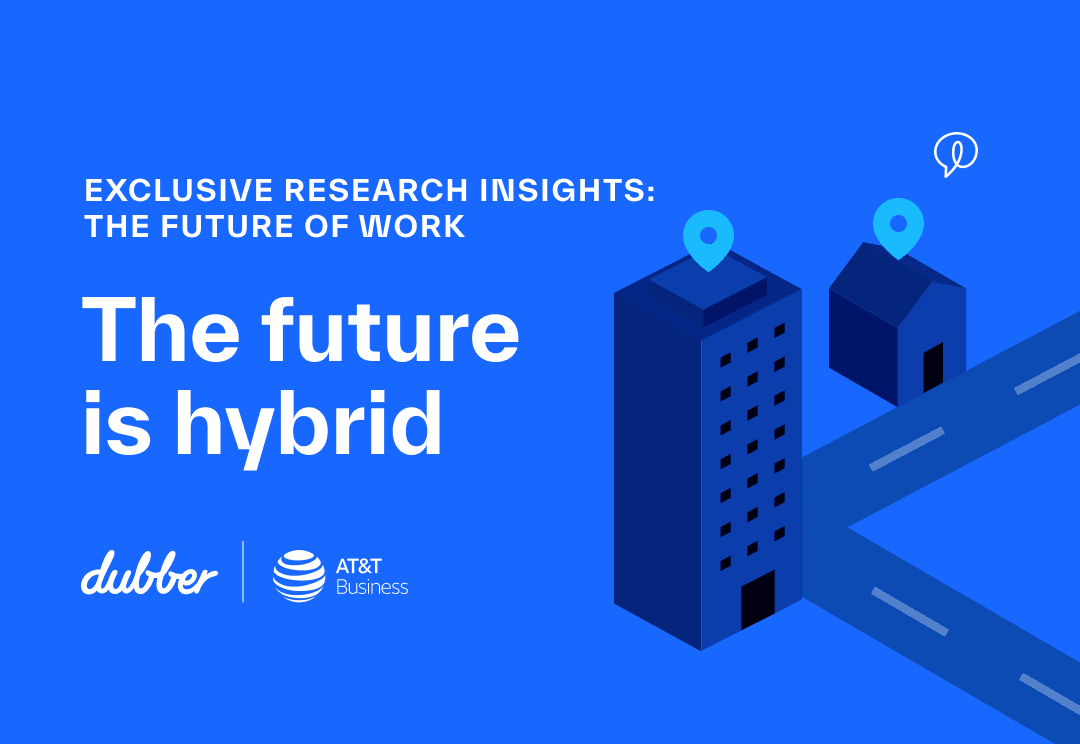
By Kennedy Pereira, AVP/GM Voice Transformation Practice, AT&T Global Business Solutions, via AT&T
Prior to March 2020, corporate human resources professionals and their bosses were in deep discussion about the next-generation workforce. This new group of workers were unique from other workers because they had different ideas both on what they valued and what motivated them in the workplace. Then, as a new reality hit for the world, these discussions ended. Workforce strategies that had been implemented were suddenly irrelevant. To complicate matters more, each month brought new challenges for how to manage employees in the remote… then hybrid, workforce.
Fast forward to January 2022. Considering all of the changes to manage – whether it’s been 1,000 or one million employees, corporate America has weathered the new normal well. But it’s also learning that even as day-to-day work slowly returns to its rhythm, the workforce strategies of the past no longer apply.
Incisiv, in conjunction with AT&T Business and Dubber, Inc., sought to understand how executives are planning to manage the workplace as offices re-open and companies return to standard operations. We conducted quantitative and qualitative research across five industries – retail, energy, healthcare, manufacturing, and banking/finance. Through this, we uncovered that that not only is a new way of work here to stay, but certain legacy thinking still exists among executives that’s contrary to what workers want. In addition, our research revealed that executives are struggling with how to protect corporate culture and maximum productivity in a way that also meets employee satisfaction in the new marketplace that’s more competitive for quality workers.
So, what does The Future of Work look like?
- The Future of Work is hybrid –
A casual discussion at a neighborhood dinner party would likely reveal that some friends love working at home and never want to return to the office. On the other hand, others miss the structure and camaraderie of the office. Most people, though, want a mix of both. That “hybrid” mix is the prevailing workplace model that most business leaders foresee as the new standard. In fact, while the fully remote workplace model is expected to take a dramatic decline from 2021 (56%) to 2024 (19%), the hybrid model is expected to grow from 42% (2021) to 81% (2024).
The difference between March 2020 and January 2022 is that in 2020, trends around the younger workforce were pointing towards the need to offer a more flexible work environment to attract and retain the best workers. In 2022, however, that applies to all generations of workers. In fact, a whopping 97% of respondents believe offering a hybrid model will help to attract better talent.
- Companies are willing, but not ready –
It was unprecedented how quickly the world, and the workplace, changed. Most companies did the best they could to keep operations going both for the business and the livelihoods of their employees. Now to keep the benefits of their efforts going in their own version of a hybrid model, they’re realizing there are a number of things to consider. For example, new communications strategies, new policies, and new technologies are needed. Also, how can a business maintain company culture when employees have little to no in-person interaction and are less social?
Our research revealed that most companies have not addressed most of these issues, with 60%-75% of respondents stating that they haven’t put detailed strategies for a distributed workforce to address these issues into place. Because of this, it is no wonder that ‘maintaining employee oversight’ was the number one challenge cited for executives managing in a hybrid model.
- Preparing for a future that’s already here –
The challenges company executives face continue to become more complex. Over the next 24 months, the new workplace will be a major contributor to that complexity. As a hybrid model takes hold, executives are looking to technology to help address and simplify some of this complexity.
A good example of this is artificial intelligence (AI) and machine learning (ML). The benefits of these emerging technologies may not always be apparent in the short term; however, there are many opportunities for how they can help to better manage a hybrid workforce. In fact, according to our study, AI and ML are the top technologies that can drive positive impact in the new workplace. They’re also critical tools to enhance employee productivity.
A word of caution, though. Companies need to make sure proper infrastructure is in place to maintain and support these data-laden technologies. It’s vital that IT leaders understand the collaboration, mobility, bandwidth, security, costs, and even power requirements needed to implement these and other new technologies.
Download a copy of the eBook to learn more and reach out to us to discuss our findings. We’ll share strategies and use cases to prepare and optimize your business for The Future of Work.
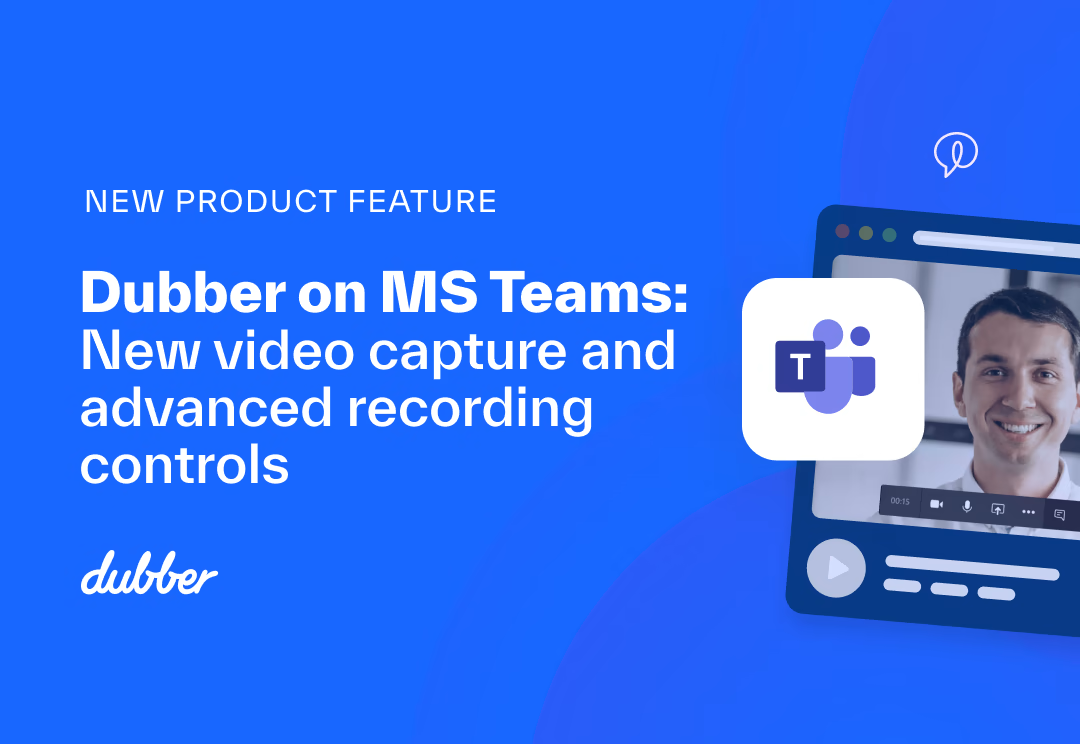
Barcelona, Spain (Mobile World Congress) and Melbourne, Australia – 1 March 2022 — Dubber Corporation Limited (ASX: DUB) (Dubber), the world leader in Unified Conversational Recording and conversational intelligence, today announced the ability to capture video recordings and perform advanced recording controls on Microsoft Teams.
Dubber video recording for MS Teams delivers certainty of recording on a single platform, real-time search, keyword analytics, and AI-enriched insights. The most advanced recording controls for Microsoft Teams give users greater flexibility and control when recording voice or video calls. The features include the ability to pause and resume recordings, record on-demand or selectively manage which types of calls or meetings are recorded.
James Slaney, COO, Dubber: “Businesses increasingly recognise default and basic recording solutions fail to meet their enterprise-grade requirements for security, compliance and data sovereignty. No other company offers the completeness, scalability and robustness of Dubber’s unified call recording and conversational intelligence capability as a Microsoft Teams certified service.
“Capturing video recordings adds critical context to knowing what was said, particularly as video has become a primary communications medium for every business driven by hybrid work.
“For example, every customer presentation captured, attached and connected to a CRM significantly improves revenue forecasting, sales coaching, training and more. For compliance intelligence, capturing video completes the requirement to know your customer and employees. The release of advanced recording controls provides flexibility and practical control for administrators and end-users to select the types of calls that are recorded and additionally to record on-demand or pause and resume recording.
“We are addressing the critical need for any service provider or reseller of Microsoft Teams to differentiate, drive revenue and increase retention,” added Slaney.
Feature release details:
- Video call recording: Capture and unify all your video calls, meetings and voice recording on Microsoft Teams in Dubber’s infinitely scalable Voice Intelligence Cloud. Affordable and flexible plan options start as low as $39.95 (USD) per user/month, with 100GB of storage included.
- AI-powered video: Enrich video recordings with AI to unlock best of breed Dubber AI capabilities such as intelligent keyword search, transcriptions, analytics, sentiment plus tone analysis and real-time notification and alerts.
- Pause-resume: Users can effectively pause and resume voice and video calls on mobile and desktop. When initiated, it results in the same consistent experience across the native app as well as calls using Dual-Tone Multi-Frequency codes (DTMF).
- On-demand: Once configured, when a call/meeting begins, it gets recorded only when the user presses the “record” button in Dubber’s app.
- Selective recording: Allows Administrator users to select which type of calls/meetings are recorded. The following call types will be supported at launch, including the ability to record all call types.
- Record external parties (determined by users’ tenancy) only
- Record meetings only
- Record PSTN only
Dubber is experiencing significant demand from Service and Solutions Providers looking to differentiate their Microsoft Teams Operator Connect offerings. A report by the Cavell Group highlighted that as the traditional service provider model transforms it is vital for providers to find new revenue streams, services, and solutions to offer to end customers.
Relevant resources:
- Ready to unlock the power of conversational intelligence on Microsoft Teams? Head to Microsoft AppSource for an update to get all the latest Dubber control features.
- Dubber on Microsoft Team datasheet
- Learn more about Dubber on Microsoft Teams
About Dubber:
Dubber is unlocking the potential of voice data from any call or conversation. Dubber is the world’s most scalable Unified Call Recording service and Voice Intelligence Cloud adopted as core network infrastructure by multiple global leading telecommunications carriers in North America, Europe and Asia Pacific. Dubber allows service providers to offer conversational recording from virtually any source – turning them into AI-enriched insights for compliance, revenue, customer and people intelligence. Dubber is a disruptive innovator in the multi-billion-dollar call recording industry. Its Software as a Service offering removes the need for on-premise hardware, applications or costly and limited storage.
European/Mobile World Congress Media
Annabel Clementson
annabel@wearetfd.com
+44 7951 786435
A/NZ Investors
Simon Hinsley
simon.hinsley@dubber.net
+61 (0) 401 809 653
A/NZ Media
Terry Alberstein
terry@navigatecommunication.com.au
+61 (0) 458 484 921

Barcelona, Spain (Mobile World Congress) and Melbourne, Australia – 1 March 2022 — Dubber Corporation Limited (ASX: DUB) (Dubber) a leading global solution provider of Unified Call Recording & conversational intelligence today launched Dubber PCI Comply for Amazon Connect. Dubber PCI Comply offers any business seeking to process credit card information a cost-effective and easy to deploy cloud-native solution to achieve efficient PCI DSS compliance for any communication modality on Amazon Connect, including contact centre, voice, IVR, and chat.
James Slaney: COO, Dubber: “Dubber’s aim is to deliver products that focus on speed of delivery and scale of the cloud. With the release of ‘Dubber PCI Comply for Amazon Connect,’ we’ve focussed on the key aspects and benefits of Amazon Connect for Service Providers, Enterprises and Contact Centres. Like Amazon Connect, Dubber PCI Comply for Amazon Connect is driven by our innovative and simple API integration, providing the ability to deploy PCI compliance across an organisation immediately.
“Service providers, Amazon and contact centre solution providers, can now deliver highly differentiated PCI-compliant payments solutions globally. Backed by Dubber’s proven cloud technology, support and carrier grade reliability, Dubber PCI Comply scales to address the needs of the smallest, or largest, call centre environments.
“With continued innovations like Dubber PCI Comply for Amazon Connect, we continue to innovate, delivering ever increasing opportunities for our partners – from service providers, contact centre solution providers and Amazon itself – to differentiate, increase revenue and drive retention. Inline with this, Dubber is continuing the innovation into PCI Comply, by expanding the supported platforms utilised by our Service Provider partners that have similar scale and integration abilities to Amazon Connect.”
Dubber PCI Comply for Amazon Connect masks the contact centre environment during transactions, including agents, enabling Payment Card Industry Data Security Standard (PCI DSS) obligations and requirements to be met. Served entirely from Amazon Web Services (AWS), Dubber PCI Comply can be used by any sized organisation globally and integrates with all payment providers.
Slaney added: “PCI DSS compliance isn’t satisfied because of the deployment of Amazon Connect alone. It is the instant Dubber PCI Comply is deployed. The moment you start processing credit card transactions, you need PCI Comply. Dubber PCI Comply eliminates the need for, or the possibility that, agents see or enter credit card data. We believe our innovative approach such as via Amazon Connect is the best and most secure way of ensuring PCI compliance.
“Too many businesses rely on pause and resume technologies as a method of preventing card payment data from being stored. However, pause and resume does not satisfy PCI DSS compliance and carries significant risk. Dubber PCI Comply prevents the transmission and storage of any card data for Amazon Connect customers eliminating PCI DSS risk and removing the burden of storing sensitive customer payment data while enabling best in class customer and agent experience.”
Amazon Connect supports over 10 million contact centre interactions a day and is one of AWS’s fastest-growing services.
How Dubber PCI Comply works:
Dubber PCI Comply for Amazon Connect for the end customer enables certified security and PCI-DSS compliant payments via voice calls, chat, and cloud-based communications platforms.
- The customer wishes to make a payment using a credit or debit card, and the agent asks them to type in their payment card details leveraging DTMF (Dual Tone Multi Frequency) codes using their telephone keypad. If the customer cannot use their telephony keypad, the solution can capture the payment information by voice using speech recognition technology while still maintaining PCI compliance.
- The agent remains engaged with the customers and the conversation, focusing on providing an excellent customer experience. As the customer enters their card details, the agent sees asterisks in real-time on the user interface.
- The card information is captured within the Dubber PCI Comply solution before passing it onto the Payment Service Provider (PSP). The agent is notified once payment has been approved or rejected.
- Without any payment card data to protect, businesses obligations to comply with PCI DSS are eliminated, risk reduced, without disruption to business workflows.
- Dubber PCI Comply works with voice, IVR & chat
- Available on the AWS Marketplace, prices start from £8.95 per user/month for PCI Comply for Connect and £11.49 per user/month for PCI Comply for Connect Plus.
Check out Dubber on the AWS marketplace listing.
About Dubber:
Dubber is unlocking the potential of voice data from any call or conversation. Dubber is the world’s most scalable Unified Call Recording service and Voice Intelligence Cloud adopted as core network infrastructure by multiple global leading telecommunications carriers in North America, Europe and Asia Pacific. Dubber allows service providers to offer conversational recording from virtually any source – turning them into AI-enriched insights for compliance, revenue, customer and people intelligence. Dubber is a disruptive innovator in the multi-billion-dollar call recording industry. Its Software as a Service offering removes the need for on-premise hardware, applications or costly and limited storage.
European/Mobile World Congress Media
Annabel Clementson
annabel@wearetfd.com
+44 7951 786435
A/NZ Investors
Simon Hinsley
simon.hinsley@dubber.net
+61 (0) 401 809 653
A/NZ Media
Terry Alberstein
terry@navigatecommunication.com.au
+61 (0) 458 484 921
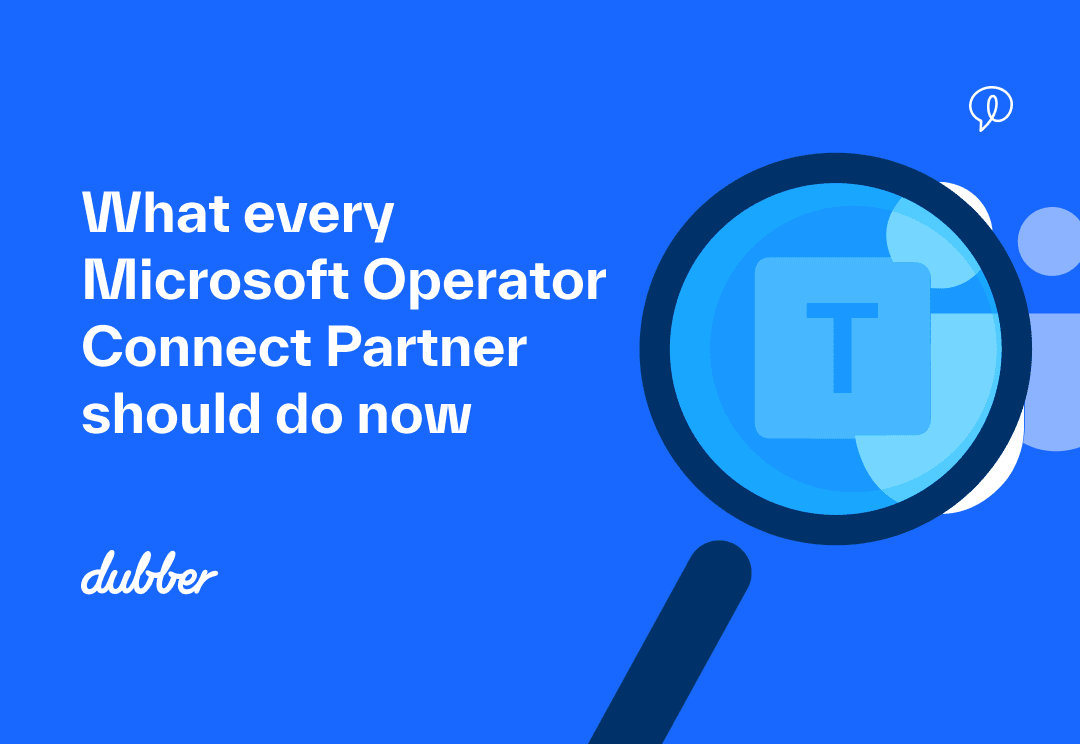
Demand for Microsoft Calling and Teams solutions has never been higher. With the race on to meet demand, Microsoft Operator Connect partners need to move quickly to differentiate and meet the broader needs of customers.
“As the traditional service provider model transforms it is vital for providers to find new revenue streams, services, and solutions to offer to end customers.” Cavell Group
Four immediate opportunities exist for every Microsoft Operator Connect partner.
1. Differentiate with value-added conversational recording and voice AI
McKinsey put it well, “Telcos’ success will hinge on their ability to leverage data and deploy advanced analytics, AI, and automation at scale to drive new sources of growth and change the broader economics of the business.”
Service providers have an immediate opportunity to differentiate themselves in every Microsoft Teams deal by offering instantly available, infinitely scalable conversational recording and AI based intelligence that lives in the cloud.
2. Increase revenue by expanding the conversation with customers – address key use cases and business drivers
Gartner predicts that by 2025, organisations will record and analyse 75 percent of work conversations, enabling the discovery of added organisational value or risk.
Organisations are seeking insights from conversations to meet compliance requirements, improve customer experience, boost productivity, and increase sales and service performance.
Service providers can harness a multi-billion dollar opportunity and address a wide range of customer requirements with one conversational recording solution without the need to continually invest in multiple niche solutions.
3. Increase retention and reduce churn by creating stickiness with the unification of data and services on a common platform
Keeping customers is valuable. Research by Frederick Reichheld, inventor of the Net Promoter Score, shows increasing customer retention rates by 5% increases profits by 25% to 95%.
So how can conversational data help?
The number of connected devices that people own has doubled since 2019, to 25 per household. People now communicate across a growing communications landscape: mobile, Microsoft Teams, SIP connections, WhatsApp, Messenger, and more. With internal conversations, plus connections with partners and customers, there is a challenge for enterprises to gain visibility into all conversations from a single access point.
By capturing and unifying every conversation across multiple platforms, service providers can generate significant value for their customers, which in turn drives greater retention and stickiness to their services.
4. Modernise legacy call recording solutions, reduce CAPEX, and develop a stronger ROI model with modern conversational recording solutions
Legacy systems can cost organisations up to a 15% budget increase every year for maintenance. This is not to mention the high costs of staffing and the opportunity cost of not investing in emerging technologies such as AI.
Service providers can modernise their approach to call recording and remove costly legacy solutions. Cloud-based SaaS unified conversational recording and AI solutions have far stronger ROI models, meaning telcos can do far more with less investment.
Solutions that can be embedded into networks and that already integrate with critical infrastructure also add to compelling business cases for service providers.
The question every Microsoft Operator Connect partner needs to answer now is: Are you ready to differentiate and 2x your Microsoft Teams ARPU?
Dubber delivers an immediate advantage on every Microsoft Teams endpoint. Cloud-native and compliant, Dubber switches on with a click and is easily integrated with your current provisioning and billing engines. But the benefits don’t stop there:
- First Microsoft Certified compliant unified call recording platform fully integrated with Microsoft Teams
- Unify call recording from any eligible end-point – not just Microsoft Teams – increasing your footprint with the customer
- Fully integrated cloud service, delivering the ultimate combination of reliability, scalability and security
- Significant upsell revenue growth – we’ll provide the pathway to other revenue streams that no other provider can offer
With more than 75% of business conversations set to be recorded – and business drivers spanning compliance, revenue, people and customer intelligence, the time for Microsoft Operator Connect partners to integrate unified call recording and conversational AI is now.
Get the edge.
Download our free guide by analyst firm Cavell Group to learn how service providers can get the edge with CX, call recording and conversational data.
Learn about:
- Why customer experience is a critical driver
- How voice data and unified conversational recording can differentiation
- How COVID, changing communications and the cloud are driving changes in Service provider offerings
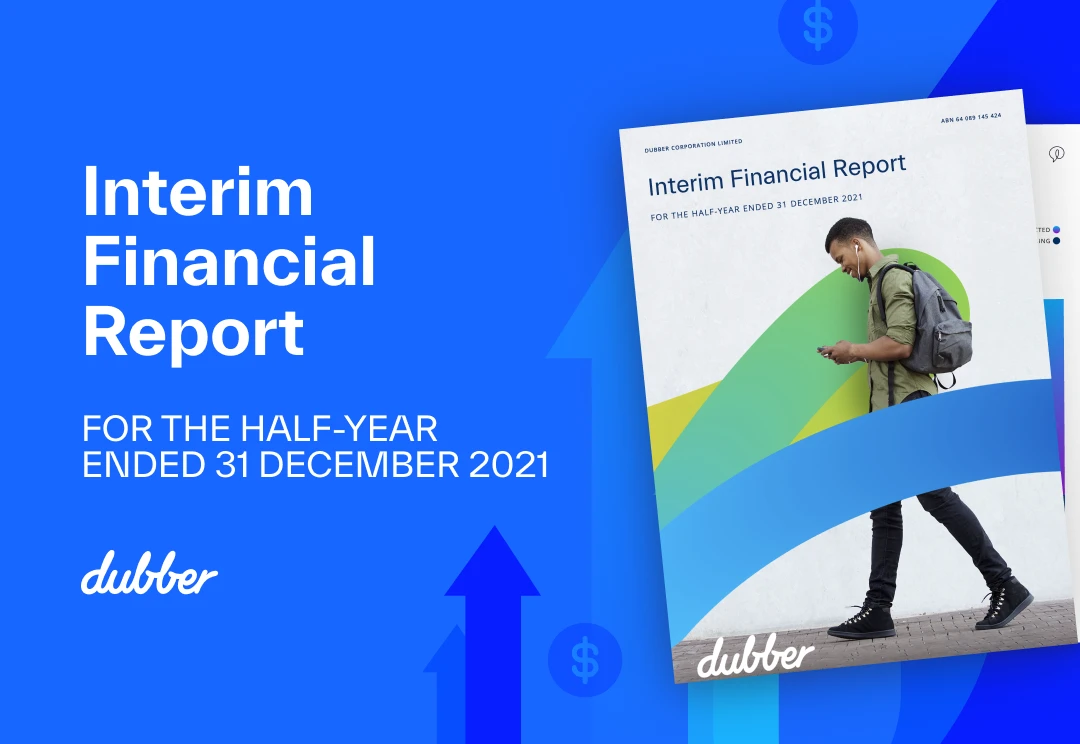
Record growth in the 6 months to 31 December 2021

We are excited to be exhibiting the world’s #1 Unified Conversational Recording and Voice AI platform at Mobile World Congress 2022. Now is the chance to see our industry-leading solution in action; learn how to add voice data rocket fuel for mobile revenue with Dubber.
Five reasons to visit Dubber
- Your customers are demanding a network-embedded service for compliant recording and conversational intelligence that extends to every end-point – mobile, phone, video and chat. When your network is mobile, shouldn’t your call recording and AI be mobile as well?
- Your competitors are differentiating their portfolio and maximising the revenue and retention potential of every connection with Unified Conversational Recording and Voice AI. Make yourself stand out in a sea of UC sameness.
- Stop paying for legacy call recording. Dubber is the solution 160+ leading mobile networks and service providers are utilising to modernise and monetize their approach to call recording, unifying end-points and enriching recordings with AI to unlock a multi-billion dollar market opportunity.
- Deploy in minutes on your solutions. We’re the only preferred and native Unified Conversational recording solution on Cisco Webex Calling, can double your revenue on Microsoft Operator Connect, and embed easily in the widest range of communication solutions including MS Teams and Zoom.
- Boost productivity for your customers. Be among the first to see Dubber Notes in action; the digital meeting organiser and notetaker that integrates with all major online meeting and project management platforms to streamline meetings and drive employee productivity outcomes for your customers.
Schedule a 1:1 demo with the team
We have big prizes on offer when you schedule and attend a demo with the team at Mobile World Congress 2022
- 5x Apple AirPod Pros
- 2x Apple AirPod Max
- We also have a £1,000 travel voucher to put toward your next holiday when you complete our on-site survey
Comment from Andy Lark on the event:
“Our debut at MWC is a powerful opportunity for mobile network operators and service providers to get up close and personal with Dubber, to see how our solution helps accelerate innovation and retain more value. The power of native cloud-based voice recording, storage, and voice data across the breadth of your mobile and Unified Communications is undeniable. Schedule some time with us to create a blueprint to 2x revenue on every endpoint.”
Schedule a time with Dubber at MWC22!
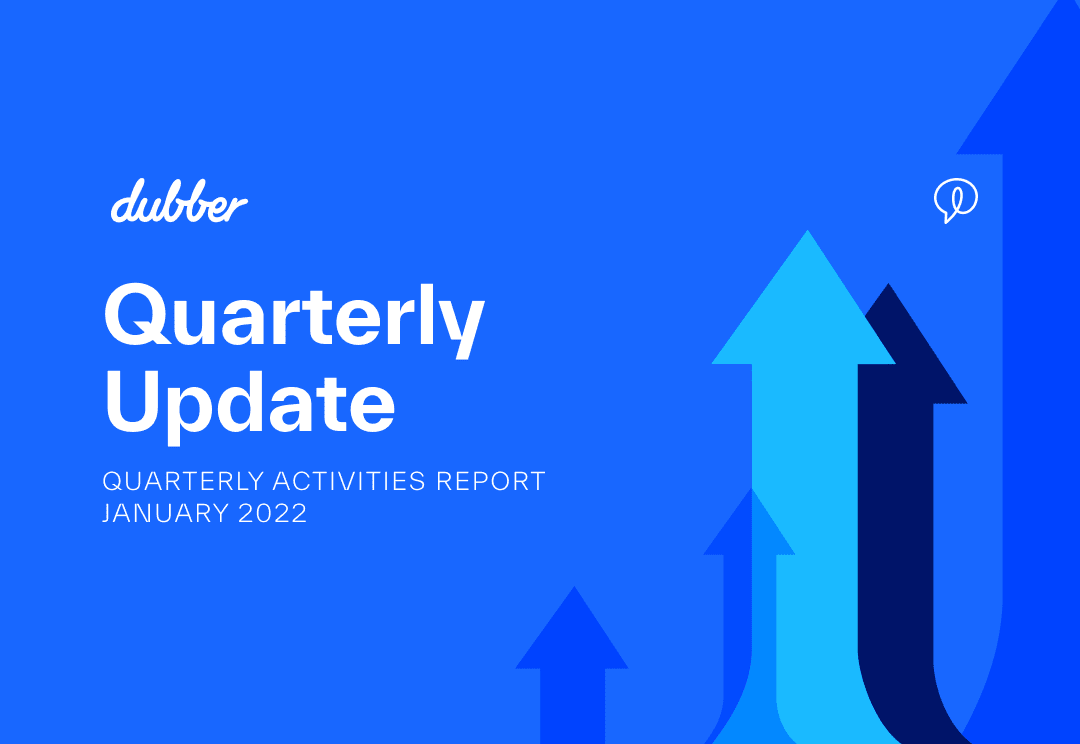
Dubber Corporation Limited (ASX: DUB) (‘Dubber’ or ‘the Company’), the leading global Unified Call Recording & Voice Intelligence cloud service designed for service providers, government, and businesses of any size, today released its report on the Company’s operating activities along with the Appendix 4C for the quarter ended 31 December 2021.
Download the Dubber December 2021 Quarterly Activities Report below.
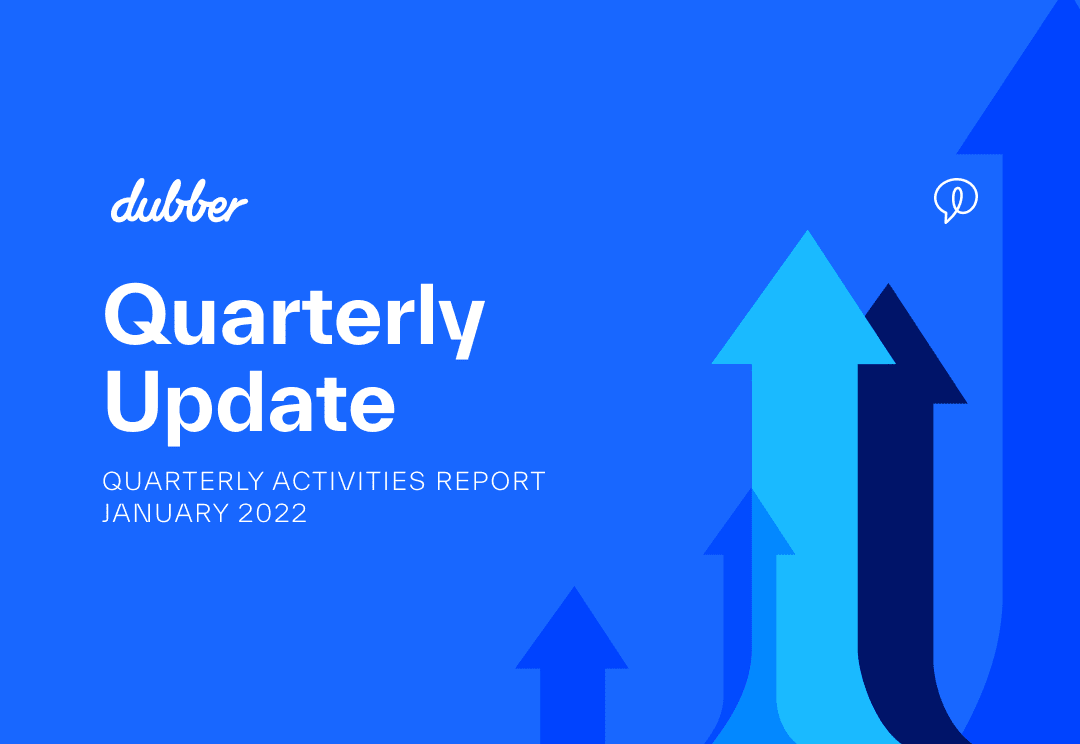
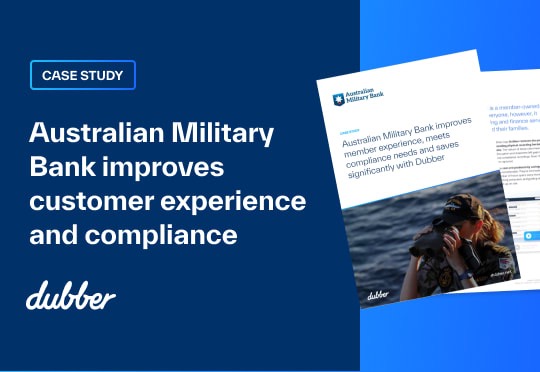
Voice calls are the main point of contact for Australian Military Bank members. The Bank uses Dubber call recording as an essential part of improving the member experience and compliance.
Here’s the backstory
Australian Military Bank is a member-owned mutual bank. Open to everyone, however, it provides specialist banking and finance services to Defence personnel and their families.
There are 14 branch locations across Australia and 11 internal Departments connected to Dubber CallN.
Head of Marketing Penelope Killick says the bank’s membership differs from other financial institutions. Many members serve in the Defence Force, they get deployed across Australia and may find themselves posted overseas.
She says: “We’ve got members who are always on the move. That’s why contacting via phone is so important. Our members may be deployed in places where they don’t have access to a branch. For these reasons, voice calls are the main point of contact for many members. It’s vital that we get it right.”
While the Bank has a central call centre in Sydney, many calls are either directed to branches or routed to them. The system can transfer after-hours calls in Eastern Australia to a branch in Perth. The contact centre team are able to handle many enquiries that might otherwise be a branch’s job.
Customer Experience is everything
Rizwan Dean, the Bank’s IT manager, says the Bank uses Dubber CallN for quality assurance, call recording and analytics. It allows staff to go back into calls, review a conversation, understand what members are talking about and identify their pain points.
He says: “We get a lot of information by listening to calls. Our conversations with our members tells us a lot about what they really want from us as their bank. We find Dubber is a very useful application.”
Killick says improving the member experience is a key priority for the Bank. “We can provide them with services to meet their requirements. We can help members particularly at the moment when Covid can mean circumstances may change”.
“Being able to log-in, and look at what is happening with member enquiries is important. We like having the ability to coach our staff in how to better respond to what are often unique requirements. And we find the tool useful when it comes to handling complaints, which is part of improving the member experience.”
Proactive Fraud Detection and Compliance
Dean says the Bank also uses voice recordings to detect and deal with fraud. Calls are easily checked if the fraud team suspects there is an issue or if a customer asks a staff member to do something fraudulent.
Another important related use is bank compliance. Australian regulators require the Bank to keep customer recordings for seven years. The recordings provide immutable evidence of every customer conversation.
As part of that process, auditors have the opportunity to review sample recordings and their own quality assurance checks. They provide reports to the Board and to regulators, to demonstrate they are meeting compliance requirements.
Cost Savings, Reliability and Productivity in the Cloud
Australia Military Bank’s dispersed network uses unified communications and that’s a natural partner for Dubber’s unified voice recording.
Dean says it means the Bank can use a single solution for all its recordings.
He says; “When I joined the Australian Military Bank one of the biggest pain points was that the Bank had to put physical computers and hardware at each site. These connect to our network and sit listening to voice traffic.
“The recordings were then uploaded back into the CallN portal. That was a problem because our branches are located at Defence sites. When there was maintenance, security work or patches on the Defence network, our branches would lose their connectivity. That meant we would have gaps in our quality assurance and compliance.
“Going to Dubber CallN cloud made our lives so much easier. That’s because it no longer matters where someone is dialling in from, even from mobiles, the recording happens at the Telstra gateway, not the branch.
“It means the gap is now closed. We don’t miss anything. It also means the overall hardware footprint and the capex is significantly reduced.”
The cost and productivity savings to the Bank are considerable. Previously every time a computer broke down, they’d have to replace it and send it out to the site and all machines required constant patching and upgrades to stay compliant.
As a result of the move to the cloud solution, they’ve eliminated the huge number of hours spent every month building and patching computers and guiding staff how to set them up on site.
Like to Learn More?

1. More Service Providers discover the value in adding data to their voice services
More service providers are adding Dubber to their networks and solutions than ever, with Dubber now on over 160 service provider networks. New partnerships this year include BT and AT&T, two of the largest leading service and solutions providers in the world, in moves that speak to the value of adding Dubber’s unified voice data service across the full suite of service provider endpoints and UC solutions.
“More service providers are driving revenue, retention and differentiation through voice services. Where the dominant revenue stream stemmed from making connections, the future will be based on creating value for themselves and their customers from the content on those connections.” – Russell Evans, Chief Revenue Officer, Dubber.
2. Business productivity in remote-first interactions got a significant boost
While the Dubber feature set continues to evolve to help end-users become more productive, of note this year was our acquisition of meeting force multiplier, Notiv. The AI-driven note-taking and action-item-generating software that sits in on meetings is hyper-focused on making meetings more effective and productive.
2022 will mark the year that Notiv becomes a key offering of service provider networks. Embedded as a service, capturing every conversation, and transforming it into meaningful insights. Note Taking will finally be automated, simple, and affordable. And an incredible source of differentiation for every service provider.
“AI can now touch every endpoint on a network – UC calls, mobile, and video. Every conversation has the potential to be augmented and enriched by AI unlocking insights and providing the data to power workflows and enrich other data sets. For too long conversations have been untapped and isolated to specific applications. By enabling AI to run, as a service, on every conversation service providers and businesses can tap one of the most important data sources in the world.” – Steve Wilson, Chief Technology Officer, Dubber.
3. Major Unified Communications platforms branch into new territory
Call recording was once a feature based on complex integration, high-cost storage, siloed applications, and management overhead. Today it is being delivered as a service at the core of major communications platforms.
Today, Webex Calling and Cisco Unified Communications Manager Cloud (Cisco’s enterprise cloud communications infrastructure solution) customers obtain Dubber basic cloud call recording solution for free – with enriched services available as an upgrade. Critically, this same service surfaces recordings, data, and insights from calls and conversations on other networks, such as mobile, providing customers with a single window into their conversational data, recordings and insights.
“Customers worldwide are responding to increased regulatory and compliance obligations for their businesses. Embedding tools, like Dubber call recording, as a standard service that is available to Webex users will help customers meet those requirements while enabling easy access to powerful advanced voice data services.” – Lorrissa Horton, Vice President and General Manager of Webex Calling and Online.
4. Hybrid-work staples gain a new service to help companies do business more effectively
Cisco Webex, Microsoft Teams and Zoom became dominant parts of every worker’s lives over the past year. And, a key offering from every service provider globally. Call recording as a feature was supplanted by call recording as a service – always on, requiring no management overhead or storage costs, and driving visibility into recordings and data across all services through a single window.
With hybrid work, employees still need to work compliantly, under the umbrella of management-sanctioned Unified Communications and enterprise mobility solutions. The recent fine of $200m metered out to JP Morgan – for violating record-keeping laws for employees using WhatsApp and personal devices for communications – speaks to the necessity of holistic solutions like Dubber for hybrid workplace control and compliance.
With a big 2021, it’s set to be an even bigger 2022 for Dubber, as we continue our mission to help service providers and end-users get the most out of every conversation.
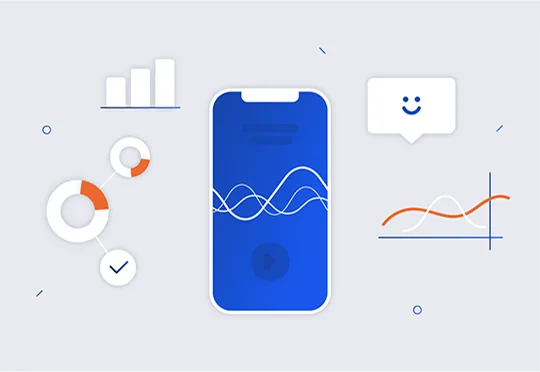
With revenue streams and retention under pressure like never before, and customers demanding solutions for compliance, productivity and intelligence – the race is on to offer call recording and AI as a service in the mobile network.
Hybrid working has increased usage of mobile and rapid adoption of unified communications, such as Microsoft Teams, Zoom and Cisco Webex, for crucial customer interactions. This has made it more challenging for businesses to meet regulatory and legal requirements – and for service providers to address those needs.
Behind the use cases that mandate call recording is the broader need to enhance productivity and harness the power of AI and data from a once untappable data source, conversations.
Applications such as Dubber’s automated note-taking – fuelled by native and cloud call recording – now make it possible to enhance the productivity of every worker through automated note-taking, AI-enriched insights, and connectivity to critical enterprise apps. Now an action spoken of in a meeting can be instantly captured, translated, and added to Asana as a task.
Mobile service providers are set to benefit from the drive to record. With Gartner indicating that by 2025, 75% of conversations at work will be recorded and analyzed, mobile call recording provides a significant market opportunity for service providers who already provide the network infrastructure for these conversations.
“Service providers instantly get access to a high-value recurring revenue stream that can well exceed $100m per annum. They achieve differentiation not just from the service but also from the new services they can deliver based on AI-enriched data sets. And, retention increased as the value of the service moves beyond just connections to how the service provider delivers value from the content on those connections. 5G in of itself, as an example won’t be enough to accelerate service provider growth. It’s the new ways in which 5G can be used – such as unified call recording – that will make the difference in 2022” – James Slaney, chief operating officer, Dubber.
The days of legacy call recording are over and don’t scale to record mobile and UC conversations. Hardware, services, siloed data and ever-increasing storage costs are being replaced with call recording and AI solutions delivered as a service, by Service Providers.
Dubber has recently partnered with Optus to deliver mobile voice recording and AI, an Australia-first, as a native feature of the Optus mobile network. As a result, Optus Enterprise customers have access to a cost-effective and complete recording and conversational insights solution across virtually any form of communication – including transcriptions, sentiment analysis, real-time search and more.
“Through our strategic partnership with Dubber we can now boost our customers productivity, visibility, and effectiveness. Optus’ Australian first native integration of Dubber into our mobile network allows participating enterprise customers the ability to unlock the power of conversational AI to push the frontier of how they care for customers, train and coach employees, resolve disputes and meet crucial compliance mandates.”
Zorawar Singh, Head of Core Product, Optus Enterprise
It’s time to do more with every conversation on mobile networks.
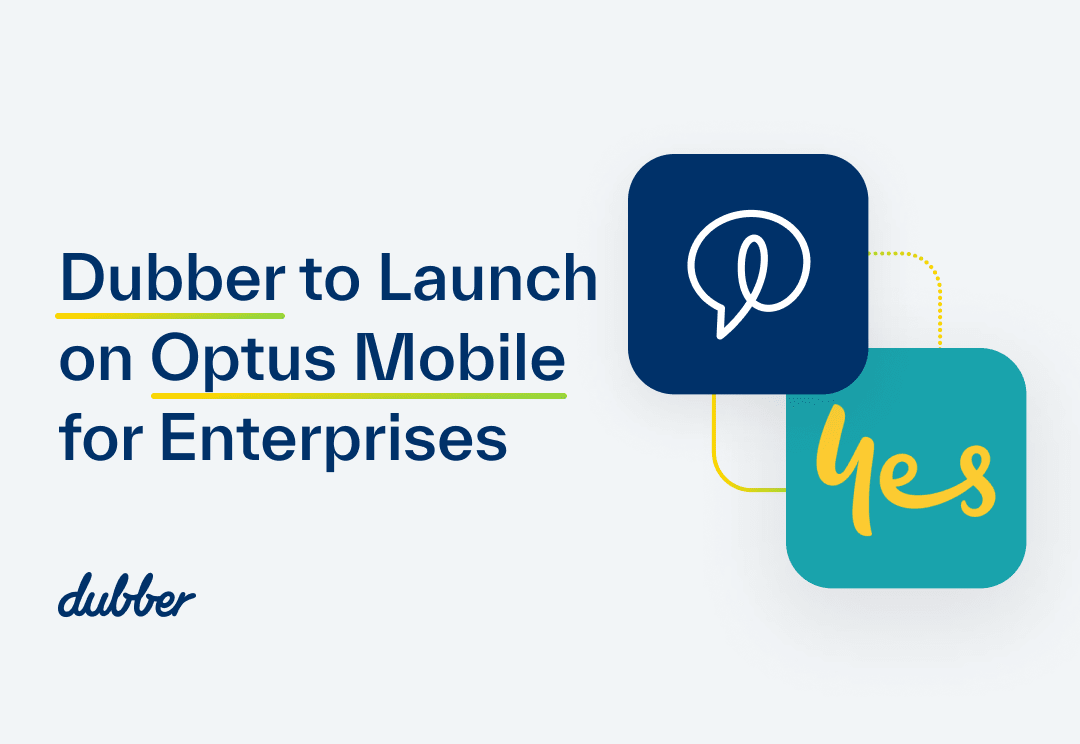
- An Australian-first, native integration of recording on the Optus mobile network*
- Unified recording across any mobile device on Optus makes revealing insights simple, easy and affordable
- Conversational AI to boost enterprise productivity, intelligence, and compliance
- Available to all Optus enterprise customers now in beta program
Melbourne, Australia – 13 December 2021 — Dubber Corporation Limited (ASX: DUB) (Dubber) is pleased to announce that its Unified Call Recording and Voice AI platform is launching on the Optus mobile network.
Delivered as Optus Mobile Voice Recording and AI – powered by Dubber, the product represents an Australian first with Dubber Unified Call recording and AI available as a native feature of the Optus mobile network. As a result, enterprise customers on Optus now have access to a cost-effective and complete recording and conversational insights solution across virtually any form of communication.
Announcement highlights:
- An industry-leader in secure and scalable recording and conversational intelligence provisioned instantly as a scalable SaaS service, with no capital or services expenditure.
- Allows enterprise and government users to securely record all mobile calls for compliance, customer, people and revenue intelligence.
- AI insights including real-time sentiment analysis, transcriptions, and alerts for every call
- Seamless integration with CRM solutions like Saleforce.com and compliance platforms
Optus enterprise customers will be able to access all call recordings, transcripts, instant sentiment data and search in real-time from their phone or browser with a click.
In addition, businesses with surveillance, internal policy and broader compliance requirements will now be able to capture mobile conversations, securely recording, storing and reporting on conversations for proactive compliance management.
Zorawar Singh, Head of Core Product, Optus Enterprise
“Through our strategic partnership with Dubber we can now boost our customers’ productivity, visibility, and effectiveness. Optus’ Australian first native integration of Dubber into our mobile network allows participating enterprise customers the ability to unlock the power of conversational AI to push the frontier of how they care for customers, train and coach employees, resolve disputes and meet crucial compliance mandates.”
Steve McGovern, CEO, Dubber
“With Dubber at the heart of one of Australia’s largest and most critical mobile networks, we are making the native recording available with AI on every participating phone. Optus is expanding its leadership in connecting Australian businesses to their employees and customers and this now includes the ability to try AI based enrichment of conversations with insights, automated workflows, and more. A conversation on Optus’ network is now worth more to a customer through the ability to capture and reveal insights from that conversation alongside others from other Optus services.
“Optus Mobile Voice Recording and AI powered by Dubber opens up a significant addressable market, provides a key solution where, historically, there has been a tangible compliance gap and represents a significant leap forward in achieving Dubber’s vision of ‘AI for every phone’. Whatever industry you are working in – financial services, healthcare, retail, government, legal, entertainment, travel, or transport – the power of native mobile recording, sentiment analysis, storage, transcription and real-time “search-ability” will be available to you on your Optus mobile service.”
Optus Mobile Voice Recording and AI-powered by Dubber benefits and use cases include:
- Search-ability – instantly find call records and transcripts from today, yesterday, last week or last year.
- Proactive Compliance –Respond to regulatory requests and investigations in real-time and provide alerts on possible compliance breaches.
- Revenue, Customer & Business Intelligence – provide real-time reporting on customer and agent sentiment and engagement. Instantly review conversations to improve customer service and employee coaching.
- Dispute Resolution – avoid costly customer disputes by having a complete and accurate record of customer conversations.
- Easily Integrate with Productivity Tools – minimize inaccurate and time-wasting manual note-taking. Instead, capture conversations and automatically attach them to customer records in Salesforce and other productivity tools.
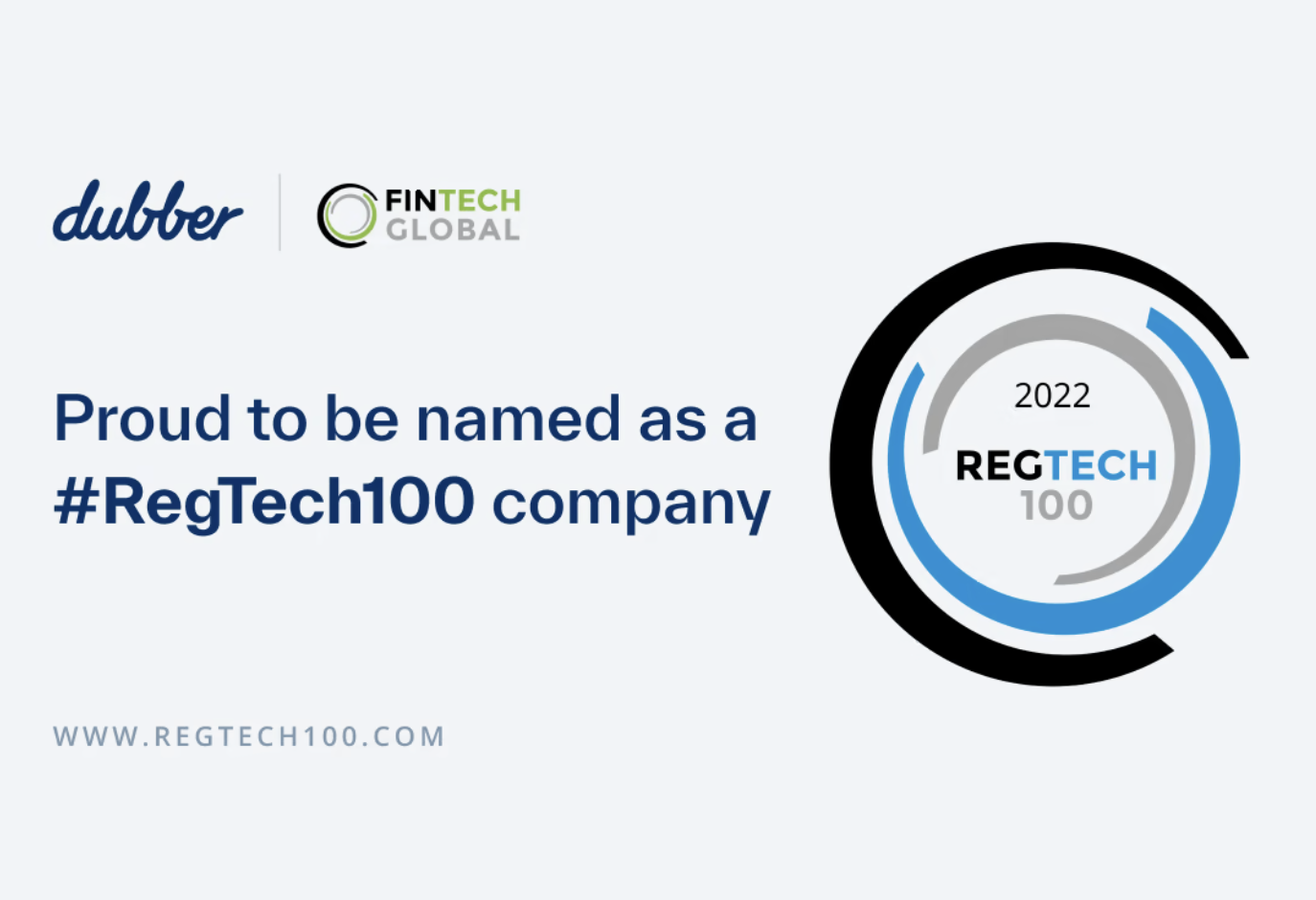
The new RegTech100 list for 2022 is launched today. Now in its fifth edition, the list recognises the world’s most innovative technology solution providers that offer products and services in the areas of compliance, risk management, information security and financial crime.
The RegTech (regulatory technology) industry has experienced rapid growth over the last two years as financial institutions dealt with rising tide of regulatory changes and rules updates brought by remote working and increased use of digital channels post Covid-19. As a result, RegTech spending by banks and other highly regulated institutions is projected to exceed $130bn by 2025.
It’s not surprising this year’s process to identify the 100 RegTech innovation leaders was more competitive than ever. A panel of analysts and industry experts voted from a longlist of nearly 1,200 companies produced by RegTech Analyst, a specialist research firm. Sixty new companies entered the RegTech100 for 2022 and the finalists were recognized for their innovative use of technology to solve a significant industry problem, or to generate efficiency improvements across the compliance function.
RegTech Analyst director of research Mariyan Dimitrov said, “Banks and other financial institutions are investing heavily into AI capabilities to automate highly manual regulatory tasks, support digital onboarding processes and monitor for fraudulent activity. The RegTech100 list helps them filter through all the vendors in the market by highlighting the leading companies in sectors such as identity verification, risk management, communications monitoring, information security and financial crime prevention.”
Dubber VP of Sales, Simon Broadbent said, “Dubber’s inclusion on the RegTech100 list is a great display of the confidence the market has in us as a leading provider of unified conversational recording and voice AI to the world’s leading banks and financial institutions.”
A full list of the RegTech100 for 2022 and detailed information about each company is available to download for free at www.RegTech100.com.
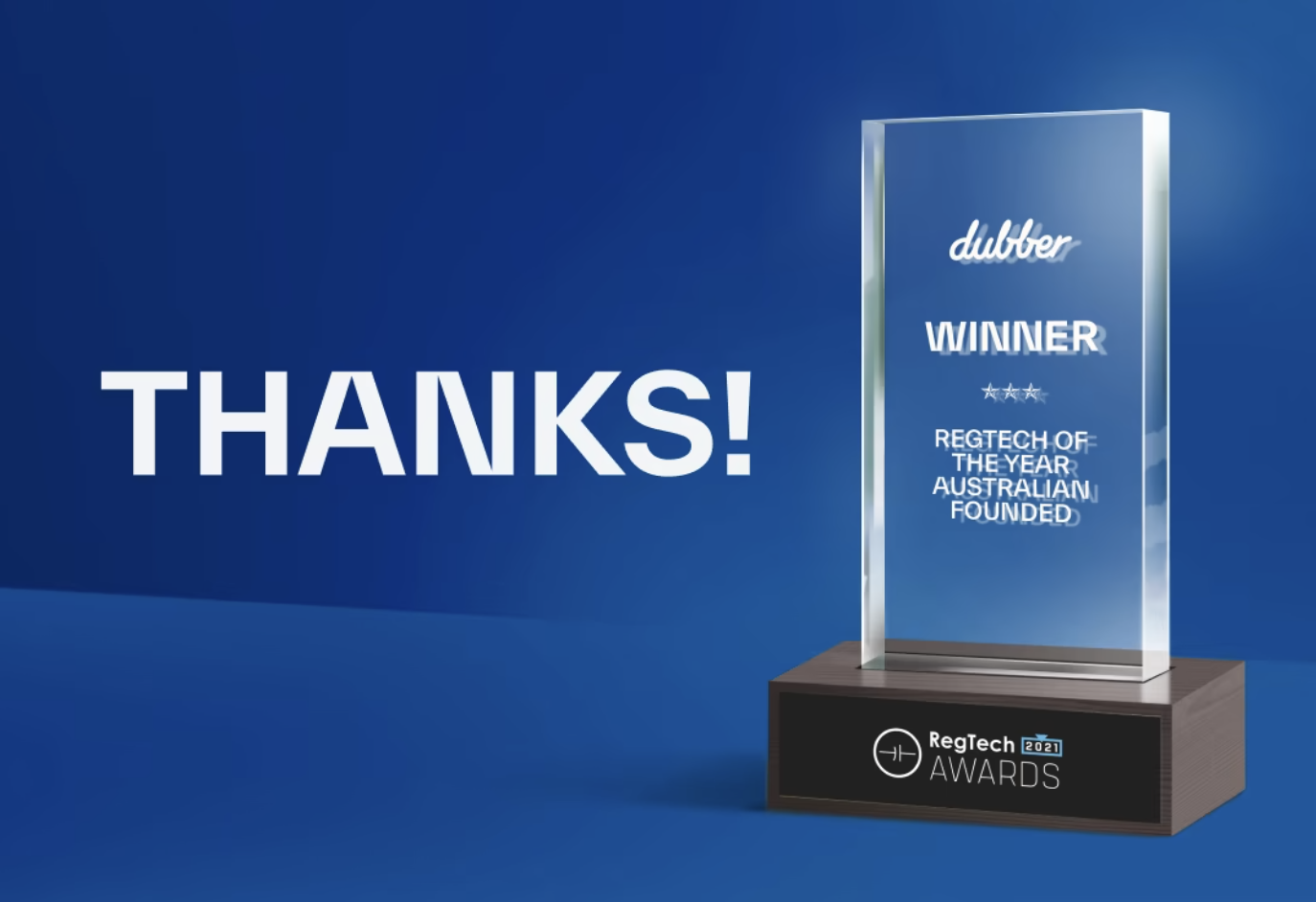
Melbourne, Australia – 2 December 2021 — Dubber Corporation Limited (ASX: DUB) today announced that the RegTech Association has awarded Dubber the 2021 RegTech of the Year (Australian-founded).
James Slaney, COO, Dubber: “Unified conversational recording and intelligence unlock a significant opportunity for Service Providers to meet the compliance and surveillance needs of businesses globally. With a record number of applications and supported by a cross-industry judging panel, this award acknowledges the work of our teams and customers.
Recognition such as this furthers our ability to attract new service providers onto the world’s leading conversational recording platform. The days of legacy call recording are over. Hardware, services, siloed data and ever-increasing storage costs are being replaced with compliance solutions delivered as a service, by Service Providers.
Where legacy call recording solutions were tied to a specific application or service, we can near-instantaneously create compliance certainty with our Service Provider partners across all the services they provide – Cisco Webex Calling, Microsoft Teams, traditional unified communication and mobile services through a single pane.
This provides a win for all parties. Service providers create compelling differentiation and revenue and their customers eliminate the cost, complexity and lack of visibility legacy solutions create. Businesses can now enable their employees to work the way they want to work, and for customers to communicate the way they want to communicate, without compromising compliance or security.”
Until now, the need for hybrid working and rapid adoption of unified communications solutions has made it more challenging for businesses to meet regulatory and legal requirements – and for service providers to address those needs.
Dubber’s Unified Conversational Recording and Intelligence platform is a foundational service for Service Providers to deliver compliance and surveillance solutions. It enables conversations to be captured in real-time – voice, video and chat – and transformed into data on which AI surfaces insights, alerts and more. From a single platform, data from any number of communications services can be viewed and shared with big data sets and other applications. Businesses can demonstrate they know customers and employees and meet compliance mandates such as MiFID, FINRA, AML & KYC, RG 271, Anti-hawking and more.
Unified Call Recording and Intelligence is now at the centre of modernising compliance and surveillance in industries ranging from financial services to entertainment and travel. By unifying conversations and AI-enriching data, organizations can address critical needs for legal hold and discovery, data retention, auditing, internal dispute resolution, monitoring, alerting and reporting, and more.
About the RegTech Association
The RegTech Association is a global centre of excellence that brings together government, regulators, regulated entities, professional services and founder-led RegTech companies for best-practice collaboration.
About Dubber:
Dubber is unlocking the potential of voice data from any call or conversation. Dubber is the world’s most scalable Unified Call Recording service and Voice Intelligence Cloud adopted as core network infrastructure by multiple global leading telecommunications carriers in North America, Europe and Asia Pacific. Dubber allows service providers to offer conversational recording from virtually any source – turning them into AI-enriched insights for compliance, revenue, customer and people intelligence. Dubber is a disruptive innovator in the multi-billion-dollar call recording industry. Its Software as a Service offering removes the need for on-premise hardware, applications or costly and limited storage.
For more information, please contact:
Investors
Simon Hinsley
simon.hinsley@dubber.net
+61 (0) 401 809 653
Media
Terry Alberstein
terry@navigatecommunication.com.au
+61 (0) 458 484 921
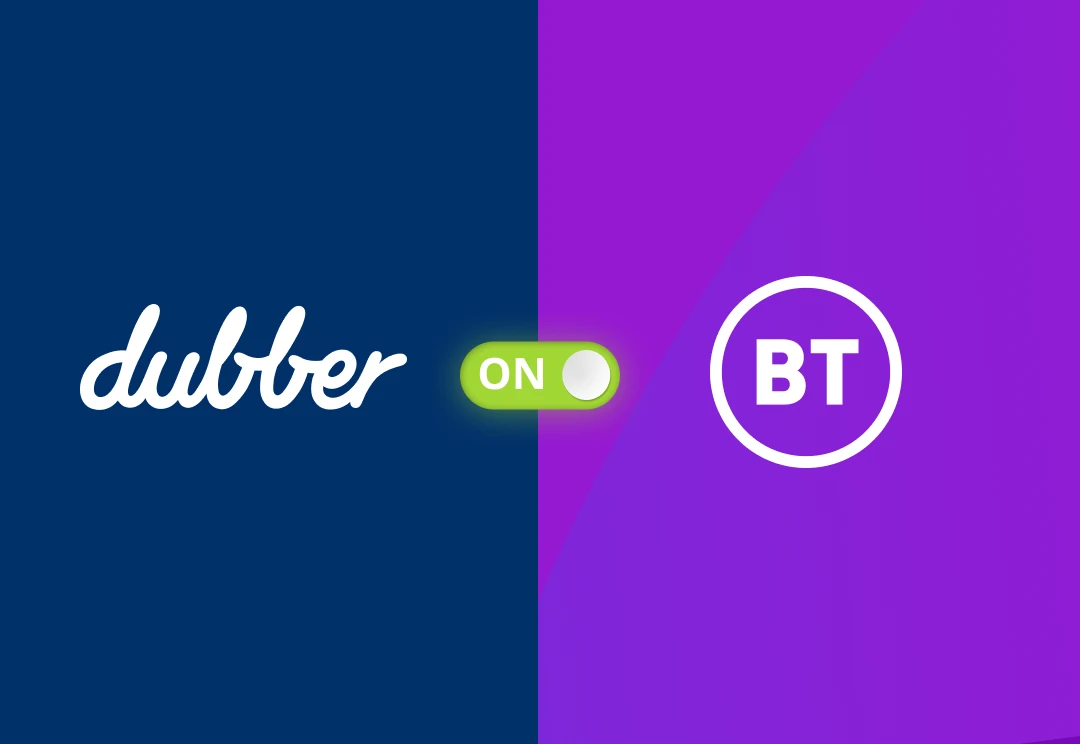
Melbourne, Australia – 2 December 2021 — Dubber Corporation Limited (ASX: DUB) has finalised a partnership agreement with BT that will see Dubber embedded as the default recording and conversational intelligence solution in the BT Meetings suite of managed services, spanning solutions based on Microsoft Teams, Zoom and Cisco Webex.
UK based BT is a leading provider of global communications services and solutions, serving customers in 180 countries.
The multi-year partnership agreement will see BT deliver unified call recording (UCR) to multinational organisations globally. BT has already worked with Dubber to implement UCR services with major financial institutions and the partners are engaged in significant opportunities globally. This new agreement provides for an accretive revenue stream for Dubber with additional revenues determined by uptake of the service by BT customers.
The Dubber and BT solution is the most advanced of its kind. It helps customers meet their compliance obligations for secure and scalable recording and conversational intelligence, and is provisioned as a scalable software as a service. UCR enables enterprise-grade recording and replay of any conversation – voice, video, and text. Enterprises can discover AI-enriched insights enhancing compliance, people, revenue, and customer intelligence by unifying conversations from multiple sources – mobile, unified communications and traditional phones. Together, BT and Dubber will help multinational organisations benefit from conversational AI at scale and eliminate the cost and complexity of legacy call recording and siloed recording services.
Steve McGovern, CEO, Dubber: “We are really pleased to be delivering Dubber unified recording and conversational AI as a core feature to BT, a true global telecommunications leader. The newly released managed service offerings will enable BT to continue to demonstrate its innovation leadership. Multinational organisations can now depend on BT for the high-performing secure connections it is known for, but now also for delivering outstanding value from the content inside every conversation on BT services.
For Dubber it marks another milestone in our journey to Dub the world’s leading networks, AI-enabling every endpoint, and creating high-value technology and distribution partnerships based on our Foundation model.”
Hriday Ravindranath, Chief Product and Digital Officer, BT: “Together we are meeting a critical customer need to know what was said to drive better compliance outcomes, especially in industries such as financial services, improve employee wellbeing and training over UC and enable better customer experience. The partnership announced today by Dubber and BT is just the start of an exciting, shared journey of innovation and collaboration that will shape the future of conversational capture and AI.”
This ASX announcement has been approved for release to ASX by Steve McGovern, CEO & Managing Director.
For more information, please contact:
Investors: Simon Hinsley
simon.hinsley@dubber.net
+61 (0) 401 809 653
Media: Terry Alberstein
terry@navigatecommunication.com.au
+61 (0) 458 484 921
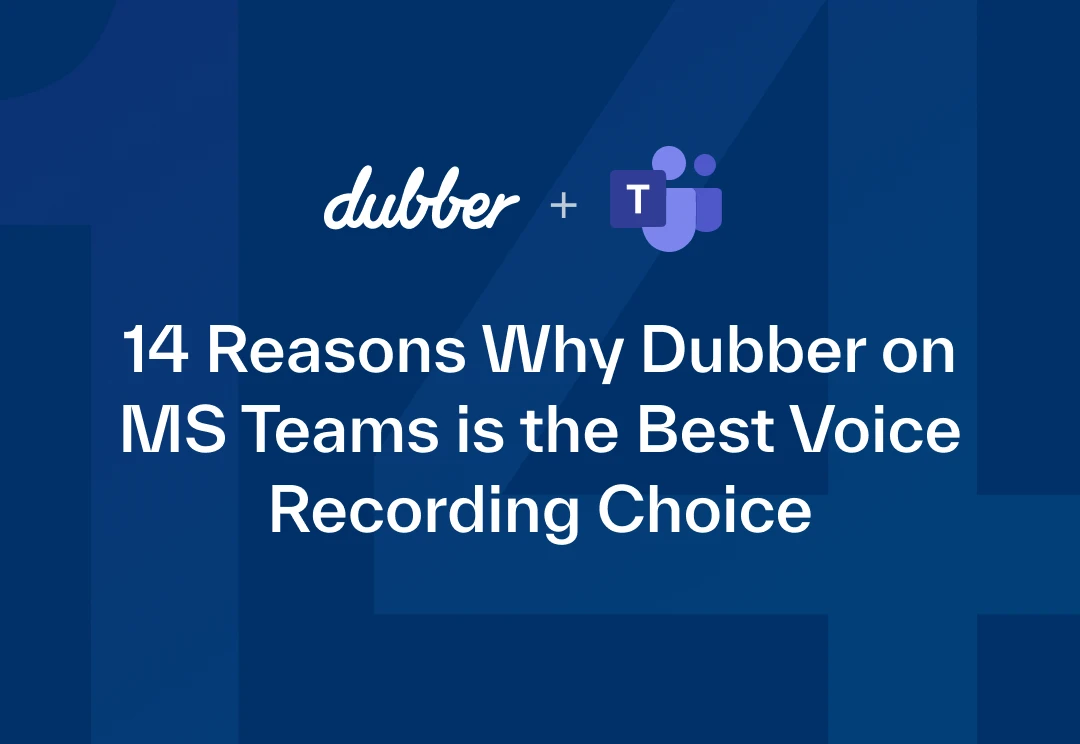
You’ve invested in Microsoft Teams. As a clear Leader in Gartner’s UCaaS Magic Quadrant, your organisation is poised for communications success, and the platform is evolving, meeting your needs and expectations.
But now the search for a recording and conversational intelligence solution that plugs into MS Teams is taking you on a deep-dive into solutions trying to find the right one. Some are just for meetings. Some just do transcription. Most of them come with serious data security concerns.
Here are 14 reasons why the only business-ready choice for Conversational Intelligence and recording on MS Teams is Dubber.
1. Advanced data sovereignty and security
Our solution is secure by design, directly built to conform to global compliance requirements such as GDPR and HIPAA, with best-in-class AES 256 bit encryption, data sovereignty and more.
Download our eBook, How to Ensure compliance on Microsoft Teams for more information, or take a look at our case study; Baseplan ensures compliant comms on Microsoft Teams with Dubber.
2. Total control
Your conversations and their data are yours to configure, replay, organise, and action as you wish. These are accessible by you only – not us.
3. Asynchronous scale, just like MS Teams
Just like MS Teams storage, tenancies, and regional requirements scale without tricky configuration; so too does Dubber.
4. Record with certainly
Dubber is always on, always working on all your required conversations. No more “Sorry, I’m having technical difficulties,” embarrassments and time wasters.
5. Enforceable recordings
Dubber recordings meet legislative requirements for data storage and capture, setting both your CIO and lawyers at ease.
6. Purpose built for UC capture
We’ve purpose-built Dubber so it integrates seamlessly with Unified Communications platforms like MS Teams. No fiddling around with trying to make apps talk to each other.
7. Native and dynamic
Dubber is a live platform. End-users are able to interact with conversational data as it is happening throughout each conversation, plus set triggers and alerts, or peruse historical data and notes.
8. Deploy with a click in minutes
There’s no need for systems admins to walk through complex setups to gain conversational intelligence on Microsoft Teams. Deploy Dubber with a click.
9. Continuous innovation
We follow the rapid release cycle model set by industry leaders such as Microsoft. That means we’re bringing new features to our platform constantly – keep up to speed via our blog and socials.
10. No limit storage
Keep all your records for as long as you like. There’s no limits on storage size or time kept, with Dubber, thanks to the power of cloud.
11. Simple and easy management
Administrators gain significant time back with a solution that doesn’t require constant management. Simply onboard team members to the platform via Azure AD, Microsoft’s identity management service that powers Teams.
12. Real-time search
Search entire organisational conversation banks like you would do Google. Find conversations that match names, topics, dates, and keywords.
13. Advanced AI-powered intelligence
This is where our platform shines, with advanced sentiment and tone analysis, the ability to instantly and automatically trigger workflows and alerts – as conversations happen, and more.
Download our AI litepaper, Unlock intelligence from every conversation with Dubber AI for more details.
14. No hidden costs
Our pricing models are set. There’s no uncertainty when it comes to billing, like when you go over a certain storage limit on some providers.
No other solution on the market ticks all the boxes we do. Chat to us about making the most of MS Teams with Dubber on the conversation.
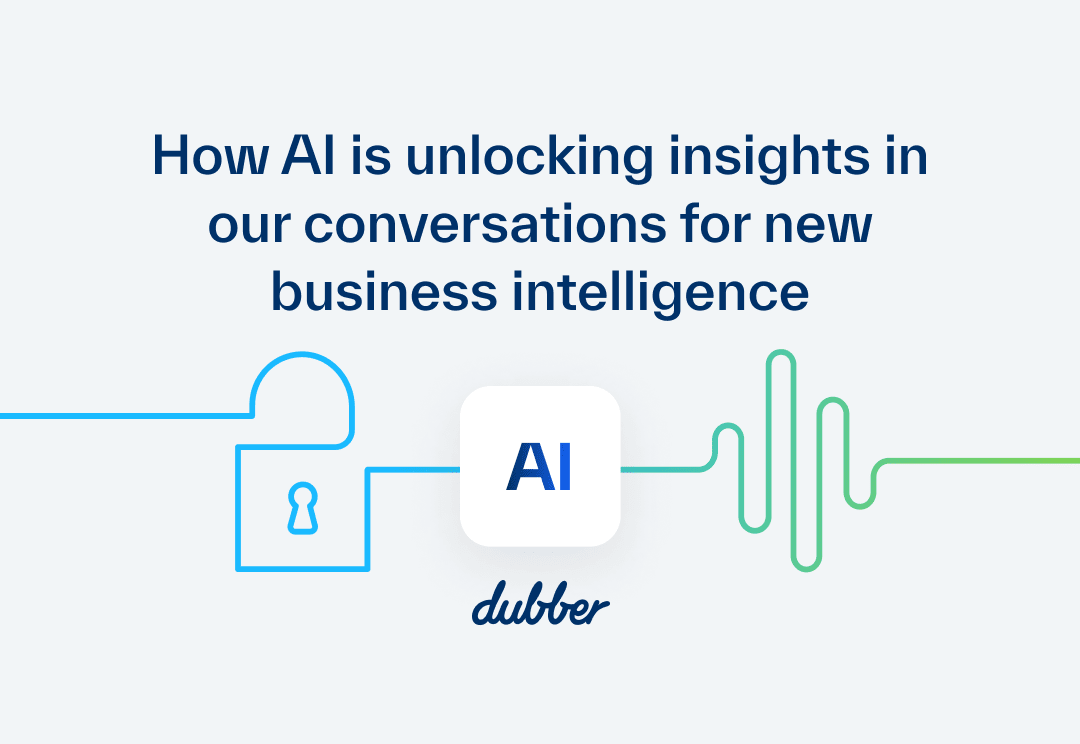
We’re doing AI on business conversations. But what exactly does that mean? How are we going about it? Most importantly – what do organisations and individuals stand to gain from it?
Read our whitepaper, Unlock intelligence from every conversation with Dubber AI.
What is AI?
“Artificial intelligence leverages computers and machines to mimic the problem-solving and decision-making capabilities of the human mind.” – IBM]
Artificial Intelligence is a bit of a catch-all phrase, covering anything a machine can do that ‘feels’ human, processing data and performing actions that a human would. For example, a machine could scan inbound emails for invoices from valid vendors and pay them, just like an assistant would.
But ‘true’ Artificial Intelligence is something deeper.
And that’s when we tend towards Machine Learning.
“A program or system that builds (trains) a predictive model from input data. The system uses the learned model to make useful predictions from new (never-before-seen) data drawn from the same distribution as the one used to train the model.” – Google
Machine Learning is when machines process great reams of data, becoming able to learn from data points what some human-defined object or concept is – and what it is not.
For example, when you go through ReCaptcha activities, clicking on fire hydrants, it’s to check whether a machine came up with the same answers for the hydrants – a machine that’s currently doing Machine Learning. Down the line, this will be applied in your self-driving car, so that it knows to swerve to avoid said hydrant – giving it ‘intelligence’ that seems human.
Since machines have a far greater collective processing speed than the human collective processing speed, it’s allowing us to classify objects or concepts far more quickly than an office of 100 analysts. This is combined with infinite, non-degradable storage – which far outperforms the capabilities of our human memory.
What does AI have to do with business conversations?
You likely already use Business Intelligence tools in your organisational analytics capacity, perhaps pulling financial information into slick dashboards in Power BI. Augmented Analytics is a step further, beyond statistical analysis to integrated machine-learning capabilities within your analytics processes and apps.
“Augmented analytics uses machine learning to automate data preparation, insight discovery, data science, and machine learning model development and insight sharing for a broad range of business users, operational workers and citizen data scientists.” – Gartner
Augmented analytics, with the help of Natural Language Processing, a form of machine learning, is what Dubber does – for business conversations.
…
Consider this: What are the ‘things’ in your business conversations that fall down the cracks? Whether it’s just two people on a phone call, or a boardroom full of people, there will be ‘things’ that are missed.
It’s why we take notes. It’s why we replay key conversations over in our heads. It’s why our most important action items come from a stern tone from a stakeholder.
But, as humans, we’re fallible and we fluctuate in effectiveness. And we’re only as useful as the collective on the conversation.
Putting machine learning to work on our conversations allows us to focus on the importnant things.
With a machine on the call, suddenly, these thought and manual process-consumptive tasks are off-loaded to a large degree to a machine brain that’s far faster at processing, and far better at remembering than our own collective intelligence. Dubber Notiv can automatically create action items for us instead of having to scribble them down.
We still need to think on our feet during the conversation, but we now have access to a post-conversational database and insights we may have missed. It’s a more effective, less error-prone memory bank. It can process and recall all the information in a conversation near-perfectly – and it gets better over time, as is the beauty of machine learning capabilities.
And when you start to combine all the conversations across your business? And being able to have a machine dig into combined insights across these conversations? Well, now you are getting to the crux of your biggest people-based business assets, your new and missed opportunities, your unsurfaced areas of improvement.
It’s Conversational Intelligence. And it’s what we do at Dubber.
Speak to one of our experts about your business needs and leveraging Dubber AI to unlock conversational intelligence, or download our whitepaper Unlock intelligence from every conversation with Dubber AI.
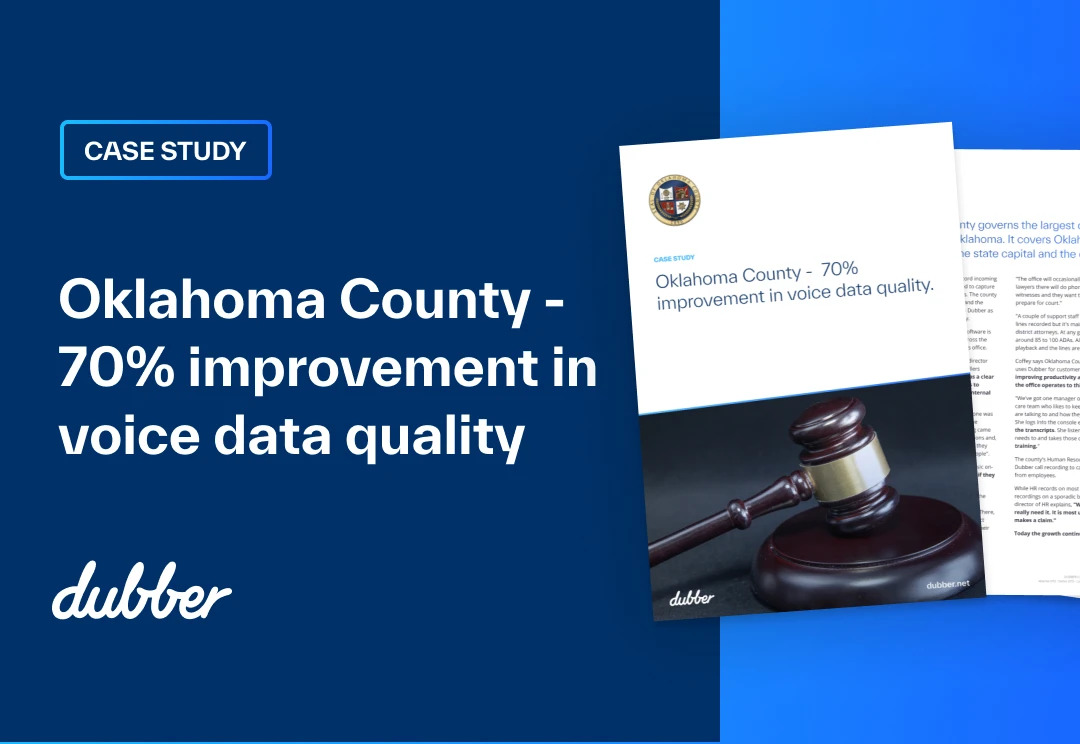
“Finding previously recorded conversations for court cases takes only minutes vs. hours, and the increased data quality has improved court preparation time.” – Dayne Coffey, Co-Director Oklahoma County Information Technology
The County first used Dubber to record incoming calls when the IT department needed to capture problematic help desk conversations. The county is a Cox Communications customer and the telecommunications company offers Dubber as its standard call recording technology.
Now the cloud-based call recording software is used by a number of departments across the county as well as the District Attorney’s office.
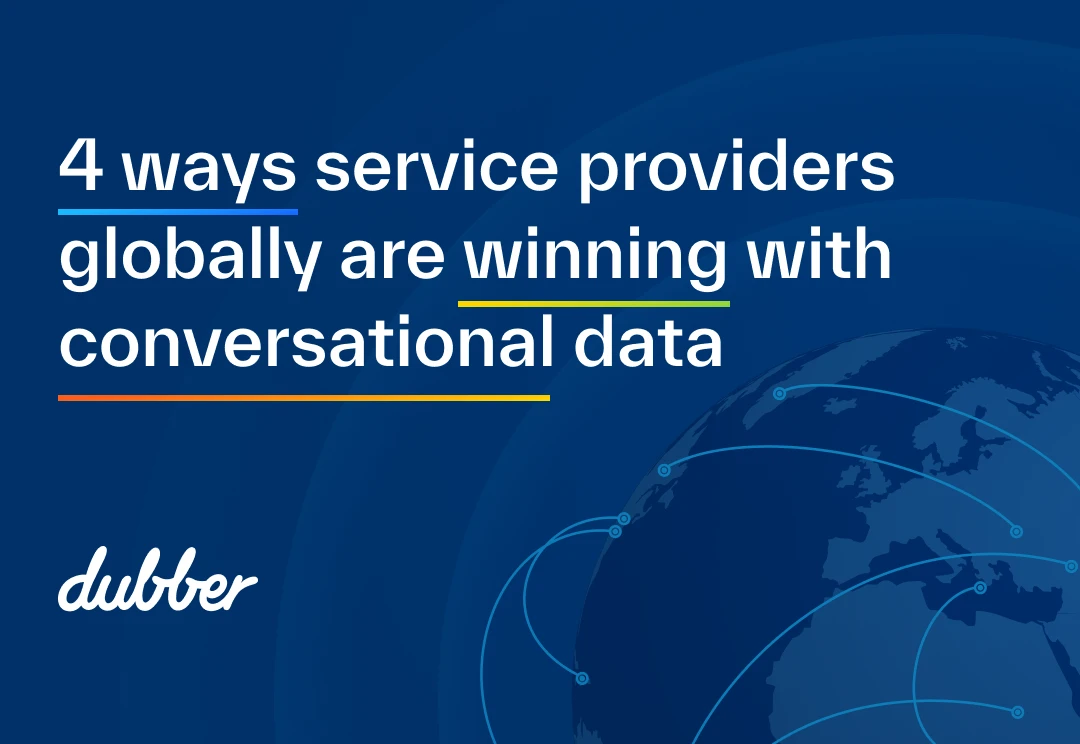
Service and solution providers globally are capturing conversations and monetizing voice connections using unified call recording and AI.
Here are the four ways that they are benefiting.
1. Delivering connections and content
Network-native unified conversational recording and AI can be deployed with minimal cost and deployment effort. It means service providers can quickly provide valuable content and intelligence, such as compliance, customer and people insights to customers.
While bundling is traditionally a calling, internet, and video service package, operators can leverage service/content bundling, together with conversational recording and data insights, to help reduce subscriber churn by up to 50%. (S&P Global Insights)
“Customers worldwide are responding to increased regulatory and compliance obligations for their businesses. Embedding tools, like Dubber call recording, as a standard service that is available to Webex users will help customers meet those requirements while enabling easy access to powerful advanced voice data services.”
– Lorrissa Horton Vice President and General Manager of Webex Calling and Online
2. Accelerated and increased revenue
Service providers are building new and differentiated services with unified call recording and AI that answer customer needs (for compliance, customer and people intelligence) and create a pathway to increased revenue, retention and new customer acquisition.
During COVID-19 recovery, service providers are expected to see new levels of demand across revenue streams in IaaS/SaaS, Cybersecurity, Unified comms, Managed services, and IoT/Industry solutions. (PwC’s Where next for telecommunications?)
“The addition of Dubber into our portfolio has allowed us to unlock new revenue streams in call recording. We share with Dubber a passion to help customers realise the full power of their voice data and achieve compliant communications. The Dubber team provides us with all the support we need to effectively offer this with their Unified Call Recording and Voice AI platform.”
– Paul Harrison Managing Director – Evolve IP
3. AI-Driven Competitive advantage
Service providers are unlocking the power of voice data, AI and NLP as a source of competitive differentiation in every deal and customer account to deliver significant value.
“Dubber has become a crucial partner for Redcentric, we lead with their unified call recording technology but their developments around AI-enriched conversational intelligence really give us the ability to differentiate ourselves and expand the conversation with our customers to add further value.”
– Alex Wilmot, Solutions Director, Redcentric
4. Winning the transition to cloud and work from anywhere
Demand for conversational data has never been stronger, driven by compliance mandates, the need to reduce costs, and a rapidly dispersed workforce working across multiple IP connections.
Growth in unified communications continues to accelerate. Microsoft now has over 280 million monthly active users on Microsoft Teams and over 80 million on Microsoft calling. And UCaaS is following a similar trend with Gartner forecasting it to grow from $46bn in 2020 to $140bn in 2025.
“The collaboration between the M247 and Dubber teams has been excellent. Dubber is changing the field of play when it comes to cloud call recording and conversational intelligence – in-turn this is key value we’re able to provide to our customers.”
– Steve Briant, Head of Enterprise Sales, M247
Moving beyond simply selling connections to monetizing the value of content on the network is a key service provider growth strategy.
Network native conversational recording creates differentiation from day one that only grows as the insights in data are unlocked. Creating a large addressable opportunity from a broad user base creates significant ARR upside. It’s why leading providers from AT&T to Cisco and Telstra are deploying Dubber today.
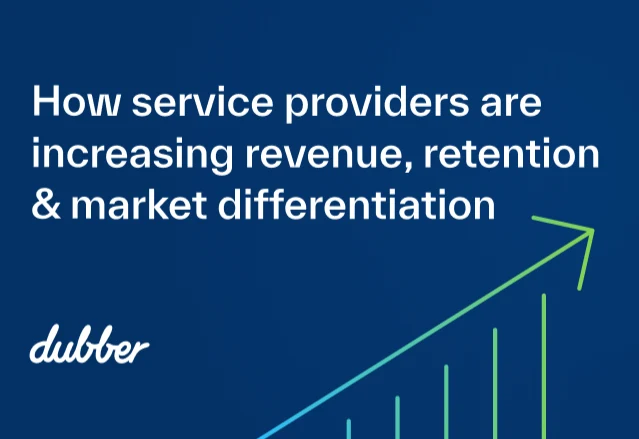
Nearly every Service Provider strategy starts with one or all three.
Service Providers are under pressure. In an environment where sources of value are ever-decreasing and product offering differentiators are slim, increasing revenues is a challenge. 2021, McKinsey suggests, was a critical year for operators: a unique opportunity to fundamentally reimagine their business or, alternatively, risk another decade of decline.
Reimagining the business of operating communications services starts with moving beyond just creating connections to realizing value from the content flowing on the network. Central to achieving this outcome is Unified Conversational Recording (UCR) – through which every conversation is captured for replay, converted to data, and enriched with AI for insights and intelligence.
Demand for conversational recording is unprecedented with Gartner indicating that by 2025, 75% of conversations at work will be recorded and analyzed, enabling the discovery of added organizational value or risk. This is a substantial market opportunity for service providers who already provide the network infrastructure for these conversations.
Embedding conversational recording and intelligence that adds value to existing customers at minimal cost and low configuration complexity is the ideal way to target this trend.
A Unified Conversational Recording solution drives revenue for service providers-
- A typical network legacy call recording solution represents a significant cost – in the millions of dollars to provision, manage and provide ongoing services. A UCR solution is a fraction of this cost, providing immediate yield. Cloud-native call recording services are up to 10X more cost-effective on a per user per month basis. UCR lives in the network and is delivered just as any service would be by the service provider.
- By switching a UCR solution on for every end-point, service providers create an immediately addressable market to sell richer solutions addressing continually rising customer needs.
- UCR solutions allow service providers to enjoy the benefits of SaaS ARR, with pricing models built in line with modern subscription market trends.
What is UCR in a S&SP Network?
UCR is:
- Native to the service provider network: to remove legacy recording costs, and allowing UCR to be delivered as a service
- Cloud-first: for simple deployment, management and provisioning
- On every endpoint: creating immediate differentiation and an addressable market for fully featured solutions
- SaaS ARR: creating a new recurring revenue stream
- True AI: for the ability to unlock conversational insights and solutions revenue
Foundation Partners Benefit More
The Dubber Foundation Partner program was designed to provide service providers with deep marketing, sales and success support – accelerating the conversion of basic Dubber call recording services to richer solutions.
- 100% attach at day one drives differentiation and immediate access to upsell opportunity
- Dubber assisted upsell to SaaS plans – increasing ARPU, in many cases doubling the ARR per customer
- Add & unify other services – further increasing ARPU through cross-sell and access to other communications services used by the customer
- Unlock the potential of conversational data to increase revenue and retention

Expensive, outdated legacy call recording’s days are numbered. And, as a communications providing service, you can capitalise on a new market that’s emerged from an overhaul in antiquated infrastructure.
Up until now, organisations have required significant investment into managed, onsite call recording equipment.
The costs multiply due to dedicated storage and processing hardware, complex high maintenance software, and ongoing service and support. And this service only captures just one line or endpoint – with multiple lines or endpoints needing recording, the process (and costs) starts again.
Unified Call Recording in the Cloud
“Unified call recording solutions offer service providers one area where they can really add value. By uniting voice data from an organisation’s potentially disparate systems, a service provider can ensure that an end customer organisation can leverage maximum value from its data and drive enhancements and optimisation.” – Cavell Group
Unified Call Recording in the Cloud replaces legacy call recording with simple to manage, easy to deploy, cloud-based and on-network infrastructure.
UCR is native to the network and requires zero hardware, complex software or heavy ongoing service and support costs. It’s a modern solution for a modern business communications landscape; across mobile, unified communications platforms, chat, and video – and it satisfies legislative compliance and data security requirements.
UCR is the key to unlocking new revenue and retention opportunities in call recording – and product offering differentiation – and enables you to create and add value to every conversation on your network.
Costs tend towards spare change
Now, the cost of voice-supplementary services is tending towards spare change.
In legacy call recording models, the costs associated with extra data services were also prohibitive; including services like manual transcription, sentiment analysis, fraud detection, and other auditing capabilities.
Only the largest enterprises were able to invest to leverage the true power of customer voice data. Now, with cloud-based services that leverage AI radically reducing direct and indirect management and configuration costs, everyone can enjoy call recording, automatic transcription, and conversational data intelligence. Every conversation can be captured and transformed with AI.
Service providers to embrace new services
Service providers who embrace cloud-based UCR voice-supplementary services can now offer these benefits to businesses across all sizes and verticals.
Service providers who adopt intelligent data visibility and usage platforms can increase their revenue and margin generation while increasing their customer’s dependency on their services. With a need to differentiate in a competitive market, it’s by productising and partnering in new connectivity data and content verticals that service providers will set themselves apart.
Source: Cavell Group
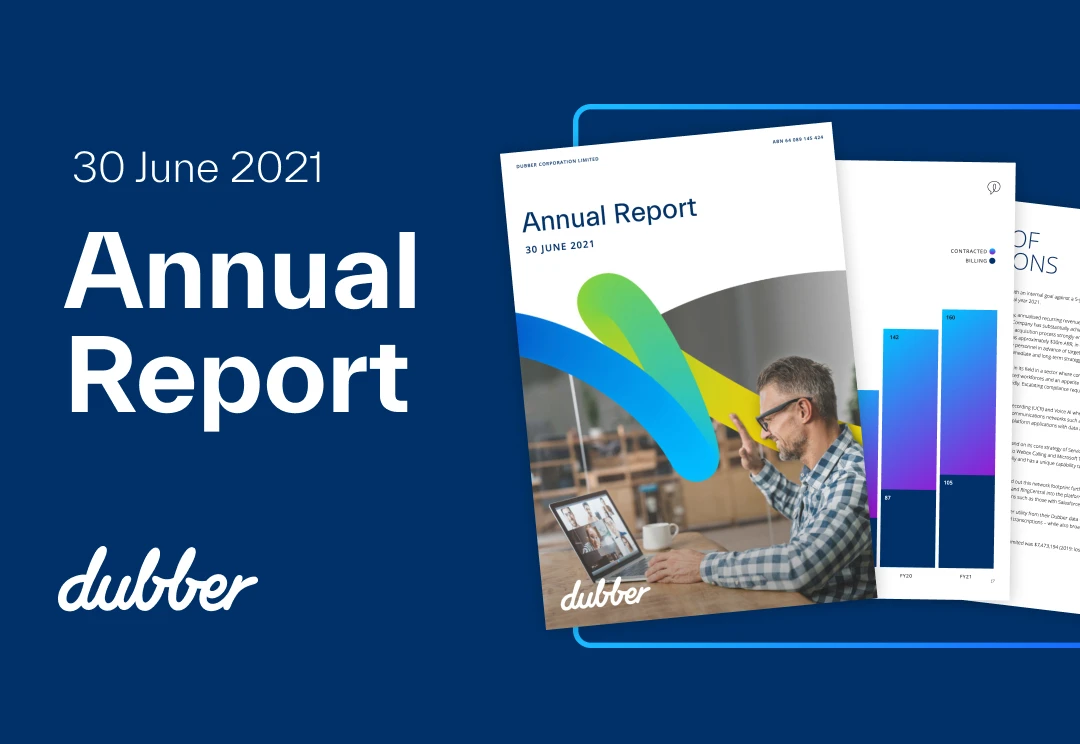
Dubber Corporation Limited (ASX: DUB) (‘Dubber’ or ‘the Company’), the leading global Unified Call Recording & Voice Intelligence cloud service designed for service providers, government, and businesses of any size, today released its Annual Report to shareholders for the year ending 30 June 2021.
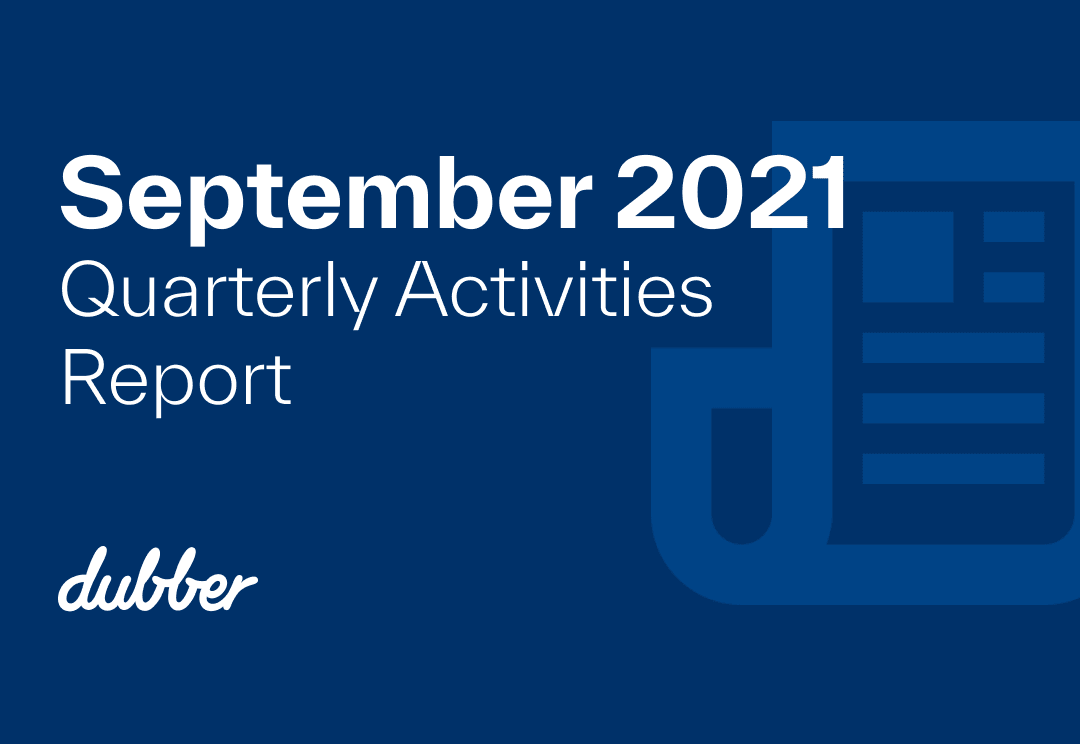
Dubber Corporation Limited (ASX: DUB) (‘Dubber’ or ‘the Company’), the leading global Unified Call Recording & Voice Intelligence cloud service designed for service providers, government, and businesses of any size, today released an update on the Company’s operating focus along with the Appendix 4C for the quarter ended 30 September 2021.

Are you really listening to your customers? Because if you aren’t capturing and unifying the conversations you have with them, meaningful insights are lost.
Sales are a multi-touchpoint experience – voice, video and chat – even more so in this new world. So, how do sales managers uncover hidden revenue?
With total visibility across multiple communication points, a centralised platform, and a little help from AI.
Traditional solutions where the recording is attached to an app or a single connection point limits visibility, introduces complexity and increases cost – inevitably you end up paying for multiple conversational recording solutions.
According to Gartner’s top strategic IT predictions for 2021 and beyond, by 2025 75% of conversations at work will be recorded and analysed. Many of our clients are in tune with these predictions.
Get acquainted with Dubber’s Six ways to improve your sales with Voice Intelligence for a more in-depth look at how you and your team can establish a whole system of continual sales revenue. Dubber’s UCR and AI conversational intelligence supports compliance regulations whilst assisting businesses in enhancing their sales revenue by unlocking insights in calls, video and messages.
Tone and sentiment analysis for opportunities and performance
Having the tone and sentiment analysed from your customers is fundamental in distinguishing who is:
- A prospective customer
- A customer that could be upsold
- An undecided customer
- Not interested
Identifying positive or negative interactions or prospective customers from the sentiment analysis lets you customise your sales pitch to meet specific needs to boost sales.
Tone analysis is a distinct advantage to your sales growth. It helps sales reps execute a consistent and compliant delivery – boosting satisfaction and customer experience, which increases the chances of consumers making another purchase by 89% *.
Forecast and generate more reports
Dubber’s contact centre intelligence looks at all the call activities with powerful analytics- ensuring sales managers can see key metrics at a glance. The dashboard provides a high-level snapshot of call metrics and data analytic solutions for managers to monitor agent performance. These insights include:
- Automate the agent QA process through score sheets
- Train sales and customer teams to implement better solutions
- Set-up out-of-the-box or custom reports (schedulable)
- Access an in-depth activity log for all user initiated activities
Dubber’s reporting tools help improve workplace performance and proactively manage risks – enabling sales managers to learn which products need more consideration or which employees might need additional support on meeting sales targets. Attending this detail allows managers to predict forecasts and achieve better solutions based on analytical insights.
Leverage transcripts for retargeting and retention
With live transcripts from customer conversations, you can keep track of customers’ requests, interests, and expectations. Dubber’s beautiful and insightful transcriptions provide a powerful source of information that can enlighten a staff member or manager on a missed sales opportunity.
For example– a manager reads the transcript of a conversation to a customer. By identifying communication gaps, the manager can recognise the customer is left unsatisfied. Then, using notes from the transcript, they can reach out to the customer and suggest a more suitable alternative, capturing the sale after all. Critically they have an accurate record of the nuances of the conversation to coach and train. Hearsay gets replaced with “knowsay”.
A record of notes and highlights from past conversations helps managers:
- Retarget prospective customers
- Action insights from conversations
- Decrease revenue leakage with immutable proof
- Navigate a system of churn reduction
- Improve training and coaching
Improve order and service accuracy
With real-time transcripts, managers can be confident that information and customer instructions are captured accurately. Dubber’s search filter enables mishaps and miscommunication to come to light.
Disputes are likely to arise based on mistaken orders or inaccurate quotes- stay ahead of this by searching keywords, customers, or employees to find a resolution based on facts from the conversation- not hearsay.
Sales managers use this function to find revenue leakage by examining conversations and seeking ways to improve the sale. Based on these key findings, managers can implement a strategy that outlines procedures to strictly use or to avoid – saving time and retention.
Measure performance on specific keywords or phrases
Managers can set certain spoken words to trigger a notification alerting them of said words within a sales conversation. For example, these words, phrases or trends may be: “New”, “Expire”, “Plan”, “Renew” or “Cheapest.”
These words indicate a particular end of the subscription period, like a plan. So here is an opportunity that managers seek out as it gives them the chance to upsell, cross-sell, or put them on a new plan that’s promoted to reach the sales target. This also allows sales managers to foresee trends occurring and optimise the collected data to engage in a higher sales success rate.
Contribute key findings to marketing
By using Conversational Intelligence, sales managers can determine any gaps in the market and then transfer that data and insight to the marketing teams.
The symbiotic relationship between sales and marketing creates a vital role — they can influence or help shape how the product is understood:
- Positioned in the market (in relation to competitors)
- Identify who are the most common consumers
- If a product/service is resonating with the target market
These insights can help the marketing team build a more in-depth buyer persona and give future marketing strategies a more direct and consequential message.
Discovering hidden revenue opportunities from recorded conversations authorises sales managers to turn key findings into actions, successfully increasing revenue. Dubber’s features enable sales managers to drive actionable insights from the business’s two most important resources: employees and customers.
*Salesforce

The landscape for technology services is evolving, more rapidly than ever before. External environmental factors, including the COVID crisis, have accelerated the evolution of enterprise technology requirements and, in turn, transformed demand for innovative and differentiated solutions from service providers.
Communications service providers face a highly competitive market, with new digitally disruptive and emergent companies, thin-margined pricing strategies, and exponentially exploding user demand and expectations.
The need to differentiate – new roles for service providers in the enterprise connectivity market
Now, more than ever, service providers need to stand out and offer unique differentiated solutions to remain relevant. And that needs to be through a best-in-class multi-vendor, multi-solution suite of services – that provide communication and collaboration services. The UCaaS landscape is the ideal playground for the savvy enterprise-focused service provider.
It’s time we go beyond traditional operating models; to shift roles from simple Connectivity Providers to Service Enablers and Service Creators. Out to 2030, there is up to USD 700 billion in B2B value at play in these new role markets, and that’s just across 5G opportunities alone.
This new way of doing business allows service providers to think like cloud providers and productise critical, emergent communications services on their networks. And, like cloud providers, these services need to be enabled to customers with a click, and provide a self-service interface.
Could customer experience be a critical product offering win?
Qualtrics ROI of Customer Experience 2020 report showed that 94% of customers would purchase more from a company with very good customer experience (CX), as well as recommend them to others, resulting in increased revenue and reputation building. As a service provider, being able to offer enterprise customers a CX product that’s ready to go, no matter their communications infrastructure is a clear, easy win.
A principal strategy: adding embedded Conversational Intelligence as a Service to the list of products available for businesses, yes, switched on with a click. It’s customer experience, reimagined with the power of data – by Dubber.
Learn more about how new productization is key to service providers winning in a crowded market where margins are slim. Download the Cavell Group whitepaper, commissioned by Dubber, “Service provider differentiation through customer experience.”
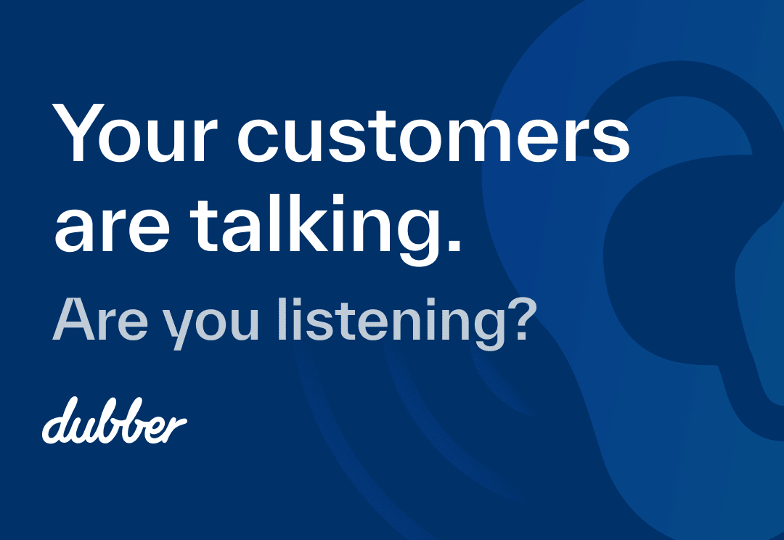
A wealth of data is locked in the conversations your business is having with customers. Conversational intelligence is the key to unlocking that wealth so you can differentiate your business in the market, boost revenue and retain customers.
Chances are, you already listen to your customers.
You do if you use call recording for compliance or training purposes.
That means you are capturing valuable insights into business performance.
Listening to what customers say is the best way to understand what they want. Pay close attention and you will know what they think and how they might respond to offers. You will understand them better.
It’s important to hear both the words and the music in a conversation. That is, the tone, the hesitations and other non-word clues.
Do that and you’ll pick up crucial insights you won’t find in other forms of communication.
Until now this has been hard to do.
Face-to-face listening is hard to scale. Team members dealing with incoming calls tend to focus on specifics. That’s how they are trained and it is how they are rewarded.
Any intelligence gathering done the manual way is, at best, secondary.
Now, thanks to Dubber cloud-based call recording, you can listen and understand what your customers are saying. Cloud based recording means you can capture every spoken word. You can collect both the words and the music of business conversations at scale.
There’s something certain about an audio recording of a conversation. Other records, either a written note or a reported conversation are only hearsay. They can’t be substantiated. In a strict legal sense they are little more than rumour. There’s always a degree of uncertainty. With an audio recording, or a written transcript of an audio recording you are dealing with verifiable information.
What’s more, when you capture a conversation by making notes, you are not listening closely enough to what is being said. Your brain is in a translating, transcribing mode. It’s controlling your pen or your figures on a keyboard.
When everything is recorded in the background you can focus on listening.
Better still, the technology means you can automate the listening.
AI, sentiment analysis and other techniques can pay close attention to every moment of every conversation.
Say there’s a barely audible wince when your team member mentions price to the customer. Or a gasp when new product features are described. They are powerful signals that team members might overlook — the software doesn’t miss a beat.
It means for the first time you can know what customers actually think.
You can better understand customers and their needs.
This gives you the power to differentiate your business.
You’ll get better customer satisfaction.
AI tools can warn that a customer is thinking of going elsewhere. You’ll have time to move in early to avoid losing their business.
None of this requires dramatic change to your business process. It uses tools you have at your disposal.
Now is the time to act.
Gartner says by 2025 companies will record three quarters of business conversations.
Voice is the most common communications channel between a business and its customers. Around four out of five customer interactions are voice conversations.
Once you are recording all your calls, it’s a short step to mining them for customer intelligence.
The best way to do this is with cloud call recording. In the past companies installed on premise call recording systems. They linked them to centralised call centres.
That’s useful, but centralised call centres only capture half of all customer conversations. Many businesses have found accessing and mining calls from legacy systems difficult and slow.
These days the interactions that matter take place elsewhere. Remote work teams and mobile employees mean people can take calls anywhere.
That’s why capturing voice data at the network level is vital. A cloud call recording system with instant easy access to conversations like Dubber does this for you.
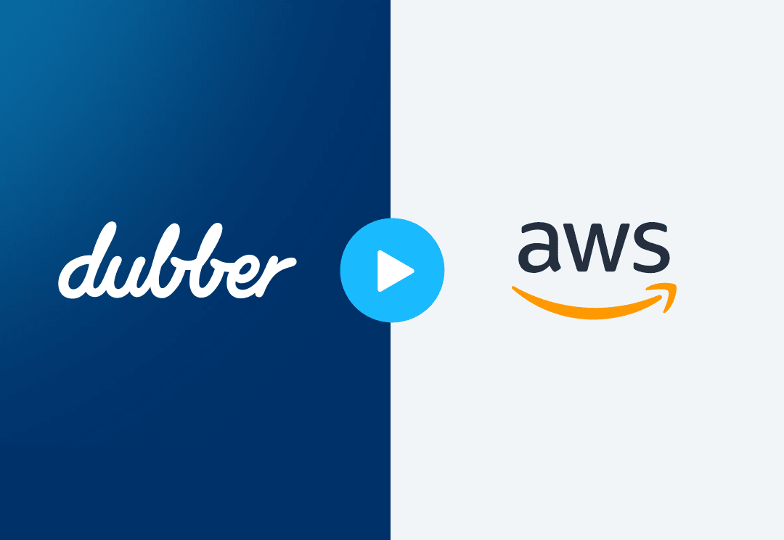
We’re cloud-native – proudly always have been. Back in 2011, at a time when cloud services were more conceptual than reality over here in Australia, Dubber realised the massive potential of making our product a cloud-native offering.
Partnering with AWS in their first Australian regional offering almost 10 years ago was a no brainer for us – and continues to be a valued and foundational partnership, as AWS goes from strength to strength as the world’s largest cloud services provider.
James Slaney, our Co-Founder and COO, sat down with Aley Hammer from AWS to talk about Dubber’s success on AWS to date.
Watch as James unwraps the power of Voice AI for businesses worldwide, how service providers are leveraging Dubber to create more value for customers on their networks, and how our centralised data services platform on AWS is available at the click of a button.
Thanks to AWS and the power of cloud, we can offer unlimited scale and always-on availability that modern enterprises have come to rely on.
For those with a different enterprise architecture mandate, we’re also ready for your data storage and processing requirements on Azure, GCP, data centres, internal enterprise or hybrid environments – so ask us if you had something a little different in mind.
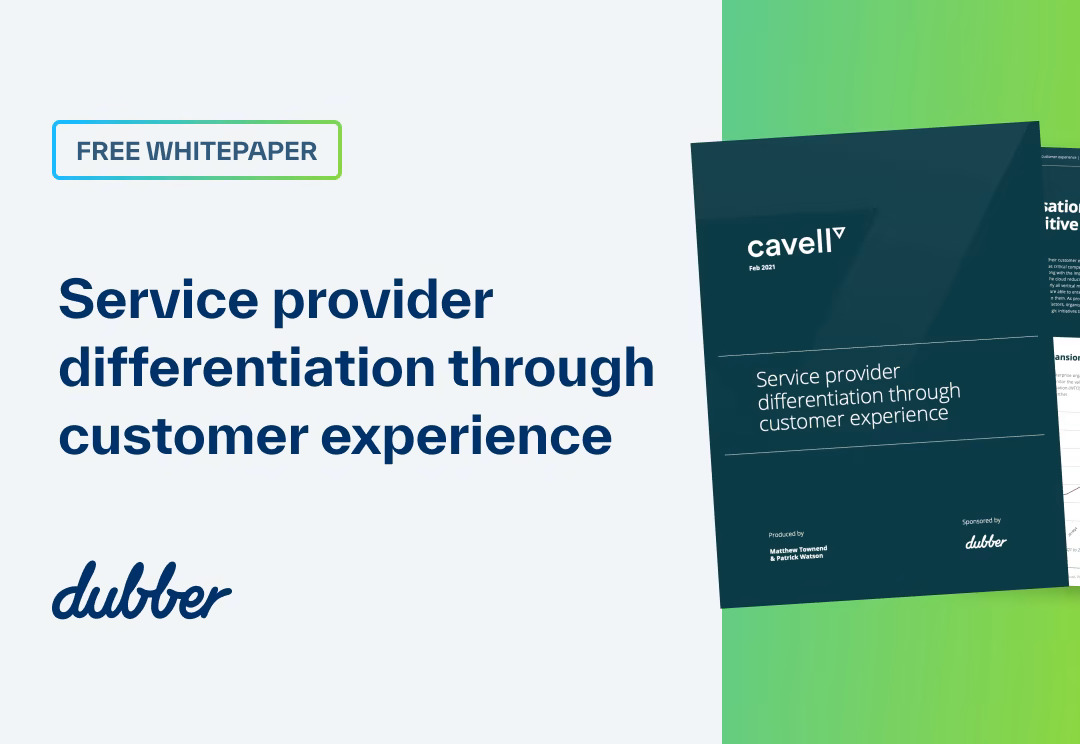
Learn how service providers can increase revenue, retention and differentiation through customer experience. Exclusive insights from Cavell Group.
Learn more about:
- Why customer experience is a critical driver
- How Unified Conversational Recording can drive revenue, retention and differentiation
- What matters most in transforming competitiveness
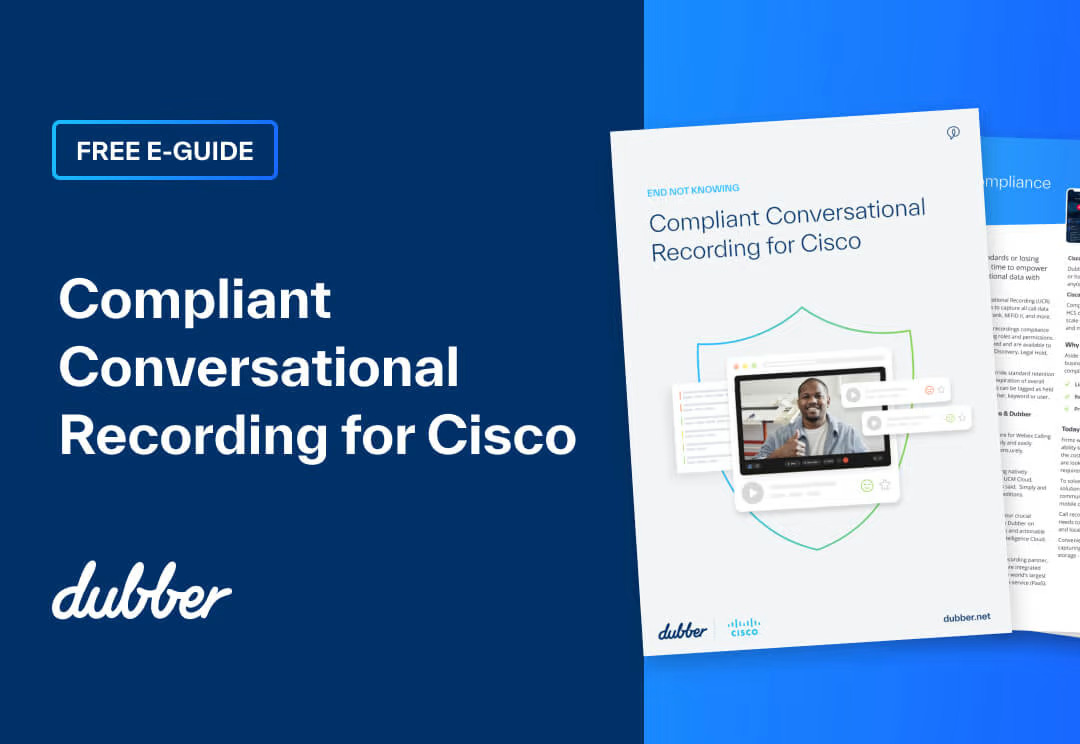
Whether you’re on Webex Meetings, Calling, Unified Communications Manager Cloud, CUCM, HCS, or BroadWorks, you want to ensure your business conversations meet compliance requirements.
Read our guide to Compliant Conversational Recording for Cisco to learn about how to:
- Use Unified Conversational Recording (UCR) to meet all compliance mandates
- Reveal insights from voice recordings
- Drive down compliance costs across the organisation
- Use UCR effectively on Cisco
Download our guide to Compliant Conversational Recording on Cisco to find out how to meet compliance imperatives across all your Cisco communications services, with our affordable, easy to manage, and cloud-based solution.
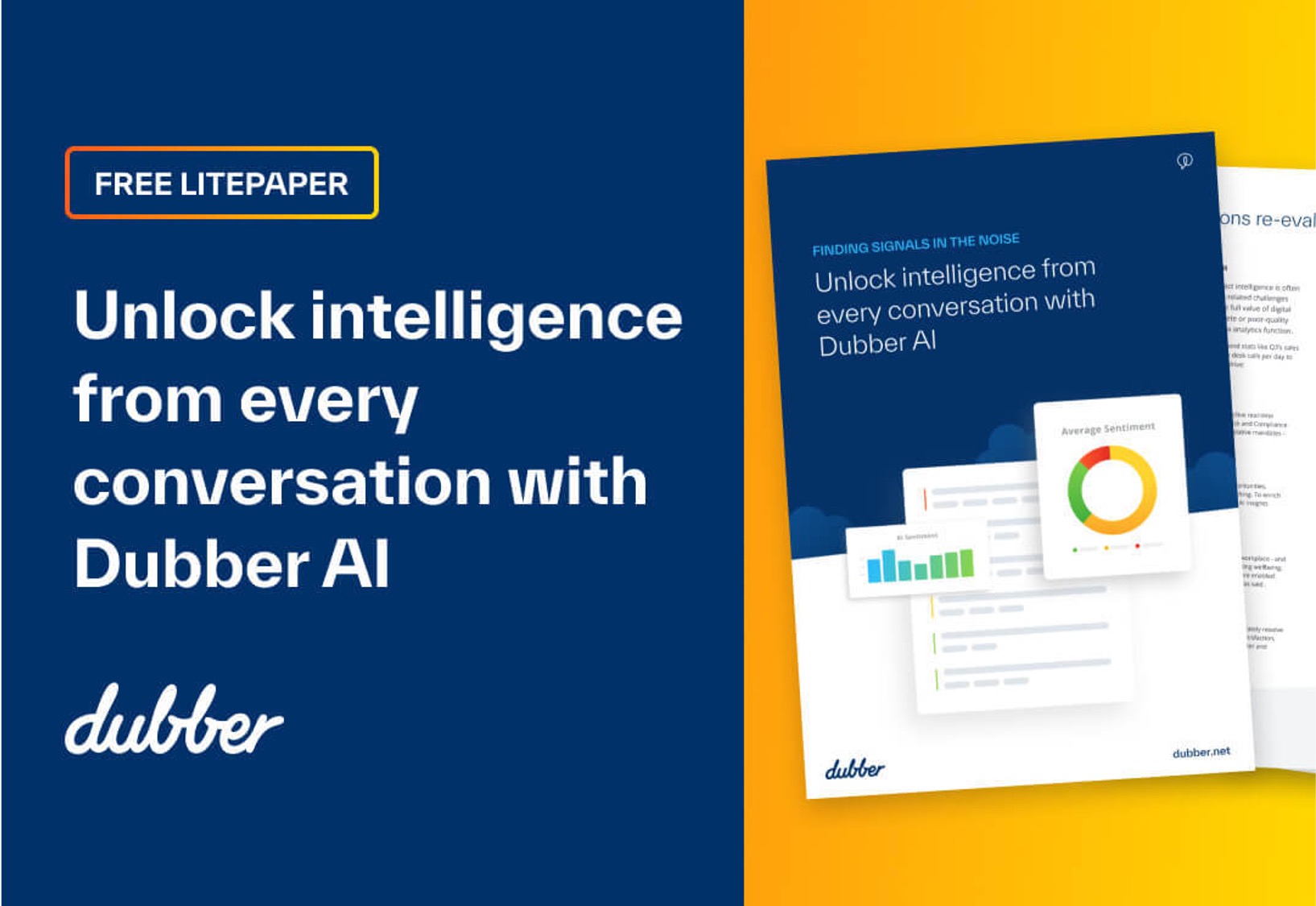
Capture more than an mp3, video, or flat transcript – unlock the power of Conversational Intelligence with Dubber AI.
Conversational Intelligence: beyond basic recording and transcription to an enriched data-set of words, speakers, emotions, languages, and themes. With these meaning-enriched data sets, users can create and trigger real-time automated actions and workflows.
Download our Dubber AI whitepaper to find out:
- How to unlock comms channel data silos with Unified Conversational Recording
- How we embed Dubber AI into every conversation; to hit compliance mandates, plus fuel revenue, people, and customer intelligence
- What’s under the hood in Dubber AI & the Voice Intelligence Cloud
- Use cases & best practices for Dubber AI-enhanced conversational analysis & actions – improve customer experience, boost employee performance, heighten fraud detection, and more
Capture conversations, enrich with AI for the full picture, surface dataset insights in real-time, and create trigger-based actions on conversations as they happen.
Here’s how Dubber AI does it.
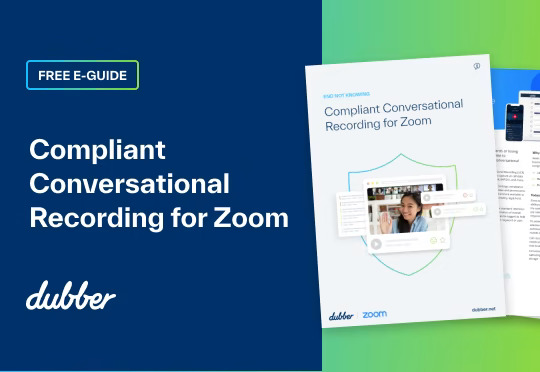
Are your Zoom conversations compliant?
Don’t get lost in the midst of manually trawling through your team’s conversations making sure they’re adhering to compliance regulations – keep a scalable system of record with Dubber.
With today’s compliance challenges, can you really afford to turn a blind eye to the risks of non-compliance in your business?
Read our guide on a more in-depth look into how we’re prioritising surveillance with Zoom conversations:
- Solving compliance problems with Unified Conversational Recording (UCR)
- Why small and large businesses are recording their Zoom conversations
- Legacy Call Recording Vs Unified Conversational Recording
- 15 Conversational Recording imperatives
Download the guide now to help your business enhance sales performances, drive operational efficiency, improve customer service, and help reduce costs significantly- all compliantly.
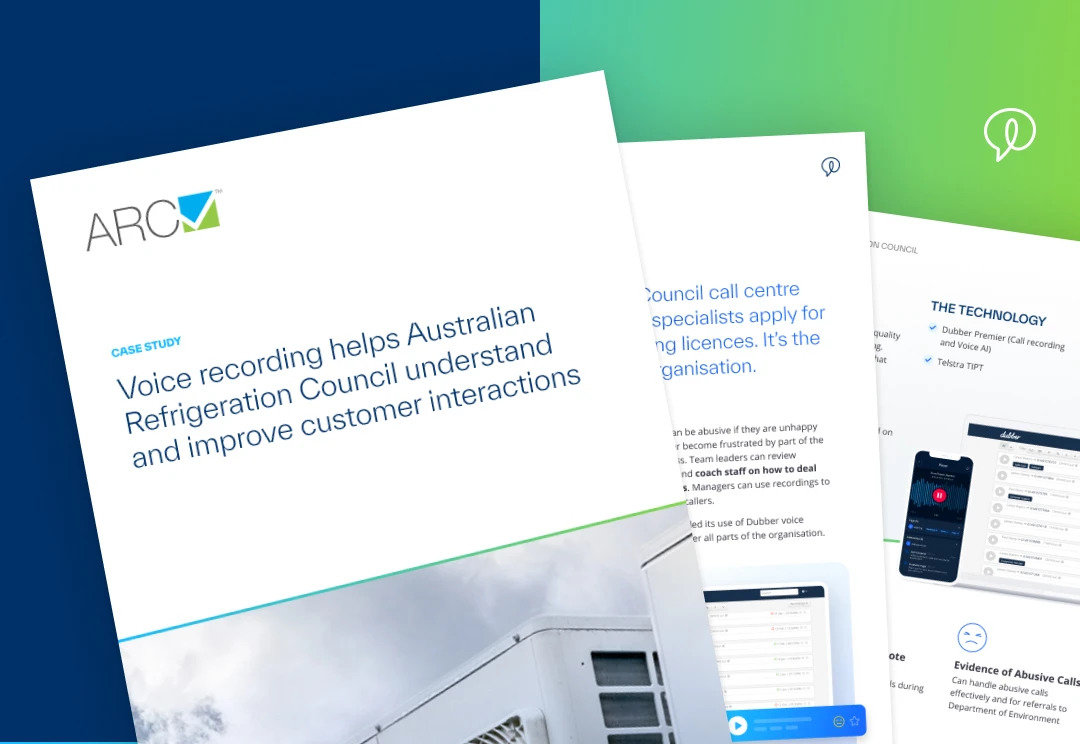
The Australian Refrigeration Council turned to Dubber for better staff training, to monitor the quality of contact centre calls and collect the evidence it needs to deal with abusive calls.
The ARC operates a call centre where employees help tradespeople and other specialists apply for new licences and renew existing licences. It’s the main point of contact for the organisation.
IT operations manager Andrew Growcott says at first the ARC deployed Dubber call recording in the Melbourne-based call centre. There’s a team of about 18 staff who handle around 1100 calls each week. They wanted recordings to track the quality of customer interactions and also to help deal with abusive calls when they happened.
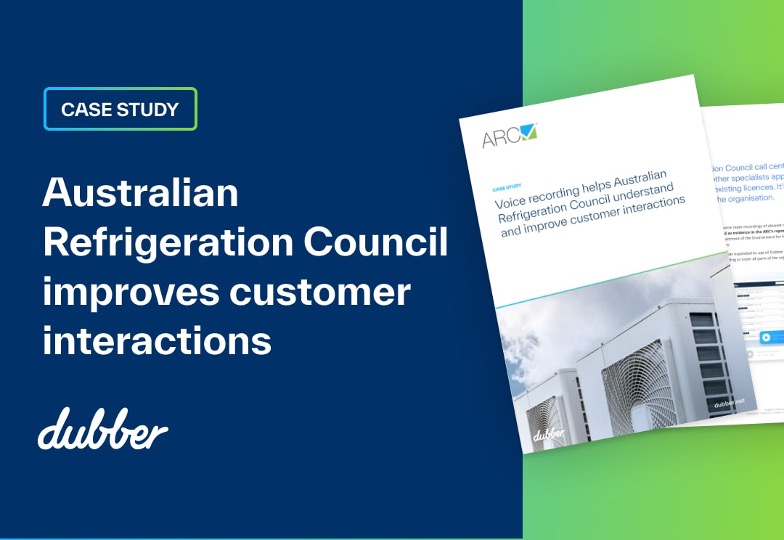
The Australian Refrigeration Council turned to Dubber for better staff training, to monitor the quality of contact centre calls and collect the evidence it needs to deal with abusive calls.
The ARC operates a call centre where employees help tradespeople and other specialists apply for new licences and renew existing licences. It’s the main point of contact for the organisation.
IT operations manager Andrew Growcott says at first the ARC deployed Dubber call recording in the Melbourne-based call centre. There’s a team of about 18 staff who handle around 1100 calls each week. They wanted recordings to track the quality of customer interactions and also to help deal with abusive calls when they happened.
Why ARC Chose Dubber
Andrew says ARC found Dubber when searching online for call recording systems. He liked the fact that Dubber is an Australian-based business and that the service is available from Telstra and runs on their calling system, Telstra TIPT. He says it was easy to deploy and get started.
Before it used Dubber, managers were able to listen in on calls for training purposes. If an abusive call came in, they might jump on the line, but often by the time the manager was involved, the caller had calmed down so the conversation was missed. There was no recording or transcription.
Staff training
Team leaders review calls for staff training purposes. If someone reports an issue, they’ll focus on that call, otherwise they pick calls to review at random. The team leaders will sit with staff members and help train them on how they can handle calls better and how to answer certain questions.
“It helps us identify who is lacking knowledge in certain areas and needs more training”, Andrew says.
Visibility during COVID lockdown
In normal times they all work in the main building, however during lockdown the people worked from home. Dubber, which works in the cloud and records at the carrier network level, was able to go on recording all incoming calls as normal. That’s not something on-premise recording systems are able to do. This meant team leaders still had access to every call without interruption.
Dealing with abusive calls
Sometimes the call centre receives abusive calls from customers that might be unhappy with the cost or frustration with the licence process.
Team leaders use Dubber to review the calls and either coach staff in how to better handle difficult customers or so the manager can follow up with the customer.
Expanded use
Since first deploying Dubber, the ARC has expanded its use and recording now covers almost everyone in the business.
Andrew says: “We looked at how well recording went in the call centre and decided to expand the recording to everyone in the business. If managers get abusive calls forwarded to them we can now track that whole interaction. Letting everyone record means we can now review the calls and decide how to deal with them.”
Like to Learn More?
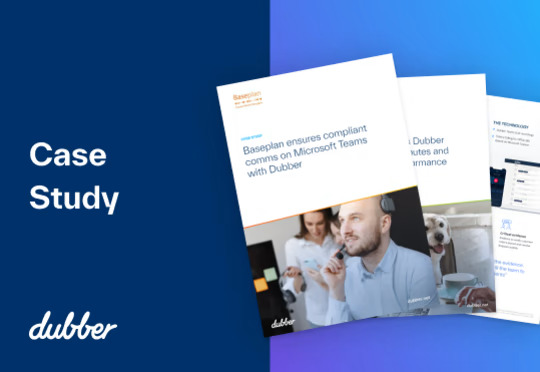
Dubber ticks all the boxes – compliance, simplicity and efficiency
Discover how Baseplan, a wealth management and advisory firm, based in Dublin, Ireland uses Dubber’s call recording and voice AI to ensure compliant communications on Microsoft Teams.
“We needed peace of mind that our client-facing staff were communicating compliantly. Dubber has given us the confidence and visibility of that”. Gordon Mellon, Managing Director, Baseplan
Download the case study to discover how Baseplan:
- Securely captures every client conversation across any device for compliance with regulations, including MiFID
- Eliminates the requirement for time-consuming manual transcription and storage of calls
- Avoids CapEx costs for hardware and equipment with flexible user-by-user retention policy settings and unlimited scalability
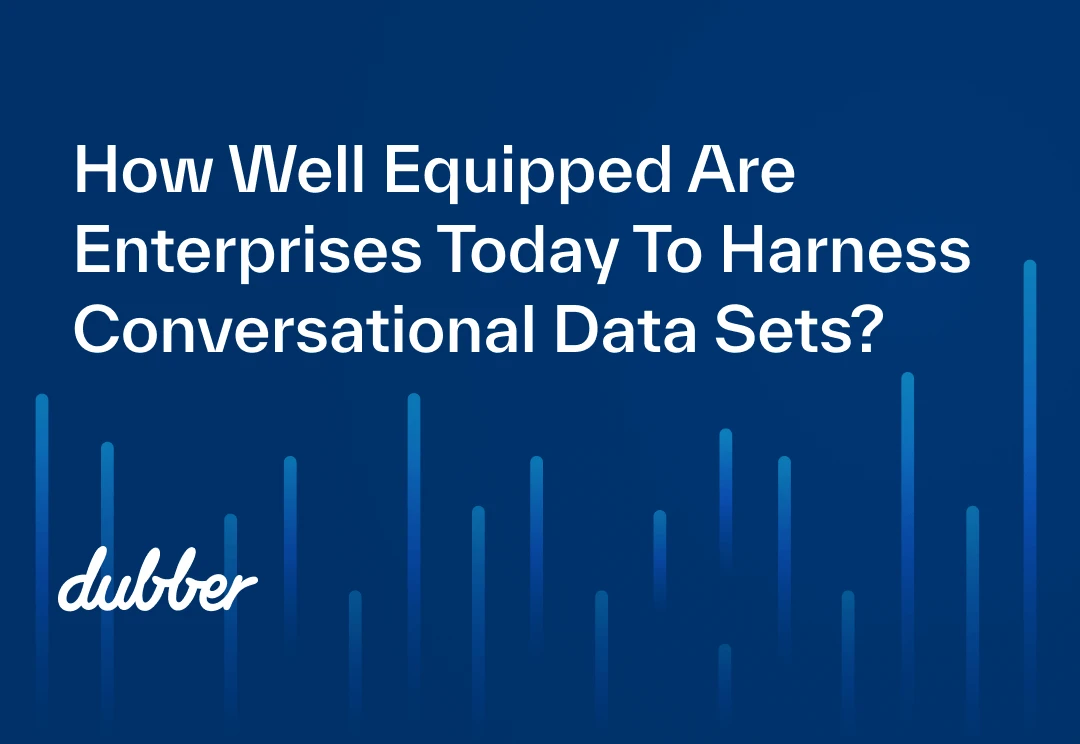
Data is what runs an enterprise. If you don’t believe it, just take a look at your business financials. But we’ve come a long way from just analysing revenue and spend. There’s now the opportunity – and business imperative – to look at all business data. And what greater goldmine of information than the conversations within your business, with your partners, with your customers, and with the public?
“Data Masters enjoy 22% higher profitability, 70% higher revenue per employee, and 245% higher fixed asset turnover over their peers”
– Data Mastery, Capgemini.
Turning conversations into meaningful business data is the first hurdle. Leveraging that data is the next. Here are the common challenges faced by enterprises in harnessing the power of conversational data sets.
Challenge: Legacy technologies have fragmented datasets
“80% of data producers and consumers regularly have data quality issues.”
– The State of Data Quality in 2021, Datafold.
Data is locked in legacy systems and often incomplete
Organisations have been using legacy, on-site and even manual technologies to record, store, transcribe and annotate voice conversations. With these solutions, archives may be limited and the data itself limited (e.g. only sound files stored, manual and incomplete data tags).
Data is usually fragmented across multiple channels/systems
Legacy systems generally only capture one channel at a time, which is no longer useful when considering that we now operate across call centres, Zoom, mobile, and more. There may be a number of different systems across different channels, each with its own data, views, and storage formats. This siloed effect means conversational data is fragmented.
Solution: Unified Conversational Recording technology
Bringing together conversational data in a centralised location across all the different channels is imperative – where it can live as one standard dataset. While some channels may lack particular data points (e.g. voice calls won’t have a video recording), the data across channels and services will be standardised. This data needs to be instantly portable so that it can be used in other business applications.
Challenge: Lots of data is required for AI to be accurate (maybe more than you have)
“There is a difficulty of obtaining data sets that are sufficiently large and comprehensive to be used for training.”
– Driving impact at scale from automation and AI, McKinsey
Industry-specific (e.g. Financial Services regulation) or domain-specific (e.g. Sales) context and dialects
Industry, domain and company-specific context and dialects aren’t always understood immediately by AI – it needs the right metadata, direction and training. For example, in Australia’s new internal dispute resolution regulatory guide for financial services businesses – ‘RG 271’ – the directive is that these businesses need to acknowledge complaints and respond within given timeframes. But what does a complaint necessarily look like in a conversation? Is it the word ‘complaint’, an angry tone of voice, or a specific utterance? Are there cultural conversational identifiers that indicate a complaint?
Solution: Capture everything, using NLP to learn your business language
Using NLP to do a deep dive into your conversational data is the only way to be able to address these type of specific business needs. Being able to acutely examine tone, sentiment, and regional differences is the key to actually understanding your employees and customer base. Without conversational metadata and NLP in circumstances like this, you’ll be left in the dark. Once you have all the right data, AI can do its job properly.
Challenge: Leveraging the cloud to reduce time to value
“The hybrid cloud platform can deliver value to the business by enabling digital transformation, giving it the best from the public cloud and on-premises infrastructure services, and transcending the corporate boundary.”
– The Business Benefits of a Hybrid Cloud Platform, DXC.technology
Some large organisations are still in the early stages of their cloud strategy implementation, and may still be working out or piloting solutions to find the best-fit and economics for their hybrid model. This complexity and legacy infrastructure limits the pace at which the organisation can change.
Solution: Look to cloud-native solutions that can integrate with legacy infrastructure
No matter where you are in your cloud maturity across the enterprise, what you can do is ensure new enterprise solutions like Conversational Intelligence are themselves cloud-native by design with the ability to integrate with your existing legacy solutions. While other cloud migration activities may take time, you can benefit from new cloud-native solutions immediately.
Challenge: Innovating with the data
“Accompanying any technological shift is a change in tools, processes, and equally as important, people and behaviour. Even with the most cutting-edge technology and well-documented processes, users need to feel empowered to adopt modern BI solutions, as they are the ones who will drive insight-driven decision making.”
– Modern Business Intelligence, Deloitte.
Many enterprises are still focused on creating data assets – which is great, but doesn’t create value in and of itself
Yes, getting quality, complete, clean datasets is a significant priority. But alone, this data is only useful to data workers – who need directives and business questions from leadership, departments, and individuals to make sense of the data.
Solution: Develop strategic plans for what to do with the data
Make a start building the business capabilities to leverage data
Leveraging business data is where leaders in business are streaking ahead. This equates to data workers, data-ingesting applications and strategic plans and roadmaps for analysis, reporting, and automation of business data. Learning how to use data effectively is the first step.
Ultimately, organisations want to empower every employee to be able to use data insights to drive efficiencies and answer relevant complex business questions in their work.
Equally important is changing culture and ways of working
Data and insights are historically hidden in organisations, only accessed by managers or disclosed quarterly. Data capture activities have been mysterious. By opening up the visibility of capture and useful real-time insights to a wider audience, we’re able to change the culture within the organisation to feel empowered by, and trust, business data.
This trust component also underpins technology program rollouts. Workflows and automations built on business data need to be used to have effect. When leadership falters on directives and messaging, employees default to known processes. While hesitancy in revolutionary technology is natural, the business benefits you’ll gain can’t be disrupted by a 2010 mindset.
Are enterprises today ready to harness the power of conversational data sets?
Technology-forward businesses have made great strides in leveraging conversational data sets, but for the rest, there is still foundational work to be done. Picking the right technologies, using the right data, and – most importantly – knowing how to put that data to work is the path to success.

The use of artificial intelligence in sales has been increasing in popularity as it facilitates customer service or sales professionals to concentrate on more important work, as machines do the ‘busy work’.
While AI promises to do much to boost sales productivity and effectiveness, most are still in the earliest stages of realising its benefits According to The AI Dossier survey 2021, 74% of businesses are still in the AI experimentation stage and only 26% of businesses focus on deploying high impact AI use cases at scale.
Here are six ways to improve your sales outcomes using a conversational intelligence service – like Dubber – to analyse and action call, chat and video conversations. And implement successful strategies to improving retention, training, and customer experience.
What is voice intelligence?
Voice intelligence uses artificial intelligence (AI), in the shape of machine learning, natural language processing (NLP), and real-time speech recognition to analyse calls, and digital conversations.
Dubber’s voice intelligence comes in the form of a specialised Unified Conversational Recording platform. Dubber’s UCR enables organisations to be more efficient in the management of their day to day communications and learn more from customer conversations. From automating note-taking to detecting customer sentiment, conversational intelligence is ending not knowing in businesses of every kind.
1. Don’t miss a conversation
As we say at Dubber: record, replay and reveal.
Having a solid foundation for Unified Conversational Recording (UCR) is essential for capturing, storing, and centralising your customer sales interactions.
Recording every voice, video, text, and chat across any communication device and end-point is where your sales will see an improvement. This enables you to catch sales conversations and turn them into actionable insights – seeing where you can drive an increase in revenue and retention.
Conversational Intelligence and UCR are two quintessential pieces in capturing recordings. These conversations are where 80% of the most crucial conversations with customers and employees occur.
2. Get the full picture with intelligent transcription and search
By complimenting Dubber’s advanced AI and natural language processing with multi-vendor AI technologies – live transcriptions can help seal the deal in your team’s sales conversations.
Here’s how the sales team and managers use Dubber’s live transcriptions:
- Always have context as to the previous conversation
- Understand the customer — know their requests, interests or boundaries
- Verify orders and T&Cs — key to effectively resolving future issues and disputes
- Note important details — stay focused and save time with the notes automagically connected to your CRM platform
- Use transcriptions to coach and train staff
- Monitor advice provided in line with compliance regulations
Take advantage of our advanced features to automatically detect the dominant language spoken.
Let’s say: A customer mentions she previously spoke to an employee about a different plan but can’t remember which plan it was. Easily search transcripts to find precisely which plan your employee suggested- without wasting any time.
3. Learn more about customer and employee sentiments
Sometimes we can have a hard time reading people’s emotions- especially when you’re not face-to-face.
With Dubber’s AI sentiment insight, you can now know what your team and customers are saying, feeling and needing. This is a distinct advantage to the growth of your sales as the tone analysis helps sales reps provide a consistent and compliant delivery. Boosting satisfaction and customer experience increases the chances of consumers making another purchase by 89%.
Dubber AI sentiment analytics combined with machine learning and NLP to save you time conducting employee call evaluations.
It analyses the spoken words in conversations by:
- Categorising them as positive, neutral, or negative
- Labelling calls against seven emotions
- Identifying the dominant language spoken
Let’s say: You have a new employee and they are trying to push a sale but are coming across as abrasive to the customer. The customer is frustrated and angry but you can use this information to help the sales rep work on their communication skills.
4. Search, filter and find across all conversations in real-time
Frantically searching for that customer interaction transcript from a week ago? Look no further than quick, elastic and instant search within Dubber.
Save stress and time with instant search results from real-time recordings by team members or customers. Dubber extracts information and insights from the conversation and categorises and organises the context.
You can apply the filter on the search function to specify:
- Team member
- Day/Time
- Keywords
- Tags
- Phone number
Show that you’re attentive to detail. Utilise quick cross-referencing on the go, verify accounts, or see what type of service, plan or products the customer is currently using. You’ll avoid chasing tails and save the customer from having the same conversation.
Let’s say: David is the best sales rep in your team. When training a new employee, you can filter and search all, or some of David’s calls for training and coaching purposes.
5. Get notified and stay on top of monitoring conversations
Sometimes we can find mistakes or red flags a little too late with legacy call recording, resulting in a loss.
Rest assured with Dubber’s real-time alerts and notifications you’ll stay ahead and be ready to diffuse situations when specific words and phrases are triggered.
You’ll be able to:
- Create notifications from a negative sentiment
- Alert on critical sales terms e.g “Not interested”
- Alert immediately or at the end-of-day summary
Utilise these options to get a leg up on your competitors – create an immutable record of best interests efforts by gaining insight from prospective customers and what your opponents may be offering. As well as trends emerging, or if a sales script just isn’t resonating with customers- you’ll know.
Let’s say: You’ve set an alert every time a customer says “not comfortable” and identify that many of the instances refer to when a customer says “not comfortable with sharing those details over the phone”. You can work out that this might be a common concern and highlight PCI compliance and security measures in marketing messaging.
6. Offer safe and easy payment options
People are more aware and definitely more sceptical of giving out personal information these days. As your sales conversations travel into confidential territory, you could be at risk of losing revenue if customers are reluctant to give out sensitive information via phone or video.
But here’s where you get the upper hand — Dubber’s PCI DSS solutions have enabled billions of dollars over phone payments globally. All data is encrypted and stored within the produced region, guaranteeing data compliance.
Encourage your team to communicate to the clients that:
Dubber’s Voice intelligence assures you that the PCI solutions hosts secure payment platforms that intercept any card data from entering your contact centre environment – basically bulletproof!
Let’s say: You’re speaking to a customer and they wish to pay a bill over the phone using a credit or debit card. Rather than asking them to read aloud their details, they type in their payment card details using their telephone keypad with a PCI compliant voice intelligence solution.
Improve sales while ensuring internal company policy compliance
With Gartner estimating that remote workers will represent 32% of all employees worldwide by the end of 2021, keeping conversations compliant can be very hard to oversee. But with Dubber, you have effortless yet total visibility of all your team’s conversations all in one place.
Managers use voice intelligence to ensure the team adheres to internal policies and collects data from customer insights that can be used to their advantage. This will drive team and sales performance to new lengths. Managers use voice intelligence as a tool:
- Save time monitoring and reviewing calls
- Enable teams to meet sales targets
- Manage and store conversations from teams
Let’s say: Your manager is reviewing your conversation with a customer and they identify a missed opportunity for you to make a sale. They playback said instance to you and utilise for coaching.
One of the most exciting and significant advancements of AI in sales is the development of voice intelligence. As you can see, voice intelligence and UCR software offer teams, managers, and organisations the upper hand. Hopefully, you’ll get some good ideas from this and pick up on some critical features of Dubber’s voice intelligence and apply them to your business.
Look forward to knowing your customers and expediting sales!
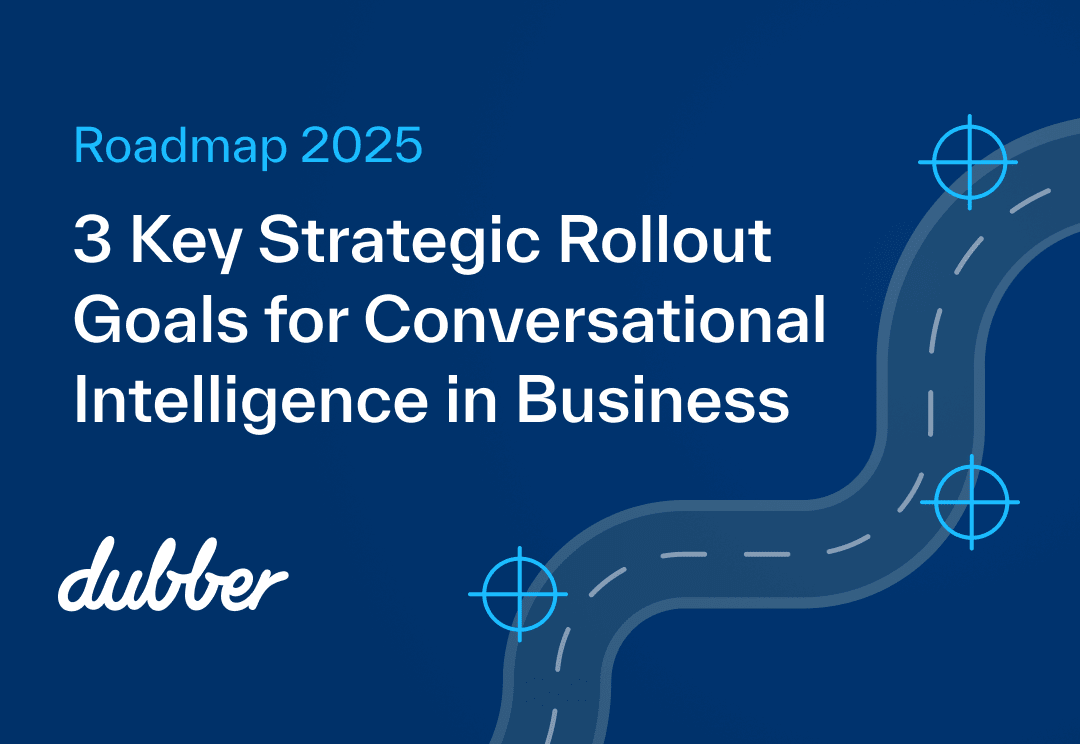
“By 2025, 75% of conversations at work will be recorded and analyzed, enabling the discovery of added organizational value or risk.”
Gartner’s prediction, one we quote often, comes from the Top 10 Strategic Predictions for 2021 and Beyond: Resetting Everything. The paper is one that clever CIOs use to help shape their company’s strategic plans, capturing trending societal, business, and technological changes to ensure successful business advantage going forward.
So what does this mean for business and government over the coming years?
Conversational Intelligence is a powerful tool, but one that needs strategic direction to have the most significant impact on business.
Map timelines for successful business outcomes with these three key goals.
1. Meet compliance mandates and decrease risk
“In 2020, penalties have totalled $10.6 billion for non-compliance with Anti-Money Laundering (AML), Know your Customer (KYC), data privacy and MiFID (Markets in Financial Instruments Directive) regulations.” – Up Close and Personal; The Year of Personal Accountability, Fenergo
Hitting compliance mandates is the lowest-hanging fruit for strategic planning in Conversational Intelligence today. It is possible to satisfy compliance mandates and legislation in voice conversations within company, industry, affiliative, and regional requirements today with Conversational Intelligence.
With growing business data and information security overheads and reporting mandates across all sectors, business voice conversations also need capturing to ensure compliance. Unified Conversational Intelligence is the only solution.
To do this effectively, companies must ensure:
- The unified conversational intelligence solution records all relevant in-person and remote voice conversations – it needs to do so with appropriate controls in place and without ties to specific applications, rather as a service
- Recordings, transcriptions, and conversational data and metadata sets are stored in accordance with relevant data security requirements and timelines
- Conversational Intelligence data is quickly searchable, replayable and reportable
- A unified conversational data set is secured, protected and managed to the same standard as all datasets
Phase two of creating business outcomes – whether for compliance, revenue, people or customer intelligence – is to present multi-dimensional insights such as instant notification of breaches or risky activities, flagging keywords (e.g. ‘offshore’, ‘cancel’, ‘unhappy’) or behaviours (e.g. angry customer).
2. Conversational Intelligence value streams aligned to business strategy are identified and actioned
“It’s the opportunity to take your existing product line and market it better, develop it better, use it to improve customer service, or to get a 360-degree understanding of your customer. Data Strategy is driven by your organization’s overall Business Strategy and business model.” – Data Management vs. Data Strategy: A Framework for Business Success, Donna Burbank, Managing Director at Global Data Strategy
The problem facing leaders is that the applications of Conversational Intelligence in business are near-endless. Aligning your Conversational Intelligence focus with key areas already outlined in your strategic plan (or digital transformation strategy) is where you gain the most value from this technology. The same goes for any data-generating activities.
Here are two areas of business improvement identified in a strategic plan and how Conversational Intelligence can help.
Increase productivity in sales revenue
Conversational Intelligence can sit in on sales with every call, every meeting, every ‘coffee catch up.’ From these conversations, it’s easy to identify the tactics, scripts, keywords and emotional indicators that help close sales with customers – and re-train employees to follow successful strategies.
Improve customer experience
If your goal is to increase customer lifetime value via loyalty born of great CX, you need insights on your customer interactions. Rather than ‘How’d we do’ emails, you can automatically analyse all customer interactions (for both customer and employee) to identify where improvements can be made. This could identify key pain points in business for customers and how to solve them, when employees need to be coached due to their manner, or which topics are taking up considerable amounts of time and how to rectify that.
3. From data insights to Intelligent Automation
“While there is investment in IA broadly, only 10 percent of respondents are integrating solutions across its various dimensions: automation, artificial intelligence and smart analytics. While initial fragmentation of efforts is not to be unexpected, organizations need to move quickly to understand how, when and where to integrate efforts across technologies to fully optimize their potential.” – Easing pressure points: The state of intelligent automation, KPMG
Automation should be deployed throughout the business for operational efficiencies – and Conversational Intelligence is a tool that can be used to identify where automation opportunities lie.
For instance:
- Repeated keywords across a wide customer base can identify areas for switching over to web-based self-service to free up operator time
- Action items mentioned in video meetings automatically create and assign tasks in project management systems
- Competitor and product mentions can trigger on-the-fly competitive product analysis reports to display on screen for employees to speak to during the conversation
Creating intelligent automation throughout the business based on data requires significant thought and ongoing investment, but simply can’t be ignored – it’s time to action.
Let’s talk
Conversational Intelligence is available now with Dubber – a cloud-native, compliant, fully scalable solution available across all your usual communication channels. We go beyond basic voice recording and transcriptions to an enriched dataset of words, speakers, emotions, languages, and themes. With these meaning-enriched datasets, you can create and trigger real-time automated actions and workflows. Start planning your roadmap to doing more with your business data with Conversational Intelligence & Dubber.
Let’s chat.
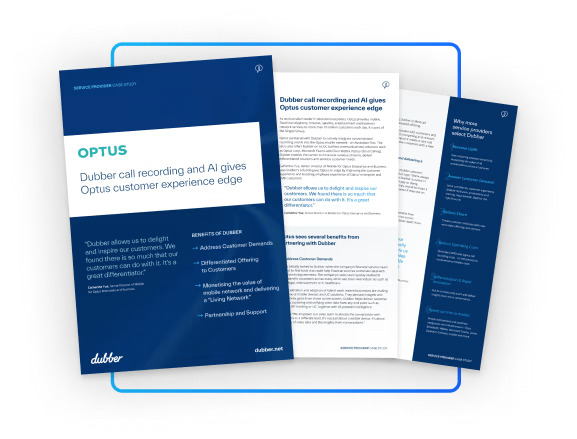
Learn how Dubber enables Optus to drive new revenue streams, deliver differentiated solutions and address customer needs by:
- Address Customer Demands
- Differentiated Offering to Customers
- Monetising the value of mobile network and delivering a “Living Network”
- Partnership and Support
“Dubber allows us to delight and inspire our customers. We found there is so much that our customers can do with it. It’s a great differentiator.”
Catherine Yue, Senior Director of Mobile for Optus Enterprise and Business
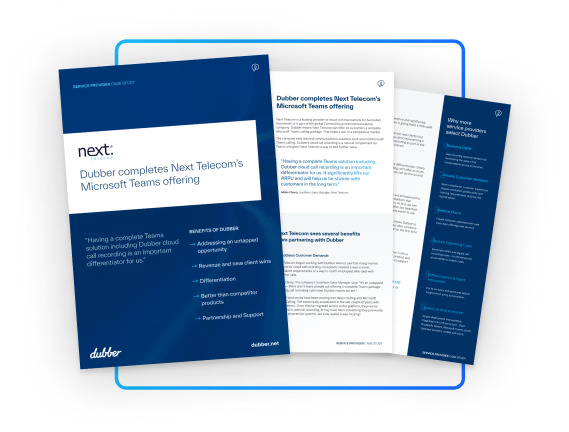
Learn how Dubber enables Next Telecom to drive new revenue streams, deliver differentiated solutions and address customer needs by:
- Addressing an untapped opportunity
- Revenue and new client wins
- Differentiation
- Better than competitor products
- Partnership and Support
“Having a complete Teams solution including Dubber cloud call recording is an important differentiator for us.”
Adam Cleary, Southern Sales Manager, Next Telecom
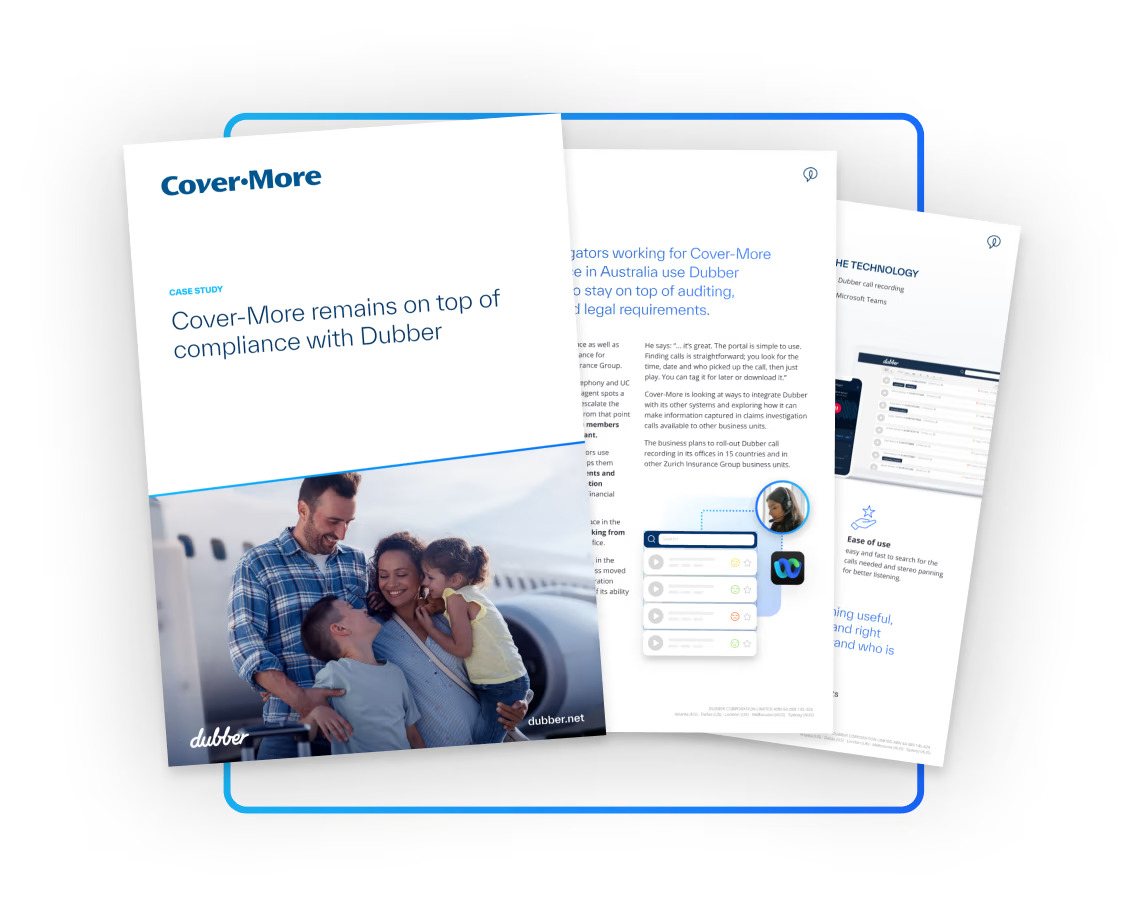
Learn how Cover-More, part of the Zurich Insurance Group, uses Dubber call recording to stay on top of auditing, compliance and legal requirements.
- Uses recordings to provide evidence if a customer disputes a decision
- Meets legal and compliance requirements with recordings and transcriptions of all investigations
- Enables staff to have calls recorded when working from home or office
- Can search and quickly find recordings if needed during investigations
“The claims team needs Dubber call recording to protect Cover-More, the product we sell, the customer holding the policy and to remain compliant.”
Peter Valdes, Global Telephony and Unified Communications Lead, Cover-More Group
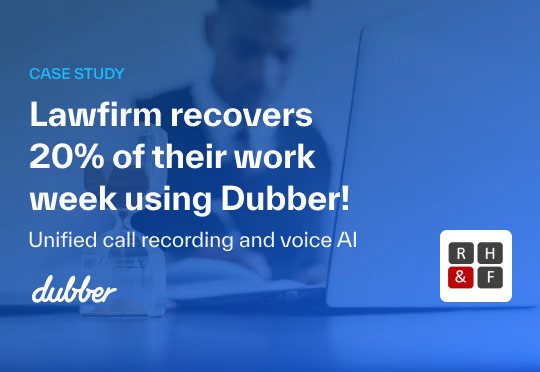
Law firm recovers 20% of their work week using Dubber!
Oklahoma City-based Robinson Hoover & Fudge specialises in debt collection and related litigation. Like many law firms, it needs to record and store phone conversations for compliance and review phone conversations for case reference.
Terri Goldsberry, Robinson Hoover & Fudge’s Director of Operations says: “We use Dubber to record our interactions with defendants. For compliance reasons we have to keep recordings in place in case there are questions.”
Since Robinson Hoover & Fudge focuses on debt collection, mediation and litigation, the firm’s records must be compliant with the Fair Debt Collection Practices Act and the Consumer Financial Protection Bureau.

How unified call recording and voice AI can help you comply with certainty
From October 5 new regulations will cover how financial service companies handle complaints.
Regulatory Guide 271 lays out what companies need to do. The Australian Securities and Investments Commission (ASIC) is in charge of the reforms. It’s guide is an updated set of obligations for internal dispute resolution (IDR) and replaces the existing RG 165.
In this paper we’ll further explore what the regulations mean for financial services firms and how new unified call recording and voice AI technologies can help you comply quickly and cost-effectively.

There’s a new Chief Technology Officer at Dubber! Introducing Steve Willson.
Fresh from his time as CTO of Great Southern Bank, Australia’s largest customer-owned bank, Steve Willson has joined Dubber to guide our industry-leading technology and key technical relationships.
With a long list of executive tech roles at some of Australia’s largest financial institutions, plus time in London fintechs, Willson strengthens Dubber’s position as a key player in conversational intelligence for every government and business.
The value in Dubber
Willson speaks about why he chose Dubber as his next move.
“I was attracted to the massive potential of Dubber’s technology to create value for clients globally. Recording is really just the tip of the iceberg; the greater opportunity is to leverage the data to help clients improve their businesses and customer experience.”
“As I see it, there are four key value levers businesses need to focus on moving forward from a technology perspective, and that Dubber already does across voice conversations:
- Radical improvements in productivity eliminating what I call busy work, which is preventing employees/business owners/agents from focusing on value-creating activities.
- Greater control, visibility and transparency – whether that be capturing knowledge, decisions or evidencing compliance.
- Differentiated products and experiences for your customers.
- Unification of conversational data so that it can be leveraged to provide insights and inform decisions”
The impact of Covid on technology as an accelerant
While Covid has caused significant hurdles for business and government worldwide, it has also rapidly accelerated digital transformation.
“At a macro level, I think that COVID has accelerated digital disruption rather than changed it, it has necessitated increased take-up of digital products and services and customers’ expectations of digital experiences are higher than ever.
Similarly, employees now expect (and need) advanced technology that makes it easy to work from anywhere.”
“This has created a push to many large (and usually slow) organisations to do things differently, such as responding to technical challenges in days, not weeks or months. It has also provided the means for businesses to break through cultural barriers that have prevented greater take up of these technologies in the past.”
“In the new normal – if we can call it that – ‘work’ is being done anywhere. This makes sharing, collaboration, productivity and clarity of conversations more than ever, with an office-home-remote hybrid work model likely for most businesses.”
“Dubber is – I think – a critical technology in underpinning our new way of working.”
End not knowing
“AI, NLP, machine learning and a raft of technologies are central to ending not knowing in every business and government. As data grows exponentially it’s not plausible or possible for humans to see the signals in the noise. Applying AI to unified data sets is going to be a crucial building block for the success of any enterprise activity – whether it’s knowing your customers and employees, complying, or improving the accuracy of supply chains.”
“The way Dubber is doing this is impressive, from disrupting the high-cost, siloed world or legacy call recording to harnessing its own AI advances alongside those of leaders like IBM, Amazon and others.”
“I’m passionate about the tech sector and have supported many fintech partnerships in my enterprise executive roles, so I’m excited about the opportunity to play a more active role in the Aussie and global tech community with Dubber. Joining what is the clear leader not just here, but also globally, is incredibly exciting.”
We’re excited to have Steve onboard.
3 Actions Compliance Leaders Must Take
For many, the rapid acceleration of digital transformation has made already challenging regulatory complexity even more difficult. New ways of communicating and ever-increasing digital transactions generate even greater data sets requiring surveillance and compliance monitoring.
Against this backdrop, compliance and surveillance leaders face a more familiar set of challenges – unravelling regulations, reducing costs and driving productivity. The answer – in part – doesn’t lay in yet another set of tools or applications but rather in establishing more robust data sets on which artificial intelligence, machine learning and natural language processing can surface new levels of intelligence.
Conversation data is not just necessary – in many cases, it’s a regulatory requirement.
The role of AI and Machine Learning
Instead of relying on human analysis of trends to try and spot aberrant behaviours, true AI solutions are needed to create proactive signals of risk – and accelerate time to data and insights.
33% of financial institutions are increasing their AI capability over the past year, and 57% deployed, piloting, or planning to deploy AI & Machine Learning solutions for AML over the next 12-18 months.
Underpinning this is a shift from surfacing insights based on what happened to using behavioural insights to understand what might happen next. As workforces have become dislocated from the workplace, managerial insight based on day-to-day interactions has become more difficult. Conversational intelligence can signal behavioral shifts enabling managers to engage, coach and guide employees to the right practices.
Today, knowing your employee is as important and knowing your customer.
Modernising GRC: 3 actions compliance leaders must take
1. Record every conversation, across all channels
It’s not enough to just record conversations on one application, when interactions between employees and customers are occurring across call centres, mobile, and chat.
What is required today is a single window into all conversations – a Unified Conversational Recording platform and, if you want it to scale without barriers, it needs to live in the cloud – all compliantly, with inbuilt data security.
For example, Don Anderson, chief information officer (CIO) at the Federal Reserve Bank of Boston, noted in 2019 that ignoring the cloud may even “introduce new security vulnerabilities as on-premises vendors discontinue support for their products.”
How you record is as important as what you record. Creating a comprehensive data set with rich conversational recordset to satisfy KYC and AML also has to be done in a way that satisfies GDRP and PCI.
2. Replay instantly when non-compliant calls come through
Can you capture non-compliance as it happens? With triggers on sentiment like an angry customer, or an alert that goes off when a representative mentions the word ‘cash’, you can quickly head off incidents before they escalate or wind up getting buried in an avalanche of data. This type of natural language processing is essential in modern compliance operations, where you are expected to be able to respond in real-time.
3. Reveal insights across the organisation
While every conversation has the potential to be powerful, or non-compliant – or hopefully just helpful and archivable – being able to glean not just individual Conversational Intelligence insights, but cumulative insights on this data will give key indicators on your organisational health.
For instance, you’ll be able to tell whether departments are sticking to their scripts. Whether staff are spending too long on certain topics that could be addressed by a knowledge base. If certain staff are bringing up topics again and again that seem out of the ordinary. There are infinite possibilities to mine the data for both proactive compliance and operational efficiency.
Beyond Compliance
Compliance and surveillance data sets are amongst the most trusted in any business – but they also can alleviate the pain felt across financial institutions.
KYC procedures are also straining relationships with customers; for instance, the time taken to bring a new client on board continues to increase. And employees are challenged to receive the same level of guidance, coaching and training that was once part of their daily interactions in the workplace.
Conversational data – recordings, insights and workflow automation provide a much needed answer for both. The big opportunity and key benefit is data quality, with multiple conversational sources contributing to a single, secure and compliant system of record.
“At a time when risk management leaders are being asked to process greater amounts of data in shorter amounts of time—often amid budget and staff constraints—cloud computing could unlock considerable benefits. It can help risk teams react rapidly to changes in the external environment and dive deeper into the analytics life cycle to better understand the drivers of risk, all without major capital expenditures.” – Mckinsey
Dubber’s Compliance Editions put compliance teams in front of the right content, data insights, and actions for conversations across the entire organisation. Take a look at how a Swiss Private Bank Identifies Rogue Operators & Compliance Breaches With Dubber, or talk to us about how we can help your compliance team become more effective with Dubber.
Make sure to join us and other industry leaders for the AML & KYC APAC Virtual Event on October 28, 2021, to learn about the latest AML & KYC developments and how to protect your organisation from criminals, mitigate risks, ensure compliance and accelerate your digital transformation.
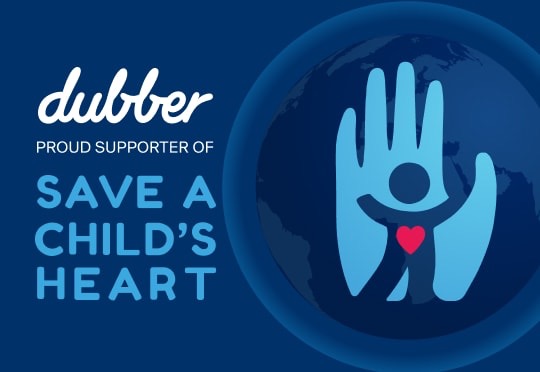
September 29 is World Heart Day, a day dedicated to raising international awareness around the cause and prevention of Cardiovascular Diseases (CVD), a cause close to Dubber.
CVDs are the leading cause of death globally, resulting in an estimated 18.6 million deaths a year, and about 520 million people living with a CVD today. CVD affects the heart and blood vessels, resulting in coronary heart disease, cerebrovascular disease, rheumatic heart disease or other conditions.
As CVDs come in many forms, so do its causes – smoking, high blood pressure and high blood cholesterol are key risk factors for heart disease. Other medical conditions and lifestyle choices can also increase the risk of heart disease including; diabetes, overweight and obesity, unhealthy diet, excessive alcohol use, or air pollution.
Save a Child’s Heart & Dubber
For two years, Dubber has been a proud sponsor of Israeli humanitarian organisation, Save a Child’s Heart.
Save a Child’s Heart (SACH) is an international organisation that provides life-saving surgery to children suffering from heart disease from countries where access to pediatric care is limited or nonexistent. So, every day is World Heart Day with SACH.
For 25 years they’ve saved the lives of nearly 6000 children from 63 countries around the world. From these countries, 50% of the children come from the Palestinian Authority and Gaza, Iraq, and Morocco. More than 40% of the children are from Africa, and the remainder are from Asia, North and South America, and Eastern Europe.
SACH medical professionals
The ultimate goal for Save a Child’s Heart is to enable equal opportunity for life-saving surgery for children with CVD. One of SACH’s programs is taking on medical professionals from developing countries and providing them post-graduate training in all facets of pediatric cardiac care in order to provide sufficient treatment in their own communities.
SACH trained professional and Ethiopia’s first pediatric cardiac surgeon, Dr Yayu Mekonnen addressed Dubber in celebration of the organisation’s 25th anniversary.
Inspired by an experience that shaped his career, Dr Yayu shared an anecdote of why he became a pediatric cardiac surgeon and why he loves what he does.
“When you provide this procedure at the right time, you change the course of this child’s life forever. They will be normal kids and are able to do whatever they want in life now.” – Dr Yayu Mekonnen
Use heart to connect ❤️
As the world struggles to fight COVID-19, it’s put pressure on us to be cautious of our own health, as well as the safety of those around us. With this new wave of vigilance, World Heart Day’s theme is around Using a heart to connect.
At Dubber we can vouch for a more mobile and modernising way of connecting with people, especially through digital platforms and telehealth. Use heart to connect is about harnessing our knowledge and influence in order to spread accurate information about heart health to our communities and loved ones.
https://www.instagram.com/p/CTxF3x7DQrg/

Some ways you can use heart to connect:
- Share your story and commitment by sharing a poster online
- Take care of your body by eating healthily, not smoking, and exercising
- Share support and look out for our vulnerable communities
- Use technology to bridge gaps in our communities
- Don’t forget to use the hashtag #UseHeart
- Give the gift of hope by donating to Save a Child’s Heart organisation
All information published in this article is provided for general education and isn’t intended to replace expert medical advice from a registered healthcare professional.
Dubber does not accept any liability for any error or injury incurred by any person as a result of using this information published.
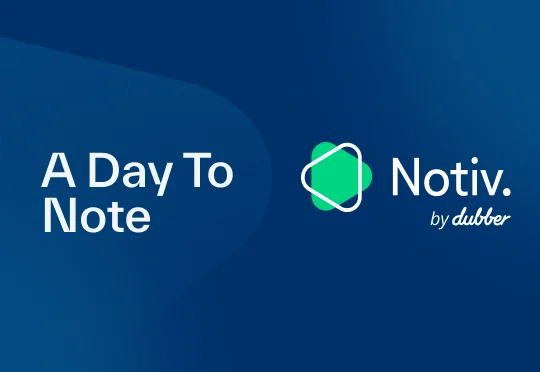
Where Dubber leads in capturing every call, video, and chat – then turning it into a source of value; Notiv has been pioneering the use of AI to make every meeting more productive and efficient.
So what does this mean for Dubber?
First, we gain an exciting and proven product built to answer a compelling use case – making meetings better. Notiv will help Dubber convert a higher proportion of our addressable market within our existing networks and new communications services that want this functionality on their networks.
Enhanced productivity can benefit everybody – however they are communicating and whatever the use case. For example, a tradesperson on a mobile phone could instantly capture customer requests and share the actions. Likewise, C-level executives could use Notiv to note and capture actions in a planning meeting.
Second, we can drive significant adoption of Notiv through our industry-leading base of partners and customers. Notiv is a compelling new service, enabling them to drive incremental revenue and differentiation. Notiv will also be a magnet for new service providers, increasing the value of our industry-first Foundation Partner program.
Third, Notiv will provide Dubber with a world-class team with deep expertise in AI and data science. Together we will accelerate our overall product roadmap and capabilities and advance our AI, digital signal processing and natural language processing technologies. Notiv furthers our leadership in capturing and transforming conversations between one person and another – and large groups of people in a meeting.
We are continuing to unlock the potential of AI on every end-point and enabling our service and solution providers to make the critical shift from selling connections to extracting the value in every conversation on their networks.
And they’ll now be able to do that with Dubber Notiv on the same hyper-secure, scaleable and compliant infrastructure that Dubber has made available in over 150 service providers globally – and all the worlds leading UC solutions.
I’ve been using Notiv for the past few months, and it’s impressive. It’s magical seeing the meeting being transcribed in real-time – and then having the ability to highlight important parts of the meeting.
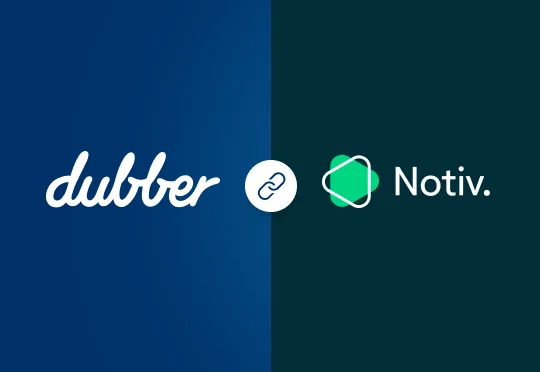
Notiv brings AI-driven notetaking and action items to every call and meeting
Adds advanced technology capabilities in real-time transcription, artificial intelligence, and advanced natural language processing
Adds revenue generating service to existing and expanded Dubber customer base
Delivers product capabilities that enrich Dubber Foundation and broader service provider offering
Accelerates Dubber’s AI program and expands Dubber core offerings
Circa A$6.6m acquisition by way of cash and equity
Melbourne, Australia – 20 September 2021 — Dubber Corporation Limited (ASX: DUB) (Dubber) announces today that it has acquired Brisbane, Australia based technology group Notiv (https://www.notiv.com). Notiv is a developer of innovative cloud-native AI-based products that turn meetings into transcribed notes, summaries, signals, actions, and more.
Steve McGovern, CEO, Dubber:
“One of our fundamental beliefs is that artificial intelligence has a part to play as a standard feature of every call and conversation. Notiv is a significant step towards achieving this in that it has clear and defined use cases for everyone from individuals to the largest of enterprises. With Notiv, Dubber will now have the ability to automatically take notes and create action items on every call. We are confident that our telecommunications carrier and service provider partners will see enormous potential for revenue-generating value-added services for their customers at scale.
We welcome the Notiv team to Dubber along with the AI and data science expertise they bring. We see the teams combining to form the core of our Dubber AI Labs for developing future AI capabilities.
The integration of the Notiv business is accretive for both parties in that Dubber can expose the fantastic capability of the Notiv offering to a global customer base and the Notiv team can develop a continuous stream of revenue-generating services for Dubber’s addressable market.
Dubber’s overall strategy is to grow organic Annualised Recurring Revenue (ARR) while augmenting that growth with strategic acquisitions where possible. Acquisitions must either add accretive and synergistic revenue or provide substantial product and technology capability, which will drive organic ARR growth. The Notiv acquisition reflects that strategy perfectly, and the speed at which the parties have executed the transaction now enables the Company to continue to pursue other identified opportunities.”
Notiv will be available to Dubber Foundation Partners, select service and solution providers and sold alongside other Dubber solutions for businesses and Government.
Chris Raethke, Co-Founder & CEO, Notiv:
“The Notiv team is exceptionally proud of the technology we have developed. The ability to roll out Notiv globally with the world’s leading service providers is an unmissable opportunity. The chance to join the Dubber growth journey at this time and expand Dubber’s AI and NLP capabilities is exciting for all of us. We are confident that the combination of Dubber and Notiv will deliver incredible value to customers, businesses and our fellow shareholders alike.”
James Slaney, COO, Dubber:
“Dubber has over 150 global service provider network partners as well as all of the world’s primary unified communications solutions – and is the only true native, cloud-first service of its kind.
Our strategy has always been to use this footprint to deliver layers of value and drive associated revenues. Notiv suits this strategy perfectly and accelerates our existing AI program in three ways.
First, we gain an exciting and proven product built to answer a compelling use case – making meetings better by automatically enabling voice data to replace or improve note taking. We believe that the ability to create notes, highlights and action items in every video and phone call provides invaluable use cases for every demographic, from individuals to large enterprises, thereby expanding Dubber’s already large addressable market. Enhanced productivity can benefit everybody in all methods of communication. For example, a tradesperson on a mobile phone call could instantly capture customer requests and share the actions. Likewise, C-level executives could use Notiv to note and capture actions in a planning meeting.
Second, we believe that the ability to deliver this capability directly from the network will be a compelling proposition for both existing and new service provider partners. As well as the opportunity for service providers to drive new services, incremental revenue and differentiation, we believe that Notiv is an ideal product to increase the value of our industry-first Foundation Partner program.
Finally, Notiv will provide Dubber with a world-class team with deep expertise in AI and data science. Together we will accelerate our overall product roadmap and capabilities and advance our AI, digital signal processing and natural language processing technologies. Notiv furthers our leadership in capturing and transforming conversations between one person and another – and large groups of people in a meeting.
We are continuing to unlock the potential of AI on every end-point and enabling our service and solution providers to make the critical shift from selling connectivity to extracting the value in every conversation on their networks. They’ll now be able to do that with Dubber Notiv on the same hyper-secure, scalable and compliant infrastructure that Dubber has already made available to over 150 service providers globally – including all the world’s leading UC solutions.”
Key Transaction Terms:
Dubber has acquired Notiv through the purchase of all of the issued share capital of holding company Pinch Labs, Inc., a US corporation that wholly owns and operates the Brisbane-based operations and technology
Aggregate consideration of approximately A$6.6 million
A$5.15 million paid in cash at completion and the balance, representing 24.8% of the consideration, is to be satisfied by way of the issue of 386,277 Dubber fully paid ordinary shares at a deemed issued price of A$3.75. The shares will be issued within Dubber’s existing Listing Rule 7.1 issue capacity
Key management and employees are to stay with the business, including Chris Raethke, Co-Founder & CEO and Dr Iain McCowan, Co-Founder and CTO
The agreement also includes provisions customary for a transaction of this nature, including warranties and representations, confidentiality and non-competition/solicitation
Strategic Rationale
Accretive fundamentals. Proven application and technology with customers with strong product-market fit and alignment to the Dubber solution set
Enriches Dubber’s service and solution provider offering – and current product offerings. Accelerates Dubber’s technology roadmap both in terms of providing Dubber with access to AI technologies and also adding a critical and differentiated product
Furthers differentiation and value of Dubber Foundation Partner Program – and its more than 150 service and solution provider customers worldwide
Broadens Dubber’s conversational intelligence offerings
Dubber to accelerate the adoption of Notiv globally. Provides Notiv with critical sales and marketing resources to scale go-to-market capabilities
Strong synergies in product approach mean technologies can be easily unified into common platforms with the potential to create efficiencies over time
Key shareholder support. All key management shareholders retained in the business with incentives to continue strong performance
Financial Impact
Scrip and cash consideration up-front. No further amounts payable
No incremental investment in staff or technology required to achieve scaling
Strong potential to enhance future revenue (or stated revenue), typical of an early-stage technology venture
This ASX announcement has been approved for release to ASX by Steve McGovern, CEO & Managing Director.
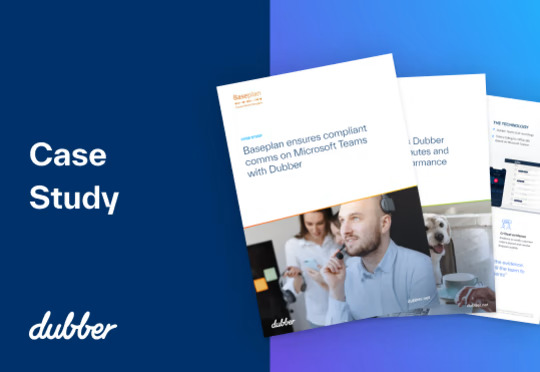
Fewer wasted trips for NT Recycling Solutions trucks with Dubber
“Our business is based on time, so mistakes are costly”
NT Recycling Solutions saves $50,000 per year using Dubber’s call recording to resolve client disputes over services ordered and staff training to reduce errors in bookings.
Here’s the backstory
NT Recycling Solutions is a waste management and recycling business in the Australian Northern Territory city of Darwin. The business deals in general waste removal and operates a recycling facility to reduce the amount going to landfill.
The company has three staff who take inbound calls. Regular customers who don’t have a scheduled service call the company and book when they need their waste bins emptied. Causal customers can call to order bins and the company’s drivers make contact with the office when there are issues with jobs.
Being able to record calls helps quickly resolve customer disputes and staff booking errors. These were costing NTRS thousands of dollars and causing inefficiencies with drivers schedules.
The Solution
NTRS uses Telstra Calling for Office 365 (based on Microsoft Teams) for all its calls. It uses Dubber Unified Call Recording to record and capture calls. In tandem, NTRS uses Dubber’s CallN reporting for additional insights into call statistics. This can include knowing which team member takes the most calls and what time of day those calls come in.
Different departments within the business including customer service, sales, and administration can all easily review calls and reports on Dubber.
Dubber’s recent partnership with Microsoft together with Dubber’s rich functionality were central to giving NTRS the right solution.
NTRS was operating a traditional on premises phone system, using CallN for recording. When it moved to Telstra Calling for Office 365, Dubber was able to craft a unique solution that delivered Dubber’s backend recording while maintaining the familiar CallN interface at the front end.
The Benefits
Speedy dispute resolution
General Manager, Dean Caton says NTRS mainly uses Dubber to verify orders placed by customers. “A customer will ring the office and say I asked for this service: ‘I need your driver to come back right now and do this for us’.”
This can be disruptive and expensive. By the time the call comes in the driver might be 40 minutes away. Revisiting pick-ups was costing NTRS more than $1000 a week.
When this happens, the staff member can check the call recording and listen to the request. Caton says at this point the customer might change their story — if they still want the driver to return, they will have to pay for it.
This was a huge problem in the past, but Caton says now that customers know their calls are recorded, they are less likely to make these claims.
Staff training and reduction of costly errors
Another Dubber benefit for NTRS is staff training and reducing booking errors.
The business depends on efficient scheduling, so mistakes and booking errors are costly.
“All our business is based on time, so if we’re going back to sites we’ve already been to, that costs us a lot of time and we don’t get the productivity out of our drivers”.
Caton says it is useful for training, especially when a new team member joins to be able to go through a recording if, say, they made a booking error.
“We can say that you should have asked this question. A number of our customers have different types of bins at their site. If they ring and say they want their bin emptied, we want our customer service person to ask the right question to find out which bin needs to be collected.”
Not all trucks can collect all bins, so getting this right is another cost saving because they don’t have to divert trucks from other locations to service the job correctly.
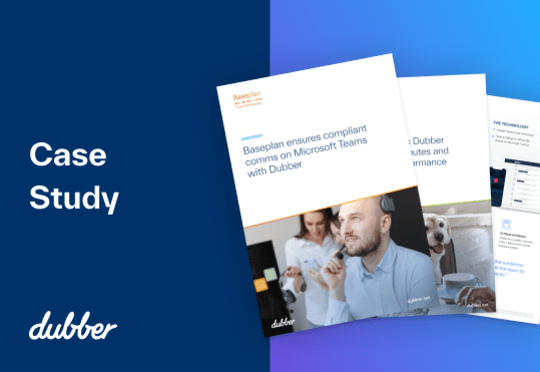
Soma improved customer experience using Dubber call recording and voice AI to track conversations across a dispersed workforce.
Here’s the backstory
Australian managed IT services provider soma technology group uses Dubber to record all incoming and outgoing client calls, internal calls and meetings.
The business’s headquarters is on the Gold Coast in Queensland and there are offices in Brisbane, Sydney, Melbourne and Perth, with a large number of staff working remotely.
Soma provides technical phone support to small to medium-sized organisations. It also runs a consulting practice that handles audits, implementations and other IT functions.
COO Aaron Prout says: “As a managed service provider we are a customer service business. It’s important our clients receive the support they need. It’s also very important that everything we do is traceable with checks and balances through all our systems”
Soma’s previous phone and recording solution was difficult to use and therefore staff were avoiding it and using their mobiles instead. And it was impossible to record calls made by the remote workforce. This meant that a large number of customer service calls weren’t being recorded for evidence or monitored for quality assurance.
The Dubber solution
Soma chose Dubber’s call recording and voice AI solution combined with Telstra Calling for Office 365, based on Microsoft Teams, as its voice system. “We wouldn’t have moved to Teams Calling if it wasn’t for Dubber”.
“The Dubber and Microsoft Teams solution is much better than the previous one. Now everyone is using it across the whole company”
Before, when they wanted to review a conversation they would have to go through all the MP3 files and listen to the entire call – and there was no search function.
With Dubber, they can search for calls easily using the google-like search function and quickly skip through the call to the relevant section. “It’s a lot faster to find what we’re looking for”.
What are the results?
Effective staff training for customer service performance
When soma gets negative customer feedback, either from a survey or through direct communication, managers listen to the conversation. This gives them an opportunity to guide staff on how they can improve.
“Dubber ticks a lot of boxes for us. We use it in a variety of areas. We use it for team education, we can go back and look at some of the calls our staff make. We make sure they’re following our phone support processes, that they are using the right communication style and that they have an understanding of the products they are selling. It’s all about giving good customer service”.
Better customer satisfaction
Soma uses Dubber to improve client satisfaction. If there is any negative feedback in post-customer service call surveys, they can listen to the conversation and quickly identify the issue.
Now with Dubber, the weekly satisfaction survey results never go below 4.5 out of 5 “This is 100 percent because of call recording”.
Dubber also helps fill in the gaps when a client doesn’t complete a survey. Not every unhappy customer provides feedback. soma uses the AI sentiment analysis tool to quickly highlight and identify those customers.
“Dubber’s AI sentiment analysis means we can learn if the clients are getting frustrated and if someone needs to dive in and take a closer look at that. It may be that we need to get in contact with them and have a conversation before the relationship goes south. We didn’t have the ability to do this before Dubber.”
Visibility of remote workers conversations
Staff throughout the country field incoming calls. Now with Dubber, all calls can be recorded regardless of location. This was especially useful during the Covid-19 lockdown when all employees worked from home.
Before Dubber and Telstra Calling for Office 365, this level of universality wasn’t possible. Originally the business was only able to record calls at the head office.
Prout says: “Our systems are set up so the call flows mean any of our guys can work from wherever they are with access to Microsoft Teams and into our systems.
“We use Dubber for the call recording and it captures everything whether people are on a mobile, an office phone or on Teams. We use it for all our support.”
Traceability of crucial conversations
Soma also uses call recording to monitor discussions over new business proposals. It means everything is detailed and captured to prevent any disputes over what was agreed.
“It stops there being any arguments about what we said and it covers us from a legal standpoint as well”.
Thousands of dollars saved
Moving to Dubber and Telstra Calling for Office 365 has meant significant cost savings for soma – about $30,000 per year – by eliminating costly hardware and maintenance costs and reducing expensive license fees.
Like to Learn More?
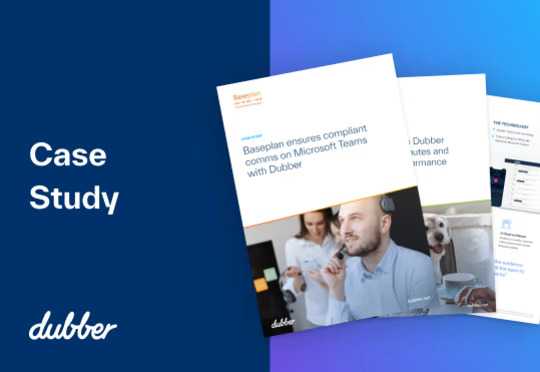
WellPet Vets saves thousands using Dubber Call Recording to confirm clients understand agreed procedures and costs
Here’s the backstory
WellPet turned to Dubber when it needed a better way to record calls at three veterinary hospitals in its Western Sydney practice.
Lucy Chapman, WellPet senior manager, says 19 employees speak to clients throughout the day. This includes nurses, receptionists, and admin staff. The practice is busy, it runs around the clock 365 days a year and deals with hundreds of calls every day.
WellPet noticed there was a problem. What clients would say about their phone conversations with staff didn’t always match notes taken at the time. This led to billing disputes.
“We want to be able to confirm what a receptionist says when on a call. In this industry, there are a lot of emotions because we deal with pets. Things can escalate fast. We wanted to know if clients’ reports of what staff told them was accurate, or if it was a bit of a lie,” she says.
Why WellPet chose Dubber
WellPet IT manager Anthony Karolis says his company took its first steps with call recording when it implemented a call centre.
“We had media recording provided through Cisco Media Sense. There wasn’t anything intelligent: it recorded, nothing else. Media Sense was reliable but we’d end up with .wav files that had random names. It meant we would have difficulty finding recordings and matching them to calls. Often we would lose recordings.”
Karolis says Outcomex, WellPet’s systems integrator, proposed Dubber as part of a review of the company’s IT infrastructure. This was in preparation for a move to cloud-based Cisco Webex Calling.. He says that Outcomex worked with WellPet to get the right solution in place and that “… the Outcomex technical guys work like an extension of my team”.
WellPet chose Dubber because the licence cost was much lower than the alternatives. That meant every call at the three hospitals could be recorded, not just a select few.
The Dubber Experience
Installation was simple. Dubber is cloud-based and fully integrated with Cisco Webex Calling, so it was switched on instantly. At WellPet it was a matter of giving log-ins to relevant staff members and a short rundown on how to use the software.
Today, if there is a query or concern, Chapman’s team can find the relevant recording fast.
She says: “When we search for a client phone number in our database, we can find the file. Linking to a number, not a client account, is important as WellPet often deals with new clients.
“We can immediately clarify what the client said and listen to the context. Our previous system was fine up to a point, but if IT is not your main focus it could be complex to use.
“When we switched to Dubber we had a system that an average user would have no trouble navigating. I found it easy, even with tasks like exporting recordings. That’s something that was difficult with our previous system.
“No matter how many times we did it, things would always go wrong or we’d lose something and not be able to find it again. Now I can do this myself in minutes.”
Recently, WellPet helped the police with an investigation. Chapman needed to extract many recordings the police wanted. She says with Dubber it was easy to find and export them.
“This was something I would have needed help with when we used the previous system.
She says: “Because Dubber is more user-friendly, I find myself using it more. In the past, there were situations where call recordings would have been beneficial, but I knew retrieving them would involve too much work. It might take several hours to track down two minutes of audio.”
Here’s the results…
The key benefit of Dubber is to resolve billing issues. Chapman says a client may be told a vet has found something and needs to conduct tests that might cost $1500. Then at billing time the client says they were never warned about that. “We’re able to fight disputes now that we have the evidence to back us up. We can tell the client that they were told of the cost and consented”. This has saved WellPet thousands of dollars and ensured issues don’t escalate further.
Another area where WellPet now uses call recording is in training. Chapman uses it to give client-facing staff feedback on how to better handle calls. This is important because the people dealing with calls tend to come from a veterinary nursing background and are not necessarily experienced in front-line customer relations.
She says she can listen to understand where someone may have used the wrong language or if something was explained that didn’t make sense. Likewise, if there is a client complaint she can listen and discuss the incident with the person involved.
Ultimately, this means that we can improve the service we offer to clients.

Devonport City Council turned to Dubber’s call recording and voice AI to get insights to improve staff training, boost customer service, and track customer satisfaction on every call.
Here’s the backstory
Devonport City Council found Dubber when it needed help understanding customer satisfaction.
The council serves a city of 26,000 people on Tasmania’s north coast.
There’s a team of seven customer service staff who handle all the calls arriving at the council. They can deal with queries themselves or pass calls on to other council departments.
The team deals with a wide range of calls including parking, animal control, rates, and health matters. It also handles calls from developers and builders, along with requests for services such as fixing potholes in local roads.
Customer Services Coordinator Danielle Harvey says the council wanted to know if callers were happy with the service they got, but didn’t want to ask them to stay on the line for an automated survey.
In the past without call recording, they only had anecdotal evidence of customer satisfaction. “We didn’t even have any statistics on how many calls a day we had. I couldn’t tell the busiest time of day or day of the week”
What was the solution?
The council uses Telstra’s IP telephony (TIPT) service and asked the telco for help. It suggested Dubber, which is able to record every call then provide full analytics.
It took next to no time to set up Dubber to record all the council’s incoming calls. The council then added voice AI analytics to transcribe and measure the sentiment of every call.
What were the results?
Improved Staff Training
The council uses Dubber to improve staff training and the way calls are handled. Harvey says in the past training involved her sitting beside the team to hear their side of conversations. “When you are working alongside someone you might not hear their tone and manner. With Dubber I can sit in a quiet room, listen to both sides and hear the tone and manner. It’s very useful”.
Harvey takes a subtle approach with staff feedback. She says the customer service team are not keen on being recorded and do not like being told after a call what they should have said.
Instead, she listens to a select number of calls each week and, based on what she hears, makes general suggestions to all staff members during meetings.
She says: “I simply say something like: did you realise we have these parking permits? If anyone asks about parking you can give them this information.”
At the same time, she asks staff to identify calls they think she should listen to. This can be when someone asks a difficult question or maybe when the caller feels they didn’t get a full enough answer. Harvey can simply and quickly search for the call using a phone number.
“Dubber has been the next level for customer service performance and we now have more structure in our training. Dubber is filling in the gaps in knowledge”.
Feedback for other departments
One area where she found Dubber helpful is with setting up questions for data collection. A council department might give the customer service team a series of questions to ask callers to gather more information. In cases, the customer service team understands these might not be the best questions.
By being able to go back to the departments with recordings of calls, they are able to identify where they might improve their questions to get the right answers from callers.
Customer Satisfaction Monitoring
The sentiment rating instantly measures if a call is happy, unhappy or neutral and quickly gives pointers to the calls that may need closer examination. Transcripts are helpful for a quick overview, because listening to recordings takes more time. Harvey says she also finds transcripts handy when it comes to sharing information with other council managers.
The council’s next step will be using Dubber’s automation and sentiment analysis to set up dashboards. That way managers can log-in and get an instant overview of customer satisfaction. They can see how customers are responding, how many calls are coming in, and how long each call takes.
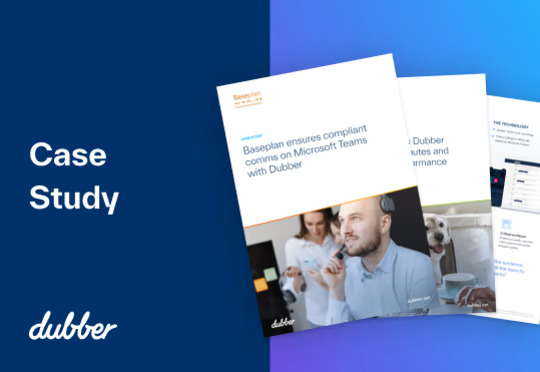
Discover how one of Switzerland’s largest private banks utilises Dubber Unified Call Recording and Voice AI to proactively monitor phone calls and messages, enabling the identification of rogue operators and potential compliance breaches.
Glean insights on how you can ensure MiFID II, GDPR and PCI compliance across your organisations’ communications channels with:
- Unified call recording across any device, location or collaboration platform
- Automatic transcription into multiple languages
- Sentiment and tone analysis of every phone call
- Real-time alerts of keywords and phrases surfaced during conversations
Download the case study and get in contact to discuss how Dubber can solve your compliance concerns.
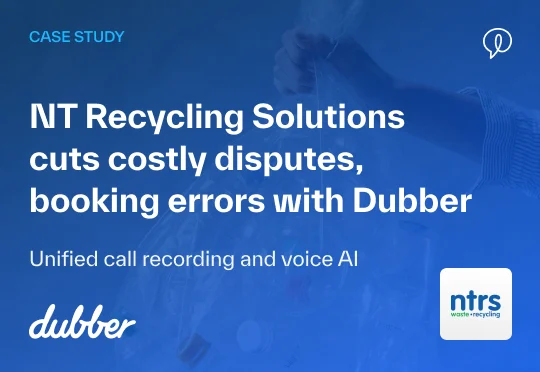
“Our business is based on time, so mistakes are costly”
NT Recycling Solutions saves $50,000 per year using Dubber’s call recording to resolve client disputes over services ordered and staff training to reduce errors in bookings.
Here’s the backstory
NT Recycling Solutions is a waste management and recycling business in the Australian Northern Territory city of Darwin. The business deals in general waste removal and operates a recycling facility to reduce the amount going to landfill.
The company has three staff who take inbound calls. Regular customers who don’t have a scheduled service call the company and book when they need their waste bins emptied. Causal customers can call to order bins and the company’s drivers make contact with the office when there are issues with jobs.
Being able to record calls helps quickly resolve customer disputes and staff booking errors. These were costing NTRS thousands of dollars and causing inefficiencies with drivers schedules.
The Solution
NTRS uses Telstra Calling for Office 365 (based on Microsoft Teams) for all its calls. It uses Dubber Unified Call Recording to record and capture calls. In tandem, NTRS uses Dubber’s CallN reporting for additional insights into call statistics. This can include knowing which team member takes the most calls and what time of day those calls come in.
Different departments within the business including customer service, sales, and administration can all easily review calls and reports on Dubber.
Dubber’s recent partnership with Microsoft together with Dubber’s rich functionality were central to giving NTRS the right solution.
NTRS was operating a traditional on premises phone system, using CallN for recording. When it moved to Telstra Calling for Office 365, Dubber was able to craft a unique solution that delivered Dubber’s backend recording while maintaining the familiar CallN interface at the front end.
The Benefits
Speedy dispute resolution
General Manager, Dean Caton says NTRS mainly uses Dubber to verify orders placed by customers. “A customer will ring the office and say I asked for this service: ‘I need your driver to come back right now and do this for us’.”
This can be disruptive and expensive. By the time the call comes in the driver might be 40 minutes away. Revisiting pick-ups was costing NTRS more than $1000 a week.
When this happens, the staff member can check the call recording and listen to the request. Caton says at this point the customer might change their story — if they still want the driver to return, they will have to pay for it.
This was a huge problem in the past, but Caton says now that customers know their calls are recorded, they are less likely to make these claims.
Staff training and reduction of costly errors
Another Dubber benefit for NTRS is staff training and reducing booking errors.
The business depends on efficient scheduling, so mistakes and booking errors are costly.
“All our business is based on time, so if we’re going back to sites we’ve already been to, that costs us a lot of time and we don’t get the productivity out of our drivers”.
Caton says it is useful for training, especially when a new team member joins to be able to go through a recording if, say, they made a booking error.
“We can say that you should have asked this question. A number of our customers have different types of bins at their site. If they ring and say they want their bin emptied, we want our customer service person to ask the right question to find out which bin needs to be collected.”
Not all trucks can collect all bins, so getting this right is another cost saving because they don’t have to divert trucks from other locations to service the job correctly.
Virtual oversight can help finance companies preparing for the Australian Securities and Investments Commission’s Regulatory Guide 271 which comes into effect on October 5.
RG 271 explains what finance companies must do to create an internal dispute resolution system that ticks all the regulatory boxes. It is part of a suite of regulatory changes happening in October. Elsewhere we look at Anti-Hawking regulations.
What are the requirements?
DLA Piper partner Sophie Devitt says the new rules aim to see that every customer of the financial services industry is able to get “fair, timely and effective dispute resolution”. This covers consumers and small businesses.
“Part of this means capturing any expression of dissatisfaction from customers where there is a reasonable expectation that a response or resolution is expected.”.
There’s no need to trawl the internet for evidence of dissatisfaction. Yet there is an expectation that should something show up on a company’s Twitter feed or Facebook page then the company will respond to the complaint.
Likewise, if a company representative hears a verbal complaint, that also has to be acknowledged and given a response.
The company needs to let the complainer know staff have registered their grievance and will get back with a formal response. The idea is that the incoming communications channel is the best outgoing channel, so a complaint voiced on, say Facebook will get a notification on Facebook.
Devitt says dealing with disputes can get challenging with the required timeframes and the manner in which the complaint arrives. A complaint has to be documented and acknowledged within 24 hours, and in most cases, a substantive response is needed in 30 days. This can be challenging when complaints are received by staff who are not sitting behind desks, say, an insurance assessor working in the field.
Demonstrate compliance
Devitt says the industry has had more than 12 months to prepare. Which means by now their plans are likely to be well advanced.
She says; “They need to think about how they can meet their obligations. It means putting the right structures in place, setting up internal processes and deciding on the frequency of reviewing the processes. There is a reporting requirement.”
“You have to demonstrate to the regulator through your reporting and data collection how you are going to comply. Producing the data is now a significant element of compliance.’
Speed and clarity is the essence
The key is getting the complaint into the system as fast as possible, wherever it comes from. And then making sure the key people are alerted immediately.
Data collection is essential. Companies need to classify complaints for later analysis to help identify problem areas, it could be the customer service department or the nature of transactions.
‘Expression of dissatisfaction’ is a broad term. Devitt says lawyers are working with clients on how to do this; a good starting place would be to look at customer expectations and whether they are being met. This can also mean work for companies on setting those expectations.
Call recording, AI – a digital backstop
All of this puts obligations on teams to monitor every customer interaction across every channel. Virtual oversight is using unified call recording and AI technology to provide an extra layer of support to teams looking for potential complaints.
There’s always a possibility companies will miss ‘expressions of dissatisfaction, especially during conversations. For companies using modern call recording technologies, AI has the potential to scan calls looking for, say, a tone of voice or keywords. It can then point out potential problems.
Unified call recording and AI technologies can also automatically alert the right people when a customer is unhappy. It can feed that data into existing IDR processes and workflows to ensure fast responses. Conversational data can also be integrated into reporting data sets – vital to meet ASIC’s expectations on data.
Sophie Devitt is a partner with DLA Piper. She works from the global law firm’s Brisbane office and specializes in insurance regulatory law, which has wider application across the entire finance sector.
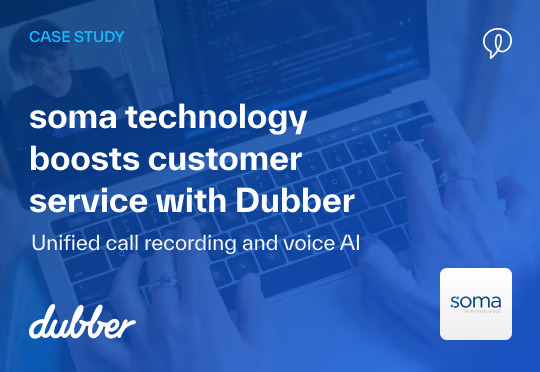
Soma improved customer experience using Dubber call recording and voice AI to track conversations across a dispersed workforce.
Here’s the backstory
Australian managed IT services provider soma technology group uses Dubber to record all incoming and outgoing client calls, internal calls and meetings.
The business’s headquarters is on the Gold Coast in Queensland and there are offices in Brisbane, Sydney, Melbourne and Perth, with a large number of staff working remotely.
Soma provides technical phone support to small to medium-sized organisations. It also runs a consulting practice that handles audits, implementations and other IT functions.
COO Aaron Prout says: “As a managed service provider we are a customer service business. It’s important our clients receive the support they need. It’s also very important that everything we do is traceable with checks and balances through all our systems”
Soma’s previous phone and recording solution was difficult to use and therefore staff were avoiding it and using their mobiles instead. And it was impossible to record calls made by the remote workforce. This meant that a large number of customer service calls weren’t being recorded for evidence or monitored for quality assurance.
The Dubber solution
Soma chose Dubber’s call recording and voice AI solution combined with Telstra Calling for Office 365, based on Microsoft Teams, as its voice system. “We wouldn’t have moved to Teams Calling if it wasn’t for Dubber”.
“The Dubber and Microsoft Teams solution is much better than the previous one. Now everyone is using it across the whole company”
Before, when they wanted to review a conversation they would have to go through all the MP3 files and listen to the entire call – and there was no search function.
With Dubber, they can search for calls easily using the google-like search function and quickly skip through the call to the relevant section. “It’s a lot faster to find what we’re looking for”.
What are the results?
Effective staff training for customer service performance
When soma gets negative customer feedback, either from a survey or through direct communication, managers listen to the conversation. This gives them an opportunity to guide staff on how they can improve.
“Dubber ticks a lot of boxes for us. We use it in a variety of areas. We use it for team education, we can go back and look at some of the calls our staff make. We make sure they’re following our phone support processes, that they are using the right communication style and that they have an understanding of the products they are selling. It’s all about giving good customer service”.
Better customer satisfaction
Soma uses Dubber to improve client satisfaction. If there is any negative feedback in post-customer service call surveys, they can listen to the conversation and quickly identify the issue.
Now with Dubber, the weekly satisfaction survey results never go below 4.5 out of 5 “This is 100 percent because of call recording”.
Dubber also helps fill in the gaps when a client doesn’t complete a survey. Not every unhappy customer provides feedback. soma uses the AI sentiment analysis tool to quickly highlight and identify those customers.
“Dubber’s AI sentiment analysis means we can learn if the clients are getting frustrated and if someone needs to dive in and take a closer look at that. It may be that we need to get in contact with them and have a conversation before the relationship goes south. We didn’t have the ability to do this before Dubber.”
Visibility of remote workers conversations
Staff throughout the country field incoming calls. Now with Dubber, all calls can be recorded regardless of location. This was especially useful during the Covid-19 lockdown when all employees worked from home.
Before Dubber and Telstra Calling for Office 365, this level of universality wasn’t possible. Originally the business was only able to record calls at the head office.
Prout says: “Our systems are set up so the call flows mean any of our guys can work from wherever they are with access to Microsoft Teams and into our systems.
“We use Dubber for the call recording and it captures everything whether people are on a mobile, an office phone or on Teams. We use it for all our support.”
Traceability of crucial conversations
Soma also uses call recording to monitor discussions over new business proposals. It means everything is detailed and captured to prevent any disputes over what was agreed.
“It stops there being any arguments about what we said and it covers us from a legal standpoint as well”.
Thousands of dollars saved
Moving to Dubber and Telstra Calling for Office 365 has meant significant cost savings for soma – about $30,000 per year – by eliminating costly hardware and maintenance costs and reducing expensive license fees.
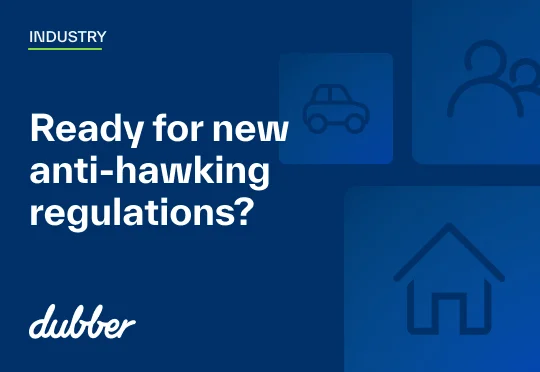
From October, Australian insurers and financial institutions must comply with new anti-hawking and internal dispute resolution regulations.
Both sets of rule changes add to compliance risks and highlight the need for reliable, comprehensive call recording. Here we look at the implications of new anti-hawking rules, a second post will examine the internal dispute resolution requirements.
Anti-hawking legislation
Anti-hawking means that offers of financial products to retail clients can no longer be made as a result of unsolicited contact. In effect, it is the end of unsolicited cross-selling.
DLA Piper partner Sophie Devitt says the law addresses concerns raised in the Banking Royal Commission that poor customer outcomes may occur when sales of financial products occur after-sales teams contact customers without any prompting.
She says; “A concern raised by ASIC is that unsolicited contact means there’s a risk customers will be unable to make clear and informed decisions about the products they may or may not want.
“While that’s the main focus of the new law, there’s also recognition that even when a customer contacts the financial service provider in relation to a specific product, that the risk could still occur.”
In the past, general insurance products were exempted from the hawking provisions. They were able to cross-sell so long as they could meet certain requirements and provide key information to consumers. That exemption has gone.
Clear informed consent
Now the regulatory environment is all about having “clear, informed consent” even before creating an opportunity for a consumer to buy a product. The idea is to reduce the pressure on consumers to buy, even when there is a cooling-off period.
Many finance companies have traditionally used call centres for cold-calling to handle these sales. Under the new rules, accurate and complete call recording becomes a compliance must-have.
Devitt says the rules can be tricky to navigate.
How can call recording and voice AI help?
Dubber call recording can collect and document evidence of a clear customer request to buy further insurance or financial products. It’s unobtrusive, the recording takes place at the network level and needs no intervention by the person taking the call. Transcripts are available on every call.
Voice AI provides critical insights to flag potential compliance risks and for staff training to ensure compliant conversations. Automated alerts and notifications can surface conversations that shouldn’t have happened but did happen. In addition, the powerful Google-like search in voice AI provides access to records for investigations and training in seconds.
Sophie Devitt is a partner with DLA Piper. She works from the global law firm’s Brisbane office and specializes in insurance regulatory law, which has wider application across the entire finance sector.
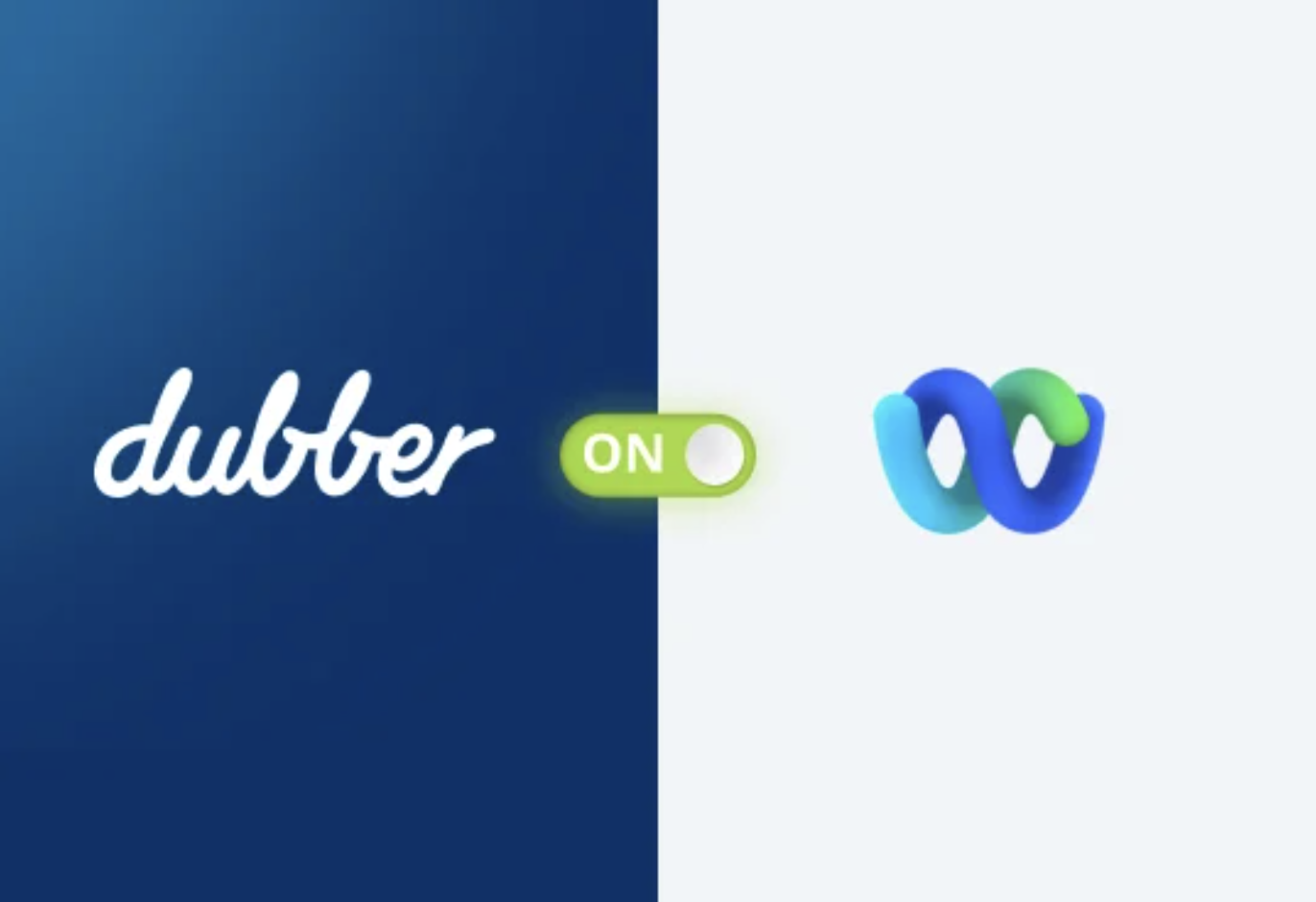
-
Answers critical need for recording, replaying, and revealing insights across video conversations
-
Dubber for Webex Meetings Video add-on pack and Video storage add-ons available today
-
For a limited time, all Webex Meetings Dubber Premier subscription plans get video add-on pack free for 6 months
Melbourne, Australia and Dallas, Texas – 19 August 2021 — Dubber Corporation Limited (ASX: DUB) (Dubber), today announced that it has launched compliant video capture to its cloud call recording and voice AI services for Cisco Webex Meetings. Dubber personal and confidential call recording is embedded as a standard feature for Cisco Webex Calling and Cisco Unified Communications Manager Cloud (UCM).
Businesses and individual users with compliance and regulatory requirements to record and store their communications can now securely capture every call, and video conversations including, one to one video calls and multi-party video conferences on the Cisco Webex Meeting platform via Dubber.
For an add-on price of $25 (USD) per user/month, the Dubber platform now enables video recordings with instant insights, analytics, transcriptions, sentiment analysis with Voice-AI powered alerts and notifications all stored in the Voice Intelligence Cloud. The Video add-on pack comes with 100GB storage as standard for each user. In addition, for power users who need augmented storage, businesses can purchase the Video Storage add-on, which comes in 1TB packs for only $100 (USD) per account/month.
“Video has become a primary communications medium for every business,” James Slaney, COO, Dubber. “With the release of compliant and secure video recording options for Webex meetings we’re enabling video to be captured, reviewed and intelligence generated alongside call records.”
“We’re answering the need to address compliance mandates in a work from anywhere world with advanced functionality, secure ease of access and economically scalable storage. There are equally important opportunities for business and government to improve employee coaching and productivity, resolve customer disputes with ease, and automatically generate real-time customer and employee satisfaction data,” added Slaney.
Background: Dubber Video Capture on Cisco Webex Meetings
- Available to all Cisco Webex Meetings customers
- Available for order now from Cisco, Cisco Partners and registered Dubber resellers on CCW
- Dubber cloud call recording now captures and unifies all voice and video data
- Flexible and affordable plan options start as low as $39.95 (USD) per user/month, which includes Video add-on pack with up to 100GB video storage per user
- Video storage add-on pack (1TB) in the Voice Intelligence Cloud available for users and accounts with expanded storage needs. Video Storage add-on packs start at 1TB storage for $100 (USD) per month for an account
- Additional Dubber compliance, storage, transcription and AI plans are available immediately
- Access more information here.
- Access Dubber on Webex Meetings via Cisco AppHub
Background: Cisco Webex Meetings
Cisco® Webex Meetings delivers over 25 billion meetings per month, offering industry-leading video and audio conferencing with sharing, chat, and more.
About Dubber:
Dubber is unlocking the potential of voice data from any call or conversation. Dubber is the world’s most scalable Unified Call Recording service and Voice Intelligence Cloud adopted as core network infrastructure by multiple global leading telecommunications carriers in North America, Europe and Asia Pacific. Dubber allows service providers to offer call recording for compliance, business intelligence, sentiment analysis, AI and more on any phone. Dubber is a disruptive innovator in the multi-billion dollar call recording industry, its Software as a Service offering removes the need for on-premise hardware, applications or costly and limited storage.
For more information, please contact:
Investors: Simon Hinsley UK Media: James Taylor | The PR Network
simon.hinsley@dubber.net james.taylor@thepr.network
+61 (0) 401 809 653 +44 (0)7796 138291
AU & NZ Media: Terry Alberstein US Media: Charlie Guyer, Guyer Group for Dubber
terry@navigatecommunication.com.au charlie@guyergroup.com
+61 (0) 458 484 921 +1 617 599 8830

Record, replay, reveal AI-enriched insights. Buy now and get the first six months of video recording on us!
We recently announced our global first Foundation Partnership with Cisco, which saw Dubber personal and confidential cloud call recording embedded as a standard feature for Cisco Webex Calling and Cisco Unified Communications Manager Cloud (UCM).
As of today, you’ll be able to compliantly capture video conversations on Webex Meetings. You’re now able to record, replay and reveal insights from every crucial business conversation across voice and video calls.
Comply & end not knowing
How often have you had a team or customer meeting and wished you could go back and review key points? Or share it with your team for coaching or training? That’s one use case for recording video.
Clearly, nobody is going to do this all the time so having real-time search and scalable storage is critical.
But what if that same content sent you signals – alerts and notifications when key phrases or words were used? Instantly managers would know they needed to dive into a conversation and check what was being said. Compliance leaders would have instant visibility to the businesses compliance standing and evidence requirements were being met. HR managers could easily check in on issues and get instant employee sentiment data.
Dubber makes all of this possible for the first time with nearly endless use cases. In simple terms, this means everyone in the business benefits. Take customer dispute resolution. Now with an instantly available record of the conversation, it’s easy to know what was said. And with Dubber you’ll be able to see phone calls, video and more in one place.
You need more than a basic recorder
The alternative is basic personal call recording solutions sometimes included with applications. These solutions are limited in capturing, authorising, managing, and facilitating compliant call recording. And they don’t enable all your calls – including those outside of Cisco Webex, to be recorded, replayed and analysed in one place.
Dubber delivers meaningful transcriptions, analytics, legal hold, and intelligent keyword search, saving time on investigations, discovery, as well as prompting actionable intelligence, effectively designed to solve business-critical outcomes.
We already see substantial early demand around video dominant use cases like telehealth, video-based customer support services, HR, recruiting, and live event streaming.
What’s included in Dubber on Webex Meetings?
For an add-on price of $25 (USD) per user/month, the Dubber platform now enables capturing every video conversation stored in the Voice Intelligence Cloud. The Video add-on pack comes with 100GB storage as standard for each user. In addition, for power users who need augmented storage, businesses can purchase the Video Storage add-on, which comes in 1TB packs for only $100 (USD) per account/month.
The first six months of video recording on us!
For a limited time, all Webex Meetings Dubber Premier subscription plans will get the video add-on pack free for 6months with every 12-month subscription! Easily capture video recordings and data revealing instant insights, analytics, transcriptions, sentiment and tone analysis, with all Dubber’s platform capabilities unleashed. To order now, speak to your Cisco Partner or visit Dubber on Webex Meetings.
Chat to us to learn more
To learn more about Dubber on Webex Meetings and help you and your business stay ahead in the hybrid work environment, book a short consulting session with our Dubber on Cisco specialist.
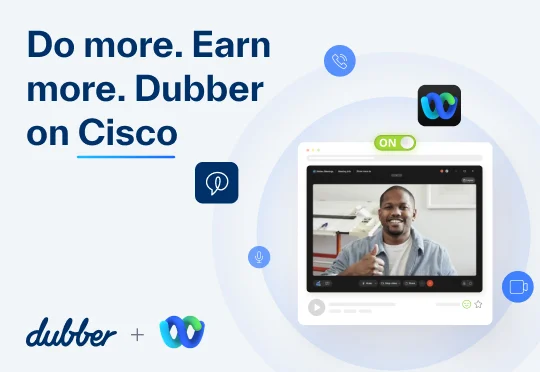
How Cisco partners unlock differentiation & revenue with Compliant Video recording on Webex Meetings
Compliant video recording is now available on Webex Meetings. Simple & easy upgrade for Dubber Go users!
80% of all critical business conversations are voice and video. This is one of the many compelling reasons why Dubber on Webex Meetings is meaningful to new and existing Dubber plus Cisco customers – enabling the capture and unification of voice calling data and video for the first time on Cisco platforms.
Dive deeper into the power of Dubber on Cisco
We’ll be running global webinars over the next couple of weeks, covering all the exciting integration details and much more for partners. To register, simply click here. For more information about Dubber on Webex Meetings, click here.
What does this mean for customers?
Individuals, Businesses, and Government users with regulatory compliance mandates to record and store every voice and video communications can now securely capture all audio calls, one-to-one video conversations and multi-party video conferences with Dubber on Webex Meetings. By simply including the video add-on pack (up to 100GB storage) for just $25 (USD) per user per month on your Dubber solution plan, all video recordings and data are automagically stored, easily searchable and will have the full complement of Dubber services available.
Critically with Dubber on Webex Meetings, compliant recordings are achievable with automated policy-based recording. Ensure proactive compliance and risk visibility with AI-enriched insights, alerts, search and sentiment analysis.
While some UC solutions include call or video recording solutions, they are limited in capturing, authorising, managing, and facilitating compliant call recording. And the costs for storage and lack of any intelligence delivered from the recording limit their use.
For Cisco Webex Meetings customers unifying voice calling and video recordings in the Dubber, Voice Intelligence Cloud unlocks limitless use cases possibilities, especially as demand grows for customer dispute resolution, customer experience, telehealth, HR, remote inspections and customer support based services.
The first six months of video recording on us!
For a limited time, all Webex Meetings Dubber Premier subscription plans will get the video add-on pack free for 6months with every 12-month subscription! Easily capture video recordings and data revealing instant insights, analytics, transcriptions, sentiment and tone analysis, with all Dubber’s platform capabilities unleashed.
And don’t forget, Dubber free and personal call recording is available as an embedded standard feature for Cisco Webex Calling and Cisco Unified Communications Manager Cloud (UCM). Enabling Dubber Go customers simple and easy upgrade to record every call and video across all major cisco platforms. With the expansion of the partnership, Dubber is now the most complete unified conversational recording solution on Cisco.
What does this mean for Cisco Partners?
The expanded Dubber offering for Cisco partners and Dubber resellers affirms Dubber as the most complete recording solution on all major Cisco platforms. In addition to Dubber being the embedded cloud call recording solution for Webex Calling and UCM-Cloud, partners can tap into the rapidly growing demand for hybrid work enabled solutions and voice data intelligence.
“Today’s announcement expands Dubber’s strategic offering on CIsco, video communications and compliant video recording are fundamental to every business in a hybrid work environment,” said Russell Evans, CRO, Dubber. “For Cisco Partners this is an incredible opportunity to increase differentiation and revenue by making the critical shift from selling connections to creating solutions based on the value of the rich content in conversations.”
For Cisco partners and resellers, ordering is simple, Dubber on Webex Meetings is available on CCW, the Cisco AppHub or from Dubber directly.
Chat with us about doing more with every conversation
To chat to a Dubber on Cisco specialist about getting your customer, team or organization set up today, reach out here. Also, make sure to register to become a Dubber on Cisco partner today and get access to partner incentives, market development funds and much more.
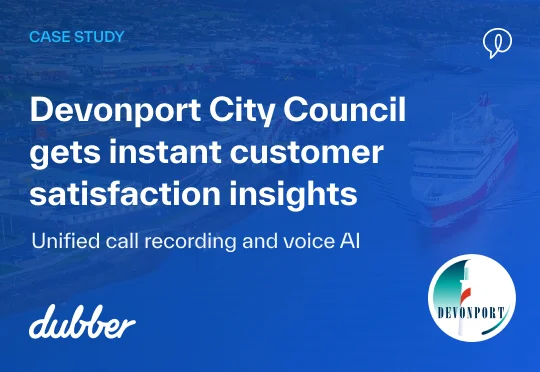
-
Dubber Unified Call Recording and Voice AI Solution provides real time sentiment analysis
-
Dubber cloud solution makes hardware based call recording for small call centre environment obsolete
-
Devonport City Council see increased customer satisfaction with service
Dubber Corporation Limited (ASX: DUB), has deployed an innovative Unified Call Recording (UCR) solution with Devonport City Council to provide insights for training, and real-time sentiment analysis for the City’s customer service team.
The solution was provided nearly “instantly” over an existing Telstra TIPT unified communications solution utilised by the City for its business communication requirements. Telstra TIPT offers carrier-grade IP voice, video, instant messaging, and other services and is one of the most extensively deployed unified communications platforms in Australia. The Dubber solution eliminated the need for any costly on-site equipment that would usually be required for legacy call recording solutions and was provisioned as an embedded service inside the Telstra TIPT service.
The Devonport City Council has a team of seven customer service staff who handle all calls arriving at the council, serving a large geographic area with a population of more than 26,000 in Tasmania’s North Coast. These calls and queries are either handled by team members themselves or passed on to other council departments.
The City’s customer service team deals with a wide variety of calls including parking, animal control, rates, health issues, as well as calls from builders, developers and planners, along with requests for services such as road maintenance.
“Dubber has helped us get to the next level for customer service performance and we now have significantly more structure in our training. With useful information like call transcription, real time sentiment analysis, and instant search of call records, Dubber helps fill in the gaps in our knowledge and improve the services we provide to our citizens,” said Customer Service lead Danielle Harvey, City of Devonport.
The Dubber solution for the City of Devonport was deployed “as a service” via Telstra’s Enterprise Sales Team. “Deploying the Dubber service was very fast and simple. We just worked with our Telstra rep with our existing phone system and Dubber was switched on nearly immediately for our entire team,” said Harvey.
“We are delighted to be working with Devonport City Council as they equip their customer service team with Dubber Unified Call Recording via their Telstra TIPT service. Devonport is a great showcase of how cloud call recording and voice AI can be used – simply and cost effectively – to deliver services to citizens better than ever. We love the fact that Dubber solutions like real time sentiment analysis, transcription and voice AI allow council staff to do their jobs better and faster, improve training and improve the services they provide to council residents,” said James Slaney, COO, Dubber.
Dubber Solution:
- Dubber Premier (Call recording and Voice AI)
- Telstra TIPT
- Recording for all inbound customer calls
- Easy to view recordings, transcriptions and sentiment analysis of each call
- To view expanded case study please click here.
About Dubber:
Dubber is unlocking the potential of voice data from any call or conversation. Dubber is the world’s most scalable Unified Call Recording service and Voice Intelligence Cloud adopted as core network infrastructure by multiple global leading telecommunications carriers in North America, Europe, and Asia Pacific. Dubber allows service providers to offer call recording for compliance, business intelligence, sentiment analysis, AI and more on any phone. Dubber is a disruptive innovator in the multi-billion-dollar call recording industry, its Software as a Service offering removes the need for on-premise hardware, applications or costly and limited storage.
For more information, please contact:
Investors
Simon Hinsley
+61 (0) 401 809 653
Media
Terry Alberstein
terry@navigatecommunication.com.au
+61 (0) 458 484 921
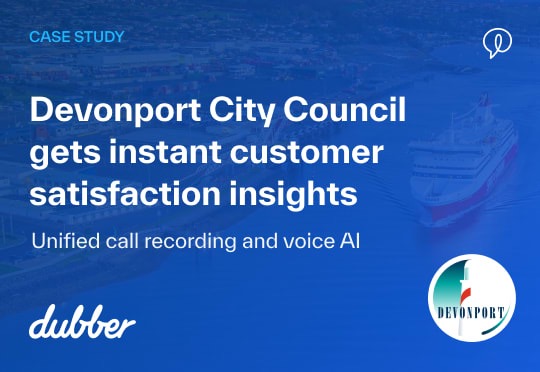
“What’s our customer satisfaction right now?”
Devonport City Council turned to Dubber’s call recording and voice AI to get insights to improve staff training, boost customer service, and track customer satisfaction on every call.
Here’s the backstory
Devonport City Council found Dubber when it needed help understanding customer satisfaction.
The council serves a city of 26,000 people on Tasmania’s north coast.
There’s a team of seven customer service staff who handle all the calls arriving at the council. They can deal with queries themselves or pass calls on to other council departments.
The team deals with a wide range of calls including parking, animal control, rates, and health matters. It also handles calls from developers and builders, along with requests for services such as fixing potholes in local roads.
Customer Services Coordinator Danielle Harvey says the council wanted to know if callers were happy with the service they got, but didn’t want to ask them to stay on the line for an automated survey.
In the past without call recording, they only had anecdotal evidence of customer satisfaction. “We didn’t even have any statistics on how many calls a day we had. I couldn’t tell the busiest time of day or day of the week”
What was the solution?
The council uses Telstra’s IP telephony (TIPT) service and asked the telco for help. It suggested Dubber, which is able to record every call then provide full analytics.
It took next to no time to set up Dubber to record all the council’s incoming calls. The council then added voice AI analytics to transcribe and measure the sentiment of every call.
What were the results?
Improved Staff Training
The council uses Dubber to improve staff training and the way calls are handled. Harvey says in the past training involved her sitting beside the team to hear their side of conversations. “When you are working alongside someone you might not hear their tone and manner. With Dubber I can sit in a quiet room, listen to both sides and hear the tone and manner. It’s very useful”.
Harvey takes a subtle approach with staff feedback. She says the customer service team are not keen on being recorded and do not like being told after a call what they should have said.
Instead, she listens to a select number of calls each week and, based on what she hears, makes general suggestions to all staff members during meetings.
She says: “I simply say something like: did you realise we have these parking permits? If anyone asks about parking you can give them this information.”
At the same time, she asks staff to identify calls they think she should listen to. This can be when someone asks a difficult question or maybe when the caller feels they didn’t get a full enough answer. Harvey can simply and quickly search for the call using a phone number.
“Dubber has been the next level for customer service performance and we now have more structure in our training. Dubber is filling in the gaps in knowledge”.
Feedback for other departments
One area where she found Dubber helpful is with setting up questions for data collection. A council department might give the customer service team a series of questions to ask callers to gather more information. In cases, the customer service team understands these might not be the best questions.
By being able to go back to the departments with recordings of calls, they are able to identify where they might improve their questions to get the right answers from callers.
Customer Satisfaction Monitoring
The sentiment rating instantly measures if a call is happy, unhappy or neutral and quickly gives pointers to the calls that may need closer examination. Transcripts are helpful for a quick overview, because listening to recordings takes more time. Harvey says she also finds transcripts handy when it comes to sharing information with other council managers.
The council’s next step will be using Dubber’s automation and sentiment analysis to set up dashboards. That way managers can log-in and get an instant overview of customer satisfaction. They can see how customers are responding, how many calls are coming in, and how long each call takes.
Like to Learn More?
Overview
One of Switzerland’s largest private banks required a secure and compliant solution that enabled the proactive recording, capture and analysis of mobile phone calls between financial advisers, traders and clients.
The Private Bank’s Chief Risk Officer (CRO) says the business had efficiency issues. “We used to have an extremely manual process of listening to recorded calls to identify breaches”.
The bank had an imperative to mitigate against potential surveillance breaches, whilst maintaining employee productivity, aligned with positive customer experience. “Any compliance breaches had the potential to leave us open to regulatory fines”, they said.
The Swiss Private Bank had a recording system in place, but staff wasted huge amounts of time locating, manually transcribing and analysing phone calls.
The customer selected Dubber to record and transcribe mobile phone calls and messages, with the real-time Search function allowing them to save time on filtering and finding specific compliance issues. The solution also enabled a more positive customer experience, driving employee culture through an AI driven sentiment and tonal analysis engine of every customer interaction.
Once installed the CRO said the team instantly became more efficient. They said, “The time and costs saved with Dubber, along with the compliance benefits have gone beyond expectations”.
The Swiss Private Bank is now recording and automatically transcribing calls in six languages and has since implemented Dubber Voice AI to enhance proactive compliance. Dubber automatically detects the language being spoken during the first few seconds of the call.
Alerts and notifications for keywords and phrases spoken in client conversations have provided the Bank with an additional layer of security leaving them confident that breaches will be identified immediately.

The Challenge
- Manual and in-efficient process of listening to recorded calls and messages between wealth managers and clients
- Their legacy system recorded calls, but the lack of a search function meant users couldn’t locate specific phone calls, meaning breaches could be missed
- No automated transcriptions – their manual workaround was slow, ad-hoc and expensive
The solution
- Dubber Snified Call Recording to deployed enable call and message capture
- Real-time search and auto-transcriptions allows users to easily locate specific calls and conversations in seconds
- Proactive surveillance for the identification of rogue operator conversations with alerts and notifications on keywords such as “You should buy ”, or suggesting the call continue on a non recorded communication platform
- Auto language technology, transcription of six languages with sentiment and tonal analysis, transforming unstructured communications data into actionable intelligence that drive business insight
The Results
Meet Compliance Requirements
- 100% visibility of wealth manager-client conversations
- Better enforcement of surveillance and risk management protocols
- Immediate escalation of potential compliance breaches
More Efficient
- Replaced manual listening and transcription process
- Sentiment and tone analysis of all calls, improving customer experience and managing employee culture
Surveillance
- Proactive alerts of keywords from recorded calls
- 100s of thousands saved in manual transcription costs
We now have total visibility of all our traders’ conversations, even when they’re working from home. The automated surveillance means we can immediately identify compliance
breaches, reduce risk, and save time and money.
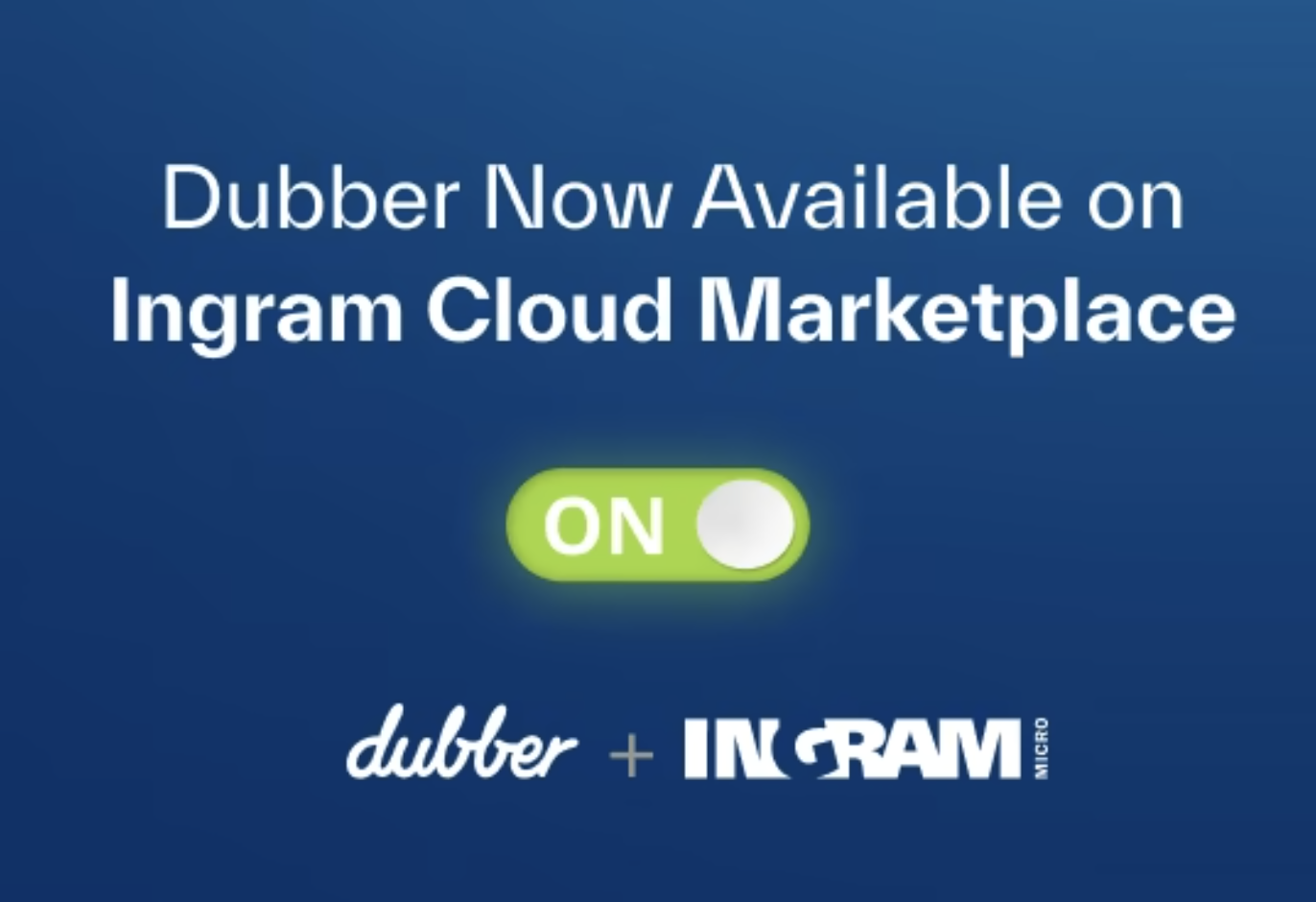
London, August 2021 – Ingram Micro, the leading global distributor of cloud-based IT products and services, today announced that Dubber, the world’s first and leading provider of cloud-based unified call recording and voice intelligence, is now available to all channel partners and resellers via the Ingram Micro Cloud Marketplace in Europe, Middle East and Africa.
Dubber’s unique value is in its ability to enable the secure cloud recording of voice calls and collaboration meetings from any device, location or collaboration platform – connecting directly at the network layer with over 150 service providers globally including BT, AT&T, Verizon, Telstra and O2, as well as collaboration platforms like Zoom Phone and Meetings, Cisco Webex Calling and Microsoft Teams.
Dubber’s AI-driven Voice Intelligence Cloud enriches voice data, generating business critical insights, real-time search, alerts, transcriptions and sentiment analysis – enabling businesses of any size to automatically record every call to meet compliance mandates; improve sales and service performance; and unlock the possibilities contained within voice data.
The availability of Dubber on the Ingram Micro Cloud Marketplace provides all channel partners and resellers an opportunity to differentiate their UC offerings to customers, with a uniquely scalable and quick-to-deploy solution that eliminates the cost, complexity and limitations of traditional legacy call recording solutions.
Dubber is one of the first recording platforms to be certified for compliance by Microsoft for integration directly into Microsoft Teams. Dubber also recently acquired Speik, the leading UK provider of mobile call recording and PCI payments solutions.
Ovi Gherghel, Cloud & Cyber Security Country Leader (UK&I) at Ingram Micro UK said: “The launch of Dubber on to the Ingram Cloud Marketplace couldn’t come at a better time for us and our partner community in the UK. As the world settles into hybrid remote-working, businesses need a compliant solution that can capture call recordings across networks and applications and support work from anywhere, at any time… Dubber can now fulfill that need.”
Simon Broadbent, VP Sales at Dubber said: “Gartner predicts that by 2025, 75% of conversations at work will be recorded, with many of those conversations taking place over service provider networks and collaboration platforms such as Microsoft Teams. All of Ingram Micro’s partner and reseller community will now be able to harness that market opportunity by integrating Dubber into their customer offering.”
Steve McGovern, CEO of Dubber, said: “There’s no doubt the 2020/21 pandemic has accelerated the adoption of communication technologies to keep up with the demands of virtual collaboration and hybrid work arrangements. Dubber allows regulated businesses to maintain compliance across traditional and remote-workforces, creating an invaluable addition to channel partners’ offerings.
About Ingram Micro:
Ingram Micro Cloud is a global division of Ingram Micro and employs more than 1,500 dedicated cloud specialists worldwide. Among this large pool of experts are 400+ cloud sales associates and 700+ engineers. Its innovative platform and services offerings power some of the world’s most pioneering and successful companies. As a premium cloud services provider, Ingram Micro Cloud views cloud as more than a single technology – it is a foundational platform capable of underpinning the digital transformation. For more information, please visit uk.ingrammicro.com.
About Dubber:
Dubber is unlocking the potential of voice data from any call or conversation. Dubber is the world’s most scalable Unified Call Recording service and Voice Intelligence Cloud adopted as core network infrastructure by multiple global leading telecommunications carriers in North America, Europe and Asia Pacific. Dubber allows service providers to offer call recording for compliance, business intelligence, sentiment analysis, AI and more on any phone. Dubber is a disruptive innovator in the multi-billion dollar call recording industry, its Software as a Service offering removes the need for on-premise hardware, applications or costly and limited storag

Corporate Governance Policies
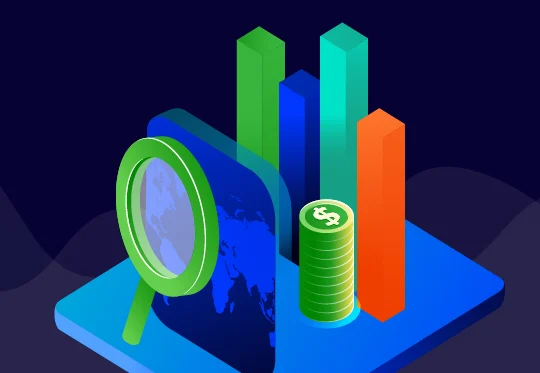
Open voice intelligence starts with either transforming legacy call recording and implementing unified call recording that transforms any and every conversation into data. From there the Voice Intelligence Cloud does the work – unifying conversational data sets and unlocking intelligence once lost at the end of every conversation – or in data silos and applications.
Traditionally, call recording was deployed as a necessary means to monitor agent performance, enable dispute resolution or enforce verbal agreements. Call recording was expensive, cumbersome and application-centric, which meant it was primarily adopted by enterprise contact centers and other places where only the most crucial of conversations occurred.
Application-centric call recording limits the capture of the broadest possible set of business conversations because it’s tied to a narrow set of devices/endpoints and specific application needs.
Often, less than 10% of crucial conversations are captured. The downstream impact is that essential data is lost, limiting broader data correlation and trapping data.
Modern call recording is cloud-based and deployed as SaaS.
The benefits of this for businesses include rapid deployment (deployed in minutes or hours, not months), significant cost reductions and the ability to capture, store and unify all business conversations, turning this into highly valuable data and insights for businesses.
This marks the start of open voice intelligence. Powered by API’s, data and insights are portable, easily federated to other business data, tools, systems and software.
Starting with Voice data.
Once companies capture all their crucial conversations and voice data, the requirement becomes to make the data accessible and portable in real-time.
For all this to work, you need to orchestrate and leverage APIs, to deliver scale in an automated manner. API’s federate the correct data and insights to the right system, with little to no human intervention, allowing automation and scale.
Automate and accelerate intelligence, accurately.
The Dubber platform is architectured around an open API, authorising companies to control, automate and self-serve, tailoring functionality and data outputs to fit and connect to specific platforms or software. Outcomes include:
- Revenue Intelligence: Port crucial conversational data with new prospects or existing customers, integrated into your CRM or sales revenue tools.
- Customer Intelligence: Good customer service and speedy dispute resolution is predicated on timeliness. Connecting the Dubber API to workflow tools based on spoken keyword triggers or phrases such as ‘I want to speak to your manager’. Solve disputes efficiently and focus on delivering outstanding customer service and experiences.
- People Intelligence: Knowing how your people are feeling and operating is critical to business success. Remote and hybrid workforce arrangements have only exacerbated the challenge of knowing. Capture conversations with sentiment and tone insights, all of which can be integrated into your people management tools to enable more tailored training or support needs.
One of the most popular ways Dubber customers are leveraging the API today is for:
- Business Intelligence: Connecting call recordings and data such as call volumes, categories (based on tags), alongside sentiment rating, tone and or keywords and phrases into data visualisation tools such as IBM Cognos, Tableau and Google Data Studio. Dubber customers are informing vital business decisions such as resourcing, increasing or decreasing marketing/promotional spend or making capital decisions based on products or services mentioned.

Successful A$110 million Institutional Placement with Strong Investor Support

Capital Raising and Release of Quarterly Report
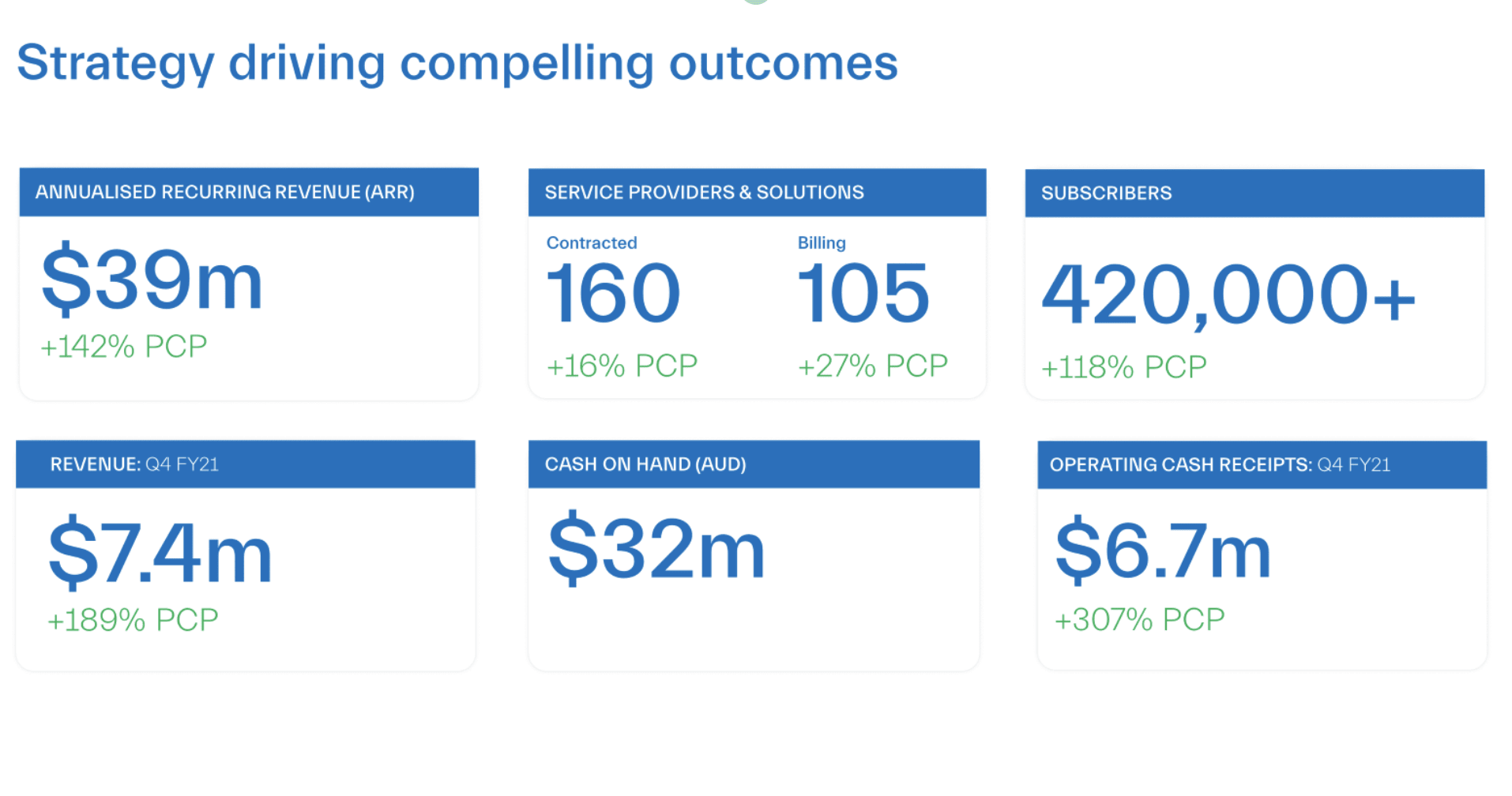
Dubber Corporation Limited (ASX: DUB) (‘Dubber’ or ‘the Company’), the leading global Unified Call Recording & Voice Intelligence cloud service designed for service providers and businesses of any size, today released an update on the Company’s operating focus along with the Appendix 4C for the quarter ended 30 June 2021.
Highlights within the Quarter:
- Revenue increased by 12% ($800k) to $7.4m
- Dubber users now exceed 420,000
- ARR increased 14% ($4.8m) to $39m
- The Company has in excess of $32m cash at bank
- Dubber now a standard feature for every subscriber on Cisco Webex Calling and Cisco UCM Cloud
Growth in all key metrics – Users and ARR
During the June quarter the Company continued to experience substantial growth across all key metrics.
User numbers grew at a record rate for Dubber’s SaaS monthly subscriptions. The Company announced the launch of its Foundation Partner Program, with Cisco’s Webex Calling and UCM Cloud platforms as the first such partner. Foundation Partners will embed Dubber services within their offering as a standard and in-built feature – from which both Dubber and the partner then benefit from upgrading users to richer functionality and product offerings. Accordingly, Dubber’s subscriber numbers have significantly expanded in this program, and for reasons of both consistency and commercial sensitivity, the Company has chosen not to include these numbers at the current time. The increase in subscriber numbers, therefore, relates to standard Dubber subscriptions.
As previously indicated, the key growth metric relating to short term growth is the Company’s Annualised Recurring Revenue (‘ARR’) which has grown by $4.8m, to approximately $39m, continuing a trend established in the March quarter, a milestone period relating to comparative ARR growth on a quarter on quarter basis.


Telecommunications Networks Growth and Yield
During the quarter, the Company continued to expand its footprint of service provider networks along with increasing penetration and revenue yield from its current telecommunication and UC platform partners.
Cisco as a Foundation Partner
During the quarter, the Company announced that it significantly expanded its commercial relationship with Cisco. Dubber is now a standard feature of every subscription for Cisco’s Global cloud telephony platforms Webex Calling and UCM Cloud. An entry level service ‘Dubber Go’ is included, at no extra charge, in every subscription enabling individual users to record calls which they alone manage. Customers can then upgrade to extended features such as extended storage, transcription and AI based features or expansion to compliance-based capabilities for the entire organization. Cisco provides Dubber a monthly license fee for this capability, which enhances its offering to their end customers.
The benefits for Dubber are significant:
- An accretive revenue stream which enhances rather than competes with Dubber’s fundamental revenue models for Cisco users
- 100% attachment to the network customer base with an increased propensity to uptake additional Dubber products and service subscriptions
- Dubber has direct communication access to end customers for co-marketing as well as via Cisco and its global reseller network
- Cisco Webex calling is re-sold by many of the world’s leading telecommunications carriers, providing Dubber with further opportunities to expand its network footprint
- Inclusion in the world’s leading cloud telephony platform provides the opportunity for ‘network effect’ as both service providers and their customers seek to standardise their core infrastructure services
- The deployment will see Dubber’s user base increase exponentially
Steve McGovern, CEO, Dubber: “Dubber and Cisco share a common vision of the way that voice data will become a critical resource for all businesses and users in the future. Our joint initiatives have significant ramifications for Dubber, notably in the Company’s two areas of primary focus: growing the Company’s ARR and expanding its telecommunications network footprint. Dubber is now a core feature on an important network for many Carriers, providing the opportunity to expand the same functionality to the Carrier’s other networks. This provides opportunities for Carriers to add an important value-added service horizontally throughout their networks, and also provides a standardized experience for users.
This marks a major milestone in increasing the ubiquity of Dubber as the Unified Call Recording and voice data layer for the world’s leading telecommunication and collaboration platforms. We believe that customers worldwide will continue to prepare for, and respond to, increased regulatory and compliance obligations for their businesses in many markets and industry verticals. Embedding Dubber cloud call recording as a standard service will allow customers to meet these requirements, while providing them access to a host of advanced voice data services.”
Foundation Partner Program
The Dubber platform has been designed specifically for large scale availability across telecommunication and cloud communication networks, as opposed to legacy bespoke recording products for enterprises, which have historically been tied to on-premise equipment, capital expenditure and complex call centre environments.
The Company is actively engaged in discussions with major service providers to become Foundation Partners and, as previously disclosed, the Company expects several of its service provider partners to deploy the Dubber platform as a standard feature across their network base as “Dubber Foundation Partners.”
This will provide Dubber large scale customer reach into end user accounts for jointly upselling additional services, including extended storage, transcription, AI insights and more.
Unified Call Recording – the ‘Single Pane of Glass’
The Company has previously referenced Unified Call Recording (UCR) which defines Dubber’s unique value proposition of UCR and voice data at scale. UCR reflects how businesses and individuals work today, particularly through COVID-19 driven ‘work from home’ settings and hybrid work environments.
The Company has previously highlighted an industry trend whereby large global service providers are releasing their own network offerings in conjunction with cloud collaboration platforms like Zoom Phone, Microsoft Teams and Cisco Webex Calling. The Company is experiencing significant demand for these services, driven by its Service Provider partners, particularly in the financial services and healthcare sectors, and primarily in markets like the UK, Europe and North America, where there are immediate needs for compliance solutions across distributed workforces.
The ability to capture recordings and voice data across multiple networks, and have them managed in a single environment, the Dubber Voice Intelligence Cloud, is a compelling proposition which should underpin and accelerate the Company’s growth.
Continued Integration of Acquired Companies:
Dubber has successfully integrated the acquisitions of Speik and Calln, both of which continue to demonstrate strong ARR retention and growth. These acquisitions have not only provided outstanding development staff but have provided Dubber with key additional technology capabilities as seen in the recent debut of Dubber PCI Comply, based on core Speik technology.
Financials
As required by LR 4.7C.1 to 4.7C.3, expenditure amounts for the quarter ended 30 June 2021 on the Company’s activities on R&D, operations, advertising and marketing, personnel and administration are as contained in the Appendix 4C accompanying this report. Operating costs include $1.869 million pre-paid for cloud services, a non-recurring expense, resulting in a significant discount to normal cost structures for such services. The amount disclosed in section 6.1 of the Appendix 4C is for executive and non-executive director remuneration for the quarter, including superannuation.
Cash receipts for the quarter were $6.7m, in line with expectations from the Company’s ARR and revenue recognized during the quarter. The Company’s ARR is calculated as the next 12 months of subscription revenue net of any incentives.
For example, an agreement signed in July may have a first billing date of September in which case the ARR would be 10x monthly subscription revenue. Dubber’s customers are predominantly service providers, which operate on varied payment terms, which can result in cash being received a further 60-90 days from billing. As a result, the ARR to revenue and cash receipt cycle can be across multiple quarters.
Steve McGovern, CEO, Dubber:
“The Company is very pleased to have continued its growth trajectory at a level established in the previous quarter. We are now one year into a five-year plan that is heavily focussed on expanding its network footprint, increasing ARR and developing revenue generating products and services which can be deployed at scale as a service directly from voice networks.
Our goal for the first year was to double the size of Dubber’s business – from a base of approximately $15m ARR and 190,000 subscribers, which the team has accomplished and exceeded. The opportunities for take up of the Dubber platform, both at a Service Provider and an end user level, have also been accelerated against a landscape where there are multiple key drivers.
The widespread movement to cloud infrastructure has been brought forward by the effects of the global social and economic requirement for working from home. Additionally, the communications sector has quickly expanded to meet these requirements, particularly with the prevalence of Cisco Webex, Microsoft Teams and Zoom services. Traditional Service Providers in turn are seeking to enrich their cloud offerings both in line with, and competing against these offerings and, finally, there is an urgent need for the extension of compliance, and customer/employee experience capabilities by enterprises at all levels.
Service providers have both an incentive and the means to deliver these capabilities, and Dubber is uniquely positioned to provide unified call recording and voice data capture services as part of this transition. All of these trends reinforce our view that the ability to turn calls into AI-enriched data, will be a standard feature for every phone in the future.
Dubber is incredibly well placed to become the de facto global provider of voice data through its unique cloud platform, partnered with the world’s leading service providers and cloud team collaboration providers.”
This ASX release has been approved for release to ASX by Steve McGovern, CEO & Managing Director.
About Dubber:
Dubber is unlocking the potential of voice data from any call or conversation. Dubber is the world’s most scalable Unified Call Recording service and Voice Intelligence Cloud adopted as core network infrastructure by multiple global leading telecommunications carriers in North America, Europe, and Asia Pacific. Dubber allows service providers to offer call recording for compliance, business intelligence, sentiment analysis, AI and more on any phone. Dubber is a disruptive innovator in the multi-billion-dollar call recording industry, its Software as a Service offering removes the need for on-premise hardware, applications or costly and limited storage.
For more information, please contact:
InvestorsSimon Hinsley simon.hinsley@dubber.net +61 (0) 401 809 653
MediaTerry Albersteinterry@navigatecommunication.com.au+61 (0) 458 484 921
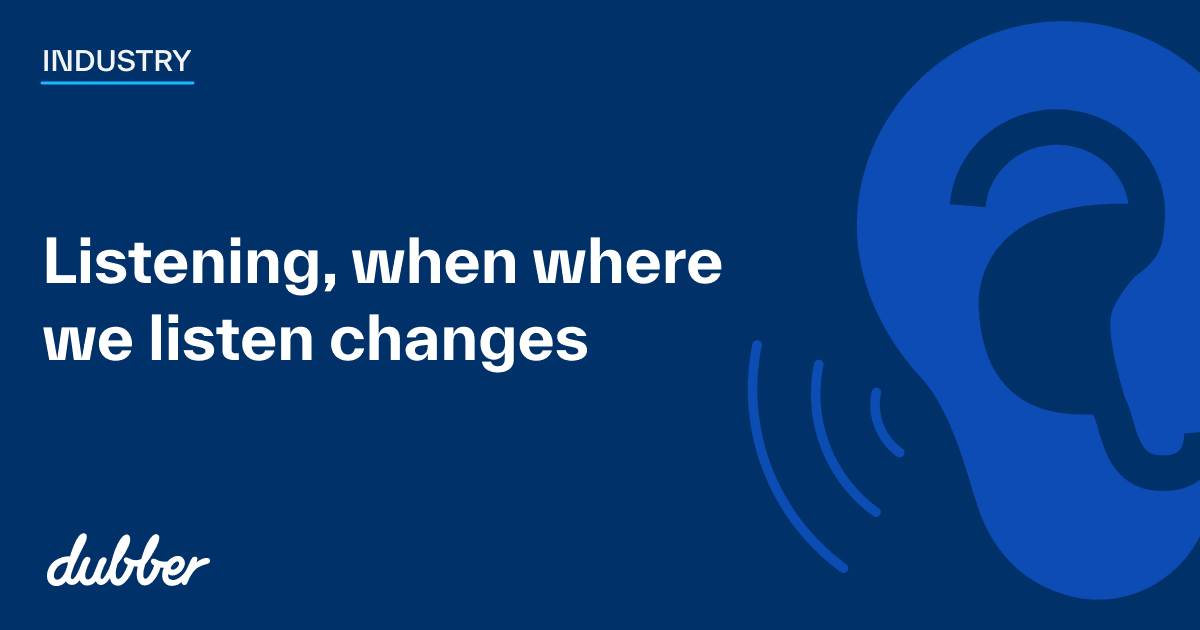
Ending not knowing in financial services
Two aspects of the 2020 pandemic lockdown transformed the way financial institutions handle compliance.
First, Bankers and others in the finance sector stopped interacting face-to-face with customers. An industry that relied on face-to-face interaction and in-person transactions had to find new ways of working.
Second, employers sent staff home to work. Within days employees equipped their home offices with suitable devices and fired up their broadband connections. Video conferencing tools like Zoom, Microsoft Teams and Cisco Webex moved centre stage.
It took some doing. Before lockdown the finance sector had plenty of digital capability. Parts of the industry had been online for decades.
Yet most video interaction focused on internal use. If you could find video conferencing anywhere in a financial institution, chances are people were using it for internal meetings.
Despite no-one anticipating a worldwide pandemic, the sector pivoted. Those inward-looking cameras and microphones now face customers. Businesses moved further online. Like everyone else, compliance staff adapted to life where many people no longer work from an office.
Unsurprisingly this switch brought new compliance challenges.
How do you authenticate a client who wants to give transactional instructions in a Zoom call? How do you know what is being said when it is being said outside of your traditional call center and phone connections? What does quality assurance look like in this new world? Is it possible to reconstruct a transaction from end-to-end across multiple end-points? How will you prove your KYC obligations?
At the same time, customers started to assert their preferred means of communication more strongly. For some that’s Wechat. For others it’s Teams. And others use Whatsapp.
And, while customer confidence in transacting digitally grew exponentially, the primacy of voice remained unchanged. Today, voice remains the preferred means of communicating for any crucial transaction or conversation.
This is where unified voice recording shines. It captures and records any conversation that takes place over any network or channel. It works with telephony, messaging or video conferencing technology.
Because it lives in the cloud and captures voice at the network level, financial services professionals can use unified call recording anywhere.
Unified voice captures working from home calls in the same way it captures calls made at the office. Best of all, it pulls together data from multiple conversations made through multiple channels.
Once captured the information sits in a single central repository that is accessible from anywhere. There’s a clear trail for managers and compliance professionals to follow.
While technology connected us, it didn’t end not knowing. Our ability to listen and collect data was further limited, amplifying an existing problem: not knowing.
Not knowing what someone said and when they said it. Not knowing if the people concerned fulfilled all their obligations.
As we continue to connect in new ways, we also need to learn to listen in new ways. And Unified Call Recording fueling Voice Intelligence is a critical part of the answer.
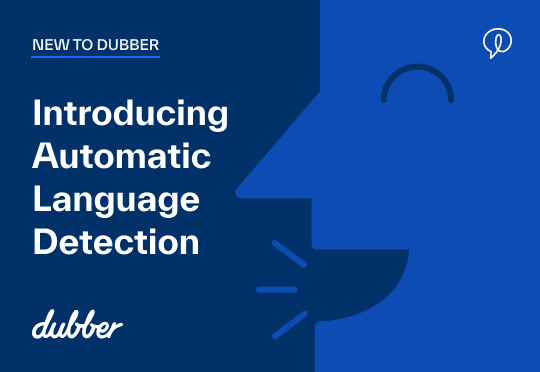
Your customers, suppliers, partners and people can be and are often dispersed across countries, time zones, markets and currencies.
At Dubber, we’re acutely aware of this, operating globally, working with businesses of all sizes across 50+ countries. We serve a plethora of product markets ranging from multinational FSI customers to local veterinarian groups.
After listening to the needs of our diverse customers, a common challenge emerged. How do we solve the problem of multiple languages being spoken on a call recording?
The value of solving this pain point is the difference between success or failure because the difference between a churning customer or an upgrading one can be seconds. According to a 2020 report U.S. companies lose $136.8 billion per year due to avoidable consumer switching (Forrester).
Enabling automatic language detection
Today, we’re launching another first – Dubber Automatic Language Detection!
Automatic language detection automagically verifies, recognises, and validates the primary speaker in the recorded call and effectively resolves the dominant language spoken to the Dubber Voice-AI dynamically.
This means transcriptions, sentiment, tone and alerts align to the detected language – and are then dynamically updated within the Dubber Voice Intelligence Cloud to appear in your Dubber portal and app instantly after the call.
Try it now!
Automatic language detection is empowering one of our customers operating in the global financial markets to dramatically improve their customer and people experiences and meet compliance mandates. Across 13 different spoken languages, their people now focus on driving value from engagements aligned to their customers desired spoken language.
Turn-on Dubber Go on Cisco
If you are selling Webex Calling or UCM-Cloud, you need to turn on Dubber Go today. Personal and confidential call recording is now included as a free feature and ready to use. And, for existing customers, the same is true.
It’s simple and easy to activate:
- Step One: Switch on call recording in your Customer Organization Control Hub (You can specify which users to enable call recording for during Step-Three)
- Step Two: Submit an activation request here or contact your Dubber sales representative.
- Step Three: A Dubber customer success representation will contact you for confirmation of details, and we’ll do the rest
- Note: You’ll need to have your customer details ready to activate these include:
- Names and email addresses of users
- Group ID, Service Providers ID and the external identifier for each user
- The region the Cisco service is provisioned
Dubber is the preferred and only embedded compliant Call Recording solution for Cisco.
So, what’s Dubber Go? Dubber Go is a private and confidential cloud call recording solution, enabling customers to compliantly record, store, share and replay any conversation on Cisco Webex Calling and UCM Cloud.
This critical new functionality turns on with a click at zero cost and is included in every Cisco Webex Calling and UCM Cloud subscription.
Activate Dubber Go and 2x your pipeline
For Cisco partners, enabling eligible customers to instantly provision private and confidential cloud recording through the Cisco Control Hub gives every Cisco partner an instantaneous point of differentiation. It also answers customer needs for an out-of-the-box secure and compliant cloud call recording solution.
Most importantly, Partners will benefit from an active pipeline of revenue opportunities. This pipeline represents clear upgrade pathways for advanced recording teams, adding rich Voice-AI functionality – and – addressing compliance mandates with a suite of compelling add-on solutions.
We’re already seeing strong customer demand and momentum building. Dubber is proactively co-selling and nurturing onboarding, support and upgrade sales conversations. Cisco partners benefit from co-sell opportunities with annualized recurring revenue streams.
Turning pipeline into revenue & retention
With Dubber, your customers solve business-critical outcomes through world-leading capabilities such as team management, auto-language detection, unlimited storage, transcription, sentiment analysis, AI-enriched insights (and much more).
Partners can effectively build on this recurring revenue foundation by offering high-value professional service engagements encouraging customers to get the most from their voice and voice-AI data. Examples include tailored reporting, bespoke projects and app integrations, all clearing the way for more revenue, better retention and improved differentiation.
Chat with us about doing more with every conversation
Reach out to chat to a Dubber on Cisco specialist ready to get your customer, team or organization set up today.
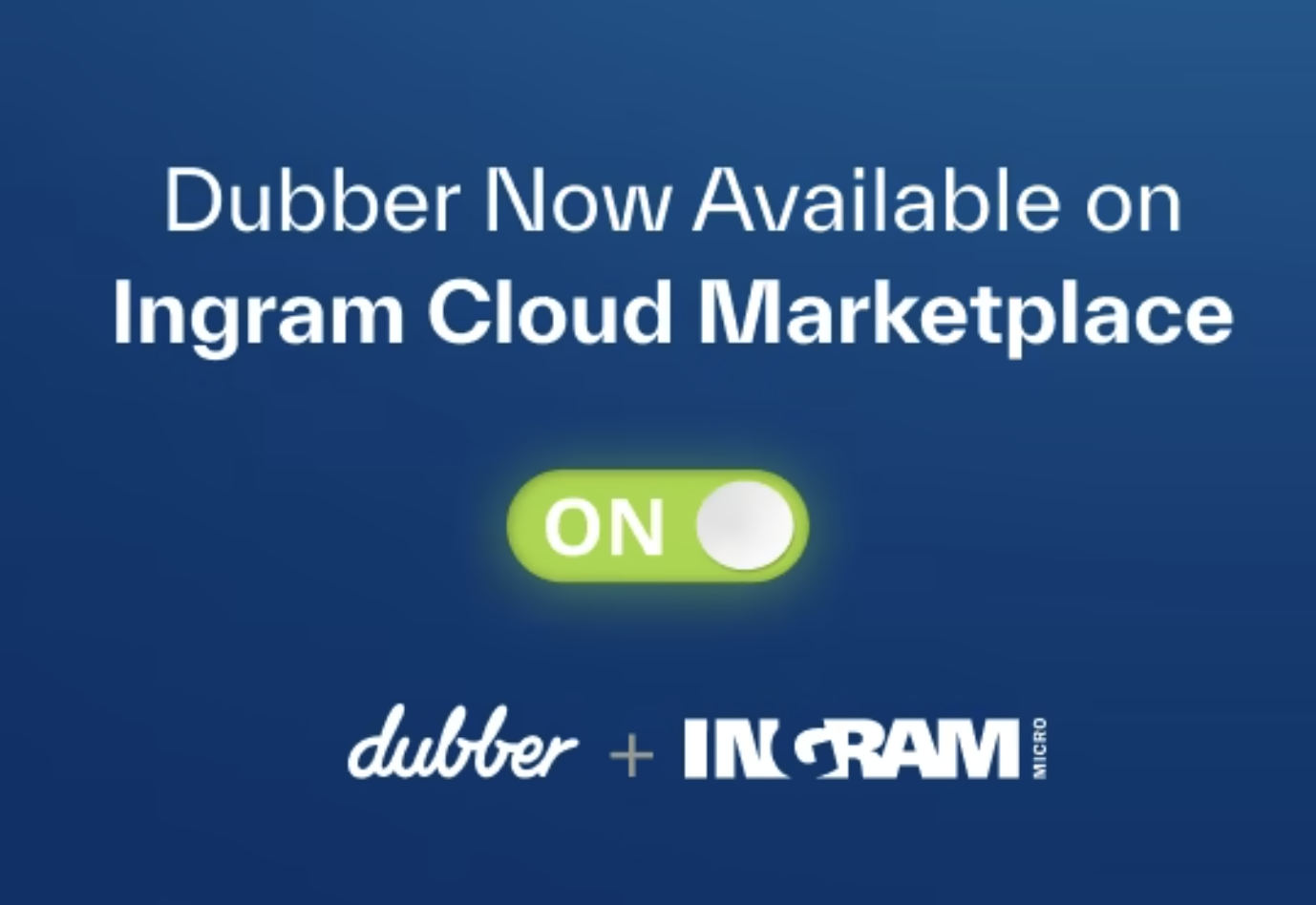
Dubber enables channel partners to help customers meet compliance mandates, improve sales and service performance, and unlock the possibilities of voice data at scale
Sydney, 12 July 2021 – Ingram Micro, Australia’s leading cloud services provider, today announced Dubber, the world’s leading provider of cloud based unified call recording and voice AI, is now available to all channel partners and resellers via the Ingram Micro Cloud Marketplace.
Cloud-based call recording is a rapidly growing market, spurred on in part by the challenges of the coronavirus pandemic and, in particular the increase in hybrid and work from home arrangements, as well as increasing regulatory requirements and digital transformation within organisations.
Dubber’s cloud-based solutions allow secure Unified Call Recording from any device or location while its AI-driven insights provide real-time search, alerts, transcription, sentiment analysis and more. Dubber’s services allow businesses of any size to automatically record every call and transform their content into rich, usable data for compliance, productivity, insights and customer engagement.
Trent Gomersall, Director of Cloud, Ingram Micro Australia said: “We’re pleased to help our Australian channel partners and resellers better meet the needs of their customers in this space.”
“The coronavirus pandemic is having a lasting impact on the adoption of communication and collaboration technologies and Gartner1 predicts demand for cloud telephony will grow by 17.8% globally this year,” he added.
Dubber COO James Slaney said: “92% of all customer interactions are voice. Dubber helps break down the limitations of application-specific, legacy call recording and unlock the possibilities of voice data and AI across any device.”
This creates opportunities for resellers and partners, Slaney continued. “Dubber is the only compliant solution in the market which can unify recording across Cisco Webex Calling, Microsoft Teams, Zoom and networks including Telstra and Optus.”
Dubber offers Ingram Micro channel partners and resellers access to market development funds, incremental commission incentives, and dedicated channel support and training.
Channel partners and resellers can learn more and purchase Dubber from the Ingram Micro Cloud marketplace here Cloud Marketplace
1 Gartner: press release, 2 June 2020.
About Ingram Micro Cloud
Ingram Micro Cloud is a global division of Ingram Micro and employs more than 1,500 dedicated cloud specialists worldwide. Among this large pool of experts are 400+ cloud sales associates and 700+ engineers. Its innovative platform and services offerings power some of the world’s most pioneering and successful companies. As a premium cloud services provider, Ingram Micro Cloud views cloud as more than a single technology – it is a foundational platform capable of underpinning the digital transformation. For more information, please visit au.ingrammicro.com
About Dubber:
Dubber is unlocking the potential of voice data from any call or conversation. Dubber is the world’s most scalable Unified Call Recording service and Voice Intelligence Cloud adopted as core network infrastructure by multiple global leading telecommunications carriers in North America, Europe and Asia Pacific. Dubber allows service providers to offer call recording for compliance, business intelligence, sentiment analysis, AI and more on any phone. Dubber is a disruptive innovator in the multi-billion dollar call recording industry, its Software as a Service offering removes the need for on-premise hardware, applications or costly and limited storage. For more information visit www.dubber.net

If conversations are the currency of effective property management, why is their value lost the moment the conversation ends? What if the value of every conversation was multiplied?
Unified call recording is being rapidly adopted by leading property managers to deliver vital insights, boost productivity and address compliance mandates.
“Property managers face a deluge of calls every day – and the majority of them are crucial conversations that need to be documented and acted on”, said Andy Lark, Chief Customer Officer, Dubber. “The challenge is preserving an accurate record of those conversations whether they took place in a call center, mobile or an application like Cisco Webex, Zoom or Microsoft teams”.
Advances in Cloud technology now make that possible.
Any conversation can be captured without the need for hardware or storage and transformed into data. And that data used to automate keyword alerts, customer satisfaction reporting and more.
Navigating the world of hybrid work
Over the past 18 months most property managers are working from everywhere while still managing entire property portfolios often with thousands of residents.
Unified call recording has enabled property managers to have more visibility into their businesses — like transcriptions evidencing contract negotiations and tenant notifications, real-time insight into in-progress workflows, or maintenance requests.
The adoption of these new tools signals a shift in the industry that sets up teams for more flexibility and agility. Simply put, the requirement to be in the know without the benefit of being in the same place can be answered by technology.
And part of that answer is unified call recording.
Today, leading property managers are realizing benefits across five areas:
- Dispute resolution
Hitting replay on any conversation – whether audio or a transcription – is the fastest way to verify what was said and resolve disputes quickly. It’s also proof positive the property management team met compliance and legal obligations.
- Workflow automation
Rather than depending on manual note taking and notoriously unreliable human recall, every conversation can be easily integrated with CRM systems. Managers then have an accurate view of not just what was said but who it was said to and when. The savings in record keeping alone can exceed five hours per agent per week.
- Customer experience
AI-powered insights running in real time across the business present customer satisfaction data without delay. Alerts and notifications surface issues and trends.
- Training & coaching
With every conversation available for replay, managers are able to coach and train based on what was actually said. Whether improving sales techniques or ensuring team members are following compliance guidelines, unified call recording provides critical visibility.
- Powerful insights
Suppose an unusually high number of your potential vendors were sending their business elsewhere. Perhaps the quality of tenants recently entering your system is not meeting your requirements? Or maybe the property management team has been lodging an outstanding number of complaints on leased properties, leading to a drop in tenant satisfaction, occupancy and overall rent roll.
This could be a sign your property business’s service and products are not meeting standards. Alternatively, it could be an issue with delivery. Either way the gap could be driving buyers, landlords and tenants away from your business, leading to a drop in closures, and agents disillusionment.
Always-on recording with visibility into customer conversations can help to discover negative patterns such as; misleading information, knowledge gaps on neighborhood issues, last minute landlord pull outs or a drop in quality buyers.
Automated conversation keyword search, in conjunction with elegant call recording transcriptions, could uncover sales opportunity blockers and blind spots.
Never leave a conversation behind
Cloud-based call recording is simple and easy to deploy.
Look for solutions that enable you to start with basic call recording for individuals or dive into more comprehensive business solutions with AI-powered insights and beautiful transcriptions.
Ensure the data you are capturing is stored securely and in line with compliance requirements. Look for how your call recording platform can easily be integrated with your CRM tools.
And establish clear policies for crucial conversations – including the services on which they must happen.
With unified call recording capturing every conversation, you’ll quickly be in a position to end not knowing.
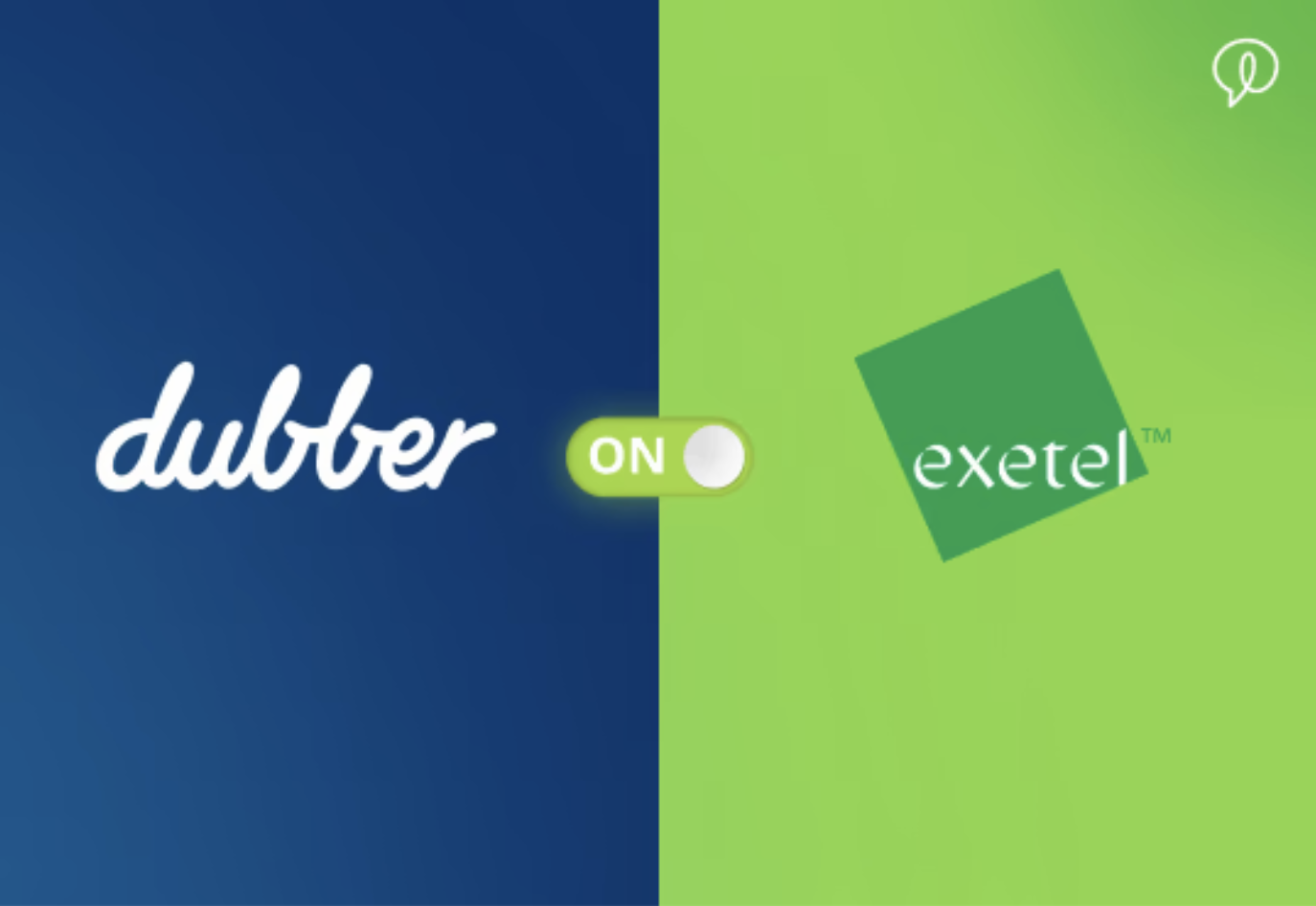
Exetel today announced a game-changing partnership with Dubber, a global leader in Unified Call Recording and Voice Intelligence solutions.
Integrating Dubber’s voice data and artificial intelligence into Banter, its own scalable cloud PBX, unified communications and collaboration platform for business customers, Exetel announced the Australian-first functionality was available as a standard and in-built feature of its VOIP services for business customers. Dubber’s Unified Call Recording will automatically record and transform every conversation on Banter into rich voice data for compliance, customer experience, call sentiment, evidence and performance improvement. Dubber will allow Exetel clients to eliminate the cost, complexity and risk of legacy call recording and unlock the benefits of voice data at scale.
Richard Purdy, Exetel Chief Executive Officer, said he was excited about the potential for business customers. “Bringing the power and intelligence of Dubber’s industry-leading solutions together with Banter’s intuitive and collaborative enterprise platform will drive a step-change in customer service levels not available on any other network in the country.
Steve McGovern, CEO, Dubber, said:
“We are delighted to be working with Exetel to bring the power of Dubber’s unified call recording services to customers on their Banter product suite. Exetel and Dubber share a common view about the importance of cloud-based communications driving the next wave of telecommunications innovation both in Australia and globally. We look forward to working closely with the Exetel team to bring scalable call recording and voice data to their business customers and helping clients to ‘end not knowing,” he said.
Responding last year to a suspected in-office case of COVID-19, the Exetel team deployed its own Banter service, a VOIP service that enabled its team to stand up a remote office and continue to work as if from their desk across fixed, desktop and mobile applications on the same day.
Purdy noted Banter was developed to provide all the functionality its business customers needed into a fully hosted business-grade collaboration platform. “It is fast to install, easy to use, fully flexible and will evolve and grow with a customer’s business. It has been a particularly attractive tool for our customers grappling with the evolving needs of working from home during the COVID period. Integrating Dubber’s Unified Call Recording and Voice Intelligence Solution into Banter takes the offering to another level altogether.”
“Voice sentiment identification is at the cutting edge of complaint resolution and Exetel is proud to partner with Dubber in bringing this service to market. Recording and storing conversations for proactive compliance and dispute resolution, continues to drive the need for voice data and intelligence at scale and Dubber is fast becoming known for its proven leadership in this space,” said Purdy.
For further information, please contact:Geoff Fowlstone
M: 0413746949
For additional information on Dubber on Banter, please visit:
About Dubber:
Dubber is unlocking the potential of voice data from any call or conversation. Dubber is the world’s most scalable Unified Call Recording service and Voice Intelligence Cloud adopted as core network infrastructure by multiple global leading telecommunications carriers in North America, Europe and Asia Pacific. Dubber allows service providers to offer call recording for compliance, business intelligence, sentiment analysis, AI and more on any phone. Dubber is a disruptive innovator in the multi-billion dollar call recording industry, its Software as a Service offering removes the need for on-premise hardware, applications or costly and limited storage.

Practical strategies and steps from the MS – Dubber webinar
Is the hybrid workplace here to stay? How do you meet post-pandemic demands for regaining compliance? And what role does technology play in enabling hybrid work flexibility, improving productivity and lifting CX and EX, all while minimizing risk?
In a recent webinar, Leon Wright, Microsoft’s Advanced Workloads Lead in Australia, together with Andy Lark, Chief Marketing Officer, Dubber, outlined the new hybrid work challenges, from siloed teams – to difficulties in accessing data for compliance insights.
Drawing from the webinar, we highlighted essential strategies to regain compliance in a hybrid workplace. We summarised for you ways organisations can now leverage voice technology to lift compliance and derive critical insights from customer conversations in the hybrid workplace.
The good, the bad and the promise of the hybrid paradox
Microsoft’s Leon Wright believes Covid is just the beginning of the disruption:
“Over a year into the pandemic, digital adoption curves are accelerating and the evidence is in the data: 80% of managers expect more flexible work from home policies post-pandemic. 73% of employees want flexible remote work options to stay and 67% of employees want more remote in-person and collaboration work.”
So how do you embrace flexible workplaces and processes and thrive?
You could start by creating a new work model that prioritizes social, knowledge and human capital. And you could embrace the Employee Experience (EX) and create more listening systems.
“If Covid has taught one thing, it is that managers were not listening… We need to get those listening systems working really well. It’s about configuring those systems for your best productivity,” Leon Wright, Microsoft.
Meeting recordings is fast becoming the new content channel
Leon Wright believes meeting recordings is going to be one of the fastest growing content types at Microsoft. “Recording has become the new champion of knowledge management. It’s a vital tool for continuous learning about customers and employees in a hybrid workplace. It’s not only the employee expectations that fundamentally changed; customer’s expectations have changed too, and we need to listen more to what they have to say.”
Organisations that embrace the seismic hybrid shift and explore ways to tune into their employees and customers may have more of a chance to succeed in this complex reality.
Are you listening? Overcoming distance in a connected world
As the workforce becomes more distant, it is more challenging to get our message across and understand correctly what’s been said between teams and customers.
There is a growing dependence on BYODs and rising use of BYOAs – Bring Your Own Applications. As a result, there is a growing difficulty to manage the Customer Experience (CX) and Employee Experience (EX) across multiple end-points, like mobile, messaging applications, VOIP applications, video meetings, and more. Employees are often switching between these multiple communications methods, and customers are demanding to be met where and how they communicate.
Voice is the largest untapped source of data and insights
Fortunately, cloud-based voice technologies evolved as one of the tools for managing this new complex hybrid workplace. Voice AI, in particular, is playing a vital role in improving CX, EX, compliance, and more. The ability to use AI to automate the otherwise impossible task of understanding sentiment and behavior during calls has become crucial.
“There has never been a more important time to establish a system of record… Many of us have forgotten just how many conversations are voice-based. Today more than 80% of crucial conversations are still voice and the value of that conversation ends as soon as it is over, ” Andy Lark, Dubber “If companies are not allowing compliance breaches to occur in email, they shouldn’t be happening in voice conversations.
The power of Unified Call Recording (UCR) and customer intelligence
The advantage of Dubber on video and call meeting platforms, such as MS Teams, Cisco’s Webex and Zoom, is you have all your conference calls, mobile conversations, SIP trunk connections, messaging, chat and more stored and retrieved from one secure and compliant place.
In the past, a single query, and there are hundreds of them a day, could take hours. Now you can drill down in seconds into conversation sets, pick up troubling keywords and easily review insightful transcriptions.
This impacts dispute resolution, contact centre calls tracking, employee training, sales revenue intelligence, and more.
In sum:
In this hybrid world, the upside of voice technology is the rise of new business performance, sales and productivity opportunities.
The ability to capture crucial conversations across remote and in-office environments and derive insights is paving the way to; improved employee engagement, boosted productivity, better outcomes in sales and compliance.
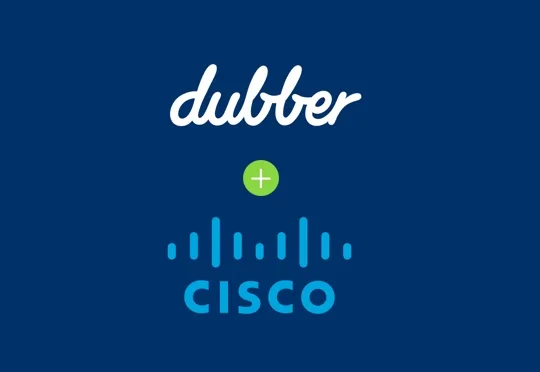
An instantly provisioned upgrade that gives you immediate differentiation? The ability to answer Cisco Webex and UCM Cloud compliance and security needs? A path to more revenue through easy and wanted upgrades?
Cisco and Dubber have you covered with today’s announcement that Dubber is powering call recording on Cisco Webex Calling and UCM Cloud. Your customers can compliantly record, store, share and replay any conversation. This critical new functionality turns on with a click at zero cost and is included in your Cisco subscription.
It’s on with a click
So here’s all you need to do. Whether a new or existing customer, simply turn on call recording in Cisco Control Hub. Your customer will need to accept the Dubber terms and conditions when doing so. That’s it.
From there, our customer success team will be available to assist with onboarding, training and more as you need it.
We’ve partnered with Cisco to reach out to all customers to ensure they are aware of how to compliantly record on Cisco and how to turn it on.
What’s included
Dubber is the global leader in unified call recording and voice AI solutions for compliance, revenue, customer and people intelligence. Basic call recording within Cisco will get you started on the path to ending not knowing, offering:
- Unlimited recordings of calls
- Cloud capture and storage
- Basic Enterprise controls and policy enforcement
- Easy access, replay, download and share from the Dubber app and web
- 30-day storage
Simple & easy path to more
If your customers require additional features such as extended team management, storage, transcription, video recording, sentiment analysis or AI-enriched insights (and much more), it’s simple to upgrade to Dubber solutions from within Cisco’s Control Hub with immediate access and effect.
Cisco partners will immediately benefit from any annual recurring revenue.
And there is more. Register to become a Dubber on Cisco partner today and get access to competitions, market development funds and much more.
Discover the benefits of unified call recording
Users that have compliance or regulatory requirements can easily ensure recording, replay and data storage on Cisco will meet their compliance obligations, regardless of the employee work location. A major concern and need for businesses as a result of the significant shift to remote and hybrid workforce arrangements.
“Expanding our relationship with Cisco marks a major milestone in increasing the ubiquity of Dubber as the Unified Call Recording and voice data layer for the world’s leading collaboration platforms,” said Steve McGovern, CEO, Dubber. “Our strong relationship with Cisco has been a critical part of our growth as a company and we share a common vision of the way that voice data will become a critical resource for all businesses and users in the future.”
A better way to hit replay
Unlike other embedded recording solutions, Dubber addresses critical data, privacy and regulatory requirements while providing a simple and easy pathway to richer functionality as it is required. Dubber recordings and AI-enriched data can easily be unified in the Dubber Voice Intelligence Cloud alongside conversations from other end-points such as landlines and mobile.
While other solutions offer the ability to record – something we call personal call recording – it’s the kind of recording ideal for an individual but not suitable for business or government. Here are a few of the reasons why:
- Secure cloud storage that can be managed centrally – avoiding privacy, data sovereignty and information leakage risks associated with recording to hardware
- Easily manage who can record and what can be recorded – implementing data and communications policies is made easy
- Controlled provisioning – via the Cisco Control Hub to ensure recordings are only available to eligible employees
Dubber also offers a range of Compliance-specific editions designed to meet the needs of highly regulated organisations and compliance teams.
“Business and Government require more than personal call recording,” said James Slaney, chief operating officer, Dubber. “They need conversations to be captured in a way that is compliant and converted to data for revenue intelligence, dispute resolution, proactive compliance and customer service. Today’s announcement is proof not only of the scalability of Dubber, but the potential we and Cisco see in tapping voice data to improve the performance of businesses and governments worldwide.”
How to start doing more with every conversation
Chat to Dubber on Cisco specialists ready to get your team or organization set up today – or your Cisco rep or partner. Dubber’s customer support team will be standing by to assist with any onboarding or training you or your team needs.
And if you need more than basic call recording for some or all of your users, our teams will assist in upgrading you to the world’s leading unified call recording solutions.
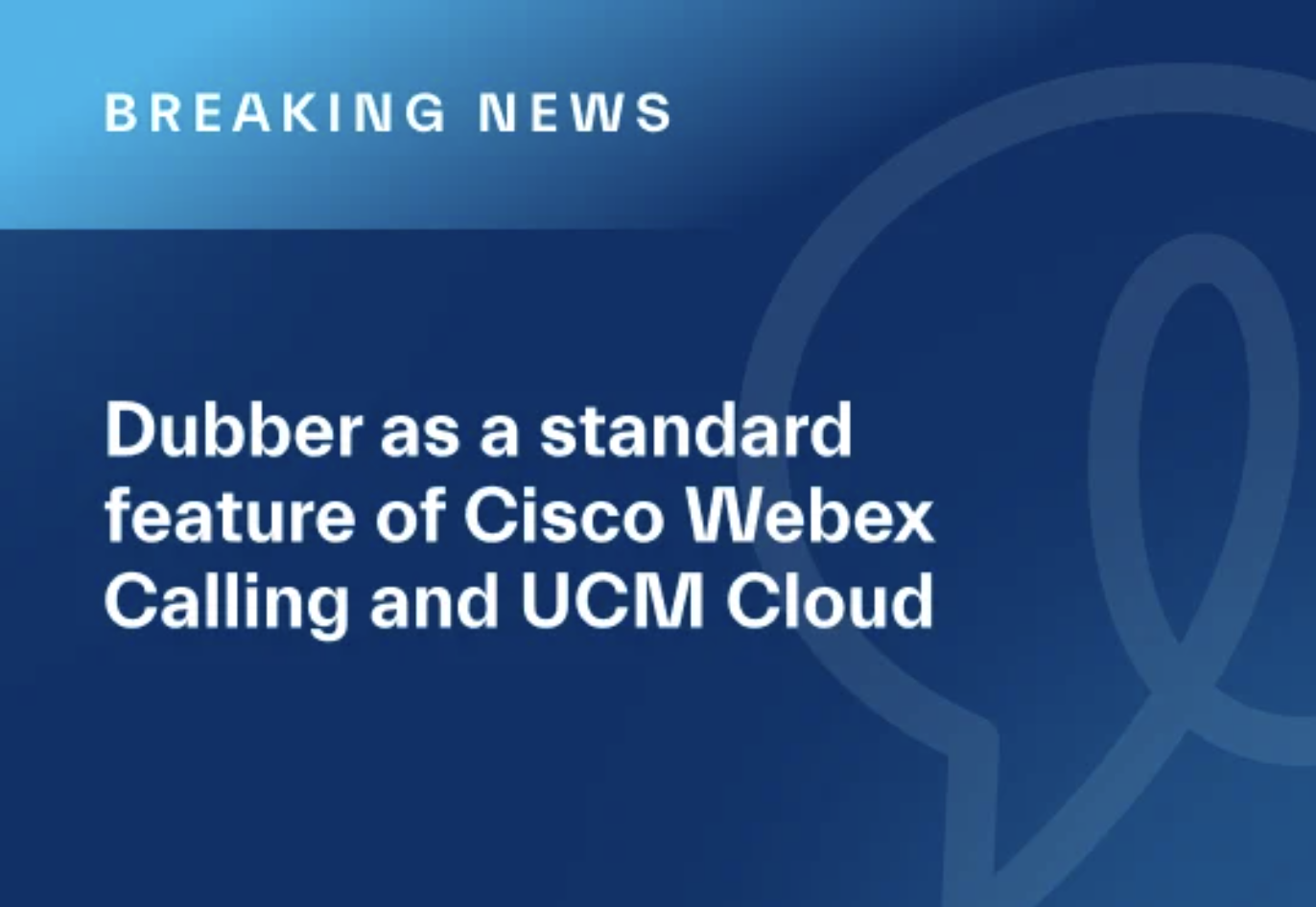
- Dubber now a standard feature on Cisco Webex Calling and UCM Cloud
- Dubber compliant Call Recording included in all subscriptions
- Cisco first Dubber Foundation Partner
Melbourne, Australia and Dallas, Texas – 3 June 2021 — Dubber Corporation Limited (ASX: DUB) (Dubber), today announced that Cisco Webex Calling and Cisco Unified Communications Manager Cloud (UCM) will now include Dubber call recording as part of all Cisco Webex and UCM services at no additional cost to users. See related blog post here.
Now, Webex Calling and UCM users with the ability to record any and all conversations as an included feature of their Webex subscription. If a user or business requires additional features such as extended storage, video recording, transcription, sentiment analysis or AI-enriched insights, they can simply upgrade their Dubber plan from within Cisco’s Control Hub with immediate access and effect.
Business users that have compliance or regulatory requirements to record and store calls can easily ensure recording, replay and data storage via the Cisco Webex platform, meeting their compliance obligations, regardless of the employee work location – a major concern for businesses as a result of the significant shift to remote and hybrid workforce arrangements.
“Cisco and Dubber share a common vision of the way that voice data will become a critical resource for all businesses and users in the future. This marks a major milestone in increasing the ubiquity of Dubber as the Unified Call Recording and voice data layer for the world’s leading collaboration platforms,” said Steve McGovern, CEO, Dubber
Cisco as a Foundation Partner
Additionally, Cisco will become Dubber’s first major Foundation Partner. The Dubber Foundation Partner Program utilises the scale and native cloud capability of the Dubber platform, enabling a service provider to embed Dubber within their core service and make basic call recording available for every user as a standard feature. Dubber and its Foundation Partners are then able to cross and upsell richer functionality for compliance, AI services, additional storage, insights and more.
McGovern added: “Dubber Foundation benefits Cisco and Dubber customers with a required capability as a standard feature while providing for the broader journey whereby the content of calls can be transformed into rich, usable data for compliance, productivity, insights and customer engagement.
“Customers worldwide are responding to increased regulatory and compliance obligations for their businesses. Embedding tools, like Dubber call recording, as a standard service that is available to Webex users will help customers meet those requirements while enabling easy access to powerful advanced voice data services,” said Lorrissa Horton, Vice President and General Manager of Webex Calling and Online.
“The Foundation Partner Program provides Dubber with a significant additional revenue stream while preserving our current revenue models and creating the opportunity to accelerate growth in our core products. Having 100% of a customer base enabled provides Dubber and Cisco the opportunity to significantly drive consumption and uptake of call recording and voice data services on the platform,” said McGovern.
As well as being an embedded solution, Dubber addresses critical data, privacy and regulatory requirements while providing a simple and easy pathway to richer functionality as it is required. Dubber recordings and AI-enriched data can easily be unified in the Dubber Voice Intelligence Cloud alongside conversations from other end-points such as land-lines and mobile.
“Business and Government require more than personal call recording,” said James Slaney, COO, Dubber. “They need conversations to be captured in a way that is compliant and converted to data for revenue intelligence, dispute resolution, proactive compliance and customer service. Today’s announcement is proof not only of the scalability of Dubber, but the potential we and Cisco see in tapping voice data to improve the performance of businesses and governments worldwide.”
Background: Dubber on Cisco Webex Calling and UCM Cloud:
- Available to all Cisco Webex Calling and UCM Cloud users as of today
- Dubber call recording on Cisco is free for any end user on the Webex Calling or UCM platforms
- Provides unlimited recordings stored for up to 30 days and is easily upgraded to unlimited storage for longer periods of time.
- Additional Dubber compliance, storage, transcription and AI plans are available immediately
- Access Cisco blog post here.
- Access Dubber on Webex via Cisco Control Hub
Background: Cisco UCM Cloud & Cisco Webex Calling recording:
Cisco® UCM Cloud provides enterprise-class call control, session management, voice, video, messaging, mobility, and conferencing services that are scalable, customizable, reliable, private and highly secure. In a sector where call recording is usually the domain of the contact centre, businesses can now switch on specific or all employees immediately paving the way for real-time insights across the entire organisation.
Cisco Webex® Calling is a cloud-based phone system optimized for businesses of all sizes. It provides essential business calling capabilities for desktop, mobile, and remote workers and is delivered from the global Webex collaboration platform. Webex Calling leverages cloud delivery to provide flexibility, rapid innovation, predictable operating expenses, and instant global scale while protecting on-premises investments by connecting them to the Webex collaboration platform.
This announcement has been approved for release by Steve McGovern, CEO, Dubber.
About Dubber:
Dubber is unlocking the potential of voice data from any call or conversation. Dubber is the world’s most scalable Unified Call Recording service and Voice Intelligence Cloud adopted as core network infrastructure by multiple global leading telecommunications carriers in North America, Europe and Asia Pacific. Dubber allows service providers to offer call recording for compliance, business intelligence, sentiment analysis, AI and more on any phone. Dubber is a disruptive innovator in the multi-billion dollar call recording industry, its Software as a Service offering removes the need for on-premise hardware, applications or costly and limited storage.
For more information, please contact:
Investors: Simon Hinsley simon.hinsley@dubber.net
+61 (0) 401 809 653
UK Media: James Taylor | The PR Network james.taylor@thepr.network
+44 (0)7796 138291
US Media: Charlie Guyer, Guyer Group for Dubbercharlie@guyergroup.com
+1 617 599 8830
AU & NZ Media: Terry Alberstein terry@navigatecommunication.com.au
+61 (0) 458 484 921
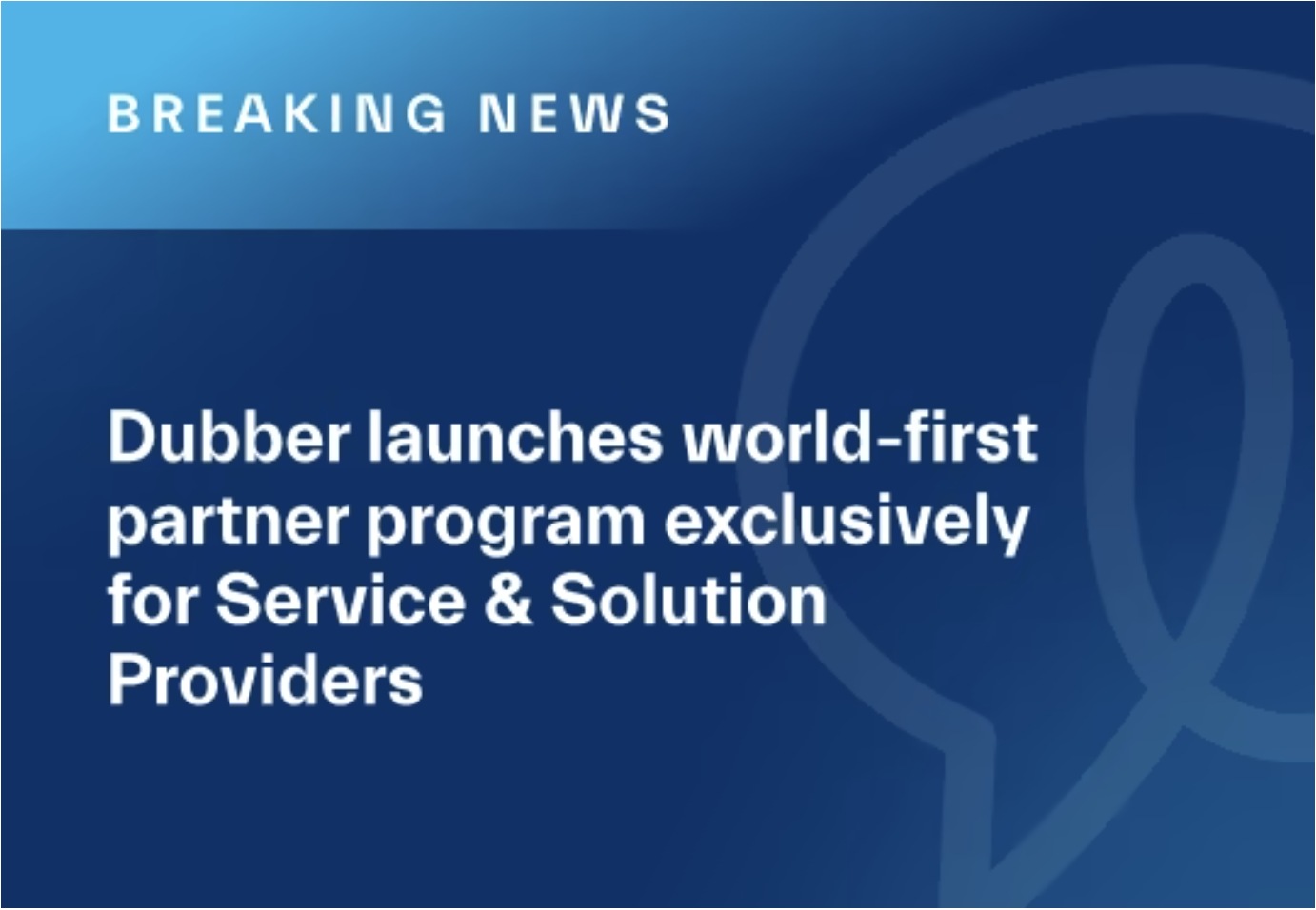
- Unlocks ability of any conversation to be economically transformed into differentiating services and significant revenue streams
- Launches Dubber Go exclusively for Foundation Partners, a call recording product packaged for embedding in any voice service as a standard feature
- Announces Cisco as first major Foundation Partner
Melbourne, Australia, and Dallas, Texas – 3 June 2021 — Dubber Corporation Limited (ASX: DUB) (Dubber), today launched the Dubber Foundation Partner Program and Dubber Go – enabling a call recording product packaged for embedding in any voice service as a standard feature. Both have been designed specifically for service and solution providers to enable cloud-first call recording from within their networks, services and applications.
Cisco is the first global Foundation Partner. Any Cisco Webex Calling and Unified Communications Manager Cloud (UCM-C) customers can use Dubber voice recording at no extra cost instantly accessible directly from Webex Control Hub.
Announcement highlights:
- Dubber available as a standard feature for 100% of Service and Solutions Providers customer base
- Delivers ‘Foundation’ revenue which is accretive without compromising the true value of standard Dubber product offerings
- Supercharges commercial outcomes for Dubber and Foundation Partner
- Dubber able to market and upsell directly to customer from a position of 100% penetration
Executive & Analyst Commentary
“Our new Foundation Program is a key component of our strategy to put AI on every communications device and application,” said Steve McGovern, CEO, Dubber. “It enables Dubber to bring the benefits of call recording to 100% of a service and solution provider’s customer base, delivering the opportunity for accretive revenue and protecting the true value of the Dubber product offering. With the ability to directly, and together, introduce customers to the benefits of unified call recording we are significantly enhancing commercial outcomes.”
“Service and solution providers are in a race globally to create new services based on the content on their networks,” said James Slaney, COO, Dubber. “Conversations are the largest content generator. Until now, much of their value is lost the moment a conversation ends. Today we’re launching an inexpensive, compliant and effective way for Foundation Partners to unlock that value. They’ll be able to create compelling differentiation. Our Foundation Partner program enables new revenue streams which could be worth many hundreds of millions of dollars.”
Dubber Foundation
Dubber Foundation Partners get exclusive access to comprehensive sales, marketing and customer success support. This includes dedicated Dubber sales resources to help customers access unified call recording1.
Dubber Foundation Includes:
- Exclusive access to Dubber Go – enabling basic call recording on all network and solution endpoints at price points that work for both parties
- A multi-tiered pricing and engagement offering. This can support service providers with as few as thousands of subscribers or those with millions
- Deep partner support including dedicated resources to assist in sales, marketing, and customer success
- Access to preferential pricing across all Dubber products that increases margins and revenue
- Available now globally across multiple service types such as UC and mobile networks
- Ability to create and co-design new services with Dubber on the Dubber Voice Intelligence Cloud. An opportunity to build new partnerships and application ecosystems based on voice data
“Our initial work with service and solution providers around the world established that Dubber Foundation Partners can create significant revenue and differentiation while addressing critical customer needs such as compliance, revenue and customer intelligence,” said Adrian Di Pietrantonio, EVP Global Partners. “For a service provider starting with 700,000 customers having access to Dubber Go, potential annual recurring revenue for a service provider could be in the hundreds of millions of dollars.”
Dubber Go
Dubber Foundation partners get exclusive access to Dubber Go. It enables basic call recording with unlimited recordings and 30-day storage for an individual as a standard inclusion in their services. Dubber Go introduces customers to the benefits of being able to compliantly record and replay any conversation whether a call, presentation, training session or video conference.
Dubber Go customers can upgrade to any of Dubber’s products at the click of a mouse.
Unlike other call recording services, Dubber captures and stores conversations in a compliant way. It works in accordance with an enterprise’s security and privacy policies. And, a simple and easy upgrade path to Dubber core and compliance solutions enables enterprise and government customers to access intelligence and features to address compliance mandates. These include retention, legal hold, compliance alerts and easy integration with other compliance systems.
1 Unified Call Recording captures any conversation – voice or video – on any communications service and from any service provider then unifies and stores the data in a form that can be used by anyone with appropriate permission, anywhere in the world at any time.
About Dubber:
Dubber is unlocking the potential of voice data from any call or conversation. Dubber is the world’s most scalable Unified Call Recording service and Voice Intelligence Cloud adopted as core network infrastructure by multiple global leading telecommunications carriers in North America, Europe and Asia Pacific. Dubber allows service providers to offer call recording for compliance, business intelligence, sentiment analysis, AI and more on any phone. Dubber is a disruptive innovator in the multi-billion dollar call recording industry, its Software as a Service offering removes the need for on-premise hardware, applications or costly and limited storage.
For more information, please contact:
Investors: Simon Hinsley simon.hinsley@dubber.net
+61 (0) 401 809 653
UK Media: James Taylor | The PR Network james.taylor@thepr.network
+44 (0)7796 138291
US Media: Charlie Guyer, Guyer Group for Dubbercharlie@guyergroup.com
+1 617 599 8830
AU & NZ Media: Terry Alberstein terry@navigatecommunication.com.au
+61 (0) 458 484 921
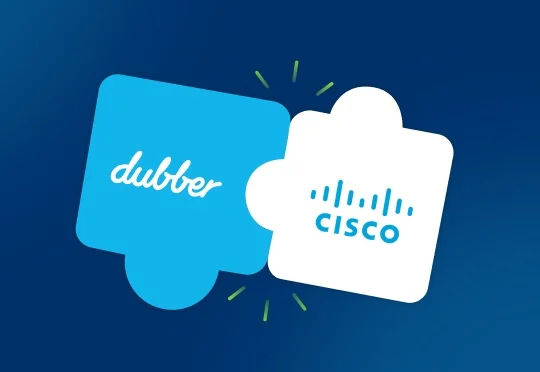
As of today, any Cisco Webex® Calling or UCM Cloud customer can compliantly record, store, share and replay any call. Powered by Dubber, this critical new functionality turns on with a click at zero cost and is included in your Cisco subscription.
If you require additional features such as extended team management, video recording, storage, transcription, sentiment analysis or AI-enriched insights (and much more), it’s simple to upgrade to Dubber solutions from within Cisco’s Control Hub with immediate access and effect.
Users that have compliance or regulatory requirements can easily ensure recording, replay and data storage on Cisco will meet their compliance obligations, regardless of the employee work location. A major concern and need for businesses as a result of the significant shift to remote and hybrid workforce arrangements.
“Customers worldwide are responding to increased regulatory and compliance obligations for their businesses. Embedding tools, like Dubber call recording, as a standard service that is available to Webex users will help customers meet those requirements while enabling easy access to powerful advanced voice data services,” said Lorrissa Horton, Vice President and General Manager of Webex Calling and Online. [Read the blog post]
What’s included
Dubber is the global leader in unified call recording and voice AI solutions for compliance, revenue, customer and people intelligence. Basic call recording within Cisco will get you started on the path to ending not knowing, offering:
- Unlimited recordings of calls
- Cloud capture and compliant storage
- Basic Enterprise controls and policy enforcement
- Easy access, replay, download and share from the Dubber app and web
- 30-day storage
A better way to hit replay
Unlike other embedded recording solutions, Dubber addresses critical data, privacy and regulatory requirements while providing a simple and easy pathway to richer functionality as it is required. Dubber recordings and AI-enriched data can easily be unified in the Dubber Voice Intelligence Cloud alongside conversations from other end-points such as landlines and mobile.
While other solutions offer the ability to record – something we call personal call recording – it’s the kind of recording ideal for an individual but not suitable for business or government. Here are a few of the reasons why:
- Secure cloud storage that can be managed centrally – avoiding privacy, data sovereignty and information leakage risks associated with recording to hardware
- Easily manage who can record and what can be recorded – implementing data and communications policies is made easy
- Controlled provisioning – via the Cisco Control Hub to ensure recordings are only available to eligible employees
Dubber also offers a range of Compliance-specific editions designed to meet the needs of highly regulated organisations and compliance teams.
“Business and Government require more than personal call recording,” said James Slaney, chief operating officer, Dubber. “They need conversations to be captured in a way that is compliant and converted to data for revenue intelligence, dispute resolution, proactive compliance and customer service. Today’s announcement is proof not only of the scalability of Dubber but the potential we and Cisco see in tapping voice data to improve the performance of businesses and governments worldwide.”
How to start doing more with every conversation
Chat to Dubber ready to get your team or organization set up today – or your Cisco rep or partner. Dubber’s customer support team will be standing by to assist with any onboarding or training you or your team needs.
And if you need more than basic call recording for some or all of your users, our teams will assist in upgrading you to the world’s leading unified call recording solutions .

- World’s first voice intelligence solution embedded in major service provider networks and UC solutions like Cisco Webex, Microsoft Teams and Zoom – eliminates need for costly hardware and services
- Purpose-built for compliance teams to specify, manage, record, store, and analyze all communications – voice calls, chat, presentations and more
- Available today globally with immediate provisioning
Melbourne, Australia, and Dallas, Texas – 18 May 2021 — Dubber Corporation Limited (ASX: DUB) (Dubber), today announced new solutions designed to meet the exacting needs of compliance, risk, audit and security professionals.
“Compliance is driving significant demand for capturing conversational content – messaging, chat and video – across any application or end-point,” said James Slaney, COO, Dubber. “Delivering an immutable record of every crucial conversation is essential and demanded by regulators globally. With COVID, the pressure to capture conversations across a multitude of endpoints – from existing Service Provider services through to Cisco Webex, Microsoft Teams and Zoom – has only accelerated. Unified Call Recording makes what used to be a complex task easy.”
With Dubber’s unique reach and Unified Call Recording (UCR), specifically for compliance, companies can capture recordings immediately in one location from all their voice, video and text services, including the 140+ Service Provider networks connected to the Dubber platform globally. This reach and the new solutions for compliance, make Dubber the world’s leading recording option for compliance.
“Dubber continues to transform the economics of call recording and voice data,” said Matthew Townend, Executive Director, Cavell – a leading industry analyst firm. “The benefits of voice intelligence as a service are clear – both to the service providers that will build differentiation through offering it and to businesses and governments that will deploy it to address critical business needs.”
Three new cornerstone compliance solutions mean business and government clients can select flexible and affordable plans that best reflect their needs and compliance practices.
Dubber Compliance offerings enable voice data to be captured economically, at scale. They recognise a smaller number of people need to access the data and that data needs to be isolated from other voice data sets. Dubber allows data integration and portability so any data from any source can be unified on Dubber and connected to other compliance data sets, applications and business intelligence tools.
- Dubber UCR Compliance Edition for compliance leaders with a need to manage, monitor, store and review conversations. Recordings and data from multiple sources can be captured, stored, searched, and reviewed in Dubber, in real-time, without the need for complex queries. Starting at USD $14.95 per month per end-point and up to ten compliance users.
- Dubber Premier Compliance Edition enables a compliance team of up to ten (with additional licenses available) to benefit from AI-enriched insights, alerts, search and sentiment analysis. Additional features include beautiful and insightful transcriptions, legal hold and discovery, and, smart keyword, team and customer search. Starting at USD $29.95 per month per end-point and up to ten compliance users.
- Dubber Voice Intelligence Cloud Compliance Edition ideal for compliance teams who only seek to record calls with confidence, then storing and unifying data in a single easily accessible source of truth. All the features of Dubber Premier Compliance Edition. Plans start at USD $1,599.99 for 250 endpoints and one user access – with additional plans for more end-points and users.
All Dubber solutions include critical features such as unlimited storage, access to the easy to use Dubber application for IOS, Android and Web, concierge set-up and training, data download and export, 24×7 online global support — and, seamless, high-quality media capture across devices and all supported endpoints for audio, video, screen share, and chat.
Critically, Dubber Compliance Solutions answer the need for policy-based recording. Organizations that adopt Dubber can easily implement compliance and administrative policies such as when calls and online meetings should be automatically recorded and captured for subsequent processing and retention as required by relevant corporate or regulatory policy.
Dubber solutions are native to the world’s leading communications solutions, including Cisco Webex, Microsoft Teams, and Zoom, and the world’s leading networks such as AT&T, Verizon, Tetstra and Cox Communications. Conversations, once captured, are stored in Dubber Cloud Storage and then processed in the Dubber Voice Intelligence Cloud – where AI creates real-time insights, alerts, and more.
Public data from key regulators including the FCA in the United Kingdom and the CFTC and SEC in the United States show that fines levied for communication compliance monitoring topped $150,000,000 in 2019. Regulatory focus continues to increase with FINRA highlighting digital communications, including collaboration platforms, as a priority for its 2020 broker-dealer examinations.
Regulations and regulators requiring an accurate record of conversations to satisfy know-your-customer, data protection and privacy mandates include MiFID II, Dodd-Frank, ASIC, APRA, AUSTRAC, PCI, SOX, FCA, FINRA and regulators globally.
“Our new solutions make Unified Call Recording more flexible and available to businesses and teams of any size,” said Slaney. “We founded Dubber to eliminate the cost and complexity of capturing any conversation. For too many, the value of that conversation is lost the moment it ends. We’re making it simpler and easier than ever to end not knowing and comply.”
Key compliance activities are made simple and easy with Dubber automating key tasks:
- Collect and integrate recordings and data in the manner required to meet compliance obligations in appropriate regional boundaries
- Real-time search for interactions based on communication-related metadata or interaction content. Common examples include:
- Metadata – participants, time, direction, dialled number, origin number, custom business data
- Content – transcription, sentiment, phonetics, related interactions
- Analyze and interact with collected communications, including the ability to monitor interactions as they are being collected
- Ensure security of collected communications and prevent tampering at all stages
- Retention policies support retain and delete action,; and, legal hold and discovery on historical and real-time data
Resources
- Pricing information: https://www.dubber.net/pricing
- Blog post: https://www.dubber.net/news
- Brochure: http://www.dubber.net/wp-content/uploads/2021/05/PP-One-Pager-Comp.pdf
- Press release: https://www.prnewswire.com/news-releases/dubber-launches-three-new-compliance-solutions-301292361.html
About Dubber:
Dubber is unlocking the potential of voice data from any call or conversation. Dubber is the world’s most scalable Unified Call Recording service and Voice Intelligence Cloud adopted as core network infrastructure by multiple global leading telecommunications carriers in North America, Europe and Asia Pacific. Dubber allows service providers to offer call recording for compliance, business intelligence, sentiment analysis, AI and more on any phone. Dubber is a disruptive innovator in the multi-billion dollar call recording industry, its Software as a Service offering removes the need for on-premise hardware, applications or costly and limited storage.
For more information, please contact:
Investors: Simon Hinsleysimon.hinsley@dubber.net
+61 (0) 401 809 653
UK Media: James Taylor | The PR Network james.taylor@thepr.network
+44 (0)7796 138291
AU & NZ Media: Terry Alberstein terry@navigatecommunication.com.au
+61 (0) 458 484 921
US Media: Charlie Guyer, Guyer Group for Dubbercharlie@guyergroup.com
+1.617.599.8830
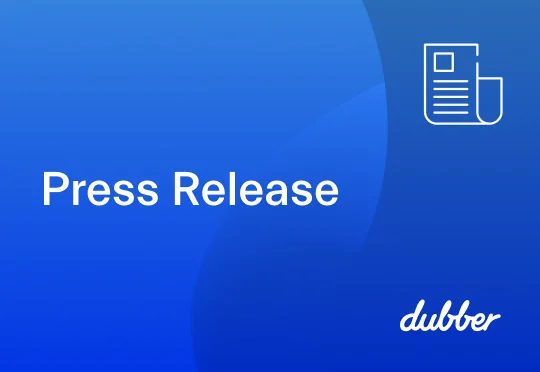
- Answers global demand for unified call recording and voice intelligence across any communications end-point with the world’s most comprehensive and advanced product family
- Creates seamless ability to enrich any conversation with AI and share with business applications
- Simple, easy to deploy, flexible monthly and annual plans
- New solutions designed specifically for compliance managers and teams
Melbourne, Australia, and Dallas, Texas – 18 May 2021 — Dubber Corporation Limited (ASX: DUB) (Dubber), today announced 12 new products and solutions, more than tripling its industry-leading voice intelligence offerings for service and solution providers, business and government. The new solutions are available today directly from Dubber on eligible networks and solutions. Dubber’s existing solutions, CallDub and DubAI continue to be offered across all networks.
“Unified Call Recording is critical to achieving the compliance, revenue, and customer insights demanded by business and government today,” said James Slaney, COO, Dubber.
“More than 80% of crucial conversations with customers and employees take place using voice. Not having access to accurate, compliant records in real-time puts leaders at a serious disadvantage. Dubber addresses that by unlocking the insights in every conversation.”
“Dubber continues to transform the economics of call recording and voice data,” said Matthew Townend, Executive Director, Cavell – a leading industry analyst firm. “The benefits of voice intelligence as a service are clear – both to the service providers that will build differentiation through offering it and to businesses and governments that will deploy it to address critical business needs.”
Three new core Dubber solutions
At the heart of today’s announcement are three new core solutions. They give business and government customers flexible, affordable options so that users or teams can capture and use voice intelligence – from recordings to transcriptions to sentiment analysis.
- Dubber You delivers Unified Call Recording where individuals need to record, store and review crucial conversations. Dubber You automates the recording of calls, meetings and video without the need for hardware or software and comes with unlimited lifetime storage. Plans start at USD $14.95 per month per recording endpoint.
- Dubber Teams is ideal for managers and leaders needing central review and control over 100% accurate and enforced recordings and data for sales, service, and customer insights. Plans start at USD $19.95 per month per recording endpoint.
- Dubber Premier unlocks all Dubber functionality delivering AI-enriched insights. Beautiful transcriptions, alerts and notifications and the ability to easily integrate Dubber with business intelligence and CRM applications. Plans start at USD $49.95 per month per recording endpoint.
All Dubber solutions include critical features such as unlimited storage, easy-to-use application for iOS, Android and Web, concierge set-up and training, data download and export and 24×7 online global support.
“Our new solutions make Unified Call Recording more flexible and available to businesses and teams of any size,” said Slaney. “We founded Dubber to eliminate the cost and complexity of capturing any conversation. For too many, the value of that conversation is lost the moment it ends. We’re making it simpler and easier than ever to end not knowing and comply.”
Users can easily expand any package with simple to deploy add-ons including:
- UCR Service Add-on Pack – easily add services with a click – review and manage recordings, transcriptions and data in one place
- Dubber API – easily connect Dubber recordings and data to applications, storage and dashboards
- Dubber Call Recording Archive – redundant and secure storage of all call recordings and data with Dubber Storage. Back up your valuable voice data in the Dubber Voice Intelligence Cloud, including recordings and data from other sources
- Dubber for Salesforce – add your Dubber recordings, metadata, transcriptions and sentiment insights to Salesforce records
Native to the world’s networks and communications solutions
Dubber is native to the world’s leading communications solutions, including Cisco, Microsoft, and Zoom. Its partners span more than 140+ of the world’s leading networks, including AT&T, Verizon, Telstra and Cox Communications.
With Dubber’s unique reach and Unified Call Recording (UCR), specifically for compliance, companies can capture recordings immediately in one location from all their voice, video and text services. Conversations, once automatically captured, are stored in Dubber Cloud Storage and then processed in the Dubber Voice Intelligence Cloud – where AI creates real-time insights, alerts, and more.
This reach and the new solutions for compliance, make Dubber the world’s leading and most flexible recording option for compliance.
Transforming how conversations are captured and used
Dubber solutions support continuous compliance and voice intelligence with critical features including:
- Collect and integrate recordings and data in the manner required to meet compliance obligations appropriate to regional regulations
- Real-time search of interactions based on communication-related metadata or conversational content. Common examples include:
- Analyze and interact with collected communications, including the ability to monitor interactions as they are being collected
- Ensure security of collected communications and prevent tampering at all stages
- Retention policies support retain and delete actions; and, legal hold and discovery on historical and real-time data
- Metadata – participants, time, direction, dialled number, origin number, custom business data
- Content – transcription, sentiment, phonetics, related interactions
Dubber also announced today a full suite of solutions designed specifically for the demanding needs of compliance, legal, security, risk and audit teams.
Call Dub and Dub AI, Dubber’s existing solutions, will continue to be provided by partners and service and solution providers globally for the foreseeable future.
Resources
- Pricing information: https://www.dubber.net/pricing
- Blog post: https://www.dubber.net/news
- Brochures quick link: https://www.dubber.net/brochure
- Press release: https://www.prnewswire.com/news-releases/dubber-launches-12-next-generation-unified-call-recording-solutions-301292378.html
About Dubber:
Dubber is unlocking the potential of voice data from any call or conversation. Dubber is the world’s most scalable Unified Call Recording service and Voice Intelligence Cloud adopted as core network infrastructure by multiple global leading telecommunications carriers in North America, Europe and Asia Pacific. Dubber allows service providers to offer call recording for compliance, business intelligence, sentiment analysis, AI and more on any phone. Dubber is a disruptive innovator in the multi-billion dollar call recording industry, its Software as a Service offering removes the need for on-premise hardware, applications or costly and limited storage.
For more information, please contact:
Investors: Simon Hinsleysimon.hinsley@dubber.net+61 (0) 401 809 653
UK Media: James Taylor | The PR Network james.taylor@thepr.network +44 (0)7796 138291
AU & NZ Media: Terry Alberstein terry@navigatecommunication.com.au+61 (0) 458 484 921
US Media: Charlie Guyer, Guyer Group for Dubbercharlie@guyergroup.com+1.617.599.8830
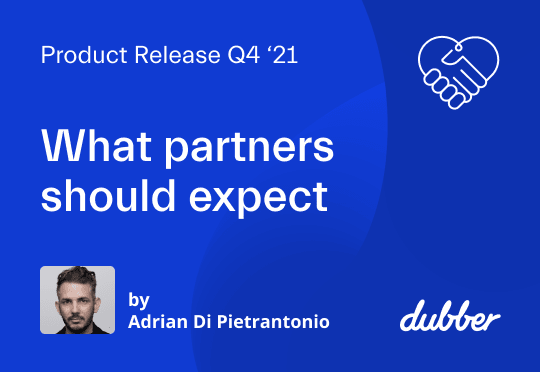
Today we announced over 12 new solutions giving our partners more ability than ever before to differentiate, drive revenue and engage customers.
With Dubber’s unique reach and Unified Call Recording (UCR), specifically for compliance, companies can capture recordings immediately in one location from all their voice, video and text services, including the 140+ Service Provider networks connected to the Dubber platform globally. This reach and the new solutions for compliance, make Dubber the world leading recording option for compliance, revenue and customer intelligence.
We’ll be working closely with our global service and solution providers to enable Dubber You, Dubber Teams and Dubber Premier on their networks and services. From today they are available on MS Teams, Cisco, Zoom and other major UC solutions. And, our new Compliance Solutions are available today on all platforms.
A New Source of Advantage
Unified Call Recording (UCR) breaks the constraints of legacy call recording. We designed Dubber’s new UCR solutions to reflect the way customers use conversational data – whether recordings, beautiful transcriptions or sentiment analytics.
And, they enable customers to store and process any recording – from any endpoint or voice recording solution – in the Dubber Voice Intelligence Cloud.
Channel partners will be able to design fit-for-purpose solutions that answer the needs of the smallest and largest businesses.
For a small business that might mean Dubber You capturing calls for rapid dispute resolution and automagically enriching customer records in Salesforce with the conversation.
A call centre will use Dubber Teams to capture all calls across the primary SIP connection and Cisco Webex, unifying records in the Dubber Voice Intelligence Cloud and using the data to fuel insights in dashboards.
Compliance teams can now access purpose-built solutions. They can mine compliant data sets for audits, investigations and discovery. Keyword and sentiment reporting will move them from a reactive to a proactive footing.
What’s next?
Over the coming weeks, we will be hosting a series of webinars to take you through the new solutions and what they mean for you.
In the meantime, our industry-leading products – CallDub and DubAI are still available. But expect the new solutions to appear quickly in major networks and UC solutions.

Quick Read
- Three new compliance solutions designed to economically enable conversation recording across many end-points — giving compliance teams the tools they need to manage, store, review and monitor conversations.
- Turn on end-points across multiple services and solutions – aggregate data in one place – the Dubber Voice Intelligence Cloud
- AI does the heavy compliance work, generating insights, alerts and powering workflows
- Dubber compliance solutions being implemented today by leading Financial Services institutions globally
Compliance, risk, audit and leaders in regulated industries need a better answer to global mandates to know the customer and record conversations. We know because they told us as we were working on the new core Dubber solutions.
We were told about an industry where customers were charged for recording on any and every endpoint bundled with a range of features for every user – when only a few needed access to those features.
Regulated industry leaders told us they need a more economical and secure way to capture every conversation. The data has to be stored with certainty. And they need better access to data and insights.
It would be a small number of personnel accessing the data and that data had to be protected.
We heard about a need to break voice data silos. In the past compliance professionals had to jump between recordings captured in the call centre to recordings for, say, Zoom in a compliance app.
Every data silo introduces cost, complexity and compliance risk. These are three things Dubber set out to eliminate.
Compliant, Unified Call Recording
So, we set about creating the first unified call recording and voice intelligence solution purpose-built for compliance teams.
Compliance drives significant demand for capturing conversational content. It covers messaging, chat and video. And that content can come from any application or end-point. Delivering an immutable record of every crucial conversation is essential. It’s also what regulators around the world now demand.
With COVID, the pressure to capture conversations across a multitude of endpoints – from Cisco WebEx to Microsoft Teams and Zoom – has accelerated. Unified Call Recording makes what used to be a complex task easy.
Today we’re unveiling three new cornerstone compliance solutions that mean business and government can select flexible and affordable plans that best reflect their needs and compliance practices.
Changing the Economics of Conversational Compliance
Dubber Compliance offerings capture voice data economically, at scale. They recognise a smaller number of people who need to access the data and the need to isolate that data from other voice data sets.
Dubber allows data integration and portability so any data from any source can be unified on Dubber and connected to other compliance data sets, applications and business intelligence tools.
- Dubber UCR Compliance Edition for compliance leaders with a need to manage, monitor, store and review conversations. Dubber captures and stores recordings and data from multiple sources in real-time. Once there it can be searched, and reviewed, still in real-time, without the need for complex queries. Starting at $14.95 per month per end-point and up to ten compliance users.
- Dubber Premier Compliance Edition enables a compliance team of up to ten (with additional licenses available) to benefit from AI-enriched insights, alerts, search and sentiment analysis. Additional features include beautiful and insightful transcriptions; legal hold and discovery; and, smart keyword, team and customer search. Starting at $29.95 per month per end-point and up to ten compliance users.
- Dubber Voice Intelligence Cloud Compliance Edition is ideal for compliance teams who only seek to record calls with confidence, then storing and unifying data in a single easily accessible source of truth. All the features of Dubber Premier Compliance Edition. Plans start at $1,599.99 for250 endpoints and one user access – with additional plans for more end-points and users.
All Dubber solutions include critical features such as unlimited storage; access to the easy to use Dubber application for IOS, Android and Web; concierge set-up and training; data download and export 24×7 online global support — and, seamless, high-quality media capture across devices and all supported endpoints for audio, video, screen share, and chat.
Policy-Based Unified Call Recording
Critically, Dubber Compliance Solutions answer the need for policy-based recording.
Dubber makes it easy for organizations to set compliance and administrative policies such as when calls and online meetings should be automatically recorded and captured for subsequent processing and retention as required by relevant corporate or regulatory policy.
Public data from key regulators including the FCA in the United Kingdom and the CFTC and SEC in the United States show that fines levied for communication compliance monitoring topped $150,000,000 in 2019. Regulatory focus continues to increase: FINRA highlighted digital communications, including collaboration platforms, as a priority for its 2020 broker-dealer examinations.
Regulations and regulators requiring an accurate record of conversations to satisfy know-your-customer, data protection and privacy mandates include MiFID II, Frank Dodd, ASIC, APRA, PCI, SOX, FCA, FINRA and Reserve Banks globally.
More Flexible, More Available
Our new solutions make Unified Call Recording more flexible and available to businesses and teams of any size. We founded Dubber to eliminate the cost and complexity of capturing any conversation. For too many, the value of that conversation is lost the moment it ends. We’re making it simpler and easier than ever to end not knowing and comply.
Dubber makes key compliance activities simple and easy by automating key tasks:
- Collect and integrate recordings and data in the manner required to meet compliance obligations in appropriate regional boundaries.
- Real-time search for interactions based on communication-related metadata or interaction content. Common examples include:
- Analyze and interact with collected communications, including the ability to monitor interactions as they are being collected.
- Ensure security of collected communications and prevent tampering at all stages
- Retention policies support retain and delete actions; and, legal hold and discovery on historical and real-time data
- Metadata – Participants, time, direction, dialled number, origin number, Custom business data
- Content – Transcription, sentiment, phonetics, related interactions
As with all the solutions we’re announcing today, we’re just getting started.

12 new ways to drive compliance, customer and revenue intelligence
Quick read:
- We’re announcing today 12 new solutions for call recording and using voice intelligence to power compliance, revenue and customer insights.
- Three new core solutions are built to reflect the way you’ll use the conversations collected
- All enable any recording from any eligible endpoint – from Cisco Webex to Mobile and more – to be compliantly stored in one place, the Dubber Voice Intelligence Cloud
- Simple to provision add-ons enable you to do more with every recording – like automagically adding conversations and transcriptions to Salesforce or business intelligence tools
We’ve been busy behind the scenes developing a new generation of Dubber solutions based on customer and partner input.
What we heard was – “give us all the great Dubber functionality and ease of use in a way that reflects how we need to work with conversations and voice data”.
That lead us to three clear scenarios.
First, some businesses only need individuals reviewing recordings and data – and some want to link that to Salesforce. It’s simple – one workspace for each person, viewing their recordings and sharing as needed.
Second, others want recordings enforced and managed by team leaders – with some wanting to connect voice data to their business intelligence platforms. Here, you have one workspace for all recordings with team members able to see recordings and data based on permissions granted.
Third, others wanted all the Dubber functionality with rich AI-powered insights, sentiment analysis, and more. Many teams, all managed in one workspace with instant customer and employee sentiment and real-time search.
And all three wanted simple to provision, add-on functionality for everything from data storage to APIs and connectors to popular apps.
So, we’ve done just that.
The answer is Unified Call Recording
Today we’re launching 12 new products and solutions, more than tripling our industry-leading voice intelligence offerings for service and solution providers, business and government.
The new solutions are available today directly from Dubber on eligible networks and solutions. Over the coming months, we anticipate they’ll be available across our more than 140 active service and solution providers services globally.
Dubber’s existing solutions, CallDub and DubAI will continue to be offered across all current networks.
Unified Call Recording is critical to achieving the compliance, revenue, and customer insights demanded by business and government today. More than 80% of crucial conversations with customers and employees take place using voice. Not having access to accurate, compliant records in real-time puts leaders at a serious disadvantage. Dubber addresses that by unlocking the insights in every conversation.
“Dubber continues to transform the economics of call recording and voice data,” said Matthew Townend, Executive Director, Cavell – a leading industry analyst firm. “The benefits of voice intelligence as a service are clear – both to the service providers that will build differentiation through offering it and to businesses and governments that will deploy it to address critical business needs.”
Three New Cornerstone Solutions
At the heart of today’s announcement are three new cornerstone solutions. They give business and government flexible, affordable options so that users or teams can capture and use voice intelligence – from recordings to transcriptions to sentiment analysis.
- Dubber You delivers Unified Call Recording where individuals need to record, store and review crucial conversations. Dubber You automates the recording of calls, meetings and video without the need for hardware or software and comes with unlimited lifetime storage. Plans start at $14.95 per month per recording endpoint.
- Dubber Teams is ideal for managers and leaders needing central review and control over 100% accurate and enforced recordings and data for sales, service, and customer people insights. Plans start at $19.95 per month per recording endpoint.
- Dubber Premier unlocks all Dubber functionality delivering AI-enriched insights. Beautiful transcriptions, alerts and notifications and the ability to easily integrate Dubber with business intelligence and CRM applications. Plans start at $49.95 per month per recording endpoint.
All Dubber solutions include critical features such as unlimited storage; easy-to-use application for iOS, Android and Web; concierge set-up and training; data download and export and 24×7 online global support.
Turbocharge Dubber
Users can easily expand any package with a simple to deploy add-on including:
- UCR Service Add-on Pack – Easily add services with a click – review and manage recordings, transcriptions and data in one place. So, if you are on MS Teams and you also want to add recordings from Cisco Webex, that’s easy.
- Dubber API – Easily connect Dubber recordings and data to applications, storage and dashboards.
- Dubber Call Recording Archive – Redundant and secure storage of all call recordings and data with Dubber Storage. Back up your valuable voice data in the Dubber Voice Intelligence Cloud, including recordings and data from other sources.
- Dubber for Salesforce – Add your Dubber recordings, metadata, transcriptions and sentiment insights to Salesforce records.
A few of the things you’ll be able to do
Dubber solutions support continuous compliance and voice intelligence with critical features including:
- Collect and integrate recordings and data in the manner required to meet compliance obligations appropriate to regional regulations
- Real-time search of interactions based on communication-related metadata or conversational content. Common examples include:
- Analyze and interact with collected communications, including the ability to monitor interactions as they are being collected.
- Ensure security of collected communications and prevent tampering at all stages
- Retention policies support retain and delete actions; and, legal hold and discovery on historical and real-time data
- Metadata – Participants, time, direction, dialled number, origin number, custom business data
- Content – Transcription, sentiment, phonetics, related interactions
We also announced today a full suite of solutions designed specifically for the exciting needs of compliance, legal, security, risk and audit teams.
With Dubber’s unique reach and Unified Call Recording (UCR), specifically for compliance, companies can capture recordings immediately in one location from all their voice, video and text services, including the 140+ Service Provider networks connected to the Dubber platform globally. This reach and the new solutions for compliance, make Dubber the world-leading recording option for compliance.
We’re just getting started!

Get your houses in order!
That’s the message resonating loud and clear to the finance industry from the ASIC RG-271 dispute resolution standards.
If your organisation wants to meet the new compliance standards by October 5, now is the time to act on updating your systems for managing complaints. And although October 5 seems a while away, the D-day drums are already beating.
Why all the fuss about RG-271?
ASIC introduced the RG-271 to improve the way financial services organisations manage and resolve business disputes. Recognising the value of customer feedback as a source of early systemic warnings, the commission reduced the timeframes for responding to complaints. It outlined what information should be in a written Internal Dispute Resolution (IDR) response, to make it easier for consumers to decide whether they want to escalate their complaints.
Capturing and tracking conversations in time will help resolve IDR issues before they escalate. The regulatory guide wants organisations to make more progress by “increasing the capture, tracking, analysis and reporting of complaint data.”
Voice data is a critical element of any business’s overall data set. Voice data is generated from recordings of conversations and the meta-data associated with those conversations.
To effectively meet the new mandate, financial services organisations will need to start call recording and implement workflows to capture compliance mishaps. What this means is they will need to quickly identify when a customer is expressing signs of distress, anger or frustration and build up efficient ways to respond in time.
Rather than this being a matter of opinion or interpretation, AI can tell you in real-time what is the sentiment being expressed by customers in every conversation. This can happen across any interaction point including call centres, mobile consulting calls, video conferencing meetings.
The red button issue – Financial organisations that don’t get their house in order in time could face penalties mounting to thousands of dollars.
Innovation leap in compliance technology brings good news
On the flip side, better IDR not only benefits consumers and small businesses, it equips the financial services boards with rich real time data on the customer experience and gives them a new lens into whether their customer’s needs are being met or not. Although the task can be daunting, regtech solutions such as Dubber accelerate dispute resolution and documentation and provide the foundation for proactive risk management and continuous compliance.
Breakthroughs in voice intelligence step up IDR management
Cloud-based Voice Intelligence is just one example of how technology is leading the way to answering the demands of a tightly regulated compliance environment. Voice intelligence done right makes it possible to create a continuous compliance loop that records, monitors conversations 24/7 and send alerts when organisations need to act on problematic conversations, before they escalate into a dispute.
Anticipating a growing need for smarter voice-driven compliance management, Dubber stepped up to offer a simple and affordable way to quickly meet the new mandates with confidence. One of the advantages of Dubber Voice AI; it can pick up when customers are dissatisfied through sentiment analysis and send an auto-alert to the compliance teams.
To help you ramp up your compliance in time for RG-271, Dubber can take you through the steps – no matter what the size of your organisation.
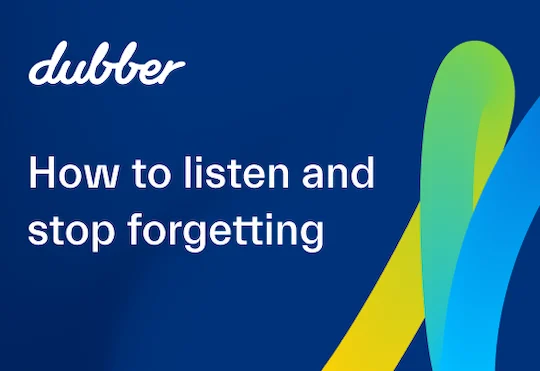
While the human brain can do wonderful things, it isn’t always the best tool for retaining information.
Don’t worry if this sounds familiar. Even bright, healthy adults are forgetful. We’re designed that way. And it’s a good thing.
Cognitive science professor Art Kohn says people are quick to forget. He talks about something he calls The Forgetting Curve. Kohn says one hour after learning new information the majority of people will have forgotten half of it.
A day later, the average person will be unable to recall 70 percent of the material. By the end of the week that figure will hit 90 percent. There will be people who do better and others who do worse. “In general the situation is appalling. Nearly everything you teach employees in company training sessions will be forgotten,” says Kohn.
This should not come as a surprise. A human brain is efficient precisely because it spends much of its time editing out unnecessary incoming information in order to focus. Along the way it will edit out important material along with the barrage of trivia coming our way every moment of the day.
Kohn talks specifically about corporate training. He worries that forward-looking businesses who spend vast sums preparing staff for new challenges may not get the value they hope for. The Forgetting Curve is a problem in other areas of business. People forget things all the time. They forget conversations, instructions, sales calls any one of dozens of interactions that take place during a working day.
With Dubber’s Unified Call Recording, there is no need to forget any interaction that takes place on a phone or video call. Unified Call Recording can capture every conversation and store it for later recall. The voice data is converted to text, date stamped and made searchable.
This means you can retrieve an accurate record of any conversation, presentation or training session. Even if our efficient, but flawed, human brain can do no better than recall it happened last Thursday morning or that it involved sending widgets to Brisbane.

Highlights from a recent Regtech and Dubber Webinar
How can managers navigate through growing compliance complexities when work happens everywhere? How do you regain control in a business communication world that is siloed into multiple voice chats, video channels, networks and devices? Will AI technology save the day, or are technology firms spreading more pixie dust?
COVID complicates compliance but isn’t the only driver of complexity
COVID complicated an already complex compliance world, adding a plethora of systems, communications tools and places over which compliance now needs to be managed. The volume, velocity and virality of customer conversations across Zoom videos, MS meetings, WhatsApp recordings, mobile conversations…, calls for new ways to track and monitor mounting mishaps and breaches.
Although some regulations were paused at the outset, they are back in force.
Underlying the complications of COVID are a range of broader changes challenging compliance teams: New communications preferences (think WeChat, Whatsapp and Signal) amongst customers and employees; the rise of video as a dominant communications medium; and the inevitability of Bring Your Own Device (BYOD) in the workplace.
Discussion on these drivers, and the challenges they pose to compliance leaders were at the centre of our recent Webinar with Regtech.
A return to mandatory conversation recording
While call and conversation recordings are mandatory for crucial conversations in most countries, they’re limited by legacy solutions, and the ability to compliantly capture them on leading communications platforms where video, calling and messaging converge.
In many environments, 80% of crucial customer conversations are voice, yet less than 10% of these conversations are captured. This percentage slides down as more conversations shift off legacy communications systems. For financial institutions, 50% of customer conversations now occur outside of the call centre. The status-quo is not about to change soon; 61% of financial service CFOs plan to make remote work permanent post-pandemic.
The financial pain is real
Last year alone, $10.4B of compliance fines and penalties were handed to financial institutions. Many of them were related to data privacy breaches. So how do you capture, retain and analyse crucial datasets when user end-points are dispersed across mobile, web and many other channels?
Not surprisingly, in the UK, the FCA mandate to record every voice conversation returned after recognising growing compliance gaps in a dispersed workforce that continues to operate across multiple communication channels.
But in a new reality where employees are hopping across MS Team meetings, Zoom videos, WhatsApp recordings and mobile voice calls, the compliance chasm is still there and growing.
The drive to continuous compliance
“The industry has come a long way from the days when the only option to access data was through spreadsheets. Now huge amounts of data are available on the cloud, and can be accessed almost instantly. This is a massive improvement.” – Regtech Webinar
The C-suite is still largely unaware of its ability to mine voice data outside the call center. There’s a clear opportunity for chief compliance officers to preserve core compliance data in a compliance cloud and be a primary data source for businesses. And critically, to aggregate voice conversations from across the business in one record system.
At the end of the day, the ability to monitor customer conversations, end not knowing, and run them at scale shifts you into a new mode of continuous compliance.
AI, compliance risks and red flags
There’s a lot of talk about driving Artificial Intelligence (AI) compliance models, and some industry kickback. But the future of AI-driven compliance is bright, and from a functionality stance, the timing couldn’t be better.
“The industry is responding positively to the different aspects of AI and what it can deliver from a compliance perspective. The future of compliance lies in the ability to harness artificial intelligence for many compliance tasks.”
The question is, how do we get to the point where we can predict mishaps and conversations that can go rogue, rather than constantly looking in the rear view mirror? This is one of the areas where innovation, AI and analytics are most likely to deliver significant compliance benefits.
If you can predict problems more effectively, you can fix them faster and more easily. You can deliver more tangible benefits and reduce the likelihood of remediation projects.
Unified vs. siloed voice communications
Global compliance leaders can no longer afford to maintain the status quo. They need to continuously monitor voice and chat platforms no matter where their teams and customers are globally positioned. Country-specific data sovereignty requirements also need to be met. So to PCI, and myriads of other regulations.
A shift to continuous compliance intelligence
“At the end of the day, call recording is just an activity. What matters is creating a compliance record system driven by voice data. It’s about integrating that data with other data sources and applications. And then from that compliant data set, fuelling AI-enriched alerts, notifications, workflows, dashboards, and more.”
“Compliance leaders need to look beyond a single application to do this and target a data-first strategy that powers any application they desire.” Andy Lark, Chief Customer Officer, Dubber.
Leaders in the future will need to track and instantly retrieve datasets from cloud-based platforms, with storage capacities up to five, or even seven years. With the tsunami of data from myriads of voice and video conversations, it could pay to spend time on data-driven strategies to flag alerts, gain insights into potential risk, and expedite proactive compliance.
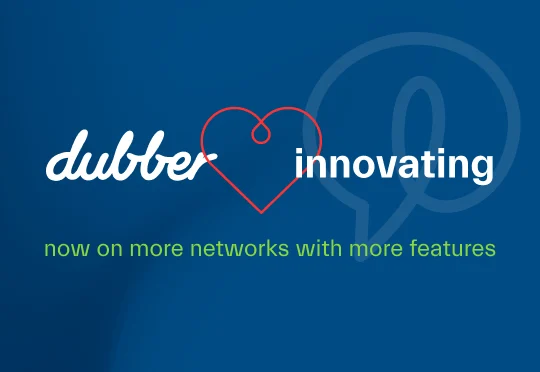
One of the key principles that guide us as a SaaS company is Dubber should get automagically better every day. So, over the past quarter, we’ve been busy behind the scenes making Dubber native to the world’s most popular calling and video solutions and adding cool new features.
Here are a few of the new places Dubber can be turned on with a click.
We recently announced the expansion of our AT&T relationship by offering compliant Unified Call Recording across 3 major AT&T networks: AT&T IP Tool Free, AT&T Hosted Voice Service and Cisco Webex calling with AT&T Business. This is only the start, as Dubber’s multi-network integration across AT&T and their partner platforms means users can now switch on Dubber with a click across AT&T’s Business portfolio, substantially broadening access to the customer voice insights across the entire enterprise.
Like you, we’ve found ourselves working from everywhere and relying on the best UC solutions to stay connected. Now, whatever you’re on, you’ll be able to record, get alerts and insights and do more. And you’ll be able to do it knowing you are complying with global data privacy and financial regulations – unlimited by storage constraints – with AI-enriched insights – and easy access through the Dubber App and Web console.
One of the great things about Unified Call Recording is all your recordings, data, transcripts and insights are in one place. So, if you are recording your own or your team’s calls and videos across mobile, Microsoft Teams, Cisco WebEx, and Zoom – they will all be conveniently in your inbox. And unlike other solutions requiring hardware, professional services, unique SIM cards, and call forwarding, we’ve integrated Dubber with these platforms, so Unified Call Recording can simply be available at a switch.
Here are a few of the integration highlights
- Dubber on Zoom: The recent Dubber – Zoom integration made it possible for Zoom users to access enhanced recording and voice analytics of millions of Zoom meetings and Zoom phone conversations
- Microsoft Teams Compliance Certification: Dubber just became one of the first unified call recording solutions to receive the Microsoft Teams compliance recording certification. Finally, businesses in regulated industries such as banking, government, insurance and financial services can easily meet legal and regulatory obligations for their Microsoft Teams users in call centres, offices, and work-from-anywhere environments
- Salesforce – Dubber integration: The recent addition of Dubber to the Salesforce AppExchange solves multiple issues. Salesforce users can now compliantly capture customer interactions, reduce administration, proactively manage accounts, and continuously improve deals by accessing insights and sentiment analysis. The newfound visibility also means salespeople can quickly search for information in their conversations, opportunities can be filtered by keywords, and managers can help teams win more deals
Cool new features
Dubber just got better with a slew of features to level up the customer experience and end not knowing. These new features don’t just add clarity, they ensure compliance is better managed and disputes are more easily solved.
- Enhanced AI Speaker Detection: Dubber now has an enhanced capability to detect speakers in a recording. As a result, Dubber transcriptions are more beautiful and more conversational, improving overall readability and insights
- AI Question Detection: Another boost to transcription readability was made by adding question marks
- Legal Hold: Now compliance-focused teams can protect recordings from deletion by user, by retention period, or accidental, ensuring that every recording can be retrieved at any time
- Transcription crosstalk elimination: Transcription quality often reduces when it comes to deciphering crosstalk. Recognising the gap Dubber built-in dual-channel transcriptions. The new capability eliminates transcription errors caused by cross talk and improves transcriptions when a caller is in a noisy environment
- IdP SSO: Security is a crucial pillar of the Dubber Platform, which is why we’ve enabled enterprises the overarching ability to control security and identity information. New Dubber customers can configure idP SSO during the account creation process while existing customers can add this functionality by requesting it through their account manager or support contact
We’re not stopping here. Dubber will continue to power on to deliver Unified Call Recording and voice intelligence solutions and end not knowing.
Let’s chat if you’d like a demo of our new integrations and features!
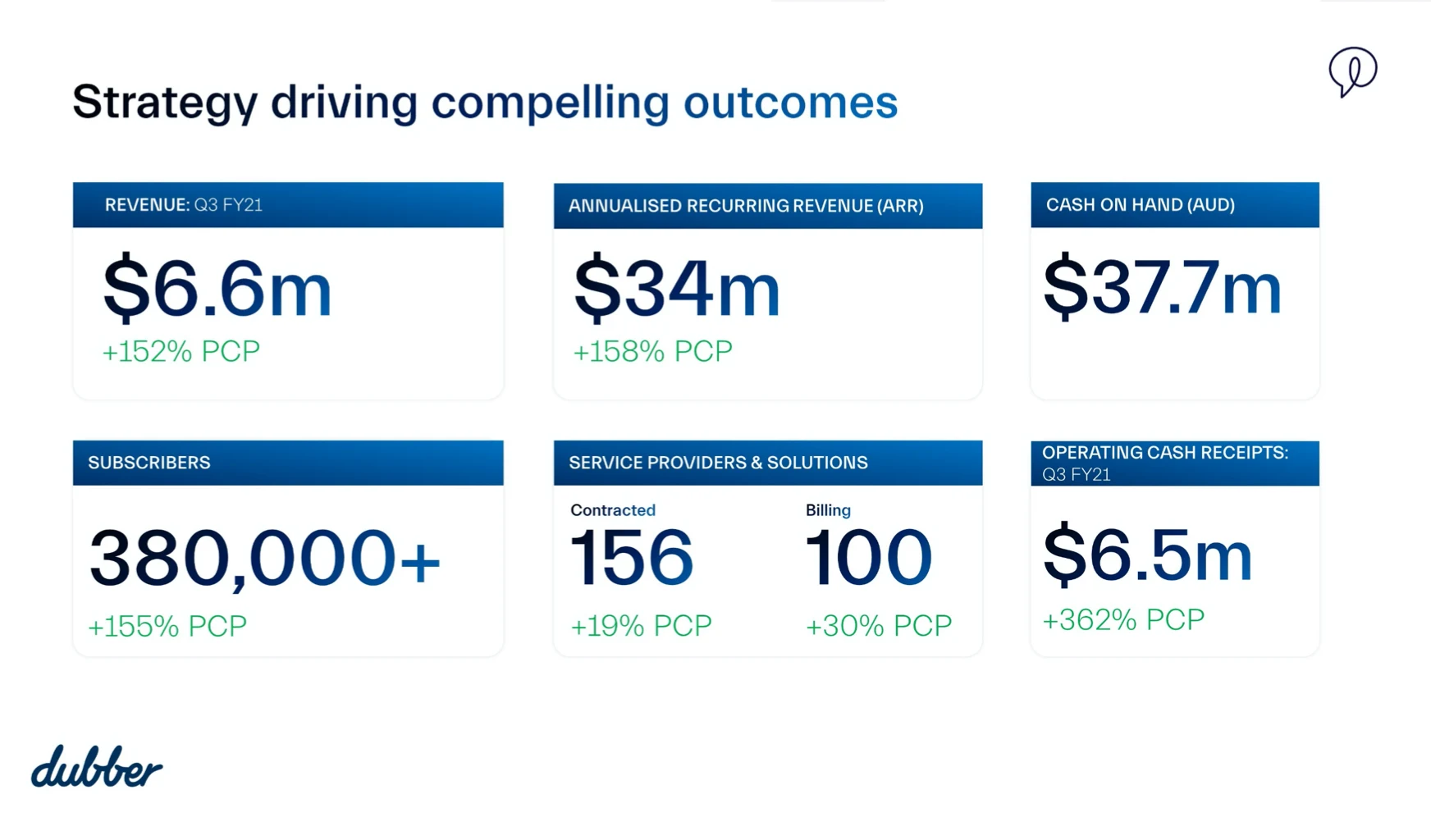
Dubber Corporation Limited (ASX: DUB) (‘Dubber’ or ‘the Company’), the leading global Unified Call Recording & Voice Intelligence cloud service designed for service providers and businesses of any size, is pleased to release an update on the Company’s operating focus along with the Appendix 4C for the quarter ended 31 March 2021.
Highlights:
- Annualised Recurring Revenue (ARR) increased 20% QoQ ($5.6m) to $34m and 158% pcp ($13.2m)
- Revenue increased 54% ($2.32m) to $6.6m QoQ and 152% pcp ($2.61m)
- Operating cash receipts increased 54% ($2.31m) to $6.55m QoQ and 362% pcp
- Dubber users now exceed 380,000
- The Company has a strong balance sheet, with in excess of $37.7m as at 31 March 2021
Growth in all key metrics – Users and ARR
During the March quarter the Company’s key metrics all experienced substantial growth.
User numbers grew at a record rate for Dubber’s SaaS monthly subscriptions. The Company expects user growth to increase significantly in the current quarter due to new initiatives including the launch of its Foundation Partner Program. Foundation Partners embed Dubber services within their offering as a standard and in-built feature – from which both Dubber and the partner then benefit from upgrading users to richer functionality and offerings.
The March quarter represents a milestone period relating to comparative user growth quarter on quarter.
The Company expects to receive Foundation and consumption-based revenues moving forward with larger and varying user attachment rates to those revenues. Therefore, as previously indicated, the key growth metric relating to short term growth is the Company’s Annualised Recurring Revenue (ARR) which has grown by $5.6m, to in excess of $34m.


Telecommunications Networks Growth and Yield
The Company continued to expand its footprint of service provider networks along with increasing penetration and revenue yield from its current telecommunication and Unified Communication (UC) platform partners.
AT&T
During the quarter, the Dubber platform went live on three AT&T networks: AT&T IP Toll-Free, AT&T Hosted Voice Service (HVS), and Cisco Webex Calling with AT&T. All three of these networks target large enterprise, government, education, and business clients. The HVS and Webex Calling networks are already providing positive uptake in SaaS monthly subscription users and services.
AT&T’s IP Toll-Free is a major global network carrying calls for the largest organisations in North America and is billed on a per minute consumption rate. Dubber’s recording, API, transcription and AI services will also be billed on a per minute rate at accretive unit increments, thereby introducing meaningful consumption based revenue streams to Dubber.
Currently, AT&T and IBM are engaged with existing mutual large enterprise customers to demonstrate the value of the newly available services on the platform which add substantial insights to those organisations, enabling them to gain valuable business intelligence from their voice data.
The Company expects the Dubber platform to be live on additional AT&T networks in both the short and medium term.
Unified Call Recording Momentum
The Company has previously referenced Unified Call Recording (UCR) which defines the Company’s unique value proposition of unifying call recording and voice data at scale. UCR reflects how businesses and individuals work today, particularly in Covid-19 driven ‘work from home’ settings and hybrid work environments.
The Company has recently become one of only two vendors certified for Compliant Call Recording for Microsoft Teams.
Dubber is already the embedded and only recording offering for Cisco’s Webex Calling platform with the Company expecting to substantially extend its relationship and availability with Cisco Webex in the near term.
During the quarter, the Company also announced availability of a Unified Call Recording solution for Zoom that allows for secure compliance and voice intelligence call recording for Zoom Meetings as well as Zoom’s recently launched cloud phone service, Zoom Phone.
Typical business communications usually involve the use of desk phones, mobiles, and UC services such as Cisco Webex, Zoom and Microsoft Teams. Dubber is uniquely placed to be able to capture recordings and voice data from all services and store them in a single location, the Dubber Voice Intelligence Cloud, where they can be managed centrally.
Behind these UC platform announcements is an industry trend whereby large global service providers are releasing their own network offerings in conjunction with cloud collaboration platforms like Zoom Phone, Microsoft Teams and Cisco Webex Calling. Dubber has detected a pronounced acceleration of telecommunication services moving to a cloud environment, either from traditional telecommunications carriers or by stand-alone UCaaS services in the last two quarters. By virtue of its unique ability to be embed into the fabric of a network and operate at scale, the company is a significant beneficiary of this trend and we believe it will continue to accelerate globally in the quarters ahead.
Foundation Partner Program
The Dubber platform has been designed specifically for large scale availability across telecommunications networks, as opposed to legacy bespoke recording products for enterprises, which are largely tied to on premise equipment, capital expenditure and call centre environments.
The Company expects several of its service provider partners to deploy the Dubber platform as a standard feature across their network base as “Dubber Foundation Partners”. The Company is actively engaged in discussions with major service providers to become Foundation Partners and expects the first initiative of this kind will take place in the current quarter.
This will provide the Company large scale customer reach into end user accounts for jointly upselling additional services, including extended storage, transcription, AI insights and more.
Steve McGovern, CEO, Dubber:
“We are delighted to have delivered such a strong quarter, achieving outstanding growth in all of our key metrics. The company is very well positioned to continue to take advantage of the major shift towards cloud based and ‘work from anywhere’ communications we are seeing in all our geographies. Governments and businesses understand the need to act on the requirement to capture conversations and voice data across their entire business. Ever expanding requirements to record and store conversations for proactive compliance and dispute resolution, and, revenue, customer and personnel intelligence all continue to drive the need for voice data and intelligence at scale. We remain very positive as to Dubber’s growth and leadership.”
Related Party Expenses
In line with requirements of lodgement of the attached Appendix 4C, the Company advises that payments shown in Item 6.1 of the Appendix 4C are in relation to Executive and Non-Executive Director remuneration (including superannuation) and form part of the operating expenses for the March quarter.
This ASX release has been approved for release to ASX by Steve McGovern, CEO & Managing Director.
Download the ASX release and Appendix 4C here (PDF)
About Dubber:
Dubber is unlocking the potential of voice data from any call or conversation. Dubber is the world’s most scalable Unified Call Recording service and Voice Intelligence Cloud adopted as core network infrastructure by multiple global leading telecommunications carriers in North America, Europe, and Asia Pacific. Dubber allows service providers to offer call recording for compliance, business intelligence, sentiment analysis, AI and more on any phone. Dubber is a disruptive innovator in the multi-billion-dollar call recording industry, its Software as a Service offering removes the need for on-premise hardware, applications or costly and limited storage.
For more information, please contact:
Investors
Simon Hinsley simon.hinsley@dubber.net
+61 (0) 401 809 653
Media
Terry Alberstein terry@navigatecommunication.com.au
+61 (0) 458 484 921

How is Voice AI meeting a growing need for faster, more accurate compliance management?
And why does Voice AI work hand-in-hand with proactive compliance?
At a recent IBM – Dubber webinar and round table, compliance industry leaders across the country talked about major compliance mandates affecting their performance. They were troubled by the new Work-from-Anywhere reality and how it’s off-setting rising regulatory demands on financial services and other industries.
During the webinar, fintech expert and Chief Customer Officer of Dubber, Andy Lark, together with Anthone Withers, Head of Public Cloud at IBM discussed the rising role of voice intelligence in stepping up compliance and removing legacy obstacles. They focused on how voice intelligence technology is meeting a growing demand for proactive compliance reporting.
See key takeaways on how to meet rising regulatory demands in 2021
Research shows a growing need to manage voice data in compliance
A history of compliance failures, cross-border mandates, and the growing list of guidelines since the Hayne Royal Commission and GFC are turning compliance and risk management into an increasingly complex task.
The Hayne Royal Commission claimed compliance was highly challenged by the common malpractice of using voice conversations to sell inappropriate products to customers. Deloitte in response, advised the industry to invest in compliance programs that embed data into their DNA. With the shift to data-driven compliance, voice data was inadequately addressed or was missing altogether.
A once impossible task now possible
“Voice has largely been captured in silos and locked into those silos. A voice intelligence platform now enables any conversation to be captured from any eligible end-point, then stored and analysed in a single compliant cloud instance.” Andy Lark, Dubber.
When coupled with IBM Watson, voice data is transformed into intelligent compliance insights. The combination shifts financial services and other regulated industries from a rear-view perspective to always knowing in real time.
When Covid hit and created a new ‘work-from-anywhere’ reality, compliance teams needed to capture and track conversations over a huge set of new endpoints and apps including mobile, Zoom, MS Teams, Cisco Webex and more. Suddenly, the impossible task of managing voice data at scale called for voice intelligence tools powered by Artificial Intelligence (AI).
The power of combining voice data with Watson IBM
Unleashing IBM Watson with Dubber Voice AI on conversation datasets ushered in a new way to analyse conversational data while managing it in a secure environment.
The IBM Watson – Dubber partnership made it finally possible for managers to gain insights into customer conversations and leverage predictive analytics. Managers could now use triggers on keywords and alerts to search and generate reports in real time.
A brave new remote world jeopardizes compliance mandates
“We’ve seen a surge in the use of Cisco Webex, Microsoft Teams, Zoom and more. The meeting online tsunami has created the need for compliant call recording, with all recordings – mobile, web and traditional handsets, unified in one place.” Andy Lark, Dubber
This switch to off-premise communications gave rise to a new remote worker and a growing reliance on mobile devices and applications. With that, new compliance issues arose. For instance, when remote financial workers recorded a business meeting on a popular application, unknowingly they broke many industry compliance mandates.
In effect, the data was not stored in a sovereign way, a privacy notification was not issued and workers were not redacting key data. Personal call recording simply did not meet compliance standards.
Time to knowing
“The new challenge is the time it takes to know if your compliance standing has been compromised.” Andy Lark, Dubber.
Traditional approaches to call recording resulted in useful dashboards for managing a call centre but today do little to meet the needs of compliance teams required to search terabytes of data in real time across multiple end-points – Or more importantly, being alerted on information misuse and policy breaches.
“Together with IBM we solved this at scale by enabling vast conversational data sets to be created and turning them into compelling insights” – Andy Lark, Dubber
Let’s look at a typical bank breach use case: Let’s say there is a serious customer complaint flagged across five years. The average time to assemble data could take up to eight hours of needle-in-a-haystack work. But with Watson IBM and Dubber, the task is reduced to 10 seconds. Anthone Withers pivoted to other important advantages: “You have proof, you have a transcript highlighting keywords that shouldn’t be in the conversation and you have sentiment analytics. Better still, all these insights that expose risk can be pulled into dashboards and reports in real time.”
In summary
Digital acceleration and remote work added multiple communication end-points that began to severely compromise compliance and fraud detection, just as regulatory demands were growing. What’s become clear is; compliance solutions that integrate voice intelligence can produce more cost-efficient and more productive compliance practices, and finally, deliver proactive compliance.
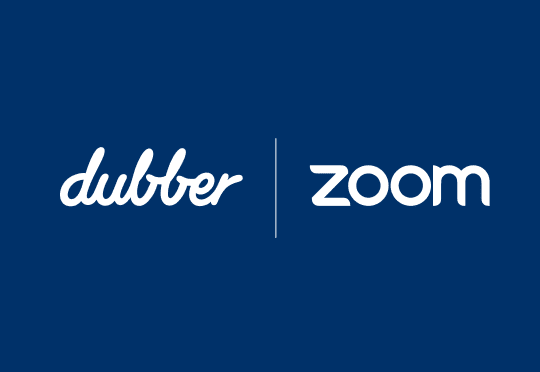
- Dubber delivers recording for Zoom and Zoom Phone
- Helps to enable fulfilment of increasing regulatory requirements in relation to ‘work from home’ and distributed workforces
- Dubber with Zoom allows secure UCR and Voice AI for businesses of all sizes
Melbourne, Australia, and Dallas, Texas – 14 April 2021 — Dubber Corporation Limited (ASX: DUB) (Dubber), today announced that it has extended its Unified Call Recording footprint with the global availability of Dubber with Zoom Video Communications, Inc.’s (NASDAQ: ZM) video-first unified communications platform.
Dubber Unified Call Recording with Zoom provides businesses of all sizes the ability to record calls for all users. Once the recordings are ingested by Dubber, businesses can enrich the content with AI delivering transcriptions, sentiment data, real-time search and more. Dubber’s solution spans service provider networks, Zoom and other communications solutions, enabling Enterprise and Government to centralise all conversation recordings, data and insights in the Dubber Voice Intelligence Cloud.
“Unified Call Recording with Zoom reflects the way employees work today – from anywhere and across many devices and solutions. Dubber has been chosen by over 150 telecommunications carriers and service providers as the recording and data capture platform for their networks. Many have embraced Zoom as an integral part of their business and communications infrastructure. The ability to capture recordings from Zoom and manage them centrally in the Voice Intelligence Cloud demonstrates the true value of Unified Call Recording,” said Steve McGovern, CEO, Dubber.
“Many of our carrier partners are also developing strategies for Zoom Phone, enabling unified management of recordings and voice data across multiple networks and solutions. For Dubber this opens the door to an opportunity to provide enhanced recording and voice analytics to the millions of Zoom Meeting and Zoom Phone users that enable this integration. For Zoom and their customers, Dubber brings a critical capability to answer the demand for compliance recording, AI enhanced insights and policy based management.”
“Helping our customers to get the most value from their voice data is an important objective for Zoom,” said Paul Magnaghi, Global ISV Program Leader. “Dubber works to assist customers in meeting their compliance obligations and gain valuable business intelligence from voice data, especially in this time of remote and hybrid working models.”
Dubber’s cloud-based Unified Call Recording solution integrated with Zoom allows a wide variety of businesses to unlock the value of conversations through voice data.
Dubber with Zoom offers key capabilities valued by enterprises and government clients including:
- Available globally today in the Zoom App Marketplace
- Dubber centralises a user’s Zoom Phone (voice) and Zoom Meeting (video/meeting data) cloud recordings
- When enabled via the Zoom App Marketplace, Dubber ingests a user’s cloud recordings from Zoom, storing them centrally, protecting them for compliance purposes while making audio and voice data available to users and other business applications
- DUB AI users will benefit from AI-powered transcriptions, sentiment, tone, notifications and alerts enriching their Zoom recordings
“We have a rich innovation roadmap for Dubber with Zoom,” said James Slaney, Chief Operating Officer, Dubber. “With Dubber, Zoom users are now able to integrate personal call recording with Unified Call Recording. Critically, every conversation can then be transformed into intelligence to power customer experience, employee engagement and compliance insights.”
Background, Dubber with Zoom:
- Available for order now from Dubber and registered Dubber resellers and partners
- Dubber is live and can be easily activated in the Zoom App Marketplace
- Flexible plans start at $14.95 (USD) per user/month for CALL DUB and $29.95 (USD) per user/month for DUB AI
- Dubber currently supports Voice Unified Call Recording (UCR) for Zoom Meetings and Zoom Phone offerings
- Access Dubber on the Zoom App Marketplace here
About Dubber:
Dubber is unlocking the potential of voice data from any call or conversation. Dubber is the world’s most scalable Unified Call Recording service and Voice Intelligence Cloud adopted as core network infrastructure by multiple global leading telecommunications carriers in North America, Europe and Asia Pacific. Dubber allows service providers to offer call recording for compliance, business intelligence, sentiment analysis, AI and more on any phone. Dubber is a disruptive innovator in the multi-billion dollar call recording industry, its Software as a Service offering removes the need for on-premise hardware, applications or costly and limited storage.
For more information, please contact:
Investors: Simon Hinsley simon.hinsley@dubber.net+61 (0) 401 809 653
UK Media: James Taylor | The PR Networkjames.taylor@thepr.network+44 (0)7796 138291
AU & NZ Media: Terry Alberstein terry@navigatecommunication.com.au+61 (0) 458 484 921
US Media: Charlie Guyer, Guyer Group for Dubbercharlie@guyergroup.com+1.617.599.8830
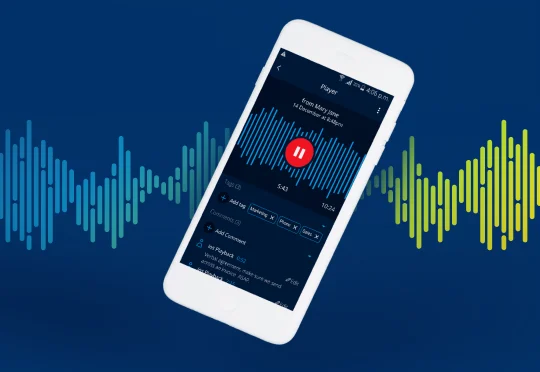
A business needs to listen to and understand two key groups. Sure, customers are vital, they are, after all, where the revenue comes from. But the front-line employees who determine how customers view your business are also important.
You can build loyalty with both groups and get to know them better by listening to what they say. The big question is how do you listen?
Start by putting humans first
Bots and automation have a place, yet for most of your customers, talking to a real person on the phone remains as important as ever. Want proof? More than seven in ten Americans would rather talk to a human than deal a chatbot or other automated process.
Chatbots and FAQs are best when it comes to dealing with minor queries. When a customer faces a bigger problem, they prefer to speak to a human. That means a phone call.
It’s not hard to see why. We know the three pillars of customer service are; a quick resolution, knowledgeable service agents, and a fast response. Customers feel valued when they speak to a knowledgeable agent who can respond in detail and at length. They want someone to listen to them.
The price of not listening can be high: Three out of four stop using an organisation’s services after a poor customer service experience.
So investing in customer service with a human voice makes good business sense.
Know your customer
Listening to customers makes them feel valued. It also gives you an opportunity to learn more about their needs and wants than you could ever get from an automated system.
By getting to know customers better, you can give them what they want. You can tailor your services, make appropriate offers. This pays off with more customer loyalty and that fuels more revenue.
Most businesses still have a long way to go when it comes to understanding customers. Almost a third of customers say they are frustrated that businesses don’t understand them or their needs.
One of the best ways to improve is by learning from mistakes.
Advances in voice AI and sentiment analysis provide the tools needed to filter negative calls to quickly identify customer complaints, or instances where customer service was lacking.
Understanding what your customers don’t like can be just as important as figuring out what they do. Analysing negative calls can identify areas for improvement – whether across products, services or experiences – and create opportunities for wins. Using data-driven decision making, businesses can increase sales, grow loyalty, and even improve their employee experience by reducing the number of negative customer calls they receive.
Do it right, do it once
One top customer frustration is having to repeat themselves when switching between channels or agents.
When a customer has to run through their problem a second time or repeat their personal details they see their call is not being resolved quickly. It also makes it look as if the person taking their call is not knowledgeable. That fails two of the pillars of customer service.
If you can’t provide a smoother, unified experience, your business will fall behind those who do. This is important if you offer omni-channel service. If you can’t offer it across a single service channel, you’re in trouble.
Pull it all together
Creating a unified customer experience needs a central repository of data from all previous conversations. The smartest way to achieve this is by using cloud native unified call recording that integrates voice data with existing business applications. Voice AI can turn those recorded conversations into a transcript.
When you pull data from previous conversations into a CRM system, data that includes a full transcript, your customer service agents can refer back to earlier conversations. This means customers don’t need to repeat themselves.
In the future consumers want more, not less, human interaction. Your business wants better customer interactions. Technology means you can do both at the same time. Better interactions mean you can make better personalised offers. You can adapt future conversations to the customer’s individual style and remember previous conversations so customers are not asked to repeat themselves.
Engage your staff
Your customer service employees define your customers’ relationship with your business. The more engaged they are, the better your business will perform. They’ll collaborate better and have higher productivity. Engaged workers are more likely to stay and less likely to take time off work. They will be enthusiastic about their work and about your business.
Keeping customer service workers engaged means a better customer experience. It also means cost savings: for a 100-employee organization, a 10 percent improvement in employee retention reduces costs by $50,000. If you can cut your staff turnover from 20 percent to 18 percent, that means two fewer employees to hire and onboard.
Staying engaged with remote working
Your customer service employees are more likely to stay engaged if you make their working life as easy as possible. That means giving them all the tools they need to do their job. This is especially true with remote workers who may miss human interaction.
Be wary of app fatigue. Using too many tools can disrupt workflows and drain productivity. Unified communications helps people stay focused. Most workers prefer the idea of having all communications in one place. Many workers believe a unified platform would help them achieve a better workflow, be more productive at work, and help work feel less chaotic.
Giving your workers a single, central repository of customer interactions will give them the insight they need to provide a better service.
Unified Call Recording and Voice AI
Unified call recording and voice AI will help you listen better to the voices that matter for your business. You’ll have a better understanding of your customers and their needs. At the same time, you’ll have valuable insights into keeping your employees engaged and focused.
Voice AI can bring things to your attention and even expose wants or needs that are not directly expressed. It can give you the information you need to deliver a better customer experience. You can reduce negative calls by learning from complaints. AI software can analyse and identify customer sentiment alerting you to problem areas. Positive calls can help you train staff and identify the best performers.
You can integrate AI voice and call recording into unified communications platforms and CRM to capture information at every customer touch point. This has the added benefit of easing app fatigue with your employees.
You can become a better listener by delegating some of the listening to Voice AI
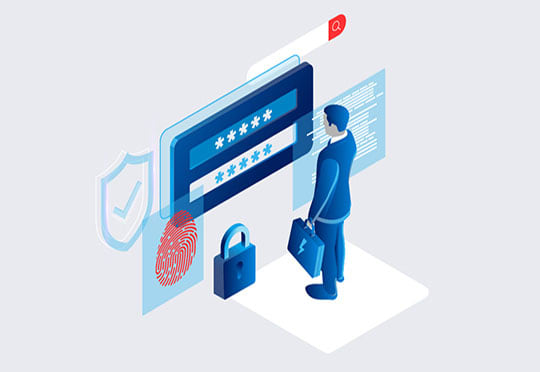
To protect and enable their employees, enterprises need to enable productivity without compromising on security. With centralised security controls, enterprises can grant access to business tools and applications without the headache of different login credentials for each system. In order to reduce IT complexity while retaining full control over employee access, enterprises are working with identity providers for their workforce.
Password fatigue is all too common, with the explosion of workflow applications and software tools that we use each day. It’s no surprise that password fatigue often results in credentials being recycled across multiple platforms and services. In fact, 80% of data breaches are caused by stolen, weak or default passwords. Identity providers not only relieve the burden of password fatigue but also mitigate risk of data breaches.
This is why our latest platform release includes the enablement of identity provider single sign-on (IdP SSO). This new functionality enables businesses to manage access to recordings on the Dubber platform through their existing identity provider (IdP).
IdPs create and maintain identity information for users within an enterprise, enabling them to authenticate access to business applications. When a business deploys an IdP, access to applications can be centrally managed through the IdP rather than requiring a separate authentication process for each application.
Take control of access to recordings
This new feature gives overarching control to enterprises. Just as they do with other applications within their business, systems administrators now have the option to grant their users access to the Dubber platform and customise this access at any time, using their chosen IdP – setting their own authentication requirements, access permissions or restrictions.
Users with correct permissions can use single sign-on (SSO) to access the Dubber platform with their IdP credentials. With access granted through the IdP, any advanced access controls such as multi-factor authentication, password strength, IP block-list or time restrictions will apply to Dubber.
Enable IdP SSO today
New Dubber customers can configure IdP SSO during account creation while existing customers can add this functionality by requesting it through their service provider, account manager, or support contact. Once IdP SSO is enabled, this will be the only authentication process that will allow access to the Dubber platform.
Contact your Dubber account representative or our support team for more information on how you can enable IdP SSO.
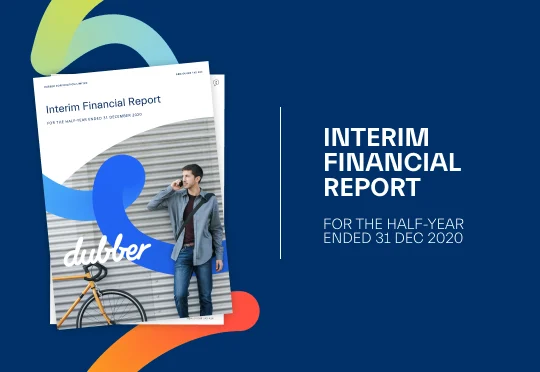
Download the Interim Financial Report for the half-year ended 31 Dec 2020 below.
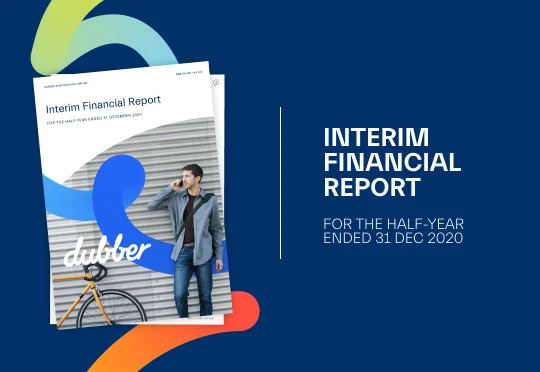
Download the Interim Financial Report for the half-year ended 31 Dec 2020 below

Half Yearly Report and Accounts

Dubber launches compliant Unified Call Recording and Voice AI on 3 AT&T Networks: AT&T IP Toll-Free Network, AT&T Hosted Voice Service and Cisco Webex Calling with AT&T Business in the United States
Melbourne, Australia, and Dallas, Texas – 23 Feb 2021 — Dubber Corporation Limited (ASX: DUB) (Dubber), today announced that AT&T Inc. (NYSE:T) has deployed its leading Unified Call Recording and Voice Intelligence solutions on the AT&T Network through AT&T IP Toll-Free, AT&T Hosted Voice Service (HVS), and Cisco Webex Calling with AT&T.
The collaboration of AT&T Business and Dubber brings the power of Dubber Unified Call Recording and Voice AI to customers already on AT&T IP Toll-Free. AT&T serves more than 3 million businesses globally including many of the Fortune 500 and enterprises across financial services, retail, healthcare, insurance and manufacturing sectors. AT&T IP Toll-Free is a SIP trunking service that delivers inbound toll-free calls to business customer locations over the entire AT&T network.
As a simple and easy to deploy feature upgrade, Dubber Unified Call Recording and Voice AI can be added to existing IP Toll-Free services. Customers can easily connect voice data – including conversational content, sentiment analytics and call meta-data to big data sets, applications such as Salesforce, and more.
“AT&T Business is again bringing industry-leading innovation to customers,” said Steve McGovern, CEO, Dubber. “By eliminating the costs of legacy on-premise and application-specific call recording and then automating compliance, customer experience and call centre activity enterprises can gain an immediate reduction in capital expenditure and drive increased productivity.”
“Voice data is one of the last great untapped resources for companies,” said Rich Shaw, Vice President, Voice & Collaboration, AT&T Business. “By making data and insights from conversations more accessible, we unlock the potential to drive digital and customer experience transformation through voice. With the pandemic and acceleration of remote work, moving to network-centric and unified call recording has never been more important. Together with Dubber, we can help answer these customer needs on a global scale.”
In addition to offering Dubber Unified Call Recording and Voice Data services with AT&T IP Toll-Free, the companies also announced Dubber Unified Call Recording service availability for businesses using Cisco Webex Calling with AT&T, as well as AT&T Hosted Voice Service (HVS) available today for United States customers.
This ASX release has been approved for release to the ASX by Steve McGovern, CEO & Managing Director.
About AT&T Communications:
We help family, friends and neighbors connect in meaningful ways every day. From the first phone call 140+ years ago to mobile video streaming, we @ATT innovate to improve lives. AT&T Communications is part of AT&T Inc. (NYSE:T). For more information, please visit us at att.com.
About Dubber:
Dubber is unlocking the potential of voice data from any call or conversation. Dubber is the world’s most scalable Unified Call Recording service and Voice Intelligence Cloud adopted as core network infrastructure by multiple global leading telecommunications carriers in North America, Europe and Asia Pacific. Dubber allows service providers to offer call recording for compliance, business intelligence, sentiment analysis, AI and more on any phone. Dubber is a disruptive innovator in the multi-billion dollar call recording industry, its Software as a Service offering removes the need for on-premise hardware, applications or costly and limited storage.
For more information, please contact:
Investors: Simon Hinsleysimon.hinsley@dubber.net+61 (0) 401 809 653
AU & NZ Media: Terry Albersteinterry@navigatecommunication.com.au+61 (0) 458 484 921
UK Media: James Taylor | The PR Network+44 (0)7796 138291james.taylor@thepr.network
US Media: Charlie Guyer, Guyer Group for Dubber+1.617.599.8830charlie@guyergroup.com

Today we announced another major deployment of Dubber – this time at the heart of one of the world’s largest networks – AT&T.
Dubber will be launching compliant Unified Call Recording and Voice AI on 3 AT&T Networks: AT&T IP Toll-Free Network, AT&T Hosted Voice Service and Cisco Webex Calling with AT&T Business in the United States. What makes AT&T so special is that they are the first of the major service providers to deliver on the promise of Dubber Unified Call Recording.
It’s an unequivocal validation of our strategy to enable conversations to be captured across multiple end-points and unified in the Dubber Voice Intelligence cloud.
This reflects how modern businesses operate. We jump from calls on Microsoft Teams and Cisco Webex to responding to customers on mobile devices and taking calls in service centres. What is crucial – for compliance, productivity, and visibility – is that all those calls can be integrated into one place and used to enrich systems of record like Salesforce.
That’s how, with AT&T, we can end not knowing for any business of any size. And that’s equally true for state and local government and education.
A Unified Approach.
Dubber is the only Unified Call recording and Voice AI solution running across multiple AT&T Voice business services – creating one place for all voice, video and text data to be harvested and leveraged instantly.
- AT&T IP Toll-Free
- AT&T Hosted Voice Services
- Cisco Webex Calling with AT&T
Native + Cloud = Advantage
Business, state and local government have been trapped for years on legacy call recording solutions often requiring hardware, storage (that increases in costs the more you record) and only connected to specific applications.
Together with AT&T, we will enable customers to capture conversations from any eligible end-point – a simple feature add-on, and then AI-enrich and store their voice data in one place. They’ll be able to access all this safely and securely, meeting critical compliance and regulatory mandates.
Data is immediately available to analyze and to pull key insights from. Key insights that make material improvements to business operations, customer experience, and compliance mandates, all of which takes place in a vastly more dispersed work environment than ever before.
As a simple and easy to deploy feature upgrade, Dubber Unified Call Recording and Voice AI can be added to any of the listed AT&T services. Customers can easily connect voice data – including conversational content, sentiment analytics and call meta-data to big data sets, applications such as Salesforce, and more.
Central to the Dubber on AT&T offering is compliance. Not just that experienced by Financial Services enterprise and others in regulated industries, but also regulations such as PCI and HIPPA. Answering the broad range of compliance mandates faced by a business means Dubber on AT&T addresses every element of compliance – from how calls are recorded to what data is retained to how data is stored.

The unprecedented events of 2020 drove adoption of Microsoft Teams globally as businesses were forced to adapt rapidly to continue their operations with a dispersed workforce. Ensuring continuing compliance with industry regulations has been a challenge for enterprises using Microsoft Teams, until now.
The Importance of a Certified Compliance Call Recording for Microsoft Teams
An automated, policy-based recording solution certified by Microsoft that seamlessly integrates with Microsoft Teams is a critical piece of communication infrastructure. It is also essential for ensuring Microsoft Teams communications compliance.
Dubber is among the first Call Recording solutions to achieve compliance call recording certification for Microsoft Teams. And from what we can tell, the only certified call recording solution capable of delivering Unified Call Recording.
What makes Compliance Unified Call Recording different?
Legacy call recording solutions capture call recordings from a small range of end-points; they are often specific to an application; and typically require hardware, software and professional services. Dubber is truly network native and cloud based. This means compliance call recording is provisioned with a click, any number of endpoints can be captured, and any recordings can be stored in the infinitely scalable Voice Intelligence Cloud.
Just like Dubber is native to Microsoft Teams, it will work as well for mobile, desk-phones and more. And it’s open API and out-of-the-box integrations with popular software like Salesforce mean you’re not tied to seeing your voice data, beautiful transcriptions and AI-enriched insights in Dubber.
Enabling Continuous Compliance for Microsoft Teams Customers
Businesses in regulated industries such as banking, government, insurance and financial services sectors can now meet their legal and regulatory obligations for Microsoft Teams users in call centre, branch, and work-from-home environments simply, easily, and with confidence.
By recording calls with Dubber, financial services firms can use Microsoft Teams with confidence knowing that they can automatically record, store and encrypt all call data as required by HIPAA, GDPR, PCI DSS, KYC, Dodd-Frank, MiFID II, and more.
Dubber’s cloud based compliance call recording solution frees financial institutions from the restrictions of application-specific and infrastructure-based call recording normally confined to call center environments. Dubber offers a cloud-native solution that records directly from the network to complement remote working.
Discover the gold standard in compliance call recording for Microsoft Teams today.
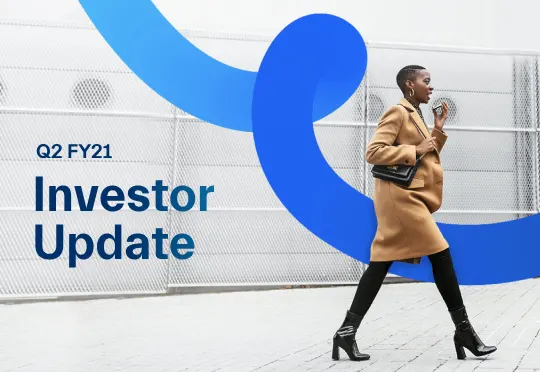
Download the Q2 FY21 Investor Update below.
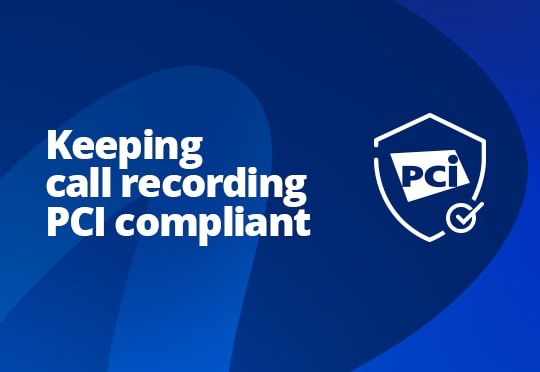
Not all information is equal. Some can be stored and used. Other information can’t.
The question is how to separate what can and can’t be recorded and stored when your aim is to capture crucial conversations while also ensuring PCI DSS compliance.
Fortunately there are solutions, but not all are created equal.
The dangers of redaction
There is an old saying: prevention is better than cure. As far as PCI solutions for call recording go, there are preventative measures and there are cures. PCI redaction solutions are cures. Customers give all of their payment information to contact centre agents while the call is being recorded. Not only is the information taken by the agent, but it’s now been processed and recorded. Redaction solutions rely on AI to detect the correct information to delete and no solution is 100% effective.
PCI compliant call recording options
Now for the preventative measures: pause and resume and payment gateways. These solutions stop identifiable information from ever being recorded, so there’s no need for an AI bot to go through recordings and transcripts with a black pen.
PCI compliant payment gateways
Payment gateways are the ultimate gold standard in PCI compliance solutions. Not even the contact centre agent has any knowledge of the customer’s details as these are entered by the customer through their keypad. Any dual-tone multi-frequency (DTMF) tones are masked and the agent sees asterisks appear on their screen instead of characters.
Pause and resume for PCI compliance
Payment gateways aren’t for everybody. Depending on the PCI requirements of your business and your budget, a pause and resume solution may be more suitable. Choose from manual or automatic options, depending on your needs.
Manual solutions put the pause and resume of recording in the hands of contact centre agents – allowing them to stop recordings when sensitive information is about to be shared. Of course, this method opens up the potential for human error.
PCI DSS guidelines recommend that merchants using this method check their recordings weekly for identifiable information.
Automatic pause and resume is triggered by window or URL changes, or through custom triggers using an API. Desktop clients don’t require any custom developments and can be easily integrated, while API solutions are more robust, with a lower risk of end-user interference.
Chat to a Dubber compliance expert today to understand how to address PCI compliance when recording calls and storing conversational data.
92% of all customer interactions are voice. More than ever with dispersed work environments, those calls and conversations are happening in new locations, and across multiple networks, collaboration platforms and devices. These are the most important conversations happening in a business and when they end critical data, content and value is lost forever.
Dubber automates the process of creating a system of record that shows not only exactly what was said but the sentiment it was conveyed with. Unified Call Recording enables businesses to securely and compliantly capture all their voice data. Voice AI is a powerful tool that enables users to convert conversations into strategic business insights and decisions and empowers businesses to automate high-value process workflows.
ROI can be measured across a range of areas including:
- Cost reduction of legacy call recording solutions – Eliminate storage and professional service costs with cloud based call recording.
- Reduction in compliance costs and mitigation of risks – Utilise holistic compliance management to cost effectively meet regulatory requirements and avoid costly fines.
- Call centre efficiency– Optimise the time, workflows and productivity of call centre staff.
- Automate customer satisfaction reporting and improve CX – Reduce customer satisfaction survey costs and automate reporting and workflows.
- Automate sales & service admin for productivity gains – Remove manual data entry of call data and time spent on administrative tasks.
- Time to remediation of investigations – Quickly and easily manage customer investigations with access to all customer conversations in real-time.
For more information on how your business can benefit from Unified Call Recording take a read of the the whitepaper ‘End not knowing: six strategic and economic benefits of Unified Call Recording and Voice AI’
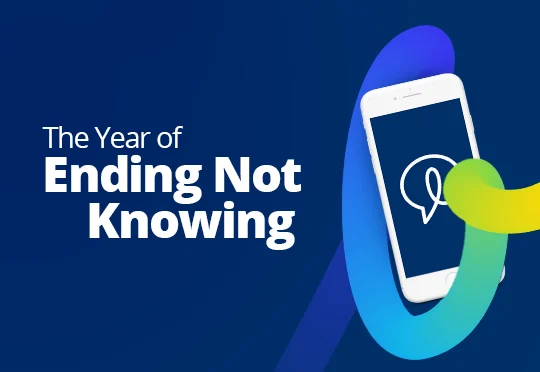
2020 was certainly different. And 2021 will be different again.
While 2021 will see the continuing acceleration of the dominant trends of 2020, it will be a different year again as enterprises and governments shift from a scramble to adapt to a new normal, to reshaping their futures based on new conditions.
Plato was right: necessity is indeed the mother of invention. During the COVID-19 crisis, one area that has seen tremendous growth is digitization, meaning everything from online customer service to remote working to supply-chain reinvention to the use of artificial intelligence (AI) and machine learning to improve operations. Healthcare, too, has changed substantially, with telehealth and biopharma coming into their own. – McKinsey
Here are our views on what these new conditions mean for governments and enterprises in the context of Voice Data as a Service and Unified Call Recording.
1. Endpoints have been dispersed, for good
The overnight shift to remote work meant the scattering of communication endpoints from one centralised location to home offices and makeshift desks all over the world. This opened the door to mobile and Internet Protocol (IP)-based communication becoming the main channel for business conversations.
Enterprise adoption of Unified Communications solutions as the dominant communication tool will accelerate in 2021 – driving the need to answer broader enterprise needs for compliant conversations on these platforms.
“As organisations raced to deploy communications platforms such as Zoom, Microsoft Teams and Cisco Webex, they faced new pressures to ensure that communications across these channels were in compliance with industry regulations. This has shifted the requirement for call recording from being application-specific to the need for Unified Call Recording – due to the need to capture every endpoint.” – James Slaney, COO
2. Compliance optimisation
The pressure to maintain compliance with industry regulations isn’t going anywhere, in fact it accelerated this past year.
Compliance has remained a primary driver for call recording, however, we have seen a new emphasis on utilising the data to understand the customer and ensure employee wellbeing as part of a more proactive approach to compliance and business continuity.
2020 saw voice data emerge as a principal driver of optimising compliance programs to deliver a real-time view and reduce costs and complexity. This too will accelerate in 2021 as business leaders look to seamlessly integrate voice data with big data sets, applications such as Salesforce and more.
“Employers are feeling the distance between themselves and their employees and are keen to know more about the wellbeing of their staff, as well as wanting to be on the front foot when it comes to reducing risk and complying with industry regulations. This has led to organisations looking for ways to rapidly undertake audits – making keyword search and custom alerts more important than ever and relegating old world systems that don’t enable real-time search to the back seat.” – Russell Evans, CRO
3. The paradox of contactless customer experience
Satisfying customers through digital and contactless experiences means getting closer to customers, even while they are further away.
The lack of customer intimacy implicit in digital channels created more demand for voice communications. Leading organisations increased efforts to listen harder and automate customer experience (CX) reporting. Traditional approaches to net promoter scores that delivered CX insights quarterly or annually have begun to be replaced by AI-enriched voice and digital data that provides real-time insights. Analysing customer experience and employee experience identifies the true drivers of engagement and loyalty.
“Ending not knowing what was said, what the customer or employee experience was, or how the organisation is performing from a CX and EX standpoint is more important today than ever. 2021 will see traditional methods -– which present data months after it happened or worse, are based on hearsay – with real-time voice data analytics derived from Unified Call Recording. Enterprises will rapidly shift from time-lapsed CX to continuous CX, and reap significant cost savings as they do it.” – Andy Lark, CMO
4. Closing the business continuity chasm
2020 made the term “unprecedented events” seem like the understatement of the century. Business continuity planning was upended by the coronavirus pandemic. Organisations were forced to reassess their approach to every aspect of their operations and communications: from call centres to supply chains.
Business applications easily managed in data centres and wired to end-points had to be rapidly reassessed as workers dispersed, and legacy call centre approaches rethought. Cloud and network-centric approaches will accelerate in 2021 as enterprises look to reduce costs and fully virtualise approaches to voice interactions.
“We saw a shift in enterprise focus towards building out more UCaaS capability, which drove interest in the potential of voice communications as a valuable source of data. There was a growing desire to understand conversational data and turn it into actionable insights through the use of AI. Businesses began to understand that voice data can be used to improve operational performance, especially with the increase of digital and distanced transactions.” – James Slaney, COO
5. Mobile as the primary communication channel
The rise of mobile communications skyrocketed throughout 2020. Without an office and the accompanying communications systems, employees resorted to using their mobile as their primary communication channel. With the rise of 5G this adoption of mobile devices will only continue to increase.
While some regulators hit pause on compliance mandates for employees working from home, most – including the FCA in the UK – now require compliant call recording of conversations between bankers and customers.
This leaves businesses reevaluating their communications solutions and their compliance requirements. In order to ensure compliant and critical record keeping, businesses need to be able to capture calls directly from the network.
“Where call recording was once confined to the domain of the call centre, enterprises raced to understand how to capture conversations from mobile devices across wireless and IP connections. Unified Call Recording and Voice Data as a Service became a priority as organisations looked to capture calls from anywhere, enrich voice data with AI, and aggregate that data for broader enterprise use.” – Russell Evans, CRO
6. Work changed forever
Vaccine rollouts bring promise of a return to old freedoms, but in the meantime, communication and collaboration is likely to remain virtual. A Gartner survey of company leaders found that 82% plan to allow employees to work remotely at least part of the time after the pandemic, and 47% will allow employees to work from home full-time.
“The move to remote work has continued the shift to the cloud, with businesses moving away from application-specific and infrastructure-based call recording solutions. Organisations are demanding cloud-based and network-based offerings to complement the new way of working, and a landscape of business that looks like it has been permanently altered.” – Andy Lark, CMO
7. AI pixie dust is everywhere
Any tech solution offered in 2020 had AI attached to it in some form. It was also the year in which organisations saw through the hype and started to look to the real power of AI to automate workflows, enrich data and generate insights.
The application of AI to create intelligence and actions from conversational data will accelerate in 2021. At the most basic level we will see improvements in the ability to accurately transcribe voice data. At the same time advances in conversational outcome predictions will provide enterprises with the ability to significantly improve customer and employee experience.
“Anyone will have seen that in recent years vendors have begun sprinkling AI into every conversation, but what remains is the gap between the technology and understanding of where AI fits and how it can benefit businesses. Poorly managed voice data and AI only adds to the ‘info-besity’ many enterprises experience, further limiting their ability to get clarity from large data sets. Voice AI is more than just transcription, and decision-makers need to be sure they are getting the right data and insights to optimise their organisation.” – Russell Evans, CRO
8. The rise of voice data in the cloud
If data is the new oil, 2020 made it clear that voice data is the largest untapped source of rich insights available. Once isolated to individual applications and business functions, 2021 will see voice data break free of silos and discrete endpoints to become unified in the cloud.
We are seeing an increase in demand for data, as businesses are using this information to fuel continuous intelligence that can inform their everyday business decisions and actions. Gut feelings are no longer enough – the growing complexity of the world requires data-driven organisations.
“While Voice Data as a Service across mobile, UC, and SIP connections is a critical differentiator for service providers, the broader opportunity is in unifying that data in the Voice Intelligence Cloud and letting AI enrich it. This enables enterprises to turn compliant call recording into continuous compliance monitoring.” – James Slaney, COO
Here’s to ending not knowing in 2021!
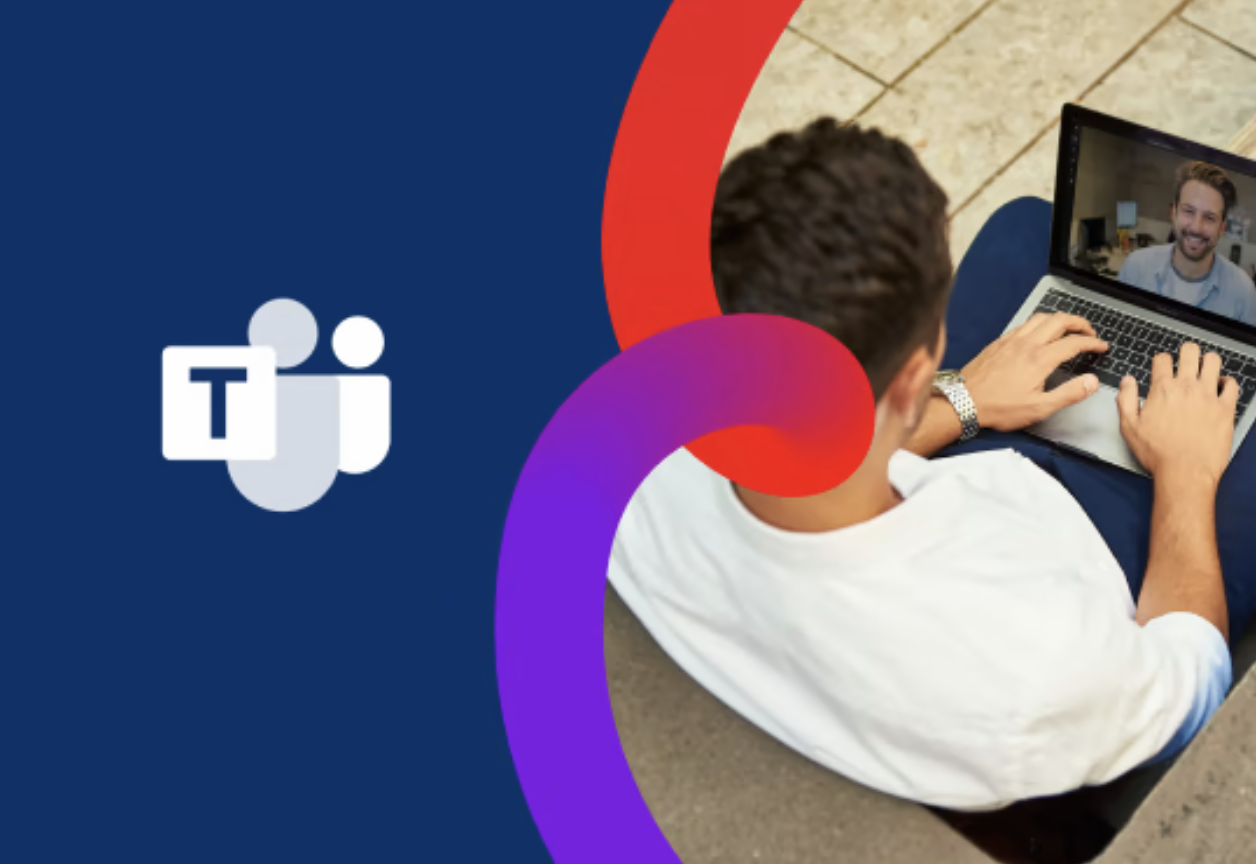
PRESS RELEASE
Dubber achieves compliance call recording certification for Microsoft Teams
Rigorous, in-depth third-party certification process ensures user experience meets all Microsoft-defined quality and security parameters
Melbourne, Australia, and Dallas, Texas, 2 February 2020 — Dubber today announced that it is among the first Unified Cloud Call Recording solutions to achieve compliance call recording certification for Microsoft Teams. To be certified under the Microsoft program, companies are required to submit their solutions for rigorous third-party approved testing for quality assurance, performance within the Microsoft Azure environment, interoperability and compatibility with the Teams user experience, security and compliance, marketing and customer support.
Achieving Teams Certification for the Dubber Unified Call Recording (UCR) solution means service provider partners, channel partners and enterprises are ensured of a trusted solution that has met the highest levels of testing for the Teams platform. Spanning several months of rigorous testing, Dubber’s solution met and, in many instances, exceeded the parameters of the certification process for voice, video, and screen share. As a part of the certification process, Dubber will also be included in the Microsoft AppSource Marketplace for compliance.
“Achieving Microsoft Teams Certification for Compliance is a significant first for Dubber and our partners. Successfully completing this rigorous level of testing, our service provider partners and enterprise users can be confident the Dubber platform will meet their requirements for security and compliance call recording on the Teams environment. The Teams compliance certification is especially significant for our customers in the banking, government, insurance, and financial services environments who are often under legal mandates to record and store call recordings. With Dubber, they can eliminate costly on premises and cap-ex intensive solutions and meet their obligations for Teams users in call center, branch and work-from-home environments simply, easily and with confidence,” said Adrian Di Pietrantonio, EVP, Global Platforms & Partnerships, Dubber.
Mike Ammerlaan, Director, Microsoft 365 Ecosystem at Microsoft Corp. said, “Our partners are an essential part of meeting our customers’ communication and collaboration needs with Microsoft Teams. We are pleased to have Dubber successfully complete the Teams compliance recording certification process. This can help their customers– especially in the financial services sector –stay compliant and meet their call recording obligations for calls placed in Teams.”
Background:
- As a part of the certification process, Dubber is listed in the AppSource Marketplace here: https://appsource.microsoft.com/en-us/product/web-apps/dubbercorp1603082091027.dubber01?src=wnblogjan2018&tab=Overview
About Dubber:
Dubber is unlocking the potential of voice data from any call or conversation. Dubber is the world’s most scalable Unified Call Recording service and Voice Intelligence Cloud adopted as core network infrastructure by multiple global leading telecommunications carriers in North America, Europe and Asia Pacific. Dubber allows service providers to offer call recording for compliance, business intelligence, sentiment analysis, productivity and more from any endpoint. Dubber is a disruptive innovator in the multi-billion-dollar call recording industry, its Software as a Service offering removes the need for on premise hardware, ties to specific applications or costly and limited storage.
For more information, please contact:
Investors
Simon Hinsley simon.hinsley@dubber.net +61 (0) 401 809 653
Media
Terry Albersteinterry@navigatecommunication.com.au+61 (0) 458 484 921
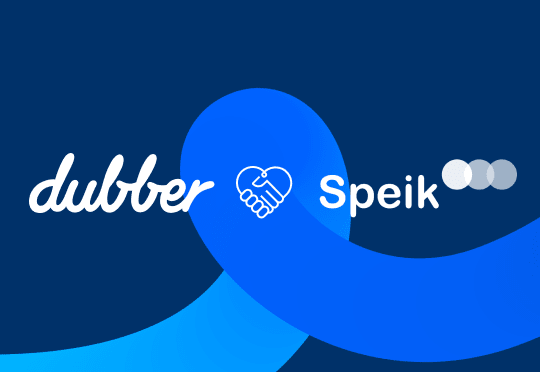
Today we welcome Speik to the Dubber family.
Growth through Dubber’s continuing global execution – and by adding service provider footprint and capability through acquisitions – is core to our strategy. The aim is simple – grow faster and deliver more services to more service and solution providers, Enterprises, SMEs and Governments than ever before.
Matthew Townend, Executive Director, Cavell said it well:
“Service and Solution Providers are in a race to achieve differentiation and answer the accelerating compliance, security and productivity demands of Enterprise. Dubber with Speik creates an industry-leading offering for service and solution providers and deep capability in addressing compliance and call recording needs within SME’s and Enterprises.”
Demand for Unified Call Recording continues to accelerate driven by compliance, dispersed workforces driving demand for IP-based and mobile conversations, and the need to capture crucial conversations for business continuity, operational and team productivity.
To meet this need, we’re continuing to move quickly. Unlike others who have concentrated on doing this within specific applications or use cases, Speik aligns with our approach of capturing billions of conversations as they take place in the service provider network and major communications solutions – like Cisco Webex and Microsoft teams.
By doing so, we enable Enterprises and Government users to capture calls from any endpoint while eliminating their need for costly hardware, professional services and ever-escalating costs as data grows.
And critically, we can fully answer the need of the modern Service Provider working across SIP, Mobile and UC end-points – enabling them to deliver a complete and differentiated solution to customers.
Why Speik?
Speik is a leading provider of call recording solutions to UK service providers – in particular, O2’s mobile network – and has strong solutions capabilities for addressing PCI and other compliance mandates.Sergio Budkin, Director of Business Products and Propositions, Telefonica UK Ltd (O2);
“Together with Speik, O2 has been providing the mobile recording service in the UK, enabling compliance, improved customer experience and productivity gains for Enterprises and Government. We welcome the opportunity to expand those services via Dubber’s industry-leading offering across multiple sectors and delivery platforms.”
Our combined capabilities will accelerate Dubber’s industry-leading growth and address the significant opportunity for compliant Unified Call Recording. The acquisition immediately grows Dubber’s market-leading position in EMEA and contributes positively to Dubber’s annual recurring revenue (ARR) momentum.
And Speik are profitable – which adds to our bottom-line and gives us confidence that as we invest in growing Speik through sales and marketing, it benefits our customers and shareholders.
Steve McGovern, CEO, Dubber on the Speik acquisition:
“Dubber’s acquisition of Speik is fundamentally accretive on all levels. Speik brings to Dubber a strong footprint in the leading UK-based mobile network provider, world-class technology resources, and a growing base of subscribers.
“The team at Speik has been a pioneer in terms of network-based mobile recording together with O2. Their success with one recording partner over 7 years provides an insight into Dubber’s ambitions for its own 130plus service provider partners, globally.
“The Dubber product suite has a capability to expand Speik’s revenue opportunities with O2 – and other service providers – from its current enterprise focus into the larger addressable markets of mobile SME and across UC and Microsoft Teams services with Unified Call Recording.
We believe that Dubber can substantially accelerate growth and adoption in that and other key UK-based relationships — and use Speik’s PCI services to drive additional revenues into our service provider partners. We welcome the Speik team to our growing Dubber family and look forward to serving our mutual customers like never before.”
Dubber’s scale and industry-leading Unified Call Recording technologies will enable to Speik to grow across the UK and EMEA. We’ll also be bringing Speik capabilities to service providers globally.
A Unified Approach to UCR
Speik and Dubber have a common network-centric and Cloud-first technology approach enabling us to accelerate the evolution of Unified Call Recording and Dubber Voice Intelligence Cloud.
Simply put, that means any conversation from any endpoint captured – and from any call recording solution – in the Dubber Voice Intelligence Cloud. There it can be shared with applications like Salesforce, big data sets and data visualisation and analytics platforms like Tableau and Google Data Studio.
2021 will see more Enterprises and Governments moving to realise the potential of voice data — together with Speik we are best positioned to help Service Providers meet that opportunity.

New agreement expands reach of Dubber’s Unified Call Recording & Voice Intelligence Cloud with IBM & Ingram Micro Advances Dubber vision for ‘AI on every Phone’
Sydney, Australia, 7 December 2020: A leading global provider of cloud-based call recording and voice AI, Dubber (ASX:DUB), is the latest Australian company to sign up to utilise IBM hybrid cloud technologies as part of their product offerings. The new three year agreement will see Dubber expand its industry-leading Unified Call Recording and Voice Intelligence Cloud services to include IBM Hybrid Cloud and advanced security through IBM Hyper Protect.
Dubber has been working with IBM over the past 18 months to develop a cloud-based solution which uses IBM Watson Speech to Text to transform call recordings into actionable data that can be tagged, recalled, analysed, searched and saved as text to store all telephone interactions in the cloud. The solution will be available via Dubber’s existing solution providers and partners.
Dubber CEO, Steve McGovern, said, “Continuing to expand our successful partnership with IBM to include IBM Hybrid Cloud and Ingram Micro distribution will further accelerate our vision of putting AI in every network and on every phone. The security and scale at which we can achieve Unified Call Recording will enable networks to make the crucial shift from connections to delivering value from the content on the network like never before.”
“Together we are transforming the economics of capturing conversations – using the Cloud, AI and infinite scale – for service providers in a way that will ultimately enable it to be offered as an ubiquitous service,” added McGovern.
“Hybrid cloud is swiftly becoming the dominant force driving change in businesses. As companies work to modernize workloads and build new business applications on the cloud without jeopardising security and control, they are turning to IBM Cloud,” said IBM Head of Cloud for ANZ, Anthone Withers.
“As part of this agreement, we are also helping Dubber expand their business globally as an independent software vendor (ISV) through Ingram Micro so they can continue to grow, and expand their network.”
IBM’s hybrid cloud approach is built on a foundation of open source software, security leadership, and enterprise-grade infrastructure. Data protection and security services have been embedded into IBM’s hybrid cloud architecture to protect a client’s processes, applications and cloud services, while managing compliance requirements. For example, IBM Cloud Hyper Protect Crypto Services will provide Dubber’s customers with a heightened level of security as they control their cloud data encryption keys – ensuring that only the client has control over their crypto keys – and that not even IBM can access.
Additionally, earlier this month, Dubber announced its inclusion in the 35+ member strong partner ecosystem for IBM Cloud for Telecommunications: an open, hybrid cloud architecture designed to help telecommunications providers address the specific challenges of the highly-regulated industry: accelerating business transformation, enhancing digital client engagement and improving agility as they modernize their enterprise applications and infrastructure to unlock the power of 5G and edge.
As part of its work with the ecosystem, Dubber’s Voice Intelligence Cloud will integrate and be interoperable with IBM Cloud for Telecommunications, to help enable providers to deliver next generation Unified Call Recording and Voice AI Services on one cloud platform.
For more information about IBM visit www.ibm.com.au

Dubber Acquires Leading UK Mobile Recording Company Speik

2021 will be different
2020 was anything but the year any of us expected. Predictions made in January seemed to have little relevance by March and vapourised by July.
So where should Service Providers, UC solutions and their Resellers focus to maximise revenue and opportunities in 2021?
While some geographies, notably Australia and New Zealand are returning to a degree of certainty, for many others, uncertainty remains the norm. What is clear are the growth opportunities that have accelerated in response to new customer and business needs.
- Dispersed workforces + Proliferation of end-points = Shift from connections to mining the value in conversations and content
Workforces will continue to disperse, increasing the demand for unified communications and security solutions that enable Government and business to work across many endpoints. Remote work practices will continue to reshape work itself, accelerating adoption of Cloud solutions. And 5g will only add fuel to the fire.
Action: Service and Solution providers – and their partners – are seeing continued strong demand for UCS and UCaaS platforms. And targeting those opportunities is the first step to underpinning growth. The second step is to develop solutions that answer broader needs for compliance, security and productivity.
Unified Call Recording is central to developing these solutions – moving Resellers from simply selling connections to delivering value from multiple and dispersed end-points in the Cloud. That value ultimately will come from ending not knowing and providing insights into every customer and employee interaction.
- Big Data + Voice Data = Bigger Big Data that’s compliant
Voice interactions with customers and between employees either rank first or second as a form of communication. And yet they account for a fraction of the Big Data pool accessible by most businesses. The moment the conversation ends, the value within the content is lost.
2021 will see a rapid shift to capturing voice data – driven by the new economics of Unified Call Recording and the Voice Intelligence Cloud aggregating conversations as data from any end-point.
Action: To take advantage of this rapidly emerging multi-billion dollar market opportunity for Voice data as a Service (VdaaS), Service and Solution providers – and their partners – need to present UCR as an integral part of the UCS sale and a key ingredient for compliance, business continuity and improving customer experience.
Default call recording solutions associated with many VOIP products typically don’t meet Enterprise-grade data and security policies or satisfy regulatory requirements. Many only store recordings for a limited time, offer poor transcription, and do not offer any form of speech analytics or voice data AI. Dubber Unified Call Recording and voice data intelligence is compatible with most VOIP products, and can be added without the need for any further hardware.
- Ecommerce Acceleration = Need for continuous intelligence
Ecommerce growth rates are now in high double digits with nearly every business under pressure to accelerate digital transformation with the aim of improving customer experience. But to improve customer experience, businesses need to shift to continuous customer intelligence.
Action: Service and Solution providers – and their partners – integrating Unified Call Recording and Voice Intelligence into their UC offerings are able to differentiate, offering businesses the pathway to continuous intelligence from every customer conversation. Rather than reporting on NPS or customer satisfaction at the end of a quarter, customer experience – along with sales, marketing and agent performance can be made available in real time. And through open APIs, that data can be used to fuel dashboards, via applications such as Salesforce.
- AI + Voice Data = Better Decisions
By 2030, AI products will contribute more than $15.7 trillion to the global economy. The use of AI to analyse and predict human behaviour will become standard practice for businesses looking for trends across their business in customer experience and behaviour, churn reduction, cross-selling and marketing.
Up to 90% of a company’s data is defined as unstructured. Traditionally this type of data, particularly phone calls, has been difficult to capture and analyse. Dubber AI solves this by providing the ability to analyse voice data for sentiment analysis, keyword identification, and transcription – enabling companies to draw on this data to drive strategy and decision making.
Action: Shift to presenting AI-first solutions that automate the delivery of continuous intelligence from conversations. Critical use cases such as compliance and creating records of crucial conversations are an imperative for every regulated business. But the benefits don’t stop there.
By looking for AI beyond the conversion of voice to data, solution providers can show how that same data can be used to provide a productivity edge and improve data overall.
That same data is as valuable internally as it is externally to measure employee performance and sentiment across the distance of remote working. Businesses can also make use of voice data to provide transcripts of meetings to teams, saving on note taking, and creating further efficiencies.
- Distance + Increasing Regulatory Scrutiny = Compliance Complexity
Demands by Regulators to Know your Customer (KYC) and a shifting data and privacy landscape is creating a growing demand for complete solutions to answer needs for rapid investigations, continuous compliance reporting and voice data management.
The UK’s exit from the EU will mean that the GDPR will have major implications for European businesses who process or store data in the UK. Businesses who operate within the European Economic Area (EEA) and record their phone calls must check that their protection of voice data is sufficient for a post-Brexit world.
Action: With the increase in UC communications, and the resulting level of data being stored in the cloud, Resellers will need to understand the data laws impacting the collection and storage of conversational data. And solutions that lower the cost and burden of compliance reporting through real-time search, alerts and notifications are vital.
If 2020 wasn’t what we were expecting, 2021 is shaping-up to deliver as many surprises. Service and Solution Providers, and their partners, can ready themselves to turn change and uncertainty into opportunity by focusing on the shifts and creating the solutions to answer the needs they surface.
Voice data is central to creating these solutions as businesses increasingly turn to it to drive their decision making, predict customer behaviours and guide business direction.
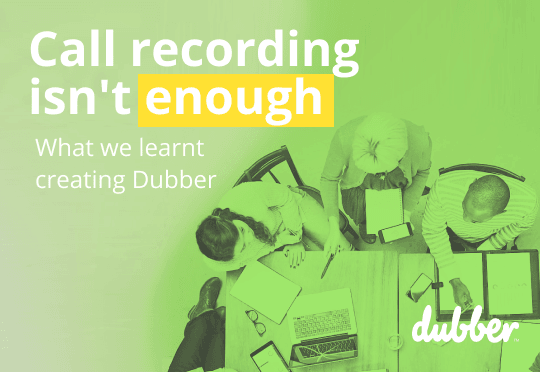
The twenty features you need to ensure your call recording solution meets your compliance needs.
1.Are your recordings clear and accurate?
Recording for compliance is all about accurate record keeping. If all you’re recording is background noise, or broken speech from a poor connection, you’re not really fulfilling your compliance requirements. Your call recording solution should record directly from the network to make sure that every word is crystal clear, no matter the quality of the call.
2.Is your storage secure enough?
When it comes to compliance, particularly in the financial services industry, you’ve got to be in it for the long-haul. Regulations such as MiFID II can require companies to store their recorded conversations for up to 7 years, or even longer. Your call recording solution must have the storage capacity to securely store recorded calls long-term. Cloud storage has a significant advantage over on-premise storage here, as there are no worries about ever running out of space.
3.Can your call recording solution scale to meet demand?
Speaking of storage and capacity…to make sure you capture every single conversation, your call recording solution will need to be scalable enough to cope with multiple concurrent recordings. If you’re running a huge global organisation, there could be hundred or even thousands of conversations happening at once. You need to ensure that all of these calls are recorded.
4.Are your recordings encrypted?
Captured calls need to be protected. With conversations containing highly sensitive personal data, these recordings must be encrypted. And we don’t just mean in storage. Data should be encrypted in transit with transport layer security, as well as at rest. AES-256 is one of the strongest block ciphers available – we encrypt every protected object with a unique encryption key. The object key itself is then encrypted with a regularly rotated master key, for that extra layer of protection.
5.Are you able to record every single call?
We’ve never navigated as many communication channels as we do today. Whether taking client calls on your mobile while we work from home, or chatting with colleagues over Microsoft Teams, for regulatory compliance you need a Unified Call Recording solution that can capture calls across every device and channel.
6.Is your data protected by geographic redundancy?
To really ensure stored data is fully protected, there should be redundancy measures in place to mitigate risk. On-premise solutions can’t compete with the ability of cloud platforms to deploy across multiple data centres within a geographic region. Platform loads can be spread across data centres to provide full redundancy across all elements, including storage.
7.Is your solution available, even in unprecedented events?
Another area that cloud solutions excel in is availability. The various elements of cloud platforms can be decoupled and run as separate services, while processing can be swapped to different servers without downtime. Cloud platforms deploy load balancers to manage traffic and scale processes. Data centre connectivity can be managed and, in the event of catastrophic failure, moved accordingly across the platform architecture.
8.Is all of your data held in one place?
Having data stored in multiple locations is a compliance nightmare. In order to reduce the complexity of compliance, all of your organisation’s recorded conversations should be stored in one unified repository.
9.Do you have a retention policy in place?
Deleting data once it’s no longer required is as equally important as storing it securely in the first place. Particularly when it comes to compliance with regulations like the GDPR, it’s vital that organisations erase data when they no longer have a legitimate purpose to store it. Your call recording for compliance solution should include the option to set retention periods for recordings so they are automatically deleted after a specified period.
10.Are you prepared for a legal hold request?
Legal hold requests can happen at any time. These events mandate the preservation of information, including recorded calls, and can cause hassle for businesses if their data isn’t stored in a unified repository. To cover legal hold requests, your call recording solution needs to have a feature to preserve recorded calls no matter what. This should override standard retention periods, the deletion of a user or the expiration of overall storage periods.
11.Who can access recordings?
Access to recorded calls should be restricted to appropriate users for data protection, so your call recording solution should enable strict and secure permissions and team structures. Make sure you can group users into teams and control who can listen to recordings within a team. As standard, users should only be able to listen to their own recordings and users outside a team shouldn’t be able to access recordings.
12.How is access to recordings authenticated?
To ensure data is transmitted securely, access to recorded calls should be monitored and your call recording solution should employ stringent password policies and granular permissions that control user access to system features, functionality, and recorded data. For extra security, access to content should be via tokenised sessions.
13.Can you instantly retrieve recordings?
Often regulatory compliance requires instant access to data in order to comply with audits or other requests for information. All recorded calls should be instantly available to prepare for these kinds of situations. Cloud solutions are the ultimate solution – with recorded call data immediately available to replay, securely download, review, or delete on request.
14.Are your recordings time-stamped?
As part of regulatory audits, legal hold requests, or dispute resolution, organisations are often required to retrieve all calls from a specific time or date. Your recording solution should time-stamp all calls and allow search results to be filtered by date or time as well as user.
15.Can you pause and resume recording for PCI DSS?
Any organisations that take card payments over the phone will be familiar with the requirements of PCI DSS compliance. Certain payment card information is not allowed to be collected so your call recording solution must have the ability to pause and resume recording.
16.Does your call recording solution proactively mitigate risk?
Most industry regulations have been put into place in order to protect consumers and promote best practices. Your call recording solution can actually be a useful tool for proactive improvements and risk mitigation when it includes voice AI. When calls are transcribed, keyword searches can be put in place for the early detection of risky behaviour – deterring potential bad actors.
17.Can you securely export your data for visualisation?
Exporting voice data, securely of course, for analysis is another way to get a really clear picture of how your organisation is operating in order to reduce your level of risk. By visualising trends across a company, business leaders can get clear visibility over their operations.
18.Do you receive alerts for risky behaviour?
In order to respond to compliance risks instantly, you need real-time alerts to risky behaviour within your organisation. Using transcription, your call recording solution should provide the ability to create instant alerts for keywords specific to your industry or even your organisation. When these words are spoken during a call, managers or supervisors will receive an email warning them and giving them a link to the recording of the conversation in question.
19.Can you implement intuitive workflows and rule-based automation?
Automation shouldn’t stop at keyword alerts. To streamline processes within a business, your call recording solution should include an open API that allows you to create intuitive workflows and rule-based automation. These can automatically populate other business applications with call data for increased productivity and visibility across operations.
20.Can you ensure business continuity?
Business continuity really came to the forefront in 2020 and is a key component of any organisation’s risk and compliance management. Ensuring that your business can continue to operate securely, no matter where your workforce is based is essential. With remote working looking increasingly like it is here to stay, your call recording solution must not be confined to your office. Likewise with data storage. Ensure your voice data is protected by storage that will continue to operate securely, even in the face of unprecedented events.
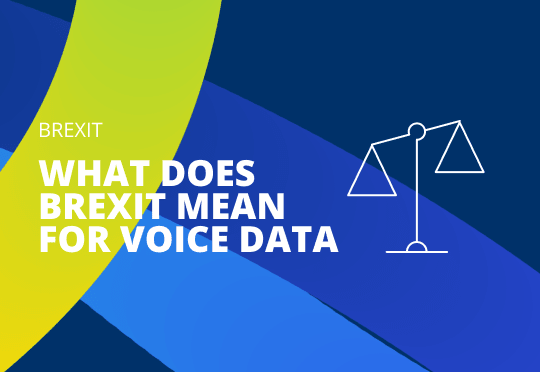
It’s official, the UK is no longer part of the European Union and the transition period is rapidly coming to a close. What does this mean for data protection? Do businesses still need to comply with the GDPR after December 31st 2020?
For those businesses who operate within the European Economic Area (EEA) and record their phone calls, they must check that their protection of voice data is sufficient for a post-Brexit world. If data is processed in the UK, they must ensure that they have contractual provisions in place to reflect any flow of data between the EEA and the UK. Any preparations need to consider the progress of negotiations that are continuing during this current transition period. GDPR may well remain part of UK law.
What legislation currently applies?
Parliament has passed The Data Protection, Privacy and Electronic Communications (Amendments etc) (EU Exit) Regulations 2019, which is basically the GDPR but applicable to a UK-only context. This will apply from the end of the transition period. If you’re a business based outside of the UK and offer goods or services to or monitor individuals in the UK this is applicable to you. If you’re a UK business and you’re already compliant with GDPR, and you don’t have any customers or contacts in the EEA, then you’re already sorted…or are you?
Any data protection plans are contingent on an adequacy decision from the European Commission, where the European Commission decides whether the UK offers an adequate level of data protection. With a rewrite of UK data protection laws potentially on the horizon, an adequacy decision could be significantly delayed. If no adequacy decision is made, businesses may need to amend their current contracts in order to continue data transfers. The extra cost of this undertaking could be bad news for small businesses.
What happens after the transition period?
From January 1st 2021, the UK will be deemed a “third country” under the GDPR, which means personal data from the EEA will only be able to be transferred if:
- The European Commission issues an adequacy decision
- Appropriate safeguards are in place
- There is an agreement of approved codes of conduct
- There is certification under an approved certification mechanism together with binding and enforceable commitments on the receiver outside the EEA
If you’re a UK business that receives personal data from contacts in the EEA, you will need to take extra steps to ensure that this data transfer can still go ahead. If you’re a UK business with some form of presence or customers in the EEA, you’ll have to comply with both the UK and EU legislation and may even have to appoint a European Representative. You will need to implement an appropriate mechanism to transfer personal data from the EEA to the UK and any onward transfers to another third country. Several of these mechanisms are already laid out in the GDPR, including standard contractual clauses adopted by the European Commission (SCCs).
Organisations should be able to continue transferring data from the UK to the EEA, but data protection documentation and contracts will require updating.
Businesses that transfer data from the UK to countries outside the EEA should be able to continue with existing processes for now, but any reforms of UK data protection laws could change that. The really tricky part is transferring to and from the US. This is due to the EU/US ‘Privacy Shield’ agreement being declared invalid by the EU Courts. This means yet more contract updates and appropriate safeguards.
What is Dubber doing to prepare for Brexit?
Dubber already complies with GDPR and will ensure that we continue to do so after the transition period, whether or not the UK is considered an adequate third country.
Let us know if you have any questions about voice data and Brexit.
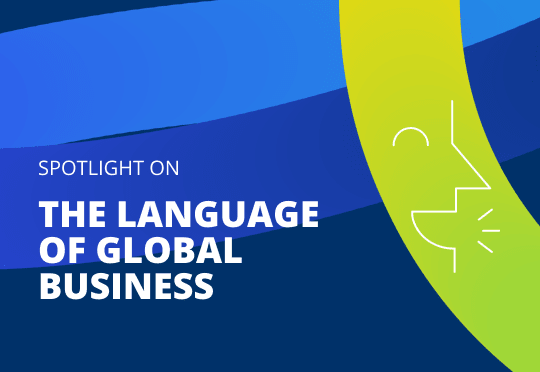
As business becomes more and more international, the languages used to communicate only become more numerous. This globalised way of operating requires a multilingual approach.
With national economies fluctuating constantly, the dominant languages of business may change – and global companies will need to be prepared. As part of their international expansion, businesses should include language in their strategy.
In the same way that machine translation has improved accessibility online, machine transcription is facilitating global business. The intersection of machine learning and language translation is helping businesses across the world reach new audiences. Part of Dubber’s mission to bring voice AI to everybody is breaking down language barriers and allowing everyone to operate in their preferred language. Offering more languages for transcription helps us better serve businesses who operate globally.Good communication allows people located across the globe to exchange information and ideas and coordinate work and business operations. With remote work the new normal, business in the future may operate from different continents as standard. AI is facilitating this. Research in the US found that the introduction of machine translation increased exports by 10.9% and improved economic efficiency1.
Speaking your language
Not only is it important that your voice transcription solution supports different languages but also regional variants. While Spanish speakers from around the world might speak the same language on paper, there are many regional differences. Companies who operate in Spanish speaking areas including Puerto Rico and Mexico use Dubber’s services, and are supported by the regional transcription variants that we provide.
In order to offer the broadest possible range of languages to our customer base we use multiple transcription services – adding Google Cloud Speech-to-Text to our arsenal this year. Google and IBM Watson also help us to identify caller sentiment, including tone and emotion.
One of the key advantages of AI transcription is speed: AI can transcribe hours of recordings quickly – work that would take human transcribers days or even years. This makes machine transcription much cheaper than employing a human transcriber, or using the time of your staff to review calls. With voice AI able to detect keywords and analyse the sentiment of a call, the expertise of your employees can be saved for reviewing the tiny sample of calls identified as requiring attention.
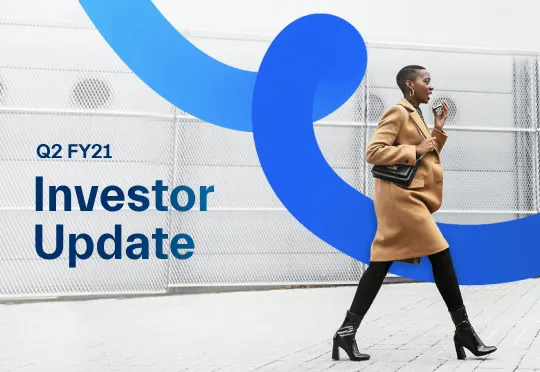
Today we had the opportunity to take Shareholders through Dubber’s strategy and why we are so excited about the opportunity ahead of us.

James Slaney is the co-founder of Dubber. Here he gives us an overview of how voice data can provide solutions to business problems.
There’s one piece missing from every organisation’s compliance and performance puzzle. Voice. And AI powered Unified Call Recording is the answer.
Today the majority of our business interactions are voice-based. And more than ever, those calls are happening outside of the call centre.
When those calls and conversations end, critical content and value is lost forever. Imagine losing the majority of your data every day.
Traditional approaches to call recording don’t work when calls are happening across devices and communication platforms like Microsoft Teams. Hardware costs, lack of scalability, insurmountable technical barriers, and compliance difficulties mean a new approach is needed.
Businesses are left not knowing.
With customers consistently choosing to contact brands over the phone, critical content and value is being lost every day. Businesses who aren’t capturing their voice data are left asking what their customers are saying, whether they’re satisfied, what the details of their orders were, and whether their records are up to date.
That’s why we created Dubber, the world’s #1 Unified Call Recording solution powered by the cloud and AI. It’s the only fully scalable and compliant solution that can be switched on with a click.
A data-driven approach to customer and employee experience is critical to the growth and development of an organisation, particularly In today’s hyper-competitive economy.
Unified Call Recording automatically captures every call and transforms conversations into tangible data through AI. Voice data can be used to power transcripts, real-time search, alerts, and sentiment analysis.
Only 36% of executives have real-time, highly integrated capabilities across all customer channels within their enterprise.
Data doesn’t stop with Dubber. The future of customer service will see one unified record of interactions across every channel, no longer requiring a customer to relay their entire history to each new representative they speak to. Why wait for the future? What if every customer call was automatically transcribed and logged within your company’s CRM application?
Using an open API, businesses can populate CRM tools with a unified record of customer interactions. Imagine every Salesforce record up-to-date with the most recent customer conversation: including the recording, transcript, and even customer sentiment.
The integration of business data is the foundation for superior data-driven customer experiences and compliance.
Together we can unlock the potential of voice data to power better business outcomes, enterprise transformation and business continuity.

If you’ve ever dealt with a legal hold request, you’ll know how difficult this mandated preservation of information can be to manage. But there is a solution that can reduce the cost and complexity of complying with a legal hold request.
What is a legal hold request?
A legal hold (or litigation hold) request is when legal counsel asks an organisation to preserve information that could be relevant to litigation, an audit, or investigation: including electronic records such as emails, instant messages, and voice recordings.
A company may have multiple active litigation cases – each with its own legal hold requirements. Legal holds cover anyone who might possess relevant information, called custodians. The list of custodians may change throughout the process so companies need an agile solution that can quickly and easily place new information under legal hold.
For companies with information in multiple locations such as employee devices, on-premise servers, and data centres: beware. This distribution of data could cause your risk and compliance teams a headache. Having one centralised location for records makes identifying information and placing it under legal hold much easier.
Dubber’s Legal Hold feature
Businesses can prepare for external events that might impact their business. These might include a simple late payment issue with a customer, litigation, regulatory audit, or even government investigation.
To rest assured that any voice recordings and their associated data can be held for investigation quickly, easily, and effectively, all CALL DUB and DUB AI licences now include our new Legal Hold functionality as standard. This vital compliance feature is included at no extra cost to provide reassurance that recordings can be preserved should the need arise.
How does it work?
Dubber’s Legal Hold functionality allows users to tag single or multiple recordings as held. Selecting multiple recordings at once assists organisations in complying with a legal hold request and preserving large quantities of information at short notice.
Once a recording is tagged as held it can be played, downloaded, and shared as with any other recording – but cannot be deleted under any circumstances. Held recordings are protected from erasure even when the retention period for the recording expires, if the user associated with the recording is deleted, or the overall storage period expires.
Dubber users can already store and manage all of their recorded voice data securely and efficiently in one single, consolidated archive within the cloud platform. With unified record keeping and automated retention periods, compliance procedures are streamlined and these now include legal hold requests.
Legal Hold allows users to target specific recordings for analysis without the need for technical assistance or expertise. Recordings can be tagged as held in bulk by filtering recordings by customer, keyword, or user. Only users with admin permissions can tag recordings as held, standard users are unable to use the feature or use filters to locate held recordings.

Customer experience starts and ends with customer satisfaction. But how do you know when a customer is satisfied or not?
Enterprises today measure customer satisfaction through a combination of anecdotal evidence and often slow reporting. Most see a significant gap between industry leaders and their peers. Leaders are moving to real-time and predictive views of customer experience.
And that’s where Unified Call Recording comes in.
A recent Walker Info report revealed that customer experience is overtaking price and product as a key brand differentiator. The report further shows that 86% of buyers are willing to pay more for a better customer experience.
At the core of these efforts is capturing every conversation with a customer in real-time, using AI to score the conversation sentiment, and presenting data in real-time – not just in dashboards but in every customer record.
This same data becomes the fuel for “Know Your Customer” – a key component of most global compliance mandates.
A Forbes Insights survey of 357 executives found that the benefits of data-driven customer experience are wide-ranging – including enhancing revenue generation and enabling cost reduction, as well as process efficiencies and quality improvements.
Unlocking happiness
The point of sentiment analysis isn’t just to know what was said, but to be able to do something about it. Modern Unified Call Recording platforms don’t just tell you how satisfied your customer is, they tell you how satisfied your employees are. Integrating employee experience is essential to improving customer satisfaction. Effective use of Unified Call Recording will tell you the real impact.
Recorded calls are an invaluable resource for training and quality control. Don’t throw your new staff into the deep end – show them what works well and what doesn’t during their onboarding by playing them real calls.
But don’t just take it from us, let one of our customers show you how they’re using voice data to optimise their customer experience.
A&E Auto Glass on Dubber
“The Dubber solution has been a great blessing for our company because we are able to listen to calls for quality and training purposes.”Eric Solheim, A&E Auto Glass
A&E Auto Glass are a family-owned business that has been working to provide the best windshield replacement experience for 17 years. We spoke to owner Eric Solheim about how A&E Auto Glass are improving customer experience with Dubber.
Dubber: What was the challenge that brought you to choosing Dubber?
Eric Solheim: We didn’t have call recording and wanted an affordable solution to help with dispute resolution, as well as to enhance our employee training. Our ultimate goal was ensuring customer happiness and accuracy in our communications.
D: How did Dubber help you solve this problem?
ES: Since deploying Dubber, dispute resolution has vastly improved with accurate records of conversations with customers. We know exactly what was said, which protects us against any future liability. We also use recorded calls to enhance our staff training to ensure that our customers are getting the best service with accurate information.
- 50% increase in disputes resolved in favour of the company
- 70 phones at the company
- 98% accuracy of recorded calls
D: What was the process of going live with Dubber like?
ES: We have our telephony service with Cox so Dubber was a clear choice as it’s the best deal out there with our phone system. They aren’t just the best deal though; their solution works very well and we deployed it across all 70 phones in our business.
The results have been great, 98% of the time the call is perfect quality. The Dubber solution has been a great blessing for our company because we are able to listen to calls for quality and training purposes. Not only is the price reasonable, but the customer service is very helpful and quick to respond. I would definitely recommend Dubber!

End the productivity and visibility trap
Unified Call Recording can capture customer calls and automatically log them within a CRM such as Salesforce. But to earn some serious points with your sales team, give them the gift of voice AI. This can act as a personal assistant to your sales reps: transcribing their calls so they never have to take notes ever again.
Recordings and transcripts can be used to inform lead prioritisation, the coaching of team members, and much more.
According to research by Salesforce, 67% of sales people say that enforcement of activity logging is stricter than in 2019, and 63% of reps log more details about customer interactions than they did in 2019. The reality is most sales leaders bemoan the fact that Salesforce isn’t up to date or current. What if you could automate this logging for your sales team and get them back to selling?
For most sales teams this can equate to another day of selling every week. Another day!
End not knowing
Ever wondered what was said? How the customer was really reacting?
Rather than hearsay, how about letting AI tell you.
With sentiment analysis, positive and negative conversations can be identified to coach new and existing team members, create alerts for negative calls, and track campaigns, competitors, or trends in customer enquiries.
Sales teams need to understand the needs of their customers and build trust through listening. But are they being supported by business tools, or being let down by them?
“Sales leaders today are plagued by not knowing and no one likes surprises – particularly at the end of the month or quarter. Customer experience is equally impacted as salespeople transfer what was heard into manual notes and back into CRM platforms. Unified Call Recording accelerates sales momentum – giving back valuable selling time to reps and, critically, ending not knowing. Implementing Unified Call Recording should be a priority for every sales leader.”Russell Evans, CRO, Dubber
Bring it all together
Unified Call Recording enables it all to come together. Every conversation captured from any end-point. No salesperson works on any one device or platform. We jump between Webex, Teams, mobile, and more. So record and capture every conversation and, with them all in one place, seamlessly integrate with Salesforce and your preferred data visualisation dashboard for real-time record keeping and insights. Set alerts on keywords and more.
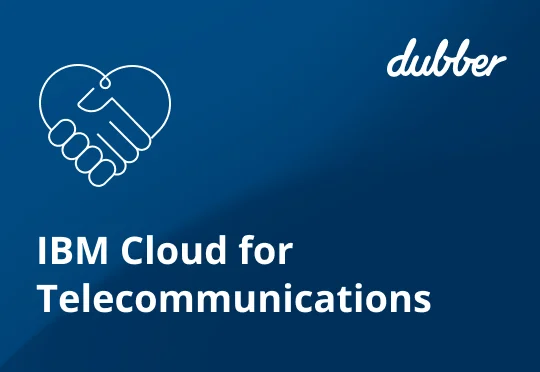
Dubber UCR & Voice Intelligence Cloud will help clients unlock benefits of IBM’s open and unified hybrid cloud architecture, built for the telco industry and delivering security, AI-driven automation and end-to-end service orchestration.
Melbourne, Australia – Dubber Corporation Limited (ASX: DUB) (Dubber) today announced it has committed to join IBM’s (NYSE: IBM) ecosystem of partners supporting the new IBM Cloud for Telecommunications. The IBM Cloud for Telecommunications is an open, hybrid cloud architecture designed to accelerate business transformation with the power of edge and 5G and address the unique requirements of operators, partner ecosystems and their enterprise clients. Built on IBM Cloud Satellite, currently in beta, and leveraging Red Hat OpenShift, clients can deploy cloud services anywhere: on the cloud, on premises or at the edge, while addressing industry-specific regulatory and security requirements.
Dubber’s Voice Intelligence Cloud will help Service Providers deliver next-generation Unified Call Recording and Voice AI Services on a unified cloud platform. Its Unified Call Recording™ (UCR) solution will integrate and be interoperable with IBM Cloud for Telecommunications and is designed to enable Service Providers to offer solutions critical to their customers addressing compliance mandates, improving sales and service performance and unlocking the possibilities contained within voice data.
“In simple terms, by leveraging IBM Cloud for Telecommunications, Dubber can help enable service providers to differentiate and create value from the conversations occurring on the network by making call recording and voice data as a service (VdaaS) ubiquitous and open,” said James Slaney, co-founder, Dubber. “All conversations can be captured in the Cloud and converted to AI-enriched data. Dubber will make it easy to capture calls – from traditional landlines to 5G services, and end-points provisioned by the Service Provider.”
“We are excited to collaborate with Dubber as part of the IBM Cloud for Telecommunications Ecosystem, to offer telecom operators access to the best technology that can help them scale and innovate.” said Evaristus Mainsah, General Manager, Cloud, Cloud Pak and Edge Ecosystem, IBM. “The power of IBM’s Ecosystem provides clients a wide range of ways to leverage the platform, positioning them to deliver next generation 5G and Edge services; deploy and manage new cloud capabilities; and enrich relationships through AI-driven engagement.”
The IBM Cloud for Telecommunications is engineered to integrate advanced AI and automation processes at the edge and speed services deployment while simultaneously reducing overall costs. With an open, container-based architecture managed as a service, operators and their providers will be able to easily integrate, automate and orchestrate how they run network and IT workloads across any environment. The platform leverages IBM’s industry-leading encryption capabilities like Keep Your Own Key (KYOK), giving clients full control of their data.
Dubber has committed to join the IBM Cloud for Telecommunications Ecosystem, an initiative to help network equipment providers, independent software vendors (ISVs), software-as-a-service providers, and hardware partners accelerate business transformation by unlocking the power of 5G and edge. The IBM Cloud for Telecommunications is an open, hybrid cloud architecture built on IBM Cloud Satellite, currently in beta, and leverages Red Hat OpenShift to enable clients to deploy IBM Cloud services anywhere: on the cloud, on premises or at the edge, while addressing industry-specific regulatory and security requirements. Red Hat OpenShift is the industry’s leading enterprise Kubernetes platform.
For more information, please contact:
Investors
Simon Hinsleysimon.hinsley@dubber.net
+61 (0) 401 809 653
Media
Terry Albersteinterry@navigatecommunication.com.au
+61 (0) 458 484 921

Dubber “Best of Breed” UCR & Voice Intelligence Cloud selected for IBM Cloud for Telecommunications Services
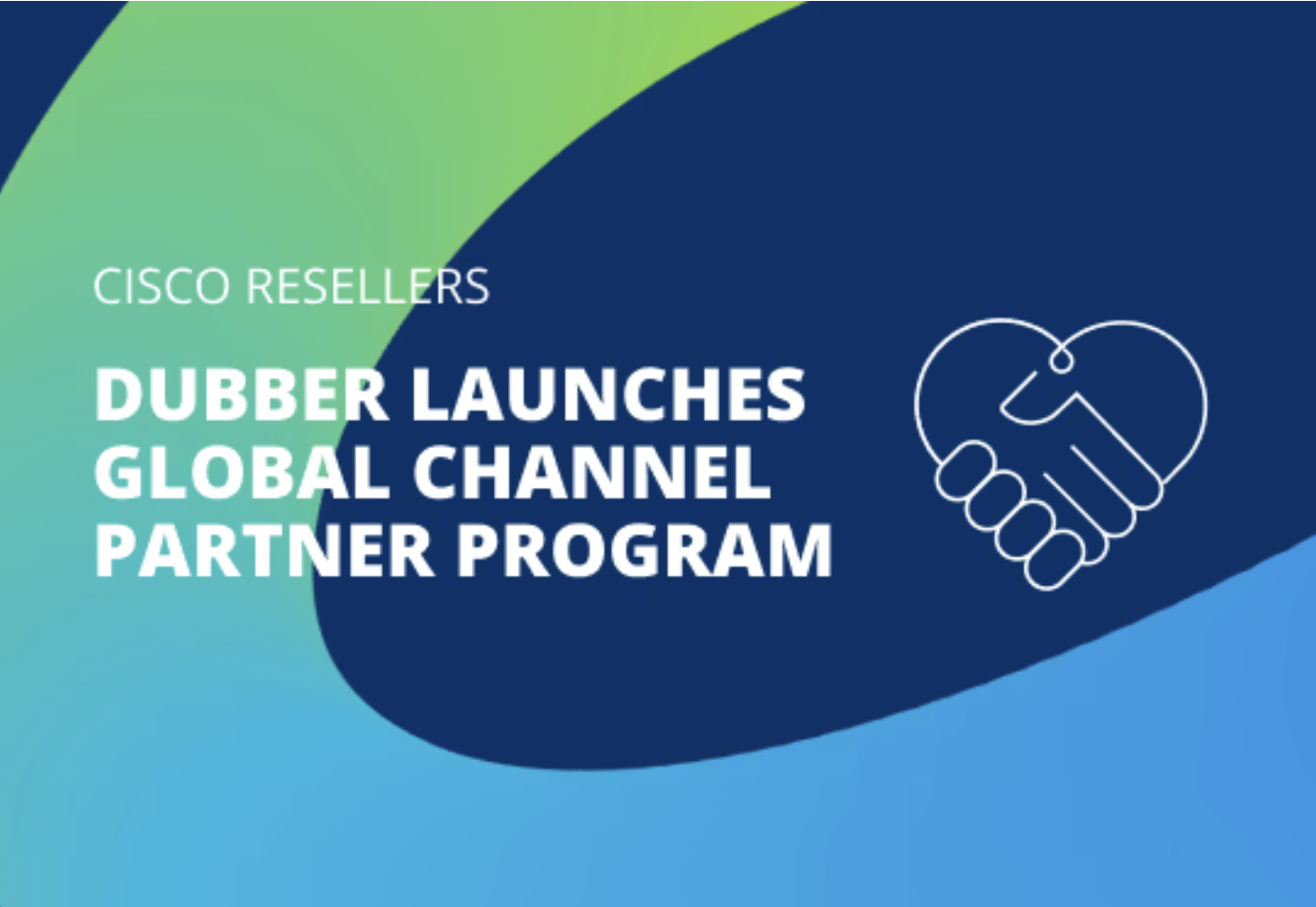
- Dubber on Cisco eliminates cost, complexity and risks of legacy call recording and unlocks possibilities of voice data at scale
- Dubber Cisco Reseller Program includes access to market development funds (MDF), competitions, dedicated channel support, and access to incremental commission incentives
Melbourne, Australia, and Dallas, Texas, 2 December 2020 — Dubber today unveiled a Global Partner Program for Cisco and its resellers, supporting the recently announced availability of its Unified Call Recording (UCR) and Voice AI solution on major Cisco voice platforms. Dubber is the recording and data capture platform natively integrated into the Cisco Webex Calling Cloud Collaboration suite.
The only solution integrated and interoperable with Cisco Webex Calling, Dubber enables customers to address critical compliance mandates, improve sales and service performance, and unlock the possibilities contained within voice data. Integrated and interoperable with Cisco – and running in the Cloud. Dubber eliminates the need for costly hardware, services and lock-in contracts.
To support global customer demand, Dubber has launched a global channel program specifically for Cisco resellers that includes a dedicated portal, support programs and sales incentives.
“The integration of Dubber into the Cisco Webex Calling Collaboration suite is globally significant for Dubber and has fostered a commercial relationship that is second to none,” said Adrian Di Pietrantonio, Co-Founder & EVP, Global Channels and Alliances at Dubber. “For Cisco resellers and partners, selling UCR inside Cisco’s voice solutions creates great opportunities. It accelerates any partner’s time to market and increases revenue and customer retention, and speeds their customer’s time to outcomes. With this new partner program, we can break the limitations of application-specific legacy call recording and unlock the possibilities of voice data and AI across the most important Cisco voice services.”
The Dubber on Cisco Reseller Program includes competitions, access to significant market development funds, dedicated channel support, and access to incremental commission incentives. “We’ve made the Dubber on Cisco Reseller Program as simple and easy to access as Dubber itself,” added Di Pietrantonio. “Within hours resellers can be increasing total contract values, increasing commissions through Dubber benefits, rewarding team members for engaging in training, and differentiating like never before from the competition.”
Background:
- Available for Cisco resellers, distributors or systems integrators (SIs) currently selling Cisco Webex Calling, Cisco Unified Communications Manager (CUCM) or Cisco Hosted Collaboration Solution (HCS)
- Dubber is live and adopted as a core network service across Cisco’s Webex Calling, CUCM, UCM-Cloud, HCS, Broadworks and WX Carrier platforms
- Access more information on Dubber on Cisco
- Interested resellers can register to join introductory Dubber on Cisco webinars
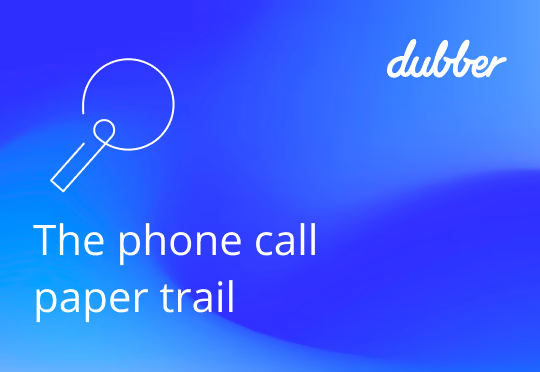
The most important conversations happen over the phone: the deal you want to close, the urgent task that requires attention, and the complaint you want resolved. Unfortunately, unlike emails, there isn’t a paper trail that shows exactly what was said. Until now.
Get concrete evidence of what was said
Companies who do the majority of their business over the phone (did you know that 60% of customers prefer to call small businesses on the phone?) may struggle to find accurate proof of what was said between them and their customers. By relying on note-taking during a call, human error is inevitable. Without concrete evidence of the conversation, orders can be incorrectly fulfilled and customers can misremember what was discussed over the phone.
The solution to these challenges is a secure and scalable call recording solution that supports a businesses communications system – whether that’s fixed lines, hosted IP telephony, mobile devices, or solutions such as Microsoft Teams. With accurate proof of what was said, businesses can ensure better quality control in their order fulfillment and be better placed to resolve disputes. With AI transcription, it becomes even easier to find evidence of a conversation.
The ability to replay calls or refer to transcripts is only useful when they can be instantly retrieved. Keeping a customer waiting while you perform slow and painful SQL search just isn’t going to cut it in a world where everyone expects instant results. Businesses need to make sure they have real-time access to recordings for quick and efficient customer service.
Learn from unhappy customers
Recorded calls are also invaluable for staff training. Having real-life examples of what kind of calls to expect on the job prepares new employees for life in their role. Recorded calls can also be a great tool for the constant improvement of existing staff – especially with AI-powered sentiment analysis. Calls rated with positive sentiment can demonstrate best practice and can also highlight which employees should be rewarded for their excellent service, while those with negative sentiment can provide examples of unhappy customers and used to work out how to improve in the future.
Not only can recorded calls and their transcripts be useful for staff to refer to, they can also be a really useful tool for accurately sharing information. The ability to pass along a recording to a colleague in order to fulfil an order or solve a problem is invaluable, and recordings and transcripts can also be shared with customers for their information and reassurance.
But what about data protection?
Calls shouldn’t be made available to just anyone, and there must be security measures in place to ensure that files cannot be downloaded and shared with anyone outside the relevant parties. The most secure method of sharing recordings is with expiring links that can only be accessed by the intended recipient. These should prevent playback after a set time period, or a certain number of replays. Call recording solutions should always have access permissions to ensure that calls can only be played by appropriate employees, or supervisors only.
Case study: Dose Moving and Storage
Dose Moving and Storage is a family owned business that provides moving and storage solutions. We spoke to founder Marilee Dose about the company’s experience using Dubber.
Dubber: What was the challenge that brought you to choosing Dubber?
Marilee Dose: We wanted a record of all of our conversations with customers for improved dispute resolution, quality control, and training.
D: How did Dubber help you solve this problem?
MD: Recording our calls not only gives us concrete proof of what was said to customers, we can also securely share recordings with them so they can refresh their memory. This has been invaluable when disputes with customers arise. The ability to replay conversations has been instrumental in improving quality control within the business and we have also used recorded calls to enhance our staff training.
D: What was the process of going live with Dubber like?
MD: Dubber is very user friendly and reliable. We found the portal easy to use and we had the peace of mind that every call was automatically recorded and could be retrieved instantly.
If you’d like to learn more about how businesses are improving dispute resolution with Dubber, speak to a member of the team today.
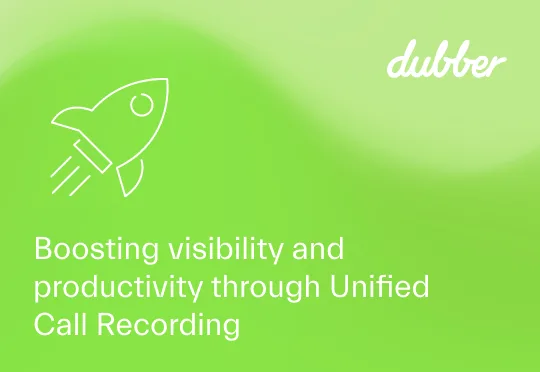
How would your sales performance improve if you gave every salesperson back five, ten or more hours every week?
One of the first places to start is reducing admin, manual and inaccurate record keeping, and searching for what was said. While effectively documenting sales activities can be vital to ensuring customer needs are addressed and performance is monitored and improved it doesn’t need to be done by hand.
End not knowing
What if you knew what was actually said? In customer-facing roles, such as those in sales or customer service departments, time can often be wasted trying to ascertain or prove what was said during a previous conversation. In order to end not knowing, sales teams need a call recording solution that captures 100% of calls for evidence of conversations. And that’s just the beginning. If a solution has added voice AI that can transcribe speech to text, a full transcript can accompany a recording for an accurate record of exactly what was said.
Things get even more interesting when you introduce an open API to the picture. This allows developers to facilitate integrations with existing business tools and applications, including CRM systems. Call recordings and their transcripts can be stored within a customer account for detailed and accurate records of every interaction the business has had with a contact.
Discover instantly
Rather than scouring manual notes or looking at inaccurate records in Salesforce, what if every conversation was captured as it was said? Sales teams would no longer waste time doing detective work to confirm agreements or resolve disputes – their time can now be spent generating revenue for the business. With absolute proof of what was said, sales reps can refer to a recording or transcript without delay. With a user-friendly interface, or integration with a CRM application, salespeople could even refer to a previous conversation with a customer while they are talking to them on the phone.
Coach and train based on real customer conversations
Recording sales conversations creates a bank of real-life examples of customer calls, which makes ideal training material for new employees. With the addition of sentiment analysis, calls rated with positive or negative scores can be easily identified to show successful customer interactions, and the kind of negative calls they might encounter.
Case study: DeSpir Logistics
DeSpir Logistics combines the best practices of logistics and technology to pioneer a new method of secure transportation logistics. We spoke to Sierra Villarreal, who covers security and compliance, to hear more about how Dubber saves the company time.
Dubber: What was the challenge that brought you to choosing Dubber?
Sierra Villarreal: We wanted a record of our calls in order to have a record of what was agreed upon during conversations with customers.
D: How did Dubber help you solve this problem?
SV: Dubber provided a great, affordable solution that meant we had a record of every agreement made over the phone. We can get to the facts on the first phone call; instead of wasting many hours following up on phone calls and emails trying to prove something was said on a phone call.
We also use calls to help with training new and existing employees on certain situations, calls, questions, etc. Most of all, we SAVE time!! We are no longer paying employees to spend hours investigating claims a customer made on a phone that wasn’t recorded. We can now use that time on sales. The company is saving money due to investigation hours reducing because of Dubber!!!
D: What was the process of going live with Dubber like?
SV: The Dubber portal is extremely user friendly. The easy to use solution makes it easy to retrieve a call in seconds, even while on a call with a customer, meaning we can reference a conversation to confirm details of agreements and resolve any disputes with customers with absolute proof of exactly what was said.
If you’d like to learn more about how businesses save time with Dubber, speak to a member of the team today.
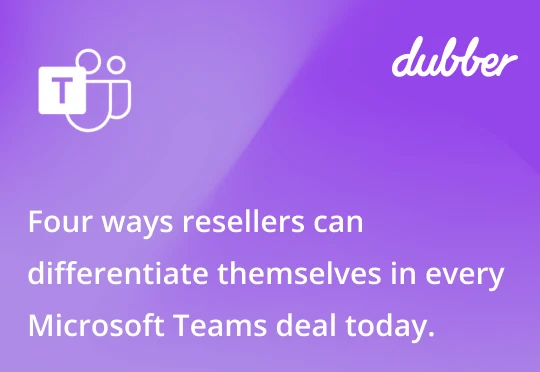
With workforces more dispersed than ever before and the number of communication devices and collaboration applications multiplying, customers are demanding solutions that answer their needs for improved visibility and meeting compliance mandates, without the constraints of legacy or app based call recording.
In parallel, resellers and solution providers are looking for new sources of differentiation and value creation opportunities for their clients.Dubber has answered these challenges by launching the first compliant unified call recording solution, with AI-enriched insights and alerts for Microsoft Teams. Dubber is now available to automatically record every conversation on Microsoft Teams, and it’s in the Cloud so it can be turned on with a click.
Here are four ways every partner or reseller can create value for their clients and differentiate themselves using Dubber on Microsoft Teams right now:
- Meet compliance and regulatory mandates Dubber provides the secure and compliant capture of voice data from all Microsoft Teams calls that meets strict data and privacy regulations. Customers can comply with Know Your Customer and regulatory requirements through alerts, keyword searches and reporting with easy to access, accurate records of every conversation. Dubber also provides the ability to set retention rules and quickly undertake granular investigations into rogue operators.
- Improve customer experience and outcomes Dubber captures 100% of all Microsoft Teams calls giving customers total visibility of customer conversations. Customers can use Dubber’s voice AI to generate deep sentiment analysis, notifications on keywords (such as “cancel account”, or competitors’ names) to reduce churn and improve customer experience and outcomes.
- Eliminate cost and complexity of legacy and app-based call recordingDubber lives in the cloud, which means infinite scalability, data sovereignty, and no additional costs – just one flexible and easy to change monthly subscription. Dubber can be switched on and recording instantly. There’s no need to implement costly, time-consuming and complex on-premise hardware.
- Increase sales and service productivityBoost sales productivity by eliminating inaccuracy, delays and lost productivity of manual call recording and note taking. Gain real-time access to call content with instant reporting and notifications on key sales indicators (sentiment, tone, keywords, and categories). Easily integrate recordings, transcriptions and insights with Salesforce, dashboards and other applications.
For any Microsoft Teams Partner, Dubber provides an opportunity to help businesses of any size address customer requirements in regulatory compliance and Know Your Customer mandates; document crucial conversations; understand customer satisfaction in real-time; and improve staff productivity.
All this adds-up to increased revenue, retention and value creation opportunities for Microsoft Teams Partners.
The first step to supercharging your Microsoft Teams sales is to join us for a free 60 minute webinar to learn the value of Dubber on Microsoft Teams. You’ll see Dubber in action and how customers are using it today – often to eliminate the costs and risks of alternatives. We’d love you to join us! Be one of the first 50 to register and attend, and win a $50 Visa Gift Card!
Click here for a schedule of dates for each region and registration details. Register Now
If you are a Microsoft Teams customer and would like to add Dubber services to your platform, it’s easy. Get in touch here: www.dubber.net/microsoft-teams-customer or contact your Microsoft Teams Partner for more information.
If you are a Microsoft Teams Partner and would like more information on how Dubber services can help you increase sales and reduce customer churn, visit our link for resellers here: www.dubber.net/microsoft-teams-reseller
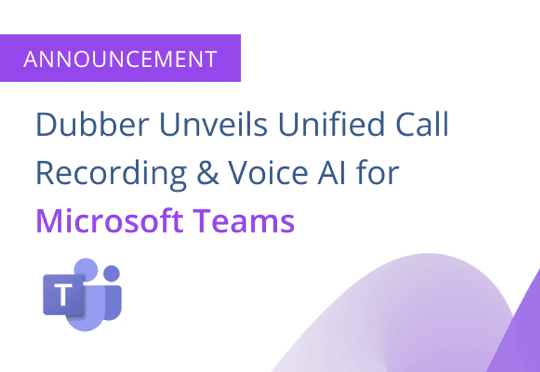
Automatically record and transform every conversation on Microsoft Teams into rich voice data for compliance, CX, evidence and performance improvement
Eliminate the cost, complexity and risks of legacy call recording and unlock the benefits of voice data at scale
Dubber unveils global channel program for Microsoft Channel Partners & Resellers
Dubber Corporation Limited (ASX: DUB) (Dubber), today announced the global launch of Dubber Unified Recording on Microsoft Teams, supported by a new and tailored global channel partner and reseller program.
Unified Call Recording is a first of a kind capability for Microsoft Teams enabled by Dubber’s unique ability to capture any conversation – voice or video — on Microsoft Teams in the cloud – and to aggregate recordings, data, insights and alerts from service provider and unified communications platforms, compliantly, in one place.
Microsoft Teams is one of the world’s fastest growing team collaboration suites, and has over 75 million daily active users. Dubber allows Teams customers to automate voice recording at scale from any device with no need for hardware. Unified call recording and voice AI are a key enabler of compliance, customer satisfaction and sales performance – delivering real-time insights, sentiment analysis, alerts, beautiful transcriptions and more.
Dubber announced an extensive global channel partner program for Microsoft partners including partner incentives with support, deployment, and training resources.
“COVID has dramatically accelerated the demand globally for unified communications solutions”, said Steve McGovern, CEO Dubber. “As workforces have dispersed and network end-points multiplied the demand for automated call recording at scale has become essential to addressing regulatory requirements and enterprise-wide visibility. With Dubber supporting Microsoft Teams via our global platform, users can activate recording immediately in the cloud – eliminating the need to build solutions or buy hardware.”
McGovern added, “Microsoft Teams customers and resellers now have access to the industry leading platform used by over 140 service providers worldwide. It’s now possible to unify call recording on these networks and Microsoft Teams into the centralised Dubber Voice Intelligence Cloud. Our integration with Microsoft Teams advances Dubber as the preeminent and de facto cloud-based unified call recording solution for communications providers – and as a source of differentiation and value for resellers globally.”
Background, Dubber on Microsoft Teams:
Available for order now from Dubber and registered Dubber resellers & partners
Dubber is live and can be easily activated on Microsoft Teams
Flexible plans start as low as AU$9.95 per month.
Dubber for MS Teams currently supports Voice Unified Call Recording (UCR) with Video and Screen Share UCR to be available in December 2020.
Access more information on Dubber on Microsoft Teams.
Interested resellers can register to join introductory Dubber on Microsoft Teams webinars.
About Dubber:Dubber is globally recognised as the Cloud Call Recording and Data Capture platform for Communications Service & Solution Providers and as integral to their Unified Communications offering. Dubber’s unique technology enables call recording to be delivered as a service and turns voice calls into data enabling broad-reaching AI services to be deployed at scale directly from a Carrier network – or from inside a Solution Providers infrastructure. Dubber services are presented either in the brand of the Carrier or as Dubber products. Founded in 2011, Dubber is headquartered in Melbourne, Australia, with operations in the USA and Europe.
Trademark reference: “Microsoft” and “Microsoft Teams” are registered names and trademarks or trademarks of Microsoft, Inc. or its affiliates in the United States and/or other countries. All other trademarks referenced herein are the property of their respective owners.
This ASX release has been approved for release to ASX by Steve McGovern, CEO & Managing Director.
For more information, please contact:
InvestorsSimon Hinsleysimon.hinsley@dubber.net+61 (0) 401 809 653
MediaTerry Albersteinterry@navigatecommunication.com.au+61 (0) 458 484 921
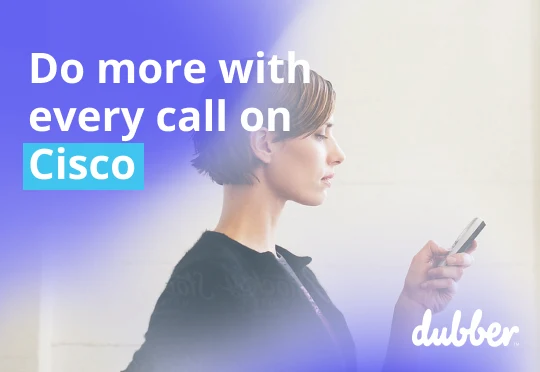
Cisco customers across their Webex® Calling, UCM-C, HCS, and CUCM services can unlock the power of voice data with Unified Call Recording and voice AI from Dubber. Automatically capture any call, receive a complete transcript, and access insights – from keyword alerts to sentiment analysis. You can even automate workflows and export data to dashboards and applications like Salesforce and Tableau through Dubber’s open API.
Legacy call recording and analytics restricted basic call recording to specific applications and a limited range of devices – often requiring costly storage and with poor scaling potential. Dubber is fully native to Cisco Webex® Calling and can support UCM-C, HCS, and CUCM services too. As a cloud platform, Dubber’s Unified Call Recording doesn’t require any on-premise hardware or software: radically reducing costs and unlocking infinite scalability. Whether you’re considering moving to the cloud, or you want to future-proof your on-premise or hybrid solution, Dubber call recording is available to you. We create the ideal cloud environment, all in one solution.
Four things you can do when you turn calls into data
Unified Call Recording from Dubber is optimized for compliance with regulatory directives such as MiFID II, GDPR, Dodd-Frank, PCI DSS, and Cisco’s CASPRx. But the benefits don’t end there. Many businesses are choosing to record their calls to learn more about their customers and to identify opportunities to reduce churn, sharpen investment decisions, and inform business development.
Transforming calls into data through transcription opens up huge potential for analysis and allows voice data to be integrated with existing business systems:
- Faster time to conversations and activity: Quickly review transcriptions and use instant search to find conversations
- Instantly report on customer and employee experience: See sentiment ratings for every conversation, including individual emotions
- Unify voice data with big data: Export call data for analysis within data visualization tools. Integrate call data within Salesforce and other CRM tools to build detailed customer profiles
- Real-time alerting and notifications: Monitor when keywords are spoken during a call to track campaigns or potential issues. Create automated alerts for negative calls to help reduce churn and increase customer loyalty
How easy is it to connect?
Getting the benefits of Unified Call Recording and AI takes minutes and requires no on-premise equipment or storage. It’s as easy as using your existing Cisco solution.
If you’re considering call recording for your Webex® Calling, UCM-C, HCS, or CUCM solution, sign up today by ordering directly from Cisco – we’re listed on Cisco Commerce Web (CCW).
You can also talk to one of our team if you’d like more information. And, if you are a Cisco reseller, we’re here to help you.

With a dispersed workforce, collaboration can feel difficult to achieve. Remote workers can often feel separated from their colleagues and their visibility of business operations can feel restricted. In departments that have a lot of direct contact with customers, this can cause customer interactions to feel disjointed.
Collaboration is critical to sales
According to Salesforce’s State of Sales report, 77% of sales teams rate collaboration across departments as critical or very important to the sales process. Customers increasingly expect salespeople to be informed about any previous interactions with a business, even if this was with a different department. Having complete visibility of a customer’s journey with the company is invaluable when trying to understand their needs and how they can be met.
An interconnected way of working with colleagues and other departments within a business can lead to the discovery of new opportunities. It is becoming increasingly common for sales and customer service teams to securely share information with each other to work more effectively. When customer interactions are correctly documented within a CRM such as Salesforce, everyone with access to a customer account can assess how well that account is performing, and understand the status of the relationship with that customer.
End not knowing with a record of customer interactions
Of course, documenting customer interactions takes time and effort. What if you had a solution that captured every single customer call, even when they were handled by a remote worker on their mobile device, or over an IP connection? And, even better, those calls were fully transcribed by speech-to-text AI for an accurate record of exactly what was said?
Where traditional call recording solutions rely on expensive on-premise storage, and only capture a small fraction of calls made across a business. Unified Call Recording captures voice conversations directly from the service provider network, and from communication solutions such as Microsoft Teams. With work no longer confined to an office or contact centre, companies who are looking for complete visibility across their business are looking for agile communication solutions that match our new dispersed way of working.
Keeping customer data secure
It is important that collaboration does not compromise on data security. While sharing detailed records of customer conversations can benefit sales and customer service teams, it is vital that customer information is not shared with more parties than necessary. Businesses should look for a solution that allows for secure sharing of data. Audio files should not be downloaded, as this could open up risks for the data being shared with multiple parties. Instead, sharing should be undertaken with expiring links that only allow access for that user, with a restricted time period and a cap on the number of playbacks.
Organisations should also check that any solution allows for the creation of teams with specific access permissions. Depending on the requirements of the team, recordings may only be accessed by supervisors with administrator controls, or may be shared with other team members for greater visibility over customer interactions.
Case study: APAC-Central
APAC-Central, Inc. supplies materials, paving and construction services across Northwest Arkansas, the Arkansas River Valley, Oklahoma and Southwestern Missouri. We spoke to their IT systems analyst Dustin Bowden about how Dubber has facilitated collaboration across the business.
Dubber: What was the challenge that brought you to choosing Dubber?
Dustin Bowden: We wanted a call recording solution that was compatible with our new phone system to ensure our customers are billed correctly.
D: How did Dubber help you solve this problem?
DB: The Dubber solution gives us the ability to error check ourselves after taking an order. If a dispatcher gets a call and then can’t remember a detail when inputting the order, they can just check the recording rather than calling the customer back. The team like that they have the ability to share recordings as well as being able to set up teams. This means they can reference each other’s recordings when talking to a customer who has previously spoken to a different representative.
D: What was the process of going live with Dubber like?
DB: I have received great customer service. Paul has been very helpful with everything we needed to get up and going. The Dubber system is easy to use and our users like it better than what we used on our old phone system. It fits seamlessly with our phone systems: it just works, and works well.

Adrian Di Pietrantonio is the co-founder and EVP, global channels at Dubber. At the recent Cavell Cloud Comms Summit, Adrian spoke about Dubber’s vision of becoming the global leader in unified call recording and voice data as a service. Here he gives us an overview of Dubber’s mission and how we are answering business problems with our Unified Call Recording and voice AI cloud platform.
We started with a simple question – why is the value of every conversation lost the moment the call ends?
How many times do you have a call, meeting, or presentation, only to lose the value of the conversation instantly? Details are forgotten, there’s no agreement on the key points that were made, no evidence of agreements, and the conversation can’t be easily recorded for compliance, training and more.
How often do you wonder what sales, customer support or team members are saying to customers? Why can’t you get real-time visibility of customer satisfaction?
It became clear that service providers were making connections – but not realising the full potential of those connections.
Voice data – held within every call – was clearly one of the great untapped sources of value for any service provider due to the ability to address three critical business pain points:
- improving customer satisfaction
- improving business performance
- meeting compliance mandates
The need for a new approach
As we looked at existing approaches it was clear they were built for the pre-cloud era and restricted the ability of service providers to participate in the voice data race. We saw a multitude of challenges:
- High-cost, inflexible infrastructure limited call recording to a small set of customers
- The cost of applications and infrastructure frequently meant less than 1% of voice calls were captured
- Call capture was confined to a single line or device – most frequently in the call centre – not reflecting how workers operate across devices and networks
- Solutions required significant investment with no way to economically add end-points or start with a flexible, scalable plan that reflected real-life use cases
- AI and the cloud were limited in their use. Data was trapped in the vendor application – limiting the ability to integrate with applications and Big Data
The Dubber answer
We created Dubber to unlock the potential of voice data for service providers, with the ability to capture every call on the network and infinitely scale.
Our innovative new model records directly from the service provider network and can be provisioned as a feature by the service provider. Offering affordable plans that are charged per user per month. Our solution captures conversations across SIP connections, mobile networks, Broadsoft, Cisco, Microsoft Teams and more: all with single-click provisioning. We call this new approach Unified Call Recording because all recordings are unified in one place – reflecting how businesses work today – via the Dubber app or web portal.
In order to answer data compliance mandates, such as GDPR, we needed a unified storage solution. So we created the Voice Intelligence Cloud. This needed to be, well, intelligent. Capturing calls and transcribing them is a commodity service today. We wanted our AI to bring value by delivering alerts, full and accurate transcriptions, customer sentiment analysis, and much much more.
Finally, we wanted the data captured from voice calls to be available for enterprises to connect to their systems of record. Through the Dubber API, we enable simple and easy connections to Big Data sets, applications like Salesforce, and dashboards in Google Data Studio, Tableau and other business intelligence tools.
Real world applications of Dubber
The Dubber solution is deployed across over 200 Service Provider networks globally today. Our Foundation Partners work with us to unlock significant revenue, retention, and differentiation by offering voice data as a service for diverse use cases:
The independent auto parts trader
Unified Call Recording enables the business to create a record of every call, and attach it to orders as evidence of the customer request. This solves two problems – giving distributors clarity on what was being asked for and providing the company with evidence of the order. They see customer satisfaction data in real-time and can view the performance of every customer contact.
The mid-sized betting company
Dubber provides chain-of-custody over customer orders and requests – eliminating costly dispute resolution processes on bets placed. Voice data also indicates trends based on sentiment, keywords, and operator – allowing business decisions to be driven by insights.
The large financial institution
Unified Call Recording is the only way for large banks to meet the compliance mandates set out for lenders. Real-time recording retrieval replaced slow and time-consuming SQL searches on legacy call recording – which often showed that the call wasn’t ever recorded. The Dubber solution ensures call recording across any device in any location and automatically sends custom notifications for specific keywords and call sentiment scores.
The question for service providers is: if data is the new oil – and voice data is its richest form – are you ready to create value from it?
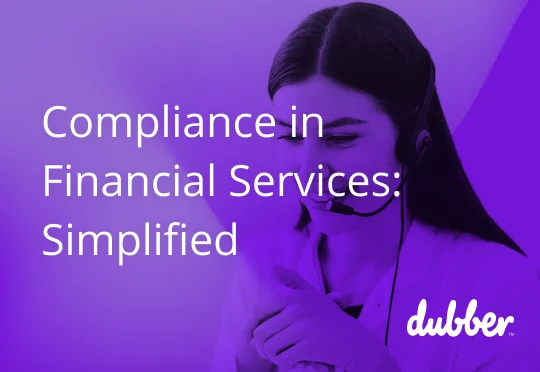
Accurate records of voice conversations – and their related data – are crucial to fuelling financial services compliance. Best practice extends beyond direct regulatory mandates to how data is stored and captured.
Current call recording solutions on applications and devices fail to address the full spectrum of compliance requirements faced by financial services organisations. Their approach to data retention and security increases risks rather than meeting the challenges set out by regulators.
The solution is Unified Call Recording which takes place inside service provider networks and popular solutions such as WebEx Calling and Microsoft Teams. And, as a bonus, enterprises can eliminate the costs of legacy platforms.
Risk and compliance managers who want to take a more proactive approach to meeting regulations and engendering trust in their customers will be looking for more than basic record keeping solutions. Providers need to be offering AI, transcription, real-time search, automated alerts and APIs as standard. Here are six critical features that should be considered in any compliant call recording solution.
Six critical features every financial services organisation should look for
Retention periods
Regulations such as the GDPR state that organisations must not keep data for longer than is necessary for the purpose the data was obtained for. It is best practice to not keep personal data for longer than is necessary and businesses need to be able to justify how long they store personal data. Financial services institutions require the ability to set retention periods in order to define the length of time that recorded calls are stored for, and to automate their deletion once this time period has been reached.
Unlimited secure storage
Is your data being stored with market-leading AES-256 encryption? Industry leading security practices are crucial. Most legacy call recording solutions require on premise storage at an incremental cost to the service and the more you store, the more it costs. By using Universal Call Recording and storing data in a Voice Intelligence Cloud, enterprises benefit from infinite storage at no additional cost – all provisioned with a click. And, by deploying the platform across dedicated regional data centres with geographic redundancy, organisations can be assured of data sovereignty.
Access permissions
In order to protect data, financial institutions need to ensure that they can restrict access to personal information such as recorded calls, depending on the role the user has been allocated. Depending on the information security policy of the firm, not every user whose calls are recorded should have access to them, or may only be allowed to listen to their calls and nobody else’s. Administrator permissions should be available so that supervisors and management with appropriate authority can access recordings.
Instant retrieval
Audit and compliance investigations require real-time access to data. Legacy call recording platforms depend on SQL searches often taking many minutes to render results. Instead, require that your Voice Intelligence Cloud provides immediate and secure access to all recordings – with search delivering results in real-time. Users should be able to search for calls using data including the date, time, and call participants. By choosing a solution with added voice AI, recorded calls can even be retrieved by searching for words spoken during a conversation. All recordings should be available for instant retrieval, playback, and secure download, with appropriate permission settings.
Call metadata
Compliance with financial services regulations relies on transparency, so call recording solutions should include call metadata alongside each conversation for a detailed record of customer interactions. This provides full transparency in the case of a request for information from a regulator. Ensure your solution provides rich call metadata – including timestamps on conversations – to allow for quick and easy search and retrieval of information. This gives firms the upper hand in compliance and risk management. Voice AI that can detect keywords and send tailored alerts to management makes it quicker and easier to detect and deter suspicious trading activities to prevent penalties from regulators.
Legal hold
Legal hold is an important feature that allows users to tag single or multiple recordings as held. These recordings can be played, downloaded, and shared as any other recording; but cannot be deleted under any circumstances. Held recordings remain even after their retention period expires, if the user associated with that recording is deleted, or if the storage period expires. This ensures that recordings required for legal reasons will always remain available for review.
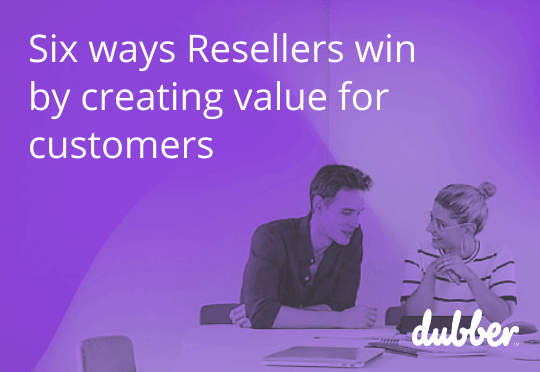
This week Russell Evans, Dubber’s global head of sales and channels looks at the most common challenge faced by resellers today – how to maximise revenue and reduce the prospect of churn in the booming demand for communications services.
Resellers of communications services – from mobile and SIP connections to UC, Teams, and more – have seen a Covid-driven boom in demand for services. The shift to the Cloud has been matched by an equal demand for data enriched AI to automate processes, gain extra functionality, and work more efficiently. Resellers that can demonstrate not simply the efficiency of the connection but also how to extract more value from every connection are winning more and seeing less churn.
So what does the new reseller playbook for resellers look like?
- Sell more than the utility and connection: What if the content created in every conversation was a source of insights and alerts? Unified Call Recording – available on the products you are selling today does just that – it converts the conversation to data to create beautiful transcriptions, sentiment analysis, real-time search and more.
- Create more value: That data becomes a source of immense value for your customers, ending not knowing what was said across the business. Sales leaders get an immediate read on every customer’s conversation. Customer service leaders can understand customer sentiment in real-time. Compliance managers get a secure and protected record of conversations and can instantly be alerted as to when to undertake investigations.
- Differentiate your offering and increase your value: While others sell Apps and connections, you are now differentiated, exposing the value of every conversation across the business. You stand-out because you are talking to the business outcomes the solution is meant to drive. Your relationship with your customer is elevated, driven by your ability to create quantifiable business benefits. You will occupy the space of trusted advisor for your clients.
- Unlock the power of voice data: Call recording helps businesses meet their compliance mandates, but it does so much more. Customers are crucial for any sustainable business. Voice data helps them gain greater visibility of transactions taking place within their business, and it provides the data for customer service employees to help with dispute resolution, leading to reduced churn and improved customer experiences.
- Target the burning needs: Every Enterprise in regulated industries – and most undertaking crucial conversations in which orders are taken, material information exchanged and issues are resolved – have a requirement to both record calls and manage voice data in compliant ways. Unified Call Recording isn’t just a way of selling more to your existing customers, it’s a natural add-on to every new connection.
Fuel big data: Big Data only captures a small proportion of data generated by a company. While companies have seen the value of big data, they are missing out on a huge chunk of data that is left uncaptured from voice calls. Imagine the value of combining both online and voice data to gain a holistic customer picture. Businesses can use these insights to inform new product lines, aid in cross-selling, and gain a better understanding of the reasons behind their customer’s decisions. Exporting this data to visualisation tools such as Google Data Studio, makes it easier than ever to extract these insights. More and more businesses are realising this, and using this voice data intelligence to gain a competitive advantage.

Sales reps are using their intuition, rather than data insights, to prioritise leads. As data becomes the driving force behind business decisions, here’s how voice data and AI can help sales teams to succeed.
End not knowing
What is more important to a sales person than a conversation with a customer? The most valuable of these most commonly occur over the phone, when a back-and-forth over email is just not good enough. But as soon as the call ends, the information and insight held within the conversation vanishes. With 67% of salespeople saying that enforcement of activity logging is stricter than in 2019, accurately recording customer interactions is more important than ever.
A sales person could try to capture the substance of a conversation themselves, taking notes either during the call or trying to remember the key takeaways once the conversation has ended. This is a drain on their productivity, and isn’t all that efficient: they will be distracted if they try to take notes while they are talking, and might not remember every detail if they are writing after the conversation is over.
Recording calls is the only way to preserve the value in a conversation, but traditional approaches have been focused on fixed lines within an office environment and things have moved on – even more so in a post-COVID world. At a time where offices are hastily erected at kitchen counters around the world, calls are being taken over the web, on mobile devices, and IP connections. It’s impossible to capture these conversations without a solution that is built in the cloud with the agility to record every call, no matter where it happens.
As businesses adapt to operating in a world with face masks, social distancing, and an increased reliance on technology for communication, customer service and satisfaction is more important than ever before. Sales teams are differentiating themselves from the competition by using AI to improve internal processes and customer experiences, with 57% of high-performing sales organisations using the technology. A true understanding of a customer’s needs and their feelings about a brand or product can give a salesperson the edge, but this takes time. With huge volumes of call data, it’s impossible to drill down to insights at such scale. The solution is voice AI.
How to boost conversion rates by up to 30%
What if every single conversation within a business could be harnessed to power data-driven decision making? Voice AI transforms recorded conversations into data that can be used by businesses to gain insights into everything from the efficiency of business processes, to product development, to the success of marketing campaigns, to customer satisfaction. Not only can companies combine this with other business data for 360º visibility, they can even use conversational content to power automation within the business.
By recording customer conversations and transcribing them from speech to text, voice AI can then be used to make day-to-day decisions more effectively. Using AI in sales has even been shown to boost conversion rates by up to 30% when interacting with sales leads1. With voice AI, call data can be integrated with a CRM to automatically populate accounts with records of every single voice conversation, including a full transcript. Sales reps can refer to call transcripts to recap customer needs and formulate tailored offerings based on their exact requirements. 69% of the highest performing salespeople had automated logging of customer notes.
Transcripts and recordings also act as evidence, meaning that crucial conversation with a customer will never be lost. Agreements can be referred to, and disputes can be resolved quickly and easily with an exact record of what was said.
The cure for churn
Sentiment analysis can also be used to gauge a customer’s feelings about a brand and even indicate those who might be about to churn. Voice AI analyses the words spoken by a customer to rate each part of a conversation, and the call as a whole, with positive, negative, or neutral sentiment. Using APIs, calls rated with a negative sentiment score can trigger an alert or even automate process, such as creating a task in a CRM such as Salesforce.
With the detailed records of previous interactions, salespeople can make hyper-personalised contact with leads and existing customers to help to nurture a relationship. Where once a customer might churn after a negative conversation, with automated alerts and task creation sales reps can proactively maintain relationships with contact that puts their needs first. Understanding customer needs was the number one reason for AI adoption, as stated by sales teams surveyed by Salesforce.
Not only are calls rated by sentiment, but voice AI can actually identify specific emotions based on what a caller said, allowing for an even more tailored approach to selling. Questions might indicate an analytical or tentative customer who might require more evidence of the benefits of a product or service, whereas someone making more active statements might be more confident in their opinions and be more ready to close the sale.
Case study: Dorsey & Dorsey
Dorsey & Dorsey Inc. is an insurance provider in Oklahoma. We spoke to their call centre manager Drew LeHew about how Dubber has improved sales performance at the company.
Dubber: What was the challenge that brought you to choosing Dubber?
Drew LeHew: We weren’t happy with our old call recording provider as calls had to be manually recorded, which resulted in us missing important conversations. We wanted to protect ourselves against liability and have recorded calls to use as part of staff training.
D: How did Dubber help you solve this problem?
DLH: The simplicity of the solution was the most important thing for us. We have complete peace of mind knowing that every call will be recorded automatically and will be easy to find when we need to. Recording our calls has allowed us to diffuse disputes very quickly and we’ve seen an improvement in the overall performance of our agents due to the enhanced training we can now offer using recorded conversations.
D: What was the process of going live with Dubber like?
DLH: The Dubber solution has given us a great system for monitoring calls and then using them as a training tool for our agents. Not only is every call recorded but we can easily retrieve important conversations and tag them for future use.
As a manager of a high call volume call center, Dubber call recording provides reassurance knowing all of our calls are recorded and easily accessible. Recording our calls with Dubber has allowed us to take our training to new heights as managers can listen to more calls and share them with their agents to find areas for improvement. I’d highly recommend the solution.
If you’d like to learn more about how Dubber Unified Call Recording and voice AI can improve sales performance, speak to a member of the team today.
1Hansen, I., Hilbert, M., Travis, T. and Zijadic, A. (2019) Predicts 2020: AI for CRM Sales Technology Must be Balanced With Analytics, Training and Change Management Considerations. Stamford, USA: Gartner.
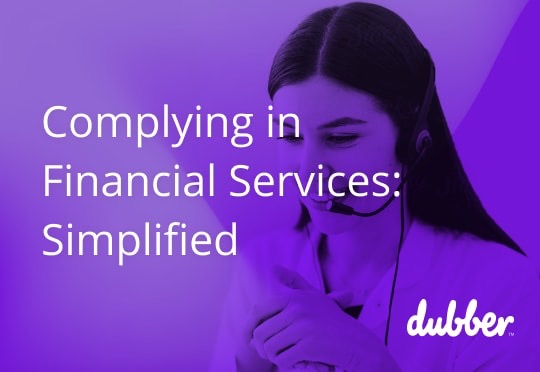
1. Regulatory change and political uncertainty
Regulations are continuously changing and, particularly as many financial services organisations operate globally, it can be difficult to make sure that measures are in place to comply with evolving requirements. With Brexit deal negotiations continuing and the exit date rapidly looming, financial institutions who deal with clients in the UK and the EU will be facing uncertainty when it comes to compliance.
Recording information is a key requirement for the majority of financial regulators around the world. There are varying standards depending on the country of operation, such as the US Generally Accepted Accounting Principles or the International Financial Reporting Standards, meaning that recording information can use vast amounts of company resources.
The solution to record keeping compliance worries is an agile call capture service with no limits on storage. Financial services organisations can record their calls and store them for as long as they need to – keeping them for 5-7 years to comply with regulations such as MiFID II at no extra cost.
2. Data protection and cybersecurity
With sensitive information being shared with banks every day by customers, data protection is a key challenge for banks. Regulations such as the GDPR can result in fines of up to 4% of annual turnover for firms that fail to comply with data protection laws. Not only is data protection a legal requirement, banks can leverage their information security policies to engender trust in their customers.
Cybersecurity is at the forefront of the minds of risk and compliance managers, as they work to protect the vast amounts of sensitive information that financial institutions process. Further regulations such as PCI DSS and SOX require formal data security policies, communication of data security policies, and consistent enforcement of data security policies.
Advances in cloud technology can really help with the burden of compliance, with secure and geographically redundant data centres ensuring the safe processing and storage of consumer conversations. Data can be encrypted and access can be restricted to reduce risk.
Data also provides a unique opportunity for financial service providers to learn more about their customers and improve products and processes within their organisations. The unstructured data held within customer communications can initially seem inaccessible, but with voice AI it can be transformed into actionable intelligence that can fuel business decisions.
3. Fintech disruptors
Established banks are beginning to feel the threat of newer, more agile players within the financial services industry. The introduction of open banking in the UK has made it even easier for fintech disruptors to lure customers away with easier switching and more competitive offerings. This initiative was introduced by the government to encourage competition in an industry that has previously been dominated by a handful of powerful institutions.
Traditional banks are realising that they will need to innovate, and embrace technology that will allow them to become more agile. This extends to compliance, where technology can facilitate adaptation to changing requirements and create a more proactive approach to risk mitigation. This forward-thinking culture of compliance utilises AI to perform in-depth data analysis to provide insightful reporting that can identify and minimise risky activity. With automated reports and customisable alerts, supervisors and managers can reduce undesirable behaviours without increasing their workloads.
Embracing the potential of technology gives financial institutions the ability to differentiate themselves from the competition and win the trust of their customers by demonstrating their commitment to risk management and data protection.
4. Minimising risk
Regulations put on financial services organisations largely focus on transparency in their aim to increase trust and protect consumers. With adequate data gathering and surveillance capabilities, firms can identify and minimise violations such as insider trading.
A recording solution that can track and timestamp conversations, and allows for quick and easy search and retrieval of information will give firms the upper hand in compliance and risk management. Voice AI that can detect keywords and send tailored alerts to management makes it quicker and easier to detect and deter suspicious trading activities to prevent penalties from regulators.
Talk to a member of the Dubber team to find out how our services can ease the burden of financial compliance.

Regulatory drivers such as MiFID II and the Dodd-Frank Act require the secure and accurate recording and long-term storage of conversations relating to financial transactions. Where once on-premise call recording that captured conversations made on fixed lines in an office were a partial, and expensive, solution to this directive, with many people working from home, they no longer offer full compliance coverage.
While web- and app-based recording may seem like a solution to this problem, these options can come with risks of insecure storage and can’t provide the instant discoverability required by regulators. The only way to record every conversation from a dispersed workforce is to find a solution that can record every call, no matter where it takes place.
Unified Call Recording enables organisations to meet compliance requirements by collecting and storing voice data at scale and across devices and channels. By recording directly from the service provider network, organisations can record calls not just from fixed lines but from mobiles and any IP connected device. It doesn’t matter where in the world employees are working from, the company can rest assured that their conversations will be accurately captured and securely stored in the cloud.
All voice data is protected with AES-256 encryption and is stored in regional data centres for sovereignty. There aren’t any limits on recordings or storage. Businesses can capture as many minutes of calls as they need and store them for as long as their compliance requirements specify. They can even set a limit on their data retention so that recorded calls are automatically deleted. This prevents businesses from holding on to old or outdated data for too long and ensures the information they have is relevant.
Compliance box ticked: what’s next?
Financial services organisations are looking for a solution that will reduce the cost and complexity of meeting compliance requirements. But as well as ticking the box for the compliance basics, they want to go above and beyond to ensure that their organisation is operating effectively.
What if their call recording solution could do more than just capture conversations? What if it used AI to allow a business to conduct its own investigations into employee conduct? What if AI transcribed each and every call, allowing users to search for a recorded conversation by a single word that was spoken?
Automation is the future
When every recorded call is transcribed, there is an accurate record of what was said that can be referred to in the event of an investigation. But this is just the beginning. Transcription can automate processes that can enable a more proactive examination of company practices.
Organisations can identify keywords that indicate policy breaches and create early warning systems through automated alerts for such keywords. Emails can be sent to supervisors to warn of suspicious activity and, through an API, these actions can trigger processes in existing business applications. Transcription also facilitates keyword search, allowing users to find conversations based on a word spoken during a call – just like an email.
Transcribing speech to text also opens up huge opportunities to learn more about an organisation’s customers and also their internal processes. Voice data can be exported to be integrated with other business data to get a 360º view of a company – allowing for analysis within business intelligence tools to identify trends and opportunities for improvement.
Get in touch with a member of the team to find out how financial services organisations are getting the compliance and performance edge with Dubber.
James Slaney is co-founder of Dubber and General Manager of Product.
1. How do you think data and analytics will change the way customers interact with their clients?
With the impacts on business we have seen from COVID, encouraging customer loyalty is more important than ever. Companies that want to provide consumer-centric products and services will be looking to analytics to inform every business decision.
An example of how voice data can be used is through sentiment analysis. Calls can be analysed to detect customer emotions, allowing businesses to use this data to identify opportunities for cross-selling or new sales, as well as identifying potential churn risks. By distilling vast amounts of call data, businesses can gain a more accurate reflection of general customer sentiment than, for example, customer satisfaction surveys. Understanding these potential risks and opportunities can be lucrative for businesses who want to put the customer at the centre of every business decision.
2. What are the major compliance issues impacting the use of call recording applications?
With regulations governing a variety of industries, and businesses increasingly operating globally, compliance is a key issue for many companies. Secure storage is a top priority when complying with regulatory frameworks, and this needs to scale to meet the 5+ year requirements of legislation such as MiFID II. Businesses can struggle to meet the high demands of regulations. On-premise solutions, and even some cloud providers, are unable to offer long-term storage that ensures businesses are compliant. Concerns about running out of storage space, data leaving the European Economic Area, or a lack of functionality such as audit logging, can mean businesses risk fines. When businesses are looking for call recording solutions, they need to ask themselves, does the call recording solution offer unlimited storage? Does it comply with global compliance standards? Can it provide back-up storage options for outages? How easy is it to set up? Is recalling specific records easy so the cost of ad hoc requests is kept to a minimum?
3. Where do you see the biggest opportunities for resellers today?
As Enterprises are seeing the importance of data, it’s possible for them to collect more data than they know what to do with or can practically use. Limited time and resources mean that, unless they are given the right tools to help segment and analyse data, any sustainable, repeatable business value that can be gained from data will be lost. This is where we see the biggest opportunities for resellers today: being a trusted advisor for businesses looking to access and understand their data. Analytics, powered by AI, offers businesses a way to extract value from the huge amount of data available to them: allowing them to improve their decision making through actionable insights.
Our most successful partners are able to show customers how an open API can allow for integrations with other products – like Salesforce – to make finding the value in data even easier. By demonstrating integrations with data visualisation tools such as Tableau, even customers with little experience of data science quickly see how easy it is to spot trends in the data they are collecting and how these can inform their business operations.
4. What kind of innovations would you like to see in 2021 and beyond?
Voice data and AI will become a natural part of understanding what is happening in every corner of a business – listening to phone calls is going to seem as outdated as receiving a fax. Advances in language technology will give us the ability to find meaning in voice data in ways that seemed like science fiction only a few years ago. Insights from voice AI are not only something that will drive better business decisions in customer-facing businesses and call centres. We will be able to use deep insights from calls to places like emergency services and COVID-19 helplines to help with decision making that will directly affect people’s lives.
5. Where do you see the future of voice data intelligence?
In today’s data-driven world of business, voice data is becoming more and more important. As organisations begin to realise the power of voice data, they are turning to unified call recording to help them harness that valuable call data they receive every day. Significant development has been put into voice-to-text transcription, and this is only going to improve as automatic speech recognition models are trained to understand more languages, dialects, and accents. It’s not only what was said that is important, but how it is said. Sentiment and tone analysis are areas of further development, allowing businesses to truly understand how their customers feel about them. These innovations give rise to a whole host of business use cases: from churn prevention through the early detection of unhappy customers, to product development by identifying trends in customer needs.

Aragon Research has recognised Dubber as a global conversational AI leader, with a report detailing Dubber’s visionary and innovative approach to using AI to generate conversational intelligence.
Dubber has been recognised as a “Hot Vendor in Conversational AI” in the 2021 report by Aragon Research, Inc. The Conversational-AI market is experiencing significant growth and is expected to record a CAGR of 30.2% (through to 2024) driven by the needs of businesses of all sizes for greater customer, people and revenue intelligence.
The report identified Dubber’s ability to derive business value from voice data and provide easy to follow transcription and sentiment analysis of crucial conversations by sales reps, customer support personnel, and others, mentioned as standout features.
Conversational intelligence benefits
Dubber’s conversational intelligence enables both internal and external benefits for businesses.
Conversational intelligence enables revenue programs such as sales, customer success, and customer loyalty. Real-time text and speech-based insights can help sales reps improve information accuracy, productivity, streamline communication between managers and employees, and drive continuous learning throughout the enterprise.
Internally, it’s often used to promote employee engagement and performance through coaching, learning, training, assisting, and more diligent recording and archiving of important enterprise knowledge, such as the knowledge stored in meetings. When the entire meeting is recorded, critical insights and intelligence is unlocked. Meeting recording and transcription paired with insights can drive a more unified, engaged and knowledgeable workforce.
Let Dubber Conversation AI do the work
Dubber Conversational AI comes ready to run with the ability to develop AI training specific to your institution.
- Industry-leading transcription with auto-language detection
- AI-enriched sentiment, tone and emotion signals
- Automate data loss and misuse monitoring Deep-learning and ML-based policies automate the detection of leakage risks in what was said, shown, or shared. Create your own custom, company-specific policies.
- AI-powered alerts on risks move you beyond random sampling and transcript searches
- Workflow automation for automating the next best action and processes based on conversational data
Dubber offers service and solution providers, government agencies and businesses the ability to compliantly record conversations in the cloud, without hardware or storage.
Dubber Unified Conversational Recording and Voice Intelligence Cloud can scale to fit any size business and allows access to previously untapped voice data. Voice, video and chat conversations are transcribed and enriched with AI-powered insights and are available on a phone or browser.
Dubber processes billions of minutes of recorded voice data and transforms that data into intelligence for 1,000s of businesses. Dubber solutions are native to Cisco Webex, Microsoft Teams, and Zoom, and networks such as AT&T, Verizon, Telstra and Cox Communications.
“Dubber’s tremendous network of service and solution providers, as well as our partners, has allowed us to the ability to unlock the potential of conversational data into meaningful intelligence for customers,” said James Slaney, COO, Dubber. “Our inclusion in the ‘Hot Vendors in Conversational AI’ report is reflective of the power of conversational recording for business insights and certainly a rewarding recognition of the incredible year of growth and progress Dubber has had.”

If you’re a Cisco customer, chances are you’ve used MediaSense. This built-in call recorder came as part of Cisco products to capture your phone conversations.
MediaSense is nearing the end of its days. Cisco stopped selling the call recorder back in 2017 and this year will be formally ending its support for both 10.x and 11.x versions.
I’ve been relying on MediaSense, what should I do?
The official deadline for the end of MediaSense is October 31st 2020. If you’ve been relying on it to record your calls, the time is now to look for a new solution. And we’re here to help. Dubber joined Cisco in 2019 to provide Unified Call Recording and voice AI services for their Webex Calling service and we now support their UCM-C, HCS, and CUCM services.
We offer pain-free migration for all of your MediaSense recordings to our cloud platform, and the chance to upgrade to the Dubber Voice Intelligence Cloud, with no need to invest in any new equipment. We record directly from the Cisco network so all calls are recorded, whether they happen on a fixed line, mobile device, or IP connection. Our services are available on a subscription model so there is no long-term commitment required.
How does Dubber compare to MediaSense?
Plus:
- By upgrading to the Dubber Voice Intelligence Cloud every call is fully transcribed with sentiment analysis
- Customer alerts based on call content
- Compatible with Webex Calling, UCM-C, HCS, and CUCM services
The Dubber platform is efficient and cost effective: with an open API for easy provisioning and integration with other business tools such as Tableau. We have ready-to-use Google Data Studio templates, and will soon be launching a dedicated Salesforce app. Our secure and scalable cloud platform offers long-term, unlimited storage that can help with regulatory compliance – with no restrictions on the amount of minutes recorded or stored.
Once you record your calls with Dubber, you get access to our Voice Intelligence Cloud – fully transcribing every single call and enriching call transcripts with detailed information about caller sentiment and tone – even identifying seven different emotions. This data opens up the potential for businesses to gain valuable insights from their voice data, search for calls by keyword, and automate processes based on what was said during a phone call.
Try out Dubber call recording and voice AI for free
To ease the transition to the cloud, we are offering free recording migration to all MediaSense users as well as free call recording for the first 90 days. Make sure you don’t lose out on the critical function of recording your calls and contact Dubber to access the free offer.
We offer three plans to suit your call recording requirements, along with increased support services. You can stack as many licenses as you need, there are no minimums required. Each license comes with unlimited recording minutes, and unlimited storage – making it perfect for compliance with industry regulations.

Our conversations are rich with information; but this valuable voice data is lost as soon as the call ends, or is trapped within proprietary call recording solutions. Voice is the largest untapped data source for most businesses, but if it is siloed its true value is lost. This is why we have introduced Data Exporter. This easy-to-use feature unlocks the voice data of a business and allows companies to truly unify their data to create a single source of truth.
When businesses export voice data and combine this with other internal data sources, they have the potential to tap into valuable insights. This can help to: develop dashboards to visualise contact centre agent performance, monitor and report on customer experience, deliver compliance reporting, access conversational content for investigations and customer remediation, enrich CRM data, and automate workflows. This kind of data cannot be extracted from chatbots or email and so is a valuable source of business intelligence.
What can businesses do with exported voice data?
Whether you’re a huge enterprise with a team of data scientists at your disposal, or you’re a small business owner who’s more comfortable with an Excel spreadsheet, data is key to making business decisions. We give you complete ownership of the data you collect from your calls, allowing you to use it in the way that best suits your business needs.
When you export data from Dubber, you are able to view call information, including sentiment ratings, tone and emotion. This kind of data can give a real insight into customer satisfaction and provide businesses with a better understanding of how customer conversations unfold.
You can unify exported voice data with data from other areas of the business, allowing for greater visibility. This is key to making your data work for you: with no more siloing of information, you get a 360º view of business trends and can more easily spot patterns.
Businesses can use contact centre analytics tools to compare data such as call volume, IVR path, and user numbers to analyse business patterns. Data can be exported to visualisation tools such as Tableau – or to tools that users are familiar with, such as Excel.
Improve customer satisfaction
Improving customer satisfaction and net promoter score is a key driver for businesses. By continually monitoring customer satisfaction using sentiment data, businesses can work to ensure satisfaction throughout sales, service, and complaints processes. Companies can use the knowledge gained from this analysis to raise customer satisfaction levels and increase the customer retention. Using Dubber’s Voice Intelligence Cloud, businesses can display sentiment and tone analysis. When viewed alongside call themes they can see how sentiment and tone changed over time.
Improve dispute resolution
Good complaint handling reduces overall operational costs. Businesses can analyse their exported voice data to ask questions of their complaints process. This data can show if complaints have been dealt with fairly and correctly by the customer service team, and whether anything could have been done differently. Customer service teams can identify common barriers to dispute resolution, alongside the root cause of complaints. This gives businesses the opportunity to address underlying issues and ultimately reduce incoming call volumes.
Understand first contact resolution
First contact resolution (FCR) provides an overview of customer resolution across various call types and shows the related sentiment and tone. FCR rates are determined by analysing spoken content within calls to find language relating to repeat contact such as ‘third time of calling’ or ‘last time I spoke with…’. When this is exported for analysis alongside CRM data and PBX records that show multiple interactions with the same users, businesses can determine the FCR rates for their calls.
Unresolved calls also provide an opportunity for deeper analysis around root cause and the frequency with which these escalate to negative call outcomes. Analysis of these calls can provide training insights.
Inform day-to-day business decisions
As well as using voice data to look at the big picture, businesses can also use it to inform everyday operations. Customer teams can export sentiment data to CRMs to inform a more personalised approach to customer interactions. Customers who are shown to be frequently exhibiting emotions such as fear or anger could receive a different approach to those who frequently show positive emotions on calls. Calls with negative sentiment can be used as a training tool for contact centre operators to learn how to alleviate negative emotions.
Particularly at this time when many businesses are operating with a remote workforce, management may want to use sentiment analysis to check on employees dealing with an increased number of calls with negative sentiment ratings.
Not a data scientist? No worries
Not everyone has the time or resources to undertake huge data science projects using expensive software. If you’re new to data science, we have you covered with our own set of templates for Google Data Studio. They will help you take your first steps into the world of analytics and business intelligence.
Available as standard for all Dubber AI plans
All businesses with Dubber AI plans will be able to use the Dubber API to export recording data up to a range of 31 days. Exports are presented as a csv spreadsheet where each row represents one recording, and include voice AI information. This allows data from recorded calls to be extracted in bulk. The new feature is included as standard through the API.

Voice data has been a long ignored or inaccessible pool of business insights critical to addressing compliance, customer experience and business performance. The inability to convert voice-based interactions internally and externally has reduced telecommunication carriers to providing connections. This has precluded them from the data race and using AI to develop new service offerings based on big data sets.
Deloitte found that, in organisations adopting AI, more than 80% of business leaders see AI as “very” or “critically” important to their business success. Some researchers have even predicted that AI could become a “general-purpose technology” – one that will transform every industry and society at large.
The power source of AI is data, and telecommunications service providers have a great opportunity to offer businesses access to this AI fuel. With 92% of all customer interactions happening over the phone, the data being created is vast – but it’s not being used to its full potential. Traditionally, if calls have been recorded at all, the capture of voice data has been limited by on-premise storage. Any data that has been recorded has been siloed and represents only a fraction of the total communications taking place. Not anymore.
Don’t leave voice data out
Businesses surveyed about their AI priorities by PWC stated that their top data challenges were identifying, collecting or aggregating data across their organisation, and integrating AI and analytics systems to gain business insights. Unstructured data, such as recorded calls, was seen as a problem to collect or make sense of. Only 18% of businesses take advantage of this data as part of their AI strategy. This is a significant opportunity for telecommunications service providers to give businesses access to data that has traditionally seemed out of reach.
It is precisely this kind of data that can give a comprehensive view of customers. Executives who say unstructured data is one of the most valuable sources of insights are 24% more likely to have exceeded their business goals, according to a survey by Deloitte. Unfortunately many companies are discovering that understanding customer journeys and making tailored offers is difficult to achieve with traditional premise-based analytics.
Telecommunications service providers have an opportunity to take the conversations happening on their global networks and deliver value from them. Currently telecom networks passively enable the exchange of data, when they could be actively enabling access to the value held within that data. If they don’t act fast, OTT players may make them redundant by building their own networks – Google and Facebook already are.
The call recording backbone for telecommunications
We created Dubber to empower service providers and businesses alike. By recording calls directly on the network, we enable service providers to provide recording and voice AI services for businesses of all sizes. By building our platform in the cloud, we have reduced the cost of data storage by removing the need for expensive proprietary software and hardware.
It’s not just our cloud storage and processing opportunities that make our platform so appealing, but the data modernisation capabilities. We can migrate existing data from on-premise solutions to the cloud to unify the voice data of a business and enable 360o analysis. Data modernisation offers substantial cost savings. 32% of businesses surveyed by Deloitte identified cost and performance as the top drivers for moving to the cloud, with 91% listing cloud platforms as their primary data storage method. Of the remaining 9% that stored their data on premise, nearly all planned to migrate to the cloud.
Removing the technical barriers to AI insights
Making voice data as accessible as possible is one of our passions. Not only do we democratise call recording through our cloud subscription service, with Dubber AI we also make it easy to extract the data held within calls for analysis. Businesses can easily view call information – including full transcripts, sentiment ratings, and tone analysis – to get a real insight into customer satisfaction.
You don’t need to be an expert in data science. Small businesses will be taking their first steps into the world of data and AI and won’t have the technical skills or budgets required to hire data scientists. With the Dubber platform, they can access easy-to-use services (including ready-to-use Google Data Studio templates) that address these shortfalls: all without having to make big upfront investments. By giving access to AI as a service we’re giving all companies the ability to use it now.
And by partnering with telecommunications service providers around the world to democratise access to voice data, all a business has to do is switch the service on.

Keeping compliant with data protection laws, such as the GDPR, PCI DSS, or information security standards like ISO 27001, requires not only securing data effectively, but also deleting the data when you no longer have a legitimate purpose to store it. With Unified Call Recording from Dubber, you can ensure that recorded calls comply with data retention periods, and are secured effectively. The latest update to be released to the Dubber platform includes the option to set a retention period for recordings, allowing companies to comply with data protection legislation more easily.
Why do I need data retention periods?
The retention period is the length of time you store customer and supplier records for business or compliance purposes before the data is deleted. Erasign data after it is no longer required is important as it reduces the risk of keeping unnecessary, inaccurate, or out of date information.
While the General Data Protection Regulation (GDPR) doesn’t set out any specific minimum or maximum periods for keeping customer and supplier data, it does state that you must keep data no longer than is necessary for the purpose you obtained it for.
If you process debit or credit card information, you may be subject to the Payment Card Industry Data Security Standard (PCI DSS).
Similarly, if you intend to comply with ISO 27001, the international standard that describes best practice for information security, you must take note of its requirements. These compliance requirements will dictate what information must be included in your information security policy and the rules you should follow. A simple data retention policy will address: the types of information the policy covers, how long you are entitled to keep the information, and what you should do with data when you no longer have a legitimate purpose to store it.
What are data retention best practices?
- You must not keep personal data for longer than necessary
- You need to be able to justify how long you store personal data. This will depend on why you are storing the data
- You should have a data retention policy that sets standard retention periods, in order to comply with documentation requirements
- You should periodically review the data you hold, and delete or anonymize it when no longer required
- In some jurisdictions, individuals have a right to erasure and you should be ready to delete data on request
- Personal data should only be retained for longer periods if it is for public interest archiving, scientific or historical research, or statistical purposes
How do I set a data retention period?
Data protection regulations around the world require enterprises to ensure that personal data from their consumers is deleted after a specified period. These requirements will vary by region and industry. With retention periods, businesses can customise their plan so that recordings are deleted according to their exact compliance needs. Retention periods can be altered as required so that organisations can adapt to changing regulations.
While your voice data is stored within the Dubber platform, you can be sure that the security measures will protect against any data breaches. The platform offers a level of encryption and reliability not seen in on-premise storage, with significantly reduced risk of damage, theft, or tampering. Alternative approaches to call recording such as in-app recording means a lack of control over who has recorded calls, where they are stored, and who has access to the voice data. Enterprises must ensure that their information security policy protects against this kind of risky behaviour.
What about complying with financial services regulations?
Legislation such as MiFID II in the EU requires financial services organisations to record calls containing financial advice, but these must be deleted after 5 or 7 years, depending on the country. With the new retention periods feature, financial institutions can set a maximum length of time for recorded calls to be stored within the Dubber platform. Once this period has been reached, these recordings and their associated AI data will automatically be deleted.
Do I need a special plan?
Retention periods are available as standard on our Call Dub and Dubber AI plans, at no additional cost, and are enabled as default within account settings. These services are both all inclusive, with a full range of recording features and unlimited storage, retention and minutes per month: ensuring no worries about running out of space. Dubber AI comes with added voice AI functionality, including transcription, sentiment and tone analysis, and customisable automated alerts.
To find out more about how Dubber’s Unified Call Recording is helping businesses meet their compliance requirements, click here to chat to one of our team.

We’re very excited today to be announcing general availability of Dubber Unified Call Recording and voice data intelligence on Telstra’s TIPT, Liberate and SIP services in Australia.
Telstra TIPT, Liberate and SIP have stood out as some of the most reliable and efficient ways to connect with customers. Now Government and Enterprise can double the value of those connections by putting the content in every call to work – improving customer experience, mitigating risks, and improving productivity.
For the first time, companies in Australia can easily purchase cloud based call recording across any connected device – including mobile, for their entire business, with no expensive hardware costs, software to install or costly storage to manage.
Legacy Enterprise call recording has traditionally been limited to call centre environments, doesn’t scale easily and only captures a small number of the calls made. These limits made it difficult for Enterprises in regulated industries to comply; critical activities such as customer sentiment reporting and knowing your customer couldn’t occur in a timely way; and integration with applications and Big Data were restricted. Covid-19 further exposed its weaknesses as businesses missed capturing and converting calls from mobile devices and a dispersed workforce.
Now, with Dubber’s infinitely scalable cloud platform and Voice Intelligence Cloud being integrated into Telstra’s TIPT and Liberate products, companies can turn on call recording on demand, for any user. Flexible plans mean they can scale-up or down easily, and it works for sole traders, SMBs and the largest of Government and Enterprises.
This opens up whole new opportunities for businesses to understand voice data and gain valuable insights into their business. Want to understand call sentiment for every branch location in a bank, or franchisee outlet? That can easily be done using Dubber’s in-built sentiment analysis tools. Want to have a transcript of important customer calls integrated into Salesforce? Easily done as a standard part of Dubber’s service. Running a medium sized financial planning firm and need to record landline and mobile customer advice calls for ASIC record keeping and compliance purposes? We’ve got you covered.
Once a company starts deploying “whole of business” call recording, they can also take advantage of valuable insights from their voice data using advanced artificial intelligence and speech analytics tools. Want to trigger notifications every time a competitor is mentioned in a voice call inside the business? How about triggering a direct mail campaign offer to a bank customer every time a customer mentions “credit card” on a voice call? All of this is possible and much more when businesses are able to use the information inside their company from voice data.
And there are great opportunities for Telstra channel partners too. We believe that Dubber cloud call recording services can drive significant new demand for TIPT, Liberate and SIP services. Liberate in particular, is the first mobile service in the country that will have network layer, integrated call recording available.
We call this the “democratisation” of call recording for businesses and individual users. It will completely change the call recording industry in the months and years ahead.
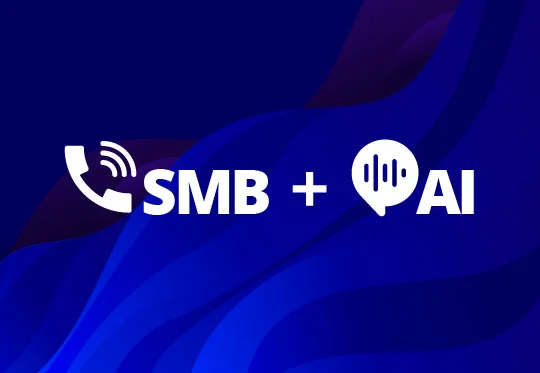
Everyone should be able to access their voice data – no matter the size of their business. Unified Call Recording and voice AI doesn’t need big budgets for up-front spending, or a big office to store bulky on-premise recording equipment. Even small business owners can see great return on investment when they start recording their calls.
1. Gain greater visibility and easily resolve disputes
Phone calls remain the dominant form of business conversation. Email, chat, and messaging are all good for quick transactional communications but, especially with the increase in remote working, the most important conversations happen on voice or video calls. Unfortunately the data from those conversations is lost as soon as the call ends.
If the call was recorded from your service provider network (with no hardware or software to install), it could be replayed from anywhere, you could review a full transcript, and receive alerts and reports on customer satisfaction based on the sentiment of calls.
Imagine you are Chris, who has run his building business for decades and is slowly handing responsibility to his two sons as he edges towards retirement. He still wants to keep track of his team and their jobs as he trains the new company directors and sometimes worries about who has committed what and at what price.
By recording conversations across all company phones, Chris has greater visibility while letting his sons take leadership over the business operations. Easy to digest call transcripts allow him to quickly assess upcoming commitments and sentiment analysis shows how happy customers are. Chris can even search by keyword for specific jobs and set up alerts for negative sentiment to ensure that any unsatisfied customers are followed up with.
While call transcripts provide Chris with peace of mind, the rest of the team also benefit from having proof of their conversations. When it comes to final invoices, they have the reassurance of knowing exactly what was agreed between them and the customer and are protected in the case of any disputes.
2. Train staff in proven sales techniques
The phone is one of a sales rep’s most important tools as they build their relationship with existing customers and nurture leads towards a sale. Sales people hone their pitches and techniques to a fine art and adapt their messaging depending on the product and the contact. In an ideal world, they’d be able to pass this knowledge onto new team members, but this can be difficult unless they listen into every conversation. By recording calls, sales leaders can isolate successful sales pitches and use these as the basis for staff training.
Alex is the owner of a tech startup that is focused on driving growth. Alex has recently employed a number of new sales staff and is keen for them all to get behind the company messaging with effective sales pitches that turn leads into customers.
By recording calls, Alex can repurpose conversational content for coaching new team members. Sentiment analysis of recordings can identify happy customers, and this data can be cross-referenced with the status of leads and deals to find the top performing messaging. This data also makes it easy for Alex to measure the achievements of the team and reward their hard work.
3. Improve customer experience through data-driven insights
Salesforce is the source of truth for sales people, who use it to track their interactions with their customers. Imagine if those interactions were available within Salesforce itself. You could recap a conversation, refer to a transcript, and see who else at the business has spoken to your contact and know exactly how they feel about the brand and at what stage of the purchase journey they are at.
Charlie owns a fashion brand and has a sales team that works with department stores and online retailers to stock the brand. Charlie is interested in how data can inform business decisions but is a complete beginner when it comes to data science. With a free Google Data Studio account, Charlie can use templates to see reporting from sales calls and get a quick insight into how the team is performing.
By integrating recorded calls with Salesforce, Charlie can see a more granular view of sales interactions. Sentiment analysis can give a report of customer satisfaction at a call level, while Charlie can also set up reporting for how wholesale customers are feeling about the brand by week or by month. One staff member might spend more time on the phone than others, and by viewing this data alongside their sales performance Charlie can see that these longer conversations build relationships with customers. By applying this knowledge to the rest of the business, Charlie can improve customer retention.
4. Reduce churn with customisable automated alerts
Call recording is vital for legal firms to store a secure record of their conversations with clients. But these calls could provide valuable insights rather than being locked away with no further action. The data held within these conversations could provide the information required to increase client satisfaction and loyalty.
Ruth runs a family law firm, with her two daughters employed as divorce lawyers. Ruth spends a lot of time trying to win big clients and maintain good relationships with her existing clients. She wants to make sure that the firm is providing excellent service to keep her clients happy and loyal.
With automated alerts, calls are automatically flagged for review. Ruth can set up custom parameters for notifications, either via email or to automate processes in software such as a CRM tool using an API. She might want all calls with negative sentiment to be sent to her inbox so she can check whether there is anything she needs to follow up on, or there might be a particular client she is worried may leave in favour of a competitor and so set an alert for any calls to or from their number.
Call transcripts provide a simple and easy way to review key conversational content and detect unhappy clients and Ruth can even review these when she is at home, or travelling between client meetings. With her secure login and specific permissions, she can access calls from any location or device.
5. Stop taking notes with instant call and meeting transcripts
Dispersed workforces are more common now than ever before, and communication is being put to the test. Sharing information with team members via email and Slack can lose nuance and tone but involving a huge team in client conversations can be unwieldy and lead to interruptions and sidetracking.
Robin is the owner of a content agency with a roster of freelance copywriters, graphic designers, and video creators. Robin spends most of the day meeting clients to get a detailed brief of their needs and chooses the appropriate member of the team to create the required content.
By recording client calls and meetings, Robin doesn’t need to take notes and can really be in the moment with clients and have time to think and ask all the right questions – safe in the knowledge that a full transcript of the conversation will be waiting. Working with a dispersed workforce, Robin relies on being able to share details of jobs with the team of content creators. With secure sharing, conversations can be accessed by the freelancer undertaking a job so they know exactly what is required.
All of this is possible with Dubber. Are you a small business owner thinking about getting call recording? Speak to a member of our team today for advice on the right subscription for you.
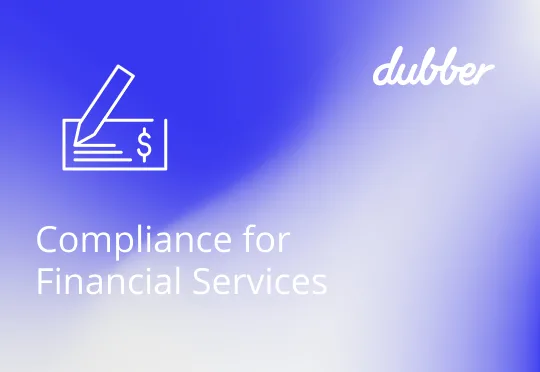
Any business in a highly regulated industry will understand the extra compliance measures they need to take to ensure they meet the required standards.
This is particularly true in the financial services industry. With more than 80% of business interactions being voice, businesses place themselves at risk if these crucial conversations are not properly captured. Customer disputes may take longer to resolve leading to customer’s losing trust in their financial institutions, expensive lawsuits, and brand damage.
But how can businesses efficiently and seamlessly prevent many of these issues escalating and damaging reputation, regulatory fines, and worse?
The answer is Unified Call Recording (UCR) and voice data analytics.
UCR allows businesses to meet compliance mandates by implementing Dubber into their telephony and UC systems. Here are five ways that Financial Services can use Dubber to mitigate any compliance risks to their business.
1. Fraud detection – While financial institutions have regulations in place to detect inappropriate or fraudulent behaviour, UCR and voice analytics provides them with a holistic overview of all customer interactions across the business. Breaches of policy can be alerted immediately. Investigations conducted using real-time search. Insightful call transcriptions provide the ability to analyse these interactions for any discrepancies or anomalies in behaviour.
2. Know your customer (KYC) – Call recordings provide a full record of a financial institution’s dealings with the customer, satisfying the major criteria of correctly identifying the individual customer or entity. Dubber features such keyword search allows Team Leaders to audit these calls to ensure that proper KYC procedures were adhered to when dealing with the customer. Dubber’s sentiment analysis also provides businesses with an understanding of how a customer feels about their business helping them to modify the way they service that customer.
3. Increasing transparency with auditors and regulators – Call recording not only benefits clients, but also financial advisers, and the corporate bodies who regulate the industry. Dubber’s API’s enable financial adviser’s to automatically transfer call recordings to their relevant client files, eliminating the need to manually take notes and ensuring all information pertaining to that client is held in the one file. This allows internal compliance teams to conduct audits and investigations more efficiently by allowing them to view all customer interactions in the one file.
4. Acting in the client’s best interest – Any institution providing financial advice must act in the client’s best interest. Unified Call Recording safeguards both the client and the adviser, ensuring any issues of miscommunication or claims of inappropriate advice are eliminated and client disputes can be resolved faster. Dubber’s Legal Hold feature also protects both the business and the customer by ensuring that selected call recordings can never be deleted, further helping businesses with client disputes.
5. Client data management – Local Privacy Laws may specify that businesses only hold on to customer data for a specified period of time. Dubber’s data retention feature allows businesses to comply with their local privacy laws by allowing call recordings to be automatically deleted after a specific period of time. This ensures businesses are only storing relevant information, and not unnecessarily holding on to customer data, minimising risks for both the business and the customer.
Dubber’s Unified Call Recording and Voice Data Intelligence has a myriad of use cases for any heavily regulated business. Schedule a time to meet with a Dubber sales representative to learn more about financial services applications.

Dispersed workforces, remote call centres, and increasing customer and employee connections across mobile devices. These are just a few of the impacts of COVID-19. Hallway conversations, listening in, and on premise systems once gave leaders some insight to the conversations taking place between employees, customers, and suppliers. For many that has become difficult, if not impossible. Costly and limited on-premise call and conversation capture can’t keep up. A move from legacy call recording to the cloud has become a priority.
With a remote workforce, enterprises are asking how to capture crucial conversations. The number of IP connections has grown rapidly with more calls occurring remotely than on premise. However, regulatory demands remain in place: requiring secure, long-term storage of calls. Enterprises are looking for keyword reporting, sentiment analysis, and accurate and accessible transcriptions to quickly view call data, and receive custom alerts.
Accelerating to the cloud
This change is reflected in the broader shift to cloud-based solutions. Where this was once part of a longer-term digital transformation strategy, it has now become accelerated. 93% of IT decision makers are moving their cloud adoption programmes forward. Budgets will be shifted towards cloud solutions that facilitate our new way of working, with 52% seeing an increase due to the pandemic.
Optimised for remote work
We created Dubber to enable any business conversation to be captured and converted to actionable insights, no matter where it takes place. We couldn’t have imagined a scenario like COVID-19, where a dispersed workforce would make cloud call recording so critical.
With automated provisioning and no need for on-premise equipment or management, we make it easy for businesses looking to move to the cloud. We can even migrate historic recordings to cloud storage to ensure minimal risk and disruption as this change takes place. From then on, businesses can be assured that their communications can continue as normal, no matter where their employees are working from.
Business insights from a dispersed workforce
While our cloud call recording means that compliance mandates can still be met regardless of where staff are working from, this is just the beginning. Our voice AI is where businesses see real value. They are identifying opportunities to reduce churn, sharpening investment decisions, and improving the quality of conversations with customers. All this from the data held within their voice calls.
Four voice data imperatives
- Call recording isn’t the answer. It’s an answer, but not the answer. Voice data remains one of the great untapped opportunities in the enterprise. To unlock the data within is where the answers lie.
- AI isn’t just a convenient buzzword. When talking about AI, most call recording vendors are referring to transcription. This is just the first step. The real imperative at the heart of Dubber is using AI to enable advanced analytics, workflow management, sentiment analysis, and more.
- Break free of application, storage and device silos. Legacy call recording platforms imposed high-costs, limited storage, and restricted call capture. This only gave enterprises a partial view of what was happening, and locked data into proprietary dashboards. Our open API, data exporter, and application integrations allow you to use call data across your business.
- Secure your voice data. We capture voice data at the network level, and secure it with market-leading technology. Recording to local storage or application clouds outside of your control is high risk. Your voice data is as important as any other data, and should be protected.
The voice data revolution is just getting started. Getting your voice data strategy right today sets you up for long-term success and will help bridge the distance created by COVID-19.

Dubber Annual Report 30 June 2020

Dubber to acquire CallN

Proposed issue of securities

Dubber goes live on Cisco Global Price List

Dubber raises $10m

Now more than ever, businesses are moving towards agile workforces that aren’t tied to a location or device. Infrastructure and operations leaders are looking to create perimeterless workplaces that enhance operations while maintaining high security standards.
As we have seen over recent weeks, digital business requirements have accelerated the adoption of cloud services in order to support remote workers. Cisco’s video-conferencing Webex service registered a record 324 million attendees in March, with usage more than tripling in the APAC region. With workers switching from office PCs, to laptops in their home office, to smartphones or tablets in their living rooms, businesses need to ensure that they can do their job, no matter the device. This changing work style is described as a perimeterless workplace.
Mobile access to business tools require appropriate security precautions to ensure that access to information is controlled. With users transitioning between devices, networks, and applications, it can be difficult to maintain a seamless experience. By migrating to the cloud, organisations can enable these new ways of working without the need for local networks or VPNs and still maintain security standards. The adoption of cloud services allows users to be productive across a range of devices.
Removing perimeters with the cloud
Dubber cloud call recording and voice AI has been designed with remote work in mind from the very beginning. We connect to service providers directly through their networks: capturing calls directly from the source and securely storing them in the cloud, with no need for any on-premise equipment. With no up-front investment required, companies can access our call recording and voice AI services on an affordable monthly subscription. Businesses of all sizes can connect to our services through their telecommunications provider, with no minimums to prohibit smaller firms or self-employed workers. With global data centres, recorded calls are protected by the latest cloud security protocols while maintaining data sovereignty. Not only can calls be captured across fixed-lines and mobiles, with the appropriate permissions they can be securely accessed from any device or location.
Access and security permissions
In order to ensure information security, access management must be put in place for remote workers. Traditionally, access to data may have been restricted to internal networks within offices or corporate-owned devices. Within a perimeterless workplace, access is granted to specific users through authentication, authorisation, and single sign-on.
Within the Dubber platform, permissions settings and team structures are put in place to restrict access to recorded call content. Depending on the permissions status of the user, they may be able to listen to no call content, only their own calls, or the calls of their team. You can read more about our security practices on our security page.
Application integrations
Users working across devices and locations expect a seamless experience. They want to be able to use the same applications wherever they are working. This is why we made the Dubber portal available to use as a mobile app, desktop app, or through a web browser. Our open API also allows for integration with existing business tools, allowing recorded content to be accessible from applications that users already feel comfortable with. Integrations with CRM systems enable organisations to create detailed customer profiles with recorded calls and their transcripts stored alongside other information.
For more information on how our cloud services can be implemented across a remote workforce, talk to one of our team today.

Unifying your business communications is more important than ever before. With the COVID-19 pandemic disrupting working practices, and telecommunications services providers such as Telstra beginning to disconnect older technologies such as ISDN services in Australia, many businesses may be thinking about migrating to a scalable unified communications solution in order to remain connected.
It is expected that cloud communication solutions will replace services such as ISDN, offering significant savings and flexibility for businesses. Voice services will be easier to manage remotely, and the same communications can be deployed across multiple locations for greater integration and resilience. Connecting through the cloud, rather than physical phone lines, frees employees to work remotely. Cloud solutions also allow for omnichannel communications, which are particularly important for businesses as customers increasingly expect to be able to contact companies by a variety of methods.
What is ISDN and why is it being shut down?
The first telephone networks, built in the 19th century, were made of copper phone lines that sent voice data. This technology makes up the public switched telephone network (PSTN), which has been used ever since. The integrated services digital network (ISDN) uses these copper wires to digitally transmit voice and data.
In Australia, the National Broadband Network (nbn™) is superseding older technology such as ISDN. The nbn™ is a nationwide project funded by the Federal Government. The project aims to provide every home and business with fast and reliable internet with the intention that any new telephone networks will now be IP (internet protocol) based. While this means that traditional devices that do not support IP services will not be compatible, there are many benefits to embracing this new technology. Similar initiatives are taking place around the world.
Will my business need to change phone system, and what are the options?
Businesses with ISDN phone systems will need to make some changes, but these needn’t be drastic. In fact, the shutdown can be seen as an opportunity to upgrade organisational communications and save money at the same time. A transition to next-generation communications has the potential to increase flexibility as well as introduce greater functionality.
Many existing phone systems are compatible with SIP (session initiation protocol) solutions, which also allow organisations to add lines as required without the need for additional infrastructure. SIP channels, sometimes called SIP trunking, are easy to set up: the only requirement is a reliable internet connection with the bandwidth to support voice services, creating a virtual telephone line. A hosted IP phone system is a commitment-free alternative to an on-premise phone system. These solutions use an internet connection to provide the usual functionality of a phone system, without the maintenance charges associated with an on-premise system.
VoIP (voice over internet protocol) systems are hosted in the cloud, and are easy to install and maintain as they don’t require physical hardware. These systems use the internet to carry voice data, without on-premise equipment. VoIP doesn’t even require physical phones: softphones can transform a computer into a phone using software.
Future proof your business
While moving your communications to an entirely new solution may sound daunting, the benefits well outweigh any short term (and mild) inconvenience. Modern voice technology like SIP and VoIP can offer huge savings, as well as greater flexibility, scalability, portability, and security. Soft clients on devices enable workers to take all the capabilities of the office with them, wherever they go. Where traditional phone lines required installation in new locations, with IP-based services telephone lines can be easily added and removed, and can be of a higher quality. This future-proofs businesses for any growth, as handsets and portable devices can be connected instantly.
VoIP systems enable mobility through single number reach, allowing users to be reached on one number across multiple devices. VoIP can also incorporate a range of communication methods, such as video conferencing, email, and instant messaging into one solution. This consolidation of communication is referred to as unified communications (UC). Unified communications can bring cost savings and facilitate increased productivity, with users able to work from any location with an internet connection.
VoIP also provides greater potential for business continuity, as it’s not tied to any on-premise hardware. Calls can be diverted easily between locations in case sites are unreachable. UC that is completely hosted in the cloud is referred to as unified communications as a service (UCaaS). A whole range of communication and collaboration applications and services can be deployed through the cloud, and consolidating these services can often simplify billing into a fixed package; making costs more predictable.
To find out more about the kinds of services we offer that can be integrated into a UCaaS solution, get in touch with a member of our team today.

Dubber and Verizon align to add Call Recording and Artificial Intelligence (AI) Service into Verizon Virtual Communications Express (VCE)
How often do businesses ask their customers what they want? The people who use products and services are a valuable source of information for product development or business direction. Many businesses spend thousands of dollars on external market research, but what if companies already had these customer insights? Customers call a business for two main reasons: when they want answers, and when they are unhappy. These are rich sources of insights for companies looking for ways to improve their business. If organisations were to turn to their customer calls, they might uncover the secrets to success.
Increasing self-service
Customer phone calls are a great place to start when trying to understand what people want or need from a business. Aggregating the key themes from this call data allows businesses to cater to these needs through other communication channels. Data analysis of customer calls can identify common questions that can be answered on the company website or even programmed into chatbots, leaving more resources to deal with more complex queries. With huge amounts of voice data captured within phone calls, there is a rich mine of untapped insights that can inform FAQ pages and anticipate common queries through statistical analysis such as topic modelling.
Preventing complaints
Another area holding great potential for business improvement is customer complaint calls. If businesses understand why customers are calling they can prevent those issues. With Dubber AI, calls are rated by sentiment — giving a positive, negative, or neutral score for each section of the conversation and the entire call. Businesses can isolate negative calls to better understand the concerns or issues that customers may have with their products, services, or experience. Common problems can be identified and prioritised for improvement, preventing future complaints, leading to happier customers and reducing churn.
Dubber AI and Automated Alerts
Not only does Dubber AI help businesses learn from the historical data held within their calls and allow them to identify trends and common issues, with new automated alerts, designated users can receive custom notifications about their calls. Alerts can be created to notify users when calls with a certain sentiment rating have been made, allowing businesses to know as soon as a customer has had a bad experience so they can follow up immediately. Keyword alerts can also be customised to notify users when a specific word or phrase has been spoken on a call. Potential churn candidates can be identified when a competitor name is mentioned, and alerts can also be set up for specific callers so that VIP customers trigger a notification.
Want to learn more about how Dubber AI can identify business improvements? Talk to a member of our team.

Guest blog written by Mikka Hendra
The current global challenges put a spotlight on IT and IT services – like cloud, Unified Communications, Call Recording, anything and everything surrounding the dramatic movement of staff to home working environments.
While our team is so grateful to be healthy and still able to work, their new challenges have become convincing the kids not to use up the household WiFi downloads for TikTok and Tiger King and remembering they only dressed their upper half for Webex Calls!
Dubber continues to work around the clock to accelerate the global movement to #WorkingFromHome. However despite this global movement, our staff found themselves struggling with basic physical movement besides moving themselves to the fridge and back, while WFH.
The Management team saw an opportunity to optimise the way we worked in these new times and decided to create the Dubber Wellness Hub | Supporting physical distancing, social connection + positive WFH lifestyles.
The Hub was built and rolled out to our workforce as a social health and wellness Hub providing our team with a means for connection, mental health support and resources, general ISO tips, tricks and ideas during physical distancing for COVID-19.
This initiative saw the creation of the Dubber Wellness schedule which includes daily Webex chats by the “office e-water cooler”, online fortnightly health coach wellness coach tips with Jessica Duchesne, UberEats vouchers for a fortnightly team lunch via video, team meditation facilitated by “conscious comedian” Jeremy Carne and after checking on the corporate insurance policy, guided yoga and fitness classes by yours truly.
Along with wellness, we started a weekly themed ‘Bad Fashion Fridays’ competition, dressed in our fashion fails for the day’s video conference meetings. The team look forward to ending the week with some humour at their co-workers expense, before recapping on our Friday Happy Hour chat.
With a new focus on nurturing our teams mental and physical health from a distance, we feel our workforce is becoming closer and more productive than ever and encourage any workplaces still able to work, to rethink how your team connects during this time.
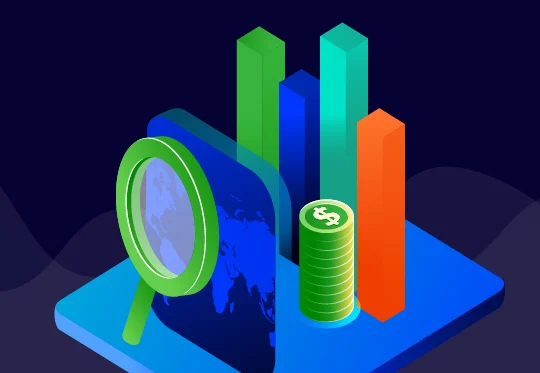
We are pleased to report significant growth for the first half of the 2020 financial year. Highlights include a revenue increase of 125% to $4.5 million, a 79% increase in end user subscribers to 122 549, a contracted annualised recurring revenue of $10.66 million, and 123 service provider agreements, of which 65 are now at the billing stage. During this period we also acquired our first Cisco Webex Calling customers and are on track to be listed on the Cisco price list this month, which will allow seamless order entry within the global Cisco partner channel.
Another highlight was signing an agreement with tier 1 US carrier Sprint Corporation. While we are still in the early stages of growth, securing tier 1 global carriers and our revenue demonstrates that our global strategy is delivering high-quality income streams.
A uniquely placed global operation
We have grown our business operations significantly in preparation for future market opportunities: recruiting team members across executive, sales, and product levels. Many of these new staff members worked closely with us in previous roles with major partners, including Cisco, BroadSoft, AT&T and Telstra, and bring with them significant industry experience. We are a global operation, well positioned to enable service providers to capitalise on the valuable asset of voice data. We believe that transcription, which forms that basis of voice AI and analysis, will become an expected standard feature. We are uniquely placed to deliver this capability to service providers.
Second half FY20 outlook
We expect strong growth in the second half of the 2020 financial year. We expect several verticals to reach the revenue generation stage. Now that our platform is embedded in the Cisco order entry system, we believe this will contribute significantly to our ongoing revenue. Last month we signed an agreement with Telstra, making Dubber available to Telstra customers in Australia. We expect this to underpin similar agreements with new carriers in 2020.

Advances in technology have facilitated a whole host of business developments, increasing efficiency and driving productivity across a variety of industries. But the benefits of such technological improvements are mostly confined to large enterprises who are able to invest in new solutions. Often small businesses face insurmountable barriers to adopting new technology, such as lack of resources, difficulty or reluctance to move away from legacy solutions, and worries about maintaining business continuity.
Future-proofing with the cloud
For service providers and value-added resellers (VARs), the small and medium business (SMB) market can be easy to neglect when faced with obstacles that prevent them from adopting new technology. However, the cloud is providing solutions that can help service providers and VARs to access this market and open up a whole new range of customers. The flexibility and accessibility of cloud solutions break down the obstacles that previously prevented small businesses from adopting new technology. Employees have grown accustomed to using the cloud in everyday life and they now expect to at work, so a move to the cloud is no longer such a daunting prospect.
Resources
Before the advent of the cloud, adopting new technology required not just a financial investment but allocation of other resources including time, trained staff, and physical space. Moving to a new solution meant investing in new hardware and software, along with installation. Deploying new technology often requires a lengthy installation process, along with specially trained staff, ongoing maintenance, and the physical space required to store any hardware such as servers.
Cloud software as a service (SaaS) solutions break down these barriers, allowing service providers and VARs to offer products and services on tailored monthly subscription plans that require no upfront investment from SMBs. Even traditional software companies like Microsoft now offer packages such as their Office product suite as SaaS. Where customers would once have bought a CD to install each new version on their computer, cloud versions can apply updates automatically and are transferable between devices. Cloud solutions require no hardware, meaning no need for specially trained staff, maintenance or storage space. Businesses can also start using the services immediately with no delays created by installation processes.
Legacy solutions
Although small businesses are known for their agility, when it comes to adopting new technology they may be unwilling to move to a different service if they have previously invested heavily in a legacy solution. Service providers and VARs could offer a compromise with a solution that enhances what they already have, without requiring a complete overhaul.
Business continuity
There are often worries about business continuity when considering adopting new technology. Cloud solutions often facilitate a smooth transition, with much shorter implementation periods and open APIs allowing integration with existing systems.
Dubber and the cloud
Dubber call recording and voice AI are great examples of how the cloud can help small businesses adopt new technology. Our services are all available on a monthly subscription, with no upfront investment, hardware, or trained staff required. We connect directly to the network to capture voice data, so businesses do not need to install any equipment on premise or worry about maintenance or storage space. We understand that businesses may not want to part with expensive legacy equipment and so we also work with businesses who want to keep their on-premise solutions, extracting the voice data for transcription and analytics. Our open API allows companies to integrate call data into their existing systems, ensuring business processes continue to run smoothly.

How well do you listen to your customers? Turns out, they could be telling you more than you think. Dubber AI has the potential to tell you exactly what your customers think about your brand and products, and even guide you to deliver what they want.
Every conversation with a customer is packed with vital information: a mention of a competitor’s name can be a prompt for the retention team, angry words can indicate product or customer service issues and might lose you repeat business, but a phone call full of kind words and thanks can show you that a member of your contact centre team deserves a reward.
Stand out from the competition
Customer service is the top differentiator between brands and the more you know about your customer, the more you can understand how to improve their experience. With Dubber AI, customer calls are transcribed using speech to text engines. These transcriptions can be stored against the customer within a CRM, when integrated with our API. This valuable data opens up huge potential to learn more about your customers. Customer service teams would have access to information from previous calls at their fingertips, allowing them to help with enquiries more quickly and easily.
Personalisation is becoming part of customer expectations as services such as Netflix offer tailored recommendations to users and Spotify creates playlists based on user listening behaviour. In the past it might have been difficult for other businesses to offer such a personalised approach due to limited data but, with the introduction of voice AI, that’s no longer the case. With call transcripts integrated into CRM systems, this allows businesses to create detailed customer profiles, enabling them to provide hyper-personalised customer interactions. This means a customer can call a large customer service centre and be directed to the agent that they have spoken to previously.
Proactive customer service
AI helps in the day-to-day running of a customer service team. Information from sentiment analysis can help managers understand trends about complaints, and train their staff to deal with common issues more efficiently. The possibilities for the future of AI are limitless: from automatic call routing to the best agent based on historical call transcripts, to proactive calming measures for customers who have consistent negative sentiment in their previous interactions.
Accessibility
Dubber AI doesn’t require in-house data scientists or machine learning experts. With our platform directly connected to carriers, introducing AI to a business has never been easier.
To find out more about how Dubber AI can improve customer service, talk to a member of our team today.

Telstra and Dubber Sign Agreement for cloud call recording and AI on Business Telephony and mobile services
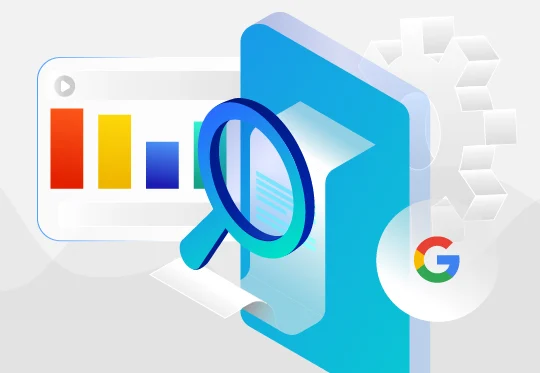
Can you tell the difference between an Australian saying ‘a boat’, an American saying ‘a bat’, someone from the UK saying ‘a boot’ and a Canadian saying ‘about’? Google can.
Here at Dubber, we have a team dedicated to expanding our AI capabilities. We know that in today’s global economy, where businesses operate from locations around the world, English speakers don’t all speak like the Queen of England (no matter how many episodes of The Crown we watch). We want to ensure that our voice AI can support businesses in their global operations, with transcription that covers not just variants of English but other languages spoken by millions around the world.
That’s why we added Google’s Speech-to-Text machine learning product to our suite of transcription engines, so that we can deliver the best transcription capabilities across the broadest set of languages and accents.
Transcription with unparalleled accuracy
Adding Google’s transcription means we can now support a wider range of languages, including Dutch, French, Spanish, German, Mandarin, Portuguese, and six regional variants of English. This will allow us to serve more of the world with our cloud call recording and voice AI. Google Speech-to-Text applies powerful neural network models to transcribe audio from a variety of sources with high levels of accuracy. These deep-learning algorithms are under constant improvement, with ever-increasing accuracy.
Google Speech-to-Text is now available on Dubber as a premium AI engine. Want to learn more about how you can access the benefits of transcription powered by Google? Talk to our team today.
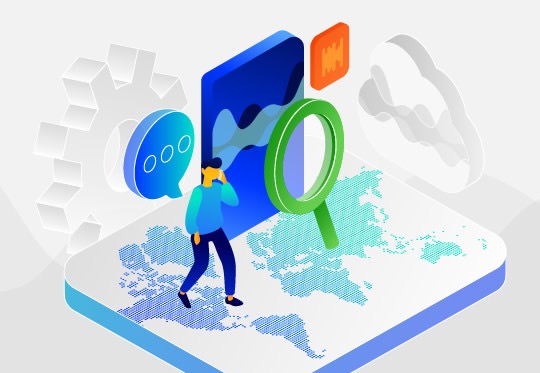
In a world that is increasingly reliant on a workforce that can work anytime, anywhere, businesses are looking for increased connectivity through innovations in wired and wireless solutions. Enter fixed-mobile convergence (FMC), where calls can be seamlessly transferred from fixed to mobile devices and vice versa. Read an in-depth guide to FMC in our white paper.
Although FMC is by no means new, the infrastructure and investment required means it has been slow to realise. But with advancing technology, the idea of combining offerings into one bundle for customers is beginning to gain traction. Could 2020 see developments in converged offerings?
What does FMC mean for businesses?
The growing popularity of FMC is the result of both customer needs and networks looking to stay ahead of the competition and retain customers with more powerful, personalised services.
FMC solutions create a union between wired and wireless technologies and allow calls to continue without dropping even as the user moves from location to location and between devices. FMC also enables better reachability, so that customer-facing employees can be reached on the first try — whether they are in the office or out on the road. Similarly, single-number reach allows customers and clients to contact a business on one number that redirects calls to available contacts, through cloud-based communications technology.
Enterprises that deploy solutions that unify fixed and mobile communications will see increased productivity.
What does FMC mean for telecommunications service providers?
Telecommunications service providers have already begun to buy into the concept and are benefitting from being early adopters of the technology. By bundling their fixed and mobile services, service providers are likely to reduce customer churn as they are able to offer cheaper packages, while increasing average revenue per user.
These simplified communication solutions also make it easy for providers to offer value-added services like cloud-based call recording from one single, unified portal without requiring any up-front investment, hardware or lengthy setup processes.
By moving to the cloud, telecommunications service providers can combine wired and wireless communications in one solution, offering greater flexibility, ease of use, and reduced IT and network costs for providers and their users.
Get in touch to find out more about how Dubber call recording and voice AI can work with FMC solutions.

The fifth, and final, instalment of our Fourth Industrial Revolution series explores what telecommunication service providers need to do in order to provide for the new digital workforce. Part one of the series gave an overview of the Fourth Industrial Revolution, part two looked at intuitive networks and how 5G and cloud technology fit into developments in the telecommunications industry, part three examined the growing importance of diversity in telecommunications product offerings, and part four examined the evolving expectations of customers.
The digital workforce is a manifestation of automated solutions, in various stages of development, that are currently driving productivity in the workforce. Integrations that share data across business tools are making workers and business processes more efficient, allowing employees to focus on more valuable activities. Over the next few years, enterprises will be increasingly deploying efficiency solutions driven by automation in order to improve the quality and productivity of their operational, back office, and customer service processes. Telecommunication service providers need to ensure they are meeting the expectations of modern businesses with their offerings, or they may be faced with increased risk of customer churn.
The connected workforce
Connectivity is steadily increasing due to innovation within the telecommunications industry, such as fixed-mobile convergence (FMC). You can read more about FMC in our white paper. However, digital players are making their way into the marketplace and disrupting the industry with rapid digital innovation. These agile disruptors are unpredictable and aren’t restricted by the legacy infrastructure and long development cycles that can hold traditional telecommunication service providers back from innovation. Digital services can often offer more opportunities for integration with existing systems, as well as better connectivity. Telecommunications service providers will need to innovate to compete with these digital players.
Alternative innovation
Innovation in the telecommunication industry has traditionally been characterised by staged developments that span multiple years. In order to compete with digital players and develop new products and services that can be deployed at scale, providers will need to review their innovation strategies. The World Economic Forum has discussed a recent trend towards innovation approaches that focus on collaboration, and the positive impact on growth that this achieves. Gone are the days of focusing on the ownership rights to intellectual property: the main focus in the future should be putting customers first. This is vital to obtaining a share of the market. These kinds of open innovation models allow external parties to contribute to the development of products and services, often achieving development at a scale that goes beyond the sum of its parts. Telecommunications companies have successfully nurtured a “sandbox” innovation approach that allows their research and development teams to work autonomously: giving them greater freedom for innovation.
Harnessing data
Data is increasingly being used to solve business problems and increase productivity within organisations. According to a 2019 report1, data science expertise is now a highly sought-after skill. Telecommunications service providers have a key role to fill in harnessing the vast amounts of conversational data held within our communications. With access to this valuable information, data scientists will be able to analyse and identify data trends, as well as problems that can be solved, through artificial intelligence.
Our Fourth Industrial Revolution series has shown that the telecommunications industry has a key role to play in shaping the way we communicate, collaborate, and consume. With developments in networks and product offerings, service providers can capitalise on the evolving expectations of customers and stay ahead of the competition. New methods of innovation can help them to compete with digital players, and their customer bases can provide them with the data they need to provide personalised offerings that will reduce churn and help with customer acquisition.
1Firebrand, Vitamin T & Aquent (2019) Transformation of the Digital Workforce: 2019 Report. Australia.

Our cloud call recording is now available for immediate signup for all customers on the Sprint® Smart UC service. With 53.9 million connections, that’s a huge number of users who can start to reap the benefits of recording their calls in the cloud.
The cloud-based unified communications (UC) service eliminates the need for traditional on-premise equipment and capital expenditure for business customers and so is a natural fit for our software as a service (SaaS) products. Their affordable unified communications as a service (UCaaS) solution allows users to combine their business phones and collaboration apps in one UC service. The solution helps to improve productivity by amalgamating carrier grade voice services with high definition video, desktop sharing, instant messaging and email.
Just as our cloud call recording is designed with small businesses in mind, Sprint® Smart also offers a service that is perfect for small and medium enterprises. As a cloud service, the need for upfront investment in on-premise hardware provides flexibility for businesses. Users can be added and removed on a monthly basis, through an easy-to-use online portal, and our call recording services can be added and adjusted in the same way.
Dubber call recording, as standard
With our cloud call recording available as a standard value-added business feature for all Smart UC customers, our CEO Steve McGovern commented: ‘We are very proud to be working with Sprint, a globally recognised leader in the telecommunications industry.” You can read more from Steve in the full ASX announcement below.
To find out how to add value to your business with call recording, speak to a member of our team today.

Dubber Call Recording Capability Available on Sprint Smart UC Platform
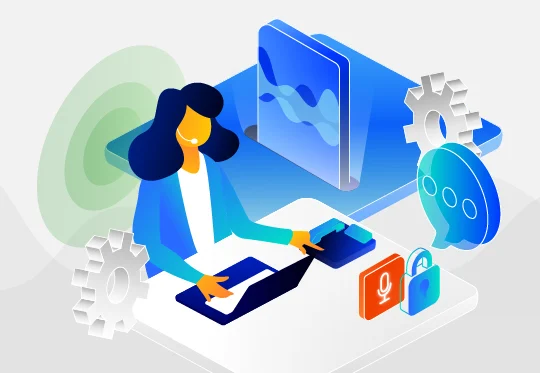
The way we communicate has changed. While we still talk to each other over the telephone, the technology that transmits this communication has moved on. The telephone has its origins in cable networks, but today businesses and individuals often use telephones powered by the internet instead. This is called voice over internet protocol (VoIP), and is a way to transmit voice calls without using analog phone technology. VoIP transmits conversations via the internet, rather than through phone lines. Using VoIP has a number of advantages, including lower costs. In order to capture the data held within VoIP calls, you must be able to record them. We have written about different methods of recording VoIP calls, but here is an overview of how to record VoIP calls.
How can you record VoIP calls?
VoIP calls can be captured through passive or active recording. Passive recording uses tools that ‘sniff’ the packets of voice data, while active recording uses software that ‘listens’ to the conversation. Recording doesn’t require any special equipment or software, as it is managed by the vendor. Recorded calls are saved as audio files and stored for future reference or playback.
A business or individual can switch on VoIP call recording at any time, and start recording almost immediately. Different providers offer various features, such as controls that determined which calls are recorded, as well as announcements to inform callers that their call will be recorded. Organisations can enable call recording for everyone in a department, or only certain employees and these settings can be changed at any time. Call recording can be automatic, or user-initiated — meaning all calls can be recorded, or a user can choose to record a call.
Why should you record VoIP calls?
VoIP calls can be recorded without using any special equipment or software required on the premises. Recorded calls are saved as audio files and stored for future reference or playback. Certain industries are regulated by legislation that requires calls to be recorded, while many organisations choose to record their calls for quality assurance and training purposes. Many industries have regulations that require organisations to record their calls, and failing to be fully compliant with these regulatory directives can result in costly fines. Keeping up-to-date with an efficient call recording solution is essential for compliance, but this is just the beginning of what can be achieved with call recording.
Recording VoIP calls can also allow organisations to create better training experiences. With a better understanding of common customer queries, achieved through replaying calls, staff across a whole business are better placed to help customers. Other benefits of recording calls include improved order confirmation and dispute resolution, as well as churn reduction. Traditionally, only large enterprises could afford to record their calls, but cloud solutions are making call recording more affordable for smaller businesses.
How to choose a VoIP call recording provider
There are a range of factors that you must consider when choosing a VoIP call recording provider. The quality of the recording will vary depending on the method used to record the call. For the best playback quality, calls should be recorded at the same quality of the original call. The output format of recordings is also an important consideration. An audio file should preserve sound quality, while retaining security. Call recording should also be accessible, both financially and through an easy-to-use interface that is user friendly.
Our cloud call recording platform offers an accessible way to easily retrieve and replay any recording. With unrestricted scalability, businesses can record huge call volumes and retrieve any recording, no matter when it was recorded. We also offer secure sharing functionality; where recordings can be shared via emails containing expiring links. No files are downloaded, ensuring the security of the recorded conversation.
Want to start recording your own VoIP calls to reap the benefits of capturing all that valuable voice data? Talk to one of our team today.
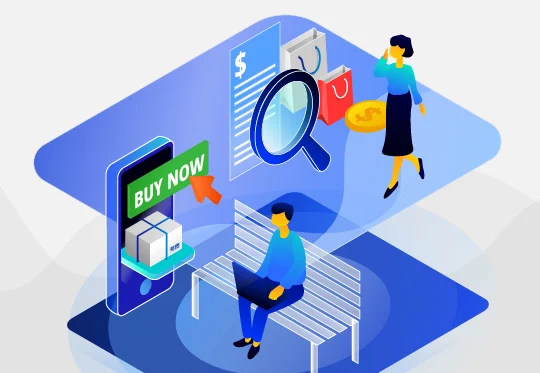
The fourth instalment of our Fourth Industrial Revolution series explores the evolving expectations of customers and how digital experiences will change over time. Part one of the series introduced the Fourth Industrial Revolution, part two examined intuitive networks and the future of cloud and 5G technology within the telecommunications industry, and part three investigated how telecommunications service providers will need to diversify their offerings in order to stand out from the competition.
Customer expectations have evolved alongside the development of technology, as businesses digitally enhance the customer experience. The high quality service and convenience afforded by technology is now seen as standard by consumers, who are demanding personalised services on demand. They are also expecting a seamless experience across channels, with hassle-free payment and deployment options.
Customer expectations within telecommunications
The telecommunications industry is plagued by customer churn and the costs associated with acquiring new customers. Encouraging customer loyalty is a great way to increase revenue, so telecommunications service providers will need to look for new and innovative ways to retain customers. This may require service providers to reassessing the expectations of their customers and developing digital tools in order to better support the customer journey at every stage and enhance their overall experience.
Telecommunications service providers are well placed to deliver personalised products and services to their users chiefly due to the amount of data they have. New technologies will enable companies to deliver these at scales previously impossible or unimaginable. Smart algorithms will be able to analyse customer data in real time to deliver personalised products and services to entire customer bases at once. We are already seeing this customisation with TV streaming services that learn from user behaviour. In the future, this personalisation will be automatically created using artificial intelligence, and a mix of predictive analytics and real time data.
Customer service is key
Peer recommendations are becoming increasingly important in the decision-making process, even more so than media product reviews. Negative reviews tend to reach a larger audience than positive reviews, meaning high quality products and excellent customer service are more important than ever. 61% of customers switched providers due to disappointing customer service, according to a recent study by Accenture.
Personalised experiences have been shown to engage customers, and the telecommunications industry should be asking how it can deliver such experiences to all users. This could be customising bandwidth supply according to a user’s individual data usage to meet a particular price point, or through the delivery of digital services and applications that have been personalised to each user such as telecommunications or utility providers offering plans to customers based on their usage. Reactivity and agility will be important qualities in the race to keep up with an evolving digital environment and changing customer expectations.
An improved and efficient customer experience
Digital tools will not only help telecommunications service providers to create personalised customer experiences, they can also help to reduce costs and grow revenue. Increased customer engagement reduces churn1; lowering the need for hefty spend on customer acquisition and marketing. Targeted offers including cross selling and/or bundling that appeal to the specific needs of customers should increase customer revenue and loyalty.
Customers expect to be able to find the information they need to make an informed decision when purchasing a new product or service. With more intelligent business communications solutions, customers should be directed to the department or information they need faster — increasing first call resolution and reducing customer service costs. This is significant when customer service can account for up to 10% of total operating costs. A report by the World Economic Forum has predicted that such a reduction in customer services and marketing costs, and the associated IT expenditure, could generate up to $18 billion in additional operating profits by 2025.
In the fifth and final part of our Fourth Industrial Revolution series we will explore what telecommunication service providers need to do in order to provide for the new digital workforce.
1 Del Rowe, S. (2019) ‘Vertafore Ensures Great CX with NewVoiceMedia’, Customer Relationship Management, June, p34.
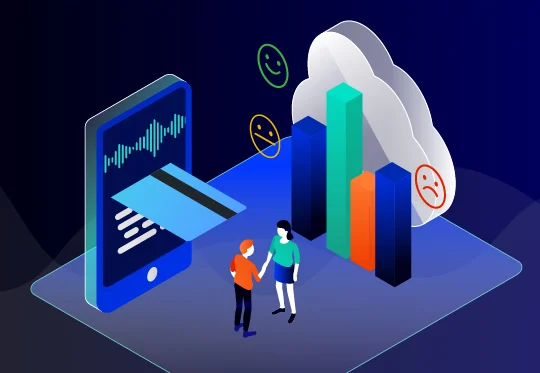
Our September quarter was a period characterised by growth: with expansion across sales, and new roles filled in Australia, Europe and North America across marketing; development; compliance; and support. This enhancement of the team will be instrumental in meeting our current priorities: providing call recording and voice AI (artificial intelligence) services for the Cisco Webex Calling platform, driving growth of mobile call recording in Australia, furthering our USA expansion with tier one carriers, rolling out a global artificial intelligence initiative, and continuing to develop our global distribution and reseller network.
Our key highlights for the period:
- Revenue increased by 6% from the previous quarter to $2.15m, up 200% on the previous corresponding period (PCP).
- End user subscriptions increased by 23% to over 117 000, up 165% on the PCP.
- 113 agreements were made with service providers and 52 service providers reached billing stage.
- Contracted annualised recurring revenue at 30th September was $10.2m.
- Cisco Webex calling launched Dubber as their recording service 31st October.
We are strongly positioned to expand on our leadership in cloud call recording and data capture in traditional unified communication networks, fixed-mobile converged networks, and UCaaS networks.
Cisco Webex Calling
Cisco Webex Calling is a multi-tenant, cloud-based alternative to an on-premise PBX, and is available as a subscription service. In preparation, we achieved ISO 27001 compliance: a globally recognised standard for information security management systems. The service is now live and will be available via the Cisco order entry system.
Mobile and ‘whole of business’ recording
Businesses are now looking beyond call recording for compliance, and seeking mobile recording services and insights on customer interactions across the whole business. We are working towards a service that will provide widespread availability across Australia. During this preparation we have completed an agreement with Schepisi Communications and have been awarded the Telstra Enterprise Mobility Carriage Partner of the Year for 2019.
Continued momentum
Dubber co-founder and CEO Steve McGovern commented on the September quarter results:
“Fundamentally, we have scaled our operations from a ‘Founder led’ company to one which is able to execute on the opportunities which are in multiple jurisdictions.
We are pleased with our momentum towards facilitating widespread uptake of the Dubber platform as a mobile or fixed mobile converged offering. The Company believes that there is significant immediate demand for these services and activation of the initiatives should see user uptake and revenues grow strongly.
Our AI programs are continuing to gain momentum with our large partners like IBM. We are seeing strong increases in the number of enterprise customers, particularly in North America, that are interested in garnering business insights. We believe that gaining access to real-time voice calls on an enterprise-wide basis will be a strong business driver for us in 2020.
Throughout the remainder of FY20 we will continue to procure additional key carrier agreements, accelerate their time to billing and add new channel and systems integrator agreements to build out the global backbone of call recording. These are the foundations of growth for the next term and we are now ready to execute on these with the team we have in place.”

Dubber Live as Cisco Webex Calling Call Recording Platform

The digital workforce is an increasing reality for enterprises, and now is the time to move from on-premise unified communications solutions to cloud-based UCaaS. Future cloud unified communications offerings will have enhanced features, including dashboards and analytics.
No more being tied down
According to Gartner, by 2021 90% of IT leaders will not purchase new on-premise unified communications infrastructure1. With UCaaS solutions providing the same, or better, functionality; such as voice, meeting and messaging services, as well as unified clients and integrations, the only change is the delivery method. Cloud deployments of communications services removes the need for on-premise equipment, and the associated investment of time and money required.
Our call recording and voice AI services are designed to integrate with UCaaS solutions, while our cloud platform has been specifically architectured in order to provide secure, scalable storage that is flexible enough to adapt to the needs of an enterprise.
Digital transformation and disruption
Moving to the cloud is a huge step on the journey to digital transformation. By removing the restrictions of physical hardware, enterprises increase their potential to disrupt their industries and expand their horizons. Cloud communications enable expansion; not just in size, but also in location. Cloud storage can scale alongside the growth of an organisation, with no worries of ever running out of space, while deployment through global data centres means new locations can be added easily.
The cloud also facilitates agility: with a faster speed of innovation, businesses are able to quickly react to trends and capitalise on new opportunities with faster deployment of communication services.
Relief from app overload
With our open API, data from recorded calls can be integrated into business tools. It’s even possible to manage our services through existing systems, meaning one less application open on a desktop. Visit our API page to find further information on what our API can do.
If you want to learn more about how a move to the cloud can help your business get ahead of the competition, get in touch with one of our team.
Sources
1Gartner (2018) Magic Quadrant for Unified Communications as a Service Worldwide.

The third part of our Fourth Industrial Revolution series investigates the ways in which telecommunications service providers will expand their offering beyond phone calls. Part one was an introduction to the Fourth Industrial Revolution, describing the latest wave of digital development; and part two explored intuitive networks and the ways in which cloud technology and 5G will transform telecommunications.
Telecommunications service providers have already adapted to changing consumer demand, adjusting their revenue streams in order to succeed in an evolving marketplace. Data has been important, and a further shift to an internet-based business model will be an opportunity for future revenue growth through the currency of data. The internet of things (IoT) will be a key part of this strategy, with the deployment of sensors, and the potential of analytics and machine a significant revenue opportunity.
New revenue streams
How we work and communicate will be shaped by forward-thinking service providers who provide new services at a low connection cost. Telecommunications service providers are at a significant advantage, due to their existing connectivity and subscriber base. More subscribers mean more data, and those with the analytical capabilities will be able to harness the value held within this data. The telecommunications operators who will succeed will be those with expanded offerings that include cloud-based services such as analytics, system integrations, and APIs that can compete in a crowded marketplace. Their competition will be technology companies and agile startups, so innovation will be key. Service providers will need to ensure that they are not held back by legacy processes, as quick reactions will be vital. Radical change may be in order at board and CEO levels to capitalise on the huge potential for revenue.
Possible areas for development by telecommunications service providers include video and entertainment services, on-demand information services such as maps or booking, retail, mobile financial services, and virtual care provision services for healthcare providers. It is predicted that these new revenue streams could generate up to $142 billion over the next decade and could contribute 15% of total revenue by 2025. New opportunities will also be available in existing spheres covered by telecommunication service providers, such as information security, enterprise mobility management, unified communications, cloud services, and analytics. These areas on their own could contribute an additional $48 billion in profits for network operators and equipment suppliers. These new revenue streams will also create new jobs in order to support service delivery across consumer and enterprise applications.
Disrupting the industry
In order to meet new consumer demand and cement their place in the market, telecommunications service providers will need to recruit digitally-minded workers with implementation knowledge who can drive innovation. Competition will be fierce, and it is predicted that acquisitions and partnerships will be key to driving growth and establishing a place in the market. Scalability will be key for platforms, as well as the integration of front and back end systems, in order to offer a range of products and services to consumers.
With existing infrastructure already in place, telecommunications service providers are well-placed to offer a range of technology-based services to compete with digital service providers. This infrastructure will allow them to disrupt other industries. In a recent survey across global operators, almost a quarter of companies reported that they expect digital services across consumer and enterprise applications to account for more than 25% of total revenues by 2020. The development of new services that are relevant to users will improve customer service, a desirable outcome considering even a 0.5-1% reduction in churn annually has the potential to generate up to $10.3 billion over the next decade. By prioritising customer convenience and value creation, service providers could drive up to $170 billion through time and cost savings for their customers
Environmental impact
The potential travel reduction brought about by these new digital services could see a decrease in carbon emissions of more than 80 million tonnes. Virtual healthcare alone could reduce emissions by 63 million tonnes by allowing patients to speak to doctors in the comfort of their own homes.
Emerging technologies
Technological developments such as augmented reality (AR) and virtual reality (VR) have the potential to change how we communicate with not just each other but the world around us. They could even herald new devices. By 2030, the PC will be 50-years-old and the smartphone almost 15: the future could hold new communication devices and see a move away from screens. A focus on emerging technologies can capture significant value. AR and VR could reshape the ways we receive medical care or go shopping, and confidence in these technologies is already strong, with funding deals for AR and VR reaching $1.1 billion as far back as 2016. Applications of these technologies will be much more varied than their existing use in gaming, with a variety of commercial and industrial applications including healthcare, retail, logistics, real estate, manufacturing, security, training, and data analysis. AR and VR have the potential to evolve how people communicate, learn, work, and consume.
In the fourth part of our Fourth Industrial Revolution series we will explore the future of customer retention; looking at the evolving expectations of customers and the ways in which digital experiences will change over time.

Our cloud storage sets us apart from other call recording service providers by offering a scalable platform for growing businesses. As a native cloud call recording solution, we offer a range of storage options to adapt to the needs of service providers and their customers. We built the Dubber platform in the cloud to offer unlimited scalability to our customers. What does this mean in practice?
Flexible options
Scalability offered by the cloud provides flexible approaches to user counts, processing capacity, and storage. Combined, these allow us to provide products and plans tailor-made for service providers.
Perpetual retention
A common challenge for on-premise solutions is that their sizing was undertaken at time of installation. As a business grows in both users and usage, a challenge can arise where the volume of daily new call recordings is beyond prediction. This forces administrators to balance which services are being recorded and the length of time to retain each recording.
This approach to retention is just not adequate in the real world, especially when regulations such as MiFID II require calls to be stored for five years. The Dubber platform has the capability to securely store large volumes of calls in perpetuity, giving organisations the tools they need to comply with the regulations of their industry.
SaaS
Our Software-as-a-Service model allows us to offer a range of subscription options to telecommunications service providers and their customers. Want to cover call recording for compliance and contact centres but also offer packages with less commitment that introduce a whole new customer base to the benefits of call recording? Dubber has you covered. We offer low-cost and commitment-free packages with shorter storage periods that can be supplied alongside standard reserved call recording packages that require perpetual storage.
Unrestricted storage
As well as long-term options, the Dubber platform can also accommodate large call volumes. The unrestricted storage provided by the cloud allows for vast numbers of concurrent calls to be recorded. Dubber’s true cloud storage allows the solution to scale alongside a business during busy periods, and there are never any concerns about running out of space. Calls are always available instantly and are easily searchable.
Security
Dubber is a native cloud platform, with an architecture specifically designed to provide maximum security for the recording data of all our users. The Dubber platform utilises sophisticated security systems, leveraging cutting edge cloud technologies to provide a highly secure and scalable call recording solution. All data is stored within our platform under AES-256 bit encryption, providing best-in-class security. The platform offers true cloud multi-tenancy architecture, ensuring separation of all customer data.
Get in touch to find out how the Dubber solution can scale to suit your business, contact us here.

June 2019 Appendix 4G

The second part of our Fourth Industrial Revolution series explores how networks are expected to evolve in the future. You can read our introduction to the Fourth Industrial Revolution here.
Telecommunication networks are vast physical structures that perform diverse functionality in a way that must conform to regulatory restrictions. The industry is constantly adapting to developments in technology and evolving business models and the rate of change that they must keep up with is increasing.
Cloud technology
Advances in digital and cloud capabilities are expected to transform networks, moving away from expensive hardware to innovative software that can increase reliability and flexibility. These software solutions will have API-based interfaces and will be deployable across affordable, general-purpose hardware platforms. Cloud technology, such as software-defined networking (SDN) and network function virtualisation (NFV) are leading this network evolution, as they allow telecommunication service providers to manipulate the network on demand.
AT&T are pioneering the adoption of SDN and NFV, setting a target of 75% of the AT&T network based on SDN and NFV technologies by 2020. It is expected that other carriers will follow AT&T’s lead and that SDN and NFV could be worth a total of $220 billion for network operators and equipment providers over the next decade. At Cox Communications, Executive Director of Advanced Technology Jeff Finkelstein said the proliferation of IoT connectivity will continue to drive cable network demand, which is increasing at an annual rate of 53 percent. He sees the only way to manage that growth is to capitalize on technologies including SDN and NFV.
Cloud technologies applied to network infrastructure will allow network operators to reduce their spending, particularly on energy. This could result in a positive change for the environment, with a switch to new technologies predicted to save more than 180 million tonnes of potential CO2 emissions.
5G
The 5G network is key to the Fourth Industrial Revolution. Already being rolled out to certain cities and locations such as Gatwick airport in the UK, 5G uses high-frequency radio spectrum but will need lower band airwaves outside of urban areas. Service providers will need to ensure that they can provide the network across the spectrum in order to reach a larger market. 5G is characterised by low-latency: meaning there is minimal delay in the processing of data. This allows it to support operations that require near real-time access to rapidly changing data. 5G will allow the commercialisation of technology such as the internet of things, virtual and augmented reality and autonomous transportation, as well as evolving industries from television broadcasting to agriculture.
Intuitive networks
Understanding network workloads and how to allocate infrastructure accordingly is another way in which networks will be transformed. As networking evolves, machine learning technologies have the potential to create networks that are self-sufficient. This technology would mean that networks could identify errors and issues and fix problems before they affect communications. These intuitive networks will be able to automatically adjust bandwidth provisions depending on requirements.
Driven by artificial intelligence, intuitive networks collect data from points throughout the network; including end user smartphones, switches, WAN routers and cloud servers. This data can be used to understand how the network is being used, giving network engineers the information they need to do their job more efficiently.
Evolved networks will make provisioning quicker and easier, with agile delivery allowing staff more time to work on other advancements as less time is required to be spent on routine network management. Networks will also have much greater scalability; meeting traffic demands as they fluctuate over time. With intuitive networks, business continuity and disaster recovery are also improved. As networks are able to identify issues, traffic can be rerouted in order to reduce downtime, reducing customer churn due to increased satisfaction through more consistent levels of service.
Dubber’s native cloud products have been designed to take their place in the Fourth Industrial Revolution. Built natively in the cloud, Dubber solutions are already offering the cost and energy saving benefits of a software-as-a-service model. With no on-premise equipment the costs of running server rooms, as well as the energy consumption associated with powering them, are removed. By eliminating the hardware requirements of legacy solutions, we are able to offer a service that can scale to meet demand: without restrictions. In this way, our platform is prepared for a future where communications solutions automatically scale depending on requirements.
In part three of the Fourth Industrial Revolution series we’ll look at the world of communications beyond phone calls and the new digital communication methods and extended revenue streams that will be available in the future.

The Fourth Industrial Revolution is a wave of digital development that encompasses our physical surroundings. Where the First Industrial Revolution used steam power to transform manufacturing and travel, the Second used electric power to enable mass-production, and the Third used technology to automate processes, the Fourth uses emerging technology including artificial intelligence (AI), robotics, the Internet of Things (IoT), 3D printing, nanotechnology, biotechnology, and quantum computing.
This series will give a general overview of the Fourth Industrial Revolution, with future pieces discussing what this will mean for networks, telecommunications, customer service, and the workforce.
The Fourth Industrial Revolution and business
The Fourth Industrial Revolution has the potential to generate income and improve quality of life through new products and services that increase efficiency and make our lives easier. It is predicted that logistics and global supply chains will improve, reducing the cost of transportation and communication and the overall cost of trade: resulting in new markets and economic growth.
Market disruption will be driven by agile players who can offer better quality, experience, speed, or price options thanks to improvements in technology. We have already seen how technology is creating new ways to consume goods and services via smartphones. The Fourth Industrial Revolution will affect customer expectations, as well as product and business development.
Artificial intelligence
AI is fast becoming a part of everyday life. Self-driving cars are being developed, while drones and virtual assistants are now commonplace. AI technology is being driven by the availability of vast amounts of data, something that has fuelled the development of our own AI technology. We developed Dubber AI to allow everyone, not just big businesses, to gain insight from their calls, and ultimately make their lives easier. With AI, businesses can identify common problems and resolve complaints to improve customer loyalty, while people in their everyday lives can use call transcripts to remember important details. Other technology companies, such as IBM, are using AI to improve everything from healthcare to Wimbledon.
Telecommunications developments
The telecommunications industry will be at the forefront of the Fourth Industrial Revolution, as a driver of global digital transformation. Investment in technology and interoperability has enabled the flow of data and the creation of new business models across industries. A globally connected network empowers millions of people around the world by giving them access to information and marketplaces.
Data will soon become a commodity such as electricity and telecommunications service providers will need to create an offering that prioritises customer experience in order to succeed. They are uniquely placed to offer a personalised customer experience that extends revenue streams beyond connectivity, through integrated IoT solutions and new communications technologies that leverage developments in augmented and virtual reality. Networks will also evolve from on-premise equipment to an era of software systems.
Competitive advantage will be achieved through the ability to collect data and create new outcomes or experiences for end users. Telecommunications service providers who offer enterprises a variety of data-driven use cases will add value to their offerings and ultimately their customers. 2020 sees 44 zettabytes (44 trillion GB) of annual data flow, 40% of which will be stored or processed in the cloud.
In part two of the Fourth Industrial Revolution series we’ll look at how intuitive networks will create value for customers through flexible services, faster routes to market, and improved user experience.
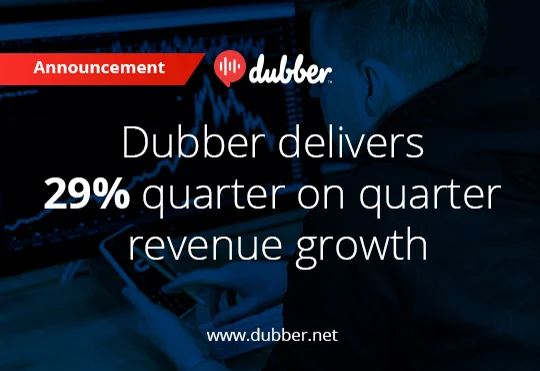
Following April’s capital raise of $22m, we have utilised this investment to scale the business in order to pursue growth potential. Cash at bank as of 30th June 2019 was $19.6m, with the company fully funded to execute these opportunities. The leadership team has been expanded, and the service has now launched with Spark New Zealand and Bell Canada. Key metrics for the June quarter include:
- Revenue increased 29% from $1.57m to $2.03m, with annual operating revenue increasing 269% from $1.5m to $5.54m
- Telecommunications service providers at the billing stage increased to 106, from 36 in June 2018
- Subscribers increased 222% to 94 825 over the year from 29 405, with 21 668 added in the June quarter
Commercial opportunities
Market conditions, customer and partner requirements, and the continued growth in cloud voice and data services has enabled Dubber to consolidate our position in the market. During the June quarter we have focused on scaling to capitalise on commercial opportunities and we have grown our sales team in order to procure network agreements and generate revenue across Australia, North America, and Europe. In order to support our channels, including IBM and Cisco/BroadSoft, we have increased resources to expand our reach with these organisations. Our AI development has continued with the enablement of third party integrations, including CRM systems and trading platforms, and other value added services for telecommunications service providers.
New staff
In order to strategically target growth opportunities around the world we have expanded our team, particularly in technology development, sales, account management, and application development. We have added 14 new staff members, including a director of global sales, a strategic partnership manager and a channel sales director for ANZ.
Service provider launches
In June, the Dubber service went live with Spark New Zealand on their Cloud Phone Service. Spark (formerly known as Telecom New Zealand) is one of New Zealand’s largest telecommunications and IT service providers. Shortly after the June quarter, Dubber also went live with Bell Canada, providing call recording to its Bell Total Connect Service. Bell Canada is the largest communications company in Canada. Customer subscriber numbers are expected to be reflected in the current quarter and beyond.
Continuing to build the global backbone of call recording
Dubber co-founder and CEO Steve McGovern commented on the June quarter results:
“Our service provider and technology partnership agreements represent some of the world’s largest telecommunications service providers and global technology sales channels. With a technology that is designed to meet large scale requirements, the business itself is in a position to scale to capitalise on the opportunities available to it.
“We have seen an acceleration of large enterprise customers moving quickly towards adopting AI in their operations (and thereby call recording), particularly in Australia and the USA. There have also been extensive developments in the cloud voice and collaboration markets in the last quarter that we believe will have a profound impact on the way voice and related services will be delivered to end customers.
“The Company’s short-term goals are unchanged – we will continue to procure additional key carrier agreements to build out the global backbone of call recording, to grow revenues on a quarterly basis, and to be cash flow positive on a monthly basis this calendar year end.”

Dubber Annual Report 30 June 2019

Corporate Governance Statement June 2019

The new Meeting Recorder tool, exclusively available in the Dubber mobile app, allows users to record meetings from their phone, store them securely in the cloud, and even transcribe them with Zoe voice AI. Record interviews, team meetings, or any conversation you might want to refer to in the future with this essential new tool. Meeting Recorder is as easy as pressing a button: once the meeting is over, it is available to replay just like your calls.
The death of minute-taking
Have you ever been so busy taking notes that you’ve missed what was said next? With Meeting Recorder you can give meeting participants your full attention, knowing you can replay the meeting at any time. With no need to take minutes, meetings can flow uninterrupted. Also, with Zoe, a full transcription of the meeting can be obtained and circulated as a follow-up to the meeting: ensuring nobody misses an important detail.
Transcripts can prompt action points and make collaboration more efficient. Zoe also analyses the sentiment of meeting participants and breaks every recording into sections assigned with a positive, neutral or negative rating. Alerts can be created to notify users of meetings that have been rated as having negative sentiment, and team managers can be alerted to meetings carried out by their direct reports to ensure that they are adhering to policies.
Pinpoint important moments with voice AI
With a full transcription of a meeting available with Zoe voice AI, locating a specific meeting recording is easy with searchable text and keywords. Stay organised by adding tags (such as customer name and attendees) and even attach comments and notes.
Never run out of storage
Unlike other mobile recording apps, Meeting Recorder stores all of your recordings in the cloud, just like your calls: so you’ll never run out of space. This is especially helpful when complying with regulations such as MiFID II, which requires financial interactions to be recorded and stored for up to 7 years. Even if you lose your device you can rest assured that your recordings will be safe in the cloud. Meetings can also be recorded on one device and accessed on another, and recordings can be integrated with existing applications, such as CRM systems, for added productivity, through Dubber’s open API.
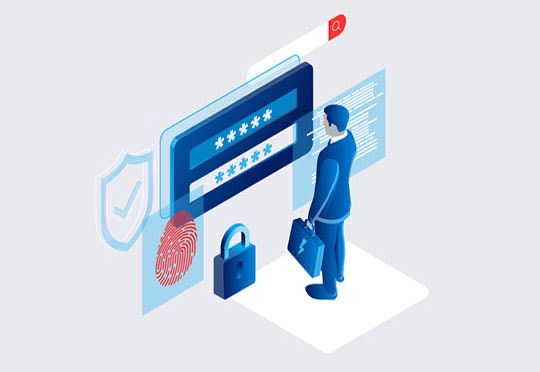
Dubber are committed to providing the highest levels of security for our native cloud platform, as well as offering unlimited scalability, and rapid deployment to meet and exceed the expectations of our clients with no CapEx. Read on to find out the ways in which we maintain our high standards of security.
Cloud security
We chose to build our products and services in the cloud, specifically to leverage the levels of security that are only made possible through the cloud. Security is maintained at every stage of the call capture and data processing journey, with AES-256 encryption protecting recordings and multiple data storage sites mitigating any disaster recovery concerns.
Safe and secure sharing
The security of our platform is just one aspect that we considered when creating our solution. We also wanted to ensure that data was protected while still maintaining accessibility for businesses and individuals. Unlocking the valuable data stored in phone calls is one of the main reasons that customers choose Dubber solutions, but it is important to make sure that the owners of this data are protected. We created teams and permissions settings that restrict access to recordings, and a unique sharing function that does not share files with third parties but instead emails a non-downloadable link that expires for added security.
Local storage myths busted
Unfortunately, security is often a concern that prevents businesses from moving to the cloud. In reality, moving storage off-premise means organisations immediately mitigate the risk of having vulnerable data on-site. With data centres all over the world, we can offer a variety of options for organisations who require specific storage locations for their data. These storage centres also offer data sovereignty, so data is only stored in one geographic location. Within each location, data is written to multiple data centres for geographic redundancy: preventing data loss in the event that a data centre is compromised. These data centres guarantee availability of every single recorded call at any time, allowing quick and easy access to data for every customer.
Dubber’s cloud storage employs the latest in encryption technology to offer the highest protection, which is managed by a team of experts at a level that legacy solutions cannot compete with. Any data stored within Dubber is only stored by us, and not owned by us. Data rights are retained by the owners of the data, Dubber merely offer solutions that capture, process, and store data.
We are ISO certified
Dubber is ISO 27001 compliant. ISO 27001 is the globally recognised and respected standard for information security management systems (ISMS). In order to gain certification, an organisation must develop and implement a rigorous security management programme: including an ISMS. Organisations must systematically evaluate information security risks, taking the impact of security threats and vulnerabilities into consideration. Any security risks must be addressed with a comprehensive suite of information security controls. An audit and compliance management process must be implemented to ensure ongoing protection.
This achievement is an assurance that Dubber’s data security processes are effective at every level of our organisation. The Dubber core principle is one of agile and continuous improvement and this extends to our data security commitment.
Download our ISO certificate here.
How we protect data
- Establishing, maintaining, monitoring, reviewing, auditing and continually improving our ISMS
- Establishing, reviewing and communicating our information security objectives and performance measures
- Committing to satisfy business, legal, and regulatory and contractual security obligations
- Committing to continual improvement of our ISMS by seeking feedback from clients, staff, and through internal and external audits
- Ensuring that the ISMS is communicated with every member of the Dubber team
Have any questions about our security? Drop us a line.

Zoe is Dubber’s voice AI technology, which transcribes everyday phone calls: unlocking previously untapped insights to aid in improving business efficiency and customer experience, and reducing churn.
What if you knew when your most important customer had called your business, and wasn’t happy? With Zoe, you can receive notifications for calls from specified numbers that have a negative sentiment score. These notifications give you the insights required to understand what caused the negative sentiment and so you are able to take a proactive approach and call them straight back. This personal attention can win back their trust, and their business.
Zoe transforms voice data from calls recorded by Dubber into text and uses the data to analyse the call content. Calls are rated as positive, neutral, or negative, based on Zoe’s analysis. This rating can then be used to trigger custom alerts to managers or supervisors, such as calls with negative sentiment. These alerts can allow businesses to improve customer loyalty and churn figures.
Custom alerts are just one application of the latest version of our Zoe voice AI technology. Sentiment has the potential to transform customer service. Zoe makes it quick and easy to review important conversations and ensure the success of a customer service team.
Accurately pinpoint key information
In the Dubber portal, a full breakdown of the Sentiment rating can be accessed, alongside a transcription of what was said. Sentiment scores are assigned to individual sections of a call, based on the words spoken, and the pattern of speech. These scores are used to create an overall rating for a call. This allows supervisors to identify exactly what went wrong with a negative call, or in what way an agent provided excellent customer service to make a customer happy.
AI for every phone
Zoe is the perfect tool for companies of all sizes, providing a way for time-poor business owners and managers to stay on top of their business communications without having to replay all of their recorded calls. More and more organisations are recording their conversations, as call recording is increasingly available on affordable OpEx subscriptions. Zoe lets companies utilise the data from these calls to their full potential, instantly.
Good customer service can be key to differentiating a brand from the competition. The value of being able to retain important customers makes Zoe a vital investment for any business.
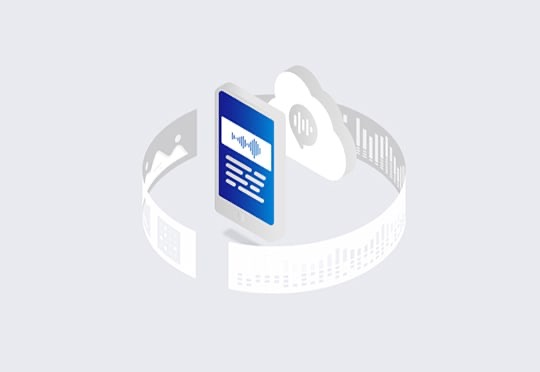
Organisations who download their recorded calls to local storage are putting valuable data at risk of damage, theft, or tampering. Dubber are committed to providing a secure and reliable call recording platform to meet and exceed the expectations of our customers: at an affordable monthly cost, with zero CapEx.
Why shouldn’t you download your calls?
There are four main risks associated with downloading recorded calls to local storage:
- Security: Recorded calls downloaded to local storage are much more vulnerable to theft, damage, or tampering. Having only one on-premise server means fire or power shortages could destroy all recordings.
- Access: Storing data locally can be detrimental to team members who need to access recordings, as it is often more difficult to manage and access recordings outside of a dedicated recording platform.
- Cost: Using and maintaining on-premise storage solutions is expensive: both to set up and maintain on a day-to-day basis. Organisations need to either employ trained staff members, or to engage expensive third parties to manage the solutions. As incidents can occur at any time, this could result in call-out charges.
- No audit trail: With local storage there is no audit trail. Users can listen, share, or delete recordings with no record of their actions.
Protect against risk with secure cloud storage
Utilising Dubber’s cloud solution, organisations immediately mitigate the risk of having vulnerable data on-site. The Dubber solution also employs the latest in encryption technology to offer the highest protection, which is managed by a team of experts at a level that legacy solutions cannot compete with.
Instant access to every call
Cloud storage with Dubber guarantees the availability of every single recorded call at any time, allowing quick and easy access to data for every customer. Storing calls with Dubber also allows users to retrieve calls instantly with advanced elastic search functionality that trawls every call, no matter when it was recorded. Cloud storage also facilitates ease of use for remote workers or those based in different offices. With all recorded calls available to access from any location, staff working across different locations can continue to playback recordings and use voice data without being in the office.
Consistent costs with no surprises
The costly management and staff resources associated with local storage can all be avoided with long-term storage with Dubber. All of the setup, management, and ongoing maintenance is covered by Dubber, meaning that costs stay the same, no matter what. The monthly subscription fee is the only expense, and there are no worries about unexpected costs in the future. Dubber’s SaaS model keeps costs down to a low monthly payment, rather than requiring CapEx that can be difficult when obtaining budget allowances.
Detailed audit trails
Access to calls is restricted by permissions structures to prevent unauthorised access or sharing of calls or data, and all activity is tracked and timestamped in order to create comprehensive audit trails. A full audit is collected for any transaction within the Dubber platform. All activity, such as users listening to, sharing, and deleting recordings, is monitored and logged within the platform. This logging provides both real-time monitoring of the platform and its status.
Offer your customers cost-effective storage from Dubber
Join Dubber and offer your customers long-term, secure cloud storage for their recorded calls. With no restrictions of storage space, no requirements of on-premise equipment, and instant access to all recorded calls, Dubber’s solution is second to none. What this offers is the opportunity to safely store huge amounts of valuable data, worth much more than marginal savings on a call recording package that might allow only 90 days of storage.
Get in touch to find out more about the benefits of long-term storage with Dubber.

It’s all in the palm of your hand
Out of the office and wish you could find your notes from an important phone call or meeting? With the latest version of the Dubber mobile app, you can play back your calls and meetings: anytime, anywhere, from any phone.
Keep all your recordings in the palm of your hand with the Dubber mobile app, available on iOS and Android. Play, share, organise, and analyse your calls with our powerful Zoe voice AI, from anywhere in the world. The app now comes with the new Meeting Recorder tool, which allows users to record meetings and store them securely in the cloud.
The full Dubber experience in an app
Working life doesn’t stop when you leave the office. With the Dubber app, you are no longer tied to your computer. From your phone, you can experience the full suite of Dubber tools wherever you are. View and listen to all of your recorded calls and meetings, just as you would in the web browser version of Dubber.
Our easy search means you can find calls using a range of criteria from date and time to call recipient. Within the playback page you can skip forward to replay an important detail or, if you have Zoe enabled, search the transcription and click on a word to play a conversation from that exact moment.
Tag your recordings from the app to organise them for easy retrieval and management. For a quick highlight of calls that require your action, mark your important calls with our star icon and separate them from the rest of your archive.
Zoe: powerful voice AI in your pocket
The Dubber app enables you to access the power of Zoe voice AI in the palm of your hand: transcribing your calls and meetings, measuring sentiment, and extracting keywords, timestamps and other metadata. Zoe can automate workflows through API integrations with third-party applications such as your CRM. With Zoe Notifications, you can create custom keyword and sentiment alerts to protect your business through proactive customer service.
Meeting Recorder: The death of minute taking?
Meeting Recorder is an exclusive recording tool with voice AI for smart transcription, available as part of the Dubber mobile app. Meeting Recorder securely stores all of your meetings in the cloud so they can be accessed from multiple devices and locations, and you’ll never run out of storage. Hit record during important meetings and talks and let the power of Dubber’s voice AI do the rest.
Meeting Recorder is the only recording app available with Zoe voice AI, eradicating the need for taking minutes with automated voice-to-text transcription. The transcript of the meeting can then be circulated as a follow-up. Zoe also allows you to search for meetings by keywords spoken, as well as within the transcript of a meeting: allowing you to pinpoint the exact part of a meeting you want to review. Sentiment is even analysed: showing an overall rating for the meeting, as well as a detailed breakdown.
Meeting Recorder is an ideal tool for sales and project managers who want to capture their team meetings in order to follow up on action points or as a coaching resource.
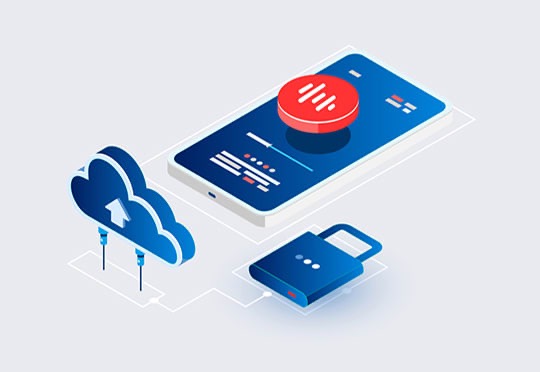
How much personal data did you share today? Within a digital society, where web browsers sometimes know more about us than our friends, security is more important than ever. For businesses who process personal data from their consumers, ensuring they protect this information is vital.
The consequences of poor security
Security breaches are big news: the headlines that result from data hacks can be disastrous for an organisation’s reputation. Consumer relationships with brands are built on trust and customers need to feel that their data is safe, otherwise they are likely to look for alternatives.
In order to help protect consumer data, the EU have enacted the General Data Protection Regulation (GDPR) to set a standard for businesses to adhere to when dealing with the management and storage of customer data. Failure to comply with the data protection requirements of this regulation can result in fines of up to €20m or 4% of annual turnover for the prior year, whichever is higher. Read our post on how the GDPR will affect call recording for more information.
In order to comply with the GDPR, and to ensure that their customers feel that their data is secure, businesses need to examine their data storage. In the past many organisations saw on-site storage as the best option, but the rise of the cloud has shown the benefits of digital transformation and the advantages of cloud storage over on-premise solutions.
What are the risks of storing calls on-premise?
Recorded calls downloaded to local storage are much more vulnerable to theft, damage, or tampering. Having only one on-premise server means fire or power shortages could destroy all recordings. With local storage there is no audit trail. Users can listen, share, or delete recordings with no record of their actions.
With a cloud storage solution from Dubber, not only are calls more secure but there are many other advantages over on-site solutions. The cloud allows users to have convenient access to information held within phone calls — anytime, anywhere. This access is managed through strict security permissions that are allocated by designated admin users, and a full audit trail can be traced. Colleagues can collaborate from across locations, and workers are no longer tied to their desks.
Dubber’s security
Recorded calls are not only a valuable source of insight, for some businesses they make the difference between compliance and non compliance. That’s why at Dubber we have put security at the forefront of every stage of the recording process.
Simple and secure access: we ensure that users can easily and securely log in to view calls, but only with strong passwords. With strict teams and permissions settings, calls cannot be accessed by unauthorised personnel.
Single sign-on: the Dubber portal can now be accessed with single sign-on, allowing users to authenticate themselves using third-party credentials.
Sophisticated security and encryption: recorded calls are encrypted using AES-256 at every stage of the recording process.
Industry-leading security standards: Dubber is ISO 27001 compliant. Download our ISO certificate here.
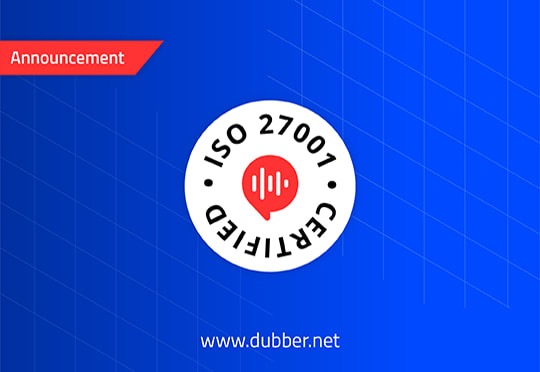
ISO 27001 is an international standard for information security, which provides a framework for the information security management system (ISMS) within an organisation. Like Dubber, ISO 27001 is all about constant improvement, and encourages a system that works to constantly optimise itself.
In order to gain certification, we developed and implemented a rigorous security management programme, including an ISMS. This management system went through a rigorous auditing process that thoroughly examined our approach to information security and the controls we have put in place. We were able to achieve this by establishing an ISMS leadership team, comprising of senior management, and an InfoSec lead to champion and to manage this within Dubber. We engaged InfoSec consultant QMIS in the early stages of the initiative and we leveraged the ISMS.online tool to enable us to centrally manage our ISMS, and to make ongoing governance easier for us in the long term. In order to receive our certificate, we worked with these cloud security specialists and were put through a rigorous auditing process that thoroughly examined the information security management and controls we have put in place.
“Our ISO 27001 certification is an important indication of our dedication to protecting the information handled by Dubber. Our approach to compliance and security has always been proactive and rooted in continuous improvement, and this certification shows our dedication and long-term commitment to data protection.”
— James Slaney, Dubber Head of Product
The key principles
The three tenets of an ISO 27001 compliant ISMS are:
- Confidentiality: ensuring access to information is restricted to certain authorised individuals
- Integrity: ensuring that information processing methods are consistently accurate and thorough
- Availability: making access to information and assets available to authorised individuals
How we protect data
Here are some of the ways we at Dubber are continually working to protect the data we process both on our platform and throughout our organisation:
- Establishing, maintaining, monitoring, reviewing, auditing and continually improving our ISMS
- Establishing, reviewing and communicating our information security objectives and performance measures
- Committing to satisfy business, legal, and regulatory and contractual security obligations
- Committing to continual improvement of our ISMS by seeking feedback from clients, staff, and through internal and external audits
- Ensuring that the ISMS is communicated with every member of the Dubber team
To learn more about Dubber security, you can download our white paper, or get in touch with one of our team.
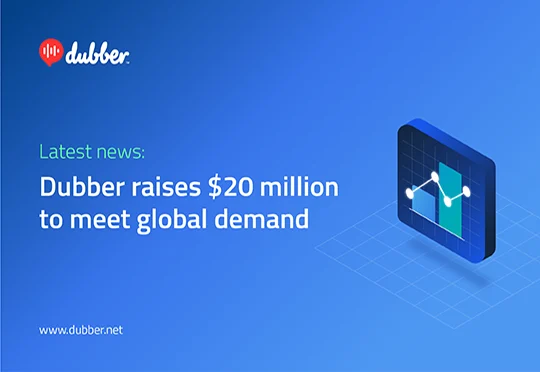
We are pleased to announce that we have successfully secured AUD$22 million from investors, with an investor demand that exceeded our aims. These funds will support our continued pursuit of global growth opportunities and allow us to scale to meet increased demand and secure long-term recurring revenue.
How this raise will be used
Dubber have existing agreements with 92 telecommunications service providers and we are continuing to see strong demand for our products. Service providers are seeking to provide services to their customers that are rich in features and they are standardising these across multiple networks. These existing relationships will be instrumental in driving customer uptake of our services and bring with them long-term value through recurring revenue. Our new investment will go towards our continued expansion into new deployments with service providers across the globe, particularly in North America and Europe.
Our Dubber Connect model is a fully-managed service that allows rapid deployment of our products. Its popularity with service providers means that we will be investing in additional business development and sales staff to ensure we can develop this model further and refine our offering.
As the embedded recording service for the Cisco BroadCloud platform, Dubber has substantial global opportunities. Funding will support growth avenues through the global presence of Cisco BroadCloud. Our recent agreement with IBM to market a joint technology solution will also receive support to fully take advantage of IBM’s substantial client base.
A ‘significant milestone’
Steve McGovern, Dubber CEO, commented on the raise: “This is a significant milestone for Dubber, following strong growth across our key metrics. Dubber has a unique advantage through its operating leverage, that to date has allowed us to service the largest carriers in the world, in a number of different continents, with less than 60 employees. We are truly excited to now invest in the next stage of growth to ensure that we become the de-facto industry solution in our market.”
Download our ASX announcementfor full details of the raise and how we plan to use the funds.

Dubber Provides Cloud Call Recording for Optus Loop

Playback is a call capture service for individuals that allows users to save calls that have already taken place. Users have three days after a call to save it for unlimited replay for one year. Features such as tagging and searching calls are available via mobile and web apps.
How does Playback work?
Playback is an innovative call capture service designed specifically for individuals. This unique product allows users to save calls that have already taken place. After each call is received or made, the user has three days to save it for unlimited replay for one year. Playback has all of the features of Dubber: allowing users to tag their saved calls, search and filter their results, and securely share their calls. Playback is available via the Dubber mobile app, which sends push notifications to remind users to save calls. Playback can also be accessed via web and deskphone apps. Users are charged per saved call. Playback works across fixed line and mobile calls, allowing users to access all of their communications.
A unique product for individuals
Playback calls remain private to the user who made or received them, unless they are shared by the user. Playback has one private login and the user has full control over which calls are saved and which aren’t. Whitelist and blacklist functions can even automate the saving or deleting of all captured calls from or to certain numbers.
Playback is the answer to forgetfulness. If you’ve ever put the phone down and immediately forgotten an important detail from the conversation, Playback is for you! Perfect for moments when a pen and paper aren’t handy, Playback can help everyone in their day-to-day lives as well as in the world of work. Playback is great for busy people on the go, people who hate taking notes and meeting minutes and those of us who are just a bit forgetful sometimes.
Just like other Dubber services, Playback can be managed via a mobile app: anytime, anywhere. Playback can also be used alongside voice AI Zoe for added benefits including transcription, keyword search, and sentiment analysis.
Designed for busy workers
Playback is designed for mobile workers who take calls on the go. Many sole traders do not have the luxury of taking calls at their desk and often conduct business while travelling between jobs. Playback gives them peace of mind that all those important details about their next job are safely stored for them to replay at their leisure. Here are some examples:
Sole traders: plumbers
Plumbers spend the majority of their time working remotely, or travelling from one client to another. Any calls they receive about new work are likely to be taken while they are working or driving, neither of which is convenient for noting down details such as the address. With Playback, a plumber is able to take a hands-free call while driving, safe in the knowledge that they can confirm an address later. At a time when they have returned to their desk and can note down important details, they can browse their call history and choose the calls they want to replay in order to confirm the details of the job.
Journalists
Busy journalists spend much of their time calling sources and conducting interviews over the phone. Rather than trying to make notes during a call, where they might get distracted from the conversation, or miss important details, journalists can replay a conversation to write up an interview. In an industry where accuracy is crucial, knowing a phone call can be replayed at any time gives peace of mind to journalists who can be reassured that any quotes can be easily confirmed.
C-level executives
Playback can make the life of everyone who conducts their business while on the go a whole lot easier. C-level executives who jump from one phone call to another, often taken while travelling between meetings, can benefit from the gift of hindsight that Playback brings. The ability to replay calls — anytime, anywhere — can save time writing follow-up emails to confirm details. Important business can be undertaken over the phone, with the knowledge that the voice equivalent of a paper trail is securely stored in the cloud.
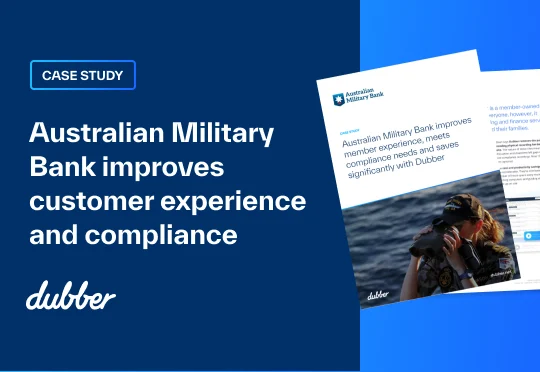
Voice calls are the main point of contact for Australian Military Bank members. The Bank uses Dubber call recording as an essential part of improving the member experience and compliance.
Here’s the backstory
Australian Military Bank is a member-owned mutual bank. Open to everyone, however, it provides specialist banking and finance services to Defence personnel and their families.
There are 14 branch locations across Australia and 11 internal Departments connected to Dubber CallN.
Head of Marketing Penelope Killick says the bank’s membership differs from other financial institutions. Many members serve in the Defence Force, they get deployed across Australia and may find themselves posted overseas.
She says: “We’ve got members who are always on the move. That’s why contacting via phone is so important. Our members may be deployed in places where they don’t have access to a branch. For these reasons, voice calls are the main point of contact for many members. It’s vital that we get it right.”
While the Bank has a central call centre in Sydney, many calls are either directed to branches or routed to them. The system can transfer after-hours calls in Eastern Australia to a branch in Perth. The contact centre team are able to handle many enquiries that might otherwise be a branch’s job.
Customer Experience is everything
Rizwan Dean, the Bank’s IT manager, says the Bank uses Dubber CallN for quality assurance, call recording and analytics. It allows staff to go back into calls, review a conversation, understand what members are talking about and identify their pain points.
He says: “We get a lot of information by listening to calls. Our conversations with our members tells us a lot about what they really want from us as their bank. We find Dubber is a very useful application.”
Killick says improving the member experience is a key priority for the Bank. “We can provide them with services to meet their requirements. We can help members particularly at the moment when Covid can mean circumstances may change”.
“Being able to log-in, and look at what is happening with member enquiries is important. We like having the ability to coach our staff in how to better respond to what are often unique requirements. And we find the tool useful when it comes to handling complaints, which is part of improving the member experience.”
Proactive Fraud Detection and Compliance
Dean says the Bank also uses voice recordings to detect and deal with fraud. Calls are easily checked if the fraud team suspects there is an issue or if a customer asks a staff member to do something fraudulent.
Another important related use is bank compliance. Australian regulators require the Bank to keep customer recordings for seven years. The recordings provide immutable evidence of every customer conversation.
As part of that process, auditors have the opportunity to review sample recordings and their own quality assurance checks. They provide reports to the Board and to regulators, to demonstrate they are meeting compliance requirements.
Cost Savings, Reliability and Productivity in the Cloud
Australia Military Bank’s dispersed network uses unified communications and that’s a natural partner for Dubber’s unified voice recording.
Dean says it means the Bank can use a single solution for all its recordings.
He says; “When I joined the Australian Military Bank one of the biggest pain points was that the Bank had to put physical computers and hardware at each site. These connect to our network and sit listening to voice traffic.
“The recordings were then uploaded back into the CallN portal. That was a problem because our branches are located at Defence sites. When there was maintenance, security work or patches on the Defence network, our branches would lose their connectivity. That meant we would have gaps in our quality assurance and compliance.
“Going to Dubber CallN cloud made our lives so much easier. That’s because it no longer matters where someone is dialling in from, even from mobiles, the recording happens at the Telstra gateway, not the branch.
“It means the gap is now closed. We don’t miss anything. It also means the overall
hardware footprint and the capex is significantly reduced.”
The cost and productivity savings to the Bank are considerable. Previously every time a computer broke down, they’d have to replace it and send it out to the site and all machines required constant patching and upgrades to stay compliant.
As a result of the move to the cloud solution, they’ve eliminated the huge number of hours spent every month building and patching computers and guiding staff how to set them up on site.

Dubber Half-Year Commentary

Investor Presentation Feb 2019

We are so pleased to announce that Cox Business has launched on Dubber. Cox Communications is the largest privately held telecommunications company in North America and Dubber’s call recording and voice AI services are now available across the Cox Business network for all UC, SIP Trunking, and VoIP customers.
Dubber and Cox have integrated their platforms to provide an automated sign up service for Cox Business customers that will instantly provision Dubber call recording on the Cox network. The service is available now for Cox Business customers, after a successful beta testing deployment stage.
Steve McGovern, CEO Dubber:
“Cox is regarded as a leading provider of business communications globally, and is one of the most trusted brands in the telecommunications industry. The Cox integration into dubberconnect.com, with Call Recording, Playback and Contact Centre services, in addition to the Zoe AI suite, provides a seamless experience for customers and a world class service offering which we believe will have widespread applicability across the Cox Business network. We are particularly pleased with the very strong uptake of our premium Call Recording plans, “Contact Centre Agent” and “Plus.”

Dubber Delivers Quarter of Record Growth

When you think about call recording, you’re probably thinking of server rooms full of equipment, call centers, RVAs announcing that this call may be monitored for training and coaching purposes…but all that is changing. Call recording no longer requires huge CapEx investment, nor the floor space to house servers. It can enable a business to do far more than just listen to a few random calls a month to rate a consultant’s performance.
Call recording with artificial intelligence opens up a world of new possibilities like reducing churn and increasing net promoter score. If you’re a marketing manager or customer experience manager, this blog is for you!
If churn or retention is part of your targets, you probably think you have enough data on your customers and know exactly why they’re leaving. You probably have access to some reports that tell you why a customer is calling, based on their IVR selection, right? But what about all the other information transacted when a customer is talking to one of your call center agents?
Chances are, unless a customer escalates an issue, or you listen to a few calls a month, you have no idea what happens on a call. Dubber’s Zoe can change all that.
Imagine receiving a report that gives you customer sentiment on every call that takes place. Or being able to identify phrases or keywords spoken during a call that may highlight customer pain points you had no idea existed. Zoe can do this and so much more!
Campaign Reporting
As a marketer, either you or one of your team will be likely be providing regular campaign reporting. And if this is the case, you’re probably relying on the call center to have accurately recorded how the customer heard about you, or if they are calling in relation to a particular campaign. Zoe’s advanced search functionality means you can pull every call where a campaign name or offer was discussed. No more wondering if your response rate is correct, you’ll know exactly how successful your campaign was without worrying if the call centre entered the right campaign details into your CRM or not.
End the guessing game
How many times have you had to estimate the impact of a price rise? With Zoe, you’ll know exactly how many people called and if they churned or changed product, so next time round it won’t be such a guessing game. Simply enter the date range and key words such as ‘price’ and search for negative sentiment to find every call. From here you can either listen to each call or review the transcript and sentiment.
Get the edge on your competitors
Understanding sentiment can give you the edge on the competition. Let’s say a customer has had a negative experience with a call center agent, we’ve all heard these one hundred times over at a BBQ. Chances are, no one knows this call took place aside from the agent and the 10 people the disgruntled customer told. Zoe can alert relevant persons in your organization to the call, allowing them to contact the customer and potentially turn a negative experience into a good one: stopping that customer from churning or leaving a negative review and telling anyone who’ll listen how bad their experience was.
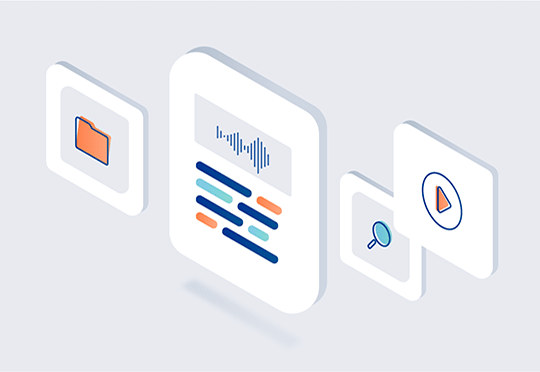
Have you ever put the phone down and forgotten what the last point was? What was the last item you are meant to pick up on the way home? When is that report due? Playback by Dubber is the answer.
These days, many of us are working on the go. If you’re driving or running from one place to the next, grabbing a pen and paper isn’t really an option, so you’re left with having to call the person back, or try and remember the details of the call.
Have the conversation over and over – in a good way!
Playback allows you to save your calls, with the option to keep the call for up to 3 days after it took place. Once you’ve chosen to keep the call, you can listen to it as many times as you like via the Dubber app on your phone. Once you’ve decided to keep the call, a secure audio file is generated, which only you can access.
Claim it as your own
Playback is available to service providers to white label as their own for their customers. The Dubber App can also be customized with your own branding.
Connect via Dubber Connect
If you’re with Cox Business or AT&T, ask your account admin to enable Playback for you and start Playing-back straight away. Your boss and spouse will think your memory has improved immeasurably!
Playback is great for busy people on the go, people who hate taking notes and meeting minutes and those of us who are just a bit forgetful sometimes.
Contact us for more information on Playback today!

Constitution of Dubber Corporation Limited

Dubber and IBM to provide Cognitive Call Solution

Notice of Annual General Meeting

Company Presentation

Contact centres would be nothing without their agents. As the first point of contact for customers, contact centre agents are the face, or voice, of the company. Organisations with contact centres need to ensure they nurture their agents and provide them with the tools they need to give the best customer care.
With contact centres such an important part of a business, it is important that organisations do what they can to improve employee morale. They must also make sure agents are not held back by technological limitations. When developing our call recording services we had contact centres in mind. We made sure that our Always On call recording and Zoe voice AI could help solve some common issues.
Improve the performance of contact centre agents with morale-boosting AI
In a contact centre, workers cannot just pick up their tasks when they return to work after an absence. Customers will continue to contact the organisation no matter how understaffed the contact centre may be, and it’s up to the remaining agents to manage the workload. At peak hours, this can be stressful for agents who are forced to handle more calls than usual.
When building our call recording solution, we wanted to find ways for organisations to learn more about their customer interactions and the way their business works. We know that an agent’s morale can decrease when understaffing creates a bigger workload for them. This is why we wanted to create technology that can help organisations to reward contact centre agents who outperform at their job. The sentiment analysis of Zoe, our voice AI service, uses speech characteristics to identify the mood of a caller throughout a conversation. Zoe then assigns the call with a positive or negative score. Agents who consistently achieve positive scores can be rewarded for their hard work, and feel like their success can finally be measured and recognised.
Increase the efficiency of your contact centre agents with automated workflows
Contact centre agents often have to use a variety of different software during their working day. This may include CRM databases and workforce management tools. With these different applications, agents may have to familiarise themselves with numerous different interfaces; jumping from one window to another to perform different tasks.
At Dubber, we didn’t want to add yet another interface to deal with. That’s why we made sure that, via our open API, an organisation can integrate our service with other applications. Our API allows developers to integrate Dubber’s functionality into existing systems. This allows the call data and recordings we collect to be used in other applications. It also allows other applications to use our technology, such as our AI or search functionality, to automate processes. For example, a manager could receive a Slack notification after a certain word is spoken during a call.
With the contact centre representing an organisation at key moments on a customer’s journey — enquiring, placing orders, making complaints — it is important to look after your contact centre agents and get the most out of your data. Contact a member of the Dubber team to see how you can provide the best solution for your contact centre.
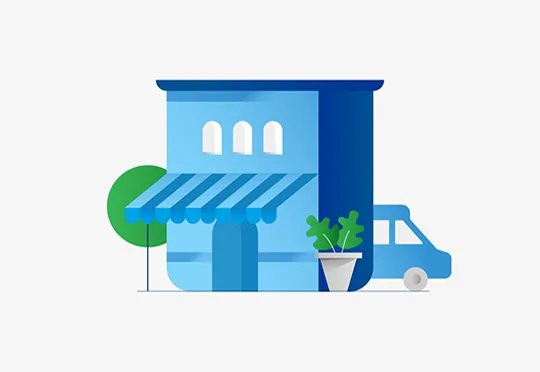
Technology has the power to make a small business big. Unfortunately, 30% of small business owners find it hard to adapt to new technology, according to a survey undertaken by AT&T.
Common obstacles for small business
Early adoption of technology can be make or break for a small business, but they need help and support in order to take steps towards digital transformation. Many small business owners feel that they are not in a financial position to adopt new technology. With the introduction of SaaS products, smaller businesses now have access to advanced technology for an affordable monthly subscription.
Of course, money is not the only resource that is scarce within the world of small business. Time is another valuable asset that companies of this size are often lacking. New technology must save time for an organisation and not require lengthy installation processes that disrupt current workflow.
Call recording and voice AI as a service
Dubber have democratised call recording and voice AI. We have made this technology available to businesses who previously were discouraged from adopting such services, due to the prohibitive cost of legacy solutions. We’ve also transformed the onboarding process: cutting the time and costs required to deploy our cloud call recording. We even created Dubber Connect to make provisioning customers even easier and reduce the disruption that can be caused by implementing new solutions.
With our limitless storage, there are no hidden costs. Customers can choose the storage plan most suited to their needs. If it turns out they want to increase their minutes allowance or storage length they can change to a different subscription at any time. This flexibility gives small businesses the reassurance that they aren’t committed to a solution that may in the future become too expensive.
Showing the value in voice to small business
Small businesses need to be shown that call recording is no longer solely for compliance. It’s not just for huge enterprises with vast contact centres. SMBs can benefit from capturing their communications too. To illustrate the ways in which businesses of all sizes can benefit from call recording, use cases are a great way to convince customers. Taking the time to enlighten your user base can result in an expanded market and increased revenue.
Digital transformation is something that many organisations are undertaking. With many aspects of business moving to the cloud, small companies shouldn’t be left behind.

Dubber Annual Report 30 June 2018

We’ve updated our API to make it super easy to access and manage team information. With the updates, service providers and their customers no longer have to log in to the Dubber portal to create and manage teams and their members. Using the API, service providers will be able to administer customer accounts straight from their own portal, as well as enabling customers to manage their own accounts through third-party applications, including their CRM.
Each account will automatically get a team named ‘All’, which cannot be deleted. New teams and their members can be easily managed through the API and Dub points can also now be created and deleted via the API to add and remove call recording implementation easily.
With multiple interfaces a part of modern working, this API update means one fewer application open on your desktop. Account admins can manage their teams from an existing application that they are familiar with, allowing colleagues to share their calls more easily.
The techie bit
We have updated our developer page to include the updates to our API. This page includes samples of how to access the Dubber API can be accessed. All these samples provide the URL for the Sandbox environment, allowing for safe and easy testing of any new developments.
Scroll down our developer page to find the new teams updates
For example, to create a new team member in an existing team, the API request would be:curl -i -k -H "Authorization: Bearer " \
-X POST "https://api.dubber.net/sandbox/v1/accounts//teams//members" \
-H "Content-Type: application/json" -d '{ "user": "johntravolta-dubber-net", "listener": true}'
This would receive the following response:HTTP/1.1 201 CREATED
{
"id": 1234,
"user": "johntravolta-dubber-net",
"date_created": "Wed, 09 Oct 2013 22:39:19 +0000",
"date_updated": "Wed, 16 Oct 2013 00:48:40 +0000",
"listener": true
}
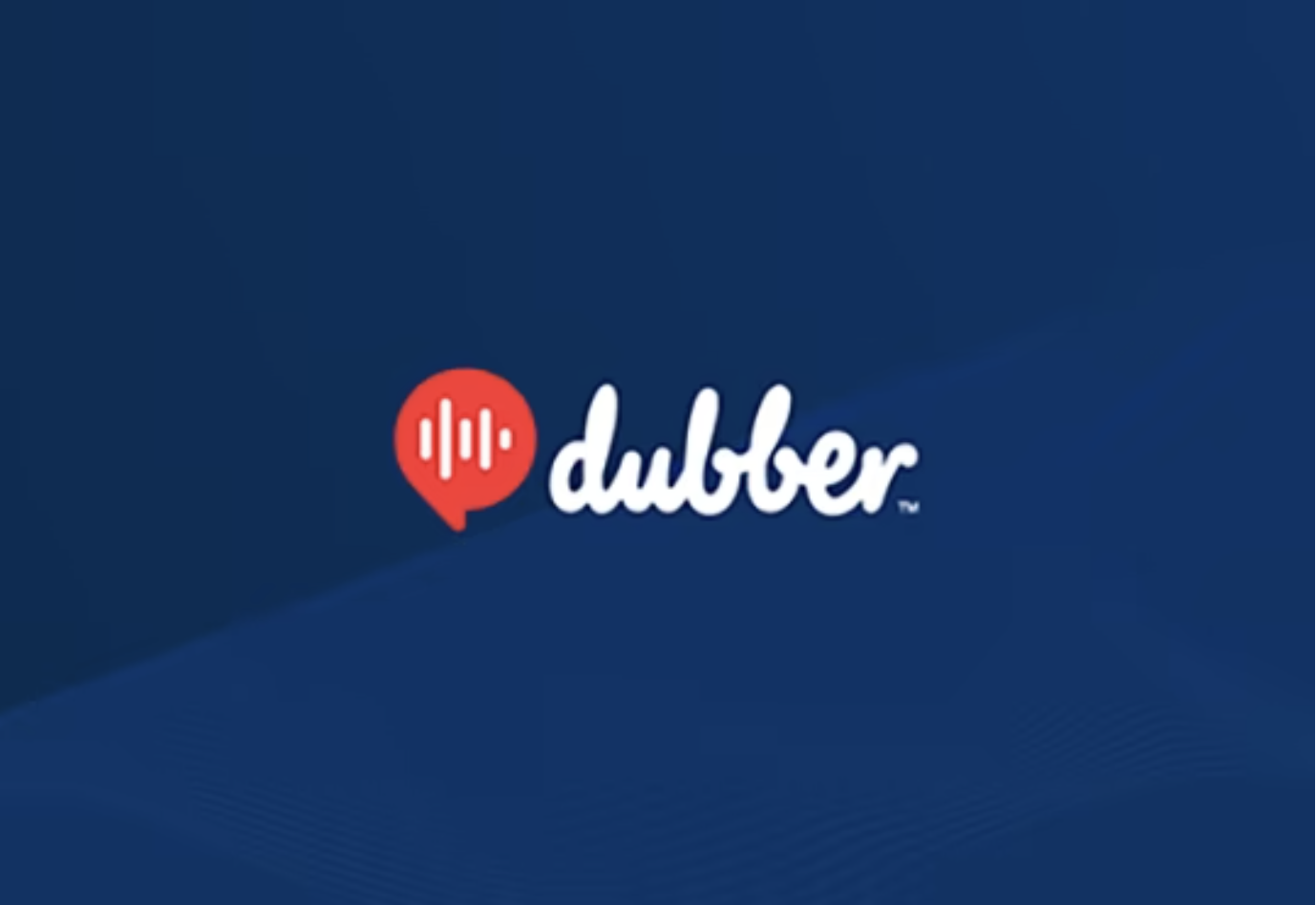
- CBTS integrates Dubber cloud call recording platform for Call Capture and Analytics
- Incumbent telecommunications carrier in greater Cincinnati, Ohio area, with national US business footprint
- Dubber Platform to be available to CBTS Customers from May 2018
- Migration of 2,800 call recording users to Dubber platform by end of CY Q2 2018
Dubber has been selected by tier one regional telecommunications provider, CTBS – https://www.cbts.com – a wholly owned subsidiary of Cincinnati Bell, to provide cloud call recording for its CBTS product portfolio.
Headquartered in Cincinnati, Ohio, the company is a tier one regional service provider that provides integrated communications solutions – including local and long-distance voice, data, high-speed Internet and video to residential and business customers in the Greater Cincinnati and Dayton areas. Through wholly owned subsidiaries CBTS and OnX, the company also provides business communications and IT services to customers throughout the USA and Canada.
CBTS will integrate the Dubber platform to provide market-leading call capture and analytics into its CBTS product portfolio by the end of May 2018. In addition, the company is immediately transitioning 2,800 call recording users on legacy systems onto the Dubber platform. This transition will be completed by the end of CY Q2 2018.
Steve McGovern, CEO, Dubber:
“We are delighted to be working with CBTS to support them for their call recording requirements on the CBTS Business platform. As a significant regional service provider in the United States, they are viewed as a market leader and innovator in the markets they serve. By integrating the Dubber platform as a feature rich, value-added service for users, the company will be able to provide their business customers with the most scalable cloud call recording and analytics platform available. We are looking forward to working closely with the CBTS team as they deploy and roll out the Dubber platform to their customers and prospects.”
The CBTS agreement will advance Dubber’s strategy to accelerate active users and associated revenues while establishing global leadership in cloud call recording and voice data management.

DUB Interim Financial Report 31 Dec 2018

At Dubber, we have built our products and services in the cloud: benefitting from the unlimited scalability and storage that this provides. We have chosen Amazon Web Services to enable us to provide high levels of security, reliability, and service. Our infographic shows how a move to the cloud can bring numerous advantages.

The world is changing. The way we communicate has been transformed and the world of work is adapting to new technology. We wanted to learn more about how people’s working lives have changed, and their frustrations with technology that hasn’t quite caught up, so we launched a targeted research campaign to learn more.
Our research surveyed over 2000 service sector employees to better understand the ways in which the world of work is changing and how communications service providers could provide products and tools that could help them reclaim their time.
An increasingly mobile workforce
Workers are no longer tied to their desks and jobs are becoming much less office-based. Our survey found that a third of the workers spend more than four hours away from their desk during their working day. With 18% away for eight hours or more, a significant number of service sector workers are completely mobile.
We wanted to find out just how productive employees are during this time away from their desk. Do they find they are catching up on missed work when they are back at the office? Are they continuing their jobs on the move? And, more importantly, do they have the tools they need to do their work effectively?
Cohesive communications
Dubber are always looking for ways to help people to manage their communications and make the most of every phone call. We were interested to find that over a quarter of all workers we surveyed make more than five business calls a week while mobile, and a tenth do the majority of their business calls on the move. With all these conversations taking place away from a desk, a keyboard, and a trusty notepad, it can be difficult to keep track of everything that takes place during a conversation.
James Slaney, Dubber co-founder, has commented on the research; noting that, “The ability to work anywhere is obviously advantageous and a necessary component of modern work life, but it remains challenging when information is poorly recorded and crucial details missed when workers have phone conversations. Phone calls are often reserved for the important stuff; for the decision that needs to be made, for the question that we want answering urgently. We pick up the phone when we just need to get things done.
When phone calls can be recorded and the information gathered on them digested in the same way we process emails, we will see a resurgence in the number of calls made in the workplace. Once only provided as an always-on service deployed for regulatory compliance or contact centres, now businesses can choose from a range of call recording options and capture their calls at the touch of a button.
Advances in cloud computing and digital transformation mean that phone calls will better retain their value to businesses and advances in speech intelligence technology will allow businesses to unlock their priceless data. For the multi-tasking, mobile working Brit, the ability to make better use of the information gathered through phone calls gives peace of mind so that miscommunication and misunderstandings will be a thing of the past.”
How service providers can help workers
Providing call recording and speech intelligence as a service allows service providers to supply their customers with solutions capable of meeting the needs of an increasingly mobile workforce, at a cost that is affordable to businesses of all sizes. Dubber’s monthly subscription model allows smaller organisations to access the benefits of call recording and pass these efficiencies on to each of their employees.

The benefits of call recording are now available on demand. Once only provided as an always-on service deployed for regulatory compliance or contact centres, now businesses can choose from a range of call recording plans and capture their calls at the touch of a button.
2018 is set to be a year of digital transformation, when organisations take their first steps into the cloud and begin to reap the benefits. Looking to the future of communication, phone calls will retain their value and advances in speech intelligence technology will allow businesses to unlock their priceless data.
How to record your calls
A move to the cloud means a move away from being tied down: to investment, to storage plans, to bulky equipment. Cloud call recording as a service allows organisations of any size to capture their conversations at an affordable cost. With no on-premise equipment required, Dubber’s call recording can not only be deployed rapidly, but can also be installed without the need for CapEx.
Always on
Always on records all calls, directly from the network. Perfect for regulatory compliance, or for large businesses that want to record calls for training purposes. Team hierarchies can be established, making calls accessible only to admins, supervisors, and the individual users who made the calls.
On demand
On-demand recording is a user-initiated service that only records selected calls. The user can decide to record a conversation before or during a call using a function on their desktop or handset. Recorded calls are stored in the same way as other team members and have a hierarchy of access permissions. Each individual user only has access to their own calls, while supervisor and admin permissions grant access to the calls of an entire team.
Playback
Specially designed for individuals, Playback gives users the gift of hindsight with the option to save a record of their calls for up to three days after the call has been made. They can then access them through their own private dashboard using a web, mobile, or deskphone app.
Zoe
Zoe transforms everyday phone calls into valuable data assets for both businesses and individuals. A comprehensive suite of speech intelligence modules, Zoe lets users unlock the insights held within the data of voice calls through its key features: Smart Search, Keywords (coming soon), and Sentiment (coming soon). Businesses can examine their customer communications to increase their understanding of their interactions and discover areas of potential improvement.
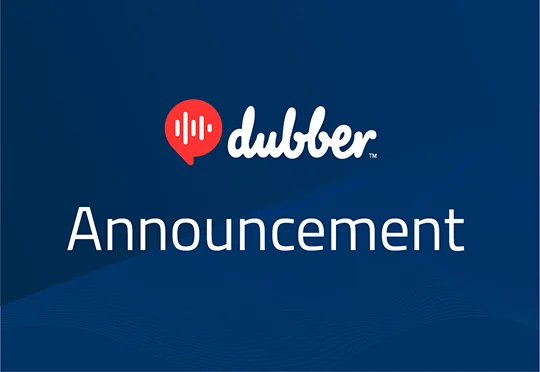
Dubber Completes $6.5 Million Placement with Institutional and Sophisticated Investors
Dubber Corporation Limited (ASX: DUB) is pleased to announce that it has received commitments for a $6.5 million capital raising placed with institutional and sophisticated investors. The capital raising will result in the placement of 17,143,572 new fully paid ordinary shares at an issue price of $0.35 per new share (with a further 1,428,572 subject to shareholder approval) under the Company’s current placement capacity in accordance with Listing Rule 7.1 (5,435,343 shares) and 7.1A (11,708,229 shares). The price of $0.35 meets the requirements of LR 7.1A.3 in being greater than 75% of the 15-day VWAP.
Settlement of the placement and issue of new shares is expected around Wednesday, 20 December 2017.
The placement was supported by existing shareholders and institutional investors. The funds raised will be used to further expand Dubber’s operations, particularly in North America and Europe where the Company is seeing strong demand for its services and a number of strategic agreements with tier one service providers reach anticipated full deployment in calendar 2018. The Company will also be adding additional staffing and strategic account directors as its cloud call recording and intelligence platform is fully integrated into BroadSoft’s BroadCloud Unified Communications delivery platform.
As part of the capital raising a significant portion was taken by entities managed by James Spenceley, an Australian telecommunications pioneer and founder of Australia’s largest fixed line Telco Vocus Group Limited.
“The adoption of cloud based IP telephony is accelerating globally, a pre-requisite of that successful transition is cloud based call recording. Dubber’s solution is simply world leading and solves a very real problem for Telcos and Vendors looking to transition their clients to the cloud. It is exciting to be able to support a home-grown technology business addressing a global market and validated by some of the world’s biggest telcos and telephony vendors” said Mr. Spenceley.
As part of the capital raising, Managing Director Steve McGovern has subscribed for 1,428,572 shares ($500,000.20) subject to shareholder approval.
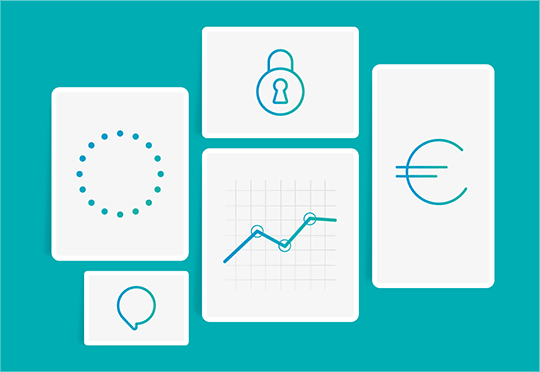
The deadline for compliance with MiFID II regulations is upon us and the time to adapt to the new rules is now. This extension of MiFID legislation requires any company or employee to record all calls, across mobile and fixed lines, that include financial advice that could lead to a trade. More regulation shouldn’t mean doom and gloom: smart organisations will see these changes as an opportunity to set themselves apart from their competitors with an honest and trustworthy approach to trading and financial advice.
Compliance is an opportunity, not a burden
With technological advances, businesses have the opportunity to make huge improvements in the way they work and the enforcement of MiFID II regulations are the perfect cue to start. By utilising cloud technology to meet the requirements of the new legislation, financial organisations can turn these regulations to their advantage to create value for their business: at an affordable cost, and with no disruption to their existing processes.
Looking beyond the necessary steps required for MiFID II compliance, financial organisations can actually improve their offering and beat the competition by taking advantage of new opportunities. The benefits of a proactive approach to compliance include:
- Improvements in business and customer service practices
- Setting a higher bar for competitors puts businesses ahead of the game
- Gaining a reputation for best-in-class practice
- An opportunity for new technologies to harness the true value of recorded data
- Risk identification and management
Intelligent call recording goes beyond compliance
By deploying call recording for compliance, organisations can also take advantage of the added benefits that can be accessed. Dubber’s call recording is available with the added intelligence of Zoe: a sophisticated suite of speech analytics tools that can help businesses unlock the data held within their voice calls.
Identifying issues and opportunities
Speech intelligence can be instantly added to Dubber’s cloud call recording, allowing organisations to turn MiFID II compliance to their advantage. Zoe can help businesses to analyse their working practices — identifying issues that can be addressed as well as opportunities for development.
Risk management
With Zoe’s Smart Search functionality, recorded calls company-wide can be searched instantly, no matter the size of the organisation. Keywords associated with financial risk can be identified, highlighting conversations that might contain issues. This kind of monitoring promotes a reassuring environment for the consumer.
A competitive advantage
The aim of the MiFID II legislation is for consumers to regain trust in the financial industry, and financial organisations should jump at the chance to showcase how their company goes above and beyond their competitors. By setting a higher bar for financial practice, organisations can get ahead of the game.
A proactive approach to MiFID II regulations
Compliance with regulations shouldn’t be a reactionary game, with organisations playing catch up to attain the minimum requirements to meet regulations. Those who will lead the market will be those who proactively consider how to provide best-in-class practices that offer a better experience for their customers. With MiFID II following so closely behind the original MIFID legislation, MiFID III can’t be too far behind. By taking a proactive approach to customer service and business development, organisations can use technology to their advantage to stay ahead of the game.
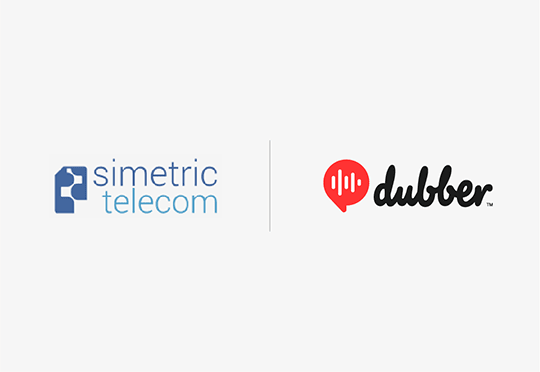
The time to adapt to the new MiFID II rules is now. Together with unified telecom services provider Simetric, Dubber has the solution to help financial services organisations comply with the expanded regulations of MiFID II.
Delivered through a SIM card, this advanced communications solution gives users the ability to capture all of their mobile conversations as well as their fixed line calls – a key component of MiFID II compliance. The regulations require all conversations that result or might result in transactions to be recorded, and includes equipment provided to, or authorised for the use of, employees and contractors of the firm – mobile phones being a key example of this clause. This new service will allow users to have a single number across their mobile and fixed line platforms, with Dubber communication capture available across all of their devices.
As MiFID II regulations have extended their coverage to include independent financial advisors, a call-recording solution that can be implemented quickly and easily through a SIM card is an ideal solution. Dubber + Simetric’s call recording solution is cloud-based, enabling users to deploy the service rapidly.
An extra feature of this advanced communications solution is Zoe, Dubber’s powerful speech intelligence suite, which enables users to search through their calls and analyse the voice data that has been captured. Calls related to trades can be quickly located — a crucial component of MiFID II compliance — using a variety of search criteria, but the power of Zoe doesn’t stop there. Zoe’s capabilities are developing every day, and new functionality will allow users to gain valuable insights in a variety of ways from their conversations.
At a time when organisations must be seen to be taking compliance seriously, implementing a comprehensive solution that records communications across devices is an ideal way to ensure your firm is ready for MiFID II. Not only will the worry of compliance be lifted, but consolidating your conversations and using one number for all communications will streamline your workflow.

Used as a new way to deliver unified communications functionality through web and mobile applications, WebRTC has quickly grown in popularity in recent years and is utilised by social platforms such as Facebook and Slack. WebRTC began as a free project that aimed to provide high quality real-time communications (RTC) capabilities between peer-to-peer connections, built into web browsers and mobile applications using simple application programming interfaces (APIs) and a common set of protocols. The growth of the global WebRTC market is expected to be over 40% between 2016 to 2023 (see chart below).

Source: Credence Research
This initiative enables audio, video conferencing, file transfer, instant messaging and also screen sharing without the plugins such as Adobe Flash that have always been required in the past. WebRTC can be seen all over the internet, such as on websites that allow consumers to access contact centre agents through their browser. Live customer assistance can be provided through a chat service or through a WebRTC call that can be placed directly through the browser. It is also what powers calls through instant messaging services such as Slack and enables the voice and video chat that is built in to Facebook’s Messenger.
Previously, this type of plugin-free RTC technology has only been available to large enterprises, as licensing fees for the audio and video technologies required were prohibitively expensive. WebRTC is the first of its kind; allowing a powerful RTC standard to be available to the public as open source. It has the potential to create a new wave of applications and change the way we communicate.
WebRTC runs on JavaScript, which can be easily incorporated into any web application to enable the functionality through a JavaScript API. The services that WebRTC provides can also work simultaneously so that, for example, files can be shared during a teleconference.
Intentionally developed to not provide any preference of protocol, WebRTC is compatible with a variety of existing communications infrastructure such as session initiation protocol (SIP), which is widely used for voice and videoconferencing over IP networks. This means that, just like other VoIP calls, WebRTC calls can be recorded by Dubber’s communication capture software.
What are the advantages of WebRTC?
WebRTC has many advantages, including significantly better video quality than Flash, session connection speeds that are up to 6x faster, and reduced audio and video latency that enables conversations to feel more natural.
Many web services already have RTC capabilities, but only through plugins. WebRTC doesn’t require any plugins and therefore has none of the download, installation, or update processes, or troubleshooting that usually accompany RTC services.
The simple APIs and protocols of WebRTC have the potential to democratise communication across a range of applications from telephony to gaming.
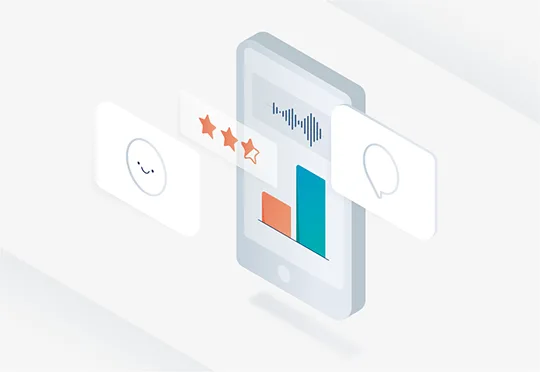
Customer service is an important area of investment for businesses wishing to differentiate themselves from their competitors. With customer contact largely occurring over the phone, the voice data from conversations with customers has become a valuable business asset. Accessing this data to enhance the customer experience can bring numerous benefits. With legacy call recording solutions this data is more difficult to access, however, call recording services built on a cloud infrastructure have the storage and processing capabilities required to truly harness the voice data collected from customer calls. Accompanied by a speech intelligence solution that can analyse the data, a cloud call recording service can allow an organisation to truly listen to its customers. The global speech analytics market has been growing steadily over the past few years and is set to continue, read on to find out how new technology can improve customer service in contact centres.
Quality assurance
Using speech intelligence software such as Zoe from Dubber, contact centre supervisors can monitor their contact centre agents to ensure they are performing to the best of their abilities. Script adherence is important when staff are given directives to do with how to handle certain situations, or when there is a sales campaign in progress. A feature like Keywords can identify those contact centre agents who adhere to scripts, and show calls that do not contain certain words or phrases.
Zoe’s Sentiment feature analyses the emotions of callers using speech characteristics such as tone, volume, and speed of speech and assigns a positive or negative score to a conversation. This allows businesses to identify negative calls that might be from frustrated callers – an automated process could even be enabled to alert management to follow up on negative calls. Trends in negative calls could be identified to show opportunities for development. As Zoe operates in the cloud, and utilises the processing power of AWS, detailed reports can be created using data from all calls rather than a small sample
Dispute resolution and detail confirmation
Recorded calls can provide definitive proof of what was said in a conversation. While this can be useful for everyday business – replaying calls taken on the go to confirm important details back in the office, or replaying orders to ensure accurate fulfillment – recorded calls are also a vital tool in dispute resolution. Zoe’s Smart search feature can easily scan call archives using a variety of criteria from date of call to a specific word or phrase spoken. This quick search means that disputes are settled as soon as possible.
Staff training
Playing real calls is the most effective training method for new staff. The ability to play an example of an actual phone call gives a realistic insight into the conversations a new contact centre employee can expect in their role. Examples of how to deal with angry callers can be played, with proven methods demonstrated.
Recorded calls can also be helpful for existing contact centre staff. An employee’s own conversations can be replayed to show how a call could be handled differently, while successful calls can be shared with a team for motivation. A culture of self-evaluation can also be nurtured by encouraging employees to replay their own calls and reflect on how they dealt with these customers and issues. Dubber’s web portal allows contact centre agents to access their own calls, and team permissions can be set-up so that supervisors can listen to their team’s calls.
Rewarding excellent staff
Zoe can be a great tool for identifying high-performing staff. With Sentiment’s call scoring, contact centre employees who consistently turn negative calls into positive interactions can be easily identified and rewarded for their great work. First call resolution can be tracked and those contact centre agents that achieve high levels can also be acknowledged.
Not all calls are best handled by the person who answers them and knowing when to transfer is a highly valuable skill. Calls transferred to management can be assessed and staff rewarded when appropriate. This variety of measures can indicate those employees who would make good candidates for promotion.
CRM integration and customer insight
Dubber’s partnerships with service providers such as Mondago allow for easy integration with features that can make life easier for contact centre agents. Mondago are leaders in computer telephony and CRM integration and can help organisations build informed profiles of their customers using data from their calls. Features such as screen population, which displays customer information to contact centre agents, can reduce call time as callers no longer need to state all of their details each time they call.
Dubber’s open API allows easy integration with CRM systems. Customer calls can be stored alongside their order history and personal information for detailed customer profiles that facilitate quick and easy customer service.
Deploying a cloud call recording solution, alongside speech intelligence, can not only improve customer service, but provide insight into the working practices of a business and identify areas of potential growth and development. Contact us to find out how to make the most of your phone calls.

Notice of Annual General Meeting/Proxy Form
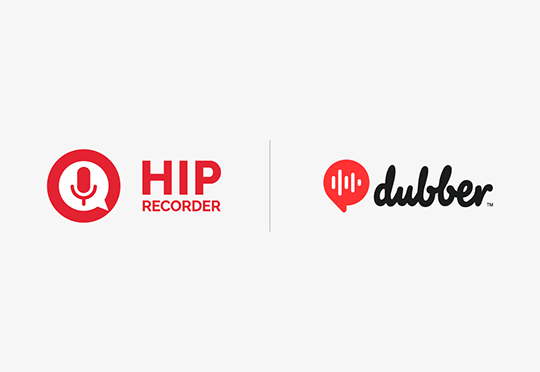
Launching at RoutIT Vision this month, HIP Recorder is the latest offering from Netherlands wholesale infrastructure and cloud services provider RoutIT – and it’s powered by Dubber. At an event that was buzzing with interest in the new developments in call recording for individuals and speech intelligence, HIP Recorder is an exciting new product.
This partnership with RoutIT will make Dubber’s cloud call recording as a service available to all RoutIT customers – the HIP Recorder is an affordable option that allows users to retrieve recordings of their calls for up to three days after the call has been made.
RoutIT was founded in 2000 and strives to develop and deliver the most innovative internet, cloud, connectivity and communication solutions. RoutIT works closely with its customers with a personalised approach to providing communication solutions. This new product matches the tailored ideology of RoutIT by providing a unique offering that allows individual users to gain access to the benefits of call recording.
HIP Recorder users can also benefit from the speech intelligence of Zoe – giving them the potential to transform everyday phone calls into valuable data assets. Zoe goes above and beyond traditional call recording to unlock the information held within voice calls – allowing users to search their call archive and automate processes triggered by keywords spoken on calls.
Dubber will be at RoutIT Vision on September 26th and 27th 2017 demonstrating the benefits of call recording for individuals and the endless potential of Zoe. Come and say hello if you are attending!
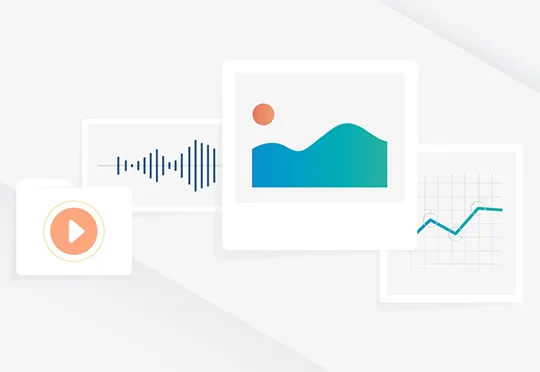
Unstructured data enables organisations to gain insight into their working practices. The term unstructured data describes information that does not have a set format, unlike its structured counterpart that is made of set data fields such as inventories and orders. Examples of unstructured data include images, and video and audio recordings.
Big Data and its analysis has proven just how vital information is to businesses. Insight into both consumers and the working practices of the organisations themselves can be a valuable asset. With global data estimated to reach over 160 zettabytes (that’s 160 000 000 000 000 000 000 000 bytes) by 2025, learning how to harness this information can set businesses apart from their competitors. These huge amounts of data allow analysts to understand a company’s true potential and more accurately predict growth and risks.
Unstructured data is often linked to structured data to make it easier to process. For example, a headshot of a staff member would be associated with structured data relating to the length of their employment and salary. This allows data to be visualised in a way that can be utilised to gain insights that were previously unimaginable. Data analysis can predict sales results, allow for more accurately targeted marketing campaigns and open up business and product development opportunities.
80% of data is unstructured, and is growing at a far higher rate than that of structured data (see graph below). Unstructured data often requires special tools to sort, search, visualise, and analyse. Unstructured data frequently holds much more information than structured data, and the information is often much more valuable. Due to the difficulties that can arise when accessing unstructured data, an organisation’s systems may need a way to read the data before it can be processed, and extra storage may be required for this more complex data. Companies with on-premise storage may be restricted by the amount of data they can store, and will be forced to make difficult decisions about the information they choose to keep.
Source: IDC
The power of the cloud
Data analysis can be overwhelming and it can be difficult for organisations to understand how to make the most of their data – especially large amounts of unstructured data. With a data management strategy, businesses can ensure they keep up with their competitors and capitalise on the wealth of information held in their data stores.
The analysis of unstructured data can be extremely time-consuming, with specialist data scientists often employed to cleanse and prepare the data before analysis. Employing expensive data scientists is an unlikely step for all but the largest enterprises to take but, with developments in artificial intelligence (AI), unstructured data can now be automatically analysed. These technological advancements allow even small businesses to profit from their valuable stores of data.
Investing in expensive hardware for data storage and processing isn’t practical for the majority of businesses, however, utilising the infrastructure of the cloud can allow organisations to store and process their data without restrictions or the need for CapEx. With dramatically reduced costs, and the scalability to accommodate large amounts of data, companies have the opportunity to experiment with analysis to grow their knowledge and skills.
Introducing Zoe
Automated analysis is now possible with AI becoming an everyday reality. Software can process huge amounts of unstructured data including images, audio and video, and not only report findings but learn as it analyses. AI is an important component in Big Data analysis, with its capabilities expanding to now include emotion recognition.
These new capabilities are exemplified by Zoe, Dubber’s suite of intelligence modules. Specialising in the analysis of voice data, Zoe’s ability to process this kind of unstructured data opens up another channel in the Big Data conversation: Big Voice. Accessing the data in consumer calls allows organisations to truly listen to their customers.
Zoe’s technology is under constant development. Its Smart Search feature is available now, allowing users to search their recorded calls using a variety of criteria from the date and location of the call to specific words that were used during a conversation. Due to be released at the end of 2017 are two more modules: Keywords and Sentiment. Keywords tags specific words and phrases and can be configured to trigger actions when these are spoken through Dubber’s open API. Sentiment identifies the emotions of the participants of a call to create a detailed understanding of their mood throughout a conversation.
Zoe’s analysis of voice opens up the wealth of insight that can be gained from this unstructured data, and allows businesses of all sizes to take advantage of the cloud and experiment with data analysis. Powered by the cloud, the processing potential is limitless.
This week Apple announced it will be bringing face-tracking support to its AR platform ARKit on iPhone X, its new phone launching in celebration of the tenth anniversary of the first iPhone. ARKit allows developers to easily integrate augmented reality (AR) elements into their iOS apps. However, AR has so much more potential than just games on your iPhone: the future of AR might look something like this…
The first thing I do each morning is put in my smart contact lens. At a glance, my day is set out before me with reminders for important appointments. I decide to do some exercise before work this morning, but rather than travelling all the way to the gym I select a pre-designed workout from my personal trainer. As I take my position on my mat, she is projected in front of me to demonstrate the exercises. She times each set and gives me encouragement as I struggle through the reps. After showering, I head to the kitchen for a much-needed breakfast. A reminder to take my medication hovers near the cupboard to make sure I take it with food.
Image: Raygun Studio
I say goodbye to my wife and wish her luck. She works as an architect and today she is showing her design to a client. The weather is nice so I decide to cycle to school, where I work as a teacher. My contact lenses give me details about my route, including traffic conditions and areas of heavy pollution.
Source: Tech in Asia
My class has a trip this morning to a local historic house to learn about life in the past. As we move from room to room, our contact lenses show us a reconstruction of the daily routines of the residents of centuries ago. My pupils are shocked to learn about the lives and long hours of hard working servants and the ways in which the rich passed their time before the internet.
After I have returned the children to school I make my way to the local high street to find somewhere to grab lunch. As I look at different sandwich shops and cafés, ratings and reviews are shown next to them. I choose a salad bar that has been rated highly for its varied vegan selection. On my walk back to school, a tourist asks for directions but can’t speak English. Translated subtitles appear in front of them as they speak and I’m able to reply in English and show them where they need to go.
I call my wife when I finish work to see how her presentation went. Her meeting took place at the proposed construction site so that her design, projected through smart contact lenses, could be seen against the surroundings. Her designs were very well received so I tell her I will cook her favourite meal this evening to celebrate.
Source: Virtually Here
I have to get a blood test after work and, as the appointment is in my calendar, my cycle route is shown to me through arrows that guide me along the road, giving me notice of upcoming turns. At the clinic, the phlebotomist uses an infrared scanner that projects an image of my blood vessels onto my skin to find the vein more easily.
Source: Europe Vein Center
My earlier phone call with my wife has been archived and speech analytics software identifies my cooking plans and creates a shopping list for the ingredients. On the way home my route is altered to take me via a supermarket, and my shopping list hovers over the food as I shop. When I get home I cook dinner, following a recipe projected onto the kitchen counter. The dish specifies exactly how the vegetables should be chopped and when I take out my chopping board, the cutting method is demonstrated so I get it right.
Source: CNBC
After we eat I do some outfit research in preparation for a friend’s wedding. I stand in front of the mirror and see the dresses I have been browsing to judge how they will hang on me. I do the same with makeup styles to see what will suit my face shape. My wife and I then turn our attention to the living room; we decide it needs brightening up with some art and maybe a coffee table. Using our smart contact lenses we can visualise different paintings on the walls to see if they fit with the rest of our decoration, and check that the coffee table we like is the right size for our space. We head to bed excited for the new additions.

Remote working is slowly challenging the norm of 9-5. Flexibility in working practice is replacing allocated desks and designated start and finish times, while performance is measured by results and is moving away from the culture of presenteeism. According to a report by Gallup, 43% of employed Americans said they have worked remotely at some point over the last year, with 20% working from home full-time. The report suggests that advances in technology mean that workers no longer need to be confined to set office hours and locations in order to do their job effectively. With this new approach to work now expected by millennials (see chart below), businesses need to be prepared to adapt to a flexible workforce.
Source: Forbes
The benefits of employing remote workers…
As employers begin to embrace different ways of working, they are finding they can reduce their property costs with fewer workers on the premises. Their employees also benefit from advantages that go beyond the simple convenience of flexibility in their work. Employees who work remotely are less stressed and much happier as they can decide how they prefer to work and have greater control of their work/life balance. They can choose the working environment that best suits them, whether that be a café with a plug socket or the comfort of their bed. Release from the daily commute increases employee wellbeing, gives them more time in their day, saves them money, and also reduces their carbon footprint. A survey by Microsoft found the top ten benefits reported by remote workers were as follows:
Source: Sage
…and the challenges
Allowing employees to work remotely presents a challenge to managers and executives, who want to maintain a balance between staff wellbeing and productivity. Compliance is also a key consideration, especially within industries such as finance. Recording communications is essential to comply with regulations so organisations need to employ a solution that can capture conversations made outside the office. Implementing a unified communications (UC) solution, which amalgamates all communications into one interface, alongside call recording will ensure all conversations are captured – even when users are mobile. Remote contact centre workers that take customer payment card details over the phone need to ensure they are compliant with PCI DSS. This set of regulations states that no payment card details can be stored, so a call recording solution must feature measures to prevent this.
With remote working comes the risk of employees feeling disconnected from their work and the rest of their team. Key to remedying this potential sense of distance is encouraging continuous and proactive communication and enabling effective sharing of information between team members. This shouldn’t be confined to work-related subjects. Without the opportunity to run into a colleague in the corridor, or to chat while making tea, remote workers can miss out on the day-to-day conversations that make a team feel connected. However, with advances in social media and other communication technology, workers can still have these catch-ups over instant messages and see each other’s faces in video conferences.
Increased engagement between colleagues is an encouraging finding from Gallup’s report (see chart below), which found that employees who worked remotely three or four days a week were actually the most likely to report that they have a best friend at work.
Source: Gallup
How Dubber can help
UC solutions are facilitating a new more flexible way of working, and increasing productivity and collaboration among the businesses that use them. Dubber is designed to be integrated with UC platforms and provides an array of solutions for call recording and communication capture, for use anywhere and on any device. By capturing communications straight from the network, when a UC solution is implemented with mobility, all user communications can be recorded even while they are mobile.
Dubber’s deployment through Amazon Web Services not only ensures a flexible solution that can be scaled alongside UC solutions to suit businesses of all sizes, but that the calls are also encrypted for added security. Dubber has also partnered with Mondago to provide an automated pause and resume function that can be integrated with their call recording solution to ensure payment card information is not included in recorded calls.
The implementation of UC can bring a culture of productivity and collaboration. UC solutions facilitate modern ways of working and a more flexible way of life. Dubber’s partnerships with UC providers such as BroadSoft allow organisations to quickly and easily deploy call recording alongside a UC solution and ensure all of their employees stay compliant, anytime, anywhere.

Dubber Selected for BroadSoft Business Unified Communications

The rise of Big Data has shown just how valuable information is to businesses today. Insight into consumers and their behaviour is showing companies how to improve their business practices in order to retain their existing customers and attract new ones. Voice data has previously been excluded from the Big Data conversation but technology is now able to interpret speech, enabling companies to mine their calls for valuable information. With customers continuing to pick up the phone for assistance, access to this data is an important breakthrough creating a new field of analytics: speech intelligence.
Speech intelligence was initially only affordable for larger enterprises that could invest the CapEx required to install proprietary solutions but the introduction of software as a service (SaaS) solutions, deployed through service providers, has democratised speech intelligence.
The advantages of speech intelligence
Speech intelligence software most commonly transcribes audio into text to enable searches, and can even go beyond the words themselves to identify the mood of the caller through tone of voice and speech patterns. The searches and automated processes that can be implemented through speech intelligence open up limitless potential for business development, particularly in customer service. By combining processing techniques used in Big Data with speech analytics, companies can uncover important insights into their customers.
Introducing Zoe
Zoe is a collection of speech intelligence modules that includes Smart Search, which will be followed by Keywords and Sentiment at the end of 2017. Zoe can analyse and evaluate recorded conversations to establish the emotion of the caller, and search calls for specific words, phrases, or characteristics. This functionality can be used to identify recurring issues and opportunities for business development, and can track trends in customer behaviour.
Zoe has democratised speech intelligence and made it accessible to small businesses, and even single users, with an affordable monthly subscription. Zoe is deployed through Dubber’s API, allowing it to be easily integrated with a variety of other applications. Through the API, users can create their own custom applications of the functionality to realise limitless use cases.
Smart Search
Smart Search allows users to search their recorded calls using a variety of metrics from date and location to specific words, phrases, or sentiment. Any calls can be searched, regardless of whether they were originally recorded with Dubber, so Smart Search can be implemented as a stand-alone service.
Keywords – due for release late 2017
Keywords enables users to track specific words and phrases across their captured communications and jump to the point in a call when the word or phrase was spoken. These words can be tagged to be automatically highlighted in future recordings and automate actions in other applications through Dubber’s open API – opening up limitless potential use cases.
Sentiment – due for release late 2017
Sentiment identifies the emotions of speakers through a recorded conversation by measuring speech characteristics such as tone of voice, speed of speech, pauses, interruptions, and certain phrases that express emotion. These indicators create a detailed understanding of a caller’s mood throughout the conversation and enable Sentiment to provide users with a report that assigns the call with a positive or negative score.
Integration
At the core of Dubber is an open API, which allows Zoe’s features to be managed through the Dubber portal, a custom portal, or directly through the API. Zoe’s deployment through Dubber’s open API allows it to integrate easily with other applications, such as CRM systems, enabling data to be automatically transferred to third party applications such as Salesforce or Microsoft Dynamics.
Zoe has democratised speech intelligence with its open API and availability as a subscription-based service. Where once only large enterprises would be able to invest in speech intelligence, businesses of any size can now benefit from the insight that Zoe can provide. Zoe’s deployment as native cloud SaaS makes it a flexible solution that can adapt to businesses of any size, without the need for any additional hardware or software installation. With calls stored in the cloud, they can be quickly and easily processed.
Previously excluded from the Big Data conversation, Zoe’s analysis of voice data opens up a world of insight that can be gained from the study of recorded calls. Now companies can truly listen to their customers.

Dubber Connect On-Net Recording for End Users

Dubber Signs Agreement with AT&T

VoIP calling has been steadily replacing traditional telephony due to its reliability and efficiency, achieved through its use of data connection instead of fixed lines. The chart below shows the reasons for moving to VoIP from landlines given by SMBs. The data connection that enables VoIP calls is quicker and cheaper as it takes advantage of the existing IP infrastructure of interconnected routers. Recording VoIP calls presents a challenge due to the difference in the way audio is transmitted in VoIP calls compared to traditional telephony. VoIP call recording requires data to be ‘sniffed’, which is a process of real-time monitoring of data flow through a computer network by a software program or a hardware device containing this sniffing software or firmware. Sniffers copy the data without altering it and can only intercept data from networks that their host computer is connected to.
Survey by Software Advice
Depending on your requirements for call recording, and how you intend to use the captured conversations, and your business telephony network (or lack thereof), the VoIP call recording solution that is right for you may vary.
What will you use your recorded calls for?
When deciding on the call recording solution that is best for you, it is important to consider how you will be using your recorded calls. If you are a journalist who records their phone interviews, you will need calls to be stored in a format that can be easily replayed, but you might not need to keep the calls for years after you have filed your copy. You might have a podcast and need to be able to access your calls as files that can be edited to form part of a finished episode. A solution such as Dubber’s Playback, designed for individuals, is an easy-to-use communication capture service that allows you to decide which of your calls are saved and allows you to download and share them as easy-to-edit audio files.
Financial institutions require their communication with customers to be recorded in order to stay compliant with the latest regulations. Call records are generally required to be stored for up to five years, so businesses will need to ensure the solution they choose has the flexibility and security needed to safely archive their conversations. A cloud-based solution, such as Dubber, has the scalability required to hold unlimited calls and is not restricted by the storage hardware limitations of legacy solutions. True cloud storage also has the added security of encryption and the redundancy that accompanies multiple storage locations, for added reassurance.
Businesses that require call recording for compliance will most often need call recording that is compatible with a unified communications (UC) solution. Modern working life spans multiple methods of communication and our mobile phones allow us to make traditional calls as well as VoIP calls, send text messages, and have conversations over instant messenger. To ensure that all of these communications are captured accurately, call recording must be able to integrate with UC solutions.
Larger businesses that have contact centres often use call recording in order to improve their customer service and business practices through analysing their captured conversations. A solution that offers speech intelligence, such as Dubber’s Zoe, will allows a business to search their calls and automate processes to make their business more efficient and gain a detailed insight into their customers. Recording with Dubber can also record conversations between extensions, ensuring recording continues if a call is transferred internally.
When considering VoIP recording options, it is important to plan for the future as well as the present. Choosing a flexible call recording solution that can adapt as your business grows and changes is vital. Expansion into different locations, sudden changes in call volume, and regulation reforms could affect your call recording needs so the solution you choose must offer you the reassurance that these eventualities can be accommodated.

Redcentric Records with Dubber
As the big telecom providers phase out traditional public switched telephone network (PSTN) functionality, businesses are looking for a modern solution to their telephony needs. A SIP trunk allows business telephone systems to operate using an internet connection rather than a traditional phone line. Session initiation protocol (SIP) is essentially a language that allows phones and other telephony devices to talk to each other. It is a standard communications protocol for initiating interactive multimedia sessions across a data network. This protocol is used for creating, modifying, and terminating sessions. A trunk is a line or connection that is able to transmit multiple signals simultaneously. A SIP trunk is able to combine data, voice, and video in one connection.
With Verizon planning to shut down its integrated services digital network (ISDN) in the USA and Germany also phasing out ISDN by 2018, and BT announcing that from 2020 ISDN and PSTN circuits will no longer be available to purchase, moving to an internet telephony service will soon be essential. Instead of traditional PSTN, calls operate through voice over internet protocol (VoIP) through one point of entry – the internet connection. SIP trunking occurs between a private domain, connected to your network, and the public domain, which is the responsibility of your internet telephony service provider (ITSP). This interconnection allows for VoIP and media streaming to take place.
A manual telephone switchboard.
Often there is no physical hardware required for a SIP trunk connection although, depending on how the trunk is presented, a private branch exchange (PBX) or session border controller (SBC) may be required. Installation uses a business’s existing internet connection, removing the need for traditional phone lines and the costs associated with maintaining them. As the telephony service is not bound to a physical phone line, you can easily move offices and keep your phone number.
Multiple phone lines can be replaced by one SIP trunk, which allows for scalability that can adapt to the growth of a company. VoIP is also more reliable than traditional phone lines as the quick and easy forwarding of calls to mobile phones provides insurance in case of system failures.
When looking at SIP trunking for your business, additional benefits such as number provision and call recording should be considered as well as cost. With SIP trunking, features such as multiple phone numbers and call forwarding that aren’t available through a traditional telephone line can be added easily.
SIPREC
Traditionally, call recording through PSTN captured voice conversations as audio files on the trunk side of a network infrastructure – the telco-facing portion on the outside of the internal phone system. Session initiation protocol recording (SIPREC) is a way of allowing calls to be recorded securely, without interception. SIPREC defines the architecture of call recording, including the call flows and metadata associated with it.
The internet engineering task force IETF has created a framework for SIPREC that identifies the two parties involved in call recording: the session recording client (SRC) and the session recording server (SRS). SIPREC occurs through the session border controller, which is a device that sits between businesses and their network provider. A SIP invite contains specific metadata for processing call recording that contains information about the call and participants.
Where traditional call recording would use hardware to tap into a dedicated line in order to capture the communications, no such equipment is required for SIPREC as the devices that handle the SIP trunk can also enable recording through SIPREC. Using SIP trunks enables SIPREC to be implemented quickly and easily, allowing a call recording solution such as Dubber to capture communications.

With online interaction dominating the modern world, a phone call feels special. Phone calls are reserved for the important stuff – for the decision that needs to be made, for the question that we want answering urgently – we pick up the phone when we just need to get things done.
Listening in
We can see this idea reflected in how customers contact companies when they need assistance: research by eConsultancy found that a phone call was the most commonly chosen method of communication at 61%. When looking for online assistance, 71% of customers wanted help within 5 minutes or less (see chart below). The majority of customers looking to buy also choose to call a company rather than contacting them online. Both Google and xAd, two of the leading digital advertising networks, found that a click-to-call option on ads was highly successful – with 51-62% of users choosing this option.
Source: eConsultancy
On top of the immediacy offered by a phone call, there is science behind why verbal communication is so effective: hearing is the fastest sense, with sound taking only 10 milliseconds to reach the brain compared to 13-80 milliseconds for sight, according to researchers at MIT,
With customers 11 times more likely to complain over the phone than via the internet, according to research from Arizona State University, these phone calls are a valuable opportunity to turn a negative experience into an improved relationship. Customer interactions that take place over the phone create a much better opportunity for a meaningful connection. Your customer is right there, willing to speak to you, and you can answer any questions they might have immediately. Up-selling and cross-selling also comes much more naturally over the phone. Only a face-to-face conversation could possibly be better.
Reading between the lines
Written communication can be open to interpretation. It’s the very reason for the enduring magic of books, but it can result in misunderstandings in the corporate world of hurried emails. Without the indicators of tone and meaning, simple sentences can be misconstrued to drastic effect. When clarification is needed over the phone, you can get an answer immediately. Complex technical queries are always best discussed with a call as the instant feedback can alleviate confusion quickly, whereas a series of emails might only further complicate things.
With a phone call, you can hear the emotion of the speaker’s voice – their intonation and volume of speech can often say more than their words. Customer service agents can tell if a customer isn’t fully happy with the resolution of their complaint, while sales agents can get a better sense of how to entice a new client.
Measuring the success of phone calls
The importance of phone calls is clear, and because of this customer service agents who excel at building relationships with customers are more valuable than ever. However, contact centre workers can feel like they lack objectives and that their work can’t be measured. In order to provide customer service agents with reports on their success, a call intelligence solution such as Dubber’s Zoe can be utilised to conduct sentiment analysis of calls and measure the customer’s experience throughout the conversation. Not only does this give workers valuable feedback on their work and progress, their supervisors receive an insight into their interactions with customers and can use this information to improve their work practices and train new members of staff effectively.
The benefits of email and instant messaging are the paper trail that they leave behind. With a call recording solution, such as Dubber, that provides transcripts of your conversations, you can have all the benefits of phone calls with the reassurance that you can track and record your communications.

Dubber and Macquarie Telecom Sign Call Recording MSA

Dubber Annual Report 30 June 2017

Virtual reality (VR) allows you to be transported to real or imagined locations instantly and can connect you to people all over the world. VR users hit 50 million in 2016 and the number of active users of VR is forecast to reach 171 million by 2018. The graph below shows how revenue has grown and is predicted to grow over the next few years. 360-degree video is already available on platforms such as YouTube and Facebook and continued investment from these companies and others including Google and Microsoft mean that VR technology is becoming more affordable every day.

Source: Superdata
The technology is set to transform a number of industries and affect on the way we work and interact with the world and each other. Developments in VR mean that live events such as concerts or sports games can be experienced from your sofa. A global audience can be reached from one venue with the help of a few cameras and some technology. Users can access live streams through VR headsets but also through their browser or mobile app.
A seamless experience
To create a 360-degree video, visual data from multiple cameras must be pieced together to create one video. Post-production of VR content begins with stitching and blending to create one seamless sphere of visual content. VR has continued to improve since its conception and now features immersive effects such as audio that matches the user’s visual experience so accurately that when a user looks away from something, the audio diminishes. Recording using binaural sound is key to this feeling of ‘presence’. For a successful VR experience, and a feeling of true presence, the stitching technology used to create the 360-degree environment must be of a high enough quality to produce a seamless experience.
The future of VR
Tech leaders are predicting that VR will compete with television in the future and are investing in livestreaming services that aim to distribute 360-degree VR content to users around the globe. Just as the internet has changed the way we consume media such as news articles, VR is expected to do the same to television. This entertainment value could be seen as a key area of investment for telcos looking to create a new revenue source after the decline in growth from voice, texts and, most recently, data.
Industry specialists such as CNET founder Halsey Minor believe that VR will be the next stage of growth for the content industry, while Goldman Sachs have stated that VR and AR have the potential to become the next big computing platform. Goldman Sachs have outlined their predictions for VR and AR use in 2025, which can be seen in the graph below. The World Economic Forum sees AR and VR as technologies that can transform daily life with their time and cost saving benefits. This growing industry should be capitalised on by any telco wishing to stay relevant in the future.
Goldman Sachs predictions for VR and AR use in 2025
An example of a telco that is investing in VR is SK Telecom, which is commercialising its 360-degree VR live broadcasting capabilities and planning to open its application programming interface (API) so that individuals and small content developers can create their own 360-degree live VR experiences.
At this stage, the development of VR is very experimental as challenges are identified and overcome. Poor internet speeds can impact the VR experience through heavily compressed images and the strain that VR will put on networks is an area of concern. Network capacity needs to be an area of investment, particularly at the user end of the journey, as VR requires around five times more bandwidth than HDTV as well as the low latency that is essential for a fully immersive experience. If users do not have the correct requirements, content will need to buffer and be stored locally – creating delays and limiting the interaction capabilities of the VR experience.
The next steps for VR will take the experience mobile. Immersive live VR broadcasting will work in tandem and become more widespread with the development of 5G due to the large bandwidth and low latency that are required for streaming. Network providers will play a key role in the realisation of VR, ensuring high quality connections to allow for a seamless immersive experience.

Hosted telephony has gained popularity and coverage recently, with its cloud base appealing to forward thinking enterprises and press alike. The chart below shows the growth of both managed and hosted systems, with on-premise PBX experiencing negative growth. However, research undertaken by communications analyst MZA has shown that most small businesses still use PBX rather than making the move to hosted telephony. There are four main factors to consider when choosing between the two solutions, which are outlined below.
Source: Synergy Research Group
Cost
Hosted telephony largely appeals to both small and large businesses due to the lack of CapEx required to implement the system. There is no hardware necessary, which reduces the storage space required as well as power costs associated with running servers. With on-premise PBX options there are also installation costs on top of hardware expenditure. Larger organisations will have greater CapEx, as costs only increase with the size of the hardware required.
However, monthly subscriptions for hosted telephony can work out more expensive over time, depending on the services and the size of the enterprise. Considerations need to be made regarding the features required by the business, as there may be extra costs that are not included in basic hosting packages. The chart below shows the top 7 reasons that SMBs look to change their system, with the results separated by their current solution, giving an idea of the considerations that should be made when deciding on a system.
Software Advice’s survey of SMBs and their phone systems
Time
As well as installation costs, the time required to implement an on-premise PBX solution is an inconvenience. Cloud solutions offer the advantage of rapid deployment, meaning installation costs are virtually eliminated by the DIY approach to implementation. When choosing a telephony option, installing a new infrastructure is a significant commitment. PBX solutions will need to be updated over time, and replacing hardware or enhancing features can take weeks to integrate. These changes can often lead to communications downtime that will need to be scheduled to reduce inconvenience as much as possible.
Hosted solutions can be implemented alongside existing communication systems. The most hardware that will be required is the phones themselves. Software updates are maintained by your cloud provider, meaning you stay constantly up to date.
Flexibility and scalability
The case for hosted telephony is certainly bolstered by the flexibility and scalability that it offers. Just as hosted telephony can grow alongside a business, it can also be scaled back. This can reduce monthly costs immediately, in contrast to large CapEx that will have already been paid in the case of PBX.
Security
With hosted telephony you have the added reassurance of reliable redundancy. Depending on the provider, you may not have immediate access to all of your data but you will have the guarantee that it will be stored securely with recovery solutions. The advantage of on-premise PBX systems is the immediate access they offer, but recovery measures are often so expensive that only larger enterprises are able to justify the cost of this level of security.
To decide which option is right for your business you need to consider not only pricing, but what your company needs from a telephony system. Looking to the future and anticipating how these needs might change as your company grows is just as important as the immediate considerations of cost and convenience.

We recently published the results of our survey of SMBs in the US, which showed what small businesses are missing from their current communications solutions. After uncovering some interesting results we conducted a comparison survey; this time of UK businesses.
Accounting for a large percentage of employees in the UK – 48% according to the report SMEs and Flexible Working Arrangements – SMBs differentiate themselves from larger enterprises through their agility and ability to respond to changes within their market quickly and easily. A cohesive communications strategy, one that encourages collaboration and productivity within the company as well as streamlining external conversations, gives smaller businesses the opportunity to triumph over larger companies that may struggle to adapt.
By consolidating their communications, across telephony, email, and instant messaging, small businesses are able to synchronise conversations that happen remotely and also out of office hours. With a similarly small number of SMBs in the UK currently using a unified communications (UC) solution – 9.2% in the UK compared to 10.7% in the US – the potential for telcos is clear.
Mobility is key across UK and US
Much like the findings of our US survey, personal mobile was also the most commonly chosen answer to the question ‘what phone system do you use for work?’ by participants of the UK survey, with 38.3% choosing this option compared to 39.7% of US respondents (see chart below). To keep workplace communications cohesive, a UC solution with mobility is essential for small businesses where workers use their personal mobiles so much. Small businesses may have limited office space, so having the confidence that their employees can have all the functionality of work available on their own devices is of great benefit. Getting employees to use their own devices may also be more cost effective for smaller businesses.
We looked at the different services that SMBs used as well as their phone system. In the UK instant messaging was the most popular choice, with 71.7% of respondents communicating in this way, closely followed by voicemail at 67.5%. This is unsurprising given the growth of Slack, which has grown to 5 million daily active users from 4 million since only October 2016. Instant messaging was slightly less common in the US with 57.9% using this service, while 79.3% of respondents said that they used voicemail. The benefits of consolidating all of these communications include an increase in productivity as conversations can be found in one place.
Interestingly, when asked if they would like to have all business communications, including mobile and deskphone as well as conference calling and internal messaging, provided in one UC platform 64.2% of UK respondents said yes, compared to 72.5% of US participants (see chart below). This is still a significant majority and one that should be pursued by telcos.
A flexible approach to work
Increasingly, employees have come to expect the flexibility to be able to work from a range of locations, at a time that is convenient to them. According to a Citrix-commissioned report by The Work Foundation at Lancaster University, over 50% of businesses in the UK are likely to have a flexible working policy in place by the end of 2017. This flexibility boosts the happiness of employees and can result in more efficient working with less time spent travelling if employees can work from home and remain connected with the rest of the team. In fact, research by Vodafone found that 83% of respondents to their extensive workplace survey said that adopting flexible working has resulted in improvements in productivity.
A unified communications as a service (UCaaS) model utilises cloud infrastructure in order to provide the kinds of features that were once only available to larger enterprises, and through a lower cost service that is quick and simple to deploy. Cloud-based solutions also offer a higher security level that can defend against cyber attacks. Any solution will need to serve a variety of devices to fully integrate all employees but will be better placed to adapt to updated technology in the future with intuitive software and the automatic rollout of new features.
Additional services
In a similar result to our US survey, the additional service that SMBs in the UK wanted most from their service provider was call recording. An even higher percentage than the US, 42.5% compared to 37.2% of US respondents, chose call recording as the service they would like to add to their phone system (see chart below). Call recording is becoming increasingly important to small businesses as regulation and compliance develop as issues for more industries.
Not only do UC solutions offer synchronised conversations, their enhanced reporting capabilities can be instrumental for business understanding and growth. Call recording can help with training new team members and the data captured can form the basis of reports that inspire improvements in business practices.
Another opportunity for business development is the integration of a UC solution with existing CRM systems. This can add value as customer details become a part of the communication process, creating an informed approach that can improve relationships and make conversations more efficient.
Not only would a UC solution create a simplified and cohesive approach to workplace communications and increase interconnectivity between employees of small businesses, the potential for increases in productivity and efficiency is great. When integrated with existing CRM systems and used to inform business practices, a UC solution can provide previously unrealised opportunities for growth and development.

With an evolving business culture that increasingly requires flexibility from workers, solutions have developed that enable businesses to stay on target even when employees are working remotely, from their own devices, and out of office hours. Unified communications (UC) solutions do just that: synchronising conversations across devices and allowing workers the flexibility they need to keep up. SMBs are now looking for UC solutions which were only available to large corporations a few years ago. We’ve surveyed 120 SMBs in the US and found some interesting results.
Investing in communication
Communication is an important part of any business, but with tighter travel budgets affecting SMBs more keenly (a recent study by Forbes found that 59% of SMBs surveyed were travelling for business less frequently than they had been at the beginning of 2008, with 37% saying that they were travelling much less frequently) developing adequate alternatives to face-to-face contact is crucial. Improving communications allow relationships to be maintained from a distance, removing the need to be constantly on the road but in a slow and precarious economy, contact with clients is vital to nurture relationships and retain business
The demand for a unified communications solution is increasing due to the productivity and cost reduction benefits associated. Our survey of 120 SMBs across the US showed that while only 11% said they had a UC solution in place, 73% of respondents said that they wanted a service that consolidated all of their communications into one platform, showing a huge opportunity for UC growth. Simplifying the ways employees talk to each other and external contacts brings with it increased efficiency and a feeling of interconnectivity that is vital in a small business.
With 84% of respondents stating that they use the telephone as a business tool either some or all of the day, it is clear that this is an important channel for their company communications. However, significant percentages of respondents also noted their use of instant messaging and conference calls: showing that while traditional voice calls remain important to businesses, communication is branching out to other channels. Especially when sharing data or imparting information that is better presented visually, technology-enabled meetings such as web-conferences are a growing channel for businesses to engage with their customers through. More than half of SMBs surveyed by Forbes said they had increased their use of web-conferencing, videoconferencing, and teleconferencing since 2008 – citing time and money saving benefits as the main reasons for their choice of communication channel and also flexibility of location and timing (see graph below).
Source: Forbes
Mobile workers
SMBs are likely to employ mobile workers who need more flexibility than a traditional desk phone can offer. They frequently work across multiple devices and out of the office and require a communications solution to match if they want their conversations to remain cohesive and organised. When asked what phone system they used for work, personal mobile was the most common choice for respondents of our survey – showing that SMBs require a UC solution with mobility to ensure their communications are synchronised.
Employees experience this level of constant connectivity in their personal lives and they have come to expect this from their work communications as well. The risk of continuing without a UC solution in place is that employees, frustrated by workplace communication channels that lack flexibility and performance, use their personal accounts for external communications. This can cause difficulties concerning security and compliance. We have written before about the rise of BYOD and the challenges it brings but in certain industries this approach just isn’t feasible. In its place, a UC platform that is both available and secure is essential. This type of solution, which included features such as call recording and mobility, was once only available to large enterprises but is now available for businesses of all sizes. Telcos now have a unique opportunity to collaborate with platforms such as Dubber to offer these services to their SMB customers who are ready to take advantage of this additional functionality.
The most popular choice of service that wasn’t currently available to the SMBs surveyed was call recording, with 37% selecting it as a feature they want from their service provider, showing a key area of growth that telcos can capitalise on. Call recording is becoming ever more important as regulation and compliance become key for increasing numbers of industries.
The obvious solution for the communication needs of SMBs is a UCaaS model, which can provide features previously only available to larger enterprises, but with much lower costs. Using cloud infrastructure is beneficial to many aspects of businesses, from CRM solutions to data storage, due to its scalability and security, and its future is in communications. Native cloud solutions offer much better security than systems hosted locally and can grow or shrink alongside a business. By consolidating all communication; from telephony to email, via instant messaging, into one integrated service, SMBs can connect their employees with a cohesive working practice.
If you’re one of the SMBs that would like call recording on top of your UC platform, then get in touch

While the days of holding the line while you wait for an available support agent might seem far from over, call centres have evolved since their conception with the emergence of new technology. Now more commonly referred to as contact centres, as communications between consumers and customer service advisors are no longer confined to calls, here we examine how they have adapted to the modern age.
Please hold the line
Traditional call centres used an automatic call distributor (ACD) to distribute incoming calls to agents using a first in, first out (FIFO) system. Modern contact centre solutions now have virtual queuing systems that allow customers to receive callbacks instead of remaining on the line while they wait for an operator to become available. Either a virtual placeholder takes the customer’s position in the queue, or a scheduling system allows customers to choose a time and date in the future at which to be called back.
New technology allows for continuous improvement of customer service. Interactive voice response (IVR) is a technology that utilises speech recognition and keypad tones in order to direct a call to the most suitable advisor using information supplied by the customer. Where traditional ACDs could only play a greeting and queue calls using the FIFO system, IVRs can profile a customer and reduce call transfer and queue times. Callers speaking different languages can be routed to an appropriate agent based on their language preference. With more sophisticated IVR, different approaches can be tested and refined to adapt to the customer’s response. Conversational IVR can even greet customers by name for a personal touch.
Adapting to the modern consumer
Historically, customer support has been delivered through call centres but today modern contact centres use computer telephony integration (CTI) to communicate through a variety of channels including online chat, forum style support ticket platforms and social media. The chart above shows how customer service interactions have changed since 2006. This immediacy and flexible approach is something that has come to be expected by the modern consumer. Where once customer advisors were only required to have excellent verbal communication skills, now their writing and adaptability is being put to the test. The chart below shows preferences in channel by age group.
Source: Fonolo
For instance, Akixi, a leading provider of cloud based call management and analytics allows businesses to improve their sales performance and deliver excellent customer service. They have recently partnered with Dubber, creating the potential for limitless applications of call recording and intelligent call analytics in one fully comprehensive unified communications (UC) package. Like Dubber, their solutions offer unlimited scalability, no hardware limitations, and rapid deployment.
Speech analytics software, such as Dubber’s Zoe, allow companies to identify repeated problems by looking at commonly used phrases and analysing the sentiment of phone calls. Complaints can automatically be picked up and forwarded to development teams to improve future products and services, while customer advisors who consistently turn complaints into positive outcomes can be identified through sentiment analysis.
With communications solutions now being integrated with CRM systems, the data generated from contact centres can help to build an informed profile of each customer. Mondago, who provide computer telephony software, specialise in providing UC solutions that are designed to be integrated with CRM systems. As repeating information is frustrating for the customer, services such as Mondago’s Go Integrator feature screen population, which allows an advisor to see all their available information, create a much more efficient way of working.
An integration between Mondago and Dubber, enables their Go Integrator product to automatically pause and resume call recording with Dubber’s cloud based service. This is essential for remaining compliant with PCI regulations surrounding the protection of payment card information. Again improving productivity in contact centres and enhancing data security of consumers.
Not so distant future
The introduction of session initiation protocol (SIP), which allows for multimedia communications, means that calls do not have to be confined to only voice. In the future, IVR can be extended to IVVR (interactive voice and video response), giving the option of video calls with customer service advisors. This will allow systems to read customer emotions by analysing facial expressions, and can also use facial recognition to identify and greet callers.
In place of security questions and difficult to remember passwords, video calls can use biometric identifiers such as iris scans to prevent fraud. Where customer emotions were once identified by an advisor’s sympathetic ear, sentiment can now be detected by software that can enhance customer understanding. The value of being sensitive to the needs of the customer still remains, but the emergence of new technology allows the modern day contact advisor to do their job more efficiently. By integrating IVR with CRM systems as well as workforce management systems, customer service has the potential to be completely transformed into a proactive element of business development.

Bring your own device (BYOD) is a workplace culture that has been adopted by most industries; from healthcare to finance. Allowing, and encouraging, employees to work from their own devices not only reduces expenditure on technology, it also increases productivity by allowing employees to work from home and while travelling, on a device they are familiar with. However, when it comes to monitoring the distribution of company data, there are some challenges that accompany the benefits.
Keeping tabs
Ensuring company data remains secure, while respecting the privacy of an employee’s personal information, is the most difficult problem that IT security departments face. When personal devices are used for work, the data remains controlled by the organisation and it is important that this responsibility is carried out without breaching any data protection obligations concerning personal data stored on devices. This can be a difficult balance to achieve, especially when working in industries such as finance and healthcare that require specific data compliance.
In finance for example, MIFID II regulations state that investment firms in the EU must take reasonable steps to record communications made from equipment that has been accepted or permitted by the investment firm – this includes personal devices. These regulations also insist that firms should prevent employees from communications on privately-owned equipment which the firm is unable to record.
Monitoring communications across social channels such as Twitter and real-time communication applications such as Skype can lead to difficulties when complying with communication recording regulations. Employees are so used to communicating across a range of methods in their daily lives that to restrict them is not an option. Add to this the US lead Dodd-Frank requirement to be able to complete a case reconstruction within 72 hours of an investigation request, and the need for a solution intensifies.
Some solutions
Developing a culture that is as dedicated to security and compliance as it is to flexibility and efficiency is the answer to the new challenges of BYOD. This evolution in work should be seen as an opportunity to examine employee communication practices and put in place measures to ensure a cohesive approach.
Chart by CIO Insight showing communication inefficiencies in American hospitals
BYOD certainly encourages companies to consider a unified communications (UC) solution. UC can easily integrate existing devices into one cohesive and efficient communications strategy that can save companies time and money. As well as ensuring that the business is compliant with regulations regarding the recording of communications, there are numerous efficiency improvements that an organisation can benefit from. Research by CIO Insight found that American hospitals were wasting billions of dollars a year due to inefficient communications technologies (see chart above). Interaction between colleagues and clients is quicker, and collaboration becomes easier, allowing employees to focus on work. Employing a call recording solution like Dubber that integrates with your company’s CRM, for example, can allow transcribed calls to be viewed alongside other client information.
Software solutions that have keyword search capability, such as Dubber’s Zoe, which allow information to be gathered quickly and easily are a vital precaution against the 72 hour deadlines involved in investigations. The ability to record, transcribe, and search conversations at the touch of a button can also increase accuracy in day-to-day work and ensure that important details are not forgotten.
Flexible call recording solves the problem of collecting work data while protecting personal communications. With an services like Dubber’s Playback, the user has the option to keep a record of a call, after they have made it. Personal numbers can be blacklisted to ensure they are never recorded, while business numbers can be whitelisted so these conversations are always stored.
Graph from Global Market Insights showing growth expectations of BYOD market in USD by device
Not if, but when
With BYOD now an unavoidable reality, not having a policy on BYOD is the biggest risk to an organisation. A report by Global Market Insights anticipates growth in the North American BYOD market size over the next five years (see graph). Employees expect more flexibility in their work, and BYOD is part of these expectations.
With communications taking place across multiple applications, even on company-owned devices, it makes sense to embrace BYOD – with a considered policy that ensures security and compliance. In fast-moving sectors such as the financial industry employees are not going to ignore important calls just because they are unable to record them, so measures need to be put in place to ensure they can. Providing a UC solution that allows employees to work in the most efficient way is the key.

With the countdown to the MiFID II regulations on the financial sector within the EU continuing apace – we take a look at the APAC call recording regulations that have been put in place since the Global Financial Crisis of 2007.
Eleven members of the G20 summit, including Australia, China, Hong Kong, and Singapore, have committed to a host of regulations for their banks. The aim of these regulations is to improve transparency in the financial industries and reduce risk culture. These measures should restore the trust in investors and consumers that may have been lost in recent years.
With MiFID II mandating the recording of all mobile calls and text messages relating to financial advice and wealth management, it is unsurprising that Asia-Pacific should follow suit with its own extensive regulations.
Burden of proof
Although there is not a cohesive set of compliance guidelines for the region, the unifying theme of the regulations is financial services providers acting in the best interests of their consumers.
The Future of Financial Advice (FoFA) Act introduced by the Australian government, designed to nurture trust in customers and encourage transparency in financial service providers, states that financial advisors must act in the best interests of their clients. Best practice guidelines released by the Australian Securities & Investments Commission describe how records should be kept to show how this is being upheld. In order to comply with these guidelines, all communications with clients will need to be captured and stored securely.
The Hong Kong Monetary Authority also requires that institutions selling investment products maintain adequate records to demonstrate that they have advised their clients appropriately – this includes audio recording. Where repeated transactions are requested over the phone, these calls must be recorded to prove that customers are aware of any continued risks before continuing with their investments. Any waivers of risk disclosure should also be recorded as evidence.

Chart from Nielsen Q4 2016 Consumer Confidence Report
Similarly, the Chinese Protection of Consumer Rights and Interests Amendment places the burden of proof on service providers in the event of a dispute. Chinese and Hong Kong banks, are also required to keep records of client communications, including audio recordings, in all derivatives transactions. These must be kept readily accessible for a minimum of five years after the transaction has matured or been terminated. The Nielsen Consumer Confidence Index (see chart above) shows that Chinese consumer confidence has increased in Q4 of 2016, which shows promising signs for the new regulations.
The Monetary Authority of Singapore, in its guidelines on risk management practices, states that institutions should maintain records of telephone calls involving trades and discussions with customers on proposed transactions. Transaction information should be stored ‘in a manner that is reasonably practicable to retrieve’ until at least five years after the last date of expiry or termination of a contract. Storage for this length of time tends to be a major challenge for legacy call recording solutions, especially as financial organisations grow. The costs involved can increase dramatically with the storage requirements. With a native cloud solution, scalability is built into the service – allowing organisations to manage their data without any extra hardware.

Chart from World Economic Forum
It’s not all doom and gloom
As regulations and guidelines around financial services tighten to protect taxpayers and consumers, technology providers strive to innovate solutions to help organisations along this road. For instance we have seen solutions such as Dubber working with service providers to provide finance-focused call recording solutions to overcome these challenges.
Solutions such as Dubber’s native cloud call recording will be an instrumental service for organisations wishing to comply with these guidelines. Just like the paper trail of emails, it provides proof that specific information was supplied to a client, ensuring advice was given in their best interest. Not only is the implementation of this service quick and easy, there are numerous commercial benefits that accompany it.
Keeping customer service and user experience at the forefront of your business strategy is vital for success, and there is no reason that this shouldn’t be the case when maintaining compliance with regulations. The systems that have been put in place by financial authorities to maintain consumer interests can actually help banks to identify consumer behaviour patterns that can help them to understand their customers and improve their business.
Safe storage that is easily accessible, is something that you can expect from native cloud solutions. Without the need for any hardware, Dubber can provide long-term secure storage for your calls, which can be accessed in a flash. Solutions such as Dubber’s platform offering, which utilise third party infrastructure as a service solutions such as Amazon Web Services, experience vast benefits such as scalable storage and enhanced cloud security. Prioritising security is all part of the AWS cloud infrastructure, which is constantly evolving to protect your data.

The way people communicate is changing, and so telcos need to reevaluate how they deliver their core services to keep up with these. In a dynamic and turbulent time for communications, telcos must consider a new balance to build lasting revenue streams; they must find innovative new solutions to overcome the 4 major challenges facing telcos today whilst still providing users with key services.
To stay afloat, telcos must adapt. If they invest and develop suitable solutions that simultaneously answer consumer demand and support tech innovation, they will broaden their user base and open themselves up to new sources of revenue. If they fail to adapt, however, they will find themselves threatened by other new, innovative smaller but yet fastly growing companies. In a competitive and dynamic industry that is headed for a big shake up, what new challenges are the biggest threats to telecom longevity?
1. Competition from OTT services.
The phenomenal growth of mobile messaging apps in the last few years has become a serious threat to telco revenue. Approximately 2.5 billion people worldwide now use at least one messaging app, which is steering valuable traffic away from telco’s text services. There is already an obvious decline in the Average Revenue Per User (ARPU) of telcos, with a decrease from 34.58% in 2007 to 22.11% in 2015. If the trend continues, text messaging will die out completely and OTT service providers will continue to steal valuable revenue from telcos. Add the voice services provided on top of these messaging apps and the issue is much more significant.
2. Gearing up for the IoT
The integration of the IoT into our everyday lives is edging ever closer, and it is predicted that there will be 21 billion connected devices by 2020. To sustain these numbers, platforms that support incredibly high levels of connectivity will be needed. This places a lot of pressure on telcos to develop a converged platform that is sufficiently functional to support the full weight of the IoT. The integration of technology companies with telco services to form the IoT could also result in a hugely compressed telco infrastructure.
3. Decrease in voice revenue
The way people communicate is changing: where voice and text used to dominate the communications industry, now internet messaging and VoIP do. Smartphone traffic is moving to WiFi, increasing from a total of 59% of smartphone traffic in 2011 to 81% in 2013. As a consequence, voice traffic has decreased from 50% in 2009 to 41% in 2014, leading to a decrease in voice revenue of 2.7% by 2014. Previously voice revenue was the largest source of income for telcos, and so the decrease in voice revenue has led to an overall decline in ARPU. Telcos must find an additional source of revenue to replace voice and text – such as network level Value Added Services.
4. Developing 5G
5G is expected to become available to the public by 2020. It is expected to improve not just the speed of the spectrum, but the capacity and latency as well. Ultimately, 5G will provide a browsing experience for users with less delay and unlimited connections. The potential of 5G will also facilitate development of IoT, meaning 5G will be not just an upgrade, but a complete revolution of mobile technology. However, there are many industry sectors and companies who could profit from 5G – including technology giants such as Apple, who are investing in 5G to support their smartphones, and IoT companies in need of a platform from which they can launch their products. The involvement of other industries puts telcos under pressure to develop 5G technology before they are shut out of the process altogether. The race is on – and telcos must invest heavily if they are to produce a network with the promised capabilities of 5G.
Take the new Peugeot Instinct for instance. At this year’s Mobile World Congress, we saw glimpse of telecommunication services and device providers, partnering with car manufacturers, to produce concept products and showcasing the reach of 5G within new sectors. This is a welcome step in the right direction.

Park Associates recently released an Internet of Things (IoT) industry report suggesting that by 2025, 66% of US households would be smart homes. This got us at Dubber thinking about the future, and wondering what 2025 would look like, and just for fun, we thought we’d write a snapshot of what life might be like in 2025.
Chart from Statista
I am woken by the shrill, high notes of my alarm as they penetrate into my ear and leave no opportunity for delaying or ignoring their wake up call. I miss the time when alarms were by my bed or on my phone, and could be snoozed until I decided I wanted to get up. Since they have been integrated into our pillows they’ve become pretty hard to ignore, and unless I lift my head off the pillow it won’t stop. On the plus side, I’m never late anymore.
I drag myself from my nice, heated bed and head to the bathroom. I decide I’m still feeling pretty drowsy, so I tell the screen in the bathroom to get the coffee machine to make my morning espresso ready for when I get out and to set my shower temperature to a little hotter than usual. I select my shower music and step into the cubicle, the water automatically starting once I close the door.
One very hot shower, massage (from my new shower installation) and an espresso later, I leave my bedroom and head into the kitchen, the lights following me as I move from room to room. After my bespoke liquid breakfast, I set the hoover, mop and lawnmowers to do the rounds once I leave, and pick up my coat and bag. The screen on my fridge tells me that it’s raining outside, so I grab my umbrella too. As I’m about to leave, I get a notification on my phone alerting me that the fridge door is open, so I return to the kitchen and force it shut before leaving the house.
As I get into my car I get a notification on my phone informing me that, because the sensors detect nobody is home, the heating and lights will all be switched off. I approve the notification and ask the car to play Justin Bieber. I’m in a Throwback Thursday mood today.
As my car drives me to work my phone plays the daily headlines and weather reports through the car’s speakers and talks me through my schedule for the day. I rearrange a meeting and dictate a couple of emails and decide to pick up breakfast from my favourite cafe on my way. The cafe is pretty busy but their Amazon Go system picks my face and details up as soon as I walk through the door, and a notification on my phone asks whether I would like to change or keep my last order. I choose to keep it, pay with my phone and wait for only a minute for my order to be ready.
Annoyingly my retina scan entry isn’t working today, so I have to go to security and get an ordinary touch ID entry to let me into the office. I can’t help thinking that sometimes all this technology slows me down, but then I look at my breakfast and think how I don’t have any cleaning waiting for me at home and instantly dismiss the thought. I heard someone say the other day that the world has changed more in the last 20 years than in the previous 250 years, and I can’t help but think that must be true. Life before the tech revolution seems like another lifetime altogether. I can barely even remember what it’s like to drive, clean or place an order with a waitress. I wonder how I ever got by before my phone became my personal assistant and virtual soul-mate. I try to remember the last time I wrote anything. It was probably my mum’s birthday card 5 years ago.
An alert from my Google Contact Lens reminding me that my first meeting of the day is in 5 minutes stops my thoughts in their tracks, and I hurry to my desk. My iScreen greets me, and within seconds my phone is connected to the workspace and I am ready for the video conference.
After a busy morning of 3 meetings, I read through the email transcripts of the calls and save all notifications of the important actions I must prioritise into my calendar. An alert reminds me that my appointment with my GP is during my lunch break, so I head to the canteen to grab some lunch and am seated once more at my desk just in time to chat to the doctor. He examines my vitals through the sensors on my phone, asks me questions and informs me that he will be prescribing me some Immune Boost, which will be delivered by drone to my office within the hour.
By the end of the day the Immune Boost has done its job and I feel much more lively, so I decide to walk to my car rather than taking the shuttle to the car park. From the car I check the inside of my fridge to see if I need any chicken for the casserole tonight and order my oven to preheat to 180℃. I can’t wait to get home and spend the night in front of my TV. I wonder what recommendations it will have for me tonight – they’re always so perfectly catered to my likes, current events and even to how my day has been. I have no idea how it works but I love it.
I arrive home at 6pm to find the front lights on and waiting for me, knowing that this is the time I usually get back. My house opens the garage door, deactivates the security system and turns on the lights on sensing my car in the driveway, and I park up and head inside. After dinner, I settle down on the sofa to read through the TV’s recommendations and select a feel-good film – perfect for when you’ve been feeling unwell. I’m guessing that recommendation was based on my Immune Boost prescription earlier in the day, although I must admit the technical side of life today does completely escape my understanding.
After the film, which was as always perfectly recommended, I head to bed and put on my Thync head pad to help me relax, enjoying the gentle stimulating pulses and knowing my alarm will be set as soon as my head is detected on the pillow. I make sure everything in the house is turned off from my phone, select a dream from my UtopiApp and settle down for a good night’s sleep, looking forward to a night of sunbathing in the Maldives in my dreams.

Dubber Signs Agreement with RoutIT for Cloud Call Recording

Inclarity to Launch Revolutionary Service with Dubber

Dubber Selected By PCCW Global For Cloud Call Recording

Since the first generation of iPhone was introduced almost a decade ago, numerous other tech giants have thrown their hats into the ring and attempted to compete with their own smartphones. There have been various levels of success, but none have given Apple a run for their money more than Google’s Android phones. From the day Android entered the market, a never-ending Apple vs Android debate began, with both teams gathering loyal followings. The sales and performance of the two are constantly compared, but this blog is interested in knowing which side will be strongest in the upcoming fourth industrial revolution. With the rise of the Internet of Things, 5G and smart technology, which side will adapt and win the debate once and for all?
A Decade of Competition
The true comparison between Apple and Google’s smartphones is between their operating systems iOS and Android, as this is where the competition for control of the IoT will actually take place. When it comes to sales, they vary most quarters. According to Tim Cook, 30% of iPhone buyers in the July-September 2015 quarter had switched from an Android device, and in the last quarter of 2016, iOS sales outperformed Android: winning a 6.4% rise in shares whilst Android experienced a 5.1% decline. Despite this, Android still holds the majority of the market.
The debate of iOS versus Android remains unsolved when it comes to smartphones, as some users are firmly in Android’s corner and others back iOS. Whilst each camp constantly and fervently argues their side, those of us on the fence have decided that the debate is currently futile. At this point, both iOS and Android are mature and competent operating systems that realistically are more similar than different. In our eyes, it could be that the future, and their response to it, will finally end the debate.
The next big trend in consumer technology is set to be home automation, as smart technology is brought into the home. Possible new products include doorbells that connect to smartphones and show who is at the door, coffee machines that brew coffee based on traffic and self-ordering fridges. These devices will all be connected to smartphones, enabling homeowners to control their home from their phone.
To make the development of these smart homes a possibility, a strong platform that facilitates the connection of many devices to a unified service must first be built. The role of smartphones in smart technology and the Internet of Things appoints Apple and Android as the major players in the battle to develop the first successful IoT platform.
An example of an everyday use of a Smart Home. Watch full video here.
Apple’s IoT Platform
Apple’s current contribution to the IoT market is HomeKit, a framework for connecting smart devices in the home. The platform uses HomeKit Accessory Protocol (HAP), and already has the advantage of many HomeKit-enabled devices being available in the market. These devices may also be able to connect to Apple Watches and Apple TV, which will rejuvenate both products and give Apple Watch owners an exciting new use for their smartwatch. The downside of HomeKit is that it is a closed-source project. Every IoT device that hopes to connect to it will need to be Made For iOS (MFi), which will limit the connectivity of the IoT.
HomeKit will appeal to those already favouring Apple and iOS, and its attractiveness as the first IoT platform will depend on the number of devices which Apple successfully can bring to the smart market using MFi. Apple will need to identify the greatest consumer demand for smart devices, which at this early stage of the IoT and smart technology is still relatively unknown.
Google’s IoT Platform
Google are already on their second attempt at developing an IoT platform: following the failure of Brillo, they have rebranded and released Android Things. Google’s entry into the IoT race is a platform that enables Android developers to create new smart devices by using Google’s existing Android APIs, and many are excited by the platform’s compatibility to Android devices and its brand new OS.
Android Things enables cross-platform APIs, which will encourage innovation for the IoT and home automation across a broader range of developers – by offering up a platform for its development. Android Things is therefore less limiting that HomeKit, and offers greater connectivity. Additionally, Google’s platform has a wider range of suitable products under the Android family than Apple does. However, Android Things is also limited by its reliance on the loyalty of Android consumers to establish itself as the key IoT platform on the market.
So who will Come out on Top?
Google and Apple are not just battling each other – they also face competition from Amazon. With their recent release of Amazon Echo, an intelligent voice control assistant for the home, they have also entered the IoT race. Voice control is already popular (it is currently used by 1 in 5 Americans to perform Google searches) and is predicted to cause a larger revolution than touch screen technology. It is therefore certain to play a key role in the IoT and smart homes, validating Amazon as a key player in the IoT race. Having already conquered their industries, all three companies are in the IoT race to gain a new physical space (the home) for which to sell their products, and to broaden their demographics with smart home technology that will apply to a larger audience. For the winning company, the value will be immeasurable.
Apple, Google and Amazon’s platforms and the IoT itself are still very much in their infancy, and so it is hard to predict what will happen in the future. After all, when the iPhone was first released it received largely negative reviews. Steve Ballmer, then CEO of Microsoft, even said that the iPhone was too niche: “There is no chance that the iPhone is going to get any significant market share. None.” And yet at the end of 2016, the iPhone had a market share of 11.5%, whilst the Windows phone had 0.4%.
The bottom line is that brand loyalty does not choose the winner – just look at what happened to Blackberry and Nokia in the smartphone market. Customers will ultimately choose the company that gives them what they demand, and delivering this in a seamless fashion is what will distinguish the winner. It is predicted that the victor in the IoT race will be either Apple or Google, as both have the advantage of brand recognition and a pre-existing ecosystem of smart devices. Currently, Google’s Android Things stands out as the more promising platform, and seems to be solidly in the lead – but as Apple proved in 2007, tech wars are highly unpredictable.

With John Lewis, a large UK based retailer, recently launching a Smart Home department and Amazon, Google and Apple all developing their own Internet of Things (IoT) platforms and devices, the IoT is definitely on the rise – and looks set to become the new standard of living by 2020.
John Lewis decided to launch their Smart Home department following a yearly increase of 1,600% in searches for smart home products by their customers. The question now appears to be not if smart homes will become mainstream but how, and who will be the first to launch a successful platform. It is even predicted that smart homes will become as commonly adopted as smartphones. As the era of smart technology approaches, life in the near-future is set to become radically different to the lives we are used to leading now.
If you’ve ever wished you could check whether your fridge is out of milk on the journey home, instruct your coffee machine to make your morning coffee without getting out of bed, preheat the oven before you get home or automatically coordinate the lighting in your home with the time of day and activity levels, then those dreams may not be as far off as you think. The IoT is already making its way into everyday life, and soon these seemingly impossible tasks will become common practice.
Image from Net Things
But what you may not know is that the IoT is already integrated to a certain extent in our everyday lives. There is a large collection of smart IoT devices that are available to buy or that even are already integrated into our everyday lives. With this in mind, we have compiled a list of our top 5 IoT devices that you probably didn’t realise you are already using:
- Sat navs: Now this depends on the model, but more recent ones have been integrated into the IoT, and can now download traffic data and automatically update their planned routes to avoid heavy traffic.
- Wearable devices: Wearable health monitors, for example, Fitbits, are a growing craze. The devices record your activity levels, exercise, food, weight and sleep, and gather your overall health data to help improve a user’s health. They are considered an IoT device because they rely on connectivity and download the collected data to smartphones or computers.
- Smart thermostats: Internet-enabled heating systems are perhaps the most common smart home device. They connect to smartphones and enable users to control their home’s heating from their phone. Nest is the most famous example and is available as a package with smart smoke and carbon monoxide alarms.
- Amazon Dash buttons: Amazon is releasing increasing numbers of IoT devices, such as Amazon Echo – which marks the first IoT personal assistant device, and Amazon Dash buttons – which provide an IoT consumer goods ordering service. They are available for all common household products, and enable users to order a top-up as soon as they run out, at the mere press of a button!
- Oyster cards: Launched in 2003, Oyster cards were actually one of the first commercial devices to use the IoT. The cards collect usage data of where, when and how often the user travels, which is then analysed and used to optimise the underground for users. This is probably the most used IoT device in UK.
Map of daily London commuter journies – by Dr Ed Manley of UCL
Just for fun, we’ve also made a list of our top 5 crazy IoT devices that you’ll find it hard to believe exist:
Top 5 Examples of Crazy IoT Devices that you won’t Believe Exist:
- Smart bedding: Heat-adjustable mattresses that can be programmed to reach different temperatures on different sides of the bed, settling the heating/window row once and for all. They can also be set to a timer and to track sleep phases, heart rates and breathing rates.
- Smart garbage bin: Quite simply, they monitor your rubbish and automatically compile grocery lists.
- Smart nappies: Who would’ve thought that nappies can be smart? Connectable nappies that send SMS reports when they detect moisture are now available.
- Smart shoes: Google and WeSC have developed a shoe that connects to social media and provides exercise motivation by literally talking to the wearer if they have been still for too long.
And the winner of the most crazily unbelievable IoT device is…
- Smart toilet seats: Yep, they’re an actual thing. Developed in Japan, smart toilet seats offer an automatic raising and lowering function, heating and automatic flushing, which can all be controlled through a dedicated smartphone app. Users can also keep a diary of toilet use and (for some reason) play music through built-in speakers.
The IoT is growing fast, and is predicted to have 20.8 billion connected devices by 2020. The rate at which the IoT is growing certainly provides an explanation to the wide range of smart technology that are already available or under development, and the at-times crazy sounding devices. The benefits of the IoT are almost limitless, and smart homes in particular have the potential to significantly reduce the costs of owning a house. There are downsides too though, such as privacy concerns, this man who spent 11 hours attempting to make a cup of tea with his WiFi kettle, and we can’t help but wonder how much demand there really is for smart toilet seats… The question is, will the substantial savings on time, energy and money be worth the privacy concern of sharing very detailed data of ourselves and our everyday life with IoT and telco companies? In other words – will the ends justify the means?

As we approach the Fourth Industrial Revolution, traditional communications solutions are on the decline whilst internet-driven communications solutions become increasingly popular. This period of drastic change threatens the survival of the Telecoms industry, as substantial declines in user spending on voice and text services have caused a decline in telco revenue – which can be monitored through Average Revenue Per User (ARPU). To stay afloat, telcos must adapt to the changing times and source other revenue streams to replace what is lost in the continuing revolution of communications. Our infographic demonstrates why telco revenue is decreasing and suggests how telcos can replace it to raise their ARPU once more:

With the rise in popularity of ‘cloud computing’, it is often assumed that internet connectivity is happening in the skies above us. It is commonly believed that internet data is largely transmitted by satellites, but this is not the case. Believe it or not, the majority of internet data transmission actually happens deep undersea. Deep at the bottom of the world’s oceans lies a hidden but vast system of fibre-optic submarine cables that connect the world’s internet.
The Secret World of Submarine Cables
The network is colossal, with almost 350 cables that collectively span nearly 550,000 miles and connect every continent other than Antarctica. Cables are buried along the seabed, traversing oceans and following coastlines. Some lay as deep underwater as Mount Everest rises above the ground. The system is also more effective than you’d imagine: 99% of international data is transmitted using the submarine cables. That means that every time you log on to Facebook, stream the latest TV show on Netflix or send an international email, it is likely that your connection started deep under the sea.
Today’s submarine internet network originated from the first international telegraph cables. Aiming to speed transatlantic communications, the first submarine communications cable was laid in 1858 between Ireland and Newfoundland. The first non-test message was sent by Queen Victoria to President James Buchanan – and it took 17 hours and 40 minutes (although that was still faster than using a ship to send a letter). Although the cable was built over 4 years and was initially successful, it lasted less than a month. However, it was proof that the concept could work, and so the British began building a web of cables that spread across the oceans and linked the British Empire.
An early map of the first submarine telegraph system
Within years the telegraph system had given way to a submarine telephone network, and eventually these cables were replaced by fibre optic cables to connect the internet. Today the submarine cables are laid by dozens of countries, connecting locations all over the world. The cables are laid by dedicated ships that have been specialised to lay cables across ocean floors, following very specific routes that have been mapped to choose the smoothest sections of seabed, avoiding coral reefs, trenches and shipwrecks. The complicated process is extremely expensive – often costing hundreds of millions of dollars for a single cable.
Up to Date Submarine Cable Map
Despite the care taken to build and lay the cables, they only have lifespans of approximately 25 years. The high pressure and high levels of hydrogen at the depths they are buried in degrade the optical fibres in the cables over time. As well as this, the cables are very vulnerable to damage by human error, for example anchors, and – for some as yet unknown reason – they are also frequently the victims of shark bites.
The reason why sharks are attracted to the submarine cables remains a mystery, but the phenomenon is certainly real. Google have even decided to intervene, by designing cables with an outer layer of kevlar to provide protection from shark bites.
The Future of the Cables
Microsoft, Google and other internet giants are becoming increasingly involved in the planning and investment of the submarine cable network. Google have recently backed the world’s highest capacity undersea connection – a 5,600 mile link between the US and Japan. It is expected to be an important boost to transpacific internet speeds, transporting data at 60 terabits per second. Facebook and Microsoft have also recently announced plans for a transatlantic cable between Virginia Beach in the US and Bilbao in Spain. The new cables answer increasing demand for faster internet speeds and higher capacity for browsing, in a time where internet use and cloud based services are constantly rising. In doing so, they have found new sources of revenue to fuel their growth.
The constantly growing use of internet worldwide is placing strain on the submarine cables, and may even reduce their lifespan. To rise to the demands of today’s highly connected world, more advanced cables or more frequent upgrades are an absolute necessity. Investment and backing from internet giants such as Google may ultimately be the solution to preserve the world’s submarine internet network.

Let’s be honest; 2016 was a bit of a strange one wasn’t it? Who could have predicted that by the end of the year, Britain would have voted to leave the EU and America would be in the hands of the first ever president-elect with absolutely no political background and cameos in Sex and the City, The Fresh Prince of Bel-Air and Pizza Hut commercials under his belt. Following in the wake of 2016, it is certainly set to be an interesting year, but what changes can we expect for the telecoms industry in 2017?
With movements such as the Internet of Things (IoT), 5G and Big Data picking up speed and rapidly working their way into everyday life, 2016 was a year of evolution for telecommunications and technology, bringing the much discussed ‘Fourth Industrial Revolution’ ever closer. The third revolution began in the late 1960’s with the rise of electronics and IT in manufacturing and now, as the IoT and Big Data are developing smart cities, the fourth revolution of ‘smart’ technology is imminent.
2016 saw the initiation of Big Data, IoT and 5G into everyday life, as well as a continued decline of traditional communication solutions (such as voice calls and text messaging) as end users migrate towards OTT and WiFi services. With such radical changes in end user communications, telcos are becoming increasingly threatened. Yet, the fourth revolution presents many new revenue opportunities. On that note, and without any further ado – here are our top 10 predictions for the telecoms industry in 2017:
- Continued rise of OTT services
OTT services will continue to rise in popularity, reducing telco profits from messaging, voice calls and even data use. This will continue until telcos have little choice but to find other sources of revenue or to merge with these content companies. If you can’t beat ‘em, join ‘em. Such acquisitions began in 2016, including Verizon’s $4.8 billion deal with Yahoo. Data from l - 5G
Development of 5G will continue. Promising speeds fast enough to download all 6 seasons of Game of Thrones in under 20 seconds, 5G has the potential to revolutionise communications and facilitate large-scale development of the IoT. 2016 saw service providers begin development and testing of the technology, so it is highly possible that the telecoms industry in 2017 will release the first waves of commercial 5G offerings. - The IoT
Once 5G is up and running, development of the IoT will accelerate until IoT applications such as smart cars and smart home appliances are a part of everyday life. The increase in internet traffic will require constant connectivity, efficient management systems and an architecture that is able to handle the number of devices. Telcos will need to prepare for this in 2017, and be aware of any security concerns. - Network Function Virtualisation (NFV)
NFV will become more than a concept. The movement to remove dedicated network appliances – such as routers and firewalls – and virtualise networks entirely will transform the way service providers build and deploy network services. 2016 has seen certain telcos take steps towards NFV, and we predict that the telecoms industry in 2017 (and other companies such as cloud computing services) will begin to plan for world virtualisation. - Saturation
As virtualisation becomes a reality and the IoT moves into daily life, more and more communities and services will be forced to adopt cloud solutions and virtual technologies. For example, retirement homes may become digitised living facilities, and the populations of these will need to adopt digital methods of communication. Ultimately this may lead to digital saturation. - Mobility
As networks all over the world become virtualised and cloud communication methods are adopted, there will be a global migration towards wireless technologies. Ultimately, this will increase the mobility of work life, social activities and many other areas of everyday life. - Security
As previously mentioned, the explosion of connected devices with the IoT will make networks increasingly vulnerable to hacking. Additional security concerns will form as NFV forces the total abandonment of hardware. Customers will begin to demand higher levels of security, and telcos will need to be proactive in developing protective technology. - Smart cities
OK, we’re not saying smart cities will be fully functioning by the next new year – but we are saying that the world will be a lot closer. Believe it or not, Disney World is among the first examples of a smart city, having developed a rubber band system that unlocks hotel rooms, serves as an entry ticket for the parks, assists the purchase of food and drinks and links photographs to individual phones. The seamless system is an example of the aims of smart cities worldwide – and more and more global cities are developing initiatives to make their operations more ‘smart’. 2017 will see further advances in the planning of smart cities – and finally give us answers for what they will actually involve, how they will affect everyday life and how they will be supported by technology. - Trump
…Need we say more? The world is waiting to see what Trump’s presidency will bring, and telecommunications companies are among those nervously awaiting his new policies. Trump has yet to declare any intentions on telecom issues, other than to state that he is against net neutrality. Until his policies are declared, telcos can only wait. - Brexit
What will be the effect of the other political shock of 2016? The telecoms industry in 2017 could begin to take steps towards protecting themselves once Article 50 is triggered, and we may also witness relocations and changes to roaming, international calling and spectrums.
The Wall Street Journa
With the turbulence of 2016 behind us, 2017 will be a period of change – and this is no more true anywhere than it is for telcos. As we move closer to the fourth industrial revolution, it may come down to survival of the fittest. With declining data revenue, telcos must source profit from new sources (such as the IoT and Big Data), but they must do so with caution and preparation. 2017 is the time to rethink, adapt to the coming changes – and join the revolution of communications.

The Telecoms Industry is currently experiencing a time of drastic change, as traditional communications solutions decrease and data revenues grow. As a consequence, many companies within the industry are witnessing a decline in Average Revenue Per User (ARPU) – usually an accurate indicator of business growth and profits. To reverse this, telcos and other companies in the industry must begin to monitor customer spending, and consider altering their services to cater to the changes.
It is commonly stated that 90% of start-up businesses fail within the first 10 years – although Software as a Service (SaaS) business models are generally more likely to succeed. SaaS models offer subscription plans that are often more appealing to customers because they are more affordable, and so are also more available to users with smaller budgets. Other business models often have large upfront costs and struggle to offer the latest updates to customers because upgrading is more time consuming, expensive and difficult. Ultimately, the ability to offer the newest solutions at more affordable prices will attract more customers and give a head start on revenue for SaaS businesses.
Yet, the 90% failure rate does still apply to many SaaS businesses, and taking steps to protect the longevity of your business is therefore vital. Perhaps the most important step for businesses providing a service, is improving customer satisfaction. The importance of customer service is clear, and is something we have discussed at length in other blog posts. The ability to satisfy customers is a true business advantage, often separating the winners from the losers, and the first step to satisfied customers is getting to know their needs. There are many ways to go about this, but paying attention to your ARPU is perhaps the most important.
Some call ARPU a “vanity metric”, and whilst it is true that it is far from the be all and end all for businesses, it can indeed provide significant insight that helps to identify customer trends – if correctly managed and analysed. Vitally, this insight can then be used to design smart business solutions. The business advantages of tracking your ARPU include:
- Deducing the financial health of your business
- Validating any investment in products
- Validating any investment in marketing
The most important benefit is the insight it can provide into both the short-term and long-term projected health of a business. ARPU insights can be used to generate business solutions that accelerate Monthly Recurring Revenue (MRR) growth, but can also generate smart solutions to maximise business success in the long term.
The telecom industry is experiencing a period of drastic change, as technology advances and communications move away from traditional solutions. The challenge to the industry is causing a decline in ARPU for many telcos, meaning that it is more important than ever for telcos to find additional revenue sources. Building strong customer relationships is vital, but so is becoming more flexible and adapting to the advances in communications technology. Deploying innovative new services as add-on solutions, either for contracts or as part of a bundled price, is the best way to survive the changing industry.
Graphs from Service Providers and the Cloud OTT Surge Infographic
According to a new report from industry analyst Analysys, creating bundle options for customers is an effective way to encourage users to adopt new data services. Data services are a key source of profit for the telecom industry, as the numbers using voice based communication services decline. Including data services in catered bundles increases the chance of users spending on data.
With this in mind, Dubber’s new call and communication capture service is a perfect example of a data service for telcos. Playback is a service aimed at the individual that allows users to save, replay, search, tag and share their kept calls. Users can interact with their calls like never before. Ultimately, Playback can improve the daily personal and professional life of anyone who makes phone calls frequently. Playback is provided through service operators, and is available as an app on iOS, Web and Android. Deploying Playback as the data service to be part of a bundle will attract customers with its unique product offering, and encourage them to spend more on data services than they would with traditional pricing plans.

The rise of cloud computing has given birth to an entire industry of cloud-based services, as companies from all sectors move their products and services to the cloud to offer their customers an improved product. Cloud services offer a myriad of benefits, including reduced costs and unlimited scalability, all of which stem from their liberation from hardware. Cloud solutions soon evolved to include a wide range of services. New native cloud solutions were built on engineered platforms and deployed on cloud infrastructure, and from this Platforms as a Service (PaaS) – and eventually a variety of related dedicated services (such as CPaaS) – were born. PaaS provide fully managed platforms on which companies can build applications quickly and easily, without the complexity of building or maintaining the infrastructure beneath, and at a fraction of the cost. This may all sound like something out of Matrix, but it’s actually not that complicated – and the result is beneficial for all users.
The Cloud Computing Stack
Cloud services allow companies to outsource a part of their infrastructure or software service, ultimately opening up a plethora of applications for both business and personal users. The most common services form what is known as the ‘cloud computing stack’:
Infrastructure as a Service (IaaS) – a series of virtualized servers that complete a company’s network infrastructure
Platform as a Service (PaaS) – a provider manages a platform where companies can build their own software, deploy existing services or run off-the-shelf products
Software as a Service (SaaS) – a provider hosts cloud based software on behalf of a company, often eliminating the need for any upfront costs or investment in hardware and software license
Screen-Shot-2016-12-09-at-12.36.16
Diagram from Rackspace
The interaction between the 3 services is best described using the following analogy from Rackspace:
If the cloud stack was a road system: the roads are the infrastructure, vehicles are the platform that sits on top of the infrastructure and transport the people and goods, and the people and goods are the software and data.
The PaaS market in particular has seen significant growth in recent years; it was valued at $1.60 billion USD in 2013 and has been forecast to grow by 25.7% annually between 2014 and 2020. Forbes estimate that the PaaS market will reach $7.5 billion USD by 2020. This growth is partly due to investment from internet giants such as Google and Amazon, as well as pioneering firms like Rackspace and OVH.
Screen-Shot-2016-12-05-at-17.25.08
Graph from Transparency Market Research
PaaS solutions offer end user organisations and service providers an alternative to the complex infrastructure and high costs of legacy software building solutions, and appeal to various sized enterprises because they are flexible, fully scalable and have no capital expenditure.
CPaaS – The Communication Solution
As the popularity and revenue from the PaaS market rises, platform solutions that cater to smaller, more specific requirements, are created. A key example is the Communications Platform as a Service (CPaaS) market. The platform which CPaaS solutions provide, enables the integration of real-time communications, such as instant messaging and voice calls, into existing business applications. This is an innovative solution for enterprises of all sizes, as previously real-time communications have only been accessible from purpose-built applications, which require expensive hardware and software installations.
CPaaS solutions are a natural progression in the previously stagnant telecommunications industry, because they uniquely offer high availability and accessibility, affordable Pay-as-you-go pricing models, high security, multi-tenancy and no CapEx. Ultimately, CPaaS platforms enable the creation of application bundles, opening up exciting opportunities for the telecoms industry. The past year has been a dynamic growth year for CPaaS; Dr. Natasha Tamaskar from GENBAND estimates that the value of the CPaaS market will reach $40 billion US by 2019.
Dubber’s core offering is a CPaaS solution. From the bottom up, Dubber has been built as a communication platform where new and innovative products can be designed and deployed as product offerings.
True_cloud_platform-02-1024×572
For service providers, CPaaS facilitates the embedding of communication solutions, ultimately bringing innovative new offerings to customers. Using Dubber’s RESTful API, service providers can build communication bundles that offer call recording and communication capture services on top of their own products, in a way that matches the needs of their customers and fits the company branding. In this way, CPaaS and APIs collaborate well, with the former even making the latter more valuable.
Using CPaaS to build applications opens up a myriad of benefits for end users. Ultimately, CPaaS helps both business and personal users to increase their organisation, productivity and efficiency, streamlining their communications and gaining deep insight into the content.
Dubber is a CPaaS that brings the benefits of communication capture and voice intelligence to everyday communications. Ultimately, this organises communication forms onto a single platform and increases their accessibility, whilst maximising their value by bringing the insight of intelligent voice diagnostics to all recorded conversations.
The CPaaS market brings the benefits of cloud computing to communications, allowing service providers to innovate and deploy new solutions faster – making them more affordable, accessible and relevant to end users than ever before. The rise of cloud services as an industry, together with the Internet of Things and Big Data, mark the continuing power of the internet in everyday life, and soon 92% of everything we do will be in the cloud.

Experts say we are now in the ‘Fourth Industrial Revolution’ – a new age of technology that has the potential to entirely reshape the way we live our lives. Cloud computing is on the rise – tech experts agree that the question is now not if cloud computing is the best option but how best to implement it – and with it, a complete revolution of communications technology. Also pushing the Fourth Revolution forwards is 5G. The release will facilitate the Internet of Things to gather momentum and exist on a greater scale that unites limitless items through one network.
Technology has always played a central role in reshaping industries; developments have pushed boundaries and redefined business strategies, ultimately forcing new business models. This is no different within the communications industry, where the smartphone redefined mobile communications, and social media redefined online communications. The latest innovative developments, including big data and unified communications, have once more revolutionised the communications industry. Sectors within the industry must again adapt and fight to keep up, whilst businesses outside of the industry should look to utilising and benefiting from these advances. Telcos must adapt to the developments of cloud call recording, UC and big voice analytics, if they are to remain on top of the communications industry.
A recent survey conducted by Dubber found some interesting data that provides insight. The data corresponds with the suggested need for companies to adopt new solutions in the communications industry. The survey questioned over 100 small to medium businesses in the USA, and found that even though 93% use the telephone to conduct business frequently, 81% do not use a call recording solution. In the increasingly modernised and mobile workplace, voice analytics and call recording have proved themselves to be a very useful tool. More and more companies are using the solutions to gain insight into customer interactions, and to improve their customer service. In this sense, the survey respondents are missing out on beneficial solutions for business communications.
The respondents in the survey were from the legal, sales, finance, health or leisure, food or retail and freelance sectors, and all could benefit their business by deploying call recording and voice analytics. Firstly, the legal and financial sectors are actually required by law to deploy call recording, in order to comply with regulations. The sales sector must maintain high standards in sales performance to be successful, and those working in food or retail, health or leisure and sales must ensure they provide incredibly high standards of customer service. Call recording, therefore, plays vital roles in optimising business processes, increasing productivity and ultimately increasing the success of a business. Traditionally, call recording requires varying amounts of hardware, which is accompanied by substantial costs and hardware’s associated flaws. However, recent developments in cloud computing have seen call recording transformed to native cloud platforms, and freed of all hardware requirements and restraints. Call recording as a service is now available, and a cloud-based platform ensures that it is both accessible and affordable to companies of all sizes, with all size budgets.
Research by the Aberdeen Group investigated the benefits of using multi-channel call recording and analytics, and the statistics simply speak for themselves:
Average retention of customers is 89%, 70% for those without the solutions
First-contact resolution at 87%, 59% for those without the solutions
Annual reduced costs at 12%, 2% for those without the solutions
Businesses in every industry sector are increasingly adopting cloud computing and unified communications for their business telephony processes to experience the benefits highlighted by the Aberdeen Group’s research. Firstly, there are obvious financial benefits of subscribing to a communications solution “as a service” as opposed to purchasing and installing on-site hardware solutions. The business benefits are not limited to cost; there are also many strategic advantages in terms of scale, consistency across a network and the ease of adding future solutions and innovations when technology next advances.
The respondents to Dubber’s survey also indicated that they would also be interested in call analytics and intelligent data from their calls. The most popular feature, which approximately half of the respondents from the finance, health or leisure and freelance sectors choose, is an intelligent search feature that allows keywords to be located within a call. Deducing the mood of the customer and automating actions based on a specific spoken phrase were also popular options. The Aberdeen Group’s research provides a clear evidence base for the business benefits of investing in UC, analytics and call recording. There is, therefore, a strong case for the survey respondents, and all small businesses, to make the move to cloud computing and benefit from the associated business communication solutions, such as UC, call recording, big data and voice analytics. With this in mind, there is an equally strong case for telcos to deploy these cloud communications solutions to small businesses, similar to those surveyed.
Time for Telcos to seize the day
As the move towards cloud computing gains momentum, 5G and the IoT draw closer and the demand for big data and analytics grows, telcos are in a unique position to benefit from the current revolution of the communications industry. Cloud call recording, unified communications and big voice analytics have all increased the relevance and usefulness of business communications solutions for companies of all sizes, bringing new revenue streams to any telco that deploys these revolutionary solutions to SMEs globally. With their unrivalled knowledge of the industry, telcos are in a position of power to profit from the revolution of communications, as long as they are able to reshape their business models and adapt to keep up with the changes.

Dubber Successfully Completes $6.3m Capital Raising

This post is part of a series on Big Data and Big Voice:
- Big Data – What is it?
- How Big Data will Change Contact Centres Forever
- Big Voice – a Case Study on Tackling Autism
The power of Big Data, specifically in contact centres, has been examined in the previous posts in this series. This post focuses on the potential of Big Voice – the result of managing Big Data through voice analytics and Unified Communications solutions. Big Voice can use intelligent diagnostic solutions to effectively manage Big Data and increase the value of business communications for all companies.
Big Voice is a new and largely unexplored territory of data which, if utilised by businesses, can enable them to provide a new range of services and increase their appeal to customers. Amazon Echo and other rival products are among the first glimpses into the potential of Big Voice that has been integrated into everyday life. Amazon Echo is a voice assistant and speaker system that was highly successful in the US and has only recently become successful in the UK, after a 2 year process of analysing and integrating the British accent into the solution. The business value of Big Voice is extensive, and yet it currently remains largely untapped. One of the many capabilities of Big Voice is an ability to analyse the sentiment of a speaker, which can be used by companies to provide assistance in employing adults with certain disabilities, specifically autism.
According to the National Autistic Society, there are around 700,000 people with autism in the UK alone and shockingly, around 85% of these are unemployed. Employing people with autism is obviously important for their well being, but is actually also beneficial to a company; adults with autism commonly make excellent employees, and a national survey of consumer attitudes found that 87% of Americans would prefer to give their business to a company that hires adults with disabilities. Additional surveys have found that employees with disabilities have excellent attendance records, and are just as productive as their peers.
“The idea that people who formally have a disability can produce and sometimes even outperform non-disabled people in the workspace is quite a disruptive thought for employers,”
– Thorkil Sonne, founder of Specialisterne
Infographic from graphs.net
However, autistic men and women often struggle to find employment and when they do find a role they often struggle with the social aspect of working in an office. The key difficulties that employers often find with autistic employees are social communication and interaction, lack of understanding from peers, and sensory issues. Employers must bare these in mind, but advances in Big Data are providing an increasing number of innovative solutions to tackle these difficulties.
Thomas Madar is an example. When employed in a role, he struggled with the social aspects of a working environment, and was often dismissed as having poor communication. When searching for employment, he struggled in interviews and found it difficult to convey himself as a likeable person who could fit perfectly into a team. Eventually he found Specialisterne, a company who specialise in helping those with autism to find a job by matching them to a role where skills such as attention to detail, that are characteristic of the autism spectrum, are valued. Through them, Thomas Madar found a role that suited him.
Specialisterne’s solution helps individuals to secure a suitable job, however it does not take any steps to make the actual employment easier for either the employee or the employer. This is where Big Data, voice analytics and UC solutions come in: Big Voice. Utilising Big Voice, voice analytics solutions can monitor the stress levels and emotions of an autistic employee by deducing their mood. This is done by analysing the speed of speech, tone of voice, vocabulary and more, in phone communications.
With the advances in voice analytics and intelligence solutions, the content of calls are becoming an increasingly valuable business asset. Now solutions can analyse not just what was said but how it was said. When combined with UC solutions, the emotions of autistic employees can be potentially monitored by an AI and the analysis can be saved and shared with employers, all through a single business communication solution. Autistic employees would be able to work from home, or in any environment they are comfortable in, and still take part in conferences and meetings via VoIP calls. Analysis of their emotions could be conducted during the conferences, and if at any point analysis indicates that the employee is becoming stressed, the employer can be notified and deal with the situation accordingly.
Dubber’s Sentiment is an innovative voice intelligence solution that is able to analyse mood through a long list of metrics. Sentiment operates like a Shazam for human emotions, and could therefore be used to aid employers with managing autism, by monitoring emotional responses it will hypothetically be able to ensure that the employees are happy and comfortable in their business communications at all times. This intelligent analysis would be offered as part of a UC and call recording package, streamlining business communications, Big Voice and call recording into one single solution, ultimately opening up a myriad of applications and benefits for employers. Dubber’s Sentiment could potentially assist individuals with autism in finding and striving in their employment, which increases their quality of life and ensures they are given similar opportunities to everyone else.

This post is part of a series on Big Data:
- Big Data – What Does Big Data Mean for Telcos?
- How Big Data will Change Contact Centres Forever
- Big Voice – a Case Study on Tackling Autism
As internet use increases each year, the volume of data created every year also significantly increases. The rate of data creation has actually increased so much that 90% of data in the world today was created in the last two years alone.
Contact centres are among the companies at the front line of the big data phenomenon, and so they must develop methods to manage the data volumes they are inundated with every day, whilst maintaining high standards of customer service. To be truly successful, call centres in the modern age must figure out how to not only manage big data, but to analyse it and gain useful business insights. Using call recording and voice analytics solutions, call centres can extract useful data from every customer call, thus maximising the value of all customer – agent communication.
The importance of customer service to a call centre speaks for itself, but is highlighted by these statistics:
- 60% of customers prefer to pay extra for a better customer experience
- 86% of customers have left a company’s service because of a bad experience
- Resolving disputes is more important than guaranteeing no mistakes in the first place, as 56-70% of customers will remain with a service if their complaint is adequately resolved
For call centres, as companies whose customer service is entirely presented over the telephone, the need to monitor, manage and enhance their customer service is indisputable. This is where Big Voice comes in.
Infographic from Business2Community
A significant advance for call centres is the progression of Natural Language Processing (NLP) technologies, which have increased the ability of technology to understand unstructured data, such as voice recordings. Call centres can now gain important data every time a customer call is recorded. Combined with call analytics tools, these big data sets can gain valuable insights into customer interactions. These are the ways big data can revolutionise call centres:
- Speech analysis – NLP is not exactly new – it has long been used by contact centres to prompt callers for information to direct their call, although these are not known for being particularly accurate! Now however, with the progression of NLP accuracy has improved and systems can interpret and correctly direct calls from whole sentences, such as “I have a strange charge on my bill that I would like to discuss.”
- In depth speech analysis – NLP systems can now interpret not only what you say, but the way it was said. Speech analysis can examine tone of voice, vocabulary, mood and more to deduce the emotions, age, gender and requirements of a caller.
- Training – Speech analysis can be used to identify gaps in an agent’s knowledge, the types of calls they are best at handling, and can then provide prompts.
- Predictive analysis – mood analytics can detect a caller’s emotions and deduce when they are on the verge of frustration, and advise the agent accordingly. Mood analytics is also capable of lie detecting.
- Social media – Combining big data with social media can provide companies with an insight into current trends or problems that may affect their call volumes, and prepare accordingly.
- HR – companies can put applicants through an automated application process and use data analytics to find the best person for the job.
With the advances in NLP and analytics solutions, call centres are finally able to convert their recorded data into useful information, from which they can gain valuable business insights. The true potential of big data lies in its correct management. For call centres, combining big data with recent developments in analytical technology will begin to turn big data from just a large volume of data into valuable understanding of customer interactions. Ultimately, correct management and analysis of big data is the key to achieving excellent customer service, and improving the success of a call centre.

This post is part of a three-part series on Big Data:
- What does Big Data mean for Telcos?
- How Big Data will Change Contact Centres Forever
- Big Voice – a Case Study on Tackling Autism
Big Data is a subject currently receiving substantial attention within the communications and technology sectors. With its potential role in the development of the Internet of Things and smart cities, two of the most talked about topics in the industry, the buzz is not surprising. But what actually is Big Data, and what does it mean for technology? Most importantly, what role will it play as technology drives us towards the ‘Fourth Industrial Revolution’? Here, we strip Big Data down to the basics and explore its potential.
As is always the case with industry trends and buzzwords, ‘Big Data’ is a very vague term, often utilised to aid sales without honouring the true meaning. Put simply, it is exactly what it says on the tin – large volumes of data, or more specifically, the large volumes of data that flood businesses on a daily basis.
But what does this actually mean? Big Data cannot be simplified by defining it as large volumes of data; the true value lies in what is done with the data, and what value businesses can draw from it. Properly used, Big Data can be a gold mine of business insights. However, the volume of data that is collected every day is enormous, and to be able to discern any insight from it, appropriate management strategies are a necessity.
Infographic from Business2Community
The concept of Big Data first gained attention in the early 2000’s, when industry analyst Doug Laney defined Big Data in terms of the three V’s – a definition that is still in use today:
- Volume – large amounts of data are collected daily from a variety of sources, all of which must be processed
- Velocity – data streams flow into businesses at incredibly high speeds that must be matched in their processing.
- Variety – data is collected in a wide range of formats, including structured – numeric data in databases, and unstructured – email, video, financial transactions and more.
In today’s increasingly digital world, at the beginnings of the ‘Fourth Industrial Revolution’, the volume of data that is created and stored worldwide on a daily basis is inconceivable. Business data has increased in volume, velocity and variety, and it is this increase that is the true meaning and relevance of Big Data.
Image from Soft Computing and Intelligent Information Systems
Big Data is capable of providing indispensable business insights as long as it is efficiently managed. Smart analysis of the data can assist enterprises in making businesses decisions that could ultimately result in cost reductions, time reductions, new and optimised product development and streamlined business processes. Furthering its potential are companies who are combining Big Data with high-tech analytical solutions, to discover information that is even more powerful and insightful. The use cases are limitless, including:
- Diagnosing the cause of system failures quickly and efficiently
- Generating recommendations at the point of sale, based on the customer’s buying habits
- Detecting fraudulent behaviour fast and resolving the issue before your business is affected
- Many more
An example of a company that is a Big Data success story is Uber. Monitoring use of its application by both drivers and users, Uber has mapped a real-time logistics flow of human transportation. This use of Big Data has enabled Uber to enter new markets and continually regenerate the company and their revenue streams. Uber are the perfect example of how the potential lies not in the volume of data, but in its management, and they used it for a very simple purpose – to dispatch cars to the right users. With this simple yet powerful use of Big Data, Uber have grown into a company that is currently dominating the consumer transportation sector.
The final question is how to build solutions that enable enterprise users to utilise Big Data and maximise business productivity. Maximising its potential could open telcos up to new revenue streams, and provide them a gateway to smart cities and the Internet of Things, which will further their growth trajectory infinitely.
Only 0.5% of business data is currently being analysed; providing significant opportunity for telcos to deploy Big Data solutions that assist enterprises in business decisions. Telcos need only tap into the potential to gain access to unlimited numbers of new clients and profit opportunities. Even more significant for telcos is Big Voice, a solution that provides deep insights into customer communications, going beyond simple statistics. Big Voice enables telcos to deduce a customer’s communication pattern by analysing their call times, locations and more. This information helps telcos to gain an understanding of individual customer activity, and to then cater solutions to fit these requirements. Organisations can also use recorded data to analyse the sentiment of their customers and internal communications and keep a catalogue of smart, searchable call recordings. Ultimately, Big Voice turns audio and call recordings into rich business assets, enabling companies to streamline and improve business processes, ultimately increasing the likelihood of retaining customers.
The role that telcos must play in Big Data management, what it will mean for call centres and similar businesses, and the future of communications once Big Data and analytics solutions are partnered, will be addressed in the second post in the series.
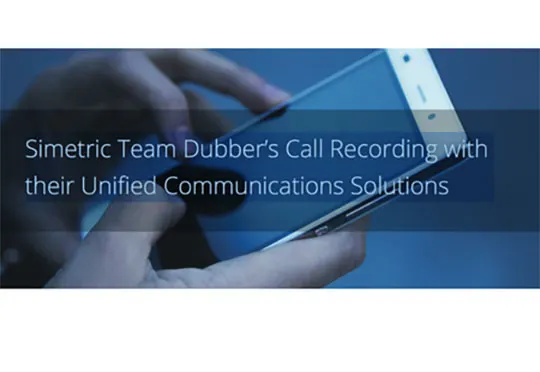
Simetric aim to converge service providers and provide users with a unified solution for their individual correspondence. They have utilised multiple mobile networks across the UK to develop a standardised network, enabling users to bene t from a single telephone number for both their mobile and fixed phones. To expand their UC solutions for business customers, Simetric chose Dubber.
“The Dubber platform and SaaS business model perfectly complement Simetric’s technologies. Simetric and Dubber share the same desire to continually work to develop and engineer innovative new products that revolutionise the telecoms industry. Through the partnership, we can now deliver a seamless integration of uni ed communications and call recording into both fixed and mobile services.
Dubber’s Playback service changes the face of mobile telephony in our view. It is the type of feature that highlights the value of our UC strategy and opens up significant opportunities to engage with all users in every market segment.”
John Murray, Director of Simetric Telecom (Tango Networks)
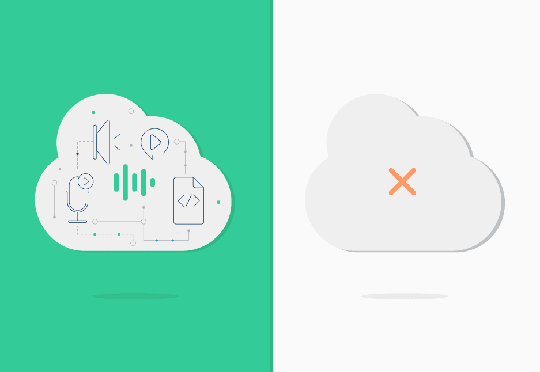
“The cloud is a principal, not a software version”
– GovSense
The internet is full of companies labelling themselves as a “cloud based solution”. Unfortunately, not all of these are true cloud products, but what have been nicknamed ‘fake’ cloud products. There are two forms of cloud based platforms from which companies deploy their technology solutions: hosted cloud platforms and true or native cloud platforms. Many companies who claim to be cloud based are often actually operating from a hosted cloud platform, which is both less efficient and less functional than true cloud based offerings. In fact, hosted cloud solutions sometimes simply add to the plethora of problems that accompany on-premise solutions.
A hosted cloud solution is a technology service offered by providers that host physical servers which actually defer the service elsewhere. Hardware is still required, which means that the solutions are not truly cloud based solutions, and are unable to be scalable – a feature that is one of the key attractions of native cloud solutions. Hosted cloud solutions are not built, maintained or managed by the provider themselves, as they are usually off-the-shelf products. Instead, they shift accountability to others, which causes the usual complications of third party involvement. Amongst other things, this creates a barrier between users and their data.

A true cloud solution is operated entirely from a native cloud platform, eliminating any need for hardware. Once hardware requirements are eliminated, the associated restraints of using hardware are simply eliminated as well. End users can benefit from efficient solutions without the need for any hardware, and the associated headaches. True cloud solutions can therefore provide best in the industry services. The list of benefits of true cloud platforms is extensive, and includes:
- Seamless integration into any application
- Unlimited scalability
- Open APIs – giving users the flexibility to adapt solutions to fit their requirements
- No tedious upgrade processes
- Speed and ease of use
- Greater value for money
- Highly secure
- Highly accessible
- Many others
Undoubtedly, the most significant benefit of true cloud platforms is their capacity for unlimited scalability, which enables end users to scale the processing power and storage capacity of solutions to fit their individual requirements. True cloud solutions have been built securely to perform in a multi-tenant cloud environment.They therefore support multi-tenancy, as well as data redundancy. They are often deployed with open APIs, providing users the flexibility to adapt the solution to fit their individual requirements. This agility perfectly compliments the dynamic and constantly changing demands of the modern world. In all these ways and more, true cloud solutions differ from hosted cloud solutions. Hosted cloud solutions are simply attempting to blur the lines between true and hosted platforms.
“Connecting an internal solution to the web and calling it ‘cloud’ is a bit like waterproofing a truck and calling it a submarine: it might technically fit the description, but it’s clearly not meant for that.”
The long list of applications and benefits that true cloud solutions offer simply cannot be matched by hosted cloud solutions, and so true cloud solutions are better equipped to help companies provide best in the industry solutions for their clients. The leading true cloud platforms are Amazon Web Services (AWS), the Google Cloud Platform and Microsoft Azure. Two notable examples of companies using these platforms to deploy their service include Netflix and Spotify. AWS enables Netflix to rapidly deploy data content on an enormous scale, to servers all over the world. It is AWS that enable Netflix to manage their huge user base and volume of data. Spotify use Google’s Cloud Platform to host their data centre, having opted to focus on data user queries to provide the best possible user experience. The Google Cloud Platform enables Spotify to scale their service to fit their popularity, and to answer user queries within seconds, by hosting their data centre on their scalable and secure platform.

In an increasingly tech-heavy world, a company’s reputation and ability to stand out from substantial competition is vital to its success, and providing best in industry solutions is the best way to secure a good reputation. True cloud platforms enable companies to deploy their solutions in a Software as a Service format, which guarantees unlimited scalability and global availability. Companies using hosted cloud solutions therefore have two problems. Firstly, they risk the displeasure of their customers at what could be perceived as false advertising – their products are not truly cloud based, and have none of the benefits of a true cloud based solution. Secondly, in providing none of the benefits that true cloud solutions do, they are far from being the best in industry.
Although true cloud solutions offer so many benefits, organisations must design their platform to take advantage of the built in seamless integration and elasticity, in order to realise these benefits. For this reason, Dubber built its recording platform with these true cloud features at its core, and is able to fully benefit from the AWS true cloud platform. Dubber therefore provides a call recording solution that functions as a Software as a Service and offers unlimited scalability, high security, an open API, rapid deployment and no upfront costs. As other true cloud solutions have done for their industries, Dubber has revolutionised the telephony industry and opened up a myriad of benefits for users: making call recording highly relevant and useful for everyone.

Dubber Selected by Telenor Sverige for Cloud Call Recording

Agreement with Simetric for Native Mobile Recording

We surveyed a sample of SMBs across the US with questions related to SMB call recording, and found some rather revealing results. After analysing the survey, it became clear that many businesses who could benefit from call recording do not use it, and often they have chosen not to because of concerns that only apply to legacy call recording solutions who rely on hardware. The survey results indicated a large target market for call recording that is yet to be tapped. Based on the results of the survey, this is where we think telcos are missing a trick.
Previous research from Harris Interactive indicates the importance of customer service – up to 60% of customers would prefer to pay more for better customer experience, and most significantly, 86% of customers left a company because of a bad experience. These statistics prove that providing excellent customer service is still high priority for all companies and, as call recording is widely used for quality assurance purposes, these statistics also demonstrate the importance of taking measures such as call recording to improve customer experience.
Yet the results of our survey demonstrate that, although 93% of SMBs conduct business over the telephone, a staggering 81% do not use call recording solutions from telcos for their business. When asked why, the survey (in which it was possible to select multiple answers to the question) found that 41% worried it would not be useful, which indicates a lack of education or efficient product marketing by telcos. Majority at 43% said cost was a factor. A further 39% worried about losing time to maintenance, and 35% were concerned about the security of call recording. A staggering 84% were concerned about all of the above.
However, 90% of those who don’t use call recording have concerns that actually only apply to legacy call recording solutions. Dubber has transformed call recording and communications capture to a cloud based platform, thereby eliminating the problems that relate to traditional call recording solution. These concerns are over security, implementation costs, usefulness and management.
The survey also revealed industry insights into what companies would use call recording for, and therefore provides interesting insight for telcos into the market for additional call recording functions. The survey, where it was again possible to select multiple answers to the question, found that the majority (58%) of SMBs indicated they would use call recording to improve their business’ customer service, whilst 43% would use it for dispute resolution, and the same again would use it for staff training. Interestingly, of the 43% who would use call recording for dispute resolution, 44% would be interested in smart search as an additional feature. Smart search features allow users to conduct advanced searches of their captured conversations and locate calls by various metrics that include date, location and keywords. They are a valuable tool for dispute resolution, as this relies on efficiently locating the correct information. For a survey that provided no additional information about call recording additional features, this percentage is high and demonstrates a significant target market. With some education on the benefits, this number could only increase.
Additionally, of those who would use call recording to improve their customer service, 28% would be interested in voice analytics as an additional function, which essentially act as a Shazam for human emotion. Voice analytics tools would serve a significant purpose in customer service, by providing insight into customer communications. Support and sales teams using voice analytics therefore gain an advantage in the provision of good customer service. Again, this is an encouraging start point for a target market, and will only increase as the true value of voice analytics becomes better understood by clients.
The results of the survey show that there is a large and untapped target market for call recording, with over 22.5 million SMBs in the US frequently conducting business over the phone, but not using a call recording service. The survey also demonstrates that this shocking number is in fact a result of concerns that only relate to legacy call recording solutions. As we have seen, over 22.5 million SMBs in the US are not currently using call recording, even though it could improve their productivity and increase their revenue. With Dubber, these SMBs have access for the first time to a call recording solution that has unlimited scalability, high security, rapid deployment, no upfront costs and increased relevance and functionality for everyone. Call recording is therefore an opportunity for a brand new client base for telcos: with a large target market and innovative new technology to offer them. Survey says… it’s a no-brainer.

MyNetFone confirms agreement to enable call recording

Since the first mobile generation was released in 1982, a new generation of mobile has followed approximately every decade, the most recent being 4G in 2012. As soon as the dust settled on the release of 4G however, talk became focussed on the next generation. Only 3 years later, 5G is among the hottest topics in the industry. With Telstra recently completing successful trials in Australia, expectations for the capabilities of 5G are high. Set to become available to the public in 2020, the potential of 5G is drawing closer – and it is not just telcos who are excited.
The Possibilities
The 5G upgrade will be achieved in one of two ways: either as a complete redesign of the radio spectrum that previous generations have built on, or as a more simple extension of the current 4G technology. 5G is aiming to improve not just speed, but capacity and latency as well – allowing users to experience browsing with less delay and unlimited connections. This crucial difference will ensure that 5G speeds are not just a slight upgrade, but light years ahead of the current technology.
Recent testing by Telstra shows 5G is capable of speeds greater than 20 Gbps, as well as a latency that is up to half of that of 4G networks. Dr Magnus Ewerbring, Ericsson’s chief technology officer in Asia Pacific and a partner of Telstra, said of the tests: “these early 5G trials will help drive the global standards that will ultimately cover 5G.” Hypothetically, these speeds would be fast enough to download 600 movies a minute, or the entire 6 seasons of Game of Thrones in less than 20 seconds.
These tests seemingly indicate that 5G will bring vastly improved speed, latency and capacity, as well as assisting the growth of the Internet of Things from present day figures of 6.4 billion connected devices, to a projected 21 billion by 2020. Use of the IoT is on the rise, as a number of companies have begun to experiment with its potential. Coca Cola for example, currently use microchips to track their bottles, and Amazon have introduced ‘Dash Buttons’ – which allow users to restock their favourite household products, such as Andrex and Ariel, at the touch of a button. The true potential however, is yet to be tapped. Ultimately, 5G could revolutionise the industry, bringing not only fast and highly accessible cellular browsing, but also bringing the full functionality of the IoT into our everyday lives. Ultimately, 5G will aid the creation of a digital society and economy that could connect limitless numbers of devices through one network.
For telcos, 5G represents a future revenue channel with abundant possibilities. Recently, smartphone users have been taking advantage of improved wifi capabilities, which has decreased data usage and resulted in some lost revenue for telcos. 5G represents a way to interest smartphone users in cellular browsing once more, and hence replace this lost revenue. However, the rise of the Internet of Things could result in a massively compressed telco infrastructure, as all industry sectors join together. For telcos and other companies in the technology sector, this makes staying ahead of the curve more important than ever… Cue a host of organisations throwing their hat into the ring.
So what’s the downside?
It is not just the telecoms industry who are excited by 5G, but various others who could capitalise from it as well. The result is numerous industries wanting a slice of the action, and so 5G must now fulfil multiple agendas and requirements. Media companies will want prioritised bandwidth, so that their movies can be streamed in higher resolutions. Gaming companies will expect low latency for optimum player experience. Technology companies such as Apple and Samsung are perhaps the biggest investors: Smartphones are an obvious motive, but they are also keen to involve themselves in the IoT, which is tipped to become their next big source of revenue. The development of 5G will therefore be a product of the involvement of various industries. It could be a case of too many cooks spoil the broth, or it could in fact signify the beginning of the next generation of telecommunications technology – a compressed infrastructure that joins together media companies, technology firms, transport organisations and more.
5G therefore represents the chance for telcos, governments and technology companies to unify and create new world standards of living in a digital age. Exciting advancements such as self-driving cars, remote-controlled surgery and self-ordering fridges are all possible with its release. It represents a time of growth for many companies: telecoms have the opportunity to reverse their declining revenue and rejuvenate the industry, whilst technology companies have the chance to broaden their field. A technology revolution is ahead, and the potential is exciting for companies from all industries.
However, as the infrastructure compresses, telecommunications companies invest in the IoT and technology companies begin to offer their own communications options (such as WhatsApp and Facebook Messenger), companies must adapt to the shifting market to stay afloat. The fate of companies such as Dell and HP, who struggled to keep up with advances in IT after the rise of cloud computing, demonstrates the necessity for companies to keep up with the technological revolution that 5G represents. Telcos, technology firms, media companies, automotive organisations and many more, all have the opportunity to profit from 5G and the IoT, as long as they are able to convert to a concentrated and interconnected digital economy. The race to 5G is officially on, and no one wants to be last.

AGM Notice of Meeting
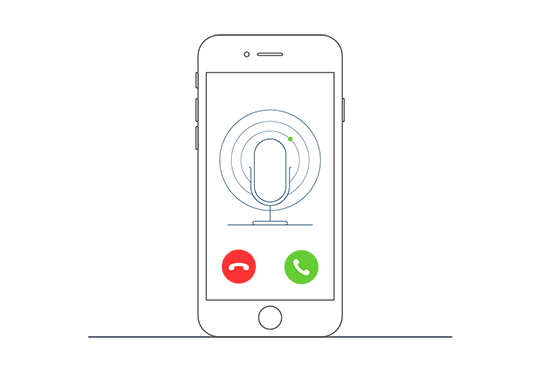
Since the game-changing release of the first generation iPhone back in 2007, the annual reveal of the newest model is an event that has gathered a following that is borderline fanatical. Since then, Apple has continued to dominate the smartphone industry, raking in a staggering 94% of smartphone industry profits, and their popularity shows little sign of slowing down. In fact today, 395 iPhones are sold in the world every minute. The release of the iPhone 7 was as eagerly awaited as ever, however its reception has already been mixed. A poll from Fortune found that fewer people than ever are actually interested in purchasing the new iPhone. The decision to eliminate the headphone jack has proved controversial, and various techies have claimed it is too similar to the previous generation. Among the displeased are telcos. One particular new feature of the iPhone 7 and iOS 10 could potentially cause trouble for the telecommunications industry.
With the increasing popularity of online communications, VoIP services are constantly growing in demand. WhatsApp recently passed the milestone of 100 million voice calls per day, and Skype now has over 300 million monthly users. The transition away from traditional methods of communication is sure to spell trouble in the future for telcos: and this trouble moves ever-closer upon the release of the iPhone 7. A new feature allows users to answer VoIP calls from the lock screen – a feature that was previously reserved for voice calls only.
Now that Apple has increased the accessibility of VoIP calls for those who invest in the new iPhone, the opportunity for VoIP growth will only increase if this feature is adopted in future evolutions of smartphones. For telcos, an increased popularity of VoIP calls will cause a decrease in their customer usage of voice call minutes. Ultimately, this could drastically affect telco revenues, as customers who make use of this new VoIP accessibility will largely only pay for their used data. This could drastically reduce profits because voice calls are currently responsible for approximately 80% of telco revenue.
The iPhone 7 has also created another problem for telcos. The iPhone 7 has been upgraded to be capable of “lightning fast” speeds, with an LTE-A of up to 450 mbps. The problem is, there are actually very few telcos in the world who can support such speeds. This could create the problem that either iPhone 7 users will be displeased with their telco because they are unable to take advantage of the faster speeds, or telcos will need to work towards expensive upgrading. Either way, the higher speeds of the iPhone 7 could put telcos under pressure, even though they’ve already invested billions of dollars upgrading their networks to provide 4G.
The silver lining
With Apple declaring the latest iPhone as more expensive than its predecessors, telcos can cash in and offer more expensive contracts. Several UK telcos have already announced their pricing options, and EE, Vodafone and O2 have confirmed their higher price plans, forcing consumers to bear the brunt.
Various telecoms have previously voiced their displeasure with VoIP apps, stating that they are in breach of licensing conditions that telecoms themselves have to abide by. With the release of the new iPhone 7 and iOS 10, increased accessibility of VoIP calls is certain to cause further problems for telecoms worldwide.
What’s the solution?
The future success of telecoms may soon depend on their ability to adapt to the shift away from traditional communications, and alter their businesses to fit the unpredictable and ever-changing market. Accepting the increased use of internet based communications, and creating price plans for customers that offer fewer minutes and increased data, is perhaps a logical start point.
Additionally, by deploying new and disruptive services such as Dubber’s Playback, telcos can tap into brand new revenue streams to compensate for the loss of revenue in call minutes. They can even do this whilst maintaining attractive price plans, instead of irritating customers by hiking up the prices of subscriptions and bundles as they have done previously, year after year. Ultimately, innovative and agile service providers will catch the worm.
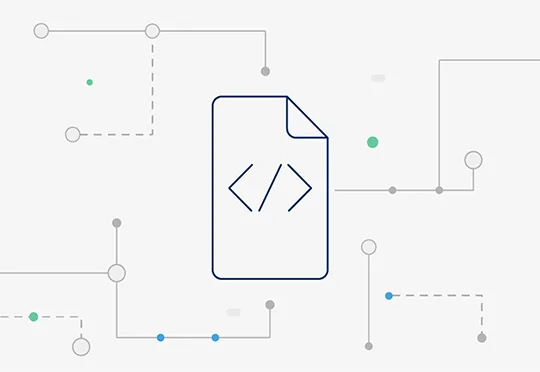
APIs began their significant rise in popularity with the launch of Salesforce’s Web API. Soon multiple large corporations were launching APIs, including ebay, Amazon.com and Amazon Web Services. The increase in popularity continued its exponential growth, and now Web APIs can be found everywhere. Communications companies are amongst the many sectors finding interesting uses for launching or using open APIs. Often, a voice and call recording API is used to improve communications, and finding the most cost-effective, scalable and secure solutions for users.
For example Dubber’s call recording solution has been constructed around an open API, allowing companies to alter the product to fit to their specific requirements. By using the Dubber open API, companies can continue building and designing the call recording solution to fit their desired functionality, brand identity, and business plan. Building requirements into our pre-existing product enables companies to save time, money and other resources. For example, Uber use the Google Maps API on their app, rather than spending superfluous time and money creating their own.
Call recording APIs similar to Dubber’s RESTful API have endless possible use cases. They present call recording as a service that can be adapted and progressed to meet the individual needs of users. Here, we list 5 innovative use cases for an open voice and call recording API.
- Telcos: Telecommunications service providers around the world have already chosen Dubber’s call recording software, and are currently reaping the benefits of our native cloud based solution. For service providers, an open voice and call recording API can be used to integrate our call recording product into their existing service, allowing them to deploy our service as part of a bundle that includes their other communications software. They are also able to benefit from our revolutionary service whilst maintaining their own brand identity.
- End user businesses: An article by Forbes writes that the chances of selling a product to an existing customer is between 60-70%, whilst the probability of selling a product to a new customer is just 5-20%, thus highlighting the importance of looking after and retaining your current customers. An infographic by Provide Support Blog suggests that 56-70% of customers will return to your service if you resolve their complaint. Good customer service and speedy dispute resolution are therefore essential to the success of a business. Call recording can help with training, dispute resolution, quality assurance and more, ultimately improving a company’s customer service. Going further, a voice and call recording API can aid integration into company CRMs, enabling customer service departments to attach recorded calls to customer data, helping to improve customer service and dispute resolution strategies over time by gaining a clear snapshot of results through detailed customer reports.
- Aiding employees with disabilities such as Autism: According to a guide written by Autism Speaks, 1 in 5 Americans have a disability. In business, the guide quotes from a national survey of consumer attitudes that 87% of Americans would prefer to give their business to companies who hire employees with disabilities. In fact, it has been found that employees with disabilities are just as productive as their peers, and have attendances that are equal to or higher. Autistic employees are one example: they make excellent employees and contributions to a company, but sometimes become stressed by the social aspects of a workplace. A service such as Dubber’s Sentiment can aid companies in hiring employees with Autism. Employees would be able to work from home or in an environment they are comfortable in, and take part in conferences and meetings via VoIP services. Sentiment could then analyze their mood, by identifying the emotional responses of the speaker through examining tone of voice, speed of speech and stress levels. Like a Shazam for human emotion. Sentiment could be operated during VoIP communications to help employers monitor the emotional responses of their employees, and ensure they are happy and comfortable.
- Reactive Keywords for call centres: Using call recording to maximise the quality of customer service and ensure returning customers has never been easier than with call recording. Using an intelligent and open voice and call recording API, call centres can track keywords or phrases, and organise customer communications. For example, using Dubber’s Zoe keywords could be implemented into existing systems using Dubber’s RESTful API, aiding customer service by creating specific reactions for keywords. For instance, the phrase “I want to speak to your manager” could reactively trigger an email to the manager alerting them, or the word “complaint”, could reactively trigger a notification to the complaints department allowing them to take immediate action.
- Risk protection audit for Banks: Banks are subject to comprehensive internal audits that play crucial roles in the ongoing maintenance and assessment of their internal processes, control and management. Using a voice and call recording API and intelligent search functions could aid this process. By highlighting and tagging certain words or phrases and creating smart transcription, automatic responses in internal inspections could be generated, which would significantly speed up the audit process.

BroadSoft provides Unified Communications and Collaboration services to operators all over the world. Put simply, BroadWorks helps operators to provide unified communications services needed by enterprise customers globally. The call recording protocol used by BroadWorks has been integrated into the very core of Dubber, allowing us to work together in perfect harmony. Without being too technical, here we describe how this partnership benefits the call recording services Dubber can provide to our users.
BroadWorks embraced a new global call recording standard when they created their SIPREC interface. The interface essentially provides a link between the service provider’s telephony environment and the recording platform, allowing companies who provide call recording solutions access to users’ conversations. If the user decides to record their calls, this interface enables them to utilise call recording software. It is the SIPREC protocol that forms the basis of Dubber’s construction. Our call recording solution has been designed to interface with the SIPREC platforms, enabling us to provide call recording to any platform that already deploys SIPREC. BroadSoft is the perfect partner for Dubber, helping our call recording solution to achieve new levels of functionality and service to our users. BroadSoft themselves have acknowledged the harmonious union as Dubber passed their rigorous interoperability tests to become accredited: “The Dubber platform and SaaS business model complement the BroadSoft technologies”.
This partnership developed further in May this year, when BroadSoft chose Dubber to be their official partner for Audio Call Recording as part of their fully managed service for Japanese telecoms, BroadCloud. This development is something Dubber has eagerly awaited, as it provides an exciting development for our growing global scope. We will soon provide our call recording solutions in association with BroadSoft’s managed service in Japan, improving our service in yet another region.
The BroadWorks motto is “simplify, accelerate, innovate”, and through our collaboration, that is exactly what Dubber has achieved for call recording services.
Simplify
Dubber’s partnership with BroadWorks simplifies call recording for our users by:
- Limiting your admin. The only administration needed to start using our recording services is a simple sign up to the BroadWorks interface
- Automatic call recording: Dubber captures calls through the SIPREC interface directly from the BroadWorks system
- Processing of data: all relevant metadata is efficiently processed, stored and presented through the Dubber Cloud Application
- No hardware headaches for end users or service providers
- No need for maintenance, upgrades or limited scalability or storage
Accelerate
Dubber’s partnership with BroadWorks accelerates call recording for our users by:
- Rapid deployment: the SIPREC link between BroadWorks carriers and Dubber speeds deployment of our call recording to users. Your service could be up and running in mere hours!
- Automatically provisioning Call Recording for BroadWorks users
- Limited administration and setup
- Hassle free testing: Dubber’s Lab operates as a call recording sandbox, allowing carriers to test our services by connecting BroadWorks lab systems to Dubber in a matter of minutes
Innovate
Dubber’s partnership with BroadWorks innovates call recording for our users by:
- Allowing unlimited scalability: Dubber’s connection to BroadWorks operates from a cloud platform, allowing elasticity of call recording services to users for the first time
- Creative ways of accessing the Big Voice Data: through the BroadWorks API allows association between Dubber users and their phone data
- Specially constructed high availability of every component of Dubber
- Meeting PCI-DSS compliance: all BroadWorks users can benefit from Dubber’s ability to help users meet PCI-DSS compliance through secure access to recordings and encryption technologies, download and sharing controls, complex password authentication, pause and resume functions during exchange of sensitive information, ability to tag recordings as ‘sensitive’, and finally DTMF masking and muting
- Global service: the partnership enables Dubber to deploy call recording worldwide: interconnect points are available to maintain a guaranteed level of quality between the service provider’s SIPREC enabled deployment and Dubber’s cloud infrastructure. New locations can be requested.
- Support for VoiP, IM and Video capture
The accreditation by BroadSoft has allowed Dubber to revolutionise BroadWorks call recording technology for service providers, by providing a service for end users that has never before been possible. As with everything we do, Dubber works to innovate our services in areas which have previously been stagnant for essentially decades. In pursuit of this challenge, we are always looking to partner with industry leaders such as BroadSoft, and through these relationships, bring improved service to both our end users and the clients of these industry leaders.
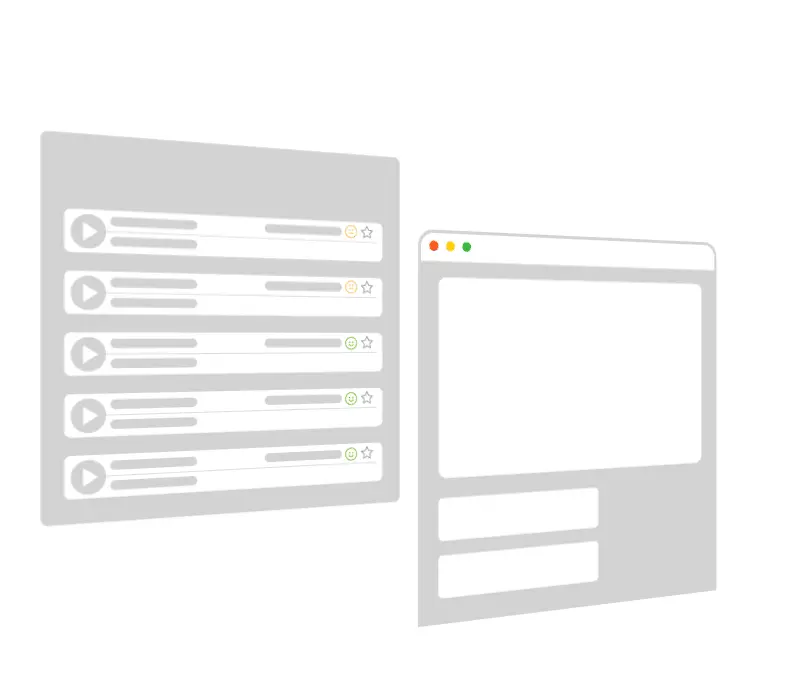
Laws and regulations put in place to protect consumers have been a large driving force behind recording communications between businesses and their customer. As remote communication overtakes face to face human interaction, it’s paramount to have procedures in place to ensure people are who they say they are at other the end of the line and also to make sure that the communication is safely recorded to resolve any incidents in future.
We’ve all come across the common line when you’re waiting to get through to a customer service agent: “This call maybe recorded for monitoring and training purposes.”. However some organisations may be recording calls to follow regulations, which you might not be aware of. Here’s are some key industries who are keeping their consumers safe through intelligent communications recording:
Contact Centres (Non-financial)
The most common use case for call recording regulations is seen in contact centres where customer service resolve an array of users’ issues. For training purposes and to resolve potential disputes, calls often get recorded at call centres. According to Ofcom’s (the UK’s communications regulator) guidance for recording calls in the UK, contact centres who look to monitor, record calls and communications are required to adhere to a combination of UK & EU legislation which includes but is not limited to:
- Regulation of Investigatory Powers Act 2000 (“RIPA”).
- Telecommunications (Lawful Business Practice)(Interception of Communications) Regulations 2000 (“LBP Regulations”).
- Data Protection Act 1998.
- Telecommunications (Data Protection and Privacy) Regulations 1999.
- Human Rights Act 1998.
To summarise the legislation, a home or business user may record communications without permission of the correspondent as long as they do not share the data with a third party, where then they would need to have their consent.
Additionally through the aforementioned LBP Regulations. A business can monitor and record communications as long as they are for a series of laid out circumstances such as preventing or detecting crime or to measure quality. The purpose of most other legislation is to avoid misuse and abuse of recordings.
Financial Services
According to the UK’s financial regulator, the Financial Conduct Authority (FCA) a series of financial firms are bound by law to record and safely store their communications. These call recording regulations were put in place to “tackle market abuse by identifying and punishing those responsible”.
To begin with, only some financial services companies are required to adhere to call recording. For example retail finance advisors, mortgage brokers, insurance brokers and some others are not required to capture their communications. More stringent rules apply to firms which are in a highly influential position such as investment advisors and stock brokers.
The type of calls that need to be recorded are specifically outlined as ones which:
- conclude an agreement with any client or with another regulated firm on behalf of a client;
or
- are conducted with a professional client or eligible counterparty with a view to concluding an agreement.
Payment Card Industry (PCI Compliance)
On the back of an earlier initiative by VISA, in 2004, the major card companies aligned to form the Payment Card Industry Security Standards Council (PCI DSS). On December 15th 2004, the PCI DSS 1.0 was released. Over the following years PCI DSS has evolved to not only provide greater security to the industry, but also to accommodate new technology advancements and is today the global data security standard for payment cards.
If your organisation is looking be PCI compliant then as part of the PCI Data Security Standard (PCI DSS), you’ll be facing the issue of recording sensitive authentication data (SAD) when taking payments through the phone or other devices.
It is a violation of PCI DSS requirement 3.2 to store any SAD, including card validation codes and values, after authorisation – even if the data has been fully encrypted. It is therefore prohibited to use any form of digital audio recording (using formats such as wav, mp3 etc) to store CAV2, CVC2, CVV2 or CID codes after authorisation if that data can be queried; recognising that multiple tools exist that potentially could query a variety of digital recordings.
Dubber or similar services, could assist organisations to become PCI DSS compliant when it comes to recording their communication. Dubber does this in two ways:
- Dubber’s PCI integration technology with Automated Pause/Resume helps a customer to comply with the Payment Card Industry’s Data Security Standard (PCI DSS). This is accomplished by automatically muting and unmuting a recording when pre-defined system events are detected.
- The Dubber PCI Payment Node can easily implement PCI compliant payments using the new Dubber PCI Payment Node. During a call, a PCI compliance transaction is required and the process is triggered by agent. At that point the agent transfers call to the PCI Payment Node (hotkey or phone number) the Node scripts take over, requesting the relevant details (e.g. amount, card number etc). The captured payment details are sent automatically to the merchant for completion. Once the transaction is completed, the caller is connected back with the agent to complete the call.
If you’re looking to implement call recording and you’re not sure about the relevant compliance which you’ll need to adhere to, contact your industry authority for further information on specific regulations and legislations.
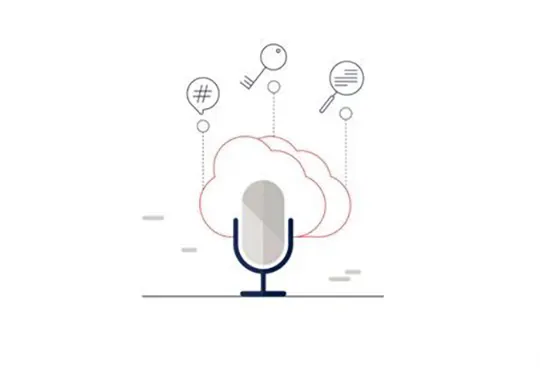
At Dubber we’re excited to announce a new partnership with a leading, UK based Computer Telephony provider, Mondago. Mondago specialise in providing unified communication solutions with a strong emphasis on CRM integration to manufacturers and providers of telephone systems.
Through Dubber and Mondago’s new partnership, Mondago’s flagship Go Integrator product is now able to provide as simple, automated pause and resume of calls being recorded, using Dubber’s cloud based service. A simple change in browser URL or PC client window can be used to automatically send a pause and resume command to the call recorder avoiding the need for the user to manually undertake this action using the handset keyboard. This feature is particularly useful for agents taking credit card type details over the phone.
“As Dubber has passed BroadSoft’s rigorous interoperability tests, we were able to quickly update our popular Go Integrator product to include this additional functionality. This means additional value-add to our customers, with minimal effort.” Rob Cox – Commercial Director at Mondago
“We’re excited to be integrated with such an innovative product suite and adding value to a network of users through Mondago. This partnership demonstrates the extent which cloud telephony is evolving and growing as we know it.” James Slaney – Global Manager at Dubber
For more information about this partnership, or if you’d like to find out how you can benefit from these services, just drop us a note through this form.
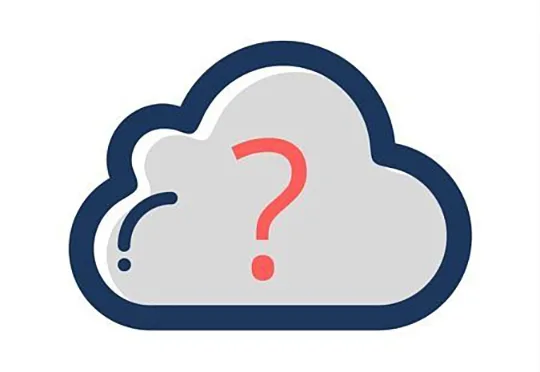
Even though it was a shock to the system, the effects of Brexit are not yet visible throughout majority of industries. The sterling has dropped against the dollar and some property finance organisations have paused investments. Apart from that, it’s business as usual for most of us. And those who are invested in trade with EU, are waiting to see what kind of a deal UK’s newly appointed Prime Minister, Theresa May, will close with the Union.
So as everyone is looking closely at what kind of trade deals UK and EU will close, is anyone actually looking at what will happen to all of our data and what kind of laws citizens of UK will be protected by when it comes to their personal information being exploited by the Cloud giants like Facebook and Google?
Trade agreements between governments are notorious for taking up to a decade to complete. Even though the EU members and UK would like to start the divorce process as quick as possible, we can boldly assume the UK will end up with a deal similar to what Norway got.
When it comes to our data, as long as the UK is still part of the European Union, we’re protected by EU laws and safe guarded from the by the giants under the Safe Harbour succeeding successor agreement called Privacy Shield. As mentioned in the agreement, this new framework will come into force practice from this Summer. But after Theresa May triggers Article 50, what will happen then?
In a very unlikely scenario, the data giants will pack up their UK offices and move to an EU member state and the data policies that protect them and their customers remains the same.
A more likely scenario is that in the short term, UK will adopt new data protection laws which mirror EU laws and anyone operating in the kingdom will be bound to and protected by these regulations.
Lastly, UK is likely to agree to a deal which means even though it’s not a full member, it will be treated as a second-class member where it will have access to tariff-free trade with EU, and would have to agree, at least on an interim basis, to Free Movement for citizens of member states, and not to rock the boat and keep the giants happy, enjoy the EU’s data protection laws and the new Privacy Shield agreement with US.

The British public have spoken and they want out (of the European Union). In the months running up to the June 23rd referendum the sterling took a plunge but made a bullish recovery ’til the the night of voting. Following the success of Vote Leave, as it was announced throughout the night and morning of 24th, we’ve seen the FTSE 100 and the GBP take huge dives.
With both now being slowly on the mend, it makes me wonder, how is rest of the economy going to react to this within short and medium terms. When it comes to Telcos and service providers, where can we see drastic changes in the near future?
Relocation, Roaming, International Calls and Spectrums
When it comes to mobile carriers and large telecommunication organisations, there are four major areas we can speculate about, and these are the ones we’ll be discussing here. First will be major providers considering moving their European headquarters outside of UK.
We can draw from Mr Colao, Vodafone’s CEO hinting that FTSE 100 companies such as Vodafone could move their headquarters if the free movement of people and capital was restricted. Freedom of movement may become more regulated in a UK outside of EU, but will movement of capital will ever become restrictive enough for companies such as Vodafone to consider relocating their headquarters?
Second is international calls. On the back of Britain leaving the EU, we might see another Scottish referendum in order for the Scots to leave the UK and apply for an individual EU membership. In basic terms, a phone call from Scotland to England would then count as an international call and the new costs imposed on consumers.
Next area of concern is roaming charges. The European Commission recently ruled in favour of abolishing roaming charges by June 2017. Companies like Vodafone and Three have already been rolling this offer to their customers. By the time UK has triggered Article 50 and spent the next two years negotiating a deal to exit the EU, we might see roaming charges snapped back into place for UK customers, travelling through Europe.
Regarding the fourth area of change, according to Bird & Bird, following Brexit, the UK is not going to be subject to decisions and regulations set by the Commission on spectrum allocations and use across the EU. Most likely UK will cooperate with member states and neighbouring countries, however regulatory divergence may rise between UK and EU in respect of regulations of OTT services. UK may take a more liberal approach on these services that could help add to stagnant revenue streams of carriers and telcos in west Europe.
For the year ended 31 March 2016, Vodafone reported organic group revenue growth of 2.3%. Most of this growth came from outside the company’s European area of operations. Vodafone’s service revenue from its African, Middle Eastern and Asia-Pacific operations grew at 6.9% year-on-year. European service revenue shrank by 0.6% on an organic basis for the period and UK service revenue contracted by 0.3% for the period.
Telcos are not Brexit ready
In a recent poll by Pinsent Masons, an international law firm, has highlighted that only 35% of telecommunication firms polled have a clear plan for dealing with impact of UK leaving EU.
In addition a recent survey by TechUK of 277 technology business leaders found 70% were in favour of staying in the EU, with only 15% supporting a Brexit. More than 90% of those in favour of leaving the EU said it would give the UK more flexibility in a global economy, and 64% believed it would make the UK more globally competitive. Here we can argue that the main disadvantages of staying in the EU would be around red tapes and regulations enforced by EU on UK innovation and growth in these areas.
To summarise, nearly in each area where a door is closed by UK leaving the EU, a new one may open through opportunity, innovation and investment. A lot will come down to the negotiations in the next two years, who the Conservative party will nominate to lead the country through these negotiations and how quickly the nation can unify and back the majority decision in the referendum. As roaming and spectrum rules could become British, it is very likely that they will mirror the European approach in these instances and we won’t see any immediate benefits from a new ‘free market’ that is to be the new UK.

Dubber Annual Report 30 June 2016

Additional Information – AVC One for Call Recording

A snapshot into the evolution of unified communications and call recording through the last two centuries. From the first telephone operators to new generation of communication recording intelligence.

Cloud-based call recording technology provider Dubber Corporation Limited (ASX: DUB) (“Dubber”) is pleased to announce it has been selected by UK telecommunications and IT service provider, AVC One (“AVC”), to provide call recording services via AVC’s BroadSoft platform.
AVC’s management team are pioneers of BroadSoft’s unified communications (UC) platform, and were one of the first to adopt BroadSoft’s technology in the UK in 2002. The company has subsequently built a channel network of service providers and resellers, and count many high profile UK brands as customers.
The agreement with AVC is the first customer engagement with Siphon Networks, under a distribution agreement commenced in March 2016. As an existing provider of BroadSoft managed services to AVC, Siphon have been an integral part of the agreement and are providing integration resources to deploy Dubber on AVC’s platform. AVC will initially deliver a minimum of 1,000 contracted ‘reserved’ users, which will expand with opportunities from both existing AVC call recording users and those requiring unique functionality provided by Dubber.
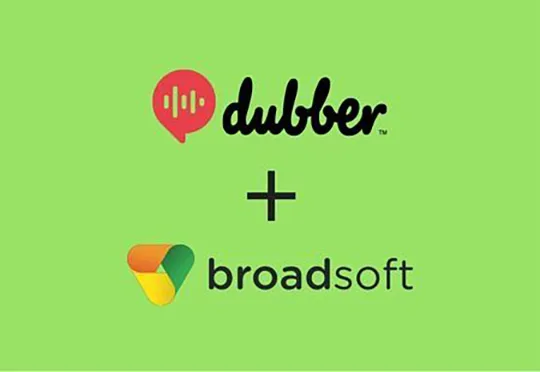
On Monday 30th May 2016 we proudly announced that Dubber has been selected by BroadSoft as their chosen partner for Audio Call Recording to be provided as part of their managed services, BroadCloud, for Japanese telecommunications carries.
BroadCloud is a fully managed service that delivers BroadSoft’s extensive range of Unified Communications services. This includes managing end-to-end customer sales and service implementation processes.
This managed services offering has been available through a series of telecommunication and carrier partners in US , however BroadCloud rapidly expanding this offering into new demographics, such as France and Japan. This news has been eagerly awaited and we’ve seen some innovative service providers such as NIFTY Japan, take it onboard immediately.
Now as Dubber is chosen to be part of the BroadSoft’s managed service offering in Japan, we can start to see a series of market leading and innovative servicer providers taking on and expanding’s Dubber’s Audio Call Recording platform, to enable a secure, easy to manage and on-demand scalable solution to their end users.

Audio Recording Capabilities for BroadSoft Japan

Dubber Annual Report 30 June 2015

Dubber Corporation Limited (Formerly Crucible Gold Ltd) Annual Report 30 June 2014

